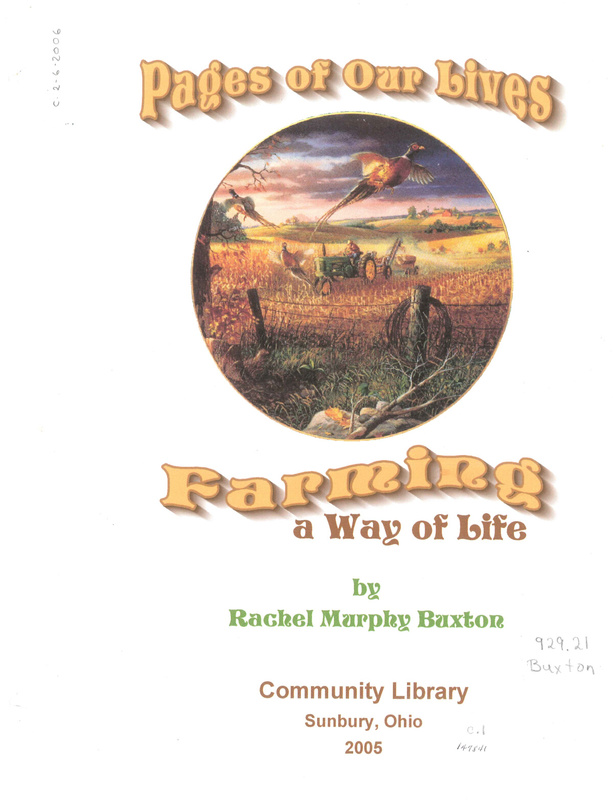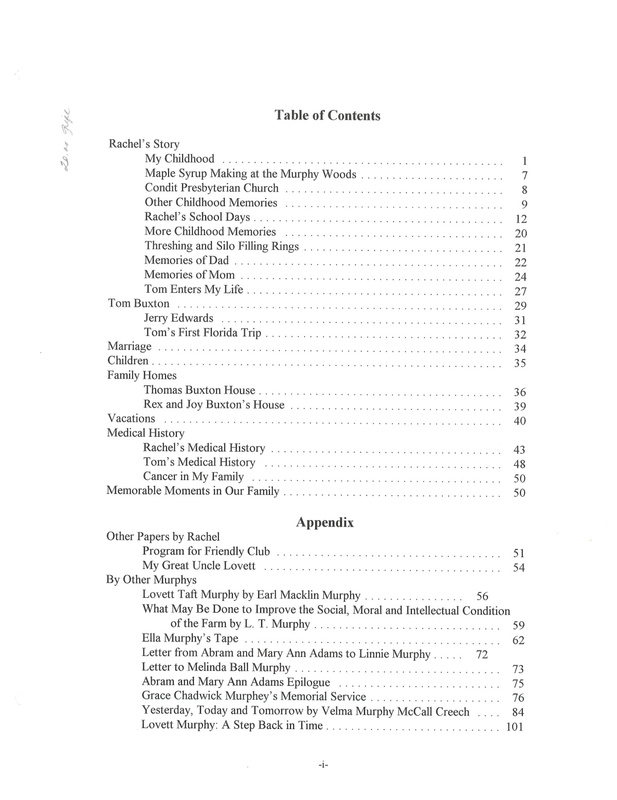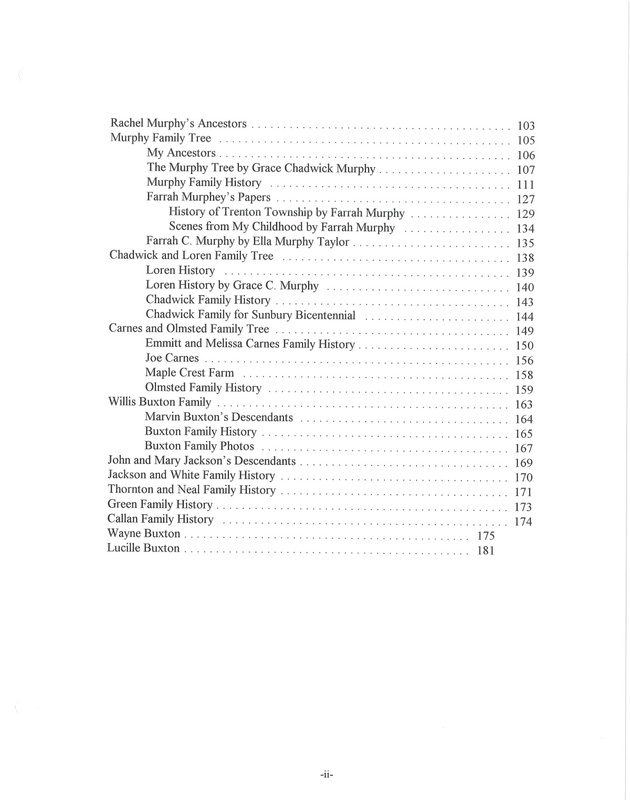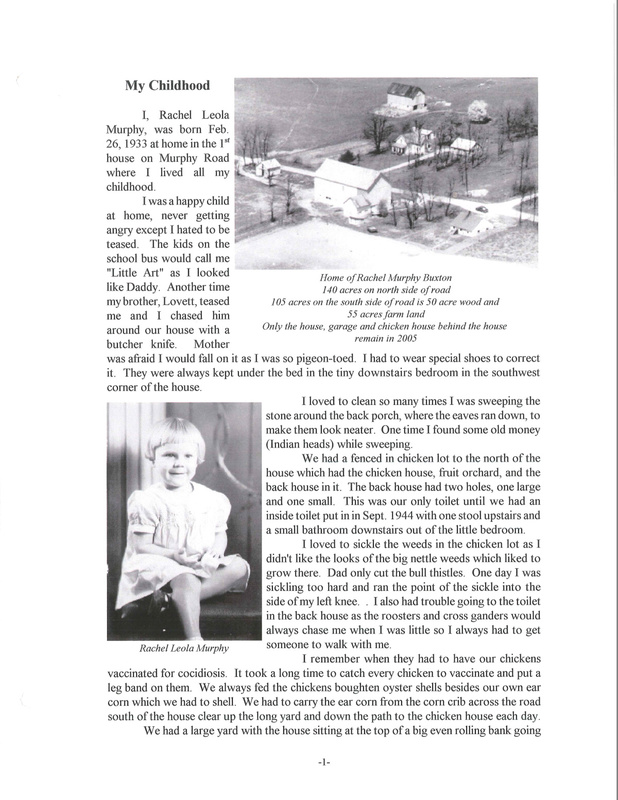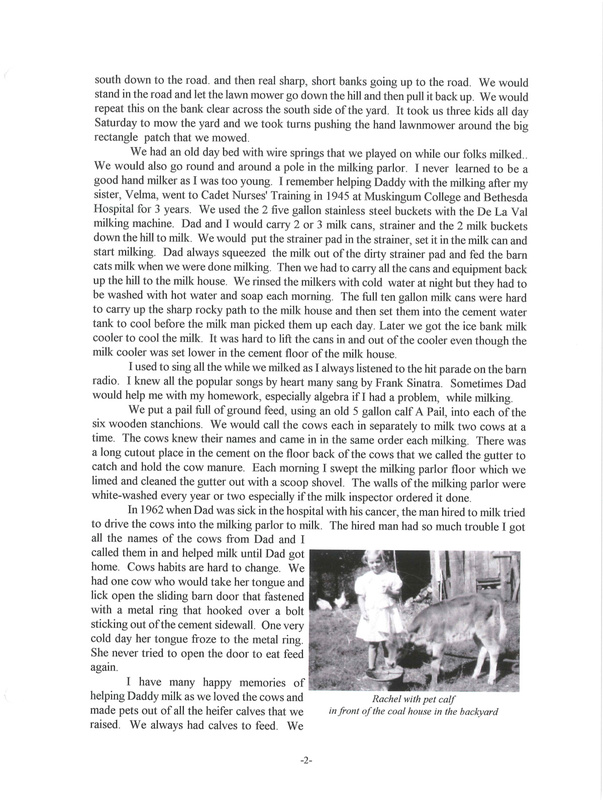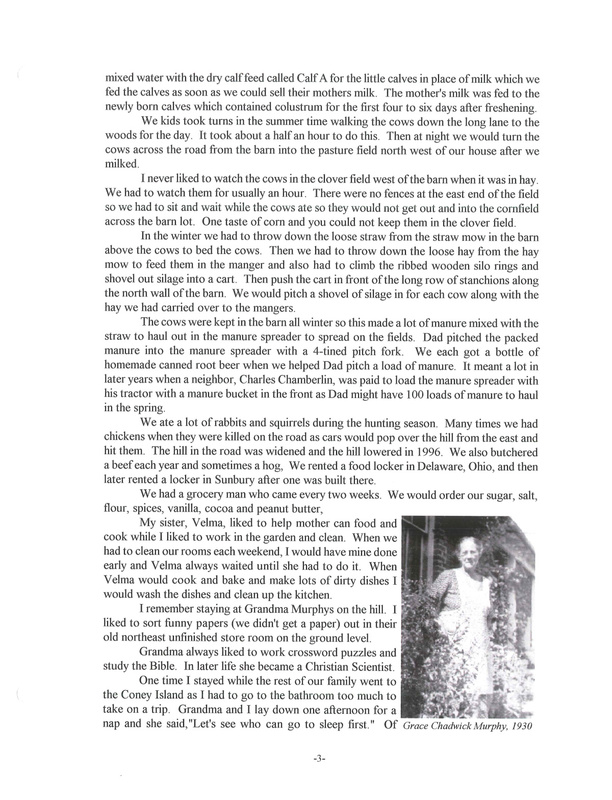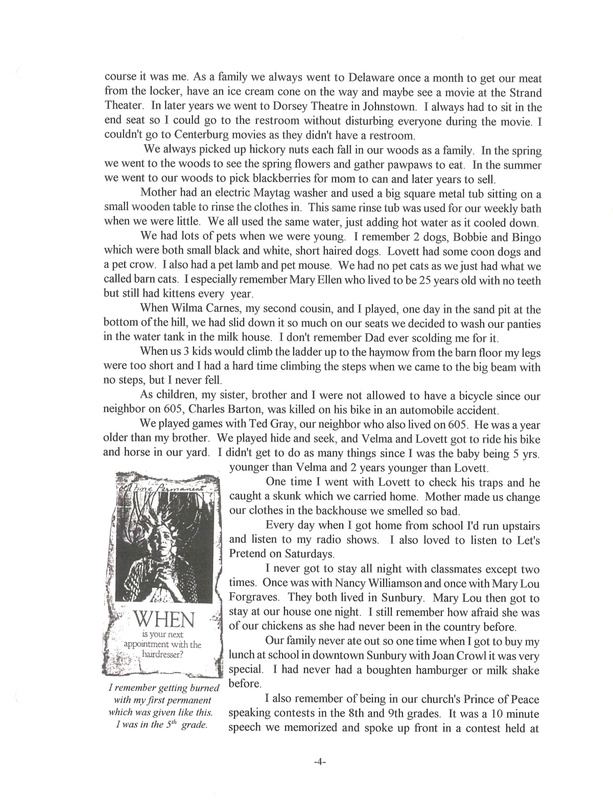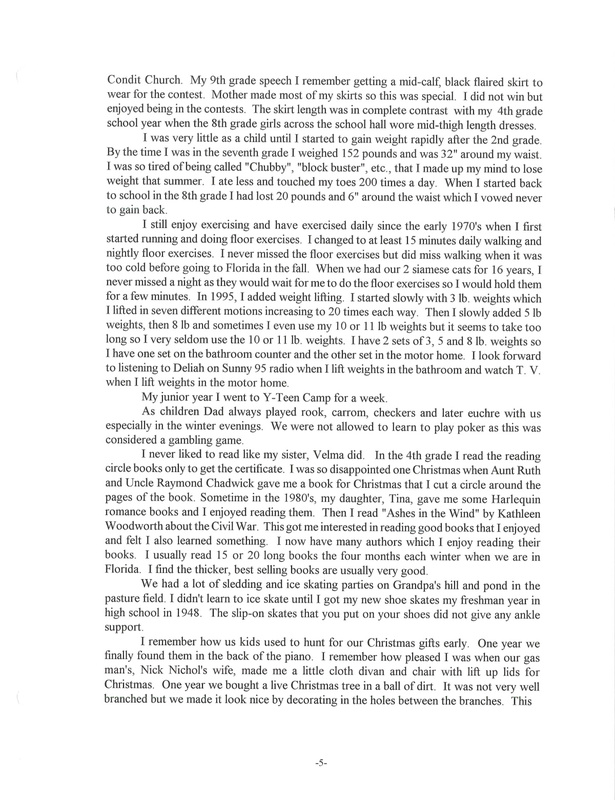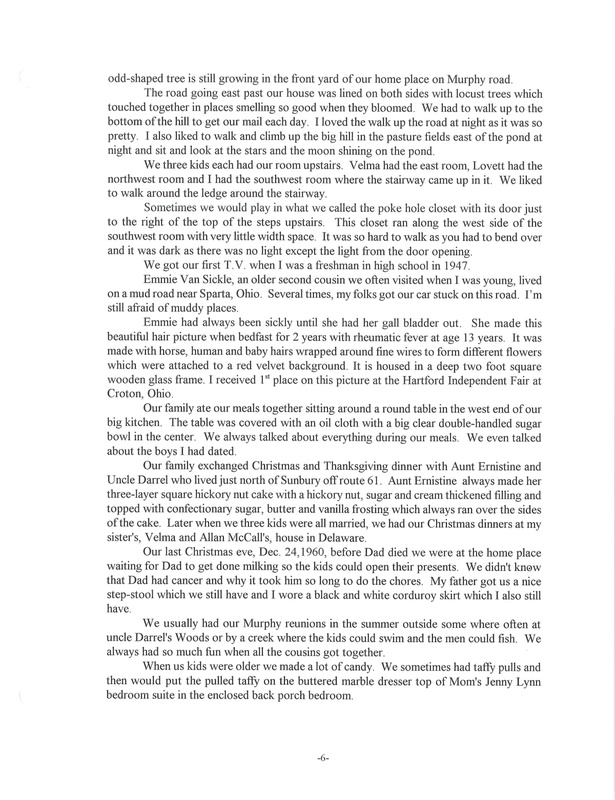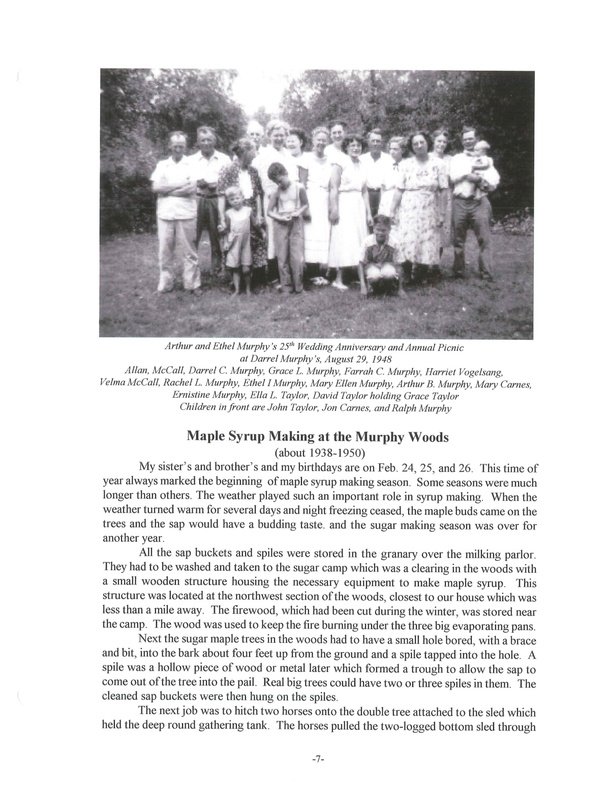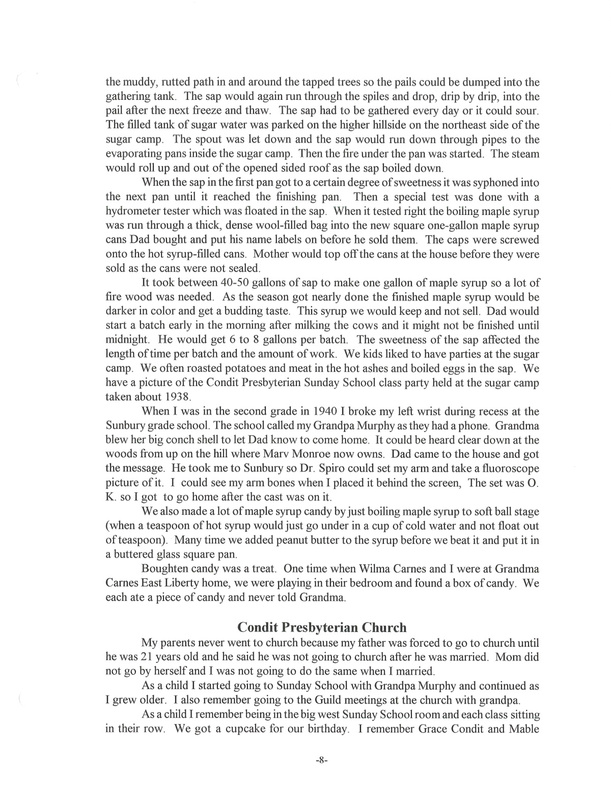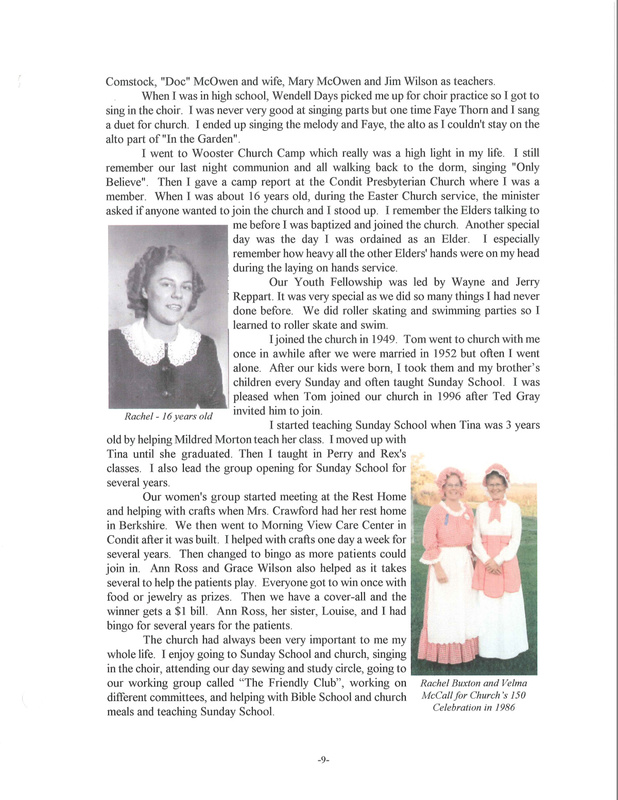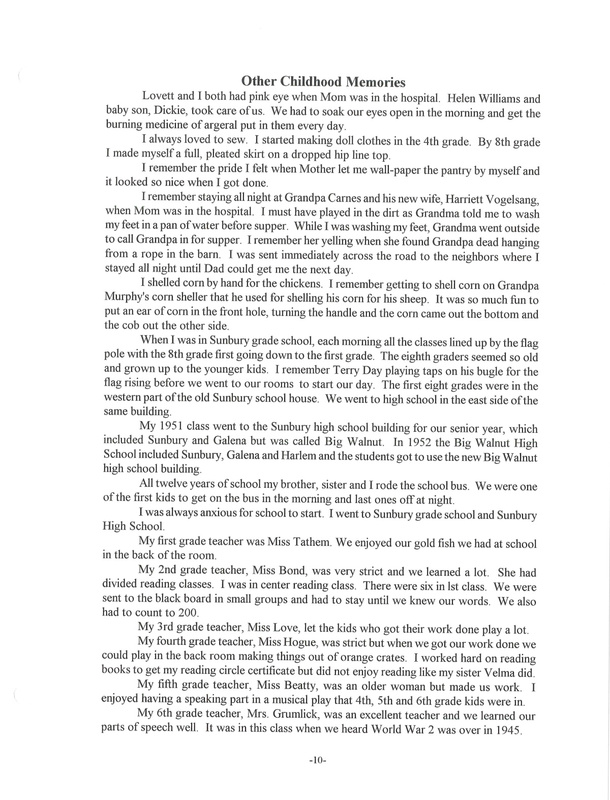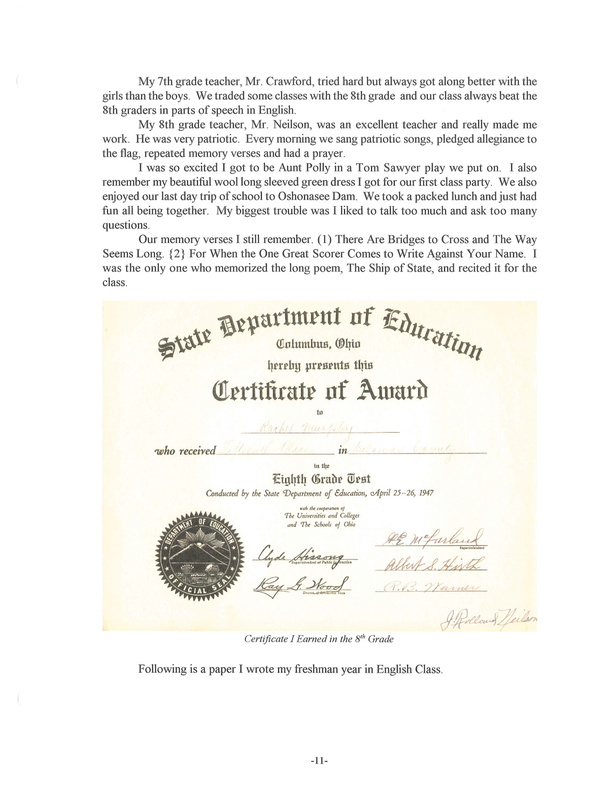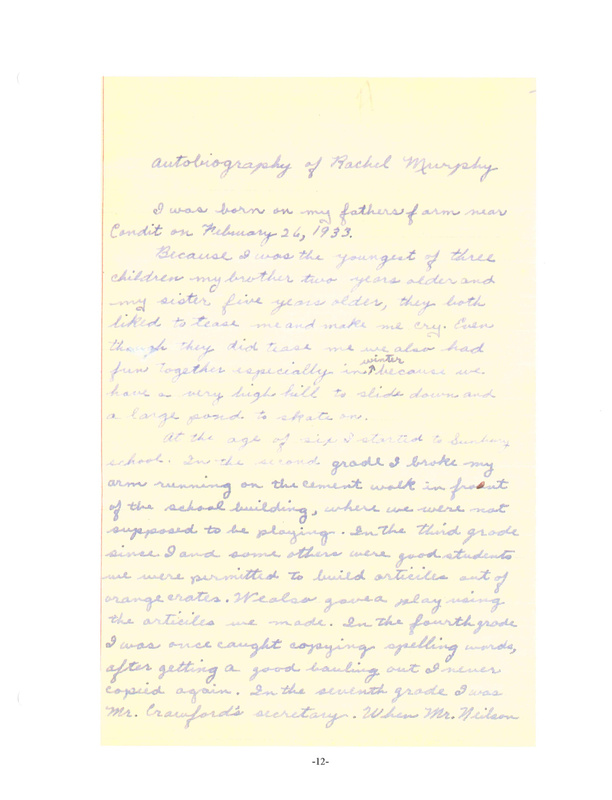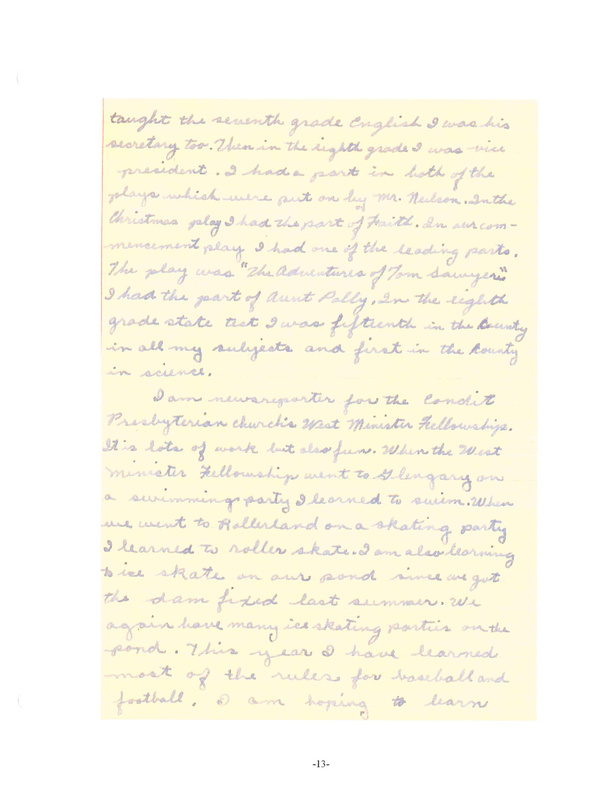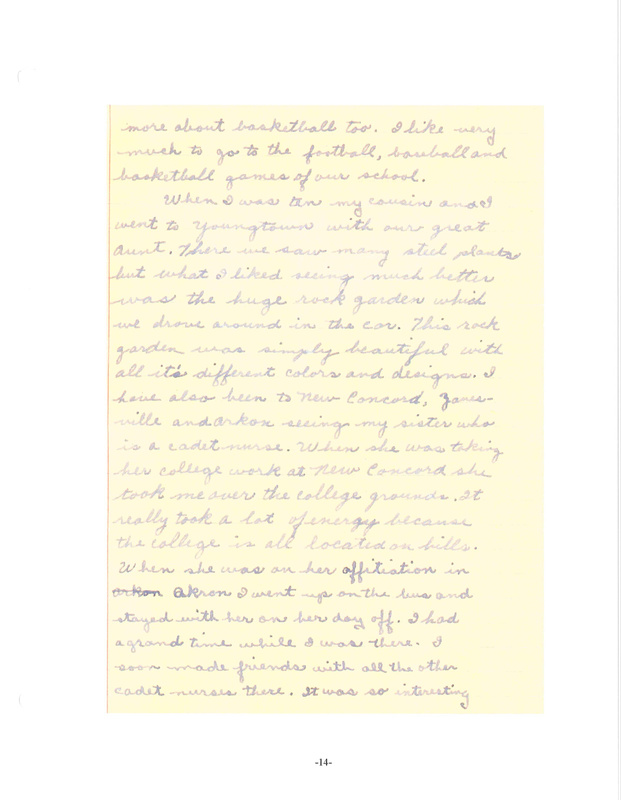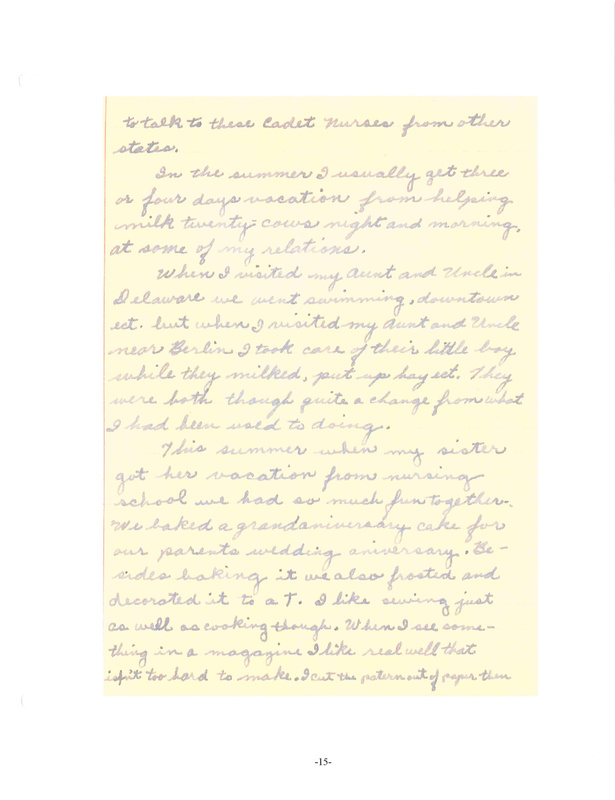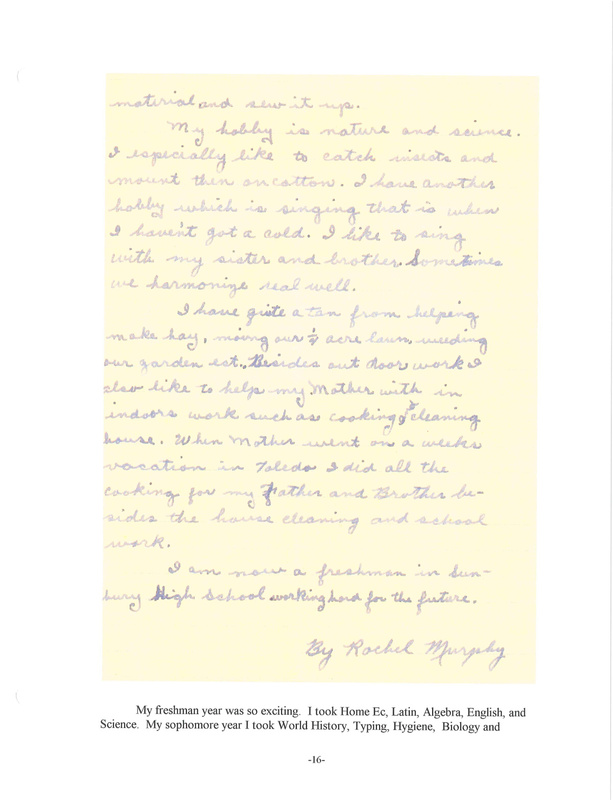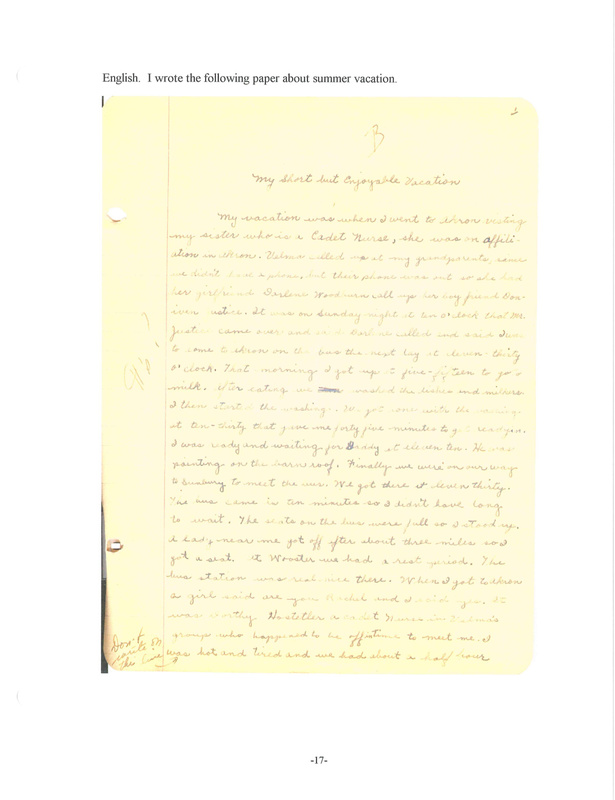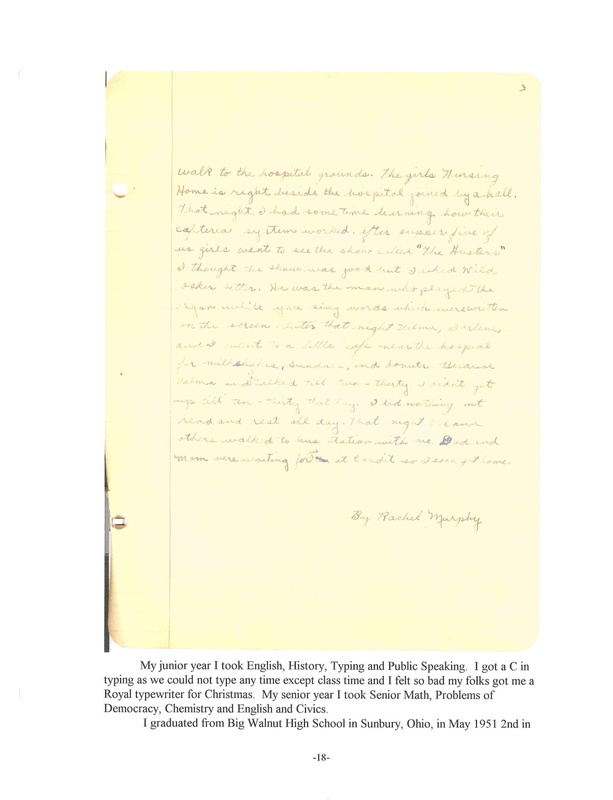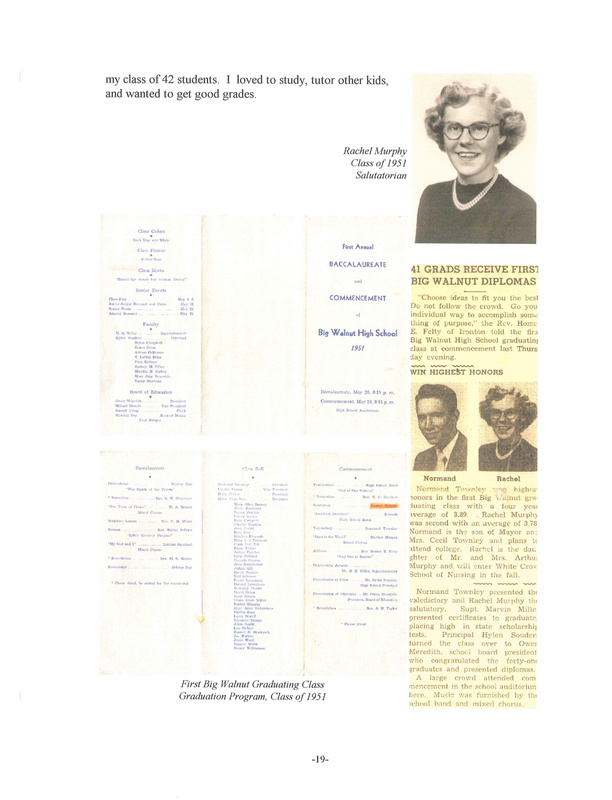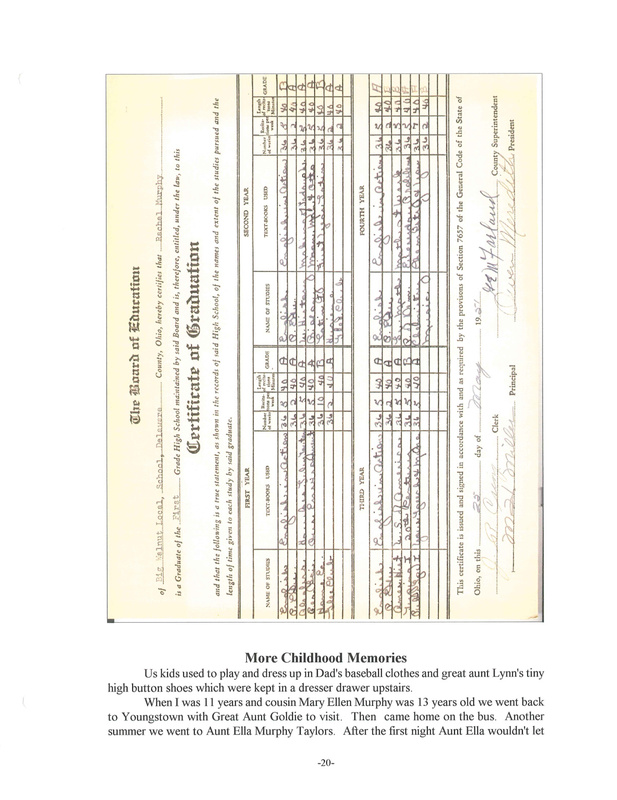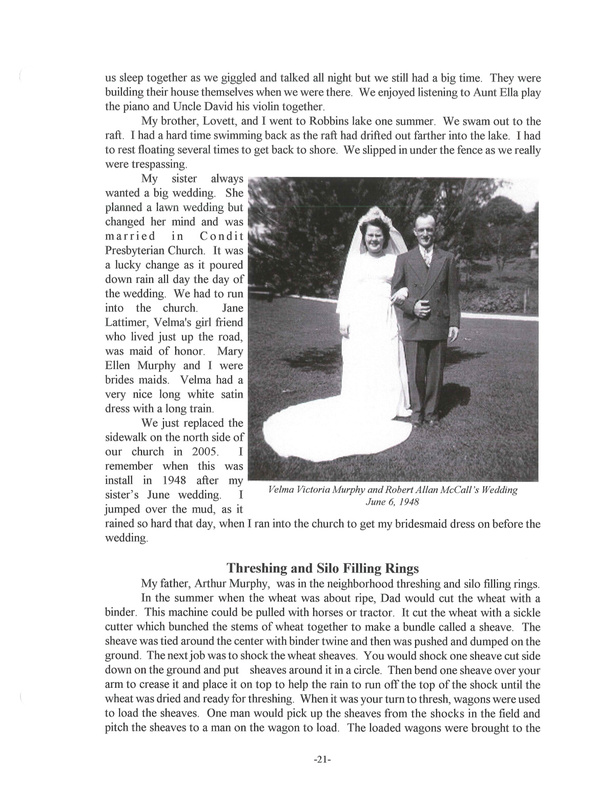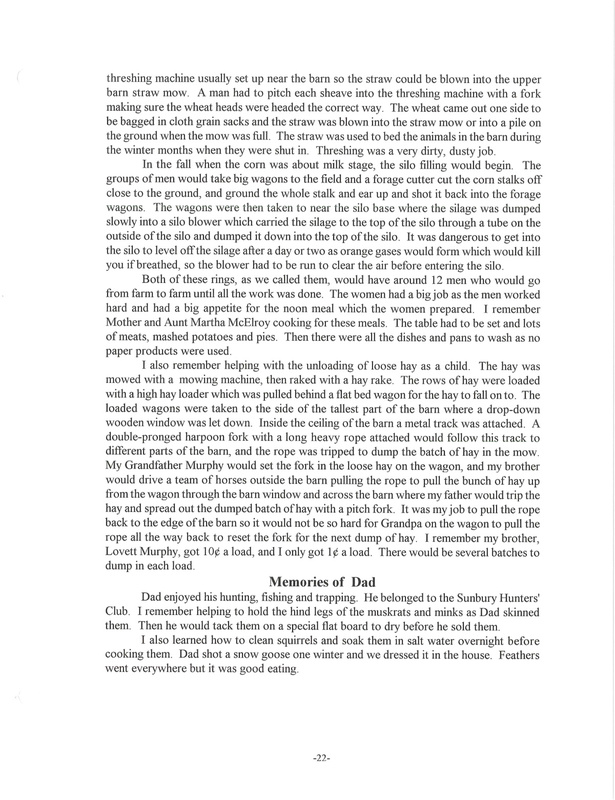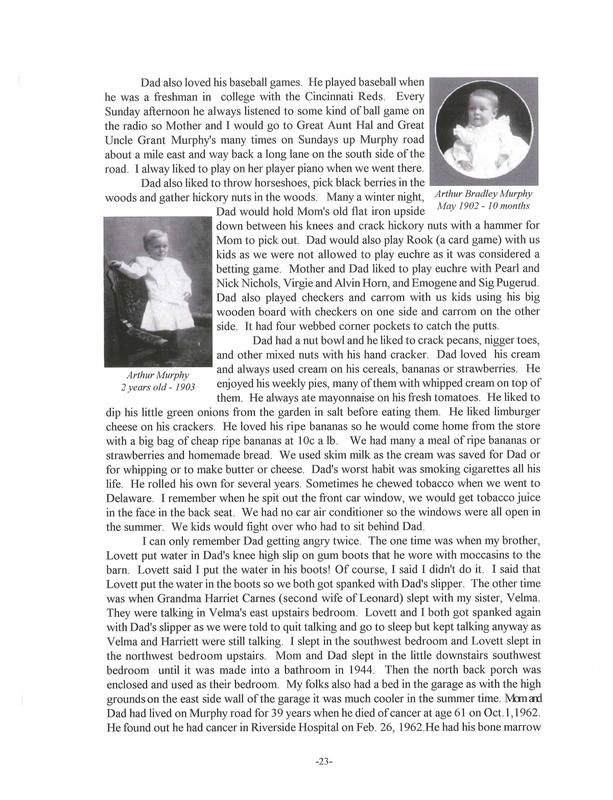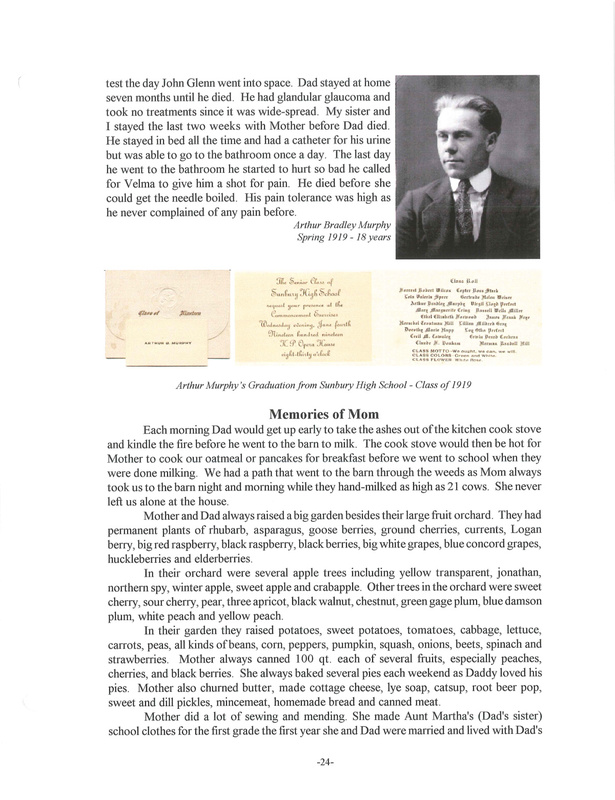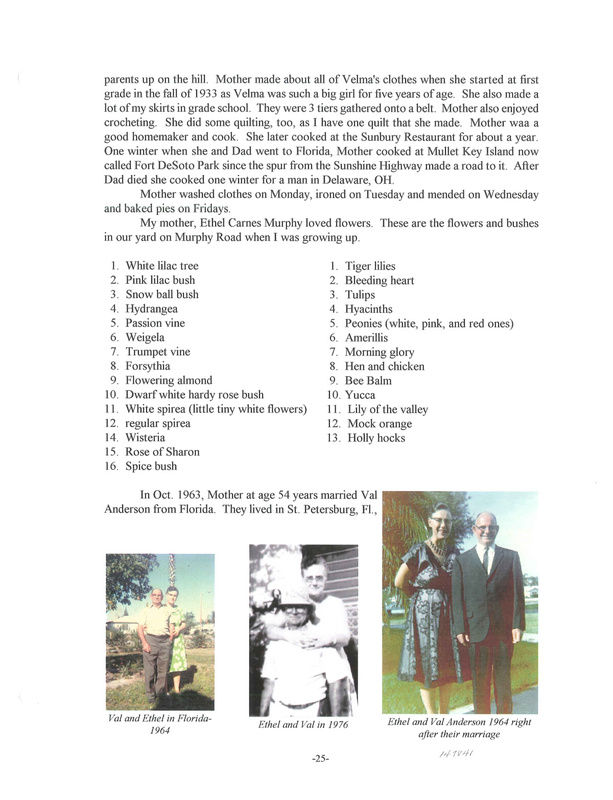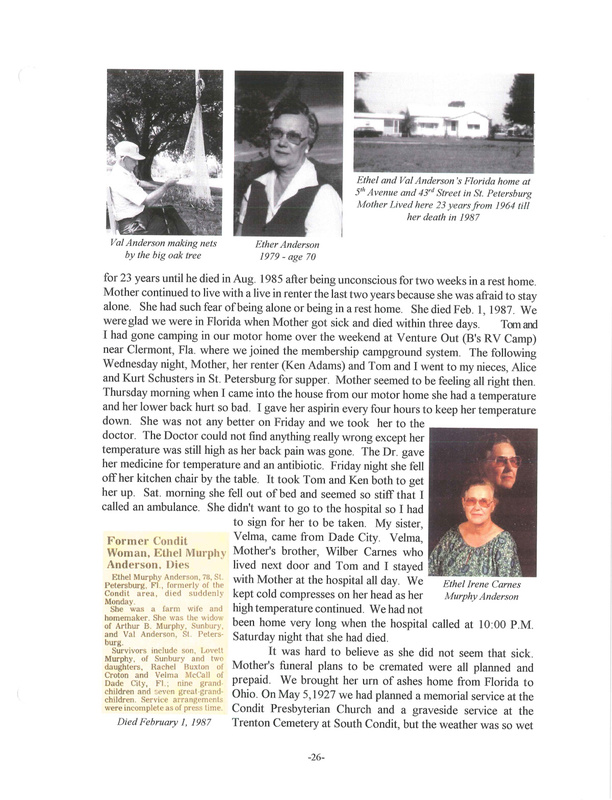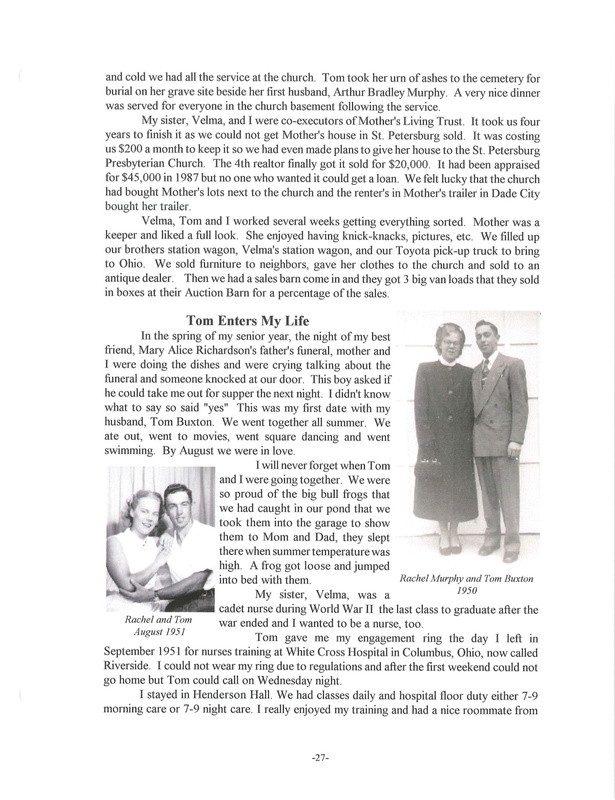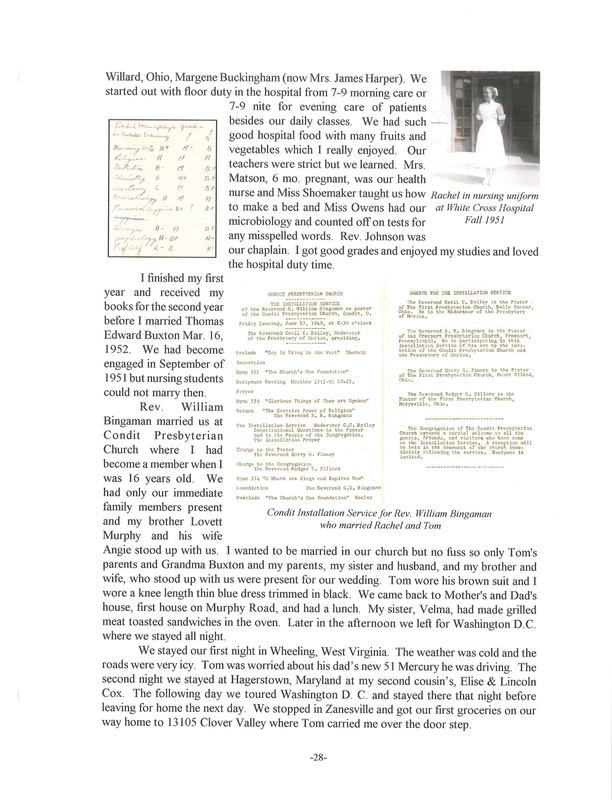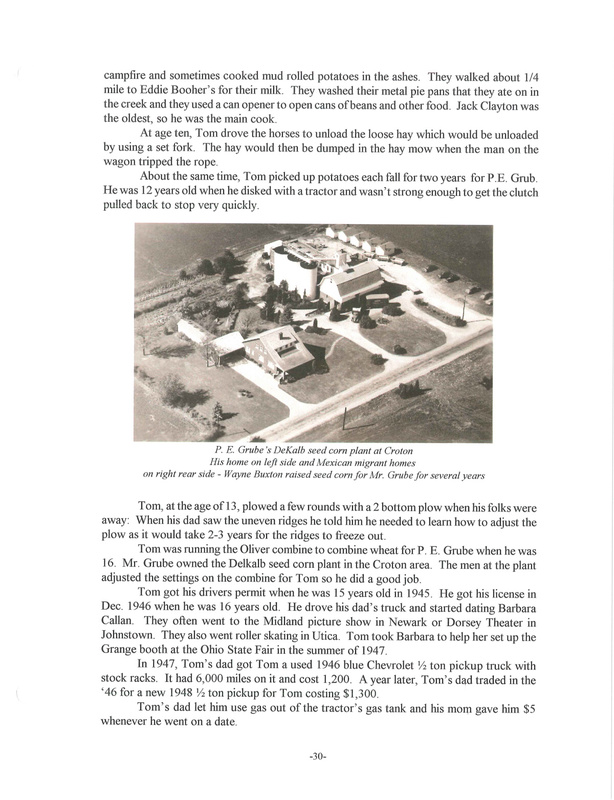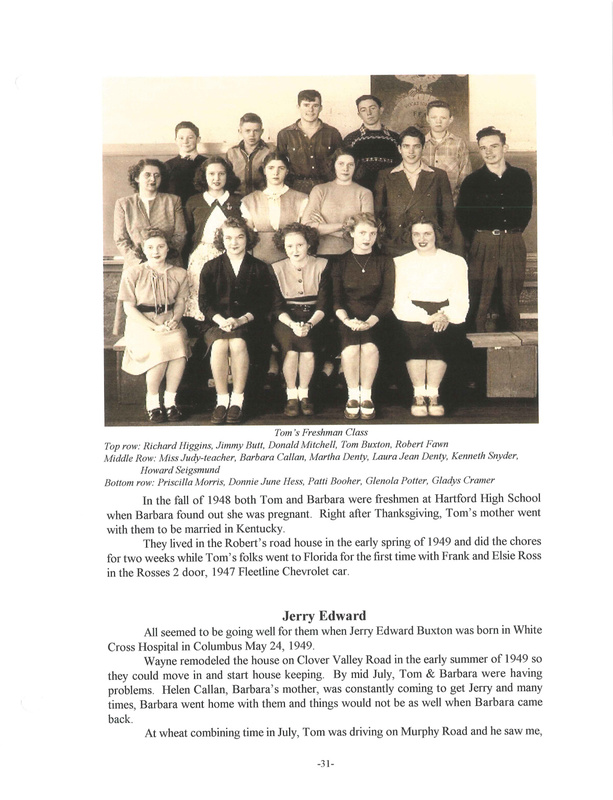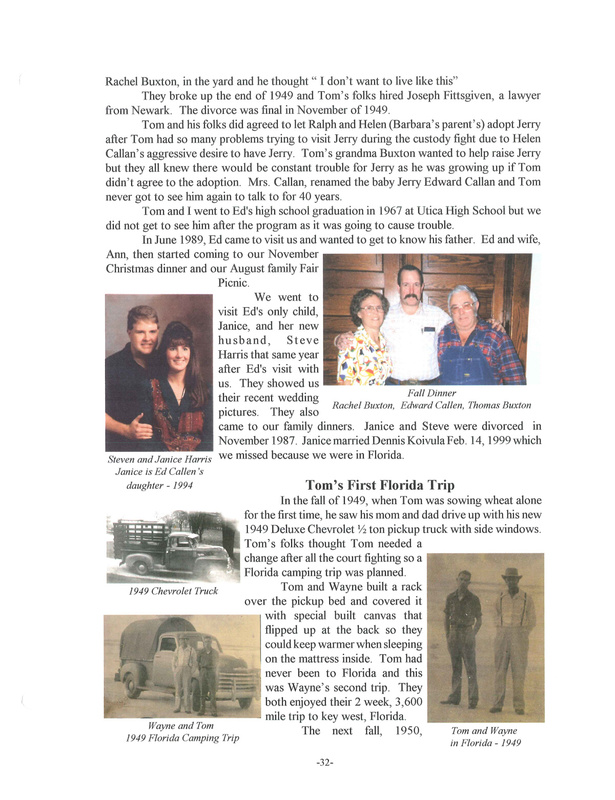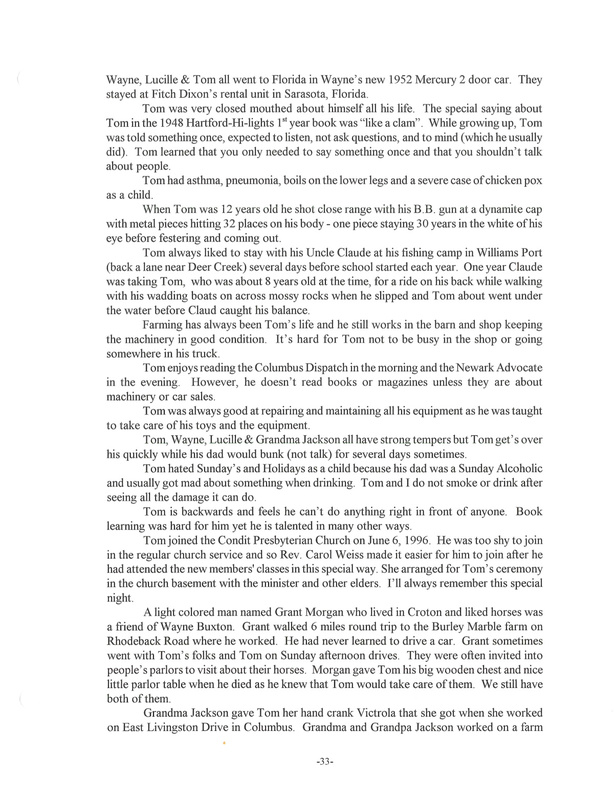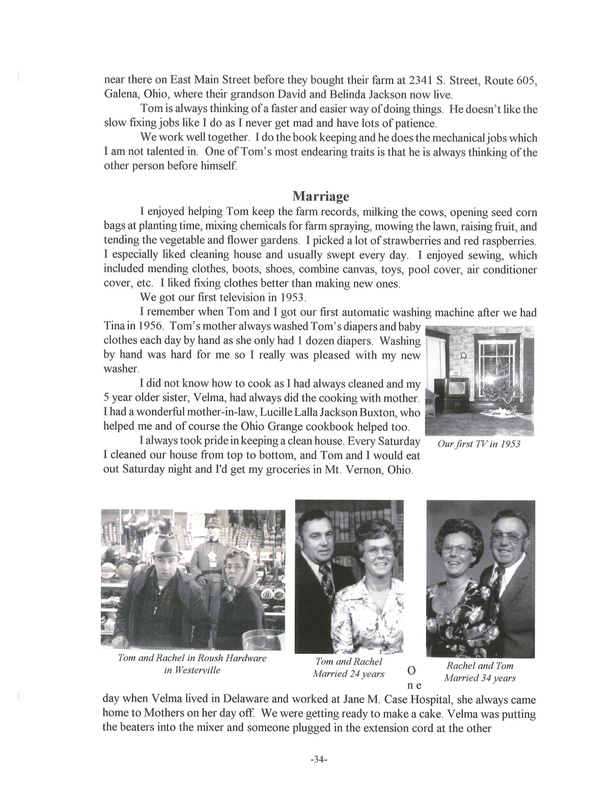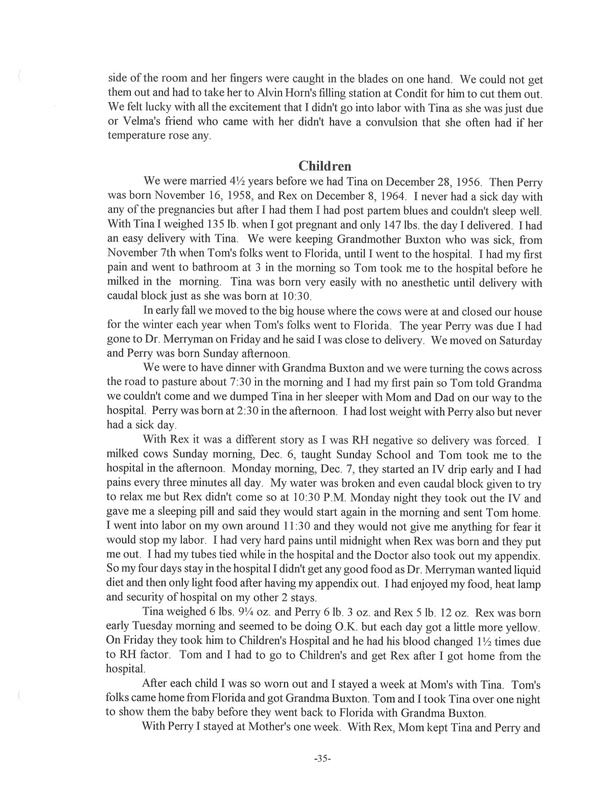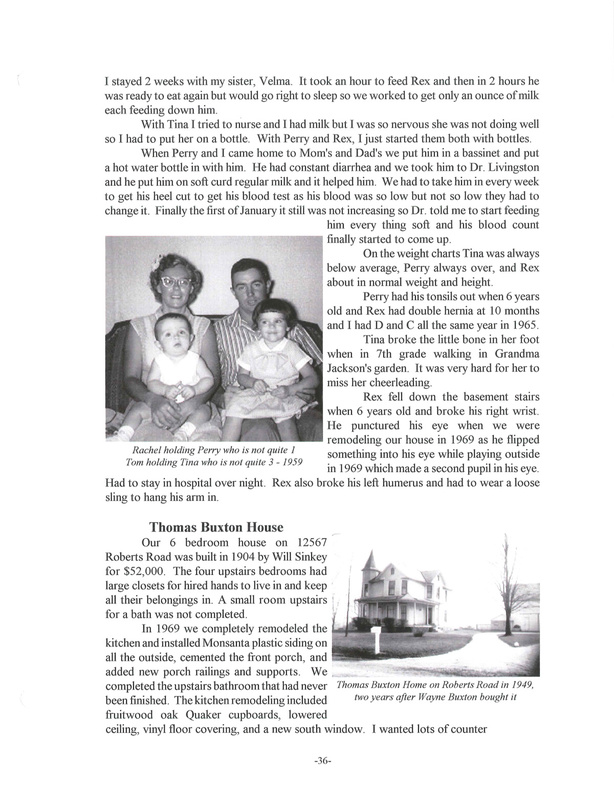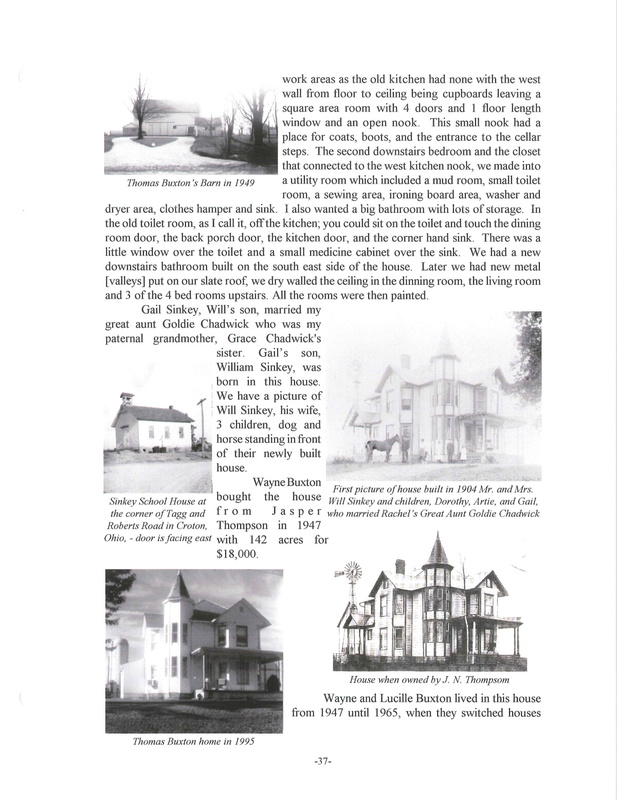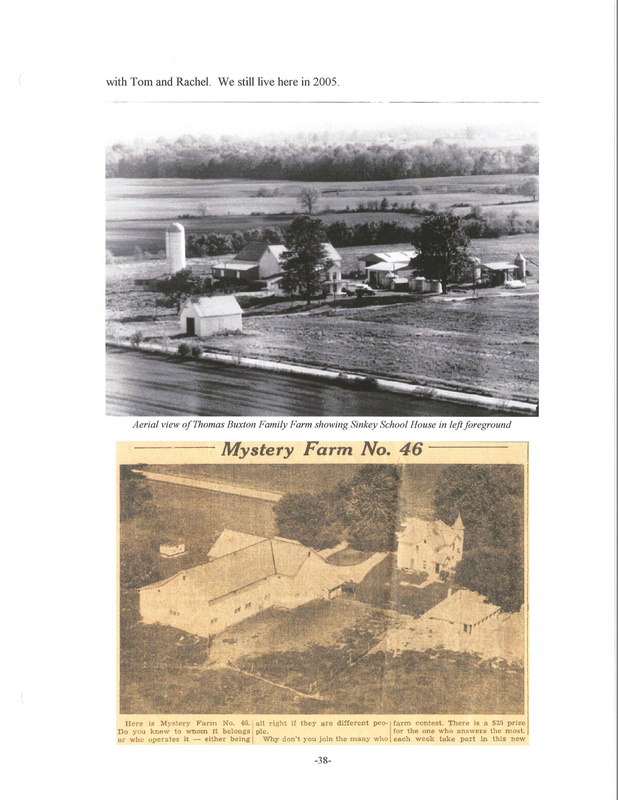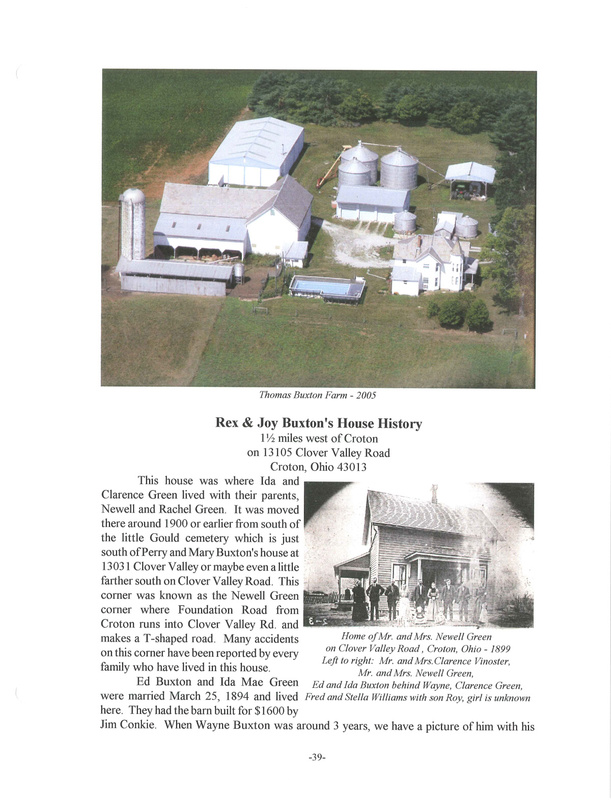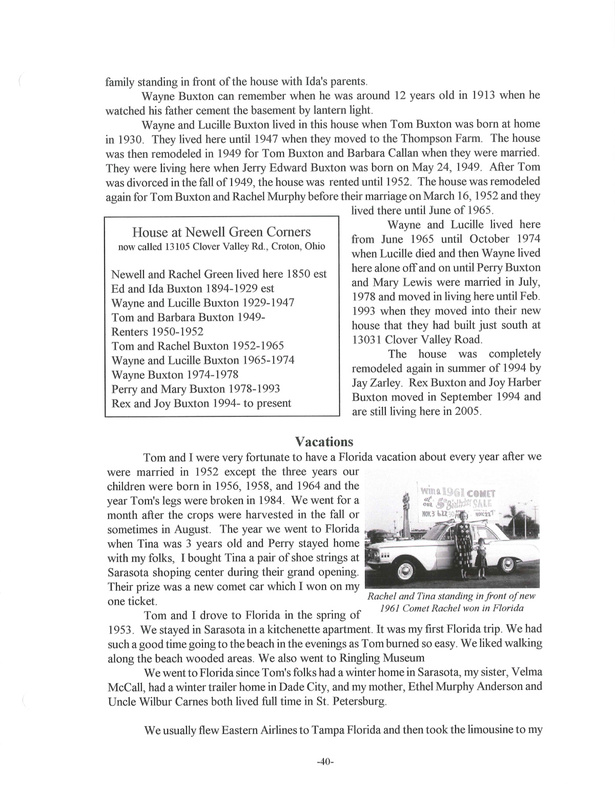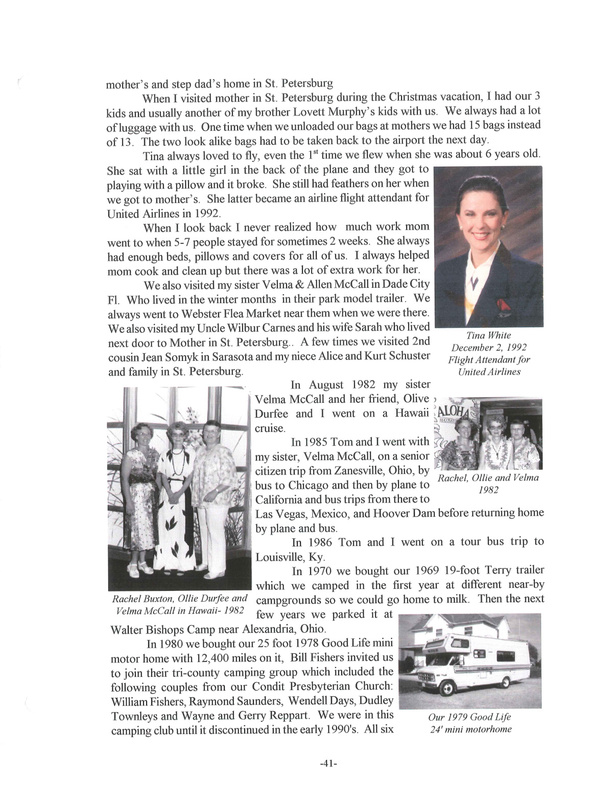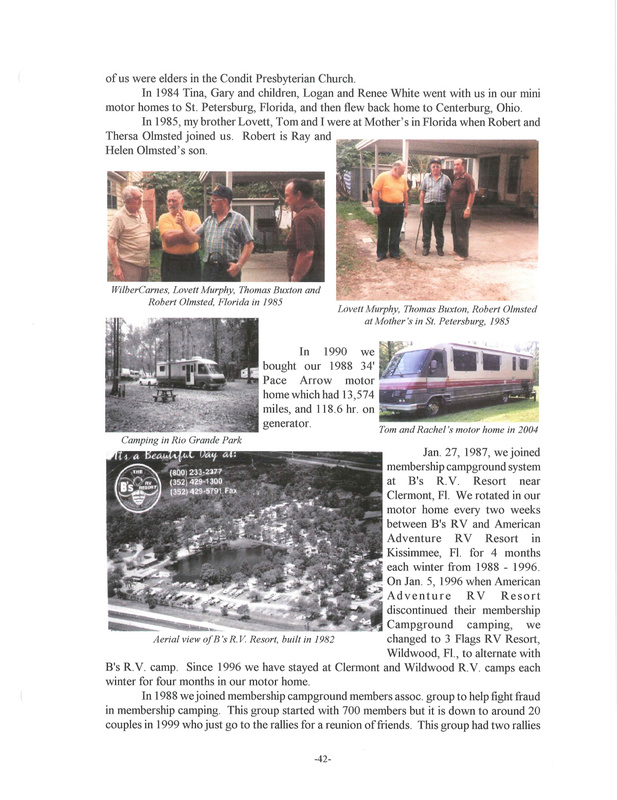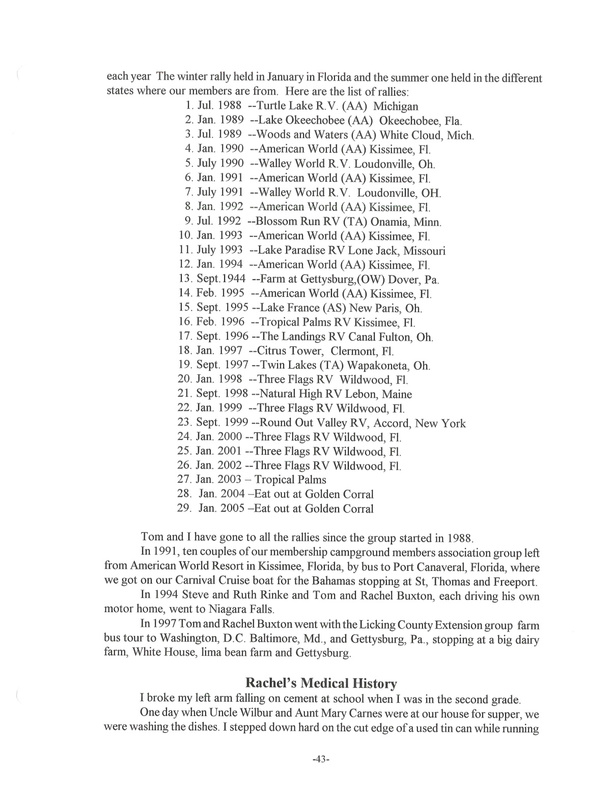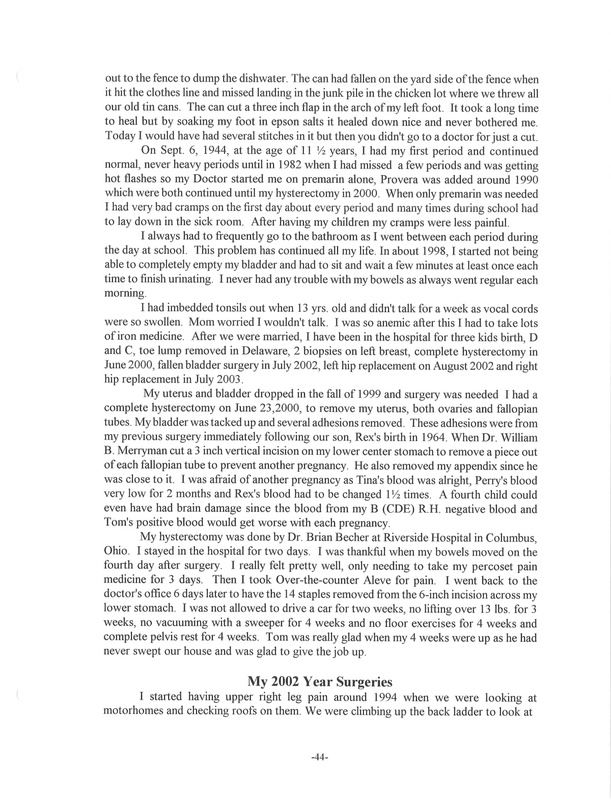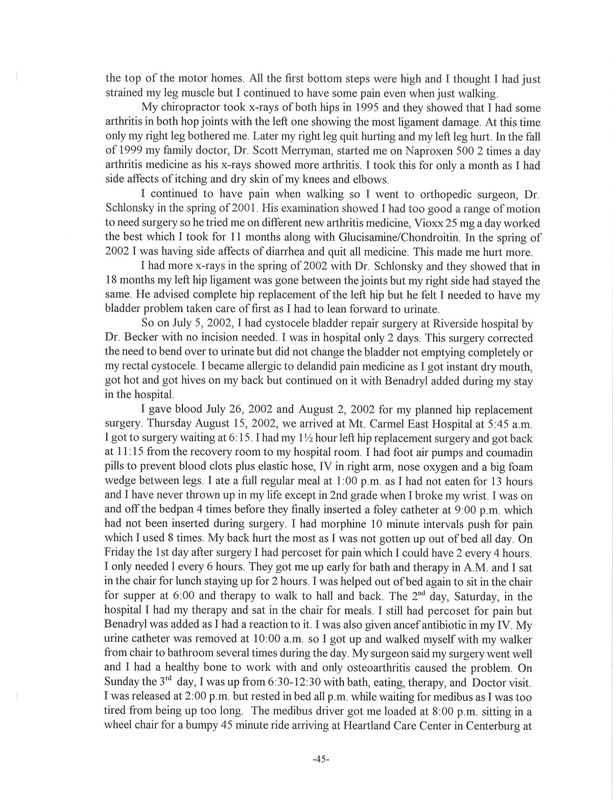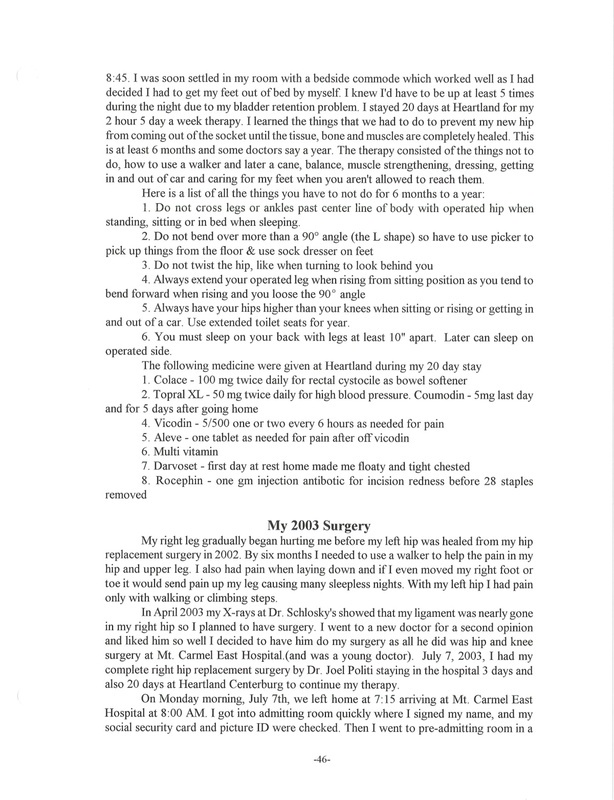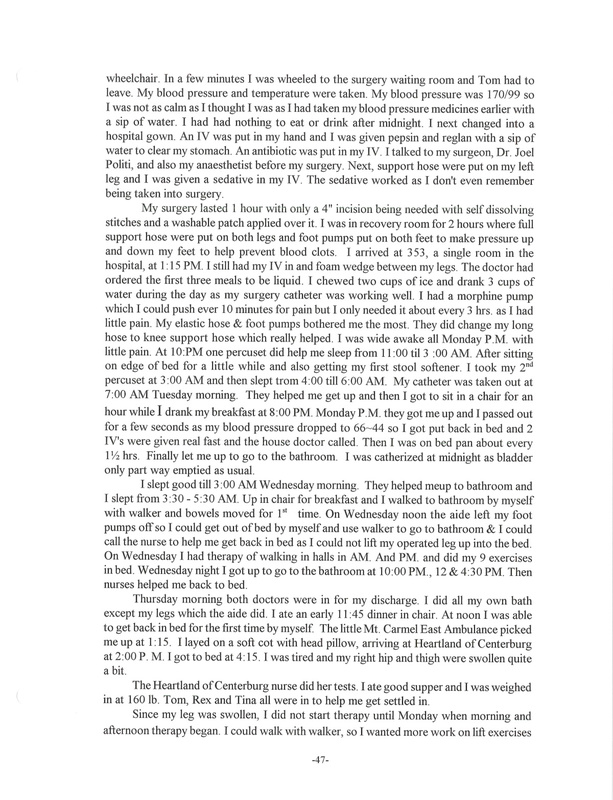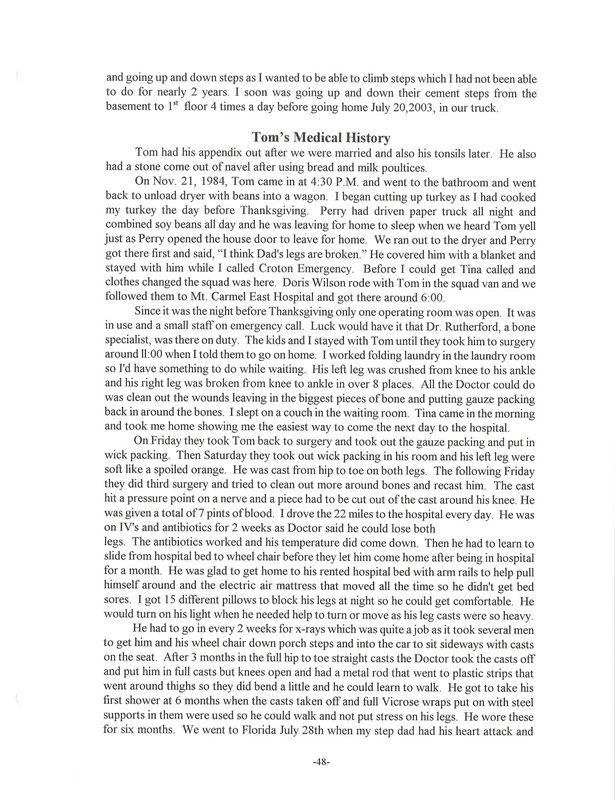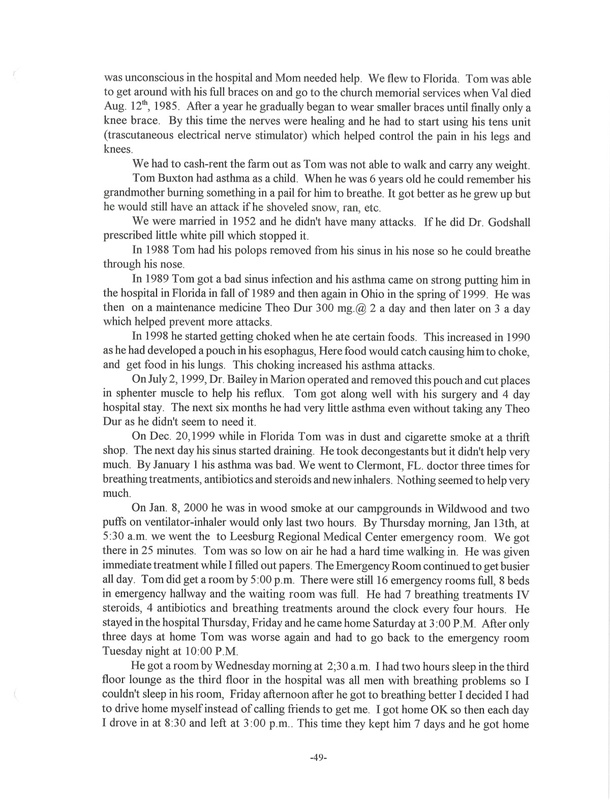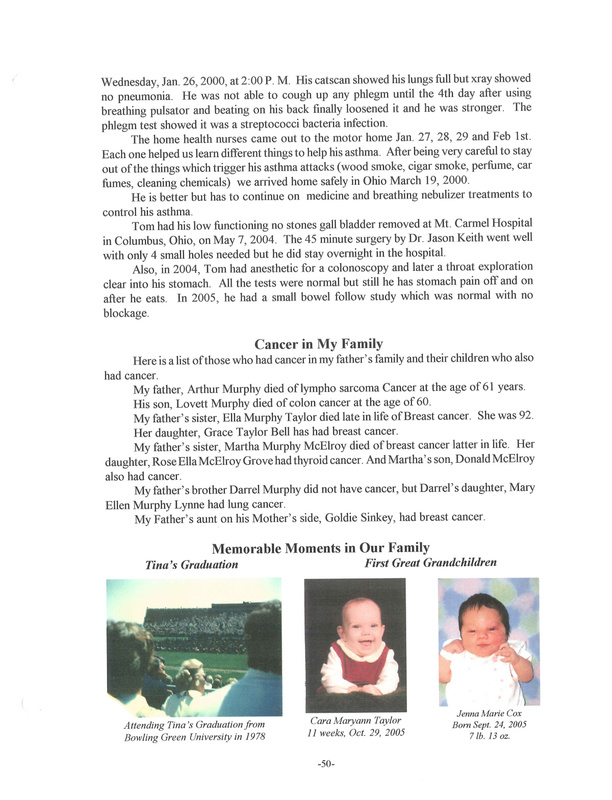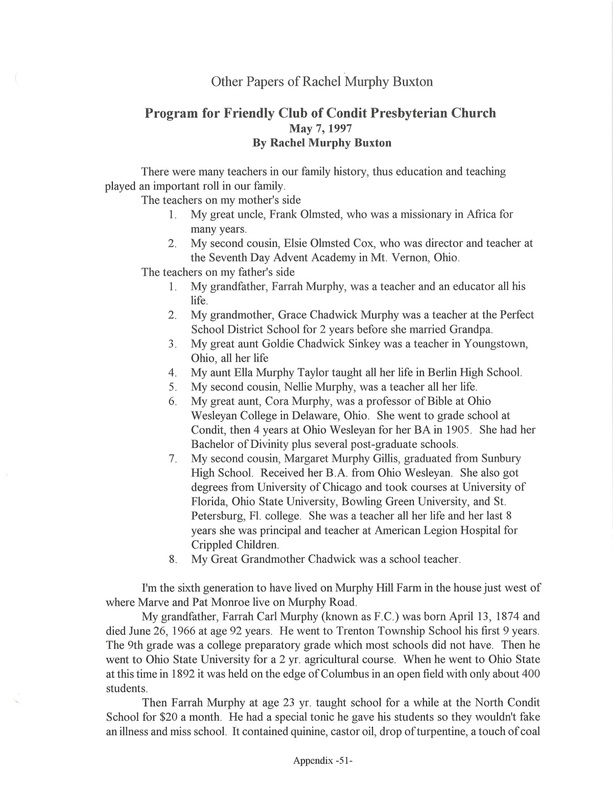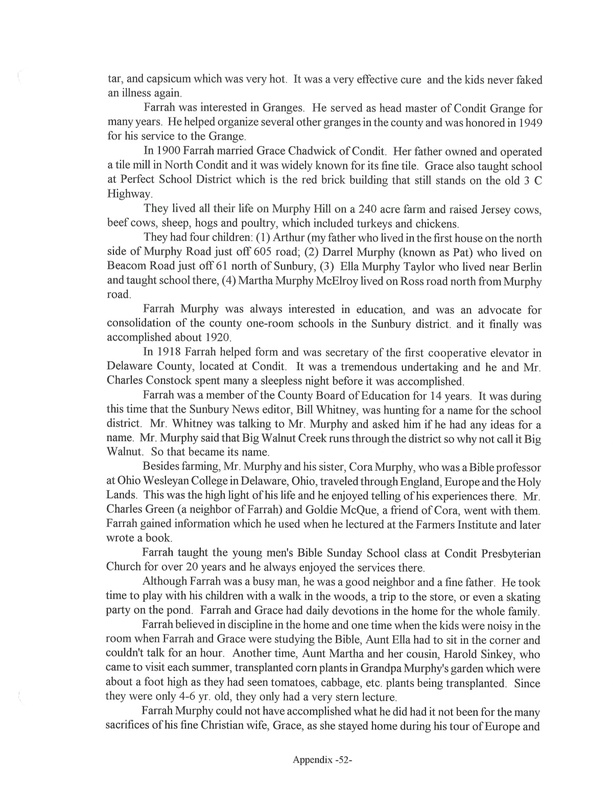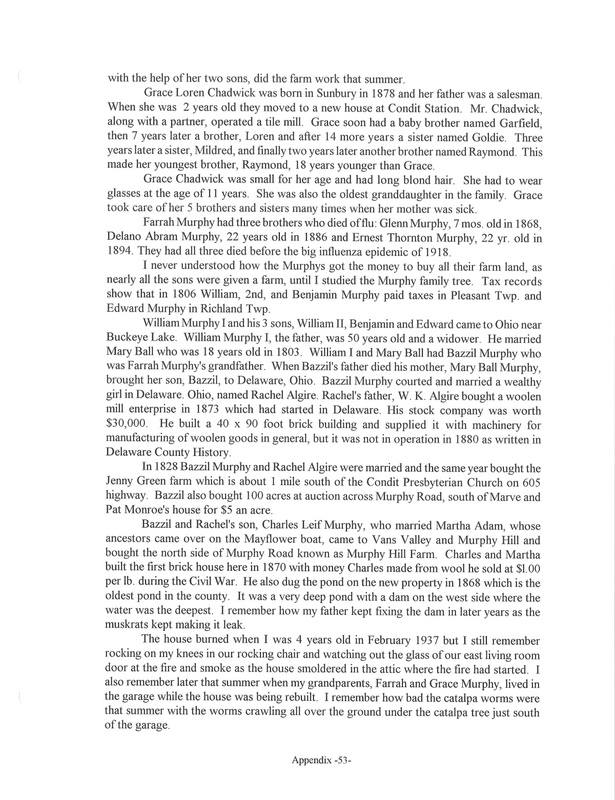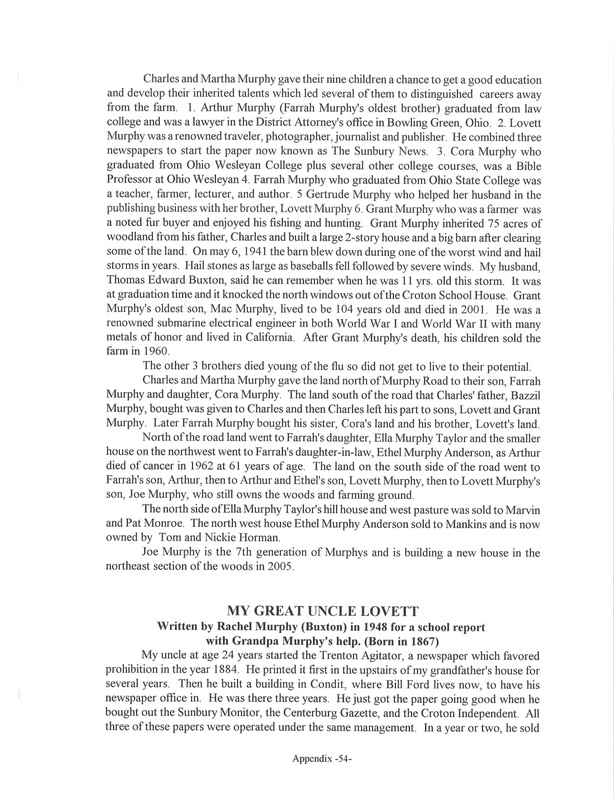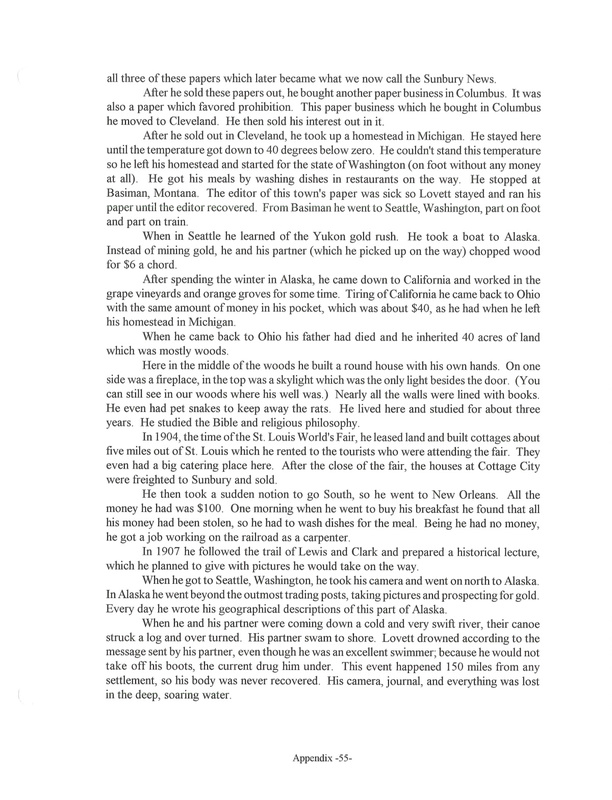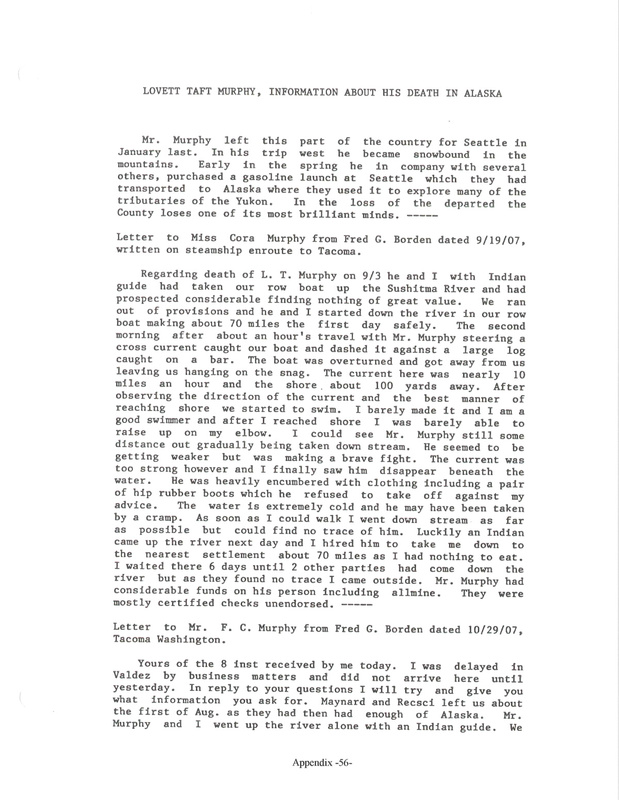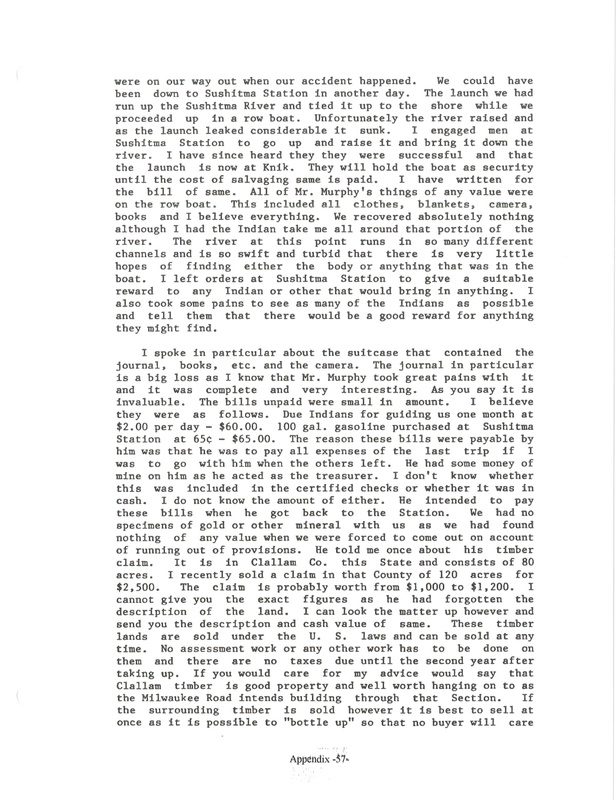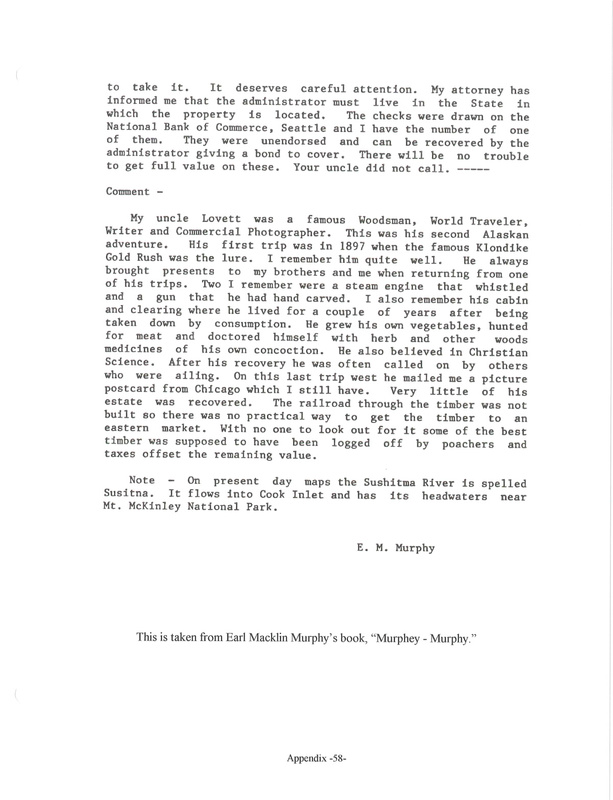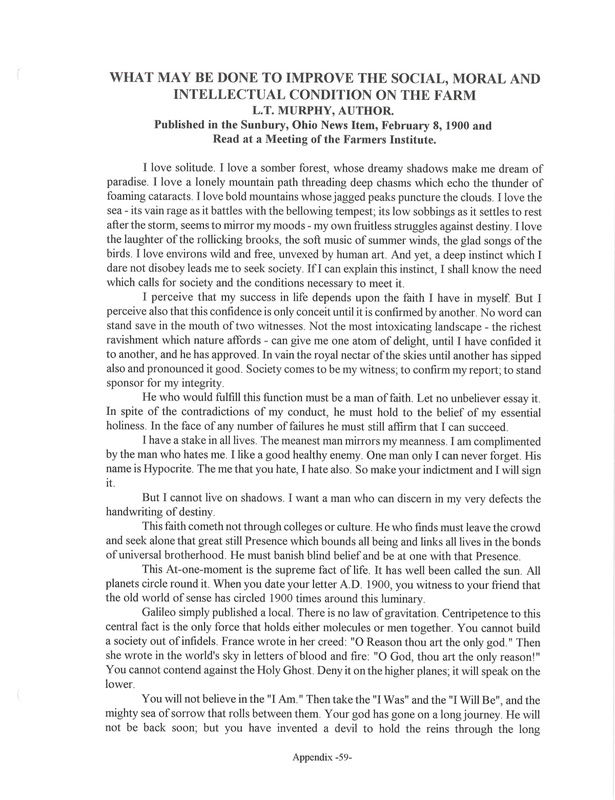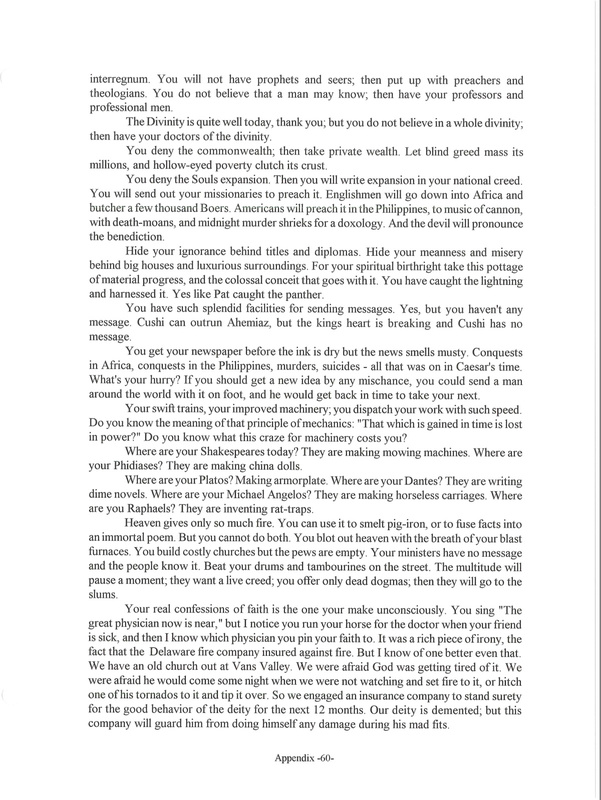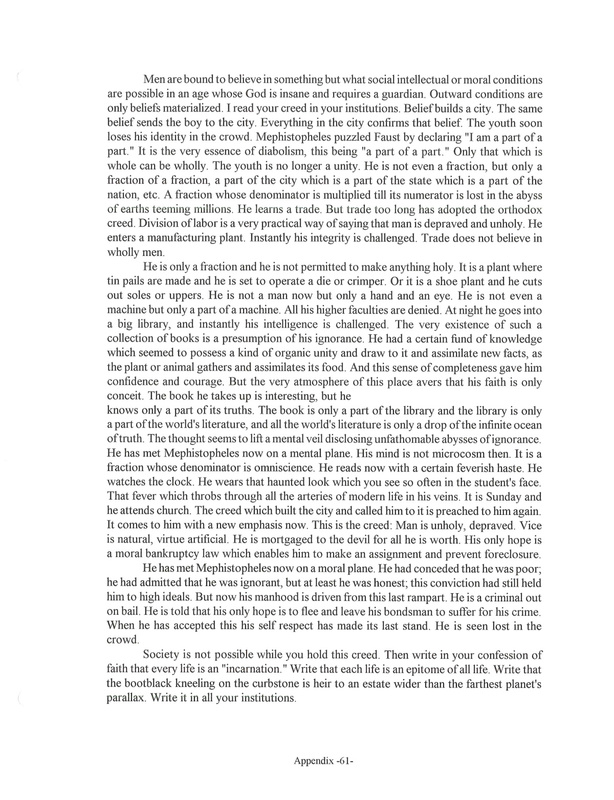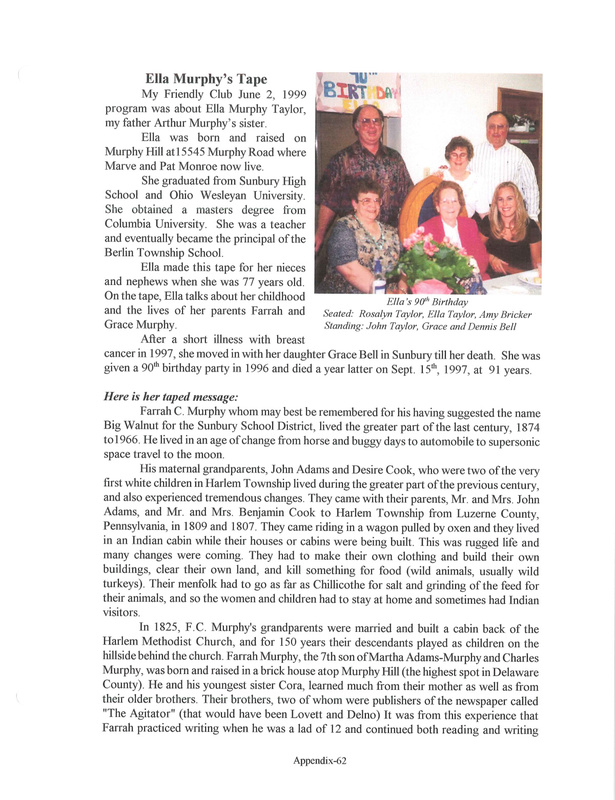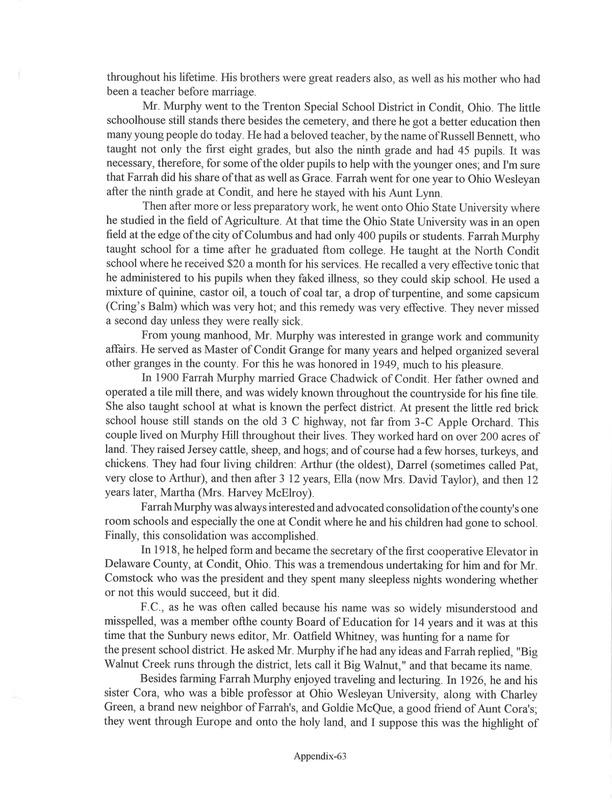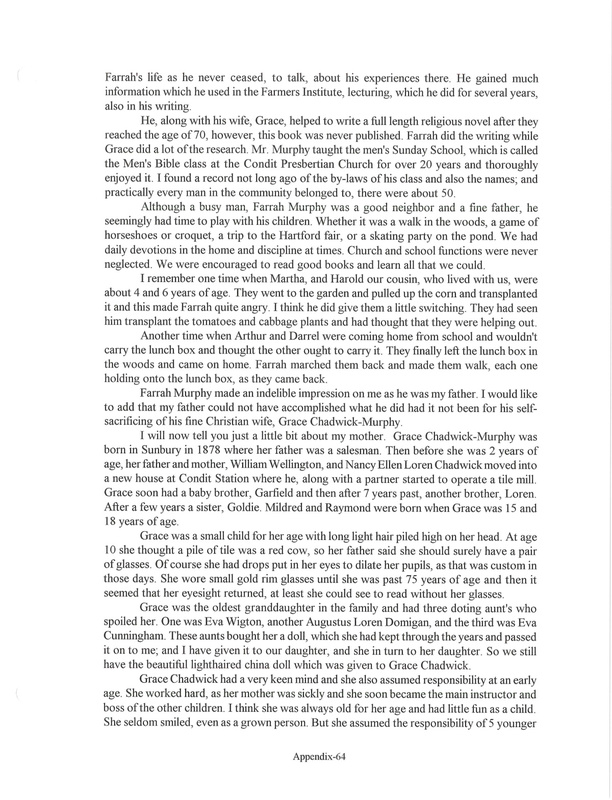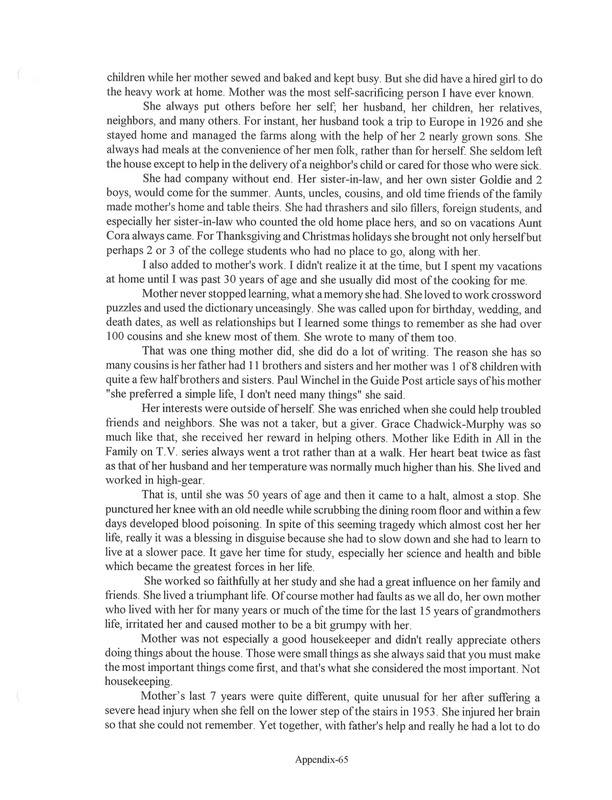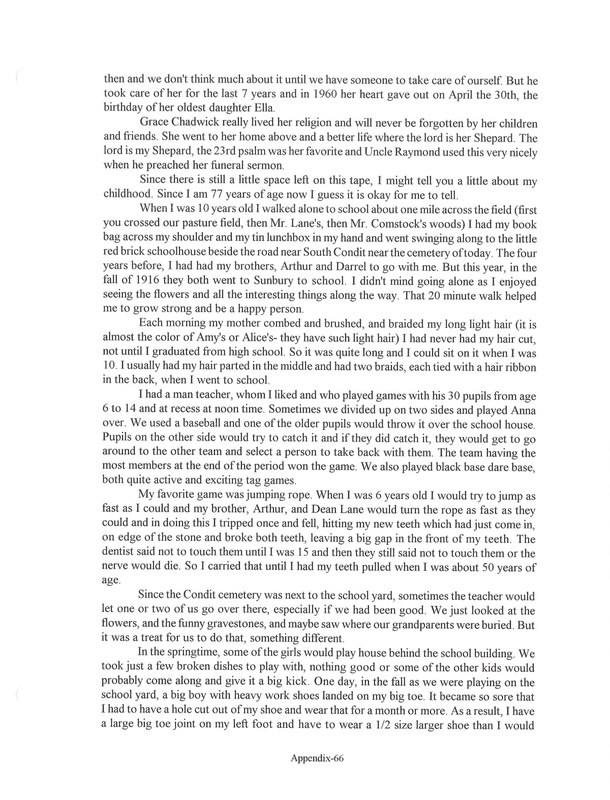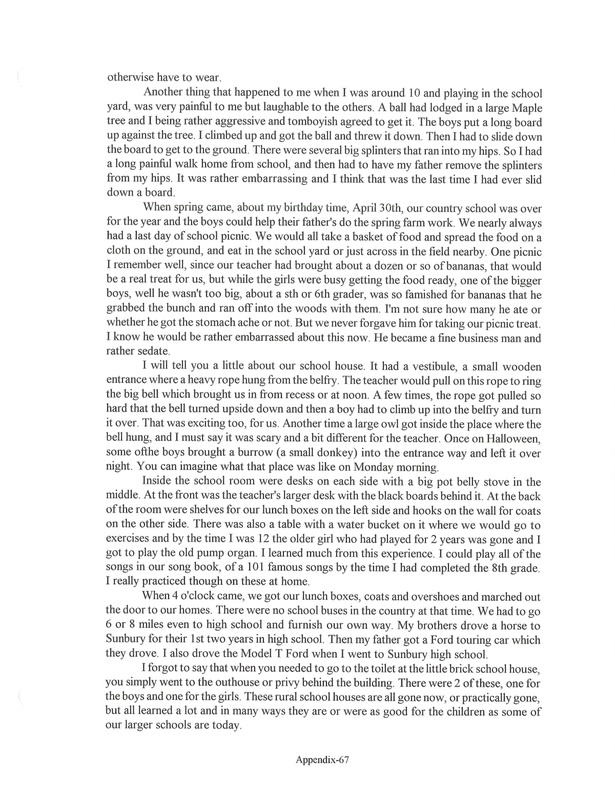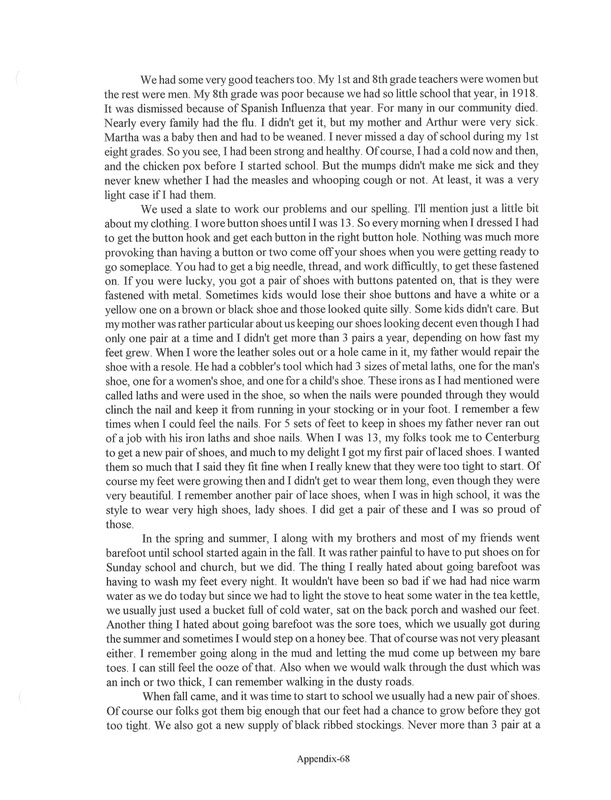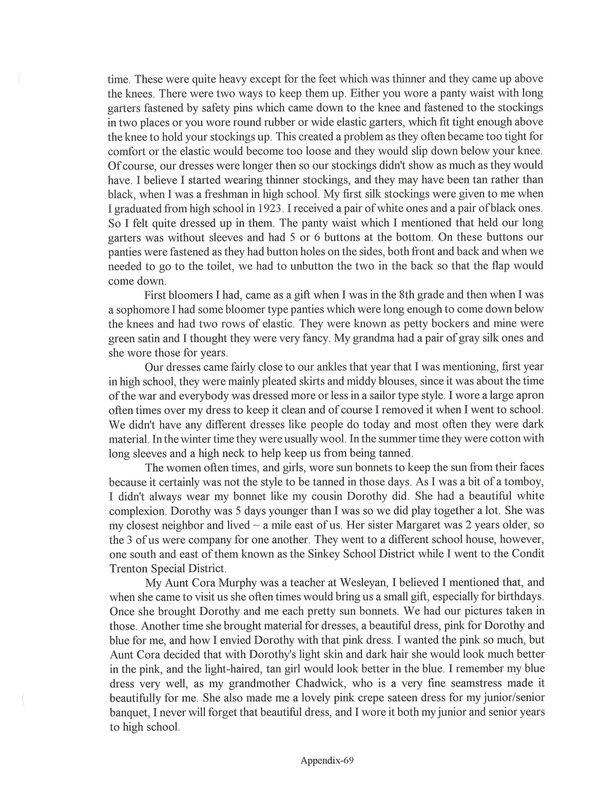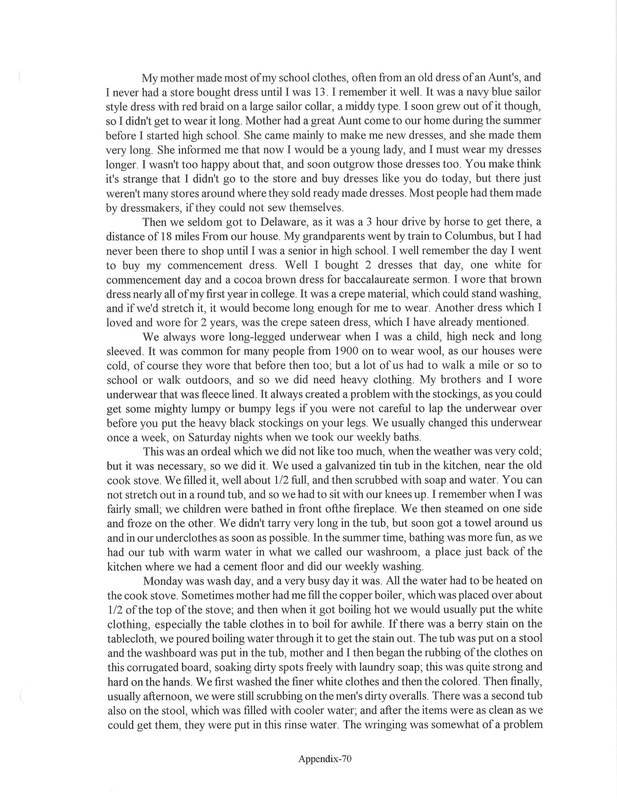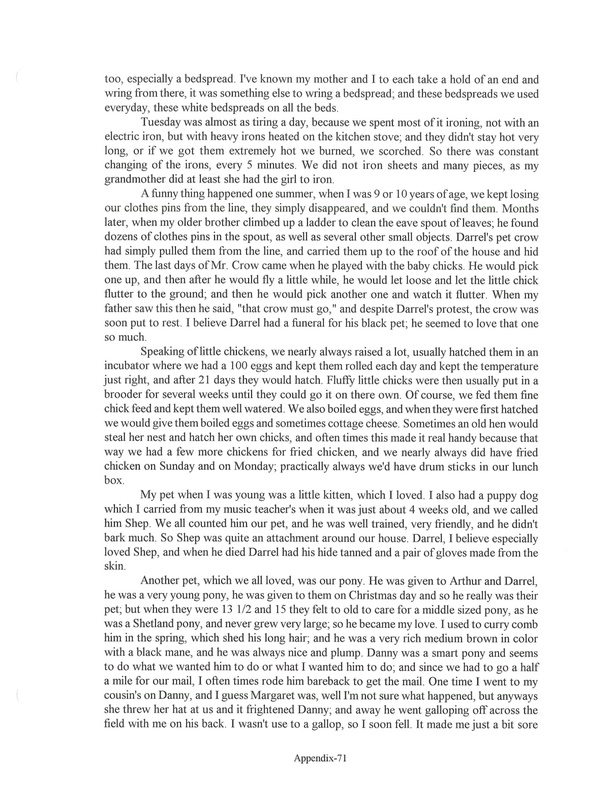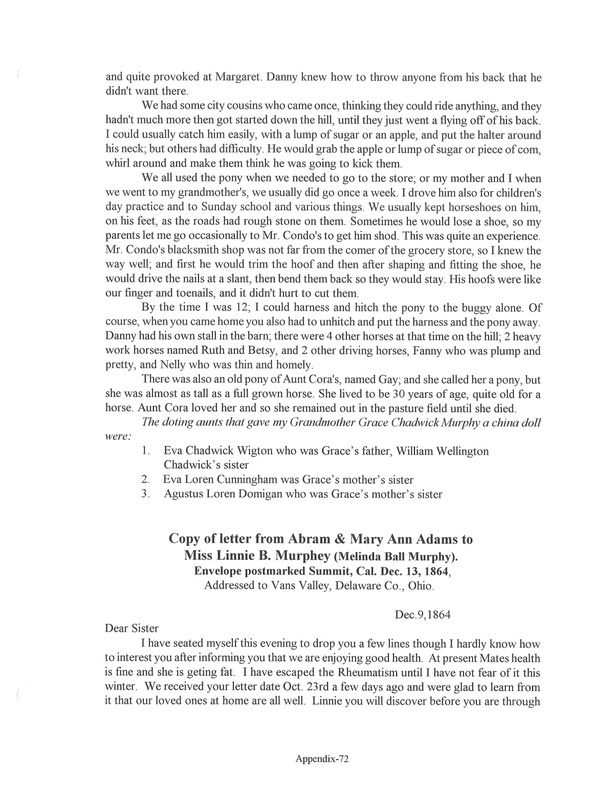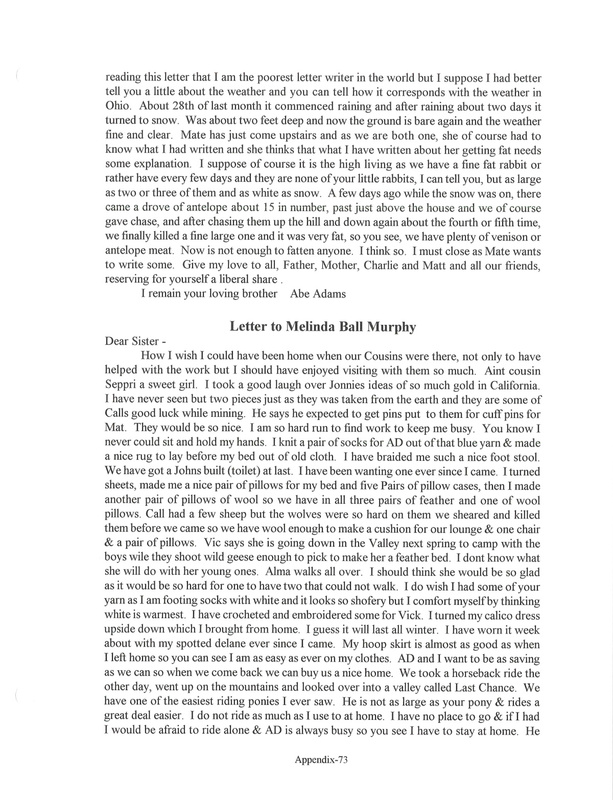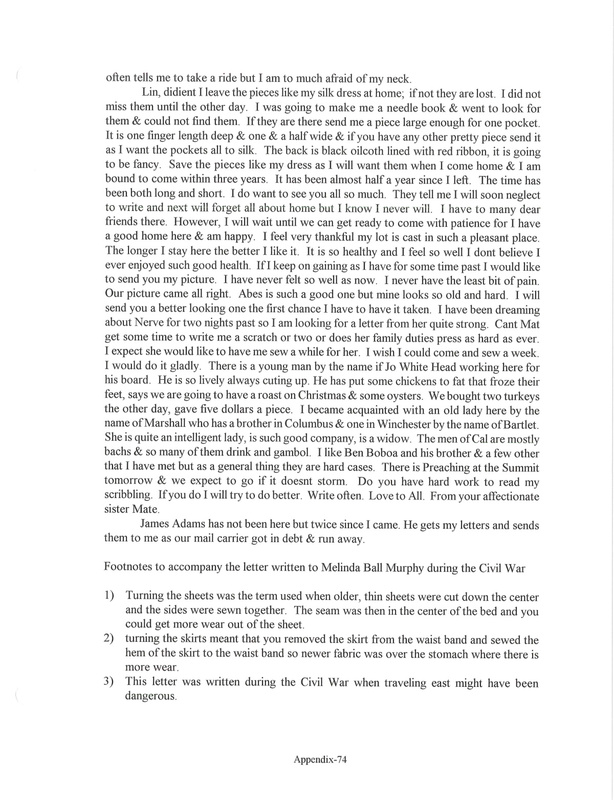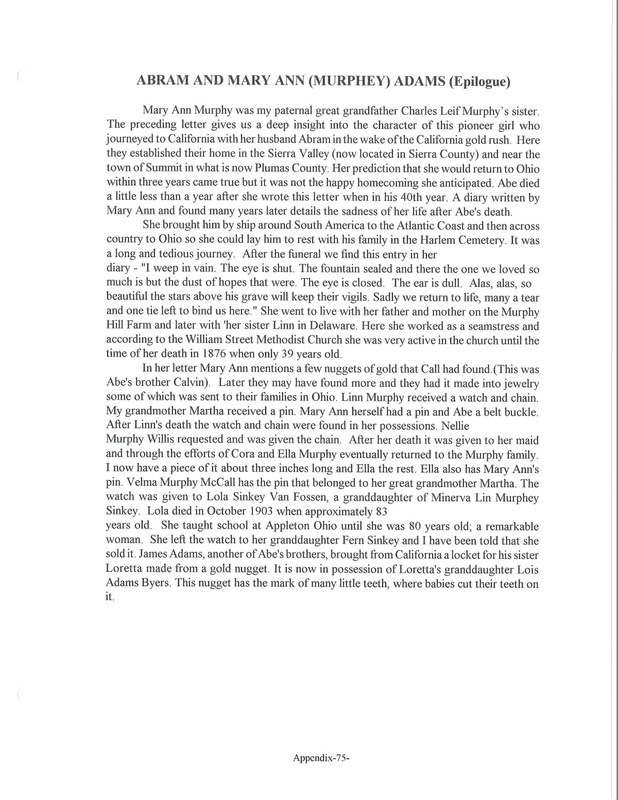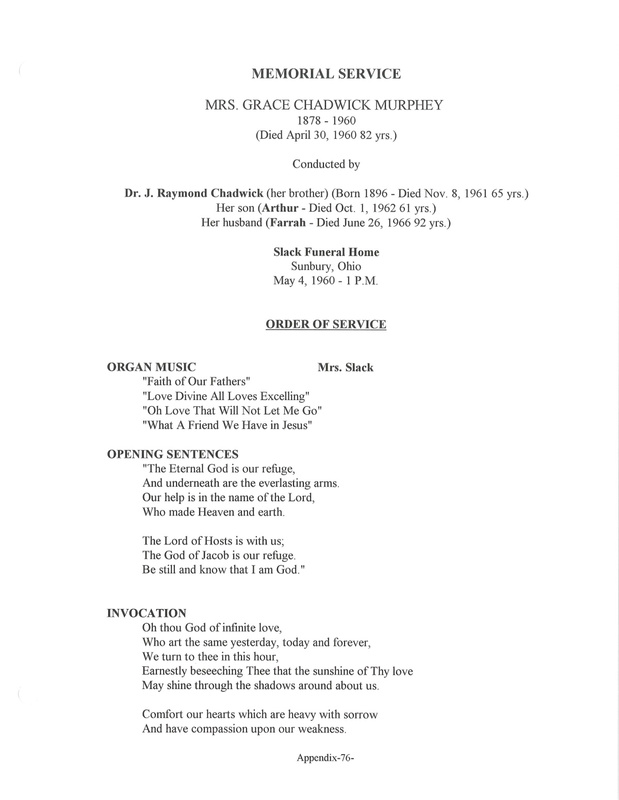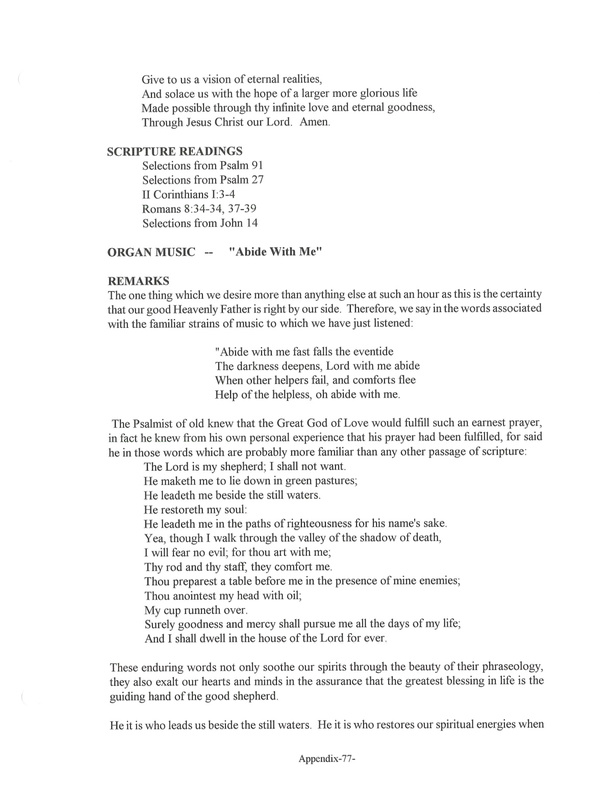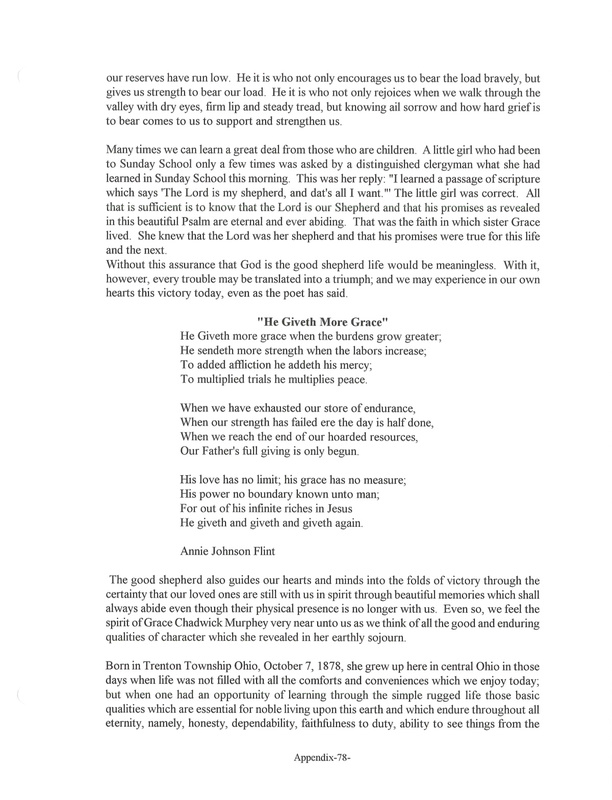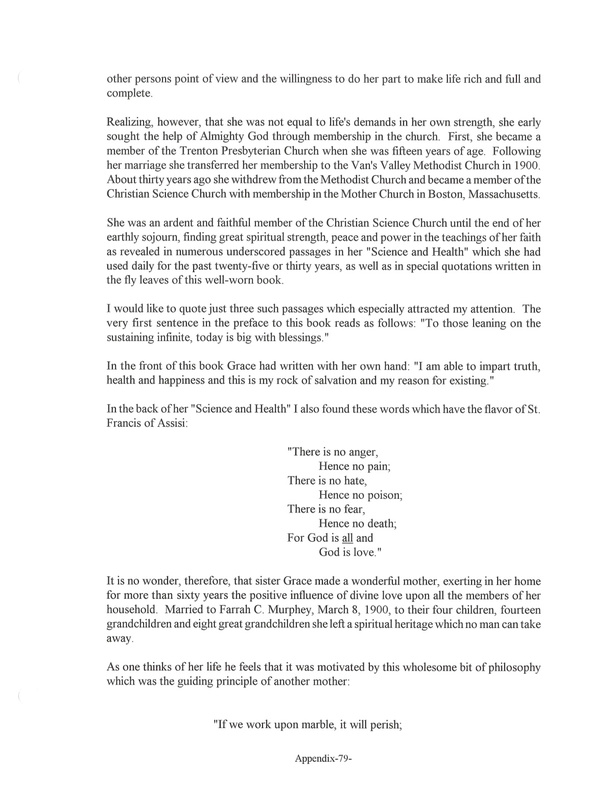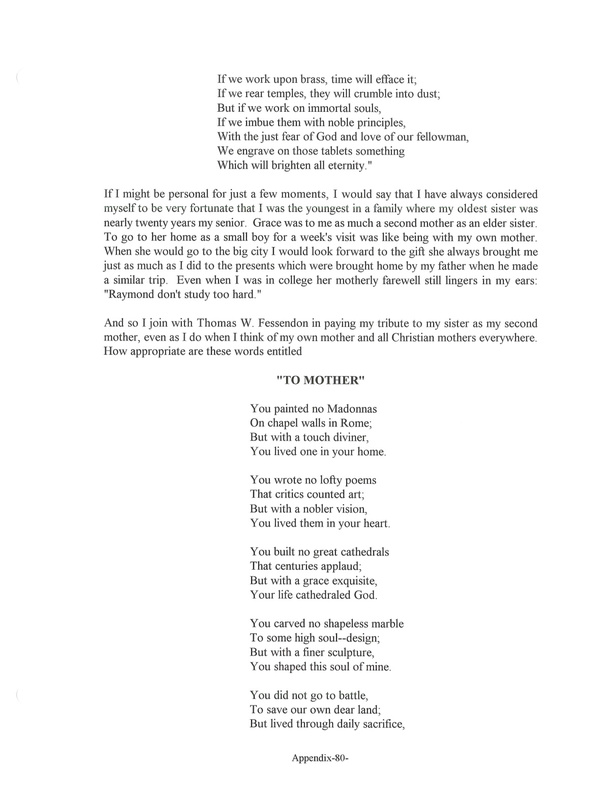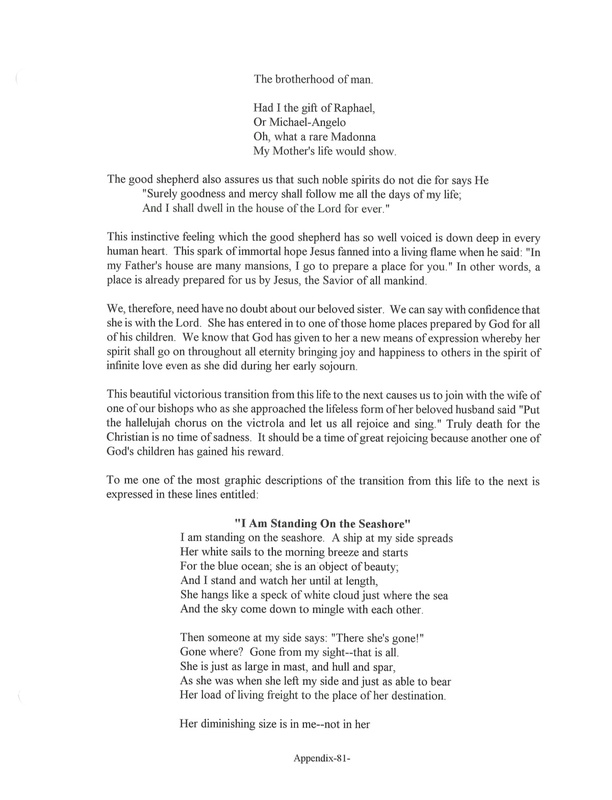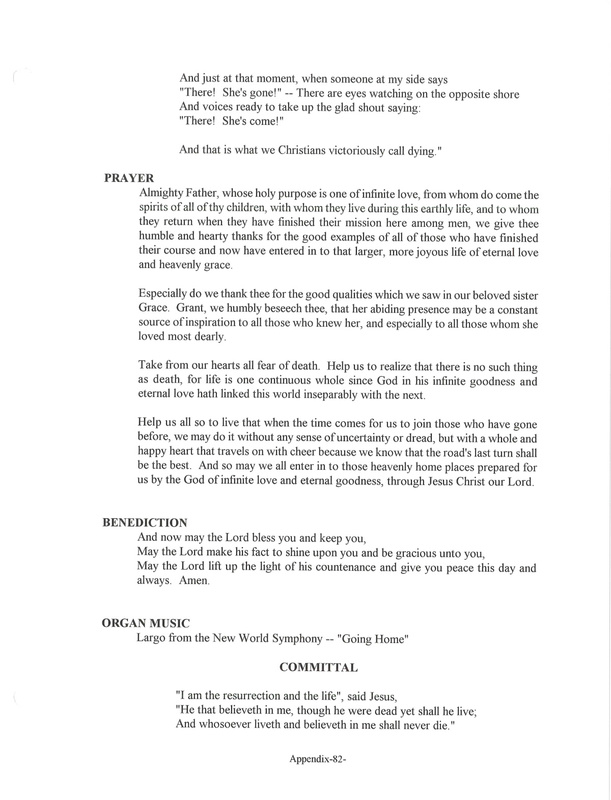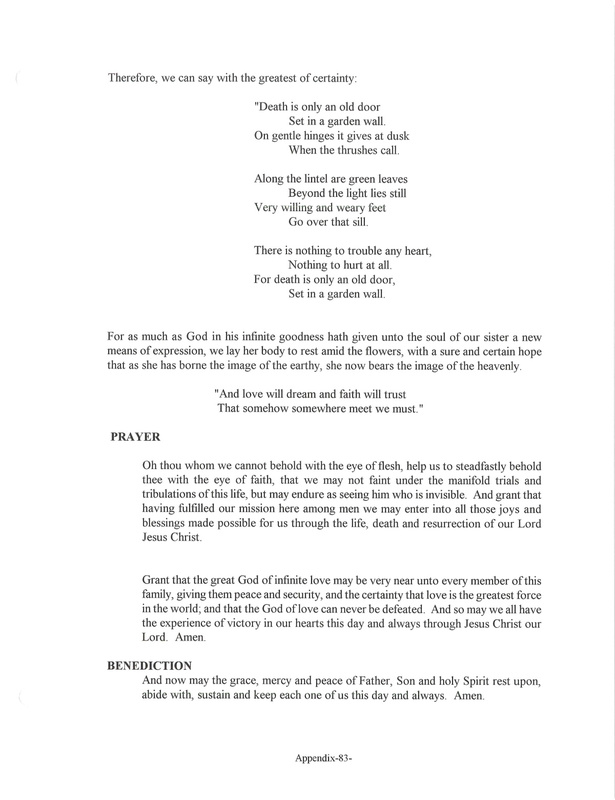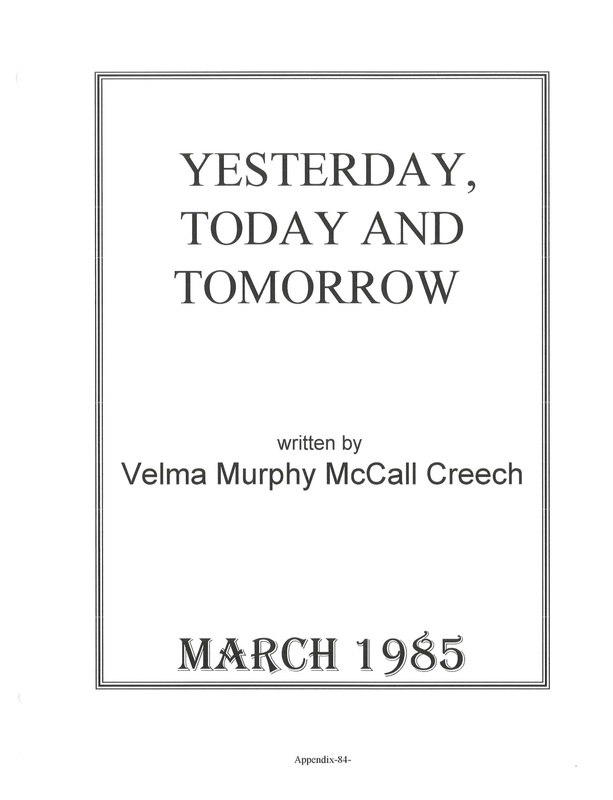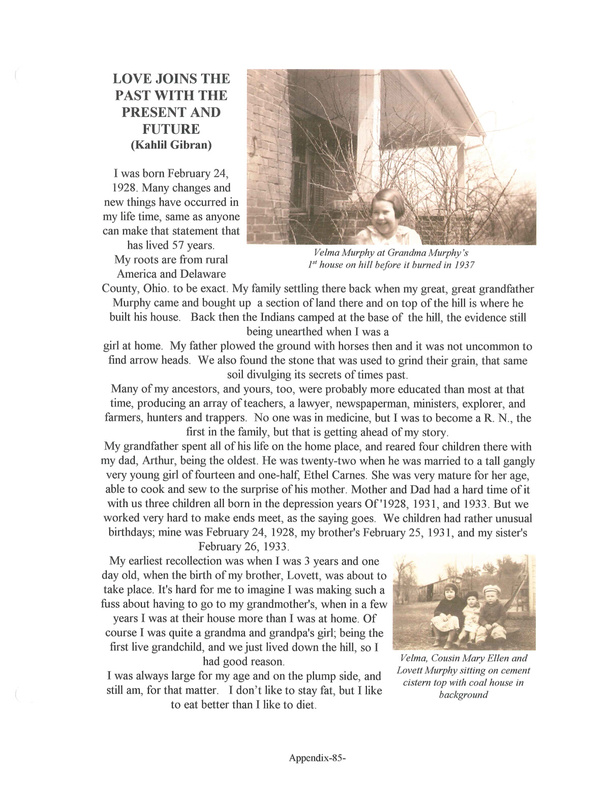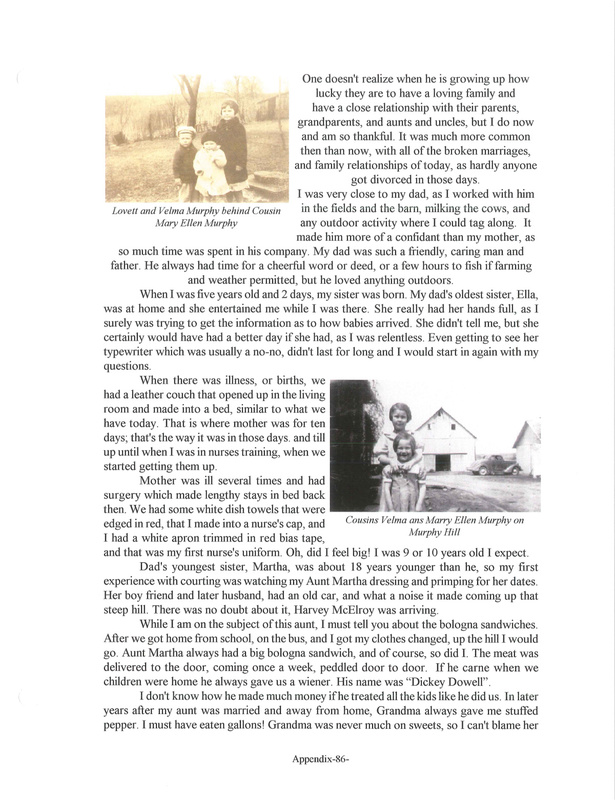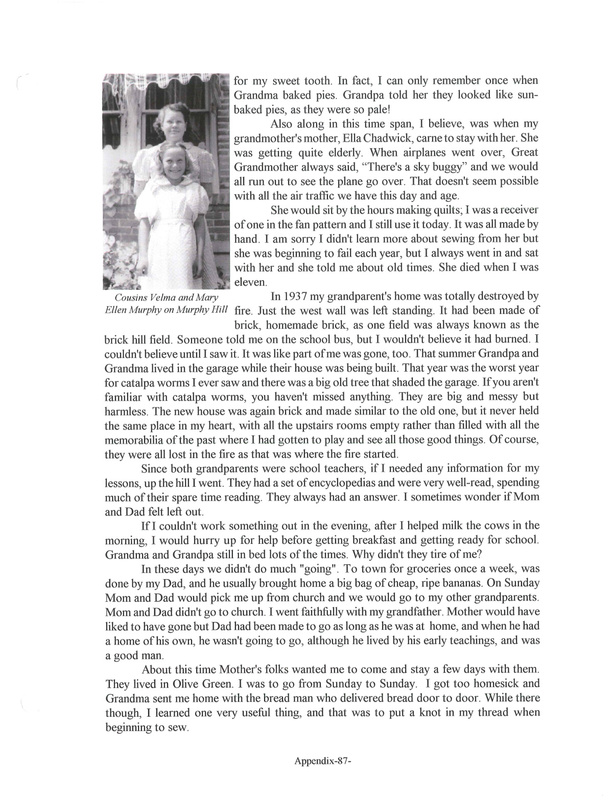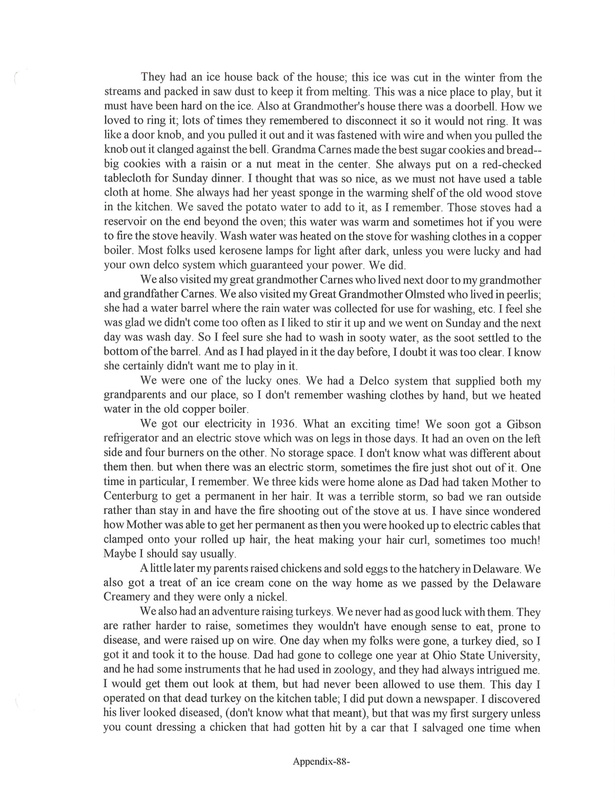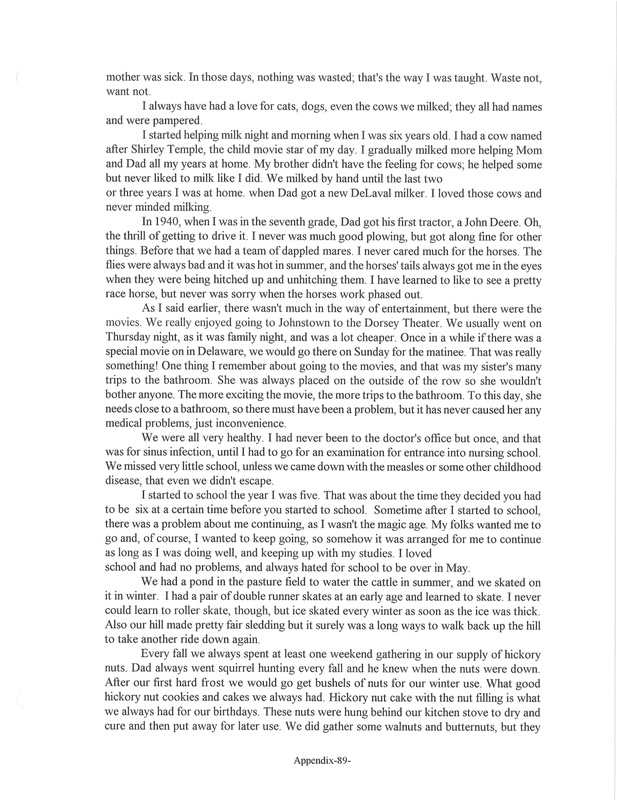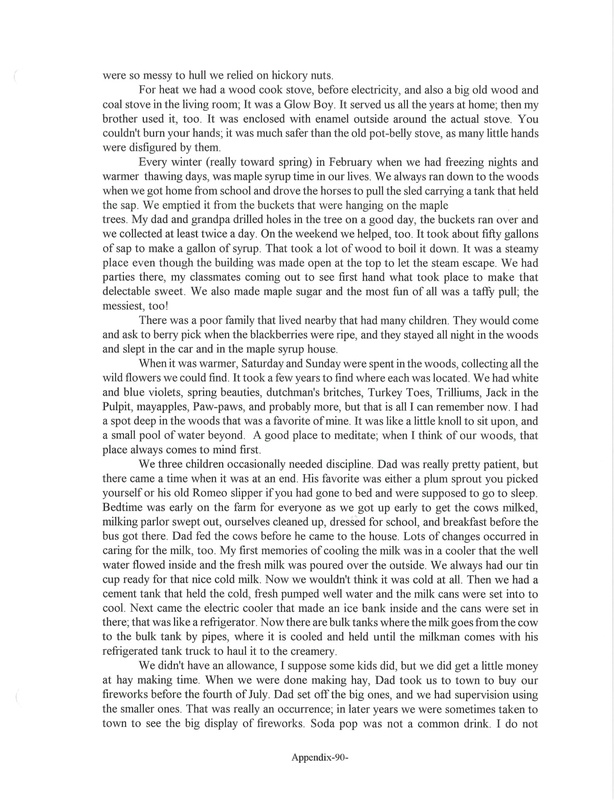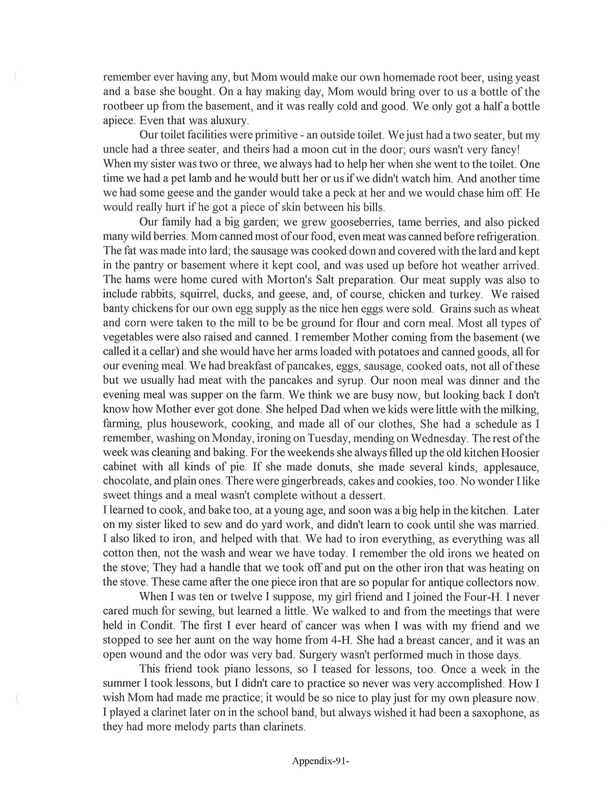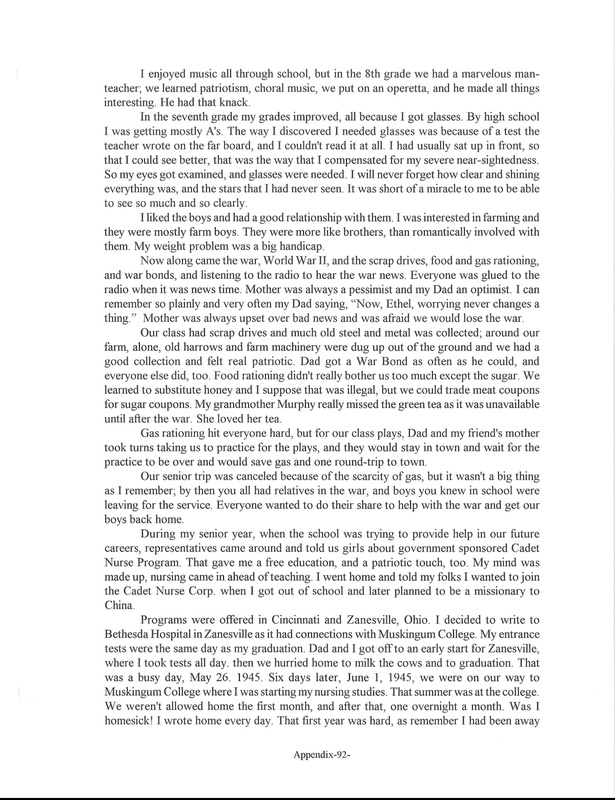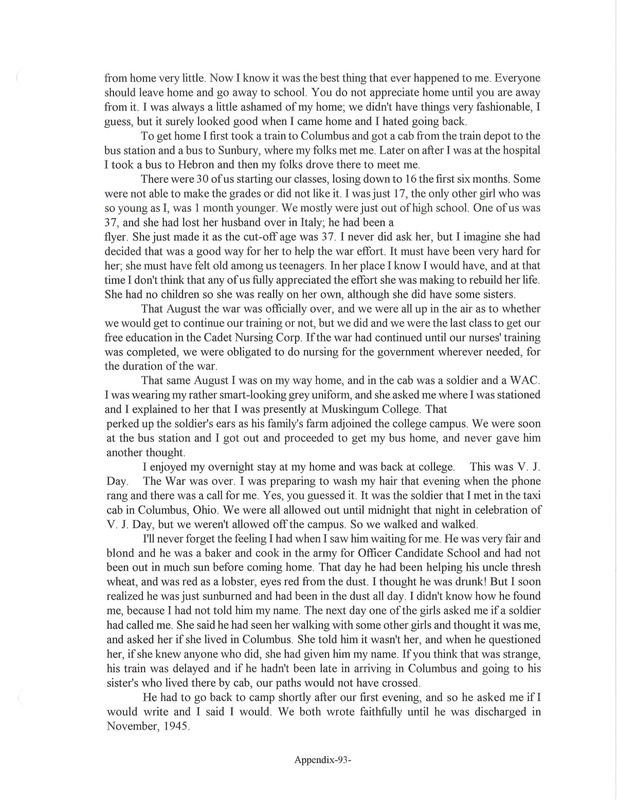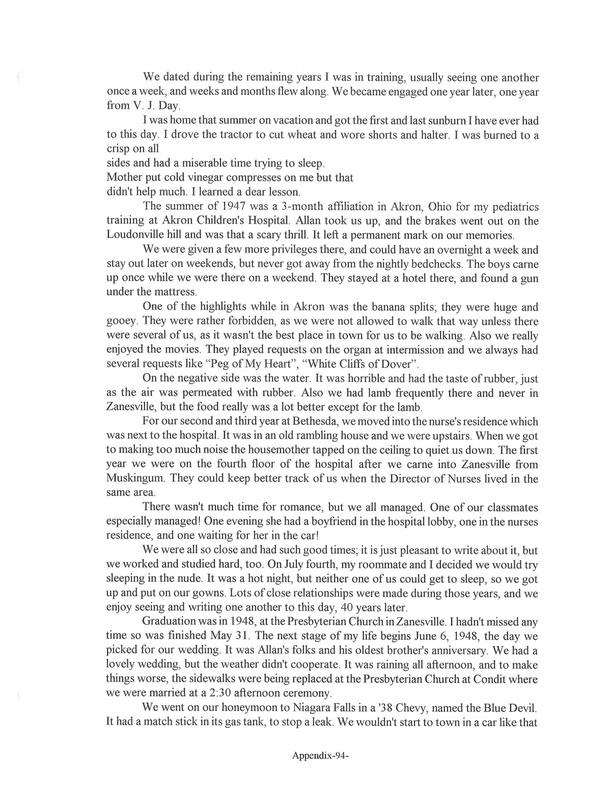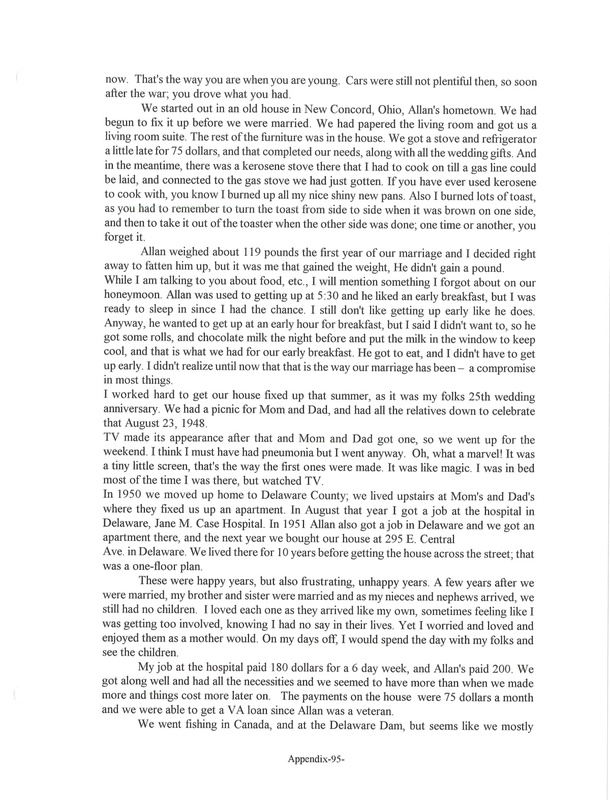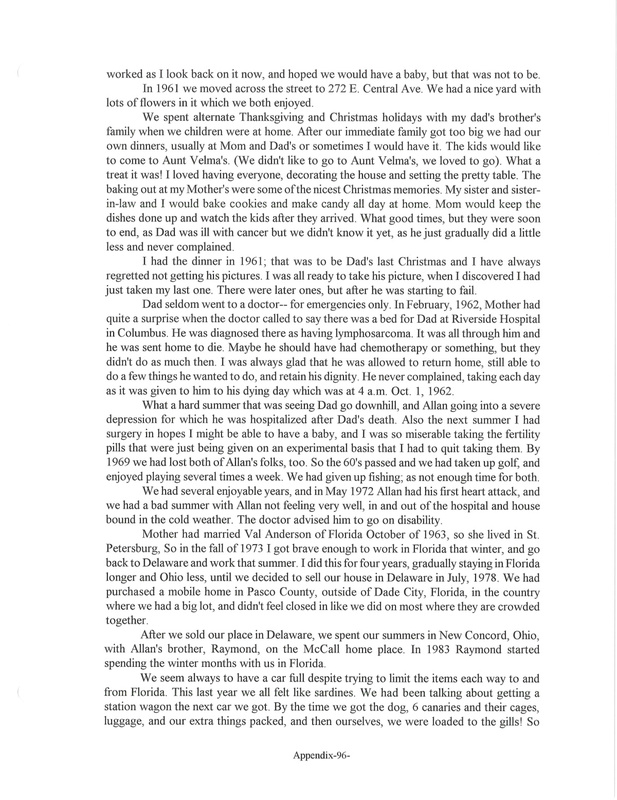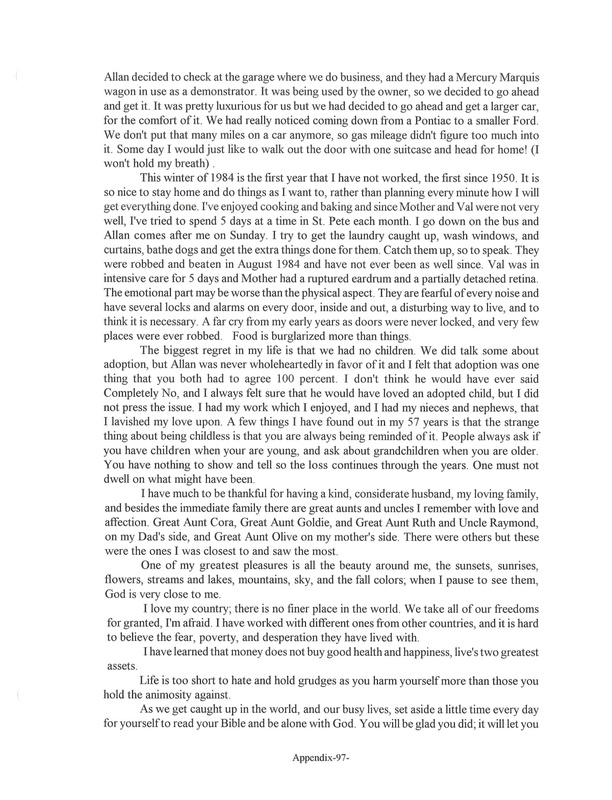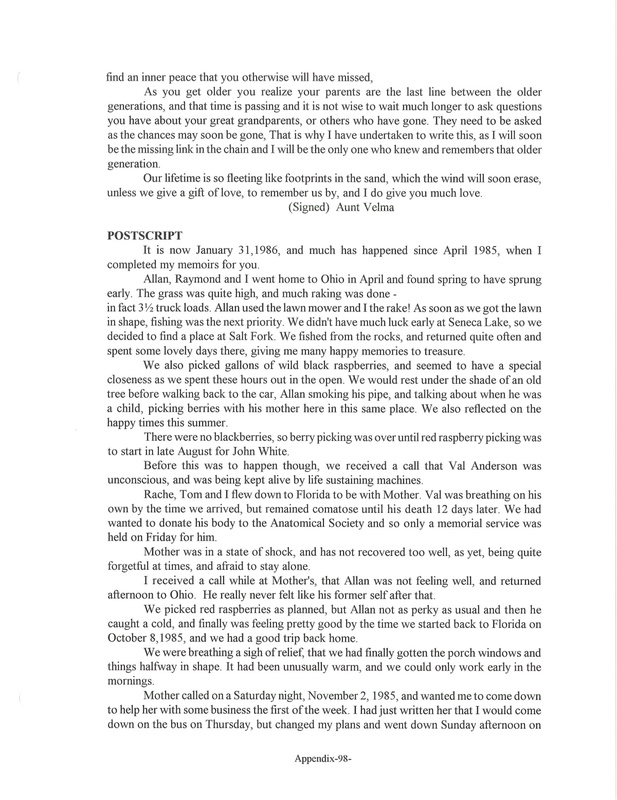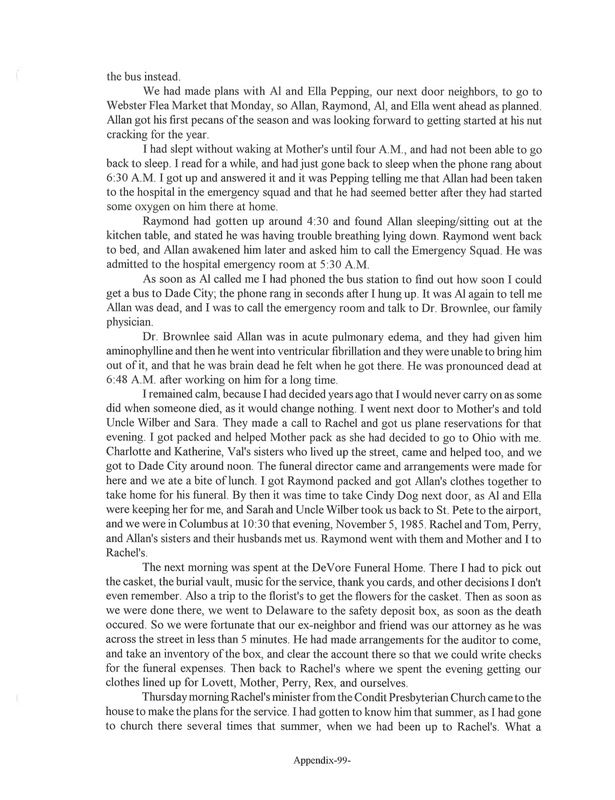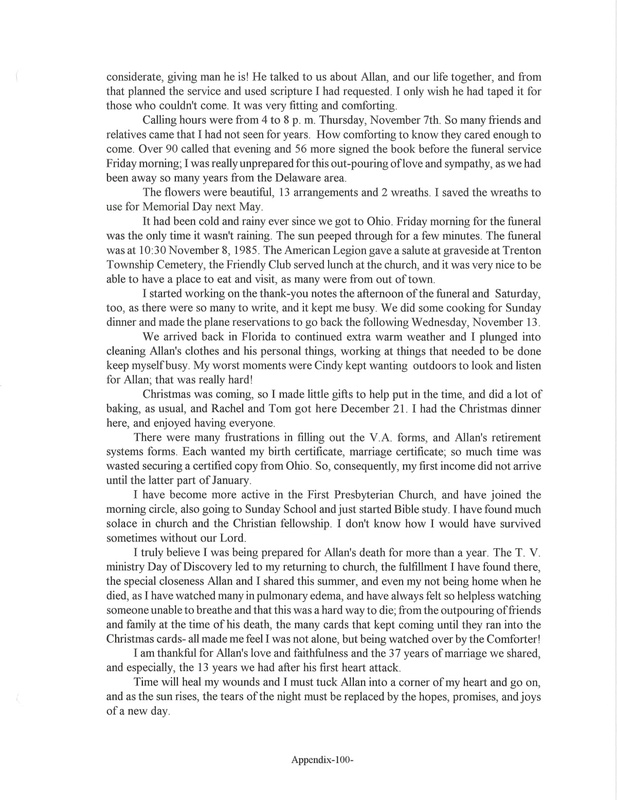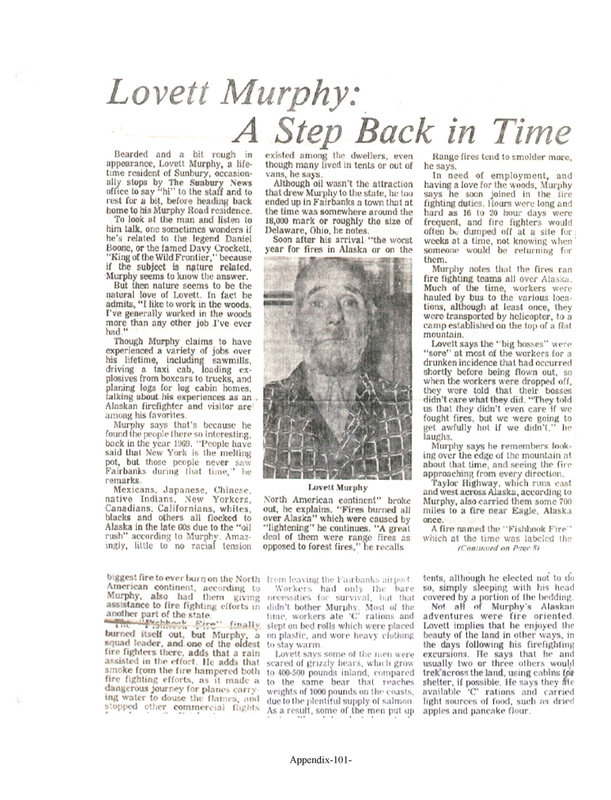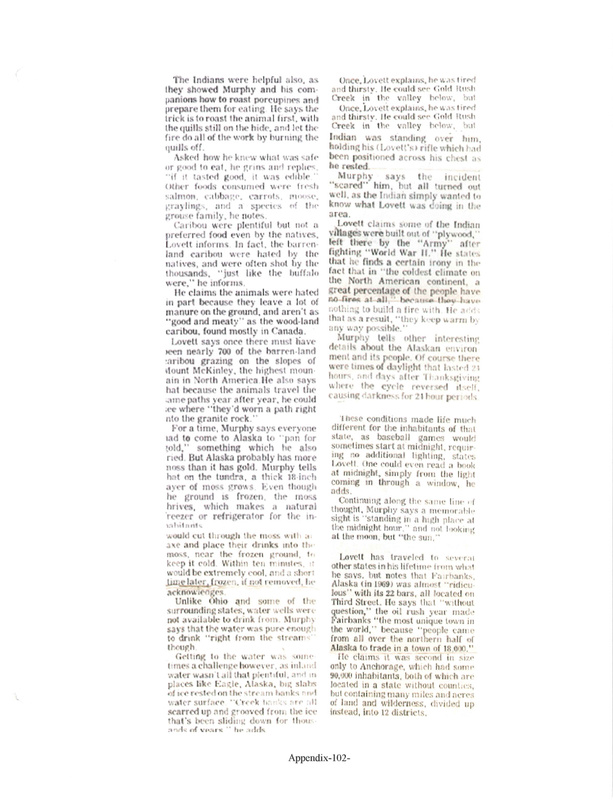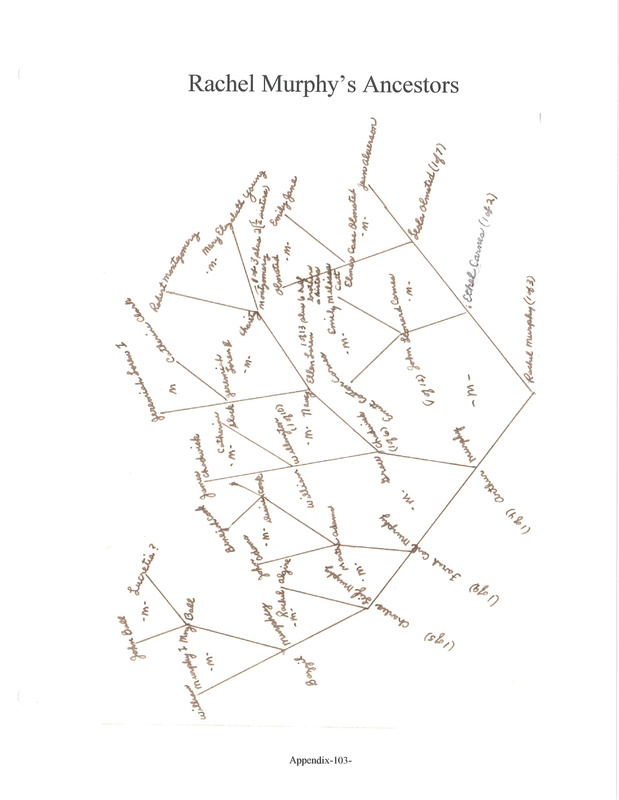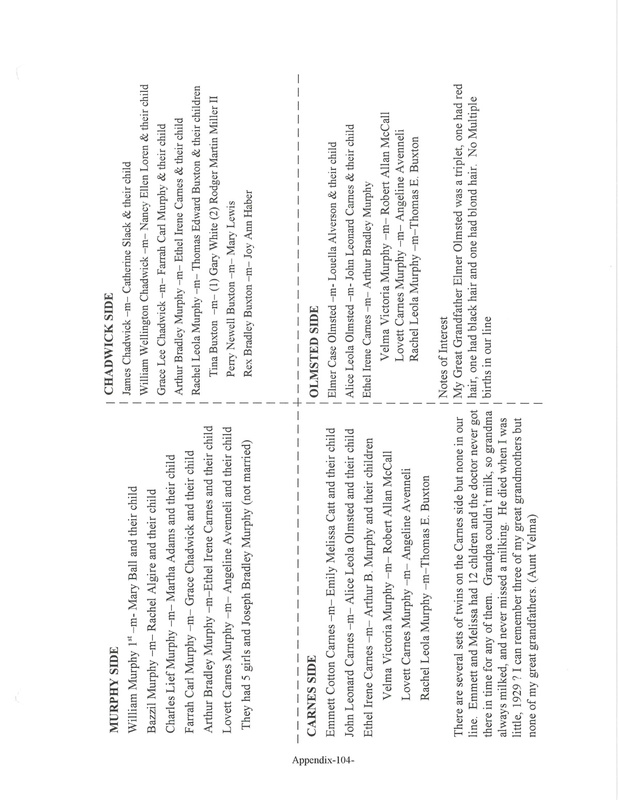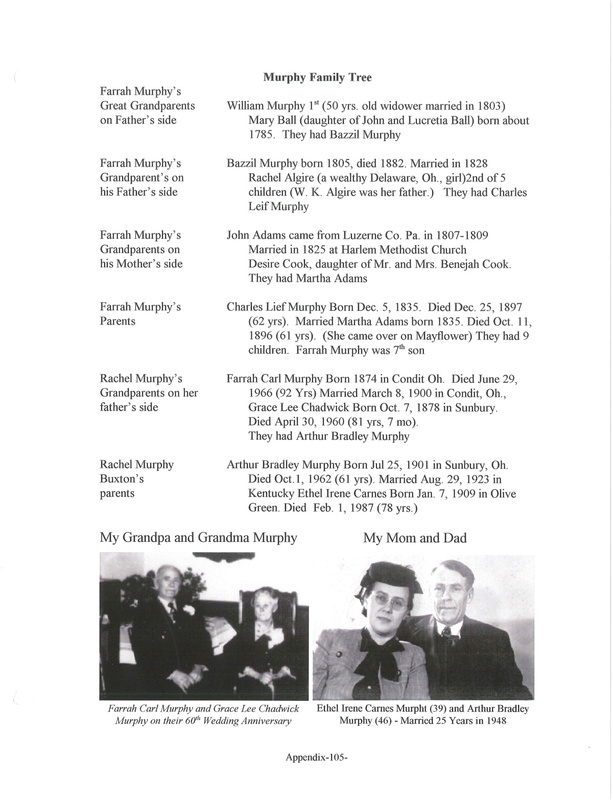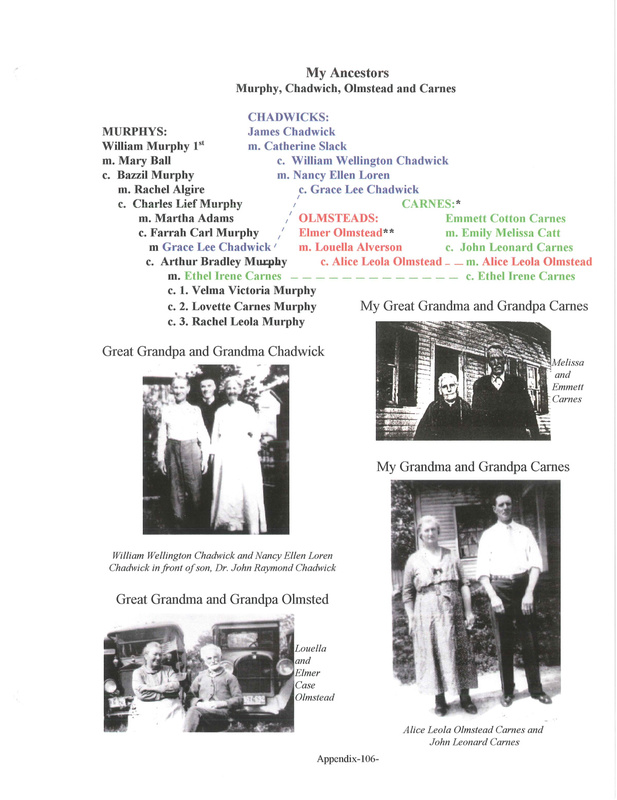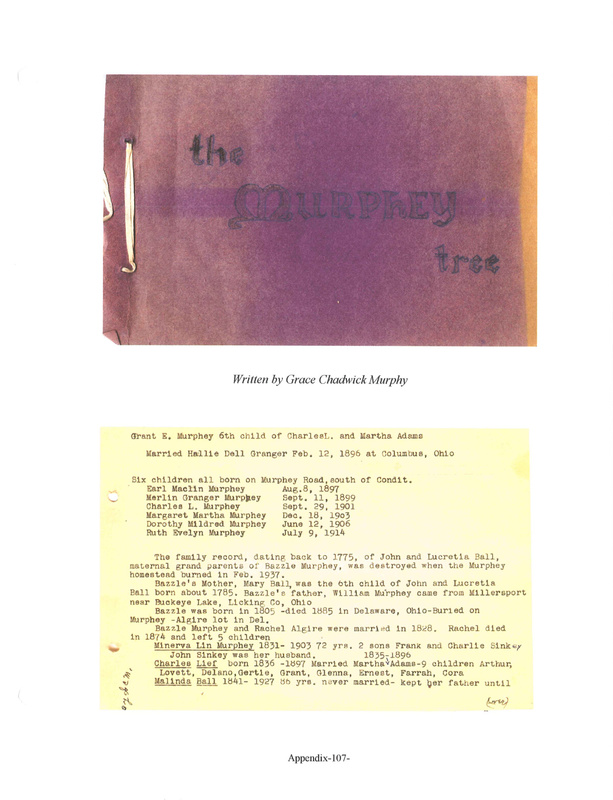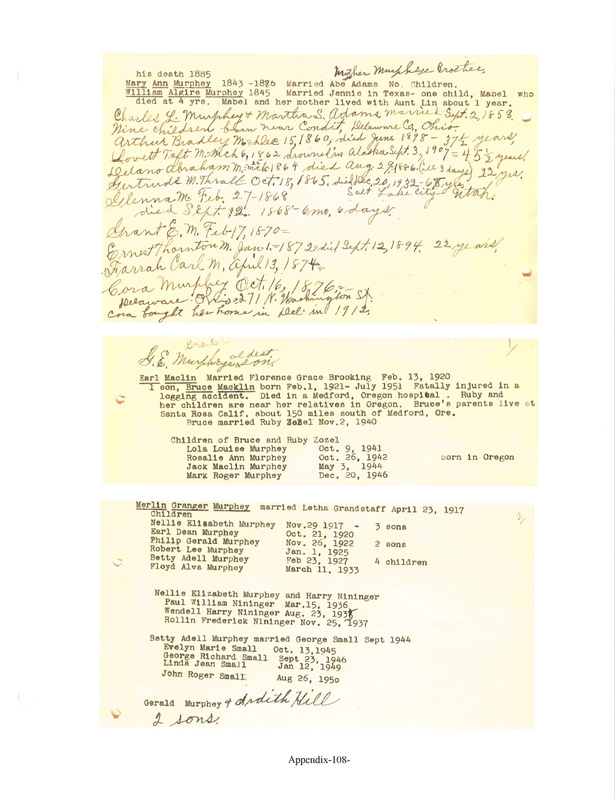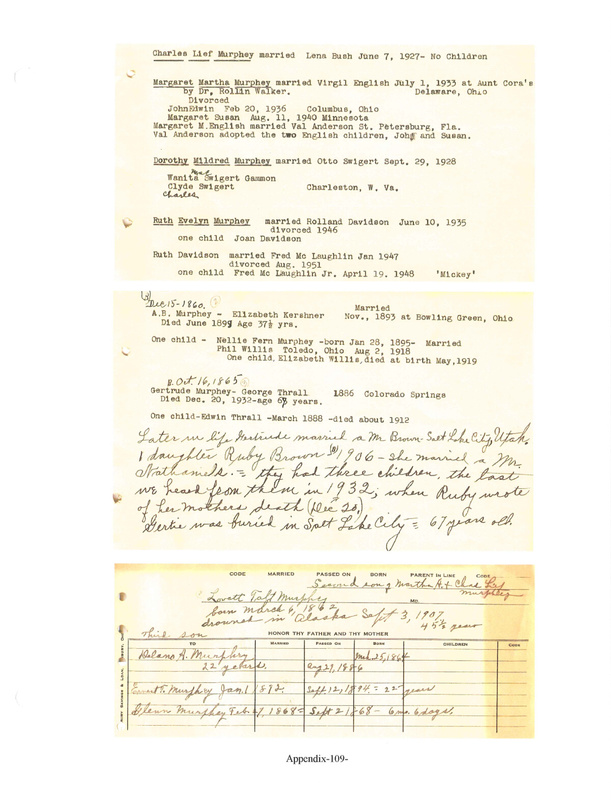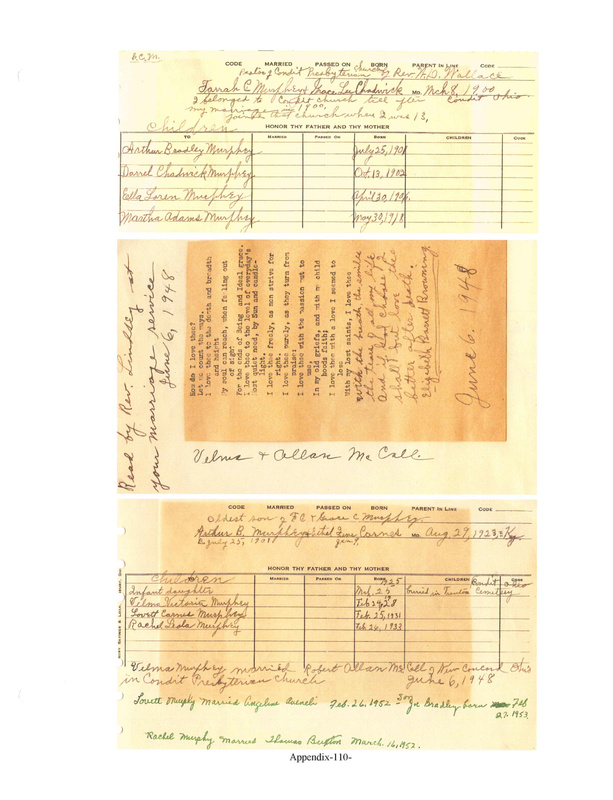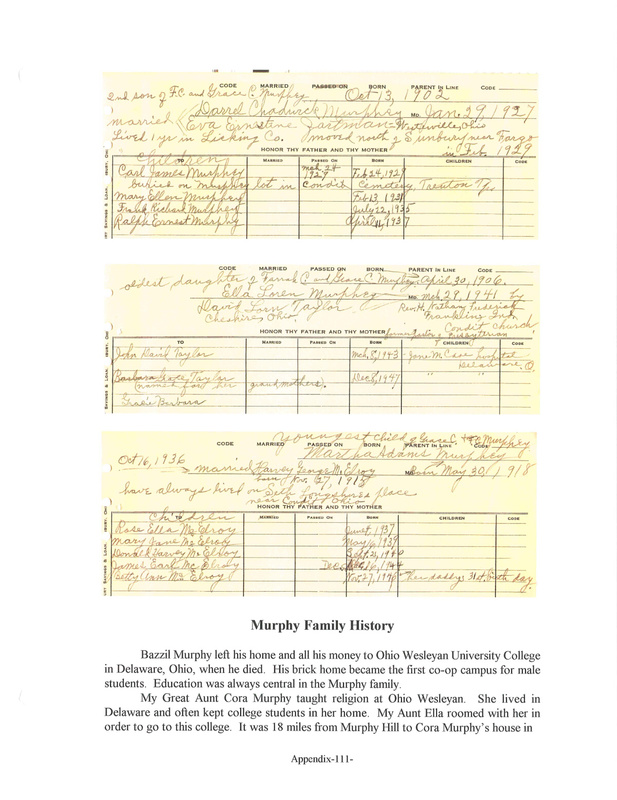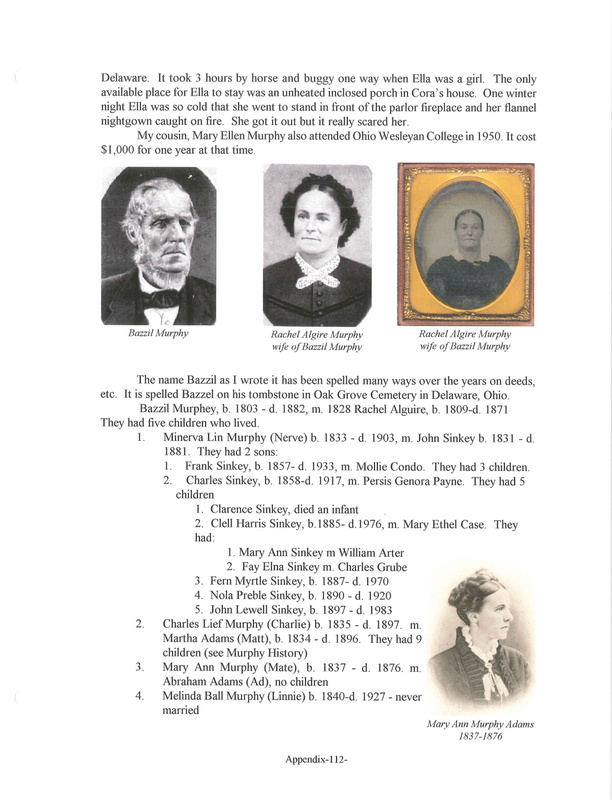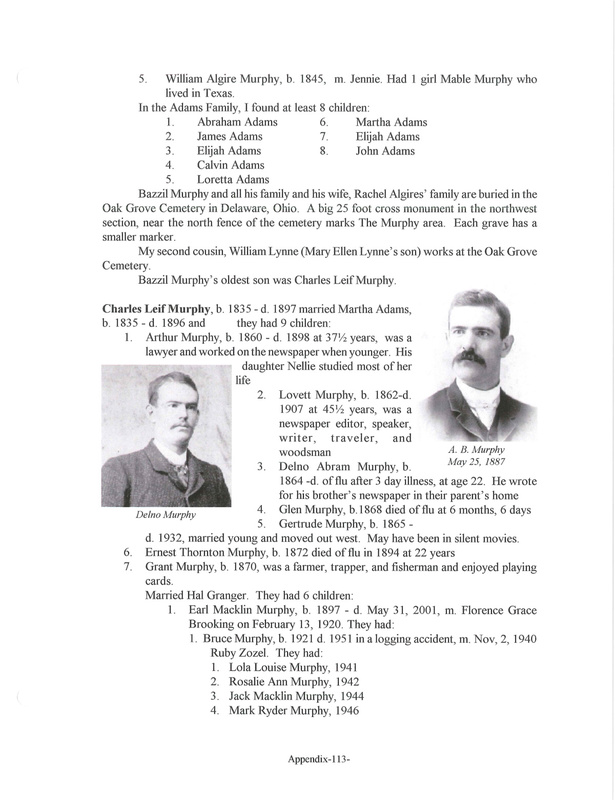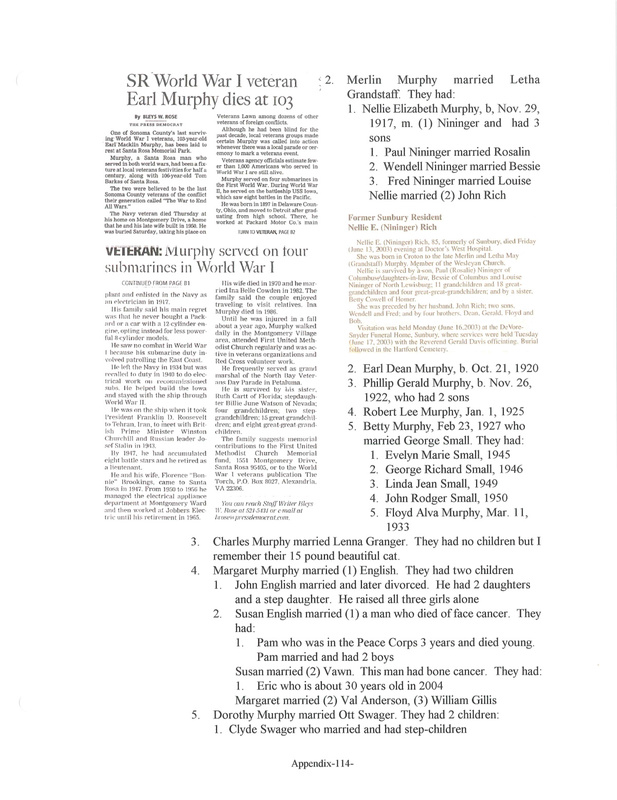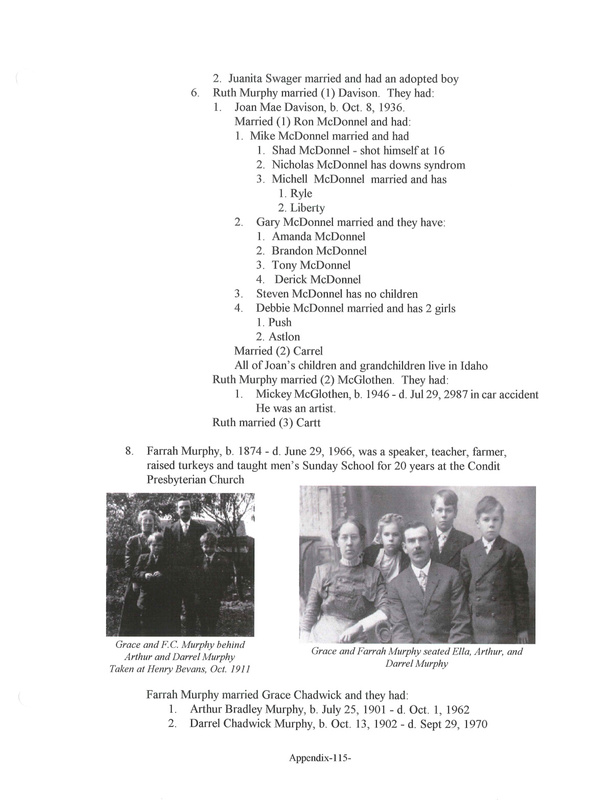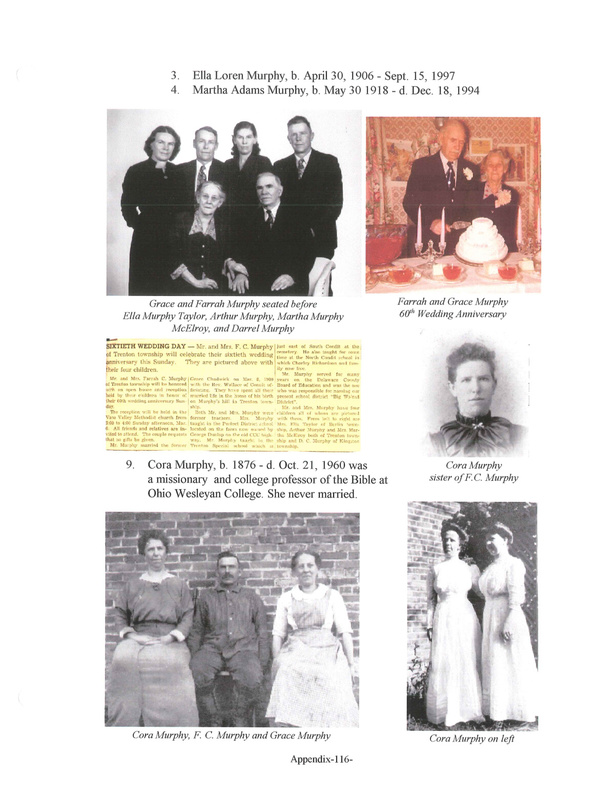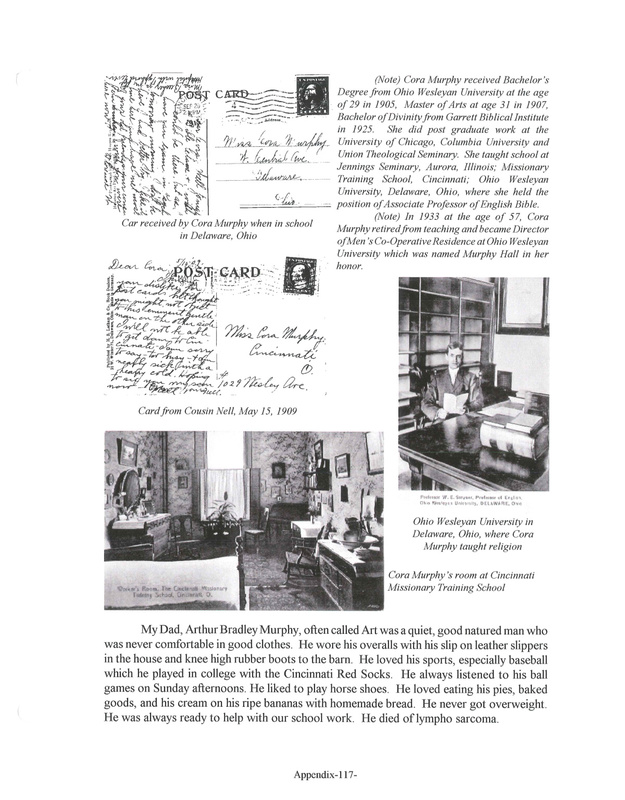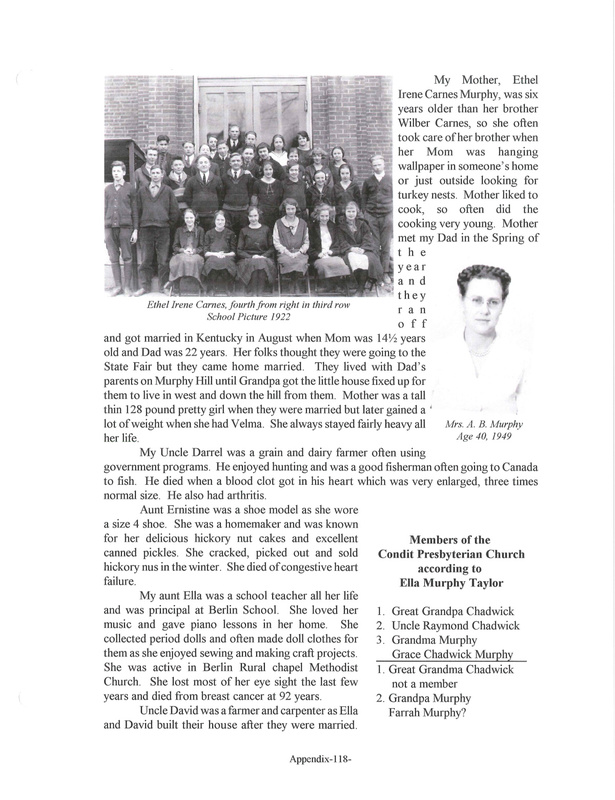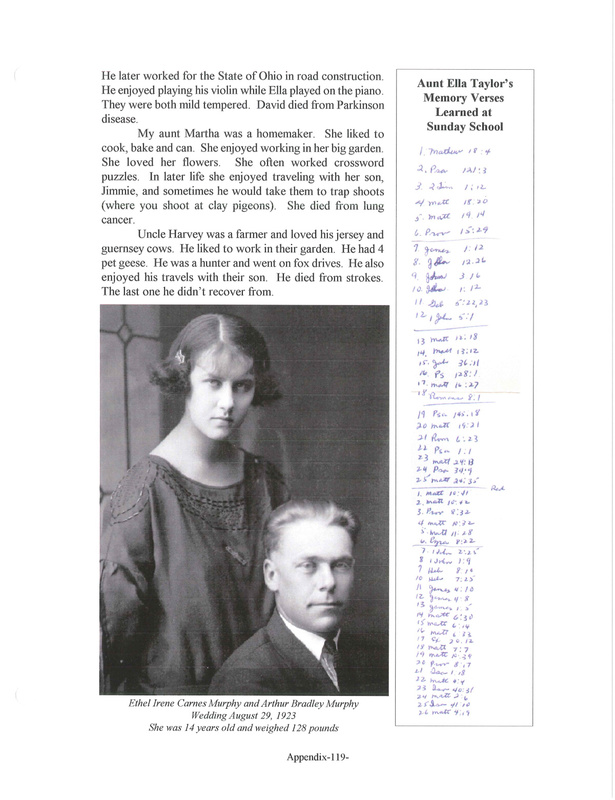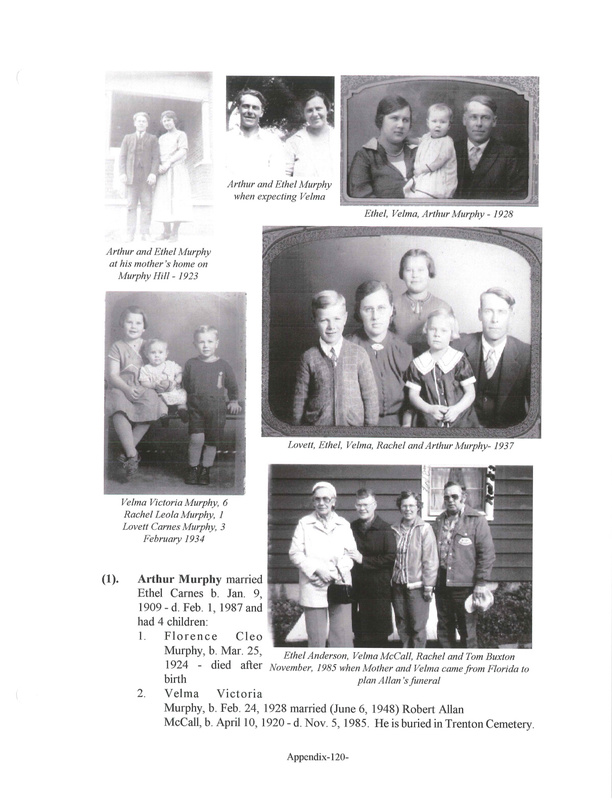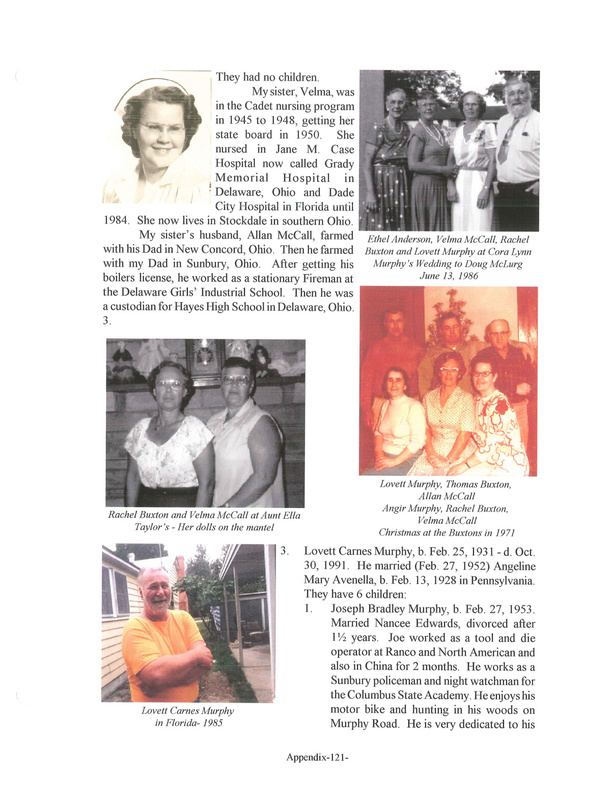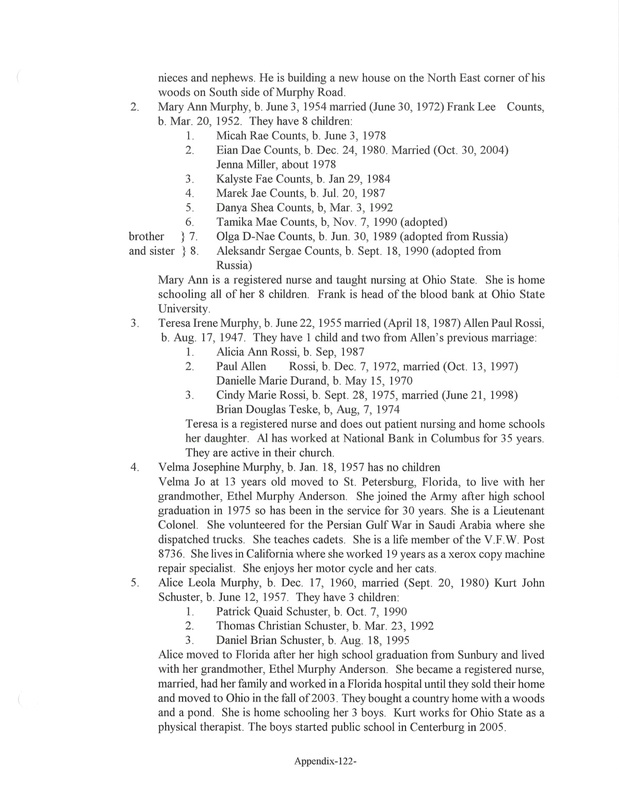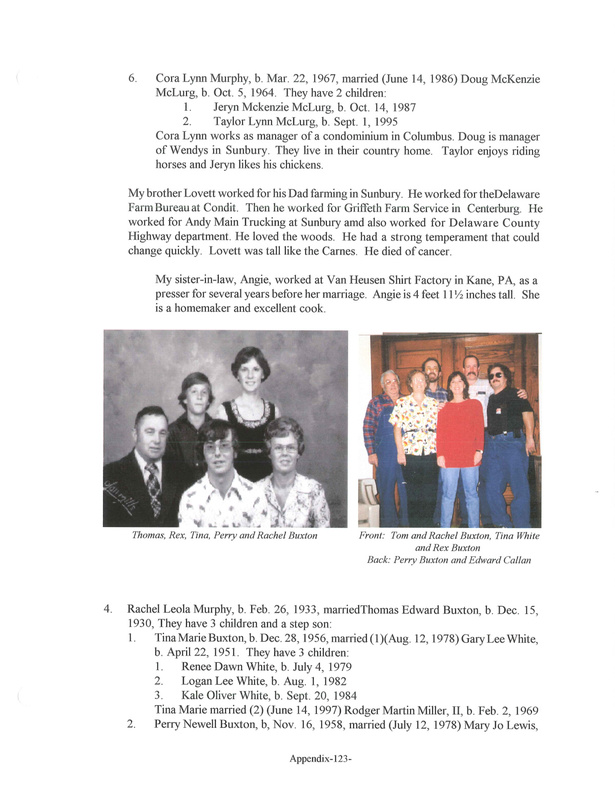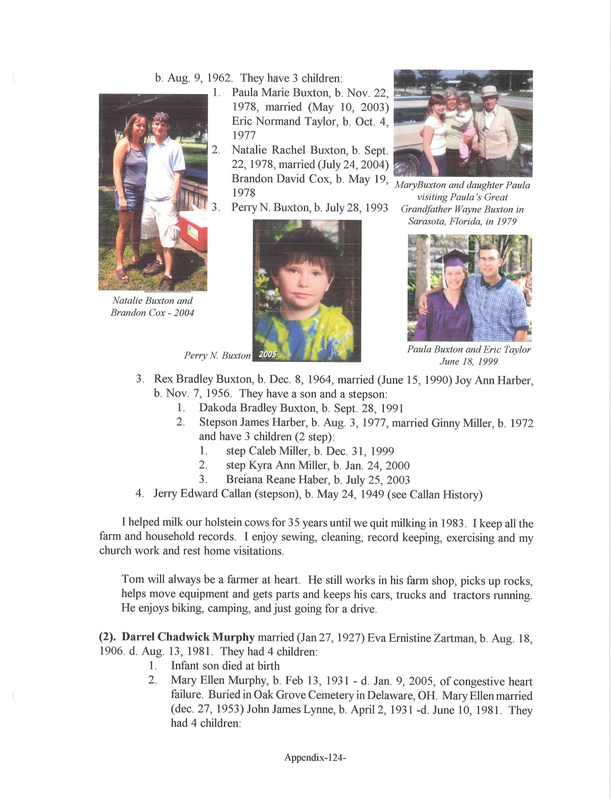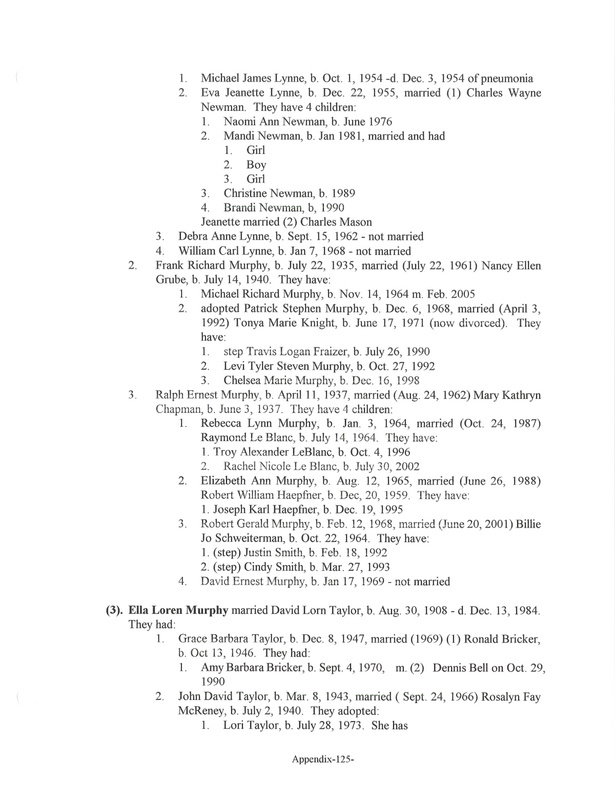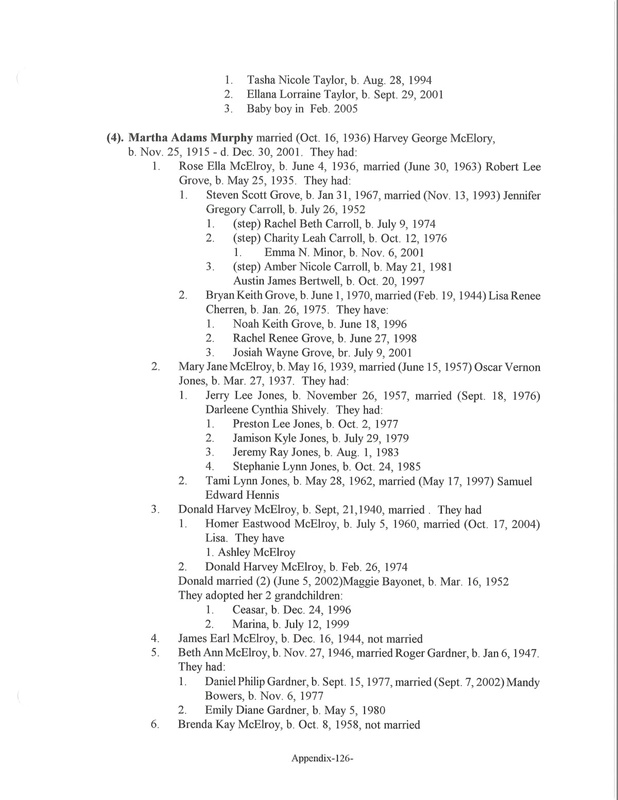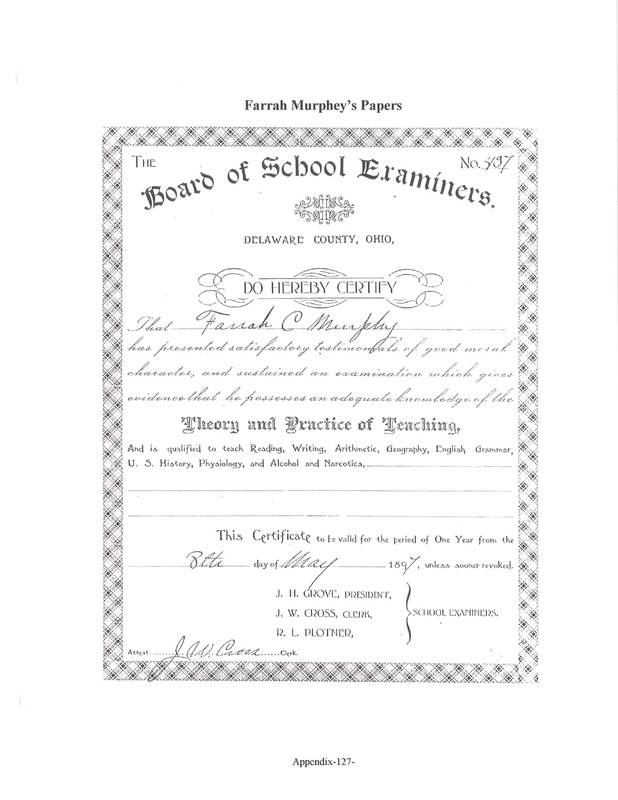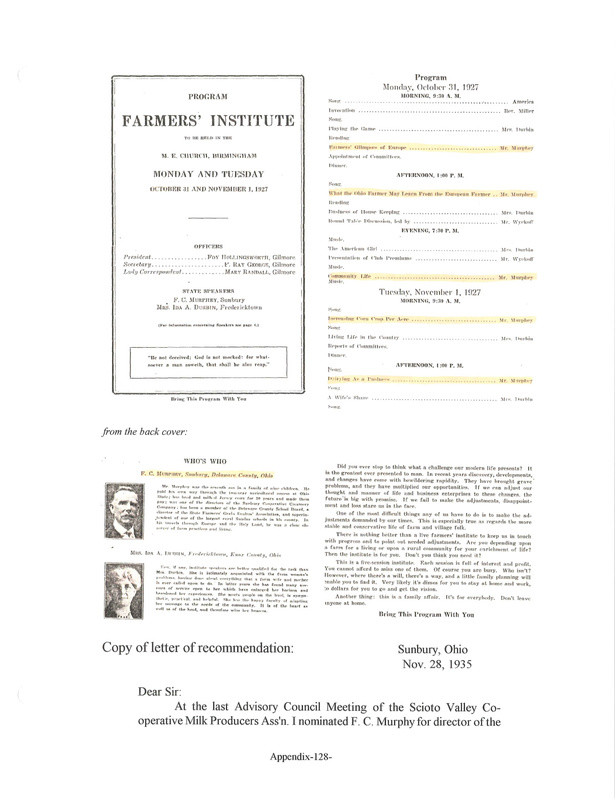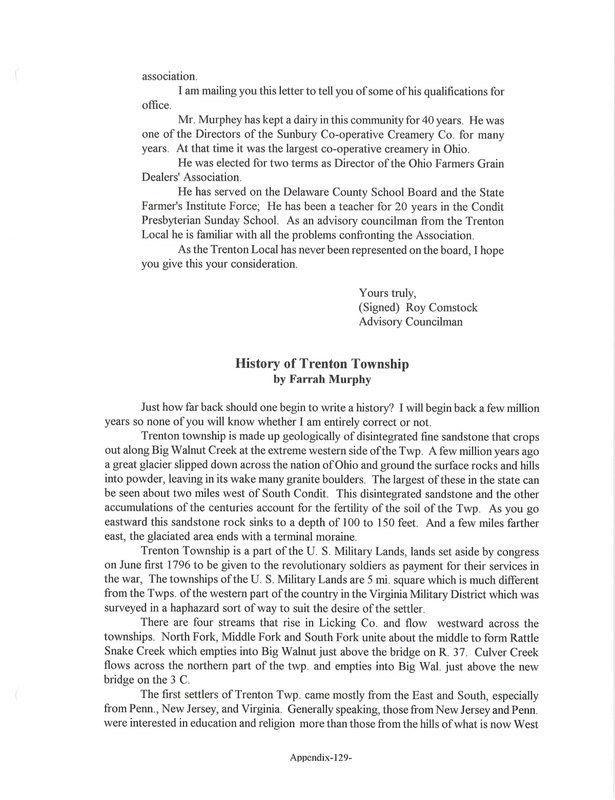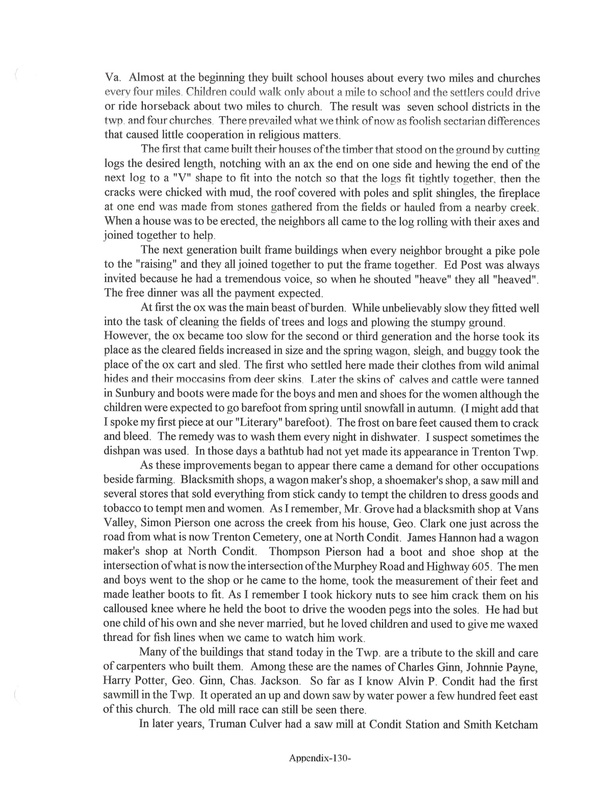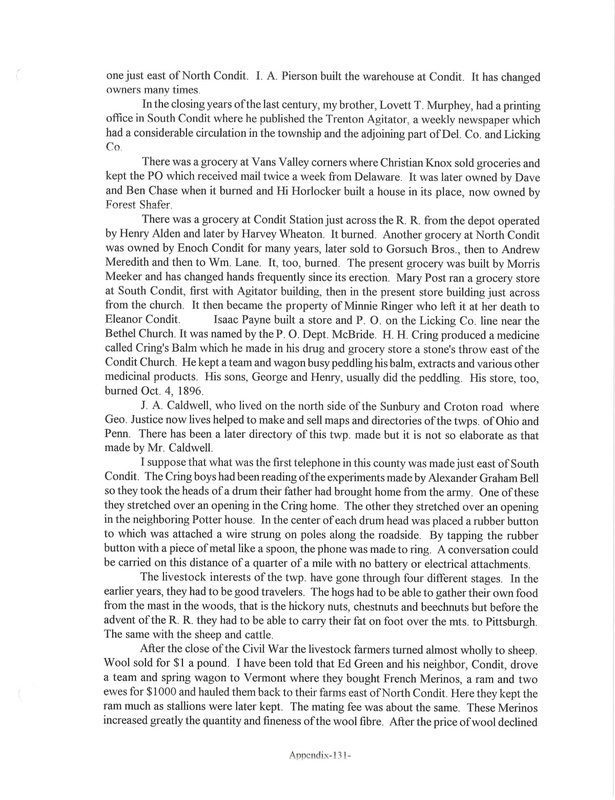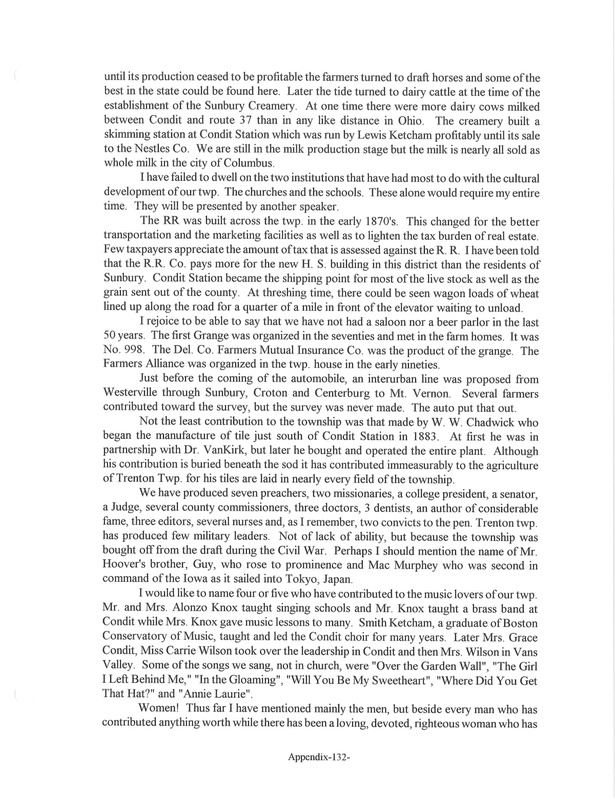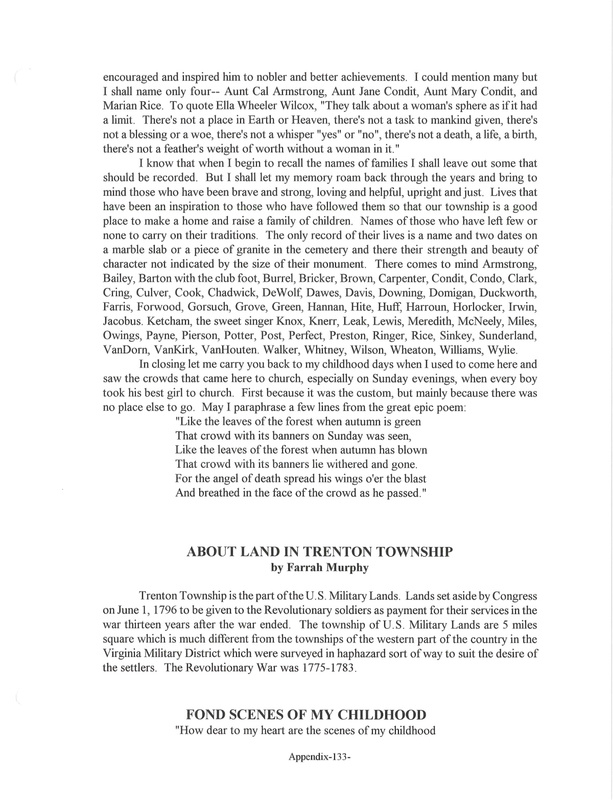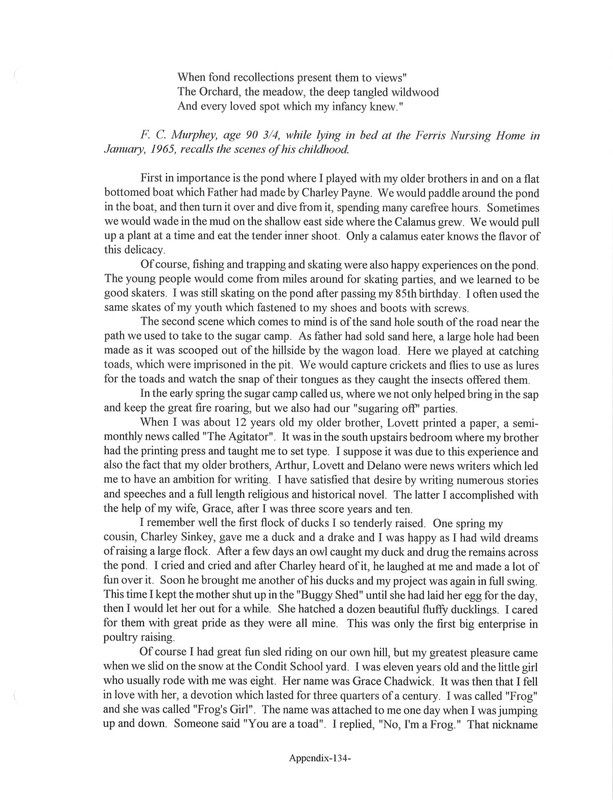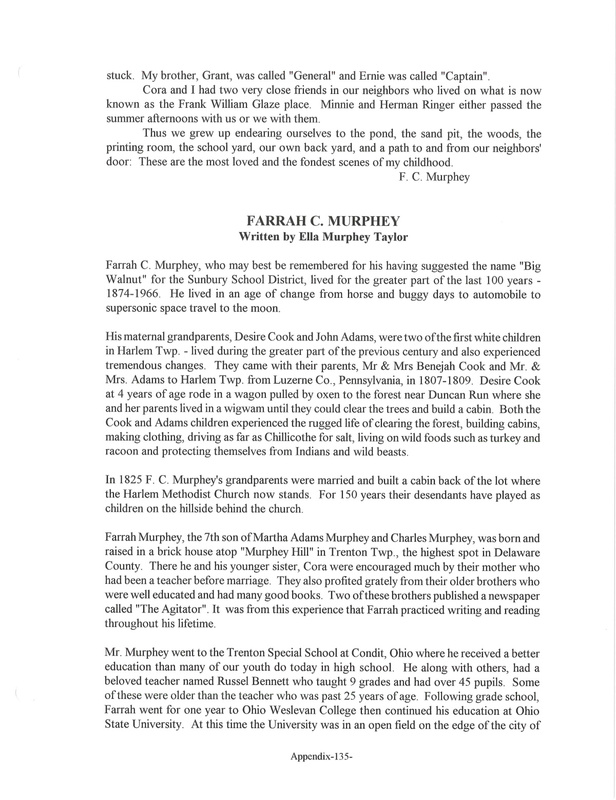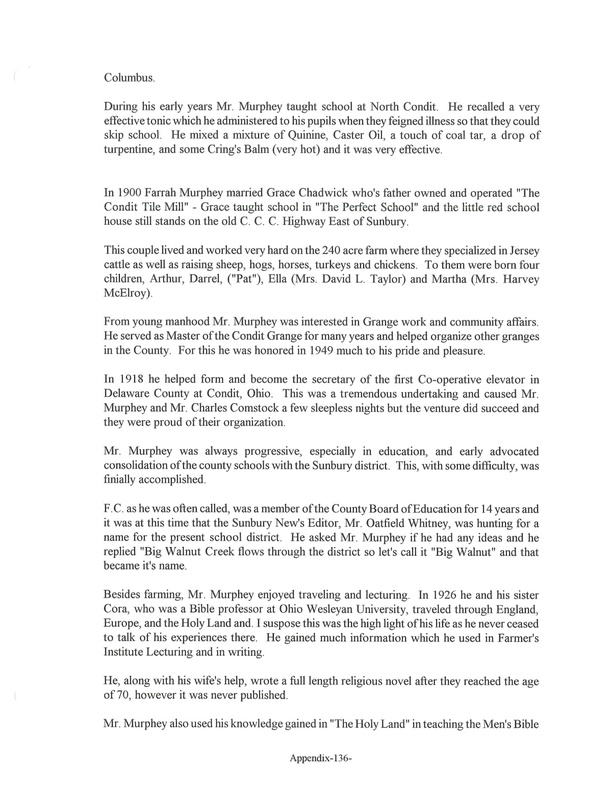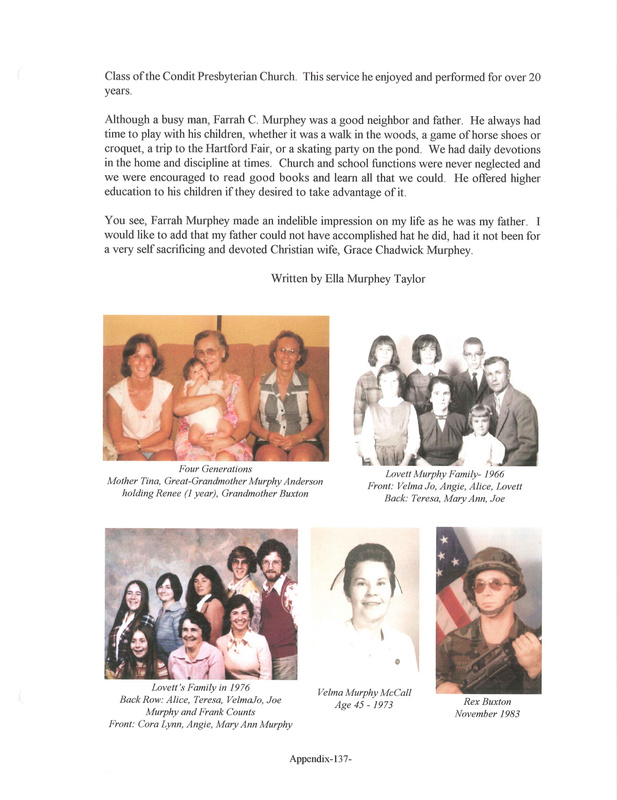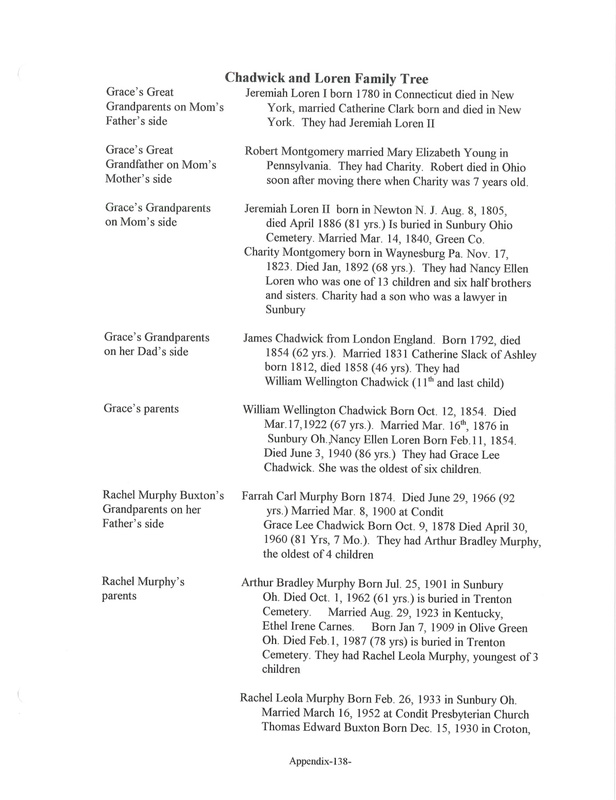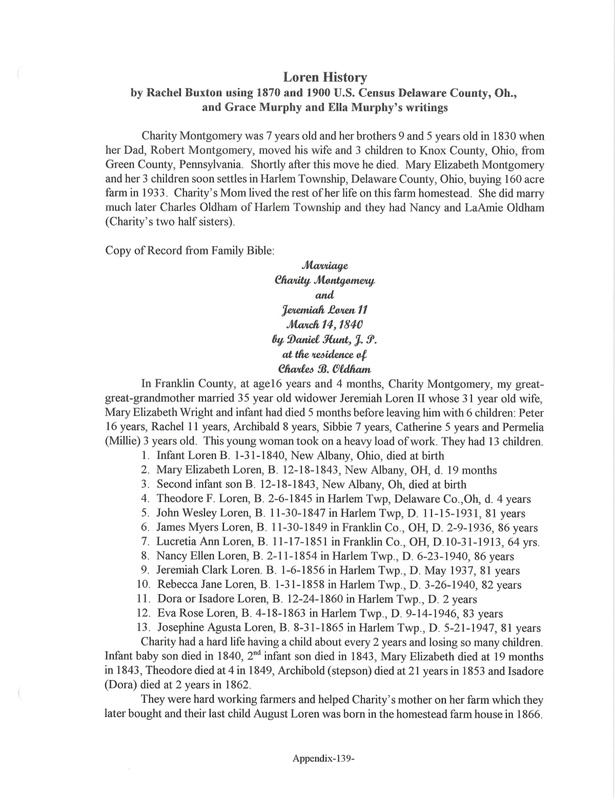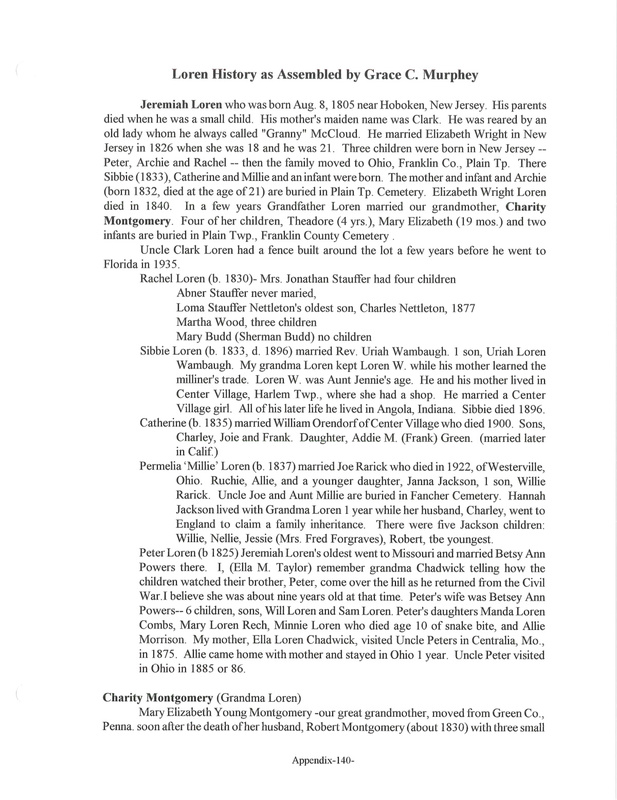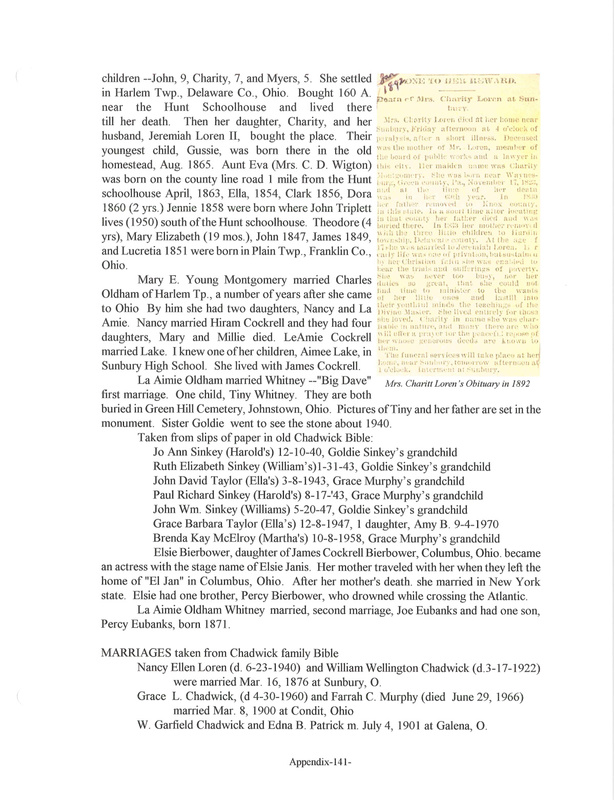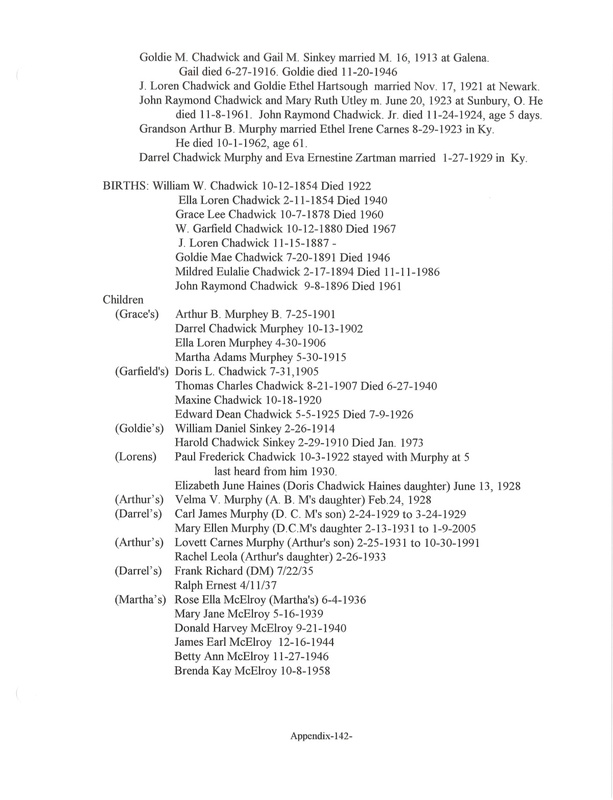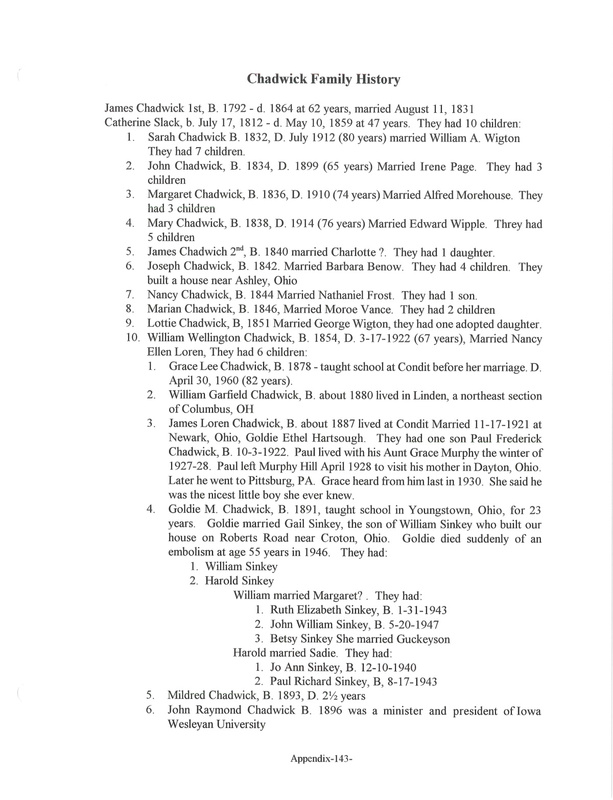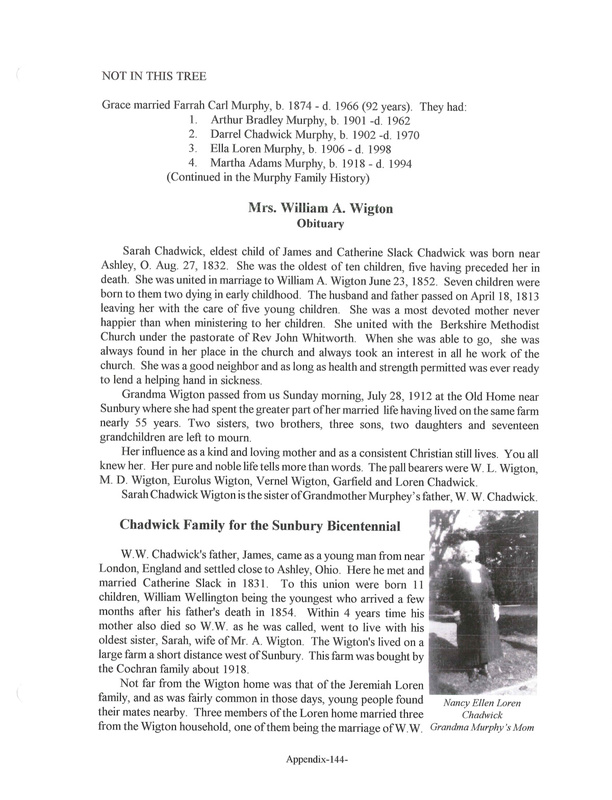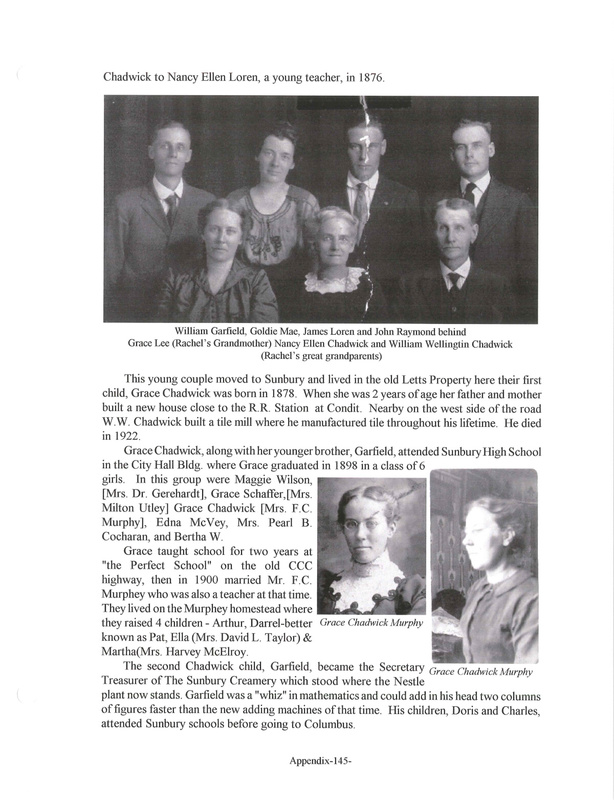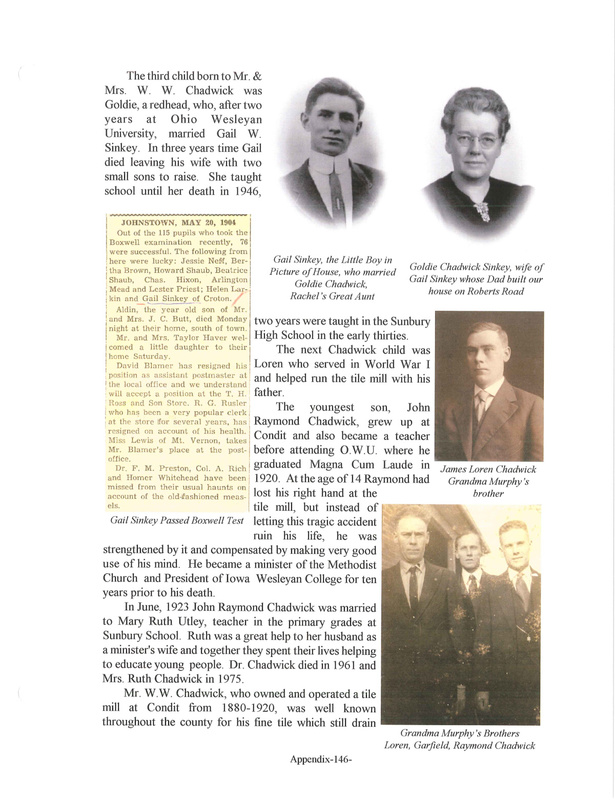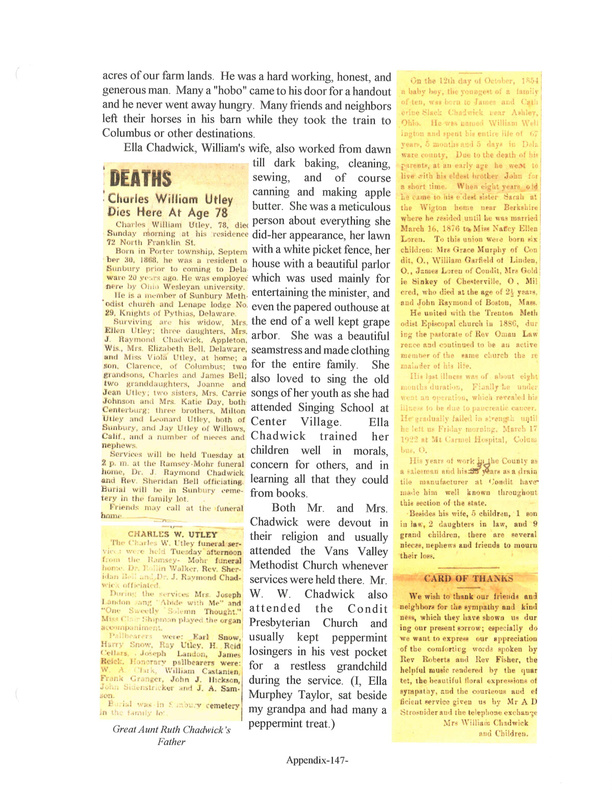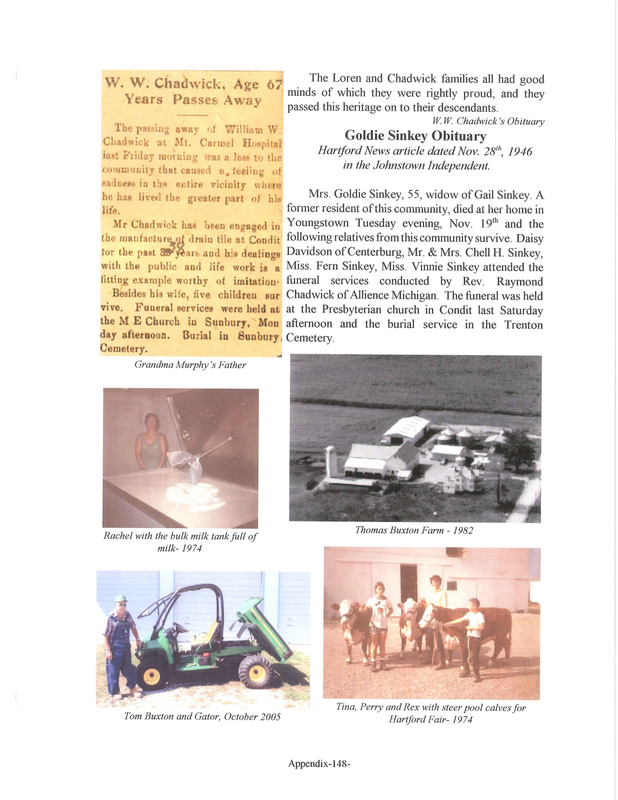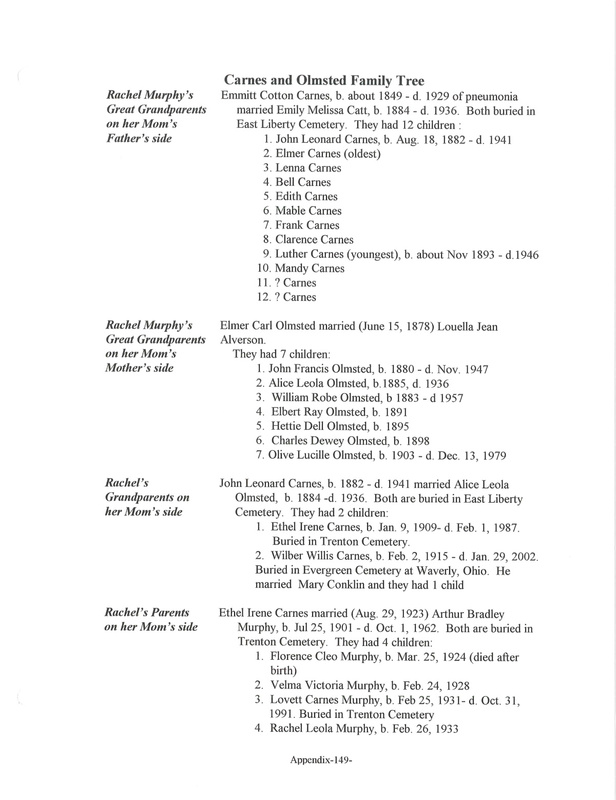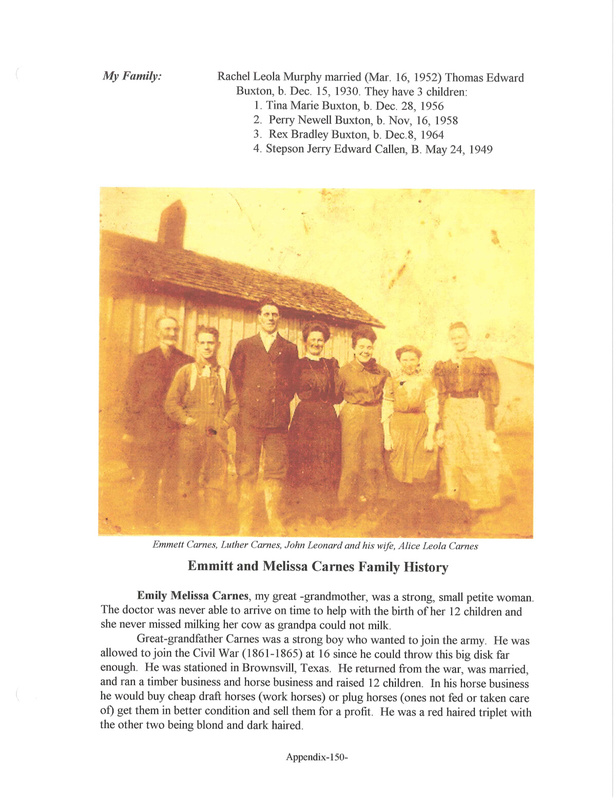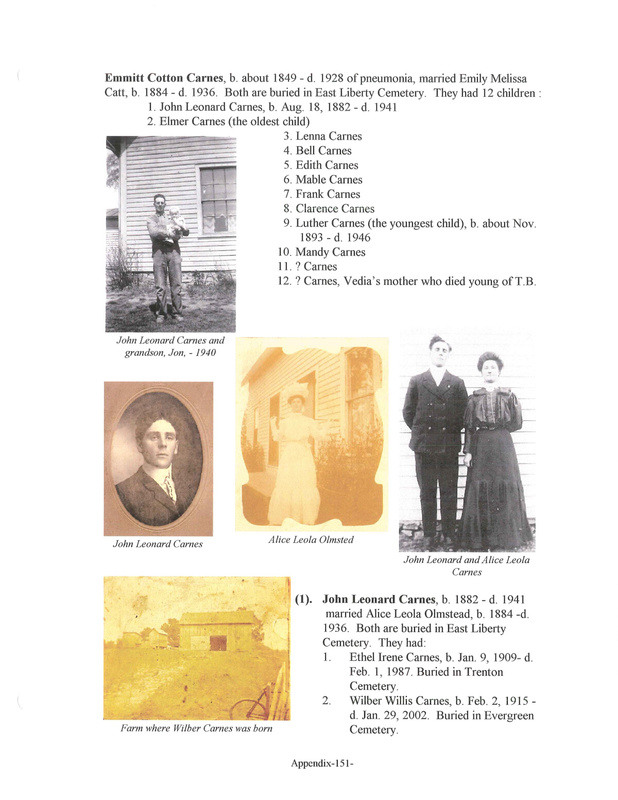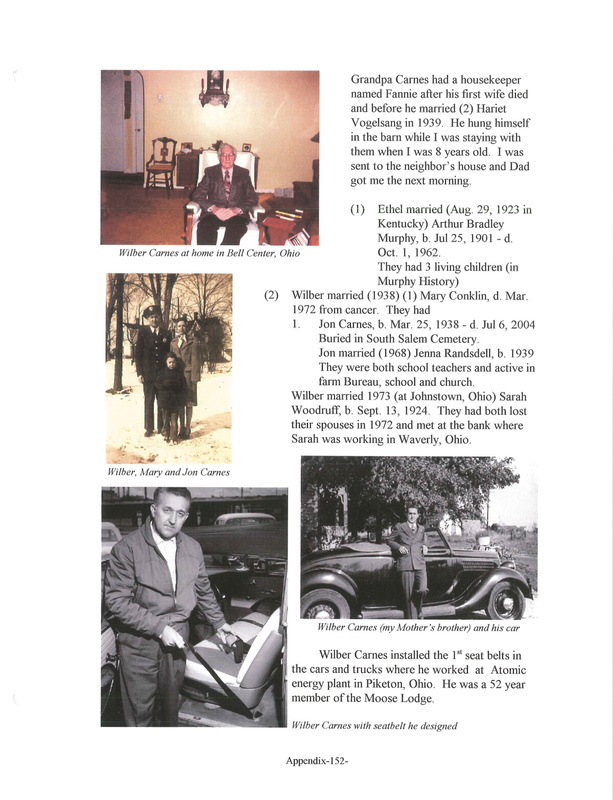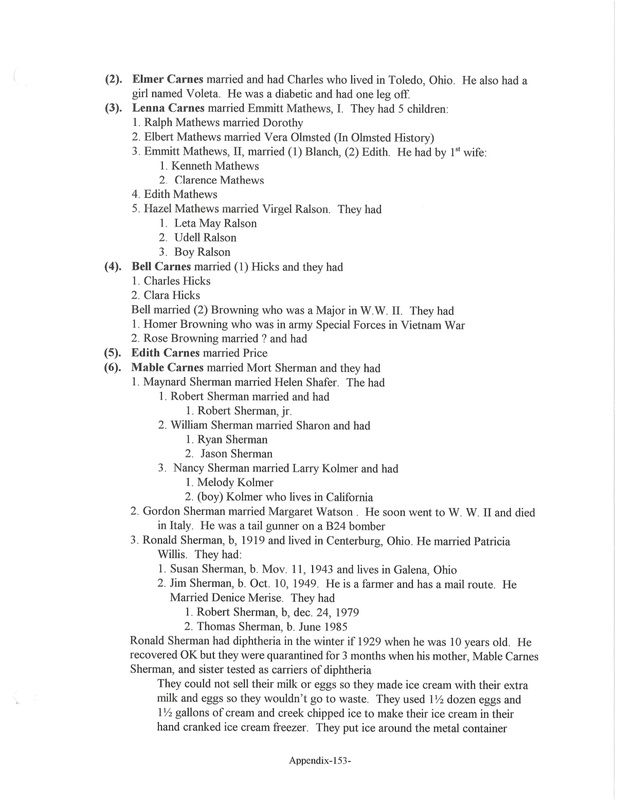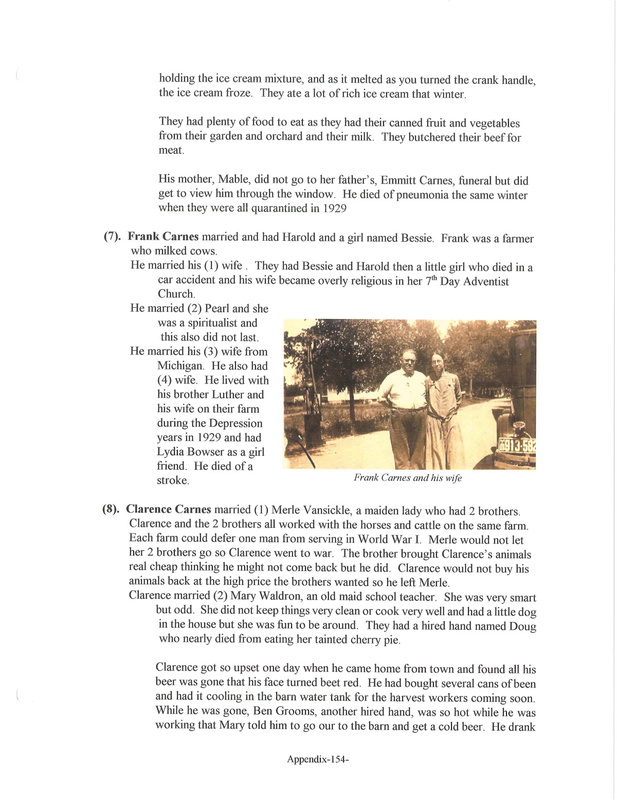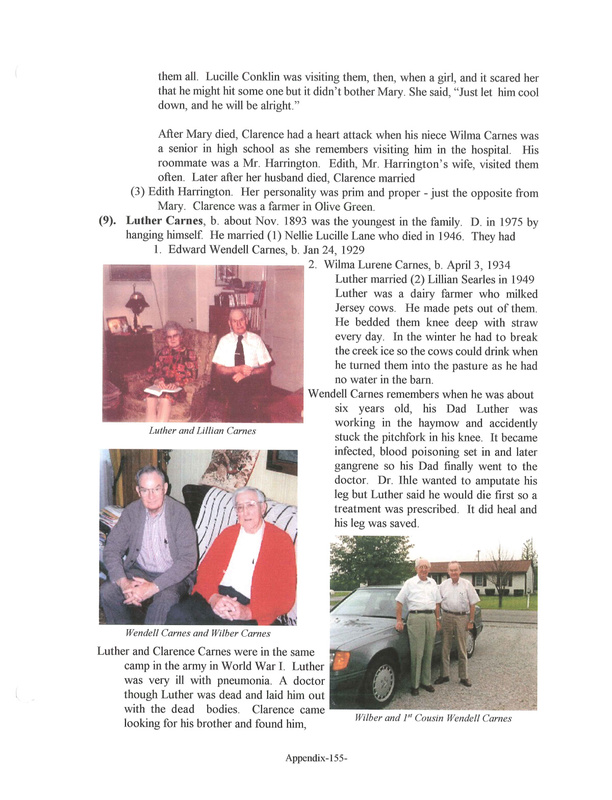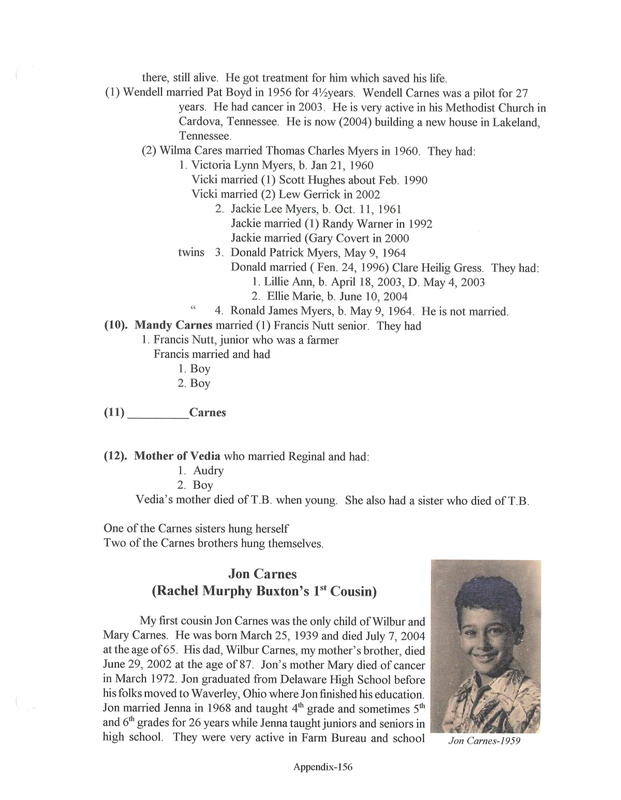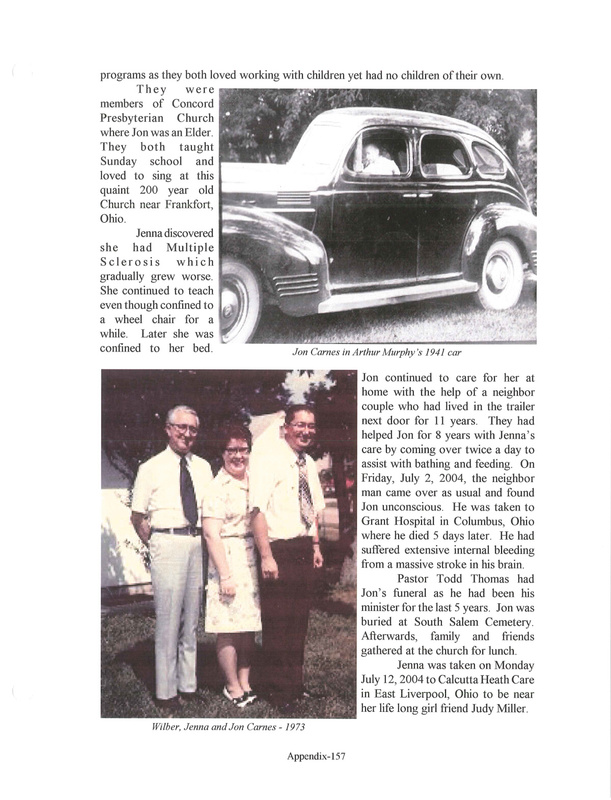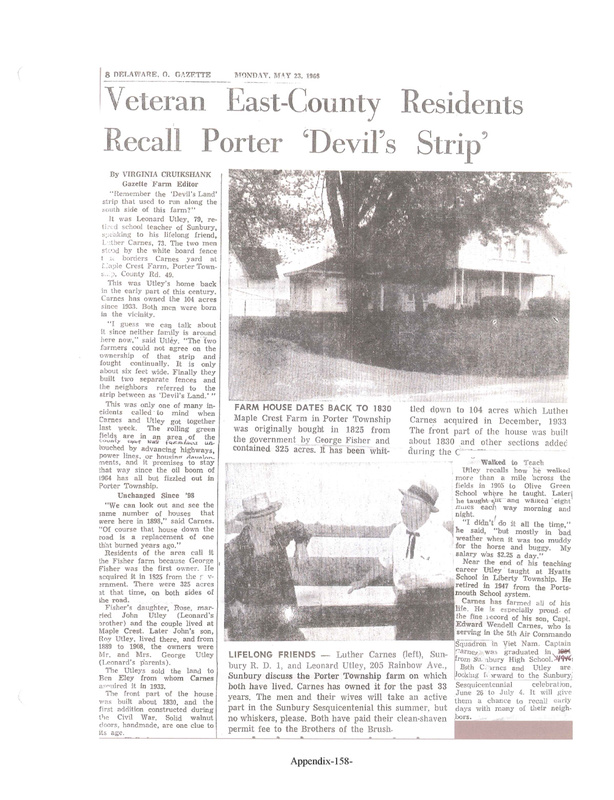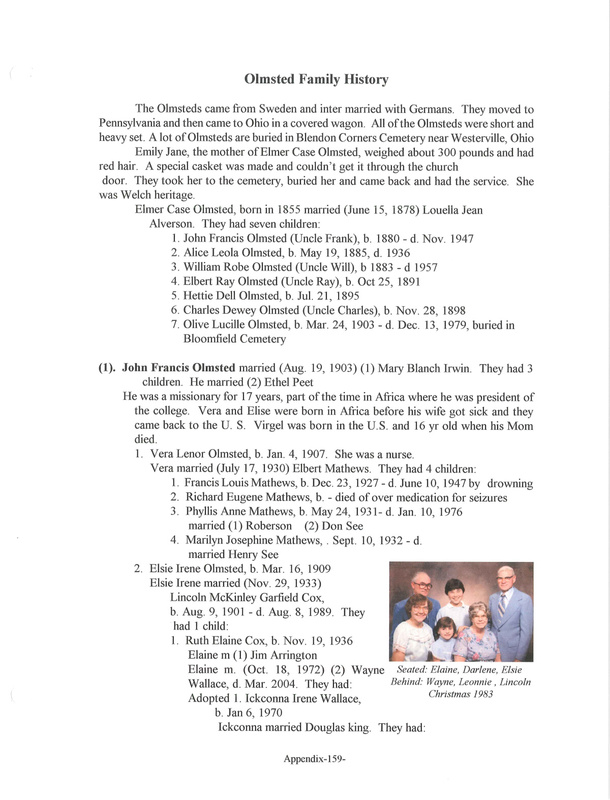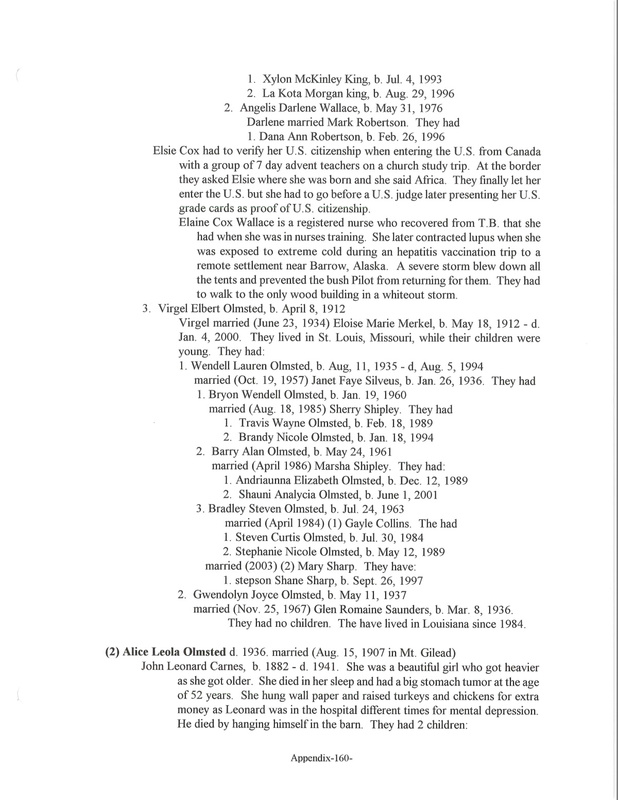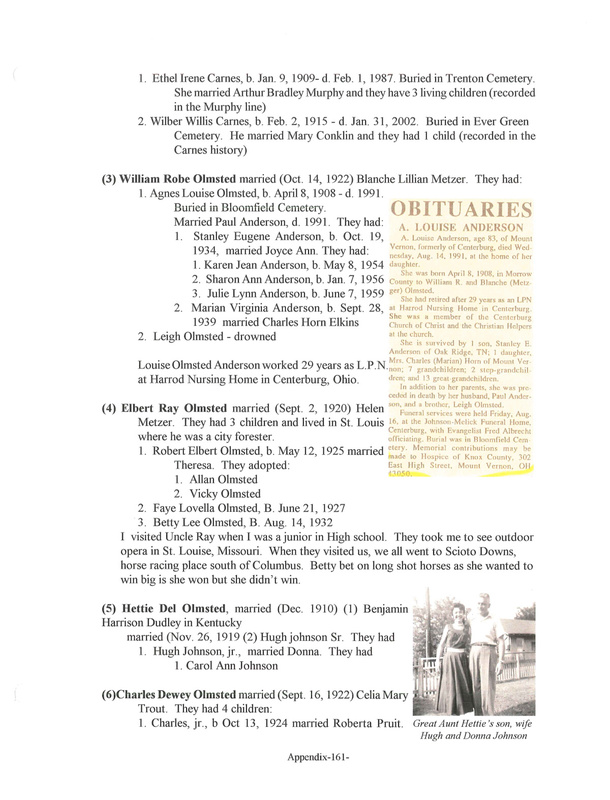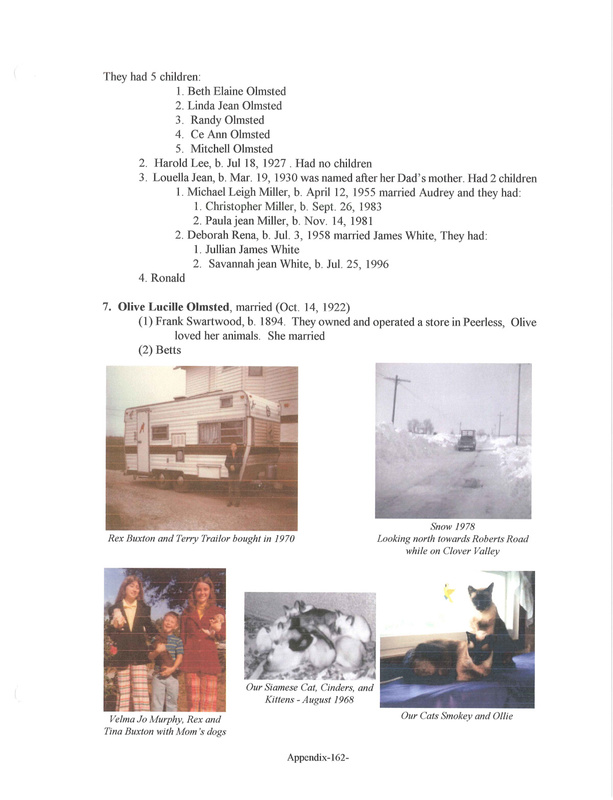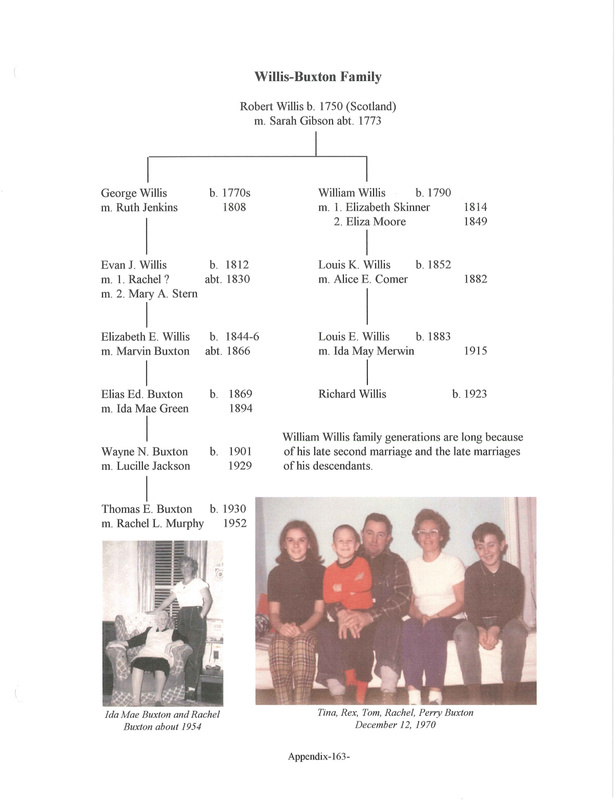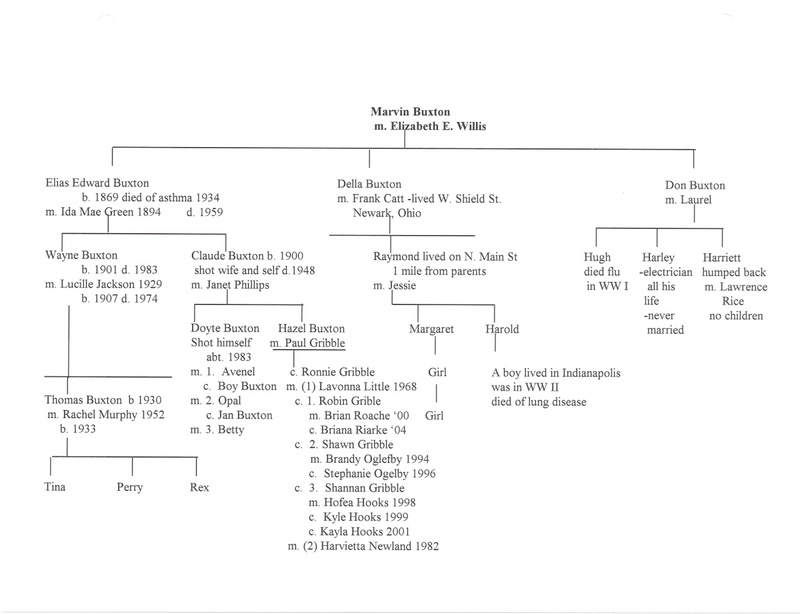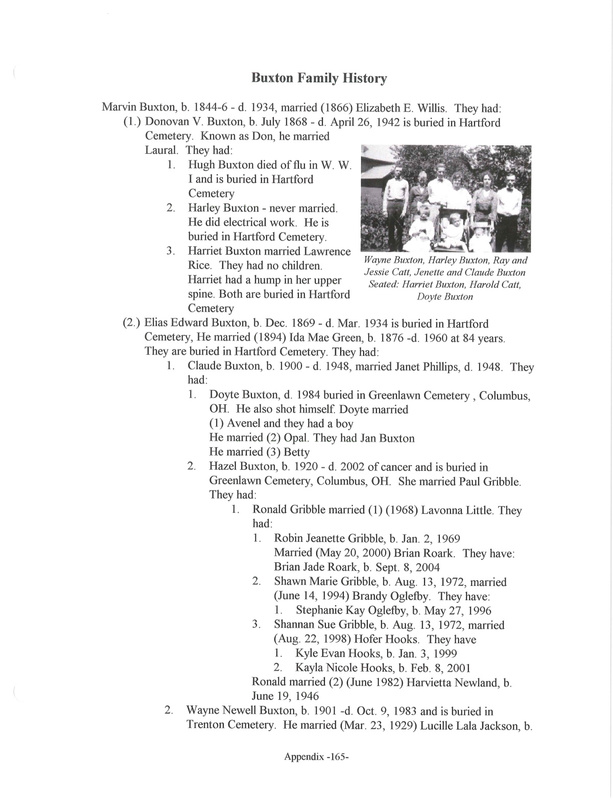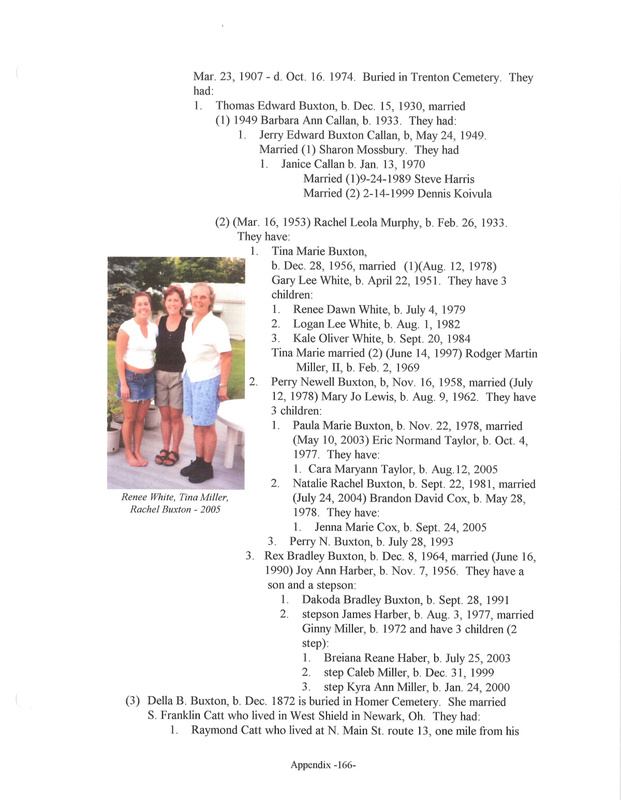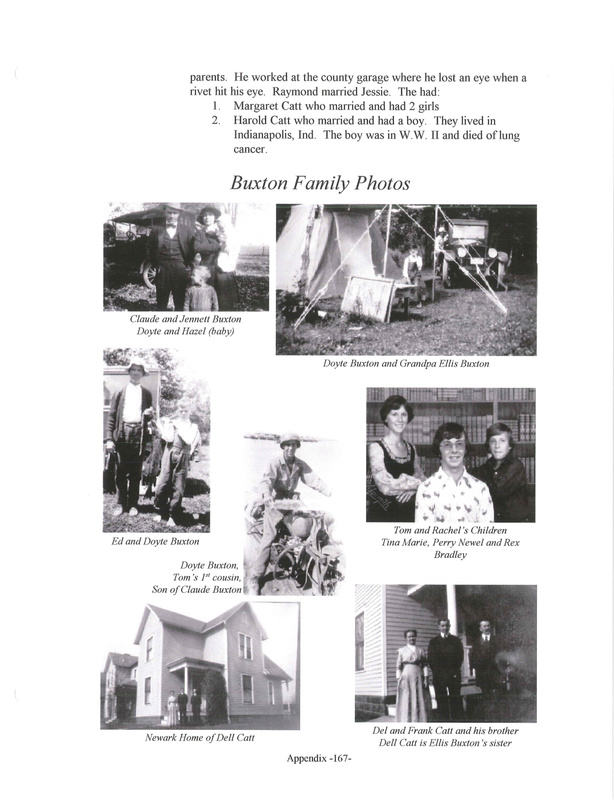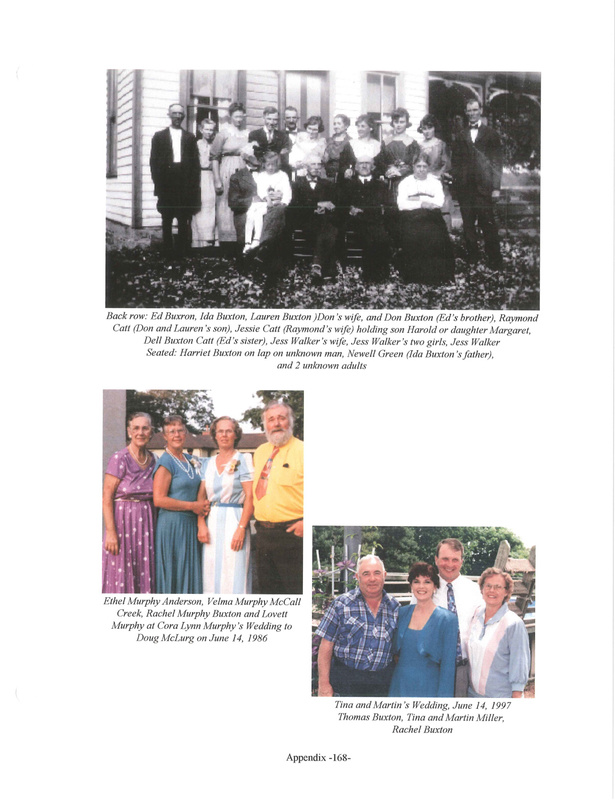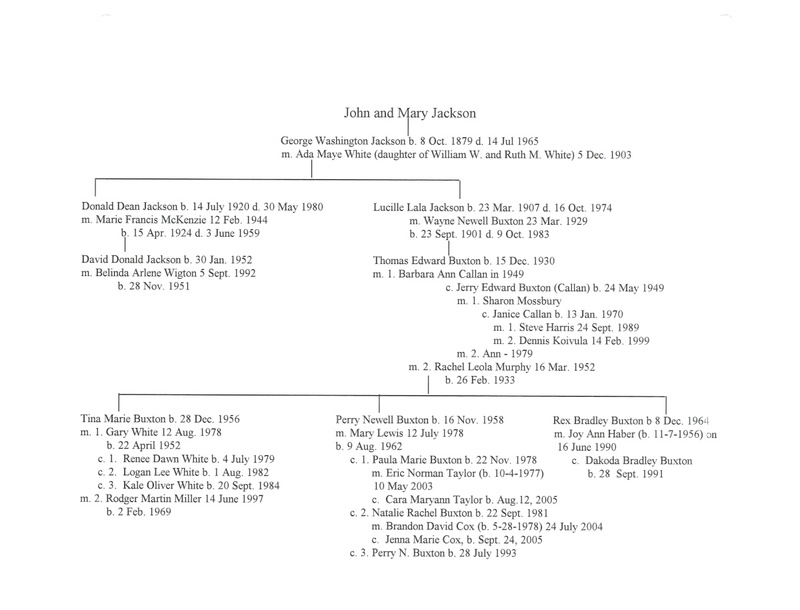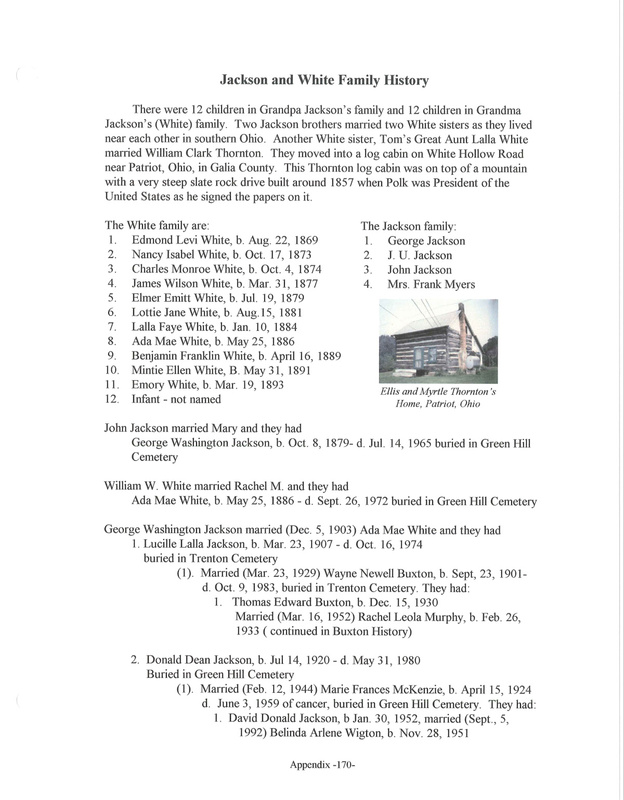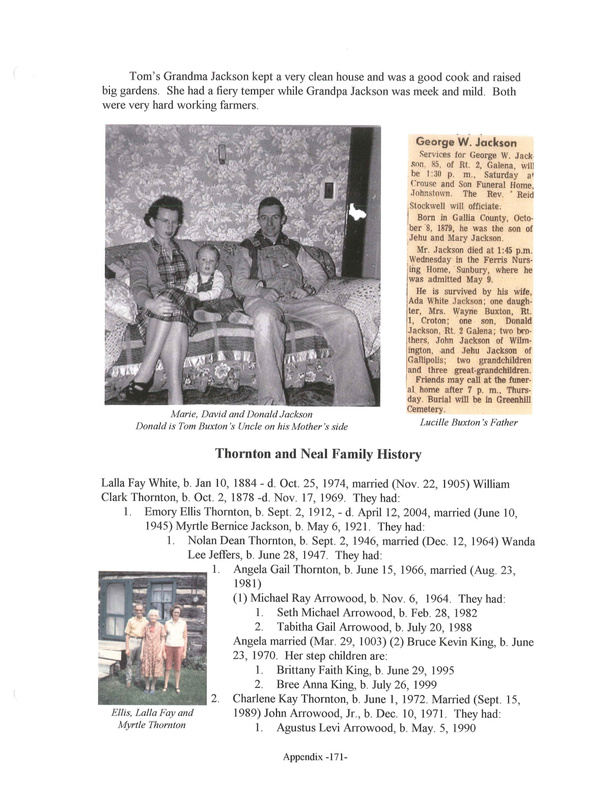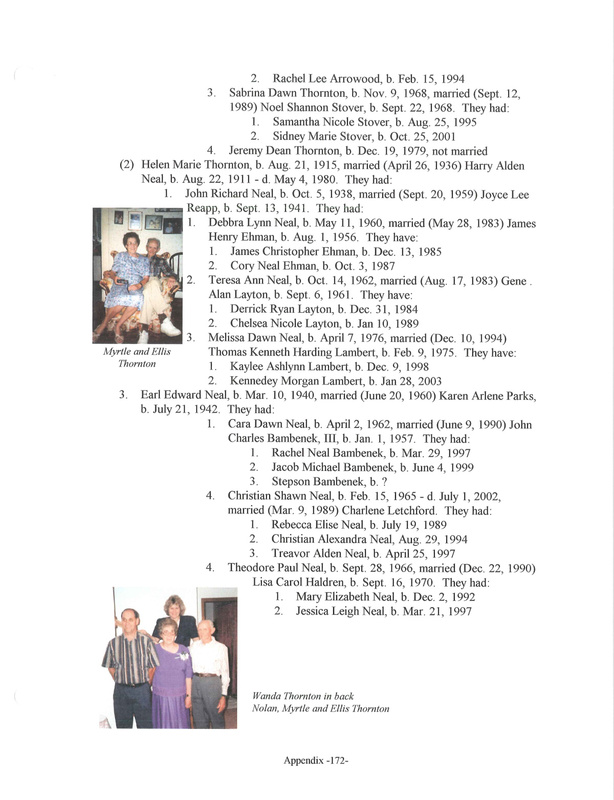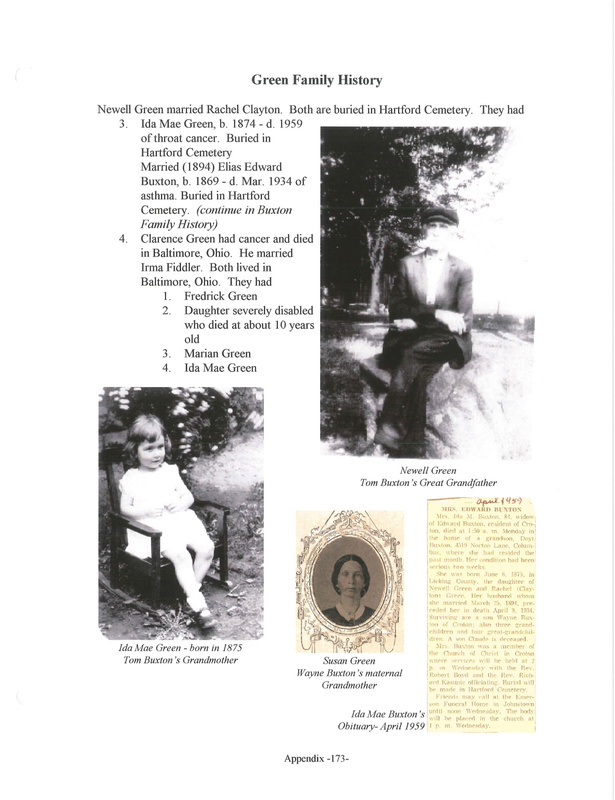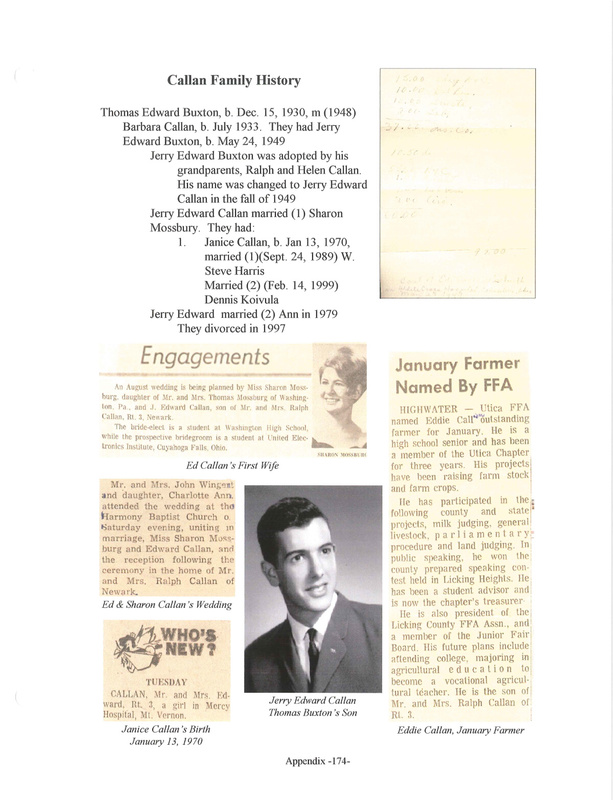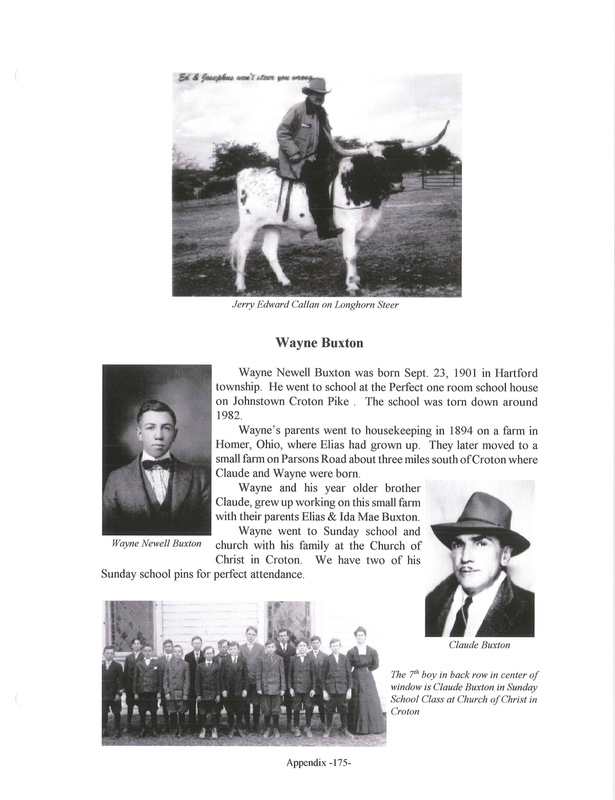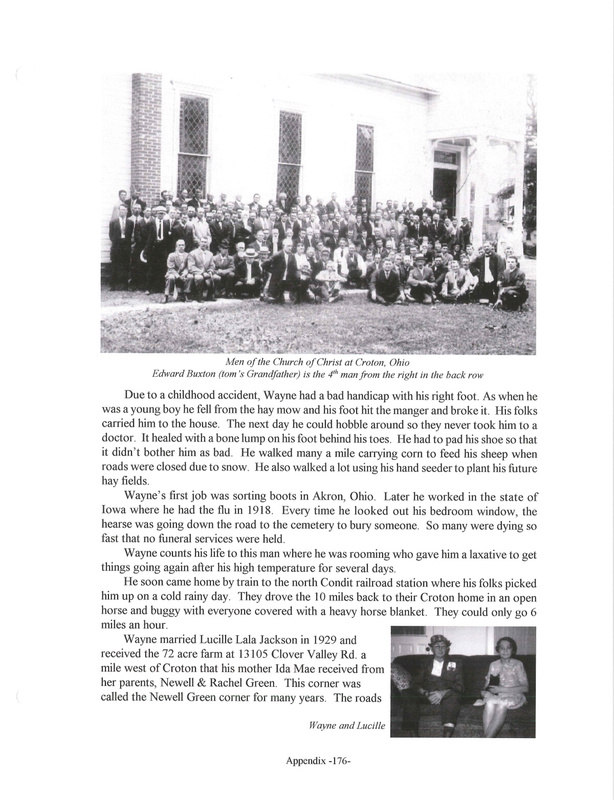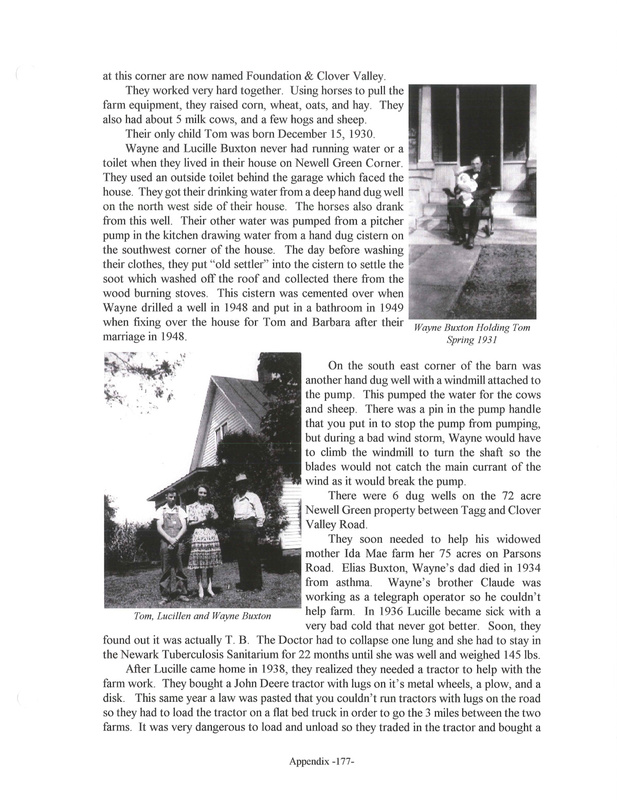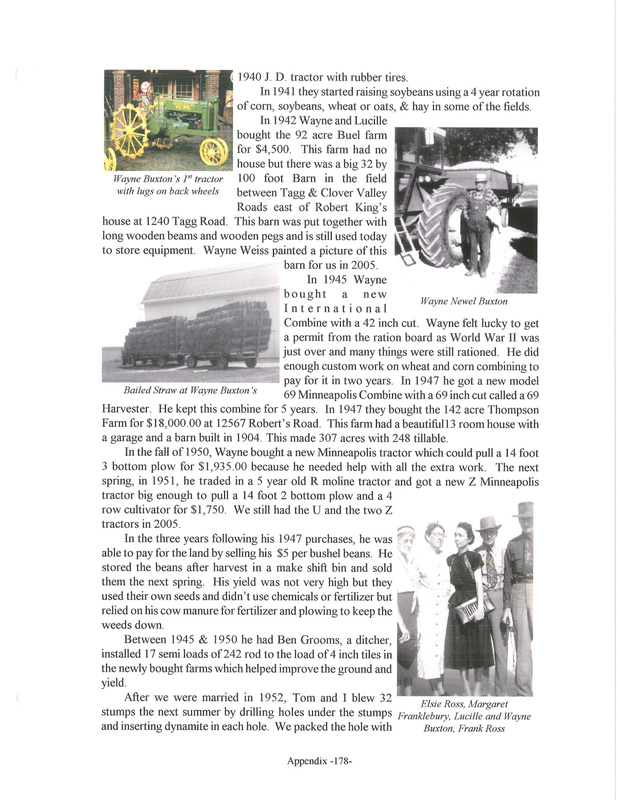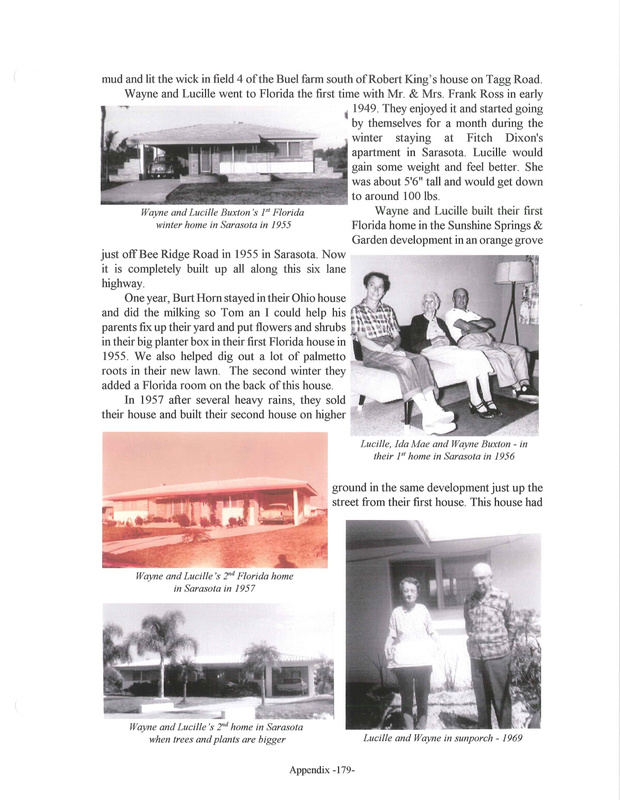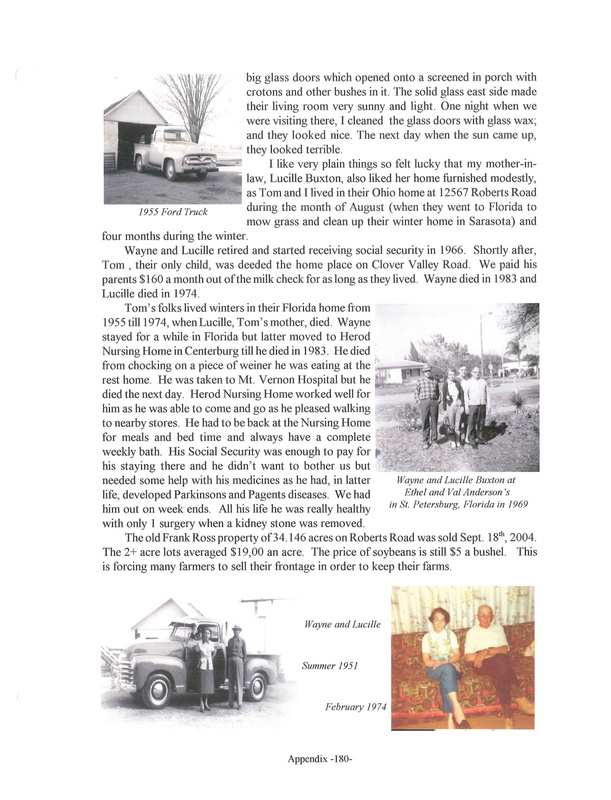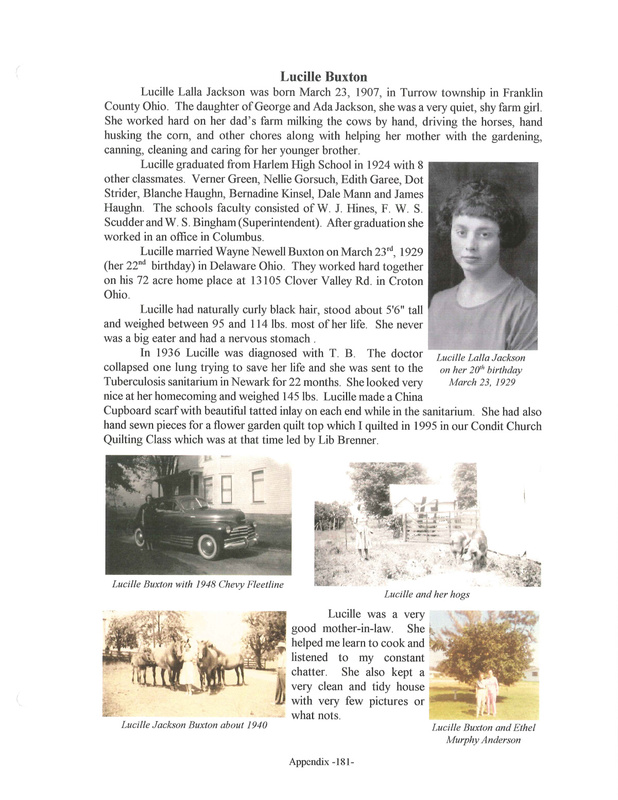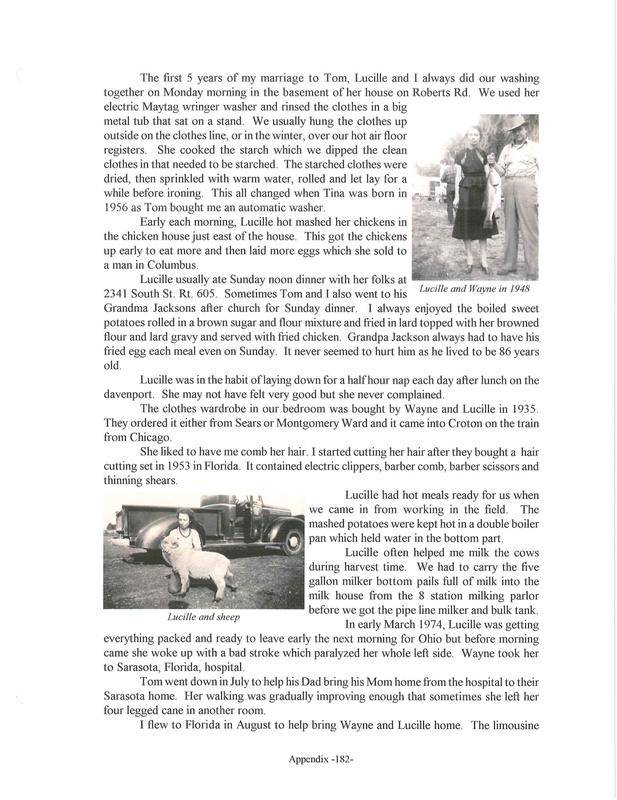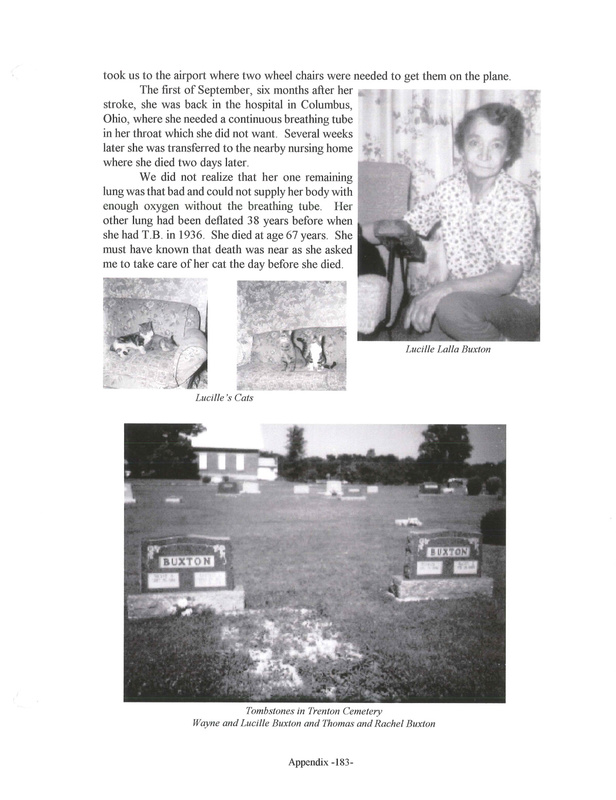Pages of Our Lives... Farming: a Way of Life
Title
Pages of Our Lives... Farming: a Way of Life (p. 1)
Description
[page 1]
[corresponds to title page of Pages of Our Lives]
Pages of Our Lives
[image]
Farming a Way of Life
by
Rachel Murphy Buxton
Community Library
Sunbury, Ohio
2005
[corresponds to title page of Pages of Our Lives]
Pages of Our Lives
[image]
Farming a Way of Life
by
Rachel Murphy Buxton
Community Library
Sunbury, Ohio
2005
Title
Pages of Our Lives... Farming: a Way of Life (p. 2)
Description
[page 2]
[corresponds to page -i- of Pages of Our Lives]
Table of Contents
Rachel's Story
My Childhood .............................................. 1
Maple Syrup Making at the Murphy Woods .................... 7
Condit Presbyterian Church ................................ 8
Other Childhood Memories .................................. 9
Rachel's School Days ...................................... 12
More Childhood Memories ................................... 20
Threshing and Silo Filling Rings .......................... 21
Memories of Dad ............................................ 22
Memories of Mom............................................. 24
Tom Enters My Life.......................................... 27
Tom Buxton.......................................................... 29
Jerry Edwards............................................... 31
Tom's First Florida Trip.................................... 32
Marriage............................................................ 34
Children............................................................. 35
Family Homes
Thomas Buxton House......................................... 36
Rex and Joy Buxton's House.................................. 39
Vacations........................................................... 40
Medical History
Rachel's Medical History.................................... 43
Tom's Medical History....................................... 48
Cancer in My Family......................................... 50
Memorable Moments in Our Family..................................... 50
Appendix
Other Papers by Rachel
Program for Friendly Club ................................... 51
My Great Uncle Lovett ....................................... 54
By Other Murpheys
Lovett Taft Murphy ...................................... 56
What May Be Done to Improve the Social, Moral and Intellectual Condition
of the Farm by L.T Murphy ............................ 59
Ella Murphy's Tape ........................................ 62
Letter from Abram and Mary Ann Adams to Linnie Murphy ..... 72
Letter to Melinda Ball Murphey ...............................73
Abram and Mary Ann Adams Epilogue .............................75
Grace Chadwick Murphey's Memorial Service .....................76
Yesterday, Today and Tomorrow by Velma Murphy McCall Creech ...84
Lovett Murphy: A Step Back in Time ...........................101
[corresponds to page -i- of Pages of Our Lives]
Table of Contents
Rachel's Story
My Childhood .............................................. 1
Maple Syrup Making at the Murphy Woods .................... 7
Condit Presbyterian Church ................................ 8
Other Childhood Memories .................................. 9
Rachel's School Days ...................................... 12
More Childhood Memories ................................... 20
Threshing and Silo Filling Rings .......................... 21
Memories of Dad ............................................ 22
Memories of Mom............................................. 24
Tom Enters My Life.......................................... 27
Tom Buxton.......................................................... 29
Jerry Edwards............................................... 31
Tom's First Florida Trip.................................... 32
Marriage............................................................ 34
Children............................................................. 35
Family Homes
Thomas Buxton House......................................... 36
Rex and Joy Buxton's House.................................. 39
Vacations........................................................... 40
Medical History
Rachel's Medical History.................................... 43
Tom's Medical History....................................... 48
Cancer in My Family......................................... 50
Memorable Moments in Our Family..................................... 50
Appendix
Other Papers by Rachel
Program for Friendly Club ................................... 51
My Great Uncle Lovett ....................................... 54
By Other Murpheys
Lovett Taft Murphy ...................................... 56
What May Be Done to Improve the Social, Moral and Intellectual Condition
of the Farm by L.T Murphy ............................ 59
Ella Murphy's Tape ........................................ 62
Letter from Abram and Mary Ann Adams to Linnie Murphy ..... 72
Letter to Melinda Ball Murphey ...............................73
Abram and Mary Ann Adams Epilogue .............................75
Grace Chadwick Murphey's Memorial Service .....................76
Yesterday, Today and Tomorrow by Velma Murphy McCall Creech ...84
Lovett Murphy: A Step Back in Time ...........................101
Title
Pages of Our Lives... Farming: a Way of Life (p. 3)
Description
[page 3]
[corresponds to page -ii- of Pages of Our Lives]
Rachel Murphy's Ancestors ............................................... 103
Murphy Family Tree ...................................................... 105
My Ancestors ..................................................... 106
The Murphy Tree by Grace Chadwick Murphy ......................... 107
Murphy Family History ............................................ 111
Farrah Murphy's Papers ........................................... 127
History of Trenton Township by Farrah Murphy ................. 129
Scenes from My Childhood by Farrah Murphy .................... 134
Farrah C. Murphy by Ella Murphy Taylor ........................... 135
Chadwick and Loren Family Tree .......................................... 138
Loren History .................................................... 139
Loren History by Grace C. Murphy ................................. 140
Chadwick Family History .......................................... 143
Chadwick Family for Sunbury Bicentennial ......................... 144
Carnes and Olmsted Family Tree .......................................... 149
Emmitt and Melissa Carnes Family History ......................... 150
Joe Carnes ....................................................... 156
Maple Crest Farm ................................................. 158
Olmsted Family History ........................................... 159
Willis Buxton Family .................................................... 163
Marvin Buxton's Descendants ...................................... 164
Buxton Family History ............................................ 165
Buxton Family Photos ............................................. 167
John and Mary Jackson's Descendants ..................................... 169
Jackson and White Family History ........................................ 170
Thornton and Neal Family History ........................................ 171
Green Family History .................................................... 173
Callan Family History ................................................... 174
Wayne Buxton ...................................................... 175
Lucille Buxton .................................................... 181
[corresponds to page -ii- of Pages of Our Lives]
Rachel Murphy's Ancestors ............................................... 103
Murphy Family Tree ...................................................... 105
My Ancestors ..................................................... 106
The Murphy Tree by Grace Chadwick Murphy ......................... 107
Murphy Family History ............................................ 111
Farrah Murphy's Papers ........................................... 127
History of Trenton Township by Farrah Murphy ................. 129
Scenes from My Childhood by Farrah Murphy .................... 134
Farrah C. Murphy by Ella Murphy Taylor ........................... 135
Chadwick and Loren Family Tree .......................................... 138
Loren History .................................................... 139
Loren History by Grace C. Murphy ................................. 140
Chadwick Family History .......................................... 143
Chadwick Family for Sunbury Bicentennial ......................... 144
Carnes and Olmsted Family Tree .......................................... 149
Emmitt and Melissa Carnes Family History ......................... 150
Joe Carnes ....................................................... 156
Maple Crest Farm ................................................. 158
Olmsted Family History ........................................... 159
Willis Buxton Family .................................................... 163
Marvin Buxton's Descendants ...................................... 164
Buxton Family History ............................................ 165
Buxton Family Photos ............................................. 167
John and Mary Jackson's Descendants ..................................... 169
Jackson and White Family History ........................................ 170
Thornton and Neal Family History ........................................ 171
Green Family History .................................................... 173
Callan Family History ................................................... 174
Wayne Buxton ...................................................... 175
Lucille Buxton .................................................... 181
Title
Pages of Our Lives... Farming: a Way of Life (p. 4)
Description
[page 4]
[corresponds to page 1 of Pages of Our Lives]
My Childhood
[photo]
[photo caption]
Home of Rachel Murphy Buxton 140 acres on the north side of road
105 acres on the side of road is 50 acre wood and 55 acres farm land
only the house, garage and chicken house behind the house remain in 2005
I, Rachel Leola Murphy, was born Feb. 26, 1933 at home in the 1st house on
Murphy Road where I lived all my childhood.
I was a happy child at home, never getting angry except I hated to be teased.
The kids on the school bus would call me "Little Art" as looked like Daddy.
Another time my brother, Lovett, teased me and I chased him around our house with a
butcher knife. Mother was afraid I would fall on it as I was pigeon-toes.
I had to wear shoes to correct it. They were always kept under the bed in the tiny
downstairs bedroom in the southwest corner of the house.
I loved to clean so many times I was sweeping the stone around the back porch,
where the eaves ran down, to make them look neater. One time I found some old
money (Indian heads) while sweeping.
We had a fenced in chicken lot to the north of the house which had the
chicken house, fruit orchard, and the back house in it. The back house had
two holes, one large and one small. This was our only toilet until we had an
inside toilet put in Sept. 1944 with one stool upstairs and a small bathroom
downstairs out of the little bedroom.
I loved to sickle the weeds in the chicken lot as I didn't like the
looks of the big nettle weeds which liked to grow there. Dad only cut
the bull thistles. One day I was sickling too hard and ran the
point of the sickle into the side on my left knee. I also had trouble
going to the toilet in the back house as the roosters and cross
ganders would always chase me when I was little so I always had to
get someone to walk with me.
I remember when they had to have our chickens vaccinated for cocidiosis.
It took a long time to catch every chicken to vaccinate and put a leg
leg band on them. We always fed the chickens boughten oyster shells besides our
own ear corn which we had to shell. We had to carry ear corn from the corn crib
across the road south of the house clear up the long yard and down the path to
the chicken house each day.
We had a large yard with the house sitting at the top of a big even rolling
bank going
[photo]
[photo caption]
Rachel Leola Murphy
-1-
[corresponds to page 1 of Pages of Our Lives]
My Childhood
[photo]
[photo caption]
Home of Rachel Murphy Buxton 140 acres on the north side of road
105 acres on the side of road is 50 acre wood and 55 acres farm land
only the house, garage and chicken house behind the house remain in 2005
I, Rachel Leola Murphy, was born Feb. 26, 1933 at home in the 1st house on
Murphy Road where I lived all my childhood.
I was a happy child at home, never getting angry except I hated to be teased.
The kids on the school bus would call me "Little Art" as looked like Daddy.
Another time my brother, Lovett, teased me and I chased him around our house with a
butcher knife. Mother was afraid I would fall on it as I was pigeon-toes.
I had to wear shoes to correct it. They were always kept under the bed in the tiny
downstairs bedroom in the southwest corner of the house.
I loved to clean so many times I was sweeping the stone around the back porch,
where the eaves ran down, to make them look neater. One time I found some old
money (Indian heads) while sweeping.
We had a fenced in chicken lot to the north of the house which had the
chicken house, fruit orchard, and the back house in it. The back house had
two holes, one large and one small. This was our only toilet until we had an
inside toilet put in Sept. 1944 with one stool upstairs and a small bathroom
downstairs out of the little bedroom.
I loved to sickle the weeds in the chicken lot as I didn't like the
looks of the big nettle weeds which liked to grow there. Dad only cut
the bull thistles. One day I was sickling too hard and ran the
point of the sickle into the side on my left knee. I also had trouble
going to the toilet in the back house as the roosters and cross
ganders would always chase me when I was little so I always had to
get someone to walk with me.
I remember when they had to have our chickens vaccinated for cocidiosis.
It took a long time to catch every chicken to vaccinate and put a leg
leg band on them. We always fed the chickens boughten oyster shells besides our
own ear corn which we had to shell. We had to carry ear corn from the corn crib
across the road south of the house clear up the long yard and down the path to
the chicken house each day.
We had a large yard with the house sitting at the top of a big even rolling
bank going
[photo]
[photo caption]
Rachel Leola Murphy
-1-
Title
Pages of Our Lives... Farming: a Way of Life (p. 5)
Description
[page 5]
[corresponds to page 2 of Pages of Our Lives]
south down to the road and then real sharp, short banks going up to the the road.
We would stand in the road and let the lawn mower go down the hill and then pull it
back up. We would repeat this on the bank clear across the south side of the yard.
It took us three kids all day Saturday to mow the yard and we took turns pushing the
hand lawnmower around the big rectangle patch that we mowed.
We had a old day bed with wire springs that we played on while out folks milked.
We would also go round and around a pole in the milking parlor. I never learned to
be a good hand miler as I was too young. I remember helping Daddy with the milking
after my sister, Velma went to Cadet Nurses' Training in 1945 at Muskingum College
and Bethesda Hospital for 3 years. We used the 2 five gallon stainless steel
buckets with the De La Val milking machine. Dad and I would carry 2 or 3 milk
can, strainer and the 2 milk buckets down the hill to milk. We would put the
strainer pad in the strainer, set it in the milk can and start milking. Dad
always squeezed the milk out of the dirty strainer pad and fed the barn cats
milk when we were done milking. Then we had to carry all the cans and equipment
back up the hill to the milk house. We rinsed the milkers with cold water at
night but they had to washed with hot water and soap each morning. The full
ten gallon milk cans were hard to carry up the sharp rocky path to the milk
house and then set them into the cement water tank to cool before the milk man
picked them up each day. Later we got the ice bank milk cooler to cool the
milk. It was hard to lift the cans in and out of the cooler ever though
the milk cooler was set lower in the cement floor of the milk house.
I used to sing all the while we milked as I always listened to the hit parade
on the barn radio. I knew all the popular songs by heart many sang by Frank
Sinatra. Sometimes Dad would help me with my homework especially algebra if I had
a problem, while milking.
We put a pail full of ground feed, using an old 5 gallon calf a pail, into
each of the six wooden stanchions. We would call the cows each in separately to
milk two cows at a time. The cows knew their names and came in in the same order
each milking. There was a long cutout place in the cement on the floor back of
the cows that we called the gutter to catch and hold the cow manure. Each morning
I swept the milking parlor floor which we limed and cleaned the gutter out with a
scoop shovel. The walls of the milking parlor were white-washed every year or two
especially if the milk inspector ordered it done.
In 1962 when Dad was sick in the hospital with his cancer, the man hired to
milk tried to drive the cows into the milking parlor to milk. The hired man had
so much trouble I got all the names of the cows from Dad and I called them in and
helped milk Dad got home. Cows habits are hard to change. We had one cow who would
take her tongue and lick open the sliding barn door that fastened with a metal
ring that hooked over a bolt sticking out of the cement sidewall. One very cold day
her tongue froze to the metal ring. She never tried to open the door to eat feed
again.
I have many happy memories of helping Daddy milk as loved the cows and made
pets out of all the heifer calves that we raised. We always had calves to feed. We
[photo]
[photo caption]
Rachel with pet calf in front of coal house in the backyard
-2-
[corresponds to page 2 of Pages of Our Lives]
south down to the road and then real sharp, short banks going up to the the road.
We would stand in the road and let the lawn mower go down the hill and then pull it
back up. We would repeat this on the bank clear across the south side of the yard.
It took us three kids all day Saturday to mow the yard and we took turns pushing the
hand lawnmower around the big rectangle patch that we mowed.
We had a old day bed with wire springs that we played on while out folks milked.
We would also go round and around a pole in the milking parlor. I never learned to
be a good hand miler as I was too young. I remember helping Daddy with the milking
after my sister, Velma went to Cadet Nurses' Training in 1945 at Muskingum College
and Bethesda Hospital for 3 years. We used the 2 five gallon stainless steel
buckets with the De La Val milking machine. Dad and I would carry 2 or 3 milk
can, strainer and the 2 milk buckets down the hill to milk. We would put the
strainer pad in the strainer, set it in the milk can and start milking. Dad
always squeezed the milk out of the dirty strainer pad and fed the barn cats
milk when we were done milking. Then we had to carry all the cans and equipment
back up the hill to the milk house. We rinsed the milkers with cold water at
night but they had to washed with hot water and soap each morning. The full
ten gallon milk cans were hard to carry up the sharp rocky path to the milk
house and then set them into the cement water tank to cool before the milk man
picked them up each day. Later we got the ice bank milk cooler to cool the
milk. It was hard to lift the cans in and out of the cooler ever though
the milk cooler was set lower in the cement floor of the milk house.
I used to sing all the while we milked as I always listened to the hit parade
on the barn radio. I knew all the popular songs by heart many sang by Frank
Sinatra. Sometimes Dad would help me with my homework especially algebra if I had
a problem, while milking.
We put a pail full of ground feed, using an old 5 gallon calf a pail, into
each of the six wooden stanchions. We would call the cows each in separately to
milk two cows at a time. The cows knew their names and came in in the same order
each milking. There was a long cutout place in the cement on the floor back of
the cows that we called the gutter to catch and hold the cow manure. Each morning
I swept the milking parlor floor which we limed and cleaned the gutter out with a
scoop shovel. The walls of the milking parlor were white-washed every year or two
especially if the milk inspector ordered it done.
In 1962 when Dad was sick in the hospital with his cancer, the man hired to
milk tried to drive the cows into the milking parlor to milk. The hired man had
so much trouble I got all the names of the cows from Dad and I called them in and
helped milk Dad got home. Cows habits are hard to change. We had one cow who would
take her tongue and lick open the sliding barn door that fastened with a metal
ring that hooked over a bolt sticking out of the cement sidewall. One very cold day
her tongue froze to the metal ring. She never tried to open the door to eat feed
again.
I have many happy memories of helping Daddy milk as loved the cows and made
pets out of all the heifer calves that we raised. We always had calves to feed. We
[photo]
[photo caption]
Rachel with pet calf in front of coal house in the backyard
-2-
Title
Pages of Our Lives... Farming: a Way of Life (p. 6)
Description
[page 6]
[corresponds to page 3 of Pages of Our Lives]
mixed water with the dry calf feed called Calf A for the little calves in place
of milk which we fed the calves as soon as we could sell their mothers milk. The
mother's milk was fed to the newly born calves which contained colustrum for the
first four to six days after freshening.
We kids took turns in the summer time walking the cows down the long lane to
the woods for the day. It took about a half an hour to do this. Then at night we
would turn the cows across the road from the barn into the pasture field north west
of our house after we milked.
I never liked to watch the cows in the clover field west of the barn when it
was in hay. We had to watch them usually an hour. There were no fences at the
east end of the field so we and to sit and wait while the cows ate they would not
get out and into the cornfield across the barn lot. One taste of corn and you
could not keep them in the clover field.
In the winter we had to throw down the loose straw from the straw mow in the
barn above the cows to bed the cows. Then we had to throw down the loose hay from
the hay mow to feed them in the manger and also had to climb the ribbed wooden silo
rings and shovel out silage into a cart. Then push the cart in front of the long
row of stanchions along the north wall of the barn. We would pitch a shovel silage
in for each cow along with hay we had carried over to the mangers.
The cows were kept in the barn all winter this made a lot of manure mixed
with the straw to haul out in the manure spreader to spread on the fields. Dad
Pitched the packed manure into the manure spreader with a 4-tined pitch fork.
We each got a bottle of homemade canned root beer when we helped Dad pitch a load
of manure. It meant a lot in later years when a neighbor, Charles Chamberlin,
was paid to load the manure spreader with his tractor with a manure bucket in the
front as Dad might have 100 loads of manure to haul in the spring.
We ate a lot of rabbits and squirrels during the hunting season. Many times
we had chickens when they were killed on the road as cars would pop over the hill
from the east and hit them. The hill in the road was widened and the hill lowered
in 1996. We butchered a beef each year sometimes a hog. We rented a food locker
in Delaware, Ohio, and then later rented a locker in Sunbury after one was built
there.
We had a grocery man who came every two weeks. We would order our sugar,
salt, flour, spices, vanilla, cocoa and peanut butter.
My sister , Velma, liked to help mother can food and cook while I liked to
work in the garden and clean. When we had to clean our rooms each weekend, I
would have mine done early and Velma always waited until she had to do it. When
Velma would cook and bake and make lots of dirty dishes I would wash the dishes
and clean up the kitchen.
I remember staying Grandma Murphys on the hill. I liked to sort the funny
papers (we didn't get a paper) out in their old northeast unfinished store room
on the ground level.
Grandma always liked to work crossword puzzles and study the Bible. In
later life she became a Christian Scientist.
One time I stayed while the rest of our family to the Coney Island as I
had to go to much to take on a trip. Grandma and I lay down one afternoon for
a nap and she said, "Let's see who can go to sleep first." Of
[photo]
[photo caption]
Grace Chadwick Murphy, 1930]
-3-
[corresponds to page 3 of Pages of Our Lives]
mixed water with the dry calf feed called Calf A for the little calves in place
of milk which we fed the calves as soon as we could sell their mothers milk. The
mother's milk was fed to the newly born calves which contained colustrum for the
first four to six days after freshening.
We kids took turns in the summer time walking the cows down the long lane to
the woods for the day. It took about a half an hour to do this. Then at night we
would turn the cows across the road from the barn into the pasture field north west
of our house after we milked.
I never liked to watch the cows in the clover field west of the barn when it
was in hay. We had to watch them usually an hour. There were no fences at the
east end of the field so we and to sit and wait while the cows ate they would not
get out and into the cornfield across the barn lot. One taste of corn and you
could not keep them in the clover field.
In the winter we had to throw down the loose straw from the straw mow in the
barn above the cows to bed the cows. Then we had to throw down the loose hay from
the hay mow to feed them in the manger and also had to climb the ribbed wooden silo
rings and shovel out silage into a cart. Then push the cart in front of the long
row of stanchions along the north wall of the barn. We would pitch a shovel silage
in for each cow along with hay we had carried over to the mangers.
The cows were kept in the barn all winter this made a lot of manure mixed
with the straw to haul out in the manure spreader to spread on the fields. Dad
Pitched the packed manure into the manure spreader with a 4-tined pitch fork.
We each got a bottle of homemade canned root beer when we helped Dad pitch a load
of manure. It meant a lot in later years when a neighbor, Charles Chamberlin,
was paid to load the manure spreader with his tractor with a manure bucket in the
front as Dad might have 100 loads of manure to haul in the spring.
We ate a lot of rabbits and squirrels during the hunting season. Many times
we had chickens when they were killed on the road as cars would pop over the hill
from the east and hit them. The hill in the road was widened and the hill lowered
in 1996. We butchered a beef each year sometimes a hog. We rented a food locker
in Delaware, Ohio, and then later rented a locker in Sunbury after one was built
there.
We had a grocery man who came every two weeks. We would order our sugar,
salt, flour, spices, vanilla, cocoa and peanut butter.
My sister , Velma, liked to help mother can food and cook while I liked to
work in the garden and clean. When we had to clean our rooms each weekend, I
would have mine done early and Velma always waited until she had to do it. When
Velma would cook and bake and make lots of dirty dishes I would wash the dishes
and clean up the kitchen.
I remember staying Grandma Murphys on the hill. I liked to sort the funny
papers (we didn't get a paper) out in their old northeast unfinished store room
on the ground level.
Grandma always liked to work crossword puzzles and study the Bible. In
later life she became a Christian Scientist.
One time I stayed while the rest of our family to the Coney Island as I
had to go to much to take on a trip. Grandma and I lay down one afternoon for
a nap and she said, "Let's see who can go to sleep first." Of
[photo]
[photo caption]
Grace Chadwick Murphy, 1930]
-3-
Title
Pages of Our Lives... Farming: a Way of Life (p. 7)
Description
[page 7]
[corresponds to page 4 of Pages of Our Lives]
course it was me. As a family we always went to Delaware once a month
to get our meat from the locker, have an ice cream cone on the way and
maybe see a movie at the Strand Theater. In late years we went to Dorsey
Theatre in Johnstown. I always had to sit in the end seat so I could go
to the restroom with disturbing everyone during the movie. I couldn't go
to Centerburg movies as they didn't have a restroom.
We picked always picked up hickory nut each fall in our woods as a
family. In the spring we went to the woods to see the spring flowers and
gather pawpaws to eat. In the summer we went our wood s to pick black-
berries for mom to can and later years to sell.
Mother had an electric Maytag washer and used a big square metal tub
sitting on a small wooden table to rinse the clothes in. This same rinse
tub was used for our weekly bath when we were little. We all used the
same water, just adding hot water as it cooled down.
We had lots of pets when we were young, I remember 2 dogs, Bobbie and
Bingo which were both small black and white, short haired dogs. Lovett had
some coon dogs and a pet crow. I also had a pet lamb and pet mouse. We had
no pet cats as we just had what we called barn cats. I especially remember
Mary Ellen who lived to be 25 years old with not teeth but still had kittens
every year.
When Wilma Carnes, my second cousin, and I played, one day in the sand pit
at the bottom of the hill, we had slid down it so much on our seats we decided
to wash our panties in the water tank in the milk house. I don't remember Dad
ever scolding me for it.
When us 3 kids would climb the ladder up to the haymow from the barn floor
my legs were too short and I had a hard climbing the steps when we came to the
big beam with no steps, but I never fell.
As children, my sister, brother and I were not allowed to have a bicycle
since our neighbor on 605, Charles Barton, was killed on his bike in an automobile
accident.
We played games with Ted Gray, our neighbor who also lived on 605. He was a
year older than my brother. We played hide and seek, and Velma and Lovett got to
ride his bike and horse in our yard. I didn't get to do as many things since I was
the baby being 5 yrs. younger than Velma and 2 years younger than Lovett.
One time time I went with Lovett to check his traps and he caught a skunk which
we carried home. Mother made us change our clothes in the backhouse we smelled so
bad.
Every day when I got home from school I'd run upstairs and listen to my radio
shows. I also loved to listen to Let's Pretend on Saturdays.
I never got to stay all night with classmates except two times. Once with Nancy
Williamson and once with Mary Lou Forgraves. they both lived in Sunbury. Mary Lou
then got to stay at our house one night. I still remember how afraid she was of our
chickens as she had never been in the country before.
Our family never ate out so one time when I got to buy my lunch at school in
downtown Sunbury with Joan Crowl it was very special. I had never had a boughten
hamburger or milk shake before.
I also remember of being in our Church's Prince of Peace speaking contests
in the 8th and 9th grades. It was a 10 minute speech we memorized and spoke up
front in a contest held at
[photo]
[photo caption]
I remember getting burned with my first permanent which was given like this. I was
in the 5th grade.
-4-
[corresponds to page 4 of Pages of Our Lives]
course it was me. As a family we always went to Delaware once a month
to get our meat from the locker, have an ice cream cone on the way and
maybe see a movie at the Strand Theater. In late years we went to Dorsey
Theatre in Johnstown. I always had to sit in the end seat so I could go
to the restroom with disturbing everyone during the movie. I couldn't go
to Centerburg movies as they didn't have a restroom.
We picked always picked up hickory nut each fall in our woods as a
family. In the spring we went to the woods to see the spring flowers and
gather pawpaws to eat. In the summer we went our wood s to pick black-
berries for mom to can and later years to sell.
Mother had an electric Maytag washer and used a big square metal tub
sitting on a small wooden table to rinse the clothes in. This same rinse
tub was used for our weekly bath when we were little. We all used the
same water, just adding hot water as it cooled down.
We had lots of pets when we were young, I remember 2 dogs, Bobbie and
Bingo which were both small black and white, short haired dogs. Lovett had
some coon dogs and a pet crow. I also had a pet lamb and pet mouse. We had
no pet cats as we just had what we called barn cats. I especially remember
Mary Ellen who lived to be 25 years old with not teeth but still had kittens
every year.
When Wilma Carnes, my second cousin, and I played, one day in the sand pit
at the bottom of the hill, we had slid down it so much on our seats we decided
to wash our panties in the water tank in the milk house. I don't remember Dad
ever scolding me for it.
When us 3 kids would climb the ladder up to the haymow from the barn floor
my legs were too short and I had a hard climbing the steps when we came to the
big beam with no steps, but I never fell.
As children, my sister, brother and I were not allowed to have a bicycle
since our neighbor on 605, Charles Barton, was killed on his bike in an automobile
accident.
We played games with Ted Gray, our neighbor who also lived on 605. He was a
year older than my brother. We played hide and seek, and Velma and Lovett got to
ride his bike and horse in our yard. I didn't get to do as many things since I was
the baby being 5 yrs. younger than Velma and 2 years younger than Lovett.
One time time I went with Lovett to check his traps and he caught a skunk which
we carried home. Mother made us change our clothes in the backhouse we smelled so
bad.
Every day when I got home from school I'd run upstairs and listen to my radio
shows. I also loved to listen to Let's Pretend on Saturdays.
I never got to stay all night with classmates except two times. Once with Nancy
Williamson and once with Mary Lou Forgraves. they both lived in Sunbury. Mary Lou
then got to stay at our house one night. I still remember how afraid she was of our
chickens as she had never been in the country before.
Our family never ate out so one time when I got to buy my lunch at school in
downtown Sunbury with Joan Crowl it was very special. I had never had a boughten
hamburger or milk shake before.
I also remember of being in our Church's Prince of Peace speaking contests
in the 8th and 9th grades. It was a 10 minute speech we memorized and spoke up
front in a contest held at
[photo]
[photo caption]
I remember getting burned with my first permanent which was given like this. I was
in the 5th grade.
-4-
Title
Pages of Our Lives... Farming: a Way of Life (p. 8)
Description
[page 8]
[corresponds to page 5 of Pages of Our Lives]
Condit Church. My 9th grade speech I remember getting a mid-calf, black
flaired skirt to wear for the contest. Mother made most of my skirts so this
was special. I did not win but enjoyed being in the contests. The skirt length
was in complete contrast with my 4th school year when the 8th grade girls across
the school hall wore mid-thigh length dresses.
I was very little as a child until I started to gain weight rapidly after
the 2nd grade. By the time I was in the seventh grade I weighed 152 pounds and
was 32" around my waist. I was so tired of being called "Chubby", "block buster",
etc., that I made up my mind to lose wight that summer. I ate less and touched
my toes 200 times a day. When I started back to school in the 8th grad I had
lost 20 pounds and 6" around the waist which vowed never to gain back.
I still enjoy exercising and have exercised daily since the early 1970's
when I first started running and doing floor exercised. I changed to at least
15 minutes daily walking nightly floor exercises. I never missed the floor
exercises but did miss walking when it was too cold before going to Florida
in the fall. When we had our 2 siamese cats for 16 years, I never missed a night
as they would wait for me to do the floor exercises so I would hold them for a
few minutes. In 1995, I added weight lifting. I started slowly with 3 lb.
weights which I lifted in seven different motions increasing to 20 times each
way. Then I slowly added 5 lb weights, then 8 lb and sometimes I even use my
10 or 11 lb weights but it seems to take too long so I very seldom us the 10
or 11 lb. weights. I have 2 sets of 3, 5 and 8 lb. wights so I have one set on
the bathroom counter and the other set in the motor home. I look forward to
Listening to Deliah on Sunny 95 radio when I lift weights in the bathroom and watch
T. V. when I lift weights in the motor home.
My junior year I went Y-Teen Camp for a week.
As children Dad always played rook, carrom, checkers and later euchre with
us especially in the winter evenings. We were not allowed to learn to play poker
as this was considered a gambling game.
I never liked to read like my sister, Velma did. In the 4th grade I read the
reading circle books only to get the certificate. I was so disappointed one
Christmas when Aunt Ruth and Uncle Raymond Chadwick gave me a book for Christmas
that I cut a circle around the pages of the book. Sometimes in the 1980's, my
daughter, Tina gave me some Harlequin romance books and I enjoyed reading them.
Then I read "Ashes in the Wind" by Kathleen Woodsworth about the Civil War.
This got me interested in reading good books that I enjoyed and felt I also learned
something. I now have many authors which I enjoy reading their books. I usually
read 15 or 20 long books the four months each winter when we are in Florida.
I find the thicker, best selling books are usually very good.
We had a lot of sledding and ice skating parties on Grandpa's hill and pond
in the pasture field. I din't learn to ice skate until I got my new shoe skate my
freshman year in high school in 1948. The slip-on skates that you put on your
shoes did not give any ankle support.
I remember how us kids used to hunt for our Christmas gifts early. One year
we finally found them in the back of the piano. I remember how pleased I was when
our gas man's, Nick Nichol's wife , made me a little cloth divan and chair with
lift up lids for Christmas. One year we bought a live Christmas tree in a ball of
dirt. It was not very well branched but we made it look nice by decorating in the
holes between the branches. This
[corresponds to page 5 of Pages of Our Lives]
Condit Church. My 9th grade speech I remember getting a mid-calf, black
flaired skirt to wear for the contest. Mother made most of my skirts so this
was special. I did not win but enjoyed being in the contests. The skirt length
was in complete contrast with my 4th school year when the 8th grade girls across
the school hall wore mid-thigh length dresses.
I was very little as a child until I started to gain weight rapidly after
the 2nd grade. By the time I was in the seventh grade I weighed 152 pounds and
was 32" around my waist. I was so tired of being called "Chubby", "block buster",
etc., that I made up my mind to lose wight that summer. I ate less and touched
my toes 200 times a day. When I started back to school in the 8th grad I had
lost 20 pounds and 6" around the waist which vowed never to gain back.
I still enjoy exercising and have exercised daily since the early 1970's
when I first started running and doing floor exercised. I changed to at least
15 minutes daily walking nightly floor exercises. I never missed the floor
exercises but did miss walking when it was too cold before going to Florida
in the fall. When we had our 2 siamese cats for 16 years, I never missed a night
as they would wait for me to do the floor exercises so I would hold them for a
few minutes. In 1995, I added weight lifting. I started slowly with 3 lb.
weights which I lifted in seven different motions increasing to 20 times each
way. Then I slowly added 5 lb weights, then 8 lb and sometimes I even use my
10 or 11 lb weights but it seems to take too long so I very seldom us the 10
or 11 lb. weights. I have 2 sets of 3, 5 and 8 lb. wights so I have one set on
the bathroom counter and the other set in the motor home. I look forward to
Listening to Deliah on Sunny 95 radio when I lift weights in the bathroom and watch
T. V. when I lift weights in the motor home.
My junior year I went Y-Teen Camp for a week.
As children Dad always played rook, carrom, checkers and later euchre with
us especially in the winter evenings. We were not allowed to learn to play poker
as this was considered a gambling game.
I never liked to read like my sister, Velma did. In the 4th grade I read the
reading circle books only to get the certificate. I was so disappointed one
Christmas when Aunt Ruth and Uncle Raymond Chadwick gave me a book for Christmas
that I cut a circle around the pages of the book. Sometimes in the 1980's, my
daughter, Tina gave me some Harlequin romance books and I enjoyed reading them.
Then I read "Ashes in the Wind" by Kathleen Woodsworth about the Civil War.
This got me interested in reading good books that I enjoyed and felt I also learned
something. I now have many authors which I enjoy reading their books. I usually
read 15 or 20 long books the four months each winter when we are in Florida.
I find the thicker, best selling books are usually very good.
We had a lot of sledding and ice skating parties on Grandpa's hill and pond
in the pasture field. I din't learn to ice skate until I got my new shoe skate my
freshman year in high school in 1948. The slip-on skates that you put on your
shoes did not give any ankle support.
I remember how us kids used to hunt for our Christmas gifts early. One year
we finally found them in the back of the piano. I remember how pleased I was when
our gas man's, Nick Nichol's wife , made me a little cloth divan and chair with
lift up lids for Christmas. One year we bought a live Christmas tree in a ball of
dirt. It was not very well branched but we made it look nice by decorating in the
holes between the branches. This
Title
Pages of Our Lives... Farming: a Way of Life (p. 9)
Description
[page 9]
[corresponds to page 6 of Pages of Our Lives]
odd-shaped tree is still growing in front yard of our home place on Murphy road.
The road going east past our house was lined on both sides with locust trees
which touched together in places smelling so good when they bloomed. We had to walk
up to the bottom of the hill to get our mail each day. I loved the walk up the road
at night as it was so pretty. I also like to walk and climb up the big hill in the
pasture fields east of the pond at night and sit and look at the stars and the
moon shining on the pond.
We three kids each had our room upstairs. Velma had the east room, Lovett
had the northwest room and I had the southwest room where the stairway came up
in it. We liked to walk around the ledge around the stairway.
Sometimes we would play in what we called the poke hole closet with its door
just to the right of the top of the step upstairs. This closet ran along the
west side of the southwest room with very little width space. It was so hard to
walk as you had to bend over and it was dark as there was no light except the light
from the door opening.
We got our first T. V. when I was a freshman in high school in 1947.
Emmie Van Sickle, an older second cousin we often visited when I was young,
lived on a mud road near Sparta, Ohio. Several times, my folks got our car stuck
on this road. I'm still afraid of muddy places.
Emmie had always been sickly until she had her gall bladder out. She made
this beautiful hair picture when bedfast for 2 years with rheumatic fever at age
13 years. It was made with horse, human and baby hairs wrapped around fine wires to
form different flowers which were attached to a red velvet background. It is housed
in a deep two foot square wooden glass frame. I received 1st place on this picture
at the Hartford Independent Fair at Croton, Ohio.
Our family ate our meals together sitting around a round table in the west end
of our big kitchen. The table was covered with an oil cloth with a big clear
double-handled sugar bowl in the center we always talk about everything during our
meals. We even talked about the boys I had dated.
Our family exchanged Christmas and Thanksgiving dinner with Aunt Ernistine and
and Uncle Darrel who lived just north of Sunbury off route 61. Aunt Ernistine
always made her three-layered square hickory nut cake with a hickory nut, sugar and
cream thickened filling and topped with confectionary sugar, butter and vanilla
frosting which always ran over the sides of the cake. Later when we three kids were
married, we had our Christmas dinners at my sister's, Velma and Allan McCall's
house in Delaware.
Our last Christmas eve, Dec. 24, 1960, before Dad died we were at the home
place waiting for Dad to get done milking so the kids could open their presents. We
didn't know Dad had cancer and why it took him so long to do the chores. My father
got us a nice step-stool which we still have and I wore a black and white corduroy
skirt which I also still have.
We usually had our Murphy reunions in the summer outside some where often at
uncle Darrel's Woods or by a creek where the kids could swim and men could fish. We
always had so much fun when all the cousins got together.
when us kids were older we made a lot of candy. We sometimes had taffy pulls
and then would put the pulled taffy on the buttered marble dresser top of Mom's
Jenny Lynn bedroom suite in the enclosed back porch bedroom.
[corresponds to page 6 of Pages of Our Lives]
odd-shaped tree is still growing in front yard of our home place on Murphy road.
The road going east past our house was lined on both sides with locust trees
which touched together in places smelling so good when they bloomed. We had to walk
up to the bottom of the hill to get our mail each day. I loved the walk up the road
at night as it was so pretty. I also like to walk and climb up the big hill in the
pasture fields east of the pond at night and sit and look at the stars and the
moon shining on the pond.
We three kids each had our room upstairs. Velma had the east room, Lovett
had the northwest room and I had the southwest room where the stairway came up
in it. We liked to walk around the ledge around the stairway.
Sometimes we would play in what we called the poke hole closet with its door
just to the right of the top of the step upstairs. This closet ran along the
west side of the southwest room with very little width space. It was so hard to
walk as you had to bend over and it was dark as there was no light except the light
from the door opening.
We got our first T. V. when I was a freshman in high school in 1947.
Emmie Van Sickle, an older second cousin we often visited when I was young,
lived on a mud road near Sparta, Ohio. Several times, my folks got our car stuck
on this road. I'm still afraid of muddy places.
Emmie had always been sickly until she had her gall bladder out. She made
this beautiful hair picture when bedfast for 2 years with rheumatic fever at age
13 years. It was made with horse, human and baby hairs wrapped around fine wires to
form different flowers which were attached to a red velvet background. It is housed
in a deep two foot square wooden glass frame. I received 1st place on this picture
at the Hartford Independent Fair at Croton, Ohio.
Our family ate our meals together sitting around a round table in the west end
of our big kitchen. The table was covered with an oil cloth with a big clear
double-handled sugar bowl in the center we always talk about everything during our
meals. We even talked about the boys I had dated.
Our family exchanged Christmas and Thanksgiving dinner with Aunt Ernistine and
and Uncle Darrel who lived just north of Sunbury off route 61. Aunt Ernistine
always made her three-layered square hickory nut cake with a hickory nut, sugar and
cream thickened filling and topped with confectionary sugar, butter and vanilla
frosting which always ran over the sides of the cake. Later when we three kids were
married, we had our Christmas dinners at my sister's, Velma and Allan McCall's
house in Delaware.
Our last Christmas eve, Dec. 24, 1960, before Dad died we were at the home
place waiting for Dad to get done milking so the kids could open their presents. We
didn't know Dad had cancer and why it took him so long to do the chores. My father
got us a nice step-stool which we still have and I wore a black and white corduroy
skirt which I also still have.
We usually had our Murphy reunions in the summer outside some where often at
uncle Darrel's Woods or by a creek where the kids could swim and men could fish. We
always had so much fun when all the cousins got together.
when us kids were older we made a lot of candy. We sometimes had taffy pulls
and then would put the pulled taffy on the buttered marble dresser top of Mom's
Jenny Lynn bedroom suite in the enclosed back porch bedroom.
Title
Pages of Our Lives... Farming: a Way of Life (p. 10)
Description
[page 10]
[corresponds to page 7 of Pages of Our Lives]
[photo]
[photo caption]
Arthur and Ethel Murphy's 25th Wedding Anniversary and Annual Picnic
At Darrel Murphy's August 29, 1948
Allan McCall, Darrel C. Murphy, Grace L. Murphy Farrah C. Murphy
Harriet Vogelsang,
Erma McCall, Rachel L. Murphy, Ethel I Murphy, Mary Ell Murphy,
Arthur B. Murphy, Mary Carnes,
Ernistine Murphy, Ella L. Taylor, David Taylor holding Grace Taylor
Children in front are John Taylor, Jon Carnes and Ralph Murphy
Maple Syrup Making at the Murphy Woods
(about 1938-1950)
My sister's and brother's and my birthday are on Feb. 24,25, and 26.
This time of year always marked the beginning of maple syrup making season.
Some seasons were much longer than others. The weather played such an
important role in syrup making. When the weather turned warm for several days
and night freezing ceased, the maple buds came on the trees and the sap would
have a budding taste and the sugar making season was over for another year.
All the sap buckets and spiles were stored in the granary over the
milking parlor. They had to be washed and taken to the sugar camp which was
a clearing in the woods with a small wooden structure housing the necessary
equipment to make maple syrup. This structure was located at the northwest
section of the woods, closest to our house which was less than a mile away.
The firewood, which had been cut during the winter, was stored near the camp.
The wood was used to keep the fire burning under the three big evaporating
pans.
Next the sugar maple trees in the woods had to have a small hole bored,
with a brace and bit, into the bark about four feet up from the ground and a
spile tapped into the hole. A spile was a hollow piece of wood or metal later
which formed a trough to allow the sap to come out of the tree into the pail.
Real big trees could have two or three spiles in them. The cleaned sap
buckets were then hung on the spiles.
The next job was to hitch two horses onto the double tree attached to
the sled which held the deep round gathering tank. The horses pulled the
two-logged bottom sled through
[corresponds to page 7 of Pages of Our Lives]
[photo]
[photo caption]
Arthur and Ethel Murphy's 25th Wedding Anniversary and Annual Picnic
At Darrel Murphy's August 29, 1948
Allan McCall, Darrel C. Murphy, Grace L. Murphy Farrah C. Murphy
Harriet Vogelsang,
Erma McCall, Rachel L. Murphy, Ethel I Murphy, Mary Ell Murphy,
Arthur B. Murphy, Mary Carnes,
Ernistine Murphy, Ella L. Taylor, David Taylor holding Grace Taylor
Children in front are John Taylor, Jon Carnes and Ralph Murphy
Maple Syrup Making at the Murphy Woods
(about 1938-1950)
My sister's and brother's and my birthday are on Feb. 24,25, and 26.
This time of year always marked the beginning of maple syrup making season.
Some seasons were much longer than others. The weather played such an
important role in syrup making. When the weather turned warm for several days
and night freezing ceased, the maple buds came on the trees and the sap would
have a budding taste and the sugar making season was over for another year.
All the sap buckets and spiles were stored in the granary over the
milking parlor. They had to be washed and taken to the sugar camp which was
a clearing in the woods with a small wooden structure housing the necessary
equipment to make maple syrup. This structure was located at the northwest
section of the woods, closest to our house which was less than a mile away.
The firewood, which had been cut during the winter, was stored near the camp.
The wood was used to keep the fire burning under the three big evaporating
pans.
Next the sugar maple trees in the woods had to have a small hole bored,
with a brace and bit, into the bark about four feet up from the ground and a
spile tapped into the hole. A spile was a hollow piece of wood or metal later
which formed a trough to allow the sap to come out of the tree into the pail.
Real big trees could have two or three spiles in them. The cleaned sap
buckets were then hung on the spiles.
The next job was to hitch two horses onto the double tree attached to
the sled which held the deep round gathering tank. The horses pulled the
two-logged bottom sled through
Title
Pages of Our Lives... Farming: a Way of Life (p. 11)
Description
[page 11]
[corresponds to page 8 of Pages of Our Lives]
the muddy, rutted path in and around the tapped trees so the pails could be
dumped into the gathering tank. The sap would again run through the spiles
and drop, drip by drip, into the pail after the next freeze and thaw. The
sap had to be gathered every day or it could sour. The filled tank of sugar
water was parked on the higher hillside on the northeast side of the sugar
camp. The pout was let down and the sap would run down through pipes to the
evaporating pans inside the sugar camp. Then the fire under the pan was
started. the steam would roll up and out of the opened sided roof as the sap
boiled down.
When the sap in the first pan got to a certain degree of sweetness it was
syphoned into the next pan until it reached the finishing pan. Then a special
test was done with a hydrometer tester which was floated in the sap. When it
tested right the boiling maple syrup was run through a thick, dense wool-filled
bag into the new square one-gallon maple syrup cans Dad bought and put his name
labels on before he sold them. The caps were screwed onto the hot syrup-filled
cans. Mother would top off the cans at the house before they were sold as the cans
were not sealed.
It took between 40-50 gallons of sap to make one gallon of maple syrup so a
lot of fire wood was needed. As a season got nearly done the finished maple
syrup would be darker in color and get a budding taste. This syrup we would keep
and not sell. dad would start a a batch early in the morning after milking the
cows and it might not be finished until midnight. He would get 6 to 8 gallons
per batch. The sweetness of the sap affected the length of time per batch and
amount of work. We kids like to have parties at the sugar camp. We often roasted
potatoes and meat in the hot ashes and boiled eggs in the sap. We have a picture
of the Condit Presbyterian Sunday School class party held at the sugar camp
taken about 1938.
When I was in the second grade in 1940 I broke my left wrist during recess
at the Sunbury grade school. The school called my Grandpa Murphy as they had a
phone. Grandma blew her big couch shell to let Dad know to come home. It could
be heard clear down at the woods from up on the hill where Marv Monroe now owns.
Dad came to house and got the message. He took me to Sunbury so Dr. Spiro could
set my arm bones when I placed it behind the screen. The set was O.K. so I got
to go home after the cast was on it.
We also made a lot of maple syrup candy by just boiling maple syrup to
soft ball stage (when a teaspoon of hot syrup would just go under in a cup of
cold water and float our of teaspoon.) Many time we added peanut butter to the
syrup before beat it and put it in a buttered glass square pan.
Boughten candy was a treat. One time when Wilma Carnes and I were at
Grandma Carnes East Liberty home, we were playing in their bedroom and found
a box of candy. We each ate a piece of a candy and never told Grandma.
Condit Presbyterian Church
My parents never went to church because my father was forced to go to
church until he was 21 years old and he said he was not going to church after
he was married. Mom did not go by herself and I was not going to do the same
when I married.
As a child I started going to Sunday School with Grandpa Murphy and
continued as I grew older. I also remember going to the Guild meetings at the
church with grandpa.
As a child I remember being in the big west Sunday School room and each
class sitting in their row. We got a cupcake for our birthday. I remember
Grace Condit and Mable
[corresponds to page 8 of Pages of Our Lives]
the muddy, rutted path in and around the tapped trees so the pails could be
dumped into the gathering tank. The sap would again run through the spiles
and drop, drip by drip, into the pail after the next freeze and thaw. The
sap had to be gathered every day or it could sour. The filled tank of sugar
water was parked on the higher hillside on the northeast side of the sugar
camp. The pout was let down and the sap would run down through pipes to the
evaporating pans inside the sugar camp. Then the fire under the pan was
started. the steam would roll up and out of the opened sided roof as the sap
boiled down.
When the sap in the first pan got to a certain degree of sweetness it was
syphoned into the next pan until it reached the finishing pan. Then a special
test was done with a hydrometer tester which was floated in the sap. When it
tested right the boiling maple syrup was run through a thick, dense wool-filled
bag into the new square one-gallon maple syrup cans Dad bought and put his name
labels on before he sold them. The caps were screwed onto the hot syrup-filled
cans. Mother would top off the cans at the house before they were sold as the cans
were not sealed.
It took between 40-50 gallons of sap to make one gallon of maple syrup so a
lot of fire wood was needed. As a season got nearly done the finished maple
syrup would be darker in color and get a budding taste. This syrup we would keep
and not sell. dad would start a a batch early in the morning after milking the
cows and it might not be finished until midnight. He would get 6 to 8 gallons
per batch. The sweetness of the sap affected the length of time per batch and
amount of work. We kids like to have parties at the sugar camp. We often roasted
potatoes and meat in the hot ashes and boiled eggs in the sap. We have a picture
of the Condit Presbyterian Sunday School class party held at the sugar camp
taken about 1938.
When I was in the second grade in 1940 I broke my left wrist during recess
at the Sunbury grade school. The school called my Grandpa Murphy as they had a
phone. Grandma blew her big couch shell to let Dad know to come home. It could
be heard clear down at the woods from up on the hill where Marv Monroe now owns.
Dad came to house and got the message. He took me to Sunbury so Dr. Spiro could
set my arm bones when I placed it behind the screen. The set was O.K. so I got
to go home after the cast was on it.
We also made a lot of maple syrup candy by just boiling maple syrup to
soft ball stage (when a teaspoon of hot syrup would just go under in a cup of
cold water and float our of teaspoon.) Many time we added peanut butter to the
syrup before beat it and put it in a buttered glass square pan.
Boughten candy was a treat. One time when Wilma Carnes and I were at
Grandma Carnes East Liberty home, we were playing in their bedroom and found
a box of candy. We each ate a piece of a candy and never told Grandma.
Condit Presbyterian Church
My parents never went to church because my father was forced to go to
church until he was 21 years old and he said he was not going to church after
he was married. Mom did not go by herself and I was not going to do the same
when I married.
As a child I started going to Sunday School with Grandpa Murphy and
continued as I grew older. I also remember going to the Guild meetings at the
church with grandpa.
As a child I remember being in the big west Sunday School room and each
class sitting in their row. We got a cupcake for our birthday. I remember
Grace Condit and Mable
Title
Pages of Our Lives... Farming: a Way of Life (p. 12)
Description
[page 12]
[corresponds to page 9 of Pages of Our Lives]
Comstock, "Doc" McOwen and wife, Mary McOwen and Jim Wilson as teachers.
When I was in high school, Wendall Days picked me up for choir practice so
I got to sing in the choir. I was never very good at singing part but one time
Faye thorn and I sang a duet for church. I ended up singing the melody and Faye,
the alto as I could't stay on the alto part of "In the Garden".
I went Wooster Church Camp which really was a high light in my life. I still
remember our last nigh communion and all walking back to the dorm, singing "Only
Believe". Then I gave a camp report at the Condit Presbyterian Church where
I was a member. When I was about 16 years old, during the Easter Church service,
the minister asked if anyone wanted to join the church and I stood up. I remember
the Elders taking to me before I was baptized and joined the church. Another
special day was the day I was ordained as an Elder. I especially remember how
heavy all the other Elder's hands were on my head during the laying on hands
service.
Our Youth Fellowship was led by Wayne and Jerry Reppart. It was very
special as did so many things I had never done before. We did roller skating
and swimming parties so I learned roller skate and swim.
[photo]
[photo caption]
Rachel - 16 years old
I joined the church in 1949. Tom went to church with me once in awhile after
we were married in 1952 but often I went alone. After our kids were born, I
took them and my brother's children every Sunday and often taught Sunday School.
I was pleased when Tom joined our church in 1996 after Ted Gray invited him to
join.
I started teaching Sunday School when Tina was 3 years old by helping Mildred
Morton teach her class. I moved up with Tina until she graduated. Then I taught in
Perry and Rex's classes. I also lead the group opening for Sunday School for
several years.
Our women's group started meeting at the Rest Home and helping with crafts when
Mrs. Crawford had her rest home in Berkshire. We then went Morning View Care Center
in Condit after it was built. I helped with crafts one day a week for several year.
Then changed to bingo as more patients could join in. Ann Ross and Grace Wilson
also helped as it takes several to help the patients play. Then we have a cover-all
and the winner gets a $1 bell. Ann Ross, her sister, Louise, and I had bingo
several years for the patients.
The church had always been very important to me my whole life. I enjoy going
to Sunday School and church, singing in the choir, attending our day sewing and
study circle, going to our working group called "The Friendly Club", working on
different committees, and helping with Bible School and church meals and teaching
Sunday School.
[photo]
[photo caption]
Rachel Buxton and Velma McCall for Church's 150 Celebration in 1986
[corresponds to page 9 of Pages of Our Lives]
Comstock, "Doc" McOwen and wife, Mary McOwen and Jim Wilson as teachers.
When I was in high school, Wendall Days picked me up for choir practice so
I got to sing in the choir. I was never very good at singing part but one time
Faye thorn and I sang a duet for church. I ended up singing the melody and Faye,
the alto as I could't stay on the alto part of "In the Garden".
I went Wooster Church Camp which really was a high light in my life. I still
remember our last nigh communion and all walking back to the dorm, singing "Only
Believe". Then I gave a camp report at the Condit Presbyterian Church where
I was a member. When I was about 16 years old, during the Easter Church service,
the minister asked if anyone wanted to join the church and I stood up. I remember
the Elders taking to me before I was baptized and joined the church. Another
special day was the day I was ordained as an Elder. I especially remember how
heavy all the other Elder's hands were on my head during the laying on hands
service.
Our Youth Fellowship was led by Wayne and Jerry Reppart. It was very
special as did so many things I had never done before. We did roller skating
and swimming parties so I learned roller skate and swim.
[photo]
[photo caption]
Rachel - 16 years old
I joined the church in 1949. Tom went to church with me once in awhile after
we were married in 1952 but often I went alone. After our kids were born, I
took them and my brother's children every Sunday and often taught Sunday School.
I was pleased when Tom joined our church in 1996 after Ted Gray invited him to
join.
I started teaching Sunday School when Tina was 3 years old by helping Mildred
Morton teach her class. I moved up with Tina until she graduated. Then I taught in
Perry and Rex's classes. I also lead the group opening for Sunday School for
several years.
Our women's group started meeting at the Rest Home and helping with crafts when
Mrs. Crawford had her rest home in Berkshire. We then went Morning View Care Center
in Condit after it was built. I helped with crafts one day a week for several year.
Then changed to bingo as more patients could join in. Ann Ross and Grace Wilson
also helped as it takes several to help the patients play. Then we have a cover-all
and the winner gets a $1 bell. Ann Ross, her sister, Louise, and I had bingo
several years for the patients.
The church had always been very important to me my whole life. I enjoy going
to Sunday School and church, singing in the choir, attending our day sewing and
study circle, going to our working group called "The Friendly Club", working on
different committees, and helping with Bible School and church meals and teaching
Sunday School.
[photo]
[photo caption]
Rachel Buxton and Velma McCall for Church's 150 Celebration in 1986
Title
Pages of Our Lives... Farming: a Way of Life (p. 13)
Description
[page 13]
[corresponds to page 10 of Pages of Our Lives]
Other Childhood Memories
Lovett and I both had pink eye when Mom was in the hospital. Helen
Williams and baby son, Dickie, took care of us. We had to soak our eyes
open in the morning and get the burning medicine of argeral put in them
every day.
I always loved to sew. I started making doll clothes in the 4th grade.
By the 8th grade I made myself a full, pleated skirt on a dropped hip line
top.
I remember the pride I felt when Mother let me wall-paper the pantry
by myself and it looked so nice when I got done.
I remember staying all night at Grandpa and Carnes and his new wife
Harriett Vogelsang, when Mom was in the hospital. I must have played in
the dirt as Grandma told me to wash my feet in a pan of water before supper.
While I was washing my feet, Grandma went outside to call Grandpa in for
supper. I remember her yelling when she found Grandpa dead hanging from a
rope in the barn. I was sent immediately across the road to the neighbors
where I stayed all night until Dad could get me the next day.
I shelled corn by hand for the chickens. O remember getting to shell
corn on Grandpa Murphy's corn sheller that he used for shelling corn for his
shelling his corn for his sheep. It was so much fun to put an ear of corn
in the font hole, turning the handle and the corn come out the bottom and
the cob out the other side.
When I was in Sunbury grade school, each morning all the classes lined
up by the flag pole with the 8th grade first going down to the first grade.
The eighth graders seemed so old and grown up to the younger kids. I remember
Terry Day play taps on his bugle for the flag rising before went to our rooms
to start our day. The first eight grades were in the western part of the old
Sunbury school house. We went to high school in the east side of the same
building.
My 1951 class went to the Sunbury High school building for our senior year,
which included Sunbury and Galena but was called Big Walnut. In 1952 the Big
Walnut High School including Sunbury, Galena and Harlem and the students got
to use the new Big Walnut high school building.
All twelve years of school my brother, sister and I rode the school bus.
We were on of the first kids to get on the bus in the morning and last ones
of at night.
I was always anxious for school to start. I went to Sunbury grade school
and Sunbury High School.
Mr first grade teacher was Miss Tathem. We enjoyed our gold fish we had
at school in the back of the room.
My 2nd grade teach, Miss Bond, was very strict and we learned a
lot. She had divided reading classes. I was in center reading class. There
were six in 1st class. We were sent to the black board in small groups and
had to stay until we knew our words. We also had to count to 200.
My 3rd grade teacher, Miss Love, let the kids who got their work done
play a lot.
My fourth grade teacher, Miss Hogue, was strict but when we got our
work done we could play in the back room making things out of orange crates.
I worked hard on reading books to get my reading certificate but did not
enjoy reading like my sister Velma did.
My fifth grade teacher, Miss Beatty, was an older woman but made us work.
I enjoyed having a speaking part in a musical play that 4th, 5th and 6th grade
kids were in.
My 6th grade teacher, Mrs. Grumlick, was an excellent teacher and we
learned our parts of speech well. It was in this class when we heard World
War 2 was over in 1945.
[corresponds to page 10 of Pages of Our Lives]
Other Childhood Memories
Lovett and I both had pink eye when Mom was in the hospital. Helen
Williams and baby son, Dickie, took care of us. We had to soak our eyes
open in the morning and get the burning medicine of argeral put in them
every day.
I always loved to sew. I started making doll clothes in the 4th grade.
By the 8th grade I made myself a full, pleated skirt on a dropped hip line
top.
I remember the pride I felt when Mother let me wall-paper the pantry
by myself and it looked so nice when I got done.
I remember staying all night at Grandpa and Carnes and his new wife
Harriett Vogelsang, when Mom was in the hospital. I must have played in
the dirt as Grandma told me to wash my feet in a pan of water before supper.
While I was washing my feet, Grandma went outside to call Grandpa in for
supper. I remember her yelling when she found Grandpa dead hanging from a
rope in the barn. I was sent immediately across the road to the neighbors
where I stayed all night until Dad could get me the next day.
I shelled corn by hand for the chickens. O remember getting to shell
corn on Grandpa Murphy's corn sheller that he used for shelling corn for his
shelling his corn for his sheep. It was so much fun to put an ear of corn
in the font hole, turning the handle and the corn come out the bottom and
the cob out the other side.
When I was in Sunbury grade school, each morning all the classes lined
up by the flag pole with the 8th grade first going down to the first grade.
The eighth graders seemed so old and grown up to the younger kids. I remember
Terry Day play taps on his bugle for the flag rising before went to our rooms
to start our day. The first eight grades were in the western part of the old
Sunbury school house. We went to high school in the east side of the same
building.
My 1951 class went to the Sunbury High school building for our senior year,
which included Sunbury and Galena but was called Big Walnut. In 1952 the Big
Walnut High School including Sunbury, Galena and Harlem and the students got
to use the new Big Walnut high school building.
All twelve years of school my brother, sister and I rode the school bus.
We were on of the first kids to get on the bus in the morning and last ones
of at night.
I was always anxious for school to start. I went to Sunbury grade school
and Sunbury High School.
Mr first grade teacher was Miss Tathem. We enjoyed our gold fish we had
at school in the back of the room.
My 2nd grade teach, Miss Bond, was very strict and we learned a
lot. She had divided reading classes. I was in center reading class. There
were six in 1st class. We were sent to the black board in small groups and
had to stay until we knew our words. We also had to count to 200.
My 3rd grade teacher, Miss Love, let the kids who got their work done
play a lot.
My fourth grade teacher, Miss Hogue, was strict but when we got our
work done we could play in the back room making things out of orange crates.
I worked hard on reading books to get my reading certificate but did not
enjoy reading like my sister Velma did.
My fifth grade teacher, Miss Beatty, was an older woman but made us work.
I enjoyed having a speaking part in a musical play that 4th, 5th and 6th grade
kids were in.
My 6th grade teacher, Mrs. Grumlick, was an excellent teacher and we
learned our parts of speech well. It was in this class when we heard World
War 2 was over in 1945.
Title
Pages of Our Lives... Farming: a Way of Life (p. 14)
Description
[page 14]
[corresponds to page 11 of Pages of Our Lives]
My 7th grade teacher, Mr. Crawford, tried hard but always got along better
with the girls than the boys. We traded some classes with the 8th grade and
our class always beat the 8th graders in parts of speech in English.
My 8th grade teacher, Mr. Neilson, was an excellent teacher and really
made me work. He was very patriotic. Every morning we sang patriotic songs,
pledged allegiance to the flag, repeated memory verses and had a prayer.
I was excited I got to be Aunt Polly in a Tom Sawyer play we put on. I also
remember my beautiful wool long sleeved green dress I got for our first class
party. We also enjoyed our last day trip of school Oshonasee Dam. We took a
packed lunch and just had fun all being together. My biggest trouble was I liked
to talk too much and ask too many questions.
Our memory verses I still remember. (1) There Are Bridges to Cross and the
Way Seems too Long. (2) For when the one Great Scorer Comes to Write Against
Your Name. I was the only one who memorized the long poem, The Ship of State,
and recited it for the class.
[photo]
[photo caption]
Certificate I earned in the 8th Grade
Following is a paper I wrote my freshman year in English Class.
[corresponds to page 11 of Pages of Our Lives]
My 7th grade teacher, Mr. Crawford, tried hard but always got along better
with the girls than the boys. We traded some classes with the 8th grade and
our class always beat the 8th graders in parts of speech in English.
My 8th grade teacher, Mr. Neilson, was an excellent teacher and really
made me work. He was very patriotic. Every morning we sang patriotic songs,
pledged allegiance to the flag, repeated memory verses and had a prayer.
I was excited I got to be Aunt Polly in a Tom Sawyer play we put on. I also
remember my beautiful wool long sleeved green dress I got for our first class
party. We also enjoyed our last day trip of school Oshonasee Dam. We took a
packed lunch and just had fun all being together. My biggest trouble was I liked
to talk too much and ask too many questions.
Our memory verses I still remember. (1) There Are Bridges to Cross and the
Way Seems too Long. (2) For when the one Great Scorer Comes to Write Against
Your Name. I was the only one who memorized the long poem, The Ship of State,
and recited it for the class.
[photo]
[photo caption]
Certificate I earned in the 8th Grade
Following is a paper I wrote my freshman year in English Class.
Title
Pages of Our Lives... Farming: a Way of Life (p. 15)
Description
[page 15]
[corresponds to page 12 of Pages of Our Lives]
[Image]
I was born on my fathers farm near Condit on February 26, 1933.
Because I was the youngest of three children my brother two years
older and my sister five years older, they both liked to tease me and make
me cry. Even though they did tease me we also had fun together especially
in winter because we have a very high hill to slide down and a large pond to
skate on.
At the age of six I started to Sunbury school. In the second grade I
broke my arm running on the cement walk in front of the school building,
where we were not supposed to be playing. In the third grade since I and
some others were good students we were permitted to build articles out of
orange crates. We also gave a play using the articiles we made. In the fourth
grade I was once caught copying spelling words, after getting a good bawling
out I never copied again. In the seventh grade I was Mr. Crawford's secretary.
When Mr. Nielson
[corresponds to page 12 of Pages of Our Lives]
[Image]
I was born on my fathers farm near Condit on February 26, 1933.
Because I was the youngest of three children my brother two years
older and my sister five years older, they both liked to tease me and make
me cry. Even though they did tease me we also had fun together especially
in winter because we have a very high hill to slide down and a large pond to
skate on.
At the age of six I started to Sunbury school. In the second grade I
broke my arm running on the cement walk in front of the school building,
where we were not supposed to be playing. In the third grade since I and
some others were good students we were permitted to build articles out of
orange crates. We also gave a play using the articiles we made. In the fourth
grade I was once caught copying spelling words, after getting a good bawling
out I never copied again. In the seventh grade I was Mr. Crawford's secretary.
When Mr. Nielson
Title
Pages of Our Lives... Farming: a Way of Life (p. 16)
Description
[page 16]
[corresponds to page 13 of Pages of Our Lives]
[Image]
taught the seventh grade English I was his secretary too. Then in the eight
grade I was vice president. I had a part in both of the plays which were put
were put on by Mr. Neilson. In the Christmas play I had the part of Faith. In
our commencement play I had one of the leading parts. The play was "The
Adventures of Tom Sawyer". I had the part of Aunt Polly. In the eighth grade state
test I was fifteenth in the county in all my subjects and first in the county in
science.
I am news reporter for the Condit Presbyterian church's West Minister
Fellowship. It's lots of work but also fun. When the West Minister Fellowship
went to Glengary on a swimming party I learned to swim. When we went to Rollerland
on a skating party I learned to roller skate. I am also learning to ice skate on our
pond since we got the dam fixed last summer. We again have many ice skating parties
on the pond. This year I have learned most of the rules for baseball and football.
I am hoping to learn
[corresponds to page 13 of Pages of Our Lives]
[Image]
taught the seventh grade English I was his secretary too. Then in the eight
grade I was vice president. I had a part in both of the plays which were put
were put on by Mr. Neilson. In the Christmas play I had the part of Faith. In
our commencement play I had one of the leading parts. The play was "The
Adventures of Tom Sawyer". I had the part of Aunt Polly. In the eighth grade state
test I was fifteenth in the county in all my subjects and first in the county in
science.
I am news reporter for the Condit Presbyterian church's West Minister
Fellowship. It's lots of work but also fun. When the West Minister Fellowship
went to Glengary on a swimming party I learned to swim. When we went to Rollerland
on a skating party I learned to roller skate. I am also learning to ice skate on our
pond since we got the dam fixed last summer. We again have many ice skating parties
on the pond. This year I have learned most of the rules for baseball and football.
I am hoping to learn
Title
Pages of Our Lives... Farming: a Way of Life (p. 17)
Description
[page 17]
[corresponds to page 14 of Pages of Our Lives]
[Image]
more about basketball too. I like very much to go to the football, baseball
and basketball games of our school.
When I was ten my cousins and I went Youngtown [sic] with our great aunt.
there we saw may steel pants but what I liked seeing much better was the huge
rock garden which we drove around in the car. This rock garden was simply
beautiful with all it's different colors and designs. I have also been to
New Concord, Zanesville and Akron seeing my sister who is a cadet nurse. When
she was taking her college work at New Concord she took me over the college grounds.
It really took a lot of energy because the college is all located on hills. When
she was on her affitiation [sic] in Akron I went up on the bus and stayed with her
on her day off. I had a grand time while I was there. I soon made friends with
all the other cadet nurses there. It was so interesting
[corresponds to page 14 of Pages of Our Lives]
[Image]
more about basketball too. I like very much to go to the football, baseball
and basketball games of our school.
When I was ten my cousins and I went Youngtown [sic] with our great aunt.
there we saw may steel pants but what I liked seeing much better was the huge
rock garden which we drove around in the car. This rock garden was simply
beautiful with all it's different colors and designs. I have also been to
New Concord, Zanesville and Akron seeing my sister who is a cadet nurse. When
she was taking her college work at New Concord she took me over the college grounds.
It really took a lot of energy because the college is all located on hills. When
she was on her affitiation [sic] in Akron I went up on the bus and stayed with her
on her day off. I had a grand time while I was there. I soon made friends with
all the other cadet nurses there. It was so interesting
Title
Pages of Our Lives... Farming: a Way of Life (p. 18)
Description
[page 18]
[corresponds to page 15 of Pages of Our Lives]
[Image]
to talk to cadet nurses from other states.
In the summer I usually get three or four days vacation from helping
milk twenty cows night and morning at some of my relations.
When I visited my Aunt and Uncle in Delaware we went swimming, downtown ect.
[sic] but when I visited my Aunt and Uncle near Berlin I took care of their little
boy while they milked, put up hay ect. They were both though quite a change from
what I had been used to doing.
This summer when my sister got her vacation form nursing school we had so much
fun together. We baked a grand anniversary cake for our parents wedding
anniversary. Besides basking it we also frosted and decorated it to a T. I like
sewing just as well as cooking though. When I see something in a magazine I like
real well that isn't too hard to make. I cut the pattern of paper then
[corresponds to page 15 of Pages of Our Lives]
[Image]
to talk to cadet nurses from other states.
In the summer I usually get three or four days vacation from helping
milk twenty cows night and morning at some of my relations.
When I visited my Aunt and Uncle in Delaware we went swimming, downtown ect.
[sic] but when I visited my Aunt and Uncle near Berlin I took care of their little
boy while they milked, put up hay ect. They were both though quite a change from
what I had been used to doing.
This summer when my sister got her vacation form nursing school we had so much
fun together. We baked a grand anniversary cake for our parents wedding
anniversary. Besides basking it we also frosted and decorated it to a T. I like
sewing just as well as cooking though. When I see something in a magazine I like
real well that isn't too hard to make. I cut the pattern of paper then
Title
Pages of Our Lives... Farming: a Way of Life (p. 19)
Description
[page 19]
[corresponds to page 16 of Pages of Our Lives]
[Image]
material and sew it up.
My hobby is nature and science. I especially like to catch insects and
mount then [sic] on cotton. I have another hobby which is singing that is when
I haven't got a cold. I like to sing with my sister and brother. Sometimes we
harmonize real well.
I have quite a tan from helping make hay, mowing our 1/4 acre lawn,
weeding our garden ect., Besides out door work I also like to help my Mother
with in indoors work such as cooking and cleaning house. when Mother went
on a weeks vacation in Toledo I did all the cooking for my Father and Brother
besides the house cleaning and school work.
I am now a freshman in Sunbury High School working hard for the future.
By Rachel Murphy
My freshman year was so exciting. I took Home Ec., Latin, algebra,
English and Science. My sophomore year I too World History, Typing, Hygiene,
Biology and
[corresponds to page 16 of Pages of Our Lives]
[Image]
material and sew it up.
My hobby is nature and science. I especially like to catch insects and
mount then [sic] on cotton. I have another hobby which is singing that is when
I haven't got a cold. I like to sing with my sister and brother. Sometimes we
harmonize real well.
I have quite a tan from helping make hay, mowing our 1/4 acre lawn,
weeding our garden ect., Besides out door work I also like to help my Mother
with in indoors work such as cooking and cleaning house. when Mother went
on a weeks vacation in Toledo I did all the cooking for my Father and Brother
besides the house cleaning and school work.
I am now a freshman in Sunbury High School working hard for the future.
By Rachel Murphy
My freshman year was so exciting. I took Home Ec., Latin, algebra,
English and Science. My sophomore year I too World History, Typing, Hygiene,
Biology and
Title
Pages of Our Lives... Farming: a Way of Life (p. 20)
Description
[page 20]
[corresponds to page 17 of Pages of Our Lives]
My Short but Enjoyable Vacation
My Vacation was when I went to Akron visiting my sister who is a
cadet nurse, she was on affiliation in Akron. Velma called us at my
grandparents, since we didn't have a phone, but their phone was out so
she had her girl friend Darlene Woodburn call up her boy friend
Doniven Justice. It was on Sunday night at ten o'clock that Mr. Justice
came over and said Darlene called and said I was to come to Akron on the
bus the next day at eleven-thirty o'clock. That morning I got up at five-
fifteen to go milk. After eating we washed the dishes and milkers. I then
start the washing. We got done with the washing at ten-thirty that gave
me forty five minutes to get ready. I was ready and waiting for Daddy at
eleven ten. He was painting on the barn roof. Finally we were on our way
to Sunbury to meet the bus. We got there at eleven thirty. The bus came
in ten minute so I din't have long to wait. The seats on the bus were full
so I stood up. A lady near me got off after about three miles so I got
a seat. At Wooster we had a rest period. The bus station was real nice
there. when I go to Akron a girl said are you Rachel and I said yes. It
was Dorthy Hostetler a cadet nurse in Velma's group who happened to be
off in time to meet me. I was hot and tired and we had about a half hour
[corresponds to page 17 of Pages of Our Lives]
My Short but Enjoyable Vacation
My Vacation was when I went to Akron visiting my sister who is a
cadet nurse, she was on affiliation in Akron. Velma called us at my
grandparents, since we didn't have a phone, but their phone was out so
she had her girl friend Darlene Woodburn call up her boy friend
Doniven Justice. It was on Sunday night at ten o'clock that Mr. Justice
came over and said Darlene called and said I was to come to Akron on the
bus the next day at eleven-thirty o'clock. That morning I got up at five-
fifteen to go milk. After eating we washed the dishes and milkers. I then
start the washing. We got done with the washing at ten-thirty that gave
me forty five minutes to get ready. I was ready and waiting for Daddy at
eleven ten. He was painting on the barn roof. Finally we were on our way
to Sunbury to meet the bus. We got there at eleven thirty. The bus came
in ten minute so I din't have long to wait. The seats on the bus were full
so I stood up. A lady near me got off after about three miles so I got
a seat. At Wooster we had a rest period. The bus station was real nice
there. when I go to Akron a girl said are you Rachel and I said yes. It
was Dorthy Hostetler a cadet nurse in Velma's group who happened to be
off in time to meet me. I was hot and tired and we had about a half hour
Title
Pages of Our Lives... Farming: a Way of Life (p. 21)
Description
[page 21]
[corresponds to page 18 of Pages of Our Lives]
walk to the hospital grounds. The girls Nursing Home is right beside the
hospital joined by a hall. That night I had some time learning how their
cafeteria system worked. After supper five of us girls went to see the show
called "The Husters" I thought the show was good but I liked Wild osker better.
He was the man who played organ while you sing words which were written on the
screen. Later that night Velma, Darlene, and I went to a little cafe near the
hospital for milk shakes, sundaes, and donuts. Because Velma and I talked till
two-thirty I didn't get up until ten-thirty that day. I did nothing but read and
rest all day. That night Vel and others walked to bus station with me. Dad and
Mom were waiting for me at Condit so I soon got home.
By Rachel Murphy
My junior year I took English, History, Typing and Public Speaking. I got a
C in typing as we could not type any time except class time and I felt so bad my
folks got me a Royal typewriter for Christmas. My senior year I took Senior Math,
Problems of Democracy, Chemistry and English and Civics.
I graduated from Big Walnut High School in Sunbury, Ohio, In May 1951 2nd in
[corresponds to page 18 of Pages of Our Lives]
walk to the hospital grounds. The girls Nursing Home is right beside the
hospital joined by a hall. That night I had some time learning how their
cafeteria system worked. After supper five of us girls went to see the show
called "The Husters" I thought the show was good but I liked Wild osker better.
He was the man who played organ while you sing words which were written on the
screen. Later that night Velma, Darlene, and I went to a little cafe near the
hospital for milk shakes, sundaes, and donuts. Because Velma and I talked till
two-thirty I didn't get up until ten-thirty that day. I did nothing but read and
rest all day. That night Vel and others walked to bus station with me. Dad and
Mom were waiting for me at Condit so I soon got home.
By Rachel Murphy
My junior year I took English, History, Typing and Public Speaking. I got a
C in typing as we could not type any time except class time and I felt so bad my
folks got me a Royal typewriter for Christmas. My senior year I took Senior Math,
Problems of Democracy, Chemistry and English and Civics.
I graduated from Big Walnut High School in Sunbury, Ohio, In May 1951 2nd in
Title
Pages of Our Lives... Farming: a Way of Life (p. 22)
Description
[page 22]
[corresponds to page 19 of Pages of Our Lives]
my class of 42 students. I loved to study, tutor other kids and wanted to
get good grades.
[Photo]
[Photo caption]
Rachel Murphy class of 1951 Salutatorian
[Image]
[Image caption]
First Big Walnut Graduating Class
Graduation Program, Class of 1951
[Image]
[Image caption]
41 Grads Receive First Big Walnut Diplomas
"Choose ideas to fit you the best. Do not follow the crowd. Go your
individual way to accomplish something of purpose," the Rev. Homer E. Felty
of Ironton told the first Big Walnut High School graduating class at com-
mencement last Thursday evening.
Win High Honors
Normand Townsley won highest honors in the first Big Walnut graduating class
with a four year average of 3.89. Rachel Murphy was second with an average of
3.78. Normand is the son of Mayor and Mrs. Cecil Townley and plans to attend
College. Rachel is the daughter of Mr. and Mrs. Arthur Murphy and will enter
White Cross School Nursing in the fall.
Normand Townley presented the valedictory and Rachel Murphy the salutatory.
Supt. Marvin Miller presented certificates to graduates placing high in state
scholarship tests. Principal Hylen Souders turned the class over to Owen Meredith,
school board president who congratulated the forty-one graduates and presented
diplomas.
A large crowd attended commencement in the school auditorium here. Music was
furnished by the school band and mixed chorus.
[corresponds to page 19 of Pages of Our Lives]
my class of 42 students. I loved to study, tutor other kids and wanted to
get good grades.
[Photo]
[Photo caption]
Rachel Murphy class of 1951 Salutatorian
[Image]
[Image caption]
First Big Walnut Graduating Class
Graduation Program, Class of 1951
[Image]
[Image caption]
41 Grads Receive First Big Walnut Diplomas
"Choose ideas to fit you the best. Do not follow the crowd. Go your
individual way to accomplish something of purpose," the Rev. Homer E. Felty
of Ironton told the first Big Walnut High School graduating class at com-
mencement last Thursday evening.
Win High Honors
Normand Townsley won highest honors in the first Big Walnut graduating class
with a four year average of 3.89. Rachel Murphy was second with an average of
3.78. Normand is the son of Mayor and Mrs. Cecil Townley and plans to attend
College. Rachel is the daughter of Mr. and Mrs. Arthur Murphy and will enter
White Cross School Nursing in the fall.
Normand Townley presented the valedictory and Rachel Murphy the salutatory.
Supt. Marvin Miller presented certificates to graduates placing high in state
scholarship tests. Principal Hylen Souders turned the class over to Owen Meredith,
school board president who congratulated the forty-one graduates and presented
diplomas.
A large crowd attended commencement in the school auditorium here. Music was
furnished by the school band and mixed chorus.
Title
Pages of Our Lives... Farming: a Way of Life (p. 23)
Description
[page 23]
[corresponds to page 20 of Pages of Our Lives]
[Image]
More Childhood Memories
Us kids used to play and dress up in Dad's baseball clothes and great aunt
Lynn's tiny high button shoes which were kept in a dresser drawer upstairs.
When I was 11 years and cousin Mary Ellen Murphy was 13 years old we went back
to Youngstown with Great aunt Goldie to visit. Then came home on the bus. Another
summer we went to Aunt Ella Murphy Taylors. After the first night Aunt Ella wouldn't
let
[corresponds to page 20 of Pages of Our Lives]
[Image]
More Childhood Memories
Us kids used to play and dress up in Dad's baseball clothes and great aunt
Lynn's tiny high button shoes which were kept in a dresser drawer upstairs.
When I was 11 years and cousin Mary Ellen Murphy was 13 years old we went back
to Youngstown with Great aunt Goldie to visit. Then came home on the bus. Another
summer we went to Aunt Ella Murphy Taylors. After the first night Aunt Ella wouldn't
let
Title
Pages of Our Lives... Farming: a Way of Life (p. 24)
Description
[page 24]
[corresponds to page 21 of Pages of Our Lives]
us sleep together as we giggled and talked all night but we still had a
big time. They were building their house themselves when we were there.
We enjoyed listening to Aunt Ella play the piano and Uncle David his
violin together.
My brother, Lovett, and I went to Robbins lake one summer. We swam
out to the raft. I had a hard time swimming back as the raft had drifted out
farther into the lake. I had to rest floating several times to get back to
shore. We slipped in under the fence as we really were trespassing.
My sister always wanted a big wedding. She planned a lawn wedding but
changed her mind and was married in Condit Presbyterian Church. It was a
lucky change as it poured down rain all day the day of the wedding. We had
to run into the church. Jane Lattimer, Velma's girl friend who lived just
up the road, was maid of honor. Mary Ellen Murphy and I were brides maids.
Velma had a very nice long satin dress with a long train.
We just replaced the sidewalk on the north side of our church in 2005.
I remember when this was install in 1948 after my sister's June wedding. I
jumped over the mud, as it rained so hard that day, when I ran into the church
to get my bridesmaid dress on before the wedding.
[Photo]
[Photo caption]
Velma Victoria Murphy and Robert Allan McCall's Wedding June 6, 1948
Threshing and Silo Filling Rings
My father, Arthur Murphy, was in the neighborhood threshing and silo
filling rings.
In the summer when the wheat was about ripe, Dad would cut the wheat
with a binder. This machine could be pulled with horses or tractor. It
cut the wheat with a sickle cutter which bunched the stems of wheat together
to make a a bundle called a sheave. The sheave was tied around the center with
binder twine and then was pushed and dumped on the ground. The next job was to
shock the wheat sheaves. You would shock one sheave cut side down on the ground
and put sheaves around it in a circle. Then bend one sheave over your arm to crease
it and place it on top to help the rain to run off the top of the shock until the
wheat was dried and ready for threshing. When it was your turn to thresh, wagons
were used to load the sheaves. One man would pick up the sheaves from the shocks
in the field and pitch the sheaves to a man on the wagon to load. The loaded
wagons were brought to the
[corresponds to page 21 of Pages of Our Lives]
us sleep together as we giggled and talked all night but we still had a
big time. They were building their house themselves when we were there.
We enjoyed listening to Aunt Ella play the piano and Uncle David his
violin together.
My brother, Lovett, and I went to Robbins lake one summer. We swam
out to the raft. I had a hard time swimming back as the raft had drifted out
farther into the lake. I had to rest floating several times to get back to
shore. We slipped in under the fence as we really were trespassing.
My sister always wanted a big wedding. She planned a lawn wedding but
changed her mind and was married in Condit Presbyterian Church. It was a
lucky change as it poured down rain all day the day of the wedding. We had
to run into the church. Jane Lattimer, Velma's girl friend who lived just
up the road, was maid of honor. Mary Ellen Murphy and I were brides maids.
Velma had a very nice long satin dress with a long train.
We just replaced the sidewalk on the north side of our church in 2005.
I remember when this was install in 1948 after my sister's June wedding. I
jumped over the mud, as it rained so hard that day, when I ran into the church
to get my bridesmaid dress on before the wedding.
[Photo]
[Photo caption]
Velma Victoria Murphy and Robert Allan McCall's Wedding June 6, 1948
Threshing and Silo Filling Rings
My father, Arthur Murphy, was in the neighborhood threshing and silo
filling rings.
In the summer when the wheat was about ripe, Dad would cut the wheat
with a binder. This machine could be pulled with horses or tractor. It
cut the wheat with a sickle cutter which bunched the stems of wheat together
to make a a bundle called a sheave. The sheave was tied around the center with
binder twine and then was pushed and dumped on the ground. The next job was to
shock the wheat sheaves. You would shock one sheave cut side down on the ground
and put sheaves around it in a circle. Then bend one sheave over your arm to crease
it and place it on top to help the rain to run off the top of the shock until the
wheat was dried and ready for threshing. When it was your turn to thresh, wagons
were used to load the sheaves. One man would pick up the sheaves from the shocks
in the field and pitch the sheaves to a man on the wagon to load. The loaded
wagons were brought to the
Title
Pages of Our Lives... Farming: a Way of Life (p. 25)
Description
[page 25]
[corresponds to page 22 of Pages of Our Lives]
threshing machine usually set up near the barn so the straw could be blown into
the upper barn mow. A man had to pitch each sheave into the threshing machine
with a fork making sure the wheat heads were headed the correct way. The wheat
came out one side to be bagged in cloth grain sacks and the straw was blown into
the straw mow or into a pile on the ground when the mow was full. The straw was
used to bed the animals in the barn during the winter months when they were shut
in. Threshing was a very dirty, dusty job.
In the fall when the corn was about milk stage, the silo filling would begin.
The groups of men would take big wagons to the field and a forage cutter cut the
corn stalks off close to the ground, and ground the whole stalk and ear up and
shot it back into the forage wagons. The wagons were then taken to near the silo
base where the silage was dumped slowly into a silo blower which carried the silage
to the top of the silo. It was dangerous to get into the silo to level off the
silage after a day or two as orange gases would form which would kill you if
breathed, so the blower had to be run to clear the air before entering the silo.
Both of these rings, as we called them, would have around 12 men who would go
from farm to farm until all the work was done. The women had a big job as the men
worked hard and had a big appetite for the noon meal which the women prepared. I
remember Mother and Aunt Martha Elroy cooking for these meals. The table had to
be set and lots of meats, mashed potatoes and pies. Then there were all the dishes
and pans to wash as no paper products were used.
I also remember helping with the unloading of loose hay as a child. The hay was
moved with a mowing machine, then raked with a hay rake. The rows of hay were loaded
with a high hay loader which was pulled behind a flat bed wagon for the hay to fall
on to. The loaded wagons were taken to the side of the tallest part of the barn a
metal track was attached. A double-pranged harpoon fork with a long heavy rope
attached would follow this track to different parts of the barn, and the rope was
tripped to dump the batch of hay in the mow. My Grandfather Murphy would set the
fork in the loose hay on the wagon, and my brother would drive a team of horses
outside the barn pulling the rope to pull the bunch of hay up from the wagon
through the barn window and across the barn where my father would trip the hay
and spread out the dumped batch of hay with a pitch fork. It was my job to pull
the rope back to the edge of the barn so it would not be so hard for Grandpa on
the wagon to pull the rope all the way back to reset the fork for the next dump
of hay. I remember my brother, Lovett Murphy, got $.10 a load , and I only got
$.01 a load. There would be several batches to dump in each load.
Memories of Dad
Dad enjoyed his hunting, fishing and trapping. He belonged to the Sunbury
Hunters' club. I remember helping to hold the hind legs of the muskrats and
minks as Dad skinned them. Then he would tack them a a special flat board to
dry before he sold them.
I also learned how to clean squirrels and soak them in salt water over-
night before cooking them. Dad shot a snow goose one winter and we dressed
it in the house. Feathers went everywhere but it was good eating.
[corresponds to page 22 of Pages of Our Lives]
threshing machine usually set up near the barn so the straw could be blown into
the upper barn mow. A man had to pitch each sheave into the threshing machine
with a fork making sure the wheat heads were headed the correct way. The wheat
came out one side to be bagged in cloth grain sacks and the straw was blown into
the straw mow or into a pile on the ground when the mow was full. The straw was
used to bed the animals in the barn during the winter months when they were shut
in. Threshing was a very dirty, dusty job.
In the fall when the corn was about milk stage, the silo filling would begin.
The groups of men would take big wagons to the field and a forage cutter cut the
corn stalks off close to the ground, and ground the whole stalk and ear up and
shot it back into the forage wagons. The wagons were then taken to near the silo
base where the silage was dumped slowly into a silo blower which carried the silage
to the top of the silo. It was dangerous to get into the silo to level off the
silage after a day or two as orange gases would form which would kill you if
breathed, so the blower had to be run to clear the air before entering the silo.
Both of these rings, as we called them, would have around 12 men who would go
from farm to farm until all the work was done. The women had a big job as the men
worked hard and had a big appetite for the noon meal which the women prepared. I
remember Mother and Aunt Martha Elroy cooking for these meals. The table had to
be set and lots of meats, mashed potatoes and pies. Then there were all the dishes
and pans to wash as no paper products were used.
I also remember helping with the unloading of loose hay as a child. The hay was
moved with a mowing machine, then raked with a hay rake. The rows of hay were loaded
with a high hay loader which was pulled behind a flat bed wagon for the hay to fall
on to. The loaded wagons were taken to the side of the tallest part of the barn a
metal track was attached. A double-pranged harpoon fork with a long heavy rope
attached would follow this track to different parts of the barn, and the rope was
tripped to dump the batch of hay in the mow. My Grandfather Murphy would set the
fork in the loose hay on the wagon, and my brother would drive a team of horses
outside the barn pulling the rope to pull the bunch of hay up from the wagon
through the barn window and across the barn where my father would trip the hay
and spread out the dumped batch of hay with a pitch fork. It was my job to pull
the rope back to the edge of the barn so it would not be so hard for Grandpa on
the wagon to pull the rope all the way back to reset the fork for the next dump
of hay. I remember my brother, Lovett Murphy, got $.10 a load , and I only got
$.01 a load. There would be several batches to dump in each load.
Memories of Dad
Dad enjoyed his hunting, fishing and trapping. He belonged to the Sunbury
Hunters' club. I remember helping to hold the hind legs of the muskrats and
minks as Dad skinned them. Then he would tack them a a special flat board to
dry before he sold them.
I also learned how to clean squirrels and soak them in salt water over-
night before cooking them. Dad shot a snow goose one winter and we dressed
it in the house. Feathers went everywhere but it was good eating.
Title
Pages of Our Lives... Farming: a Way of Life (p. 26)
Description
[page 26]
[corresponds to page 23 of Pages of Our Lives]
Dad also loved his baseball games. He played baseball when he was a
freshman in college with the Cincinnati Reds. Every Sunday afternoon he always
listened to some kind of ball game on the radio so Mother and I would go to
great Aunt Hal and Great Uncle Grant Murphy's many times on Sundays up Murphy
road about a mile east and way back a long lane on the south side of the woods
and gather hickory nuts in the woods. Many a winter night Dad would hold Mom's
old flat iron upside down between his knees and crack hickory nuts with a
hammer for Mom to pick out. Dad would also play Rock (a card game) with us kids
as we were not allowed to play euchre as it was considered a betting game. Mother
and Dad like to play euchre with Pearl and Nick Nichols, Virgie and Alvin Horn,
and Emogene and Sig Pugerud. Dad also played checkers and carrom with us kids
using his big wooden board with checkers on one side and carrom on the other side.
It had four webbed corner pockets to catch the putts.
[Photo]
[Photo caption]
Arthur Bradley Murphy May 1902 - 10 months
[Photo]
[Photo caption]
Arthur Murphy 2 years old - 1903
Dad had a nut bowl and he liked to crack pecans, nigger toes, and other mixed
nuts with hand cracker. Dad loved his cream and always used cream on his cereals,
bananas or strawberries. He enjoyed his weekly pies, many of them with whipped
cream on top of them. He always ate mayonnaise on his fresh tomatoes. He like to
dip his little green onions from the garden in salt before eating them. He like
limburger cheese on his crackers. He loved his ripe bananas so he would come home
from the store with a big bag of cheap ripe bananas at $.10 a lb. We had many a
meal of ripe bananas of strawberries and homemade bread. We used skim milk as the
cream was saved for Dad or for whipping or to make butter cheese. Dad's worst habit
was smoking cigarettes all his life. He rolled his own for several years. Sometimes
he chewed tobacco when we went to Delaware. I remember when he spit out the front
car window, we would get tobacco juice in the face in the back seat. We had no
car air conditioner so the windows were all open in the summer. We kids would fight
over had sit behind Dad.
I can only remember Dad getting angry twice. The one time when my brother
Lovett put water in Dad's knee high slip on gum boots that he wore with moccasins
to the barn. Lovett said I put the water in his boots! Of course, I said I didn't
do it. I said Lovett put the water in the boots so we both got spanked with Dad's
slipper. The other time was when Grandma Harriet Carnes (second wife of Leonard)
slept with my sister, Velma. They were taking Velma's east upstairs bedroom.
Lovett and I both got spanked again with Dad's slipper as we were told to quit
talking and to sleep but kept talking anyway as Velma and Harriet were still talk-
ing. I slept in the southwest bedroom and Lovett slept in northwest bedroom
upstairs. Mom and Dad slept in the little downstairs southwest bedroom until it was
made into a bathroom in 1944. Then the north back porch was enclosed and used as
their bedroom. My folks also had a bed in the garage as with the high grounds
on the east side wall of the garage it was much cooler in the summer time. Mom and
Dad lived on Murphy road for 39 years when he died of cancer at 61 on Oct. 1, 1962.
He found out he had cancer in Riverside Hospital on Feb. 26, 1962. He had his bone
morrow
[corresponds to page 23 of Pages of Our Lives]
Dad also loved his baseball games. He played baseball when he was a
freshman in college with the Cincinnati Reds. Every Sunday afternoon he always
listened to some kind of ball game on the radio so Mother and I would go to
great Aunt Hal and Great Uncle Grant Murphy's many times on Sundays up Murphy
road about a mile east and way back a long lane on the south side of the woods
and gather hickory nuts in the woods. Many a winter night Dad would hold Mom's
old flat iron upside down between his knees and crack hickory nuts with a
hammer for Mom to pick out. Dad would also play Rock (a card game) with us kids
as we were not allowed to play euchre as it was considered a betting game. Mother
and Dad like to play euchre with Pearl and Nick Nichols, Virgie and Alvin Horn,
and Emogene and Sig Pugerud. Dad also played checkers and carrom with us kids
using his big wooden board with checkers on one side and carrom on the other side.
It had four webbed corner pockets to catch the putts.
[Photo]
[Photo caption]
Arthur Bradley Murphy May 1902 - 10 months
[Photo]
[Photo caption]
Arthur Murphy 2 years old - 1903
Dad had a nut bowl and he liked to crack pecans, nigger toes, and other mixed
nuts with hand cracker. Dad loved his cream and always used cream on his cereals,
bananas or strawberries. He enjoyed his weekly pies, many of them with whipped
cream on top of them. He always ate mayonnaise on his fresh tomatoes. He like to
dip his little green onions from the garden in salt before eating them. He like
limburger cheese on his crackers. He loved his ripe bananas so he would come home
from the store with a big bag of cheap ripe bananas at $.10 a lb. We had many a
meal of ripe bananas of strawberries and homemade bread. We used skim milk as the
cream was saved for Dad or for whipping or to make butter cheese. Dad's worst habit
was smoking cigarettes all his life. He rolled his own for several years. Sometimes
he chewed tobacco when we went to Delaware. I remember when he spit out the front
car window, we would get tobacco juice in the face in the back seat. We had no
car air conditioner so the windows were all open in the summer. We kids would fight
over had sit behind Dad.
I can only remember Dad getting angry twice. The one time when my brother
Lovett put water in Dad's knee high slip on gum boots that he wore with moccasins
to the barn. Lovett said I put the water in his boots! Of course, I said I didn't
do it. I said Lovett put the water in the boots so we both got spanked with Dad's
slipper. The other time was when Grandma Harriet Carnes (second wife of Leonard)
slept with my sister, Velma. They were taking Velma's east upstairs bedroom.
Lovett and I both got spanked again with Dad's slipper as we were told to quit
talking and to sleep but kept talking anyway as Velma and Harriet were still talk-
ing. I slept in the southwest bedroom and Lovett slept in northwest bedroom
upstairs. Mom and Dad slept in the little downstairs southwest bedroom until it was
made into a bathroom in 1944. Then the north back porch was enclosed and used as
their bedroom. My folks also had a bed in the garage as with the high grounds
on the east side wall of the garage it was much cooler in the summer time. Mom and
Dad lived on Murphy road for 39 years when he died of cancer at 61 on Oct. 1, 1962.
He found out he had cancer in Riverside Hospital on Feb. 26, 1962. He had his bone
morrow
Title
Pages of Our Lives... Farming: a Way of Life (p. 27)
Description
[page 27]
[corresponds to page 24 of Pages of Our Lives]
test the day John Glenn went into space. Dad stayed at home seven months until
he died. He had glandular glaucoma and took no treatments since it was wide-
spread. My sister and I stayed the last two weeks with Mother before Dad died.
He stayed in bad all the time and had a catheter for his urine but was able to
go to the bathroom once a day. The last day he went to the bathroom he started
to hurt so bad he called for Velma to give him a shot for pain. He died before
she could get the needle boiled. His pain tolerance was high as he never com-
plained of any pain before.
[Photo]
[Photo caption]
Arthur Bradley Murphy Spring 1919 - 18 years
[Images]
[Image captions]
Arthur Murphy's Graduation from Sunbury High School - Class of 1919
Memories of Mom
Each morning Dad would get up early to take the ashes out of the kitchen cook
stove and kindle the fire before he went to the barn to milk. The cook stove would
them be hot for Mother to cook our oatmeal of pancakes for breakfast before we went
to school when they were done milking. We had a path that went to the barn through
the weeds as Mom always took us to the barn night and morning while the hand-milked
as high as 21 cows. She never left us alone at the house.
Mother and Dad always raised a big garden besides their large fruit orchard.
They had permanent plants of rhubarb, asparagus, goose berries, ground cherries,
currents, Logan berry, big red raspberry, black raspberry, black berries big white
white grapes, blue grapes, huckleberries and elderberries.
In their orchard were several apple trees including yellow transparent,
jonathan northern spy, winter apple, sweet apple and crabapple. Other trees in
the orchard were sweet cherry, sour cherry, pear, three apricot, black walnut,
chestnut, green gage plum, blue damson plum, white peach and yellow peach.
In their garden they raised potatoes, sweet potatoes, tomatoes, cabbage,
lettuce, carrots, peas, all kinds of beans, corn, peppers, pumpkin, squash, onion,
beets, spinach and strawberries. Mother always canned 100 qt. each of several
fruits especially peaches, cherries, and black berries. She always baked several
pies each weekend as Daddy loved his pies. Mother also churned butter, made
cottage cheese, lye soap, catsup, root beer pop, sweet and dill pickles,
mincemeat, homemade bread and canned meat.
Mother did a lot of sewing and mending. she made Aunt Martha's (Dad's sister)
school clothes for the first grade the first year she and Dad were married and lived
with Dad's
[corresponds to page 24 of Pages of Our Lives]
test the day John Glenn went into space. Dad stayed at home seven months until
he died. He had glandular glaucoma and took no treatments since it was wide-
spread. My sister and I stayed the last two weeks with Mother before Dad died.
He stayed in bad all the time and had a catheter for his urine but was able to
go to the bathroom once a day. The last day he went to the bathroom he started
to hurt so bad he called for Velma to give him a shot for pain. He died before
she could get the needle boiled. His pain tolerance was high as he never com-
plained of any pain before.
[Photo]
[Photo caption]
Arthur Bradley Murphy Spring 1919 - 18 years
[Images]
[Image captions]
Arthur Murphy's Graduation from Sunbury High School - Class of 1919
Memories of Mom
Each morning Dad would get up early to take the ashes out of the kitchen cook
stove and kindle the fire before he went to the barn to milk. The cook stove would
them be hot for Mother to cook our oatmeal of pancakes for breakfast before we went
to school when they were done milking. We had a path that went to the barn through
the weeds as Mom always took us to the barn night and morning while the hand-milked
as high as 21 cows. She never left us alone at the house.
Mother and Dad always raised a big garden besides their large fruit orchard.
They had permanent plants of rhubarb, asparagus, goose berries, ground cherries,
currents, Logan berry, big red raspberry, black raspberry, black berries big white
white grapes, blue grapes, huckleberries and elderberries.
In their orchard were several apple trees including yellow transparent,
jonathan northern spy, winter apple, sweet apple and crabapple. Other trees in
the orchard were sweet cherry, sour cherry, pear, three apricot, black walnut,
chestnut, green gage plum, blue damson plum, white peach and yellow peach.
In their garden they raised potatoes, sweet potatoes, tomatoes, cabbage,
lettuce, carrots, peas, all kinds of beans, corn, peppers, pumpkin, squash, onion,
beets, spinach and strawberries. Mother always canned 100 qt. each of several
fruits especially peaches, cherries, and black berries. She always baked several
pies each weekend as Daddy loved his pies. Mother also churned butter, made
cottage cheese, lye soap, catsup, root beer pop, sweet and dill pickles,
mincemeat, homemade bread and canned meat.
Mother did a lot of sewing and mending. she made Aunt Martha's (Dad's sister)
school clothes for the first grade the first year she and Dad were married and lived
with Dad's
Title
Pages of Our Lives... Farming: a Way of Life (p. 28)
Description
[page 28]
[corresponds to page 25 of Pages of Our Lives]
parents up on the hill. Mother made about all of Velmas's clothes when when
started first grade in the fall of 1933 as Velma was such a big girl for five
years of age. She also made a lot of my skirts in grade school. They were 3
tiers gathered onto a belt. Mother also enjoyed crocheting. She did some
quilting, too as I have one quilt she made. Mother was a good homemaker and
cook. she later cooked at the Sunbury Restaurant for about a year. One winter
when she and Dad went to Florida, Mother cooked at Mullet Key Island now
called Fort DeSoto Park since the spur from the Sunshine Highway made a road
to it. After Dad died she cooked one winter for a man in Delaware, OH.
Mother washed clothes on Monday, ironed on Tuesday and mended on Wednesday
and baked pies on Fridays.
My mother, Ethel Carnes Murphy loved flowers. These are the flowers and
bushes in our yard on Murphy Road when I was growing up.
1. White lilac tree 1. Tiger lilies
2. Pink lilac bush 2. Bleeding heart
3. Snow ball bush 3. Tulips
4. Hydrangea 4. Hyacinths
5. Passion vine 5. Peonies (white, pink, and red ones)
6. Weigela 6. Amerillis
7. Trumpet vine 7. Morning glory
8. Forsythia 8. Hen and chicken
9. Flowering almond 9. Bee balm
10. Dwarf white hard rose bush 10. Yucca
11. white spirea (little tiny white flowers ) 11. Lily of the valley
12. regular spirea 12. mock orange
14. Wisteria 13. Holly hocks
15. Rose of Sharon
16. Spice bush
In Oct. 1963, Mother at age 54 years married Val Anderson from
Florida. The lived in St. Petersburg, Fl.,
[Photo]
[Photo caption]
Val and Ethel in Florida-1964
[Photo]
[Photo caption]
Ethel and Val in 1976
[Photo]
[Photo caption]
Ethel and Val Anderson 1964 right after their marriage
[corresponds to page 25 of Pages of Our Lives]
parents up on the hill. Mother made about all of Velmas's clothes when when
started first grade in the fall of 1933 as Velma was such a big girl for five
years of age. She also made a lot of my skirts in grade school. They were 3
tiers gathered onto a belt. Mother also enjoyed crocheting. She did some
quilting, too as I have one quilt she made. Mother was a good homemaker and
cook. she later cooked at the Sunbury Restaurant for about a year. One winter
when she and Dad went to Florida, Mother cooked at Mullet Key Island now
called Fort DeSoto Park since the spur from the Sunshine Highway made a road
to it. After Dad died she cooked one winter for a man in Delaware, OH.
Mother washed clothes on Monday, ironed on Tuesday and mended on Wednesday
and baked pies on Fridays.
My mother, Ethel Carnes Murphy loved flowers. These are the flowers and
bushes in our yard on Murphy Road when I was growing up.
1. White lilac tree 1. Tiger lilies
2. Pink lilac bush 2. Bleeding heart
3. Snow ball bush 3. Tulips
4. Hydrangea 4. Hyacinths
5. Passion vine 5. Peonies (white, pink, and red ones)
6. Weigela 6. Amerillis
7. Trumpet vine 7. Morning glory
8. Forsythia 8. Hen and chicken
9. Flowering almond 9. Bee balm
10. Dwarf white hard rose bush 10. Yucca
11. white spirea (little tiny white flowers ) 11. Lily of the valley
12. regular spirea 12. mock orange
14. Wisteria 13. Holly hocks
15. Rose of Sharon
16. Spice bush
In Oct. 1963, Mother at age 54 years married Val Anderson from
Florida. The lived in St. Petersburg, Fl.,
[Photo]
[Photo caption]
Val and Ethel in Florida-1964
[Photo]
[Photo caption]
Ethel and Val in 1976
[Photo]
[Photo caption]
Ethel and Val Anderson 1964 right after their marriage
Title
Pages of Our Lives... Farming: a Way of Life (p. 29)
Description
[page 29]
[corresponds to page 26 of Pages of Our Lives]
[Photo]
[Photo caption]
Val Anderson making nets by the big oak tree
[Photo]
[Photo caption]
Ethel Anderson 1979 - age 70
[Photo]
[Photo caption]
Ethel and Val Anderson's Florida home of 5th Avenue and 43rd Street in St.
Peterburg Mother Lived here 23 years from 1964 till her death in 1987
for 23 years until died in Aug. 1985 after being unconscious for two weeks
in a rest home. Mother continued to live with a renter the last two years because
she was afraid to stay alone. She had such fear of being alone or being in a
rest home. She died Feb. 1,1987. We were glad we were in Florida when Mother
got sick and died within three days. Tom and I had gone camping in our motor home
over the weekend at Venture Out (B's RV Camp) near Clermont, Fla. where we joined
the membership campground system. The following Wednesday night, Mother, her
renter (Ken Adams) and Tom and I went to my nieces, Alice and Kurt Schusters in
St. Petersburg for supper. Mother seemed to be feeling all right then. Thursday
morning when I came into the house from our motor home she had a temperature and
her lower back hurt so bad. I gave her aspirin every four hours to keep her
temperature down. She was not any better on Friday and we took her to the doctor.
The Doctor could not find anything really wrong except her temperature was still
high as her back pain was gone. The Dr. gave her medicine for temperature and an
antibiotic. Friday night she fell off her kitchen chair by the table. It took
Tom and Ken both to get her up. Sat. morning she fell out of bed and seemed so
stiff that I called an ambulance. She didn't want to go to the hospital so I had
to sign for her to be taken. My sister, Velma, came from Dade city. Velma, Mother's
brother, Wilbur Carnes who lived next door and Tom and I stayed with Mother at the
hospital all day. We kept cold compresses on her head as her high temperature
continued. We had not been home very long when the hospital called at 10:00 P.M.
Saturday night that she had died.
It was hard to believe as she did not seem that sick. Mother's funeral plans
to be cremated were all plnned and prepaid. We bought her urn of ashes home from
Florida to Ohio. On May 5, 1927 we had planned a memorial service at the Condit
Presbyterian Church and a grave side service at the Trenton Cemetery at South
Condit, but the weather was so wet
[Image]
[Image caption]
Died Feb 1, 1987
[Photo]
[Photo caption]
Ethel Irene Carnes Murphy Anderson
[corresponds to page 26 of Pages of Our Lives]
[Photo]
[Photo caption]
Val Anderson making nets by the big oak tree
[Photo]
[Photo caption]
Ethel Anderson 1979 - age 70
[Photo]
[Photo caption]
Ethel and Val Anderson's Florida home of 5th Avenue and 43rd Street in St.
Peterburg Mother Lived here 23 years from 1964 till her death in 1987
for 23 years until died in Aug. 1985 after being unconscious for two weeks
in a rest home. Mother continued to live with a renter the last two years because
she was afraid to stay alone. She had such fear of being alone or being in a
rest home. She died Feb. 1,1987. We were glad we were in Florida when Mother
got sick and died within three days. Tom and I had gone camping in our motor home
over the weekend at Venture Out (B's RV Camp) near Clermont, Fla. where we joined
the membership campground system. The following Wednesday night, Mother, her
renter (Ken Adams) and Tom and I went to my nieces, Alice and Kurt Schusters in
St. Petersburg for supper. Mother seemed to be feeling all right then. Thursday
morning when I came into the house from our motor home she had a temperature and
her lower back hurt so bad. I gave her aspirin every four hours to keep her
temperature down. She was not any better on Friday and we took her to the doctor.
The Doctor could not find anything really wrong except her temperature was still
high as her back pain was gone. The Dr. gave her medicine for temperature and an
antibiotic. Friday night she fell off her kitchen chair by the table. It took
Tom and Ken both to get her up. Sat. morning she fell out of bed and seemed so
stiff that I called an ambulance. She didn't want to go to the hospital so I had
to sign for her to be taken. My sister, Velma, came from Dade city. Velma, Mother's
brother, Wilbur Carnes who lived next door and Tom and I stayed with Mother at the
hospital all day. We kept cold compresses on her head as her high temperature
continued. We had not been home very long when the hospital called at 10:00 P.M.
Saturday night that she had died.
It was hard to believe as she did not seem that sick. Mother's funeral plans
to be cremated were all plnned and prepaid. We bought her urn of ashes home from
Florida to Ohio. On May 5, 1927 we had planned a memorial service at the Condit
Presbyterian Church and a grave side service at the Trenton Cemetery at South
Condit, but the weather was so wet
[Image]
[Image caption]
Died Feb 1, 1987
[Photo]
[Photo caption]
Ethel Irene Carnes Murphy Anderson
Title
Pages of Our Lives... Farming: a Way of Life (p. 30)
Description
[page 30]
[corresponds to page 27 of Pages of Our Lives]
and cold we had all the service at the church. Tom took her urn of ashes to
the cemetery for burial on her grave site beside her first husband, Arthur
Bradley Murphy. A very nice dinner was served for everyone in the church
basement following the service.
My sister, Velma, and I were co-executors of Mother's Living Trust. It
took us four years to finish it as we could not get Mother's house in St.
Petersburg sold. It was costing us $200 a month to keep it so we had even
made plans to give her house to the St. Petersburg Presbyterian Church. The
4th realtor finally got it sold for $20,000. It had been appraised for
$45,000 in 1987 but no one who wanted it could get a loan. We felt lucky
that the church had bought Mother's lots next to the church and the renter's
in Mother's trailer in Dade city bought her trailer.
Velma, Tom and I worked several weeks getting everything sorted. Mother
was a keeper and liked a full look. She enjoyed having knick-knacks, pictures,
etc. We filled up our brothers station wagon, Velma's station wagon, and our
Toyota pick-up truck to bring to Ohio. We sold furniture to neighbors, gave
her clothes to the church and sold to an antique dealer. Then we had a sales
barn come in and they got 3 big van loads that they sold in boxes at their
Auction Barn for a percentage of the sales.
Tom Enters My Life
In the spring of my senior year, the night of my best friend, Mary Alice
Richardson's father's funeral, mother and I were doing the dishes and were
crying and talking about the funeral and someone knocked at out door. This
boy asked if he could take me out for supper the next night. I didn't know
what to say so said "yes" This was my first date with husband, Tom Buxton.
We went together all summer. We ate out, went to movies, went square dancing
and went swimming. By August we were in love.
I will never forget when Tom and I were going together. We were so proud
of the big bull frogs that we had caught in our pond that we took them into the
garage to show them to Mom and Dad, they slept there when summer temperature was
high. A frog got loose and jumped into bed with them.
[Photo]
[Photo caption]
Rachel and Tom August 1951
[Photo]
[Photo image]
Rachel Murphy and Tom Buxton 1950
My sister, Velma, was a cadet nurse during World War II the last class to
graduate after the war ended and I wanted to be a nurse, too.
Tom gave me my engagement ring the day I left in September 1951 for nurses
training at White Cross Hospital in Columbus, Ohio, now called Riverside. I could
not wear my ring due to regulations and after the first weekend could not go home
but Tom could call on Wednesday night.
I stayed in Henderson Hall. We had classes daily and hospital floor duty
either 7-9 morning care or 7-9 night care. I really enjoyed my training and had
a nice roommate from
[corresponds to page 27 of Pages of Our Lives]
and cold we had all the service at the church. Tom took her urn of ashes to
the cemetery for burial on her grave site beside her first husband, Arthur
Bradley Murphy. A very nice dinner was served for everyone in the church
basement following the service.
My sister, Velma, and I were co-executors of Mother's Living Trust. It
took us four years to finish it as we could not get Mother's house in St.
Petersburg sold. It was costing us $200 a month to keep it so we had even
made plans to give her house to the St. Petersburg Presbyterian Church. The
4th realtor finally got it sold for $20,000. It had been appraised for
$45,000 in 1987 but no one who wanted it could get a loan. We felt lucky
that the church had bought Mother's lots next to the church and the renter's
in Mother's trailer in Dade city bought her trailer.
Velma, Tom and I worked several weeks getting everything sorted. Mother
was a keeper and liked a full look. She enjoyed having knick-knacks, pictures,
etc. We filled up our brothers station wagon, Velma's station wagon, and our
Toyota pick-up truck to bring to Ohio. We sold furniture to neighbors, gave
her clothes to the church and sold to an antique dealer. Then we had a sales
barn come in and they got 3 big van loads that they sold in boxes at their
Auction Barn for a percentage of the sales.
Tom Enters My Life
In the spring of my senior year, the night of my best friend, Mary Alice
Richardson's father's funeral, mother and I were doing the dishes and were
crying and talking about the funeral and someone knocked at out door. This
boy asked if he could take me out for supper the next night. I didn't know
what to say so said "yes" This was my first date with husband, Tom Buxton.
We went together all summer. We ate out, went to movies, went square dancing
and went swimming. By August we were in love.
I will never forget when Tom and I were going together. We were so proud
of the big bull frogs that we had caught in our pond that we took them into the
garage to show them to Mom and Dad, they slept there when summer temperature was
high. A frog got loose and jumped into bed with them.
[Photo]
[Photo caption]
Rachel and Tom August 1951
[Photo]
[Photo image]
Rachel Murphy and Tom Buxton 1950
My sister, Velma, was a cadet nurse during World War II the last class to
graduate after the war ended and I wanted to be a nurse, too.
Tom gave me my engagement ring the day I left in September 1951 for nurses
training at White Cross Hospital in Columbus, Ohio, now called Riverside. I could
not wear my ring due to regulations and after the first weekend could not go home
but Tom could call on Wednesday night.
I stayed in Henderson Hall. We had classes daily and hospital floor duty
either 7-9 morning care or 7-9 night care. I really enjoyed my training and had
a nice roommate from
Title
Pages of Our Lives... Farming: a Way of Life (p. 31)
Description
[page 31]
[corresponds to page 28 of Pages of Our Lives]
[Image]
[Photo]
[Photo caption]
Rachel in nursing uniform at White Cross Hospital Fall 1951
Willard, Ohio, Margene Buckingham (now Mrs. James Harper). We started out
with floor duty in the hospital from 7-9 morning care or 7-9 nite for
evening care of patients besides our daily classes. We had such good
hospital food with many fruits and vegetables which I really enjoyed. Our
teachers were strict but we learned. Mrs. Matson, 6 mo. pregnant, was our
health nurse and Miss Shoemaker taught how to make a bed and Miss Owens had
our microbiology and counted off on tests for any misspelled words. Rev.
Johnson was our chaplain. I got good grades and enjoyed my studies and loved
the hospital duty time.
I finished my first year and received my books for the second year before
I married Thomas Edward Buxton Mar. 16, 1952. We had become engaged in September
1951 but nursing students could not marry then.
Rev. William Bingman married us at Condit Presbyterian Church where I had
become a member when I was 16 years old. We had only our immediate family present
and my brother Lovett Murphy and his wife Angie stood up with us. I wanted to be
married in our church but no fuss so only Tom's parents and Grandma Buxton and my
parents, my sister and husband, my brother and wife, who stood up with us were
present for our wedding. Tom wore his brown suit and I wore a knee length thin
blue dress trimmed in black. We came back to Mother's and Dad's house, first
house on Murphy Road and had a lunch. My sister, Velma, had made grilled meat
toasted sandwiches in the oven. Later in the afternoon we left for Washington
D.C. where we stayed all night.
[Image]
[Image caption]
Condit Installation Service for Rev. William Bingman who married Rachel and Tom
We stayed our first night in Wheeling, West Virginia. The weather was cold
and the roads were very icy. Tom was worried about his dad's new Mercury he was
driving. The second night we stayed at Hagerstown, Maryland at my second cousin's,
Elsie & Lincoln Cox. the following day we toured Washington D. C. and stayed there
that night before leaving for home the next day. We stopped in Zanesville and got
our first groceries on our way home to 13105 Clover Valley where Tom carried me over
the door step.
[corresponds to page 28 of Pages of Our Lives]
[Image]
[Photo]
[Photo caption]
Rachel in nursing uniform at White Cross Hospital Fall 1951
Willard, Ohio, Margene Buckingham (now Mrs. James Harper). We started out
with floor duty in the hospital from 7-9 morning care or 7-9 nite for
evening care of patients besides our daily classes. We had such good
hospital food with many fruits and vegetables which I really enjoyed. Our
teachers were strict but we learned. Mrs. Matson, 6 mo. pregnant, was our
health nurse and Miss Shoemaker taught how to make a bed and Miss Owens had
our microbiology and counted off on tests for any misspelled words. Rev.
Johnson was our chaplain. I got good grades and enjoyed my studies and loved
the hospital duty time.
I finished my first year and received my books for the second year before
I married Thomas Edward Buxton Mar. 16, 1952. We had become engaged in September
1951 but nursing students could not marry then.
Rev. William Bingman married us at Condit Presbyterian Church where I had
become a member when I was 16 years old. We had only our immediate family present
and my brother Lovett Murphy and his wife Angie stood up with us. I wanted to be
married in our church but no fuss so only Tom's parents and Grandma Buxton and my
parents, my sister and husband, my brother and wife, who stood up with us were
present for our wedding. Tom wore his brown suit and I wore a knee length thin
blue dress trimmed in black. We came back to Mother's and Dad's house, first
house on Murphy Road and had a lunch. My sister, Velma, had made grilled meat
toasted sandwiches in the oven. Later in the afternoon we left for Washington
D.C. where we stayed all night.
[Image]
[Image caption]
Condit Installation Service for Rev. William Bingman who married Rachel and Tom
We stayed our first night in Wheeling, West Virginia. The weather was cold
and the roads were very icy. Tom was worried about his dad's new Mercury he was
driving. The second night we stayed at Hagerstown, Maryland at my second cousin's,
Elsie & Lincoln Cox. the following day we toured Washington D. C. and stayed there
that night before leaving for home the next day. We stopped in Zanesville and got
our first groceries on our way home to 13105 Clover Valley where Tom carried me over
the door step.
Title
Pages of Our Lives... Farming: a Way of Life (p. 32)
Description
[page 32]
[corresponds to page 29 of Pages of Our Lives]
[Photo]
[Photo]
[Photo's caption]
13105 Clover Valley Road, Croton, Ohio
Thomas and Rachel Buxton's home for 13 years
[Photo]
[Photo caption]
Thomas Edward Buxton
Tom Buxton
Thomas Edward Buxton was born Dec. 15, 1930 at home at 13105 Clover
Valley Road to Wayne and Lucille Buxton. The milk man had come in the
morning and as he was lifting the milk cans into the truck, he heard a baby
cry.
His folks would sit Tom beside a corn stalk so he wouldn't get cold
as they husked corn by hand nearby when he was little.
Tom was very close to his Grandma Buxton as he had stayed 22 months
with her when his mother was sick with tuberculosis. She had gone to a
sanitarium in Newark and had surgery at the university to collapse her lung.
She was very sick and it was believed she might die.
Grandma Buxton lived in Croton on Main Street, east of Hartford Grade
school (the last house before the railroad crossing, on the right side of the
road, on the corner). Tom was able to walk to school. They had no car because
she sold her model T after her husband died in 1934. She and Tom would walk to
Johnstown Croton Road to catch the hack (or taxi) when they wanted to go to
Alexandria to visit her other son, (Tom's uncle) Claude. Then they had to be at
a certain place to catch it when they came back home.
Each July for almost five years, Tom Frank James, Jack Clayton, Gilbert
Duncan & Jack Holland would go camping for a week (or until they got rained out)
on Forest Canaday pasture field east of Croton. They rode their bikes to the fence
and threw over before walking to their camp site. There they would tie a rope
between two trees and hang a tarp over it. Everyone brought food. They would
cook over an open
[Photo]
[Photo caption]
Ida Mae Green Buxton
Wayne Buxton's mother
[corresponds to page 29 of Pages of Our Lives]
[Photo]
[Photo]
[Photo's caption]
13105 Clover Valley Road, Croton, Ohio
Thomas and Rachel Buxton's home for 13 years
[Photo]
[Photo caption]
Thomas Edward Buxton
Tom Buxton
Thomas Edward Buxton was born Dec. 15, 1930 at home at 13105 Clover
Valley Road to Wayne and Lucille Buxton. The milk man had come in the
morning and as he was lifting the milk cans into the truck, he heard a baby
cry.
His folks would sit Tom beside a corn stalk so he wouldn't get cold
as they husked corn by hand nearby when he was little.
Tom was very close to his Grandma Buxton as he had stayed 22 months
with her when his mother was sick with tuberculosis. She had gone to a
sanitarium in Newark and had surgery at the university to collapse her lung.
She was very sick and it was believed she might die.
Grandma Buxton lived in Croton on Main Street, east of Hartford Grade
school (the last house before the railroad crossing, on the right side of the
road, on the corner). Tom was able to walk to school. They had no car because
she sold her model T after her husband died in 1934. She and Tom would walk to
Johnstown Croton Road to catch the hack (or taxi) when they wanted to go to
Alexandria to visit her other son, (Tom's uncle) Claude. Then they had to be at
a certain place to catch it when they came back home.
Each July for almost five years, Tom Frank James, Jack Clayton, Gilbert
Duncan & Jack Holland would go camping for a week (or until they got rained out)
on Forest Canaday pasture field east of Croton. They rode their bikes to the fence
and threw over before walking to their camp site. There they would tie a rope
between two trees and hang a tarp over it. Everyone brought food. They would
cook over an open
[Photo]
[Photo caption]
Ida Mae Green Buxton
Wayne Buxton's mother
Title
Pages of Our Lives... Farming: a Way of Life (p. 33)
Description
[page 33]
[corresponds to page 30 of Pages of Our Lives]
campfire and sometimes cooked mud rolled potatoes in the ashes. They
walked about 1/4 mile to Eddie Booher's for their milk. They washed their
metal pie pans that they ate on in the creek and they used a can opener to
open cans of beans and other food. Jack Clayton was the oldest, so he was
the main cook.
At age ten, Tom drove the horses to unload hay which would be unloaded
by using a set fork. the hay would then be dumped in the hay mow when the
man on the wagon tripped the rope.
About the same time, Tom picked up potatoes each fall for two years for
P.E. Grub. He was 12 years old when he disked with a tractor and wasn't strong
enough to get the clutch pulled back to stop very quickly.
[Photo]
[Photo caption]
P.E. Grube's DeKalb seed corn plant at Croton
His home on left side and Mexican migrant homes
on right rear side - Wayne Buxton raised seed corn for Mr. Grube for several years
Tom at the age of 13, plowed a few rounds with a 2 bottom plow when his folks
were away. When his dad saw the uneven ridges he told him he needed to learn how to
adjust the plow as it would take 2-3 years for the ridges to freeze out.
Tom was running the Oliver combine to combine wheat for P. E. Grube when he
was 16. Grube owned the Delkalb seed corn plant in the Croton area. the men at the
plant adjusted the settings on the combine for Tom so he did a good job.
Tom got his drivers permit when he was 15 years old in 1945. He got his
license in Dec. 1946 when he was 16 years old. He drove his dad's truck and
started dating Barbara Callan. They often went to the Midland picture show in
Newark or Dorsey Theater in Johnstown. They also went roller skating in Utica.
Tom took Barbara to help her set up the Grange booth at the Ohio State Fair in
the summer of 1947.
In 1947, Tom's dad got Tom a used 1946 blue Chevrolet 1/2 ton pickup truck
with stock racks. It had 6,000 miles on it and cost 1,200. A year late, Tom's
dad traded in the '46 for a new 1948 1/2 ton for Tom costing $1,300.
Tom's dad let him use gas out of the tractor's gas tank and his mom gave
him $5 whenever he went a date.
[corresponds to page 30 of Pages of Our Lives]
campfire and sometimes cooked mud rolled potatoes in the ashes. They
walked about 1/4 mile to Eddie Booher's for their milk. They washed their
metal pie pans that they ate on in the creek and they used a can opener to
open cans of beans and other food. Jack Clayton was the oldest, so he was
the main cook.
At age ten, Tom drove the horses to unload hay which would be unloaded
by using a set fork. the hay would then be dumped in the hay mow when the
man on the wagon tripped the rope.
About the same time, Tom picked up potatoes each fall for two years for
P.E. Grub. He was 12 years old when he disked with a tractor and wasn't strong
enough to get the clutch pulled back to stop very quickly.
[Photo]
[Photo caption]
P.E. Grube's DeKalb seed corn plant at Croton
His home on left side and Mexican migrant homes
on right rear side - Wayne Buxton raised seed corn for Mr. Grube for several years
Tom at the age of 13, plowed a few rounds with a 2 bottom plow when his folks
were away. When his dad saw the uneven ridges he told him he needed to learn how to
adjust the plow as it would take 2-3 years for the ridges to freeze out.
Tom was running the Oliver combine to combine wheat for P. E. Grube when he
was 16. Grube owned the Delkalb seed corn plant in the Croton area. the men at the
plant adjusted the settings on the combine for Tom so he did a good job.
Tom got his drivers permit when he was 15 years old in 1945. He got his
license in Dec. 1946 when he was 16 years old. He drove his dad's truck and
started dating Barbara Callan. They often went to the Midland picture show in
Newark or Dorsey Theater in Johnstown. They also went roller skating in Utica.
Tom took Barbara to help her set up the Grange booth at the Ohio State Fair in
the summer of 1947.
In 1947, Tom's dad got Tom a used 1946 blue Chevrolet 1/2 ton pickup truck
with stock racks. It had 6,000 miles on it and cost 1,200. A year late, Tom's
dad traded in the '46 for a new 1948 1/2 ton for Tom costing $1,300.
Tom's dad let him use gas out of the tractor's gas tank and his mom gave
him $5 whenever he went a date.
Title
Pages of Our Lives... Farming: a Way of Life (p. 34)
Description
[page 34]
[corresponds to page 31 of Pages of Our Lives]
[Photo]
[Photo caption]
Tom's Freshman Class
Top row: Richard Higgins, Jimmy Butt, Donald Mitchell, Tom Buxton, Robert Fawn
Middle Row: miss Judy-teacher, Barbara Callum, Martha Denty, Laura Jean Denty
Kenneth Snyder, Howard Seigsmund
Bottom row: Priscilla Morris, Donna June Hess, Patti Booher, Glenola Potter,
Gladys Cramer
In the fall of 1948 both Tom and Barbara were freshman at Hartford High School
when Barbara found out she was pregnant. Right after Thanksgiving, Tom's Mother went
with them to be married in Kentucky.
They lived in Robert's road house in the early spring of 1949 and did the chores
for two weeks while Tom's folks went to Florida for the first time with Frank and
Elsie Ross in the Rosses 2 door, 1947 Fleetline Chevrolet car.
Jerry Edward
All seemed to be going well for them when Jerry Edward Buxton was born in White
Cross Hospital in Columbus May 24, 1949.
Wayne remodeled the house on Clover Valley Road in the early summer of 1949 so
they could move in and start house keeping. By mid July, Tom & Barbara were having
problems. Helen Callan's, Barbara's mother was constantly coming to get Jerry and
many times, Barbara went home with them and things would not be as well when Barbara
came back.
At wheat combining time in July, Tom was driving on Murphy Road and he saw me,
[corresponds to page 31 of Pages of Our Lives]
[Photo]
[Photo caption]
Tom's Freshman Class
Top row: Richard Higgins, Jimmy Butt, Donald Mitchell, Tom Buxton, Robert Fawn
Middle Row: miss Judy-teacher, Barbara Callum, Martha Denty, Laura Jean Denty
Kenneth Snyder, Howard Seigsmund
Bottom row: Priscilla Morris, Donna June Hess, Patti Booher, Glenola Potter,
Gladys Cramer
In the fall of 1948 both Tom and Barbara were freshman at Hartford High School
when Barbara found out she was pregnant. Right after Thanksgiving, Tom's Mother went
with them to be married in Kentucky.
They lived in Robert's road house in the early spring of 1949 and did the chores
for two weeks while Tom's folks went to Florida for the first time with Frank and
Elsie Ross in the Rosses 2 door, 1947 Fleetline Chevrolet car.
Jerry Edward
All seemed to be going well for them when Jerry Edward Buxton was born in White
Cross Hospital in Columbus May 24, 1949.
Wayne remodeled the house on Clover Valley Road in the early summer of 1949 so
they could move in and start house keeping. By mid July, Tom & Barbara were having
problems. Helen Callan's, Barbara's mother was constantly coming to get Jerry and
many times, Barbara went home with them and things would not be as well when Barbara
came back.
At wheat combining time in July, Tom was driving on Murphy Road and he saw me,
Title
Pages of Our Lives... Farming: a Way of Life (p. 35)
Description
[page 35]
[corresponds to page 32 of Pages of Our Lives]
Rachel Buxton, in the yard and thought "I don't want to live like this"
They broke up the end of of 1949 and Tom's folks hired Joseph Fittsgiven, a
lawyer from Newark. The divorce was final in November of 1949.
Tom and his folks did agreed to let Ralph and Helen (Barbara's parent's) adopt
Jerry after Tom had so many problems trying to visit Jerry during the custody fight
due to Helen Callan's aggressive desire to have Jerry. Tom's grandma Buxton wanted
to help raise Jerry but they all knew there would be constant trouble for Jerry as
her was growing up if Tom didn't agree to the adoption. Mrs. Callan, renamed the
baby Jerry Edward Callan and Tom never got to see him again to talk for 40 years.
Tom and I went to Ed's High school graduation in 1967 at Utica High School but
did not get to see him after the program as it was going to cause trouble.
In June 1989, Ed came to visit us and wanted to know his father. Ed and wife,
Ann, then started coming to our November Christmas dinner and August family Fair
picnic.
[Photo]
[Photo caption]
Steven and Janice Harris
Janice is Ed Callan's daughter - 1994
We went to visit Ed's only child, Janice and her new husband, Steve Harris
that same year after Ed's visit with us. They showed us their recent wedding
pictures. They also came to our family dinners. Janice and Steve were divorced in
November 1987. [date incorrect?] Janice married Dennis Koivula Feb. 14, 1999 which
we missed because we were in Florida.
[Photo]
[Photo caption]
Fall dinner
Rachel Buxton, Edward Callen, Thomas Buxton
[Photo]
[Photo caption]
1949 Chevrolet Truck
[Photo]
[Photo caption]
Wayne and Tom
1949 Florida Camping Trip
Tom's First Florida Trip
In the fall of 1949, when Tom was sowing wheat alone for the first time,
he saw his mom and dad drive up with his new 1949 Deluxe Chevolet 1/2 ton pickup
truck with side windows. Tom's folks thought Tom needed a change after all the
court fighting so a Florida camping trip was planned.
Tom and Wayne built a rack over the pickup bed and covered it with special
built canvas that flipped up at the back so they could keep warmer when sleeping
on the mattress inside. Tom had never been to Florida and this Wayne's second
trip. They both enjoyed their 2 week, 3,600 mile trip to key west, Florida. The
next fall, 1950,
[Photo]
[Photo caption]
Tom and Wayne
in Florida - 1949
[corresponds to page 32 of Pages of Our Lives]
Rachel Buxton, in the yard and thought "I don't want to live like this"
They broke up the end of of 1949 and Tom's folks hired Joseph Fittsgiven, a
lawyer from Newark. The divorce was final in November of 1949.
Tom and his folks did agreed to let Ralph and Helen (Barbara's parent's) adopt
Jerry after Tom had so many problems trying to visit Jerry during the custody fight
due to Helen Callan's aggressive desire to have Jerry. Tom's grandma Buxton wanted
to help raise Jerry but they all knew there would be constant trouble for Jerry as
her was growing up if Tom didn't agree to the adoption. Mrs. Callan, renamed the
baby Jerry Edward Callan and Tom never got to see him again to talk for 40 years.
Tom and I went to Ed's High school graduation in 1967 at Utica High School but
did not get to see him after the program as it was going to cause trouble.
In June 1989, Ed came to visit us and wanted to know his father. Ed and wife,
Ann, then started coming to our November Christmas dinner and August family Fair
picnic.
[Photo]
[Photo caption]
Steven and Janice Harris
Janice is Ed Callan's daughter - 1994
We went to visit Ed's only child, Janice and her new husband, Steve Harris
that same year after Ed's visit with us. They showed us their recent wedding
pictures. They also came to our family dinners. Janice and Steve were divorced in
November 1987. [date incorrect?] Janice married Dennis Koivula Feb. 14, 1999 which
we missed because we were in Florida.
[Photo]
[Photo caption]
Fall dinner
Rachel Buxton, Edward Callen, Thomas Buxton
[Photo]
[Photo caption]
1949 Chevrolet Truck
[Photo]
[Photo caption]
Wayne and Tom
1949 Florida Camping Trip
Tom's First Florida Trip
In the fall of 1949, when Tom was sowing wheat alone for the first time,
he saw his mom and dad drive up with his new 1949 Deluxe Chevolet 1/2 ton pickup
truck with side windows. Tom's folks thought Tom needed a change after all the
court fighting so a Florida camping trip was planned.
Tom and Wayne built a rack over the pickup bed and covered it with special
built canvas that flipped up at the back so they could keep warmer when sleeping
on the mattress inside. Tom had never been to Florida and this Wayne's second
trip. They both enjoyed their 2 week, 3,600 mile trip to key west, Florida. The
next fall, 1950,
[Photo]
[Photo caption]
Tom and Wayne
in Florida - 1949
Title
Pages of Our Lives... Farming: a Way of Life (p. 36)
Description
[page 36]
[corresponds to page 33 of Pages of Our Lives]
Wayne, Lucille & Tom all went to Florida in Wayne's new 1952 Mercury 2 door car.
They stayed at Fitch Dixon's rental unit Sarasota, Florida.
Tom was very closed mouthed about himself all his life. The special saying
about Tom in the 1948 Hartford-Hi-lights 1st year book was "like clam". While
Tom was told something once, expected to listen, not ask questions, and to mind
(which he usually did). tom learned that you only needed to say something once
and that you shouldn't talk about people.
Tom had asthma, pneumonia, boils on the lower legs and a severe case of
chicken pox as a child.
When Tom was 12 years old he shot close range with his B.B. gun at a
dynamite cap with metal pieces hitting 32 places on his body - one piece
staying 30 years in the white of his eye before festering and coming out.
Tom always liked to stay with his Uncle Claude at his fishing camp in
Williams Port (back a lane near Deer Creek) several days before school started
each year. One year Claude was taking Tom, who was about 8 years old at the
time, for a ride on his back while walking with his wadding boats on across mossy
rocks when he slipped and Tom went under water before Claud caught his balance.
Farming has always been Tom's life and still works in the barn and shop
keeping the machinery in good condition. It's hard for Tom not to be busy in
the shop or going somewhere in his truck.
Tom enjoys reading the Columbus Dispatch in the morning and the Newark
Advocate in the evening. However, he doesn't read books or magazines unless they
are about machinery or car sales.
Tom was always good at repairing and maintaining all his equipment as he
was taught to take care of his toys and the equipment.
Tom, Wayne, Lucille & Grandma Jackson all have strong tempers but Tom get's
over his quickly while his dad would bunk (not talk) for several days sometimes.
Tom hated Sunday's and Holidays as a child because his dad was a Sunday
Alcoholic and usually got mad about something when drinking. Tom and I do not
smoke of drink after seeing all the damage it can do.
Tom is backward and feels he can't do anything right in front of anyone.
book learning was hard for him yet he is talented in many other ways.
Tom joined the Condit Presbyterian Church on June 6, 1996. He was too shy
to join in the regular church service and so Rev. Carol Weiss made it easier for
him to join after had attended the new members' classes in this special way. She
arranged for Tom's ceremony in the church basement with the minister and other
elders. I'll always remember this special night.
A light colored man named Grant Morgan who lived in Croton and like horses
was a friend of Wayne Buxton. Grant walked 6 miles round trip to the Burley Marble
farm on Rhodeback Road where he worked. He never learned to drive a car. Grant
sometimes went with Tom's folks and Tom on Sunday afternoon drives. They were often
invited into people's parlors to visit about their horses. Morgan gave Tom his big
wooden chest and nice little parlor table when he died as he know that Tom would
take care of them.
Grandma Jackson gave Tom her hand crank Victrola that she got when she worked
on East Livingston Drive in Columbus. Grandma and Grandpa Jackson worked on a farm
[corresponds to page 33 of Pages of Our Lives]
Wayne, Lucille & Tom all went to Florida in Wayne's new 1952 Mercury 2 door car.
They stayed at Fitch Dixon's rental unit Sarasota, Florida.
Tom was very closed mouthed about himself all his life. The special saying
about Tom in the 1948 Hartford-Hi-lights 1st year book was "like clam". While
Tom was told something once, expected to listen, not ask questions, and to mind
(which he usually did). tom learned that you only needed to say something once
and that you shouldn't talk about people.
Tom had asthma, pneumonia, boils on the lower legs and a severe case of
chicken pox as a child.
When Tom was 12 years old he shot close range with his B.B. gun at a
dynamite cap with metal pieces hitting 32 places on his body - one piece
staying 30 years in the white of his eye before festering and coming out.
Tom always liked to stay with his Uncle Claude at his fishing camp in
Williams Port (back a lane near Deer Creek) several days before school started
each year. One year Claude was taking Tom, who was about 8 years old at the
time, for a ride on his back while walking with his wadding boats on across mossy
rocks when he slipped and Tom went under water before Claud caught his balance.
Farming has always been Tom's life and still works in the barn and shop
keeping the machinery in good condition. It's hard for Tom not to be busy in
the shop or going somewhere in his truck.
Tom enjoys reading the Columbus Dispatch in the morning and the Newark
Advocate in the evening. However, he doesn't read books or magazines unless they
are about machinery or car sales.
Tom was always good at repairing and maintaining all his equipment as he
was taught to take care of his toys and the equipment.
Tom, Wayne, Lucille & Grandma Jackson all have strong tempers but Tom get's
over his quickly while his dad would bunk (not talk) for several days sometimes.
Tom hated Sunday's and Holidays as a child because his dad was a Sunday
Alcoholic and usually got mad about something when drinking. Tom and I do not
smoke of drink after seeing all the damage it can do.
Tom is backward and feels he can't do anything right in front of anyone.
book learning was hard for him yet he is talented in many other ways.
Tom joined the Condit Presbyterian Church on June 6, 1996. He was too shy
to join in the regular church service and so Rev. Carol Weiss made it easier for
him to join after had attended the new members' classes in this special way. She
arranged for Tom's ceremony in the church basement with the minister and other
elders. I'll always remember this special night.
A light colored man named Grant Morgan who lived in Croton and like horses
was a friend of Wayne Buxton. Grant walked 6 miles round trip to the Burley Marble
farm on Rhodeback Road where he worked. He never learned to drive a car. Grant
sometimes went with Tom's folks and Tom on Sunday afternoon drives. They were often
invited into people's parlors to visit about their horses. Morgan gave Tom his big
wooden chest and nice little parlor table when he died as he know that Tom would
take care of them.
Grandma Jackson gave Tom her hand crank Victrola that she got when she worked
on East Livingston Drive in Columbus. Grandma and Grandpa Jackson worked on a farm
Title
Pages of Our Lives... Farming: a Way of Life (p. 37)
Description
[page 37]
[corresponds to page 34 of Pages of Our Lives]
near there on East Main Street before they bought their farm at 2341 S. Street,
Route 605, Galena, Ohio, where their grandson David and Belinda Jackson now live.
Tom is always thinking of a faster and easier way of doing things. He doesn't
like the slow fixing jobs like I do as I never get mad and have lots of patience.
We work well together. I do the book keeping and he does the mechanical jobs
which I am not talented in. One of Tom's most endearing traits is that always think-
ing of the other person before himself.
Marriage
I enjoyed helping Tom keep the farm records, milking the cows, opening seed
corn bags at planting time, mixing chemicals for farm spraying, mowing the lawn,
raising fruit, and tending the vegetable and flower gardens. I picked a lot of
strawberries and red raspberries. I especially like cleaning house and usually swept
every day. I enjoyed sewing, which included mending clothes, boots shoes, combine
canvas, toys, pool cover, air conditioner cover, etc. I liked fixing clothes better
than making new ones.
We got our first television in 1953.
I remember when Tom and I got our first automatic washing machine after we had
Tina in 1956. Tom's mother always washed Tom's diapers and baby clothes each day by
hand as she only had 1 dozen diapers. Washing by hand was hard for me so I really
was pleased with my new new washer. [Photo]
I did not know how to cook as I had always cleaned [Photo caption]
and my 5 year older sister, Velma, had always did the Our first TV in 1953
cooking with mother. I had a wonderful mother-in-law,
Lucille Lalla Jackson Buxton, who helped me and of course the Ohio Grange cookbook
helped too.
I always took pride in keeping a clean house. Every Saturday I cleaned our
house from top to bottom, and Tom and I would eat out Saturday night and I'd get my
groceries in Mt Vernon, Ohio.
[Photo] [Photo] [Photo]
[Photo caption] [Photo caption] [Photo caption]
Tom and Rachel in Roush Tom and Rachel Rachel and Tom
Hardware in Westerville Married 24 years Married 34 years
One day when Velma lived in Delaware and worked at Jane M. Case Hospital,
she always came home to Mothers on her day off. We were getting ready to make a
cake. Velma was putting the beaters into the mixer and someone plugged in the
extension cord at the other
[corresponds to page 34 of Pages of Our Lives]
near there on East Main Street before they bought their farm at 2341 S. Street,
Route 605, Galena, Ohio, where their grandson David and Belinda Jackson now live.
Tom is always thinking of a faster and easier way of doing things. He doesn't
like the slow fixing jobs like I do as I never get mad and have lots of patience.
We work well together. I do the book keeping and he does the mechanical jobs
which I am not talented in. One of Tom's most endearing traits is that always think-
ing of the other person before himself.
Marriage
I enjoyed helping Tom keep the farm records, milking the cows, opening seed
corn bags at planting time, mixing chemicals for farm spraying, mowing the lawn,
raising fruit, and tending the vegetable and flower gardens. I picked a lot of
strawberries and red raspberries. I especially like cleaning house and usually swept
every day. I enjoyed sewing, which included mending clothes, boots shoes, combine
canvas, toys, pool cover, air conditioner cover, etc. I liked fixing clothes better
than making new ones.
We got our first television in 1953.
I remember when Tom and I got our first automatic washing machine after we had
Tina in 1956. Tom's mother always washed Tom's diapers and baby clothes each day by
hand as she only had 1 dozen diapers. Washing by hand was hard for me so I really
was pleased with my new new washer. [Photo]
I did not know how to cook as I had always cleaned [Photo caption]
and my 5 year older sister, Velma, had always did the Our first TV in 1953
cooking with mother. I had a wonderful mother-in-law,
Lucille Lalla Jackson Buxton, who helped me and of course the Ohio Grange cookbook
helped too.
I always took pride in keeping a clean house. Every Saturday I cleaned our
house from top to bottom, and Tom and I would eat out Saturday night and I'd get my
groceries in Mt Vernon, Ohio.
[Photo] [Photo] [Photo]
[Photo caption] [Photo caption] [Photo caption]
Tom and Rachel in Roush Tom and Rachel Rachel and Tom
Hardware in Westerville Married 24 years Married 34 years
One day when Velma lived in Delaware and worked at Jane M. Case Hospital,
she always came home to Mothers on her day off. We were getting ready to make a
cake. Velma was putting the beaters into the mixer and someone plugged in the
extension cord at the other
Title
Pages of Our Lives... Farming: a Way of Life (p. 38)
Description
[page 38]
[corresponds to page 35 of Pages of Our Lives]
side of the room and her fingers were caught in the blades on one hand. We could
not get them out and had to take her Alvin Horn's filing station at Condit for him
to cut them out. We felt lucky with all the excitement that I didn't go into labor
with Tina as she was just due or Velma's friend who came with her didn't have a
convulsion that she often had if her temperature rose any.
Children
We were married married 4 1/2 years before we had Tina on December 28, 1956.
then Perry was born November 16, 1958 and Rex on December 8, 1964. I never had a
sick day with any of the pregnancies but after I had them I had post partem blues
and couldn't sleep well. With Tina I weighed 135 lb. when I got pregnant and only
147 lbs. the day I delivered. I had an easy delivery with Tina. We were keeping
Grandmother Buxton who was sick, from November 7th when Tom's folks went to Florida,
until I went to the hospital. I had my first pain and went to bathroom at 3 in
morning so Tom took me to the hospital before he milked in the morning. Tina was
born very easily with no anesthetic until delivery with caudal block just as she
was born at 10:30.
In early fall we moved to the big house where the cows were at and closed
our house for the winter each year when Tom's folks went to Florida. The year
Perry was due I had gone to Dr. Merryman on Friday and he said I was close to
delivery. We moved on Saturday and Perry was born Sunday afternoon.
We were to have dinner with Grandma Buxton and we were turning the cows
across the road to pasture about 7:30 in the morning and I had my first pain so
Tom told Grandma we couldn't come and we dumped Tina in her sleeper with Mom and
Dad on our way to the hospital. Perry was born at 2:30 in the afternoon. I had
lost weight with Perry also but never had a sick day.
With Rex it was a different story as I was RH negative so delivery was forced.
I milked cows Sunday morning, Dec. 6, taught Sunday School and Tom took me to the
hospital in the afternoon. Monday morning, Dec. 7 they started an IV drip early
and I had pains every three minutes all day. My water was broken and even caudal
block given to try to relax me but Rex didn't come so 10:30 P.M. Monday night they
took out the IV and gave me a sleeping pill and said they would start again in the
morning and sent Tom home. I went into labor on my own around 11:30 and they would
not give me anything for fear it would stop my labor. I had very hard pains until
midnight when Rex was born and they put me out. I had my tubes tied while in the
hospital and the Doctor also took out my appendix. So my four days stay in the
hospital I didn't get any good food as Dr. Merryman wanted liquid diet and then only
light food after having my appendix out. I had enjoyed my food, heat lamp and
security of hospital on my other 2 stays.
Tina weighed 6 lbs. 9 1/4 oz. and Perry 6lb. 3 oz. and Rex 5 lb. 12 oz. Rex
was born early Tuesday morning and seemed to be doing O.K. but each day got a
little more yellow. On Friday they took him to Children's Hospital and he had
his blood changed 1 1/2 times due to RH factor. Tom and I had to go to Children's
and get Rex after I got home from the hospital.
After each child I was so worn out and I stayed a week at Mom's with Tina.
Tom's folks came home from Florida and got Grandma Buxton. Tom and I took Tina
over one night to show them baby before they went back to Florida with Grandma
Buxton.
With Perry I stayed a Mother's one week. With Rex, Mom kept Tina and Perry
and
[corresponds to page 35 of Pages of Our Lives]
side of the room and her fingers were caught in the blades on one hand. We could
not get them out and had to take her Alvin Horn's filing station at Condit for him
to cut them out. We felt lucky with all the excitement that I didn't go into labor
with Tina as she was just due or Velma's friend who came with her didn't have a
convulsion that she often had if her temperature rose any.
Children
We were married married 4 1/2 years before we had Tina on December 28, 1956.
then Perry was born November 16, 1958 and Rex on December 8, 1964. I never had a
sick day with any of the pregnancies but after I had them I had post partem blues
and couldn't sleep well. With Tina I weighed 135 lb. when I got pregnant and only
147 lbs. the day I delivered. I had an easy delivery with Tina. We were keeping
Grandmother Buxton who was sick, from November 7th when Tom's folks went to Florida,
until I went to the hospital. I had my first pain and went to bathroom at 3 in
morning so Tom took me to the hospital before he milked in the morning. Tina was
born very easily with no anesthetic until delivery with caudal block just as she
was born at 10:30.
In early fall we moved to the big house where the cows were at and closed
our house for the winter each year when Tom's folks went to Florida. The year
Perry was due I had gone to Dr. Merryman on Friday and he said I was close to
delivery. We moved on Saturday and Perry was born Sunday afternoon.
We were to have dinner with Grandma Buxton and we were turning the cows
across the road to pasture about 7:30 in the morning and I had my first pain so
Tom told Grandma we couldn't come and we dumped Tina in her sleeper with Mom and
Dad on our way to the hospital. Perry was born at 2:30 in the afternoon. I had
lost weight with Perry also but never had a sick day.
With Rex it was a different story as I was RH negative so delivery was forced.
I milked cows Sunday morning, Dec. 6, taught Sunday School and Tom took me to the
hospital in the afternoon. Monday morning, Dec. 7 they started an IV drip early
and I had pains every three minutes all day. My water was broken and even caudal
block given to try to relax me but Rex didn't come so 10:30 P.M. Monday night they
took out the IV and gave me a sleeping pill and said they would start again in the
morning and sent Tom home. I went into labor on my own around 11:30 and they would
not give me anything for fear it would stop my labor. I had very hard pains until
midnight when Rex was born and they put me out. I had my tubes tied while in the
hospital and the Doctor also took out my appendix. So my four days stay in the
hospital I didn't get any good food as Dr. Merryman wanted liquid diet and then only
light food after having my appendix out. I had enjoyed my food, heat lamp and
security of hospital on my other 2 stays.
Tina weighed 6 lbs. 9 1/4 oz. and Perry 6lb. 3 oz. and Rex 5 lb. 12 oz. Rex
was born early Tuesday morning and seemed to be doing O.K. but each day got a
little more yellow. On Friday they took him to Children's Hospital and he had
his blood changed 1 1/2 times due to RH factor. Tom and I had to go to Children's
and get Rex after I got home from the hospital.
After each child I was so worn out and I stayed a week at Mom's with Tina.
Tom's folks came home from Florida and got Grandma Buxton. Tom and I took Tina
over one night to show them baby before they went back to Florida with Grandma
Buxton.
With Perry I stayed a Mother's one week. With Rex, Mom kept Tina and Perry
and
Title
Pages of Our Lives... Farming: a Way of Life (p. 39)
Description
[page 39]
[corresponds to page 36 of Pages of Our Lives]
I stayed 2 weeks with my sister, Velma. It took an hour to feed Rex and then
in 2 hours he was ready to eat again but would go right to sleep so we worked
to get only an ounce of milk each feeding down him.
With Tina I tried to nurse and I had milk but I was so nervous she was
not doing well so I had to put her on a bottle. With Perry and Rex, I just
started them both with bottles.
When Perry and I came home to Mom's and Dad's we put him in a bassinet
and put a hot water bottle in with him. He had constant diarrhea and took him
to Dr. Livingston and he put on soft curd regular milk and it helped him. We
had to take him in every week to get his heel cut to get his blood test as his
blood was so low but not so low they had to change it. Finally the first of
January it still was not increasing so Dr. told me to start feeding him every
thing soft and his blood count finally started to come up.
On the weight charts Tina was always below average, Perry always over,
and Rex about in normal weight and height.
Perry had his tonsils out when 6 years old and Rex had double hernia at
10 months and I had D and C all the same year in 1965.
[Photo]
[Photo caption]
Rachel holding Perry who is not quite 1
Tom holding Tina who is not quite 3 - 1959
Tina broke the little bone in her foot when in 7th grade walking in Grandma
Jackson's garden. It was very hard for her to miss her cheerleading.
Rex fell down the basement stairs when 6 years old and broke his right wrist.
He punctured his eye when we were remodeling our house in 1969 as he flipped some-
thing into his eye while playing outside in 1969 which made a second pupil in his
eye. Had to stay in hospital over night. Rex also broke his left humerus and had
to wear a loose sling to hang his arm in.
Thomas Buxton House
Our 6 bedroom house on 12567 Roberts Road was built in 1904 by Will Sinkey
for $52,000. The four upstairs bedrooms had large closets for hired hands to
live in and keep all their belongings in. A small room upstairs for a bath was
not completed.
In 1969 we completely remodeled the kitchen and installed Monsanta plastic
siding on all the outside, cemented the front porch, and added new porch railings
and supports. We completed the upstairs bathroom that had never been finished.
The kitchen remodeling included fruitwood oak Quaker cupboards, lowered ceiling,
vinyl floor covering, and a new south window. I wanted lot of counter
[Photo]
[Photo caption]
Thomas Buxton Home on Roberts Road in 1949,
two years after Wayne Buxton bought it
[corresponds to page 36 of Pages of Our Lives]
I stayed 2 weeks with my sister, Velma. It took an hour to feed Rex and then
in 2 hours he was ready to eat again but would go right to sleep so we worked
to get only an ounce of milk each feeding down him.
With Tina I tried to nurse and I had milk but I was so nervous she was
not doing well so I had to put her on a bottle. With Perry and Rex, I just
started them both with bottles.
When Perry and I came home to Mom's and Dad's we put him in a bassinet
and put a hot water bottle in with him. He had constant diarrhea and took him
to Dr. Livingston and he put on soft curd regular milk and it helped him. We
had to take him in every week to get his heel cut to get his blood test as his
blood was so low but not so low they had to change it. Finally the first of
January it still was not increasing so Dr. told me to start feeding him every
thing soft and his blood count finally started to come up.
On the weight charts Tina was always below average, Perry always over,
and Rex about in normal weight and height.
Perry had his tonsils out when 6 years old and Rex had double hernia at
10 months and I had D and C all the same year in 1965.
[Photo]
[Photo caption]
Rachel holding Perry who is not quite 1
Tom holding Tina who is not quite 3 - 1959
Tina broke the little bone in her foot when in 7th grade walking in Grandma
Jackson's garden. It was very hard for her to miss her cheerleading.
Rex fell down the basement stairs when 6 years old and broke his right wrist.
He punctured his eye when we were remodeling our house in 1969 as he flipped some-
thing into his eye while playing outside in 1969 which made a second pupil in his
eye. Had to stay in hospital over night. Rex also broke his left humerus and had
to wear a loose sling to hang his arm in.
Thomas Buxton House
Our 6 bedroom house on 12567 Roberts Road was built in 1904 by Will Sinkey
for $52,000. The four upstairs bedrooms had large closets for hired hands to
live in and keep all their belongings in. A small room upstairs for a bath was
not completed.
In 1969 we completely remodeled the kitchen and installed Monsanta plastic
siding on all the outside, cemented the front porch, and added new porch railings
and supports. We completed the upstairs bathroom that had never been finished.
The kitchen remodeling included fruitwood oak Quaker cupboards, lowered ceiling,
vinyl floor covering, and a new south window. I wanted lot of counter
[Photo]
[Photo caption]
Thomas Buxton Home on Roberts Road in 1949,
two years after Wayne Buxton bought it
Title
Pages of Our Lives... Farming: a Way of Life (p. 40)
Description
[page 40]
[corresponds to page 37 of Pages of Our Lives]
[Photo]
[Photo caption]
Thomas Buxton's Barn in 1949
work areas as the old kitchen had none with the west wall from floor to ceiling
being cupboards leaving a square area room with 4 doors and 1 floor length window
and open nook. This small nook had a place for coats, boots and the entrance to the
cellar steps. The second downstairs bedroom and the closet that connected to the
west kitchen nook, we made into a utility room which included a mud room, small
toilet room, a sewing area, ironing board area, washer and dryer area, clothes
hamper and sink. I also wanted a big bathroom with lots of storage. In the old
toilet room, as I call it, off the kitchen door, and the corner hand sink. There
was a little window over the toilet and a small medicine cabinet over the sink.
We had a new downstairs bathroom built on the south east side of the house. Later
we had a new metal [valleys] put on our slate roof, we dry walled the ceiling in
the dinning room, the living room and 3 of the 4 bed rooms upstairs. All the rooms
were then painted.
Gail Sinkey, Will's son, married my great aunt Goldie Chadwick who was my
paternal grandmother, Grace Chadwick's sister. Gail's son William Sinkey, was born
in this house. We have a picture of Will Sinkey, his wife, 3 children, dog and
horse standing in front of their newly built house
Wayne Buxton bought the house from Jasper Thompson in 1947 with 142 acres
for $18,000. Wayne and Lucille Buxton lived in this house from 1947 until 1965,
when they switched houses
[Picture caption]
Sinkey School House at the corner of Tagg and Roberts Road in Croton, Ohio, - door
is facing east
[Picture]
[Picture caption]
First picture of house built in 1904 Mr. and Mrs. Will Sinkey and children. Dorothy,
Artie, and Gail, who married Rachel's Great aunt Goldie Chadwick
[Picture]
[Picture caption]
Thomas Buxton home in 1995
[Picture]
[Picture caption]
House when owned by J. N. Thompson
[corresponds to page 37 of Pages of Our Lives]
[Photo]
[Photo caption]
Thomas Buxton's Barn in 1949
work areas as the old kitchen had none with the west wall from floor to ceiling
being cupboards leaving a square area room with 4 doors and 1 floor length window
and open nook. This small nook had a place for coats, boots and the entrance to the
cellar steps. The second downstairs bedroom and the closet that connected to the
west kitchen nook, we made into a utility room which included a mud room, small
toilet room, a sewing area, ironing board area, washer and dryer area, clothes
hamper and sink. I also wanted a big bathroom with lots of storage. In the old
toilet room, as I call it, off the kitchen door, and the corner hand sink. There
was a little window over the toilet and a small medicine cabinet over the sink.
We had a new downstairs bathroom built on the south east side of the house. Later
we had a new metal [valleys] put on our slate roof, we dry walled the ceiling in
the dinning room, the living room and 3 of the 4 bed rooms upstairs. All the rooms
were then painted.
Gail Sinkey, Will's son, married my great aunt Goldie Chadwick who was my
paternal grandmother, Grace Chadwick's sister. Gail's son William Sinkey, was born
in this house. We have a picture of Will Sinkey, his wife, 3 children, dog and
horse standing in front of their newly built house
Wayne Buxton bought the house from Jasper Thompson in 1947 with 142 acres
for $18,000. Wayne and Lucille Buxton lived in this house from 1947 until 1965,
when they switched houses
[Picture caption]
Sinkey School House at the corner of Tagg and Roberts Road in Croton, Ohio, - door
is facing east
[Picture]
[Picture caption]
First picture of house built in 1904 Mr. and Mrs. Will Sinkey and children. Dorothy,
Artie, and Gail, who married Rachel's Great aunt Goldie Chadwick
[Picture]
[Picture caption]
Thomas Buxton home in 1995
[Picture]
[Picture caption]
House when owned by J. N. Thompson
Title
Pages of Our Lives... Farming: a Way of Life (p. 41)
Description
[page 41]
[corresponds to page 38 of Pages of Our Lives]
With Tom and Rachel. We still live here in 2005.
[Picture]
[Picture caption]
Aerial view of Thomas Buxton Family Farm Showing Sinkey School House in left
foreground
[Picture]
[Picture caption]
Mystery Farm No. 46
Here is Mystery Farm No. 46, do you know to whom it belongs or who operates it -
either being all right if they are different people.
Why don't you join the many who farm contest. There is a $25 prize for the one
who answers the most, each week take part in this new
[corresponds to page 38 of Pages of Our Lives]
With Tom and Rachel. We still live here in 2005.
[Picture]
[Picture caption]
Aerial view of Thomas Buxton Family Farm Showing Sinkey School House in left
foreground
[Picture]
[Picture caption]
Mystery Farm No. 46
Here is Mystery Farm No. 46, do you know to whom it belongs or who operates it -
either being all right if they are different people.
Why don't you join the many who farm contest. There is a $25 prize for the one
who answers the most, each week take part in this new
Title
Pages of Our Lives... Farming: a Way of Life (p. 42)
Description
[page 42]
[corresponds to page 39 of Pages of Our Lives]
[Picture]
[Picture caption]
Thomas Buxton Farm - 2005
Rex & Joy Buxton's House History
1 1/2 miles west of Croton
on 13105 Clover Valley Road
Croton, Ohio 43013
This house was where Ida and Clarence Green lived with their parents, Newell
and Rachel Green. It was moved there around 1900 or earlier from south of the
little Gould cemetery which is just south of Perry and Mary Buxton's house at 13031
Clover Valley Road. this corner was known as the Newell Green corner where
Foundation Road From Croton runs into Clover Valley Rd. and makes a T-Shaped road.
Many accidents on this corner have been reported by every family who have lived
in this house.
Ed Buxton and Ida Mae Green were married March 25, 1894 and lived here.
They had the barn built for $1600 by Jim Conkle. When Wayne Buxton was around
3 years, we have a picture of him with his
[Picture]
[Picture caption]
Home of Mr. and Mrs. Newell Green on Clover Valley Road, Croton, Ohio - 1899
Left to right: Mr. and Mrs. Clarence Vinoster, Mr. and Mrs. Newell Green, Ed and Ida
Buxton behind Wayne, Clarence Green, Fred and Stella Williams with son Roy, girl is
unknown
[corresponds to page 39 of Pages of Our Lives]
[Picture]
[Picture caption]
Thomas Buxton Farm - 2005
Rex & Joy Buxton's House History
1 1/2 miles west of Croton
on 13105 Clover Valley Road
Croton, Ohio 43013
This house was where Ida and Clarence Green lived with their parents, Newell
and Rachel Green. It was moved there around 1900 or earlier from south of the
little Gould cemetery which is just south of Perry and Mary Buxton's house at 13031
Clover Valley Road. this corner was known as the Newell Green corner where
Foundation Road From Croton runs into Clover Valley Rd. and makes a T-Shaped road.
Many accidents on this corner have been reported by every family who have lived
in this house.
Ed Buxton and Ida Mae Green were married March 25, 1894 and lived here.
They had the barn built for $1600 by Jim Conkle. When Wayne Buxton was around
3 years, we have a picture of him with his
[Picture]
[Picture caption]
Home of Mr. and Mrs. Newell Green on Clover Valley Road, Croton, Ohio - 1899
Left to right: Mr. and Mrs. Clarence Vinoster, Mr. and Mrs. Newell Green, Ed and Ida
Buxton behind Wayne, Clarence Green, Fred and Stella Williams with son Roy, girl is
unknown
Title
Pages of Our Lives... Farming: a Way of Life (p. 43)
Description
[page 43]
[corresponds to page 40 of Pages of Our Lives]
family standing in front of the house with Ida's parents.
Wayne Buxton can remember when he was around 12 years old in 1913 when he
watched his father cement the basement lantern light.
Wayne and Lucille Buxton lived in this house when Tom Buxton was born at
home in 1930. They lived here until 1947 when moved to the Thompson Farm. The
house was the remodeled in 1949 for Tom Buxton and Barbara Callan when they were
married. They were living here when Jerry Edward Buxton was born on May 24, 1949.
After Tom was divorced in the fall of 1949, the house was rented until 1952. The
house was remodeled again for Tom Buxton and Rachel Murphy before their marriage
on March 16, 1952 and they lived there until June of 1965.
Wayne and Lucille lived here from June 1965 until October 1974 when Lucille
died and then Wayne lived here alone off and on until Perry Buxton and Mary Lewis
were married in July, 1978 and moved into their new house that they had built just
south at 13031 Clover Valley Road.
The house was completely remodeled again in summer of 1994 by Jay Zarley.
Rex Buxton and Joy Harber Buxton moved in September 1994 and are still living
here in 2005.
[Insert]
[Insert info]
House at Newell Green corners now called 13105 clover Valley Rd., Croton, Ohio
Newell and Rachel Green lived here 1850 est
Ed and Ida Buxton 1894-1929 est
Wayne and Lucille Buxton 1829-1947
Tom and Barbara Buxton 1949-
Renters 1950-1952
Tom and Rachel Buxton 1952-1965
Wayne and Lucille Buxton 1965-1974
Wayne Buxton 1974-1978
Perry and Mary Buxton 1978-1993
Rec and Joy Buxton 1994-to present
Vacations
Tom and I were very fortunate to have a Florida vacation about every year
after we were married in 1952 except the three years our children were born in
1956, 1958, and 1964 and the year Tom's legs were broken in 1984. We went for a
month after the crops were harvested in the fall or sometimes in August. The year
we went to Florida when Tina was 3 years old and Perry stayed home with my folks,
I bought Tina a pair of shoe strings at Sarasota shoping cent during their grand
opening. Their prize was a new comet car which I won on my one ticket.
Tom and I drove to Florida in the spring of 1953. We stayed in Sarasota in
a kitchenette apartment. It was my first Florida trip. We had such a good time going
to the beach in the evenings as Tom burned so easy. We liked walking along the beach
wooded areas. We also went to Ringling Museum.
We went to Florida since Tom's folks had a winter home in Sarasota, my sister,
Velma McCall, had a winter trailer home in Dade City, and my mother, Ethel Murphy
Anderson and Uncle Wilbur Carnes both lived full time in St. Petersburg.
We usually flew Eastern Airlines to Tampa Florida and then took the limousine
to my
[Photo]
[Photo image]
Rachel and Tina standing in front of new 1961 Comet Rachel won in Florida
[corresponds to page 40 of Pages of Our Lives]
family standing in front of the house with Ida's parents.
Wayne Buxton can remember when he was around 12 years old in 1913 when he
watched his father cement the basement lantern light.
Wayne and Lucille Buxton lived in this house when Tom Buxton was born at
home in 1930. They lived here until 1947 when moved to the Thompson Farm. The
house was the remodeled in 1949 for Tom Buxton and Barbara Callan when they were
married. They were living here when Jerry Edward Buxton was born on May 24, 1949.
After Tom was divorced in the fall of 1949, the house was rented until 1952. The
house was remodeled again for Tom Buxton and Rachel Murphy before their marriage
on March 16, 1952 and they lived there until June of 1965.
Wayne and Lucille lived here from June 1965 until October 1974 when Lucille
died and then Wayne lived here alone off and on until Perry Buxton and Mary Lewis
were married in July, 1978 and moved into their new house that they had built just
south at 13031 Clover Valley Road.
The house was completely remodeled again in summer of 1994 by Jay Zarley.
Rex Buxton and Joy Harber Buxton moved in September 1994 and are still living
here in 2005.
[Insert]
[Insert info]
House at Newell Green corners now called 13105 clover Valley Rd., Croton, Ohio
Newell and Rachel Green lived here 1850 est
Ed and Ida Buxton 1894-1929 est
Wayne and Lucille Buxton 1829-1947
Tom and Barbara Buxton 1949-
Renters 1950-1952
Tom and Rachel Buxton 1952-1965
Wayne and Lucille Buxton 1965-1974
Wayne Buxton 1974-1978
Perry and Mary Buxton 1978-1993
Rec and Joy Buxton 1994-to present
Vacations
Tom and I were very fortunate to have a Florida vacation about every year
after we were married in 1952 except the three years our children were born in
1956, 1958, and 1964 and the year Tom's legs were broken in 1984. We went for a
month after the crops were harvested in the fall or sometimes in August. The year
we went to Florida when Tina was 3 years old and Perry stayed home with my folks,
I bought Tina a pair of shoe strings at Sarasota shoping cent during their grand
opening. Their prize was a new comet car which I won on my one ticket.
Tom and I drove to Florida in the spring of 1953. We stayed in Sarasota in
a kitchenette apartment. It was my first Florida trip. We had such a good time going
to the beach in the evenings as Tom burned so easy. We liked walking along the beach
wooded areas. We also went to Ringling Museum.
We went to Florida since Tom's folks had a winter home in Sarasota, my sister,
Velma McCall, had a winter trailer home in Dade City, and my mother, Ethel Murphy
Anderson and Uncle Wilbur Carnes both lived full time in St. Petersburg.
We usually flew Eastern Airlines to Tampa Florida and then took the limousine
to my
[Photo]
[Photo image]
Rachel and Tina standing in front of new 1961 Comet Rachel won in Florida
Title
Pages of Our Lives... Farming: a Way of Life (p. 44)
Description
[page 44]
[corresponds to page 41 of Pages of Our Lives]
mother' and step dad's home in St. Petersburg
When I visited mother in St. Petersburg during the Christmas vacation, I had
our 3 kids and usually another of my brother Lovett Murphy's kids with us. We always
had a lot of luggage with us. One time when we unloaded our bags at mothers we had
15 bags instead of 13. The two look alike bags had to be taken back to the airport
the next day.
Tina always loved to fly, even the 1st time we flew when she was about 6 years
old. She sat with a little girl in the back of the plane and they got to playing
with a pillow and it broke. She still had feather on her when we got to mother's.
She latter became an airline flight attendant for United Airlines in 1992.
[Photo image]
[Photo caption]
Tina White December 2, 1992 flight attendant for United Airlines
When I look back I never realized how much work mom went to when 5-7 people
stayed for sometimes 2 weeks. She always had enough beds, pillows and covers for
all of us. I always helped mom cook and clean up but there was a lot of extra
work for her.
We also visited my sister Velma & Allen McCall in Dade City Fl. Who lived
in the winter months in their park model trailer. We always went Webster Flea
Market near them when we were there. We also visited my Uncle Wilbur Carnes and
his wife Sarah who lived next door to Mother in St. Petersburg. A few times we
visited 2nd cousin Jean Somyk in Sarasota and my niece Alice and Karl Schuster
and family in St. Petersburg.
[Photo image] [Photo image]
[Photo caption] [Photo caption]
Rachel Buxton, Ollie Durfee and Velma Rachel, Ollie and Velma - 1982
McCall in Hawaii - 1982
In August 1982 my sister Velma McCall and her friend, Olive Durfee and I
went on a Hawaii cruise.
In 1985 Tom and I went with my sister, Velma McCall, on a senior citizen
trip from Zanesville, Ohio by bus to Chicago and then by plane to California and
bus trips from there to Las Vegas, Mexico, and Hoover Dam before returning home
by plane and bus.
In 1986 Tom and I went on a tour bur trip to Louisville, Ky.
In 1970 we bought our 1969 19-foot Terry trailer which we camped in the first
year at different near-by campgrounds so we could go home to milk. Then the next
few years we parked it at Walter Bishops Camp near Alexandria, Ohio.
In 1980 we bought our 25 foot 1978 Good Life mini motor home with 12,400
miles on it. Bill Fishers invited us to join their tri-county comping group which
included the following couples from our Condit Presbyterian Church; William Fishers,
Raymond Saunders, Wendall Days, Dudley Townleys and Wayne and Gerry Reppart. We were
in this camping club until it discontinued int he early 1990's. All six
[Photo image]
[Photo caption]
Our 1979 Good Life 24' mini motorhome
[corresponds to page 41 of Pages of Our Lives]
mother' and step dad's home in St. Petersburg
When I visited mother in St. Petersburg during the Christmas vacation, I had
our 3 kids and usually another of my brother Lovett Murphy's kids with us. We always
had a lot of luggage with us. One time when we unloaded our bags at mothers we had
15 bags instead of 13. The two look alike bags had to be taken back to the airport
the next day.
Tina always loved to fly, even the 1st time we flew when she was about 6 years
old. She sat with a little girl in the back of the plane and they got to playing
with a pillow and it broke. She still had feather on her when we got to mother's.
She latter became an airline flight attendant for United Airlines in 1992.
[Photo image]
[Photo caption]
Tina White December 2, 1992 flight attendant for United Airlines
When I look back I never realized how much work mom went to when 5-7 people
stayed for sometimes 2 weeks. She always had enough beds, pillows and covers for
all of us. I always helped mom cook and clean up but there was a lot of extra
work for her.
We also visited my sister Velma & Allen McCall in Dade City Fl. Who lived
in the winter months in their park model trailer. We always went Webster Flea
Market near them when we were there. We also visited my Uncle Wilbur Carnes and
his wife Sarah who lived next door to Mother in St. Petersburg. A few times we
visited 2nd cousin Jean Somyk in Sarasota and my niece Alice and Karl Schuster
and family in St. Petersburg.
[Photo image] [Photo image]
[Photo caption] [Photo caption]
Rachel Buxton, Ollie Durfee and Velma Rachel, Ollie and Velma - 1982
McCall in Hawaii - 1982
In August 1982 my sister Velma McCall and her friend, Olive Durfee and I
went on a Hawaii cruise.
In 1985 Tom and I went with my sister, Velma McCall, on a senior citizen
trip from Zanesville, Ohio by bus to Chicago and then by plane to California and
bus trips from there to Las Vegas, Mexico, and Hoover Dam before returning home
by plane and bus.
In 1986 Tom and I went on a tour bur trip to Louisville, Ky.
In 1970 we bought our 1969 19-foot Terry trailer which we camped in the first
year at different near-by campgrounds so we could go home to milk. Then the next
few years we parked it at Walter Bishops Camp near Alexandria, Ohio.
In 1980 we bought our 25 foot 1978 Good Life mini motor home with 12,400
miles on it. Bill Fishers invited us to join their tri-county comping group which
included the following couples from our Condit Presbyterian Church; William Fishers,
Raymond Saunders, Wendall Days, Dudley Townleys and Wayne and Gerry Reppart. We were
in this camping club until it discontinued int he early 1990's. All six
[Photo image]
[Photo caption]
Our 1979 Good Life 24' mini motorhome
Title
Pages of Our Lives... Farming: a Way of Life (p. 45)
Description
[page 45]
[corresponds to page 42 of Pages of Our Lives]
of us were elders in the Condit Presbyterian Church.
In 1984 Tina, Gary, and children, Logan and Renee White went with us in
our mini motor homes to St. Petersburg, Florida, and then flew back home to
Centerburg, Ohio.
In 1985, my brother Lovett, Tom and I were at Mother's in Florida when
Robert and Thersa Olmsted joined us. Robert is Ray and Helen Olmsted's son.
[Photo image] [Photo image]
[Photo caption] [Photo caption]
Wilber Carnes, Lovett Murphy, Thomas Lovett Murphy, Thomas Buxton, Robert
Buxton and Robert Olmsted, Florida Olmstead at Mother's in St. Petersburg,
in 1985 1985
In 1990 we bought our 1988 34' Pace Arrow motor home which had 13,574 miles
and 118.6 hr. on generator.
[Photo image] [Photo image]
[Photo caption] [Photo caption]
Camping in Rio Grande Park Tom and Rachel's motor home in 2004
Jan. 27, 1987, we joined membership campground system at B's R.V. Resort
near Clermont, Fl. We rotated in our motor home every two weeks between B's RV
and American Adventure RV Resort in Kissimmee, Fl. for 4 months each winter from
1988-1996. On Jan. 5, 1996 when American Adventure RV Resort discontinued their
membership Campground camping, we changed to 3 Flags RV Resort, Wildwood, Fl.,
to alternate with B's R.V. camp. Since 1996 we have stayed at Clermont and
Wildwood R.V. camps each winter for four months in our motor home.
[Photo image]
[Photo caption]
Aerial view of B's R.V. Resort, built in 1982
In 1988 we joined membership campground members assoc. group to help fight
fraud in membership camping. This group started with 700 members but it is down
to around 20 couples in 1999 who just go to the rallies for a reunion of friends.
This group had two rallies
[corresponds to page 42 of Pages of Our Lives]
of us were elders in the Condit Presbyterian Church.
In 1984 Tina, Gary, and children, Logan and Renee White went with us in
our mini motor homes to St. Petersburg, Florida, and then flew back home to
Centerburg, Ohio.
In 1985, my brother Lovett, Tom and I were at Mother's in Florida when
Robert and Thersa Olmsted joined us. Robert is Ray and Helen Olmsted's son.
[Photo image] [Photo image]
[Photo caption] [Photo caption]
Wilber Carnes, Lovett Murphy, Thomas Lovett Murphy, Thomas Buxton, Robert
Buxton and Robert Olmsted, Florida Olmstead at Mother's in St. Petersburg,
in 1985 1985
In 1990 we bought our 1988 34' Pace Arrow motor home which had 13,574 miles
and 118.6 hr. on generator.
[Photo image] [Photo image]
[Photo caption] [Photo caption]
Camping in Rio Grande Park Tom and Rachel's motor home in 2004
Jan. 27, 1987, we joined membership campground system at B's R.V. Resort
near Clermont, Fl. We rotated in our motor home every two weeks between B's RV
and American Adventure RV Resort in Kissimmee, Fl. for 4 months each winter from
1988-1996. On Jan. 5, 1996 when American Adventure RV Resort discontinued their
membership Campground camping, we changed to 3 Flags RV Resort, Wildwood, Fl.,
to alternate with B's R.V. camp. Since 1996 we have stayed at Clermont and
Wildwood R.V. camps each winter for four months in our motor home.
[Photo image]
[Photo caption]
Aerial view of B's R.V. Resort, built in 1982
In 1988 we joined membership campground members assoc. group to help fight
fraud in membership camping. This group started with 700 members but it is down
to around 20 couples in 1999 who just go to the rallies for a reunion of friends.
This group had two rallies
Title
Pages of Our Lives... Farming: a Way of Life (p. 46)
Description
[page 46]
[corresponds to page 43 of Pages of Our Lives]
each year the winter rally held in January in Florida and the summer one held in
the different states where our members are from. Here are the list of rallies:
1. Jul. 1988 -Turtle Lake R.V. (AA) Michigan
2. Jan. 1989 -Lake Okeechobee (AA) Okeechobee, Fla.
3. Jul. 1989 -Woods and Waters (AA) White Cloud, Mich.
4. Jan. 1990 -American World (AA) Kissimee, Fl.
5. July 1990 -Walley World R. V. Loudonville, OH.
6. Jan. 1991 -American World (AA) Kissimee, Fl.
7. July 1991 -Walley World R. V. Loudonville, OH.
8. Jan. 1992 -American World (AA) Kissimee, Fl.
9. Jul. 1992 -Blossom Run RV (TA) Onamia, Minn.
10. Jan. 1993 -American World (AA) Kissimee, Fl.
11. July 1993 -Lake Paradise RV Lone Jack, Missouri
12. Jan. 1994 -American World (AA) Kissimee, Fl.
13. Sept 1944 (?1994) -Farm at Gettyburg, (OW) Dover, Pa.
14. Feb. 1995 -American World (AA) Kissimee, Fl.
15. Sept. 1995 -Lake France (AS) New Paris, Oh.
16. Feb. 1996 -Tropical Palms RV Kissimee, Fl.
17. Sept. 1996 The Landings RV Canal Fulton, Oh.
18. Jan. 1997 Citrus Tower, Clermont, Fl.
19. Sept 1997 -Twin Lakes(TA) Wapakoneta, Oh.
20. Jan. 1998 -Three Flags RV Wildwood, Fl.
21. Sept. 1998 -Natural High RV Lebon, Maine
22. Jan. 1999 -Three Flags RV Wildwood, Fl.
23. Sept 1999 -Round Out Valley RV, Accord, New York
24. Jan. 2000 -Three Flags RV Wildwood, Fl.
25. Jan. 2001 -Three Flags RV Wildwood, Fl.
26. Jan. 2002 -Three Flags RV Wildwood, Fl.
27. Jan. 2003 -Tropical Palms
28. Jan. 2004 -Eat out at Golden Corral
29. Jan. 2005 -Eat out at Golden Corral
Tom and I have gone to all the rallies since the group started in 1988.
In 1991, ten couple of our membership campground members association
group left from American World Resort in Kissimee, Florida by bus to Port
Canaveral, Florida, where we got our Carnival Cruise boat for the Bahamas
stopping at St, Thomas and Freeport.
In 1994 Steve and Ruth Rinke and Tom and Rachel Buxton, each driving
his own motor home, went to Niagara Falls.
In 1997 Tom and Rachel Buxton went with the Licking County Extension
group farm bus tour to Washington, D.C. Baltimore, Md., and Gettysburg, Pa.,
stopping at a big dairy farm, White House, lima bean farm and Gettysburg.
Rachel's Medical History
I broke my left arm falling on cement at school when I was in the
second grade.
One day when Uncle Wilbur and Aunt Mary Carnes were at our house for
supper, we were washing the dishes. I stepped down hard on the edge of a used
while running
[corresponds to page 43 of Pages of Our Lives]
each year the winter rally held in January in Florida and the summer one held in
the different states where our members are from. Here are the list of rallies:
1. Jul. 1988 -Turtle Lake R.V. (AA) Michigan
2. Jan. 1989 -Lake Okeechobee (AA) Okeechobee, Fla.
3. Jul. 1989 -Woods and Waters (AA) White Cloud, Mich.
4. Jan. 1990 -American World (AA) Kissimee, Fl.
5. July 1990 -Walley World R. V. Loudonville, OH.
6. Jan. 1991 -American World (AA) Kissimee, Fl.
7. July 1991 -Walley World R. V. Loudonville, OH.
8. Jan. 1992 -American World (AA) Kissimee, Fl.
9. Jul. 1992 -Blossom Run RV (TA) Onamia, Minn.
10. Jan. 1993 -American World (AA) Kissimee, Fl.
11. July 1993 -Lake Paradise RV Lone Jack, Missouri
12. Jan. 1994 -American World (AA) Kissimee, Fl.
13. Sept 1944 (?1994) -Farm at Gettyburg, (OW) Dover, Pa.
14. Feb. 1995 -American World (AA) Kissimee, Fl.
15. Sept. 1995 -Lake France (AS) New Paris, Oh.
16. Feb. 1996 -Tropical Palms RV Kissimee, Fl.
17. Sept. 1996 The Landings RV Canal Fulton, Oh.
18. Jan. 1997 Citrus Tower, Clermont, Fl.
19. Sept 1997 -Twin Lakes(TA) Wapakoneta, Oh.
20. Jan. 1998 -Three Flags RV Wildwood, Fl.
21. Sept. 1998 -Natural High RV Lebon, Maine
22. Jan. 1999 -Three Flags RV Wildwood, Fl.
23. Sept 1999 -Round Out Valley RV, Accord, New York
24. Jan. 2000 -Three Flags RV Wildwood, Fl.
25. Jan. 2001 -Three Flags RV Wildwood, Fl.
26. Jan. 2002 -Three Flags RV Wildwood, Fl.
27. Jan. 2003 -Tropical Palms
28. Jan. 2004 -Eat out at Golden Corral
29. Jan. 2005 -Eat out at Golden Corral
Tom and I have gone to all the rallies since the group started in 1988.
In 1991, ten couple of our membership campground members association
group left from American World Resort in Kissimee, Florida by bus to Port
Canaveral, Florida, where we got our Carnival Cruise boat for the Bahamas
stopping at St, Thomas and Freeport.
In 1994 Steve and Ruth Rinke and Tom and Rachel Buxton, each driving
his own motor home, went to Niagara Falls.
In 1997 Tom and Rachel Buxton went with the Licking County Extension
group farm bus tour to Washington, D.C. Baltimore, Md., and Gettysburg, Pa.,
stopping at a big dairy farm, White House, lima bean farm and Gettysburg.
Rachel's Medical History
I broke my left arm falling on cement at school when I was in the
second grade.
One day when Uncle Wilbur and Aunt Mary Carnes were at our house for
supper, we were washing the dishes. I stepped down hard on the edge of a used
while running
Title
Pages of Our Lives... Farming: a Way of Life (p. 47)
Description
[page 47]
[corresponds to page 44 of Pages of Our Lives]
out to the fence to dump the dishwater. The can had fallen on the yard side of the
fence when it hit the clothes line and missed landing in the junk pile in the
chicken lot where we threw all our old tin cans. The can cut a three inch flap in
the arch of my left foot. It took a long time to heal but by soaking my foot in
epson salts it healed down nice and never bothered me. Today I would have had
several stitches in it but then you didn't go to a doctor for just a cut.
On Sept. 6, 1944, at the age of 11 1/2 Years, I had my first period and
continued normal, never heavy periods until in 1982 when I had missed a few periods
and was getting hot flashes so my Doctor started me on premarin alone, Provera was
was added around 1990 which were both continued until my hysterectomy in 2000. When
only premarin was needed I had very bad cramps on the first day about every period
and many times during school had to to lay down in the sick room. After having my
children my cramps were less painful.
I always had to frequently go to the bathroom as I went between each period
during the day at school. This problem had continued all my life. In about 1998,
I started not being able to completely empty my bladder and had to sit and wait a
few minutes at least once each time to finish urinating. I never had any trouble
with my bowels as always went regular each morning.
I had imbedded tonsils out when 13 yrs. old and didn't talk for a week as
vocal cords were so swollen. Mom worried I wouldn't talk. I was so anemic after this
I had to take lots of iron medicine. After we were married, I have been in the
hospital for three kids birth, D and C, toe lump removed in Delaware, 2 biopsies on
left breast, complete hysterectomy in June 200, fallen bladder surgery in July 2002,
hip replacement in July 2003.
My uterus and bladder dropped in the fall of 1999 and surgery was needed I had
a complete hysterectomy on June 23, 2000, to remove my uterus, both ovaries and
fallopian tubes. My bladder was tacked up and several adhesions removed. These
adhesians were from my previous surgery immediately following our son, Rex's birth
birth in 1964. when Dr. William B. Merryman cut a 3 inch vertical incision on my
lower center stomach to remove a piece out of each fallopian tube to prevent another
pregnancy. He also removed my appendix since he was close to it. I was afraid of
another pregnancy as Tina's blood was alright, Perry's blood very low for 2 months
and Rex's blood had to be changed 1 1/2 times. A fourth child could even have had
brain damage since the blood from B (CDE) R.H. negative blood and Tom's positive
blood would get worse with each pregnancy.
My hysterectomy was done by Dr. Brian Becher at Riverside Hospital in
Columbus, I stayed in the hospital for two days. I was thankful when bowels moved
on the fourth day after surgery. I really felt pretty well, only needing to take
my percoset pain medicine for 3 days. Then I took Over-the-counter Aleve for pain.
I went back to the doctor's office 6 days later to have the 14 staples removed from
the 6-inch incision across my lower stomach. I was not allowed to drive a car for
two weeks, no lifting over 13 lbs. for 3 weeks, no vacuuming with a sweeper for 4
weeks and no floor exercises for 4 weeks and complete pelvis rest for 4 weeks. Tom
was really glad when my 4 weeks were up as he had never swept our house and was
glad to give the job up.
My 2002 Year Surgeries
I started having upper right leg pain around 1994 when we were looking a
motorhomes and checking roofs on them. We were climbing up the back ladder to look
at
[corresponds to page 44 of Pages of Our Lives]
out to the fence to dump the dishwater. The can had fallen on the yard side of the
fence when it hit the clothes line and missed landing in the junk pile in the
chicken lot where we threw all our old tin cans. The can cut a three inch flap in
the arch of my left foot. It took a long time to heal but by soaking my foot in
epson salts it healed down nice and never bothered me. Today I would have had
several stitches in it but then you didn't go to a doctor for just a cut.
On Sept. 6, 1944, at the age of 11 1/2 Years, I had my first period and
continued normal, never heavy periods until in 1982 when I had missed a few periods
and was getting hot flashes so my Doctor started me on premarin alone, Provera was
was added around 1990 which were both continued until my hysterectomy in 2000. When
only premarin was needed I had very bad cramps on the first day about every period
and many times during school had to to lay down in the sick room. After having my
children my cramps were less painful.
I always had to frequently go to the bathroom as I went between each period
during the day at school. This problem had continued all my life. In about 1998,
I started not being able to completely empty my bladder and had to sit and wait a
few minutes at least once each time to finish urinating. I never had any trouble
with my bowels as always went regular each morning.
I had imbedded tonsils out when 13 yrs. old and didn't talk for a week as
vocal cords were so swollen. Mom worried I wouldn't talk. I was so anemic after this
I had to take lots of iron medicine. After we were married, I have been in the
hospital for three kids birth, D and C, toe lump removed in Delaware, 2 biopsies on
left breast, complete hysterectomy in June 200, fallen bladder surgery in July 2002,
hip replacement in July 2003.
My uterus and bladder dropped in the fall of 1999 and surgery was needed I had
a complete hysterectomy on June 23, 2000, to remove my uterus, both ovaries and
fallopian tubes. My bladder was tacked up and several adhesions removed. These
adhesians were from my previous surgery immediately following our son, Rex's birth
birth in 1964. when Dr. William B. Merryman cut a 3 inch vertical incision on my
lower center stomach to remove a piece out of each fallopian tube to prevent another
pregnancy. He also removed my appendix since he was close to it. I was afraid of
another pregnancy as Tina's blood was alright, Perry's blood very low for 2 months
and Rex's blood had to be changed 1 1/2 times. A fourth child could even have had
brain damage since the blood from B (CDE) R.H. negative blood and Tom's positive
blood would get worse with each pregnancy.
My hysterectomy was done by Dr. Brian Becher at Riverside Hospital in
Columbus, I stayed in the hospital for two days. I was thankful when bowels moved
on the fourth day after surgery. I really felt pretty well, only needing to take
my percoset pain medicine for 3 days. Then I took Over-the-counter Aleve for pain.
I went back to the doctor's office 6 days later to have the 14 staples removed from
the 6-inch incision across my lower stomach. I was not allowed to drive a car for
two weeks, no lifting over 13 lbs. for 3 weeks, no vacuuming with a sweeper for 4
weeks and no floor exercises for 4 weeks and complete pelvis rest for 4 weeks. Tom
was really glad when my 4 weeks were up as he had never swept our house and was
glad to give the job up.
My 2002 Year Surgeries
I started having upper right leg pain around 1994 when we were looking a
motorhomes and checking roofs on them. We were climbing up the back ladder to look
at
Title
Pages of Our Lives... Farming: a Way of Life (p. 48)
Description
[page 48]
[corresponds to page 45 of Pages of Our Lives]
the top of the motor homes. all the first bottom steps were high and I thought
I had just strained my leg muscle but I continued to have some pain even when
just walking.
My chiropractor took x-rays of both hips in 1995 and they showed that I had
some arthritis in both hop joints with the left one showing the most ligament
damage. At this time only my right leg bothered me. Later my right leg quit hurting
and my left leg hurt. In the fall of 1999 my family doctor, Dr. Scott Merryman,
started me on Naproxen 500 2 times a day arthritis medicine as his x-rays showed
more arthritis. I took this for only a month as I side affects of itching and dry
skin of my knees and elbows.
I continued to have pain when walking so I went to Orthopedic surgeon, Dr.
Schlonsky in the spring of 2001. His examination showed I had too good a range
of motion to need surgery so he tried me on different new arthritis medicine,
Vioxx 25 mg a day worked the best which I took for 11 months along with
Glucisamine/Chondroitin. In the spring of 2002 I was having side affects of
diarrhea and quit all medicine. This made me hurt more.
I had more x-rays in the spring of 2002 with Dr. Schlonsky and they showed
that in 18 months my left hip ligament was gone between the joints but my right
side had stayed the same. He advised complete hip replacement of the left hip
but he felt I needed to have my bladder problem taken care of first as I had to
lean forward to urinate.
So on July 5, 2002, I had cystocele bladder repair surgery at Riverside
hospital by Dr. Becker with no incision needed. I was in hospital only 2 days.
This surgery corrected the need to bend over to urinate but did not change the
bladder not emptying completely or my rectal cystocele. I became allergic to
delandid pain medicine as I got instant dry mouth, got hot and got hives on my
back but continued on it with Benadryl added during my stay in the hospital.
I gave blood July 26, 2002 and August 2, 2002 for my planned hip
replacement surgery. Thursday August 15, 2002, we arrived at Mt. Carmel East
Hospital at 5:45 a.m. I got to surgery waiting at 6:15. I had my 1 1/2 hour left
hip replacement surgery and got back at 11:15 from the recovery room to my hospital
room. I had foot air pumps and coumadin pills to prevent blood clots plus elastic
hose, IV in right arm, nose oxygen and a big foam wedge between legs. I ate a full
regular meal at 1:00 p.m. as I had not eaten for 13 hours and I have never thrown
up in my life except in 2nd grade when I broke my wrist. I was on and off the bedpan
4 times before they inserted a foley catheter at 9:00 p.m. which had not been
inserted during surgery. I had morphine 10 minute intervals push for pain which I
used 8 times. My back hurt the most as I was not gotten up out of bed all day.
On Friday the 1st day after surgery I had percoset for pain which I could have 2
every 4 hours. I only needed 1 every 6 hours. They got me up early for bath and
therapy in A.M. and I sat in the chair for lunch staying up for 2 hours. I was
helped out of bed again to sit in the chair for supper at 6:00 and therapy to
walk to hall and back. The 2nd day, Saturday, in the hospital I had my therapy
and sat in the chair for meals. I still had percoset for pain but Benadryl was
added as I had a reaction to it. I was also given ancef antibiotic in my IV.
My urine catheter was removed at 10:00 a.m. so I got up and walked myself with
my walker from chair to bathroom several times during the day. My surgeon said
my surgery went well and I had a healthy bone to work with and only osteoarthritis
caused the problem. On Sunday the 3rd day, I was up from 6:30-12:30 with bath,
eating, therapy, and Doctor visit. I was released at 2:00 p.m. but rested in bed
all p.m. while waiting for medibus as I was too tired from being up too long. the
medibus driver got me loaded at 8:00 p.m. sitting a wheel chair for a bumpy 45
minute ride arriving at Heartland Care Center in Centerburg at
[corresponds to page 45 of Pages of Our Lives]
the top of the motor homes. all the first bottom steps were high and I thought
I had just strained my leg muscle but I continued to have some pain even when
just walking.
My chiropractor took x-rays of both hips in 1995 and they showed that I had
some arthritis in both hop joints with the left one showing the most ligament
damage. At this time only my right leg bothered me. Later my right leg quit hurting
and my left leg hurt. In the fall of 1999 my family doctor, Dr. Scott Merryman,
started me on Naproxen 500 2 times a day arthritis medicine as his x-rays showed
more arthritis. I took this for only a month as I side affects of itching and dry
skin of my knees and elbows.
I continued to have pain when walking so I went to Orthopedic surgeon, Dr.
Schlonsky in the spring of 2001. His examination showed I had too good a range
of motion to need surgery so he tried me on different new arthritis medicine,
Vioxx 25 mg a day worked the best which I took for 11 months along with
Glucisamine/Chondroitin. In the spring of 2002 I was having side affects of
diarrhea and quit all medicine. This made me hurt more.
I had more x-rays in the spring of 2002 with Dr. Schlonsky and they showed
that in 18 months my left hip ligament was gone between the joints but my right
side had stayed the same. He advised complete hip replacement of the left hip
but he felt I needed to have my bladder problem taken care of first as I had to
lean forward to urinate.
So on July 5, 2002, I had cystocele bladder repair surgery at Riverside
hospital by Dr. Becker with no incision needed. I was in hospital only 2 days.
This surgery corrected the need to bend over to urinate but did not change the
bladder not emptying completely or my rectal cystocele. I became allergic to
delandid pain medicine as I got instant dry mouth, got hot and got hives on my
back but continued on it with Benadryl added during my stay in the hospital.
I gave blood July 26, 2002 and August 2, 2002 for my planned hip
replacement surgery. Thursday August 15, 2002, we arrived at Mt. Carmel East
Hospital at 5:45 a.m. I got to surgery waiting at 6:15. I had my 1 1/2 hour left
hip replacement surgery and got back at 11:15 from the recovery room to my hospital
room. I had foot air pumps and coumadin pills to prevent blood clots plus elastic
hose, IV in right arm, nose oxygen and a big foam wedge between legs. I ate a full
regular meal at 1:00 p.m. as I had not eaten for 13 hours and I have never thrown
up in my life except in 2nd grade when I broke my wrist. I was on and off the bedpan
4 times before they inserted a foley catheter at 9:00 p.m. which had not been
inserted during surgery. I had morphine 10 minute intervals push for pain which I
used 8 times. My back hurt the most as I was not gotten up out of bed all day.
On Friday the 1st day after surgery I had percoset for pain which I could have 2
every 4 hours. I only needed 1 every 6 hours. They got me up early for bath and
therapy in A.M. and I sat in the chair for lunch staying up for 2 hours. I was
helped out of bed again to sit in the chair for supper at 6:00 and therapy to
walk to hall and back. The 2nd day, Saturday, in the hospital I had my therapy
and sat in the chair for meals. I still had percoset for pain but Benadryl was
added as I had a reaction to it. I was also given ancef antibiotic in my IV.
My urine catheter was removed at 10:00 a.m. so I got up and walked myself with
my walker from chair to bathroom several times during the day. My surgeon said
my surgery went well and I had a healthy bone to work with and only osteoarthritis
caused the problem. On Sunday the 3rd day, I was up from 6:30-12:30 with bath,
eating, therapy, and Doctor visit. I was released at 2:00 p.m. but rested in bed
all p.m. while waiting for medibus as I was too tired from being up too long. the
medibus driver got me loaded at 8:00 p.m. sitting a wheel chair for a bumpy 45
minute ride arriving at Heartland Care Center in Centerburg at
Title
Pages of Our Lives... Farming: a Way of Life (p. 49)
Description
[page 49]
[corresponds to page 46 of Pages of Our Lives]
8:45. I was soon settled in my room with a bedside commode which worked well
as I had decided I had to get my feet out of bed by myself. I knew I'd have
to be up at least 5 times during the night due to my bladder retention problem.
I stayed 20 days at Heartland for my 2 hour 5 day a week therapy. I learned
the things that we had to do to prevent my new hip from coming out of the socket
until the tissue, bone and muscles are completely healed. This is a least 6
months and some doctors say a year. The therapy consisted of the things not to
do, how to use a walker and later a cane, balance, muscle strengthening,
dressing, getting in and out of car and caring for my feet when you aren't
allowed to reach them.
Here is a list of all the things you have to not do for 6 months to a year:
1. Do not cross legs or ankles past center line of body with operated hip
when standing, sitting or in bed when sleeping.
2. Do not bend over more than a 90 degree angle (the L shape) so have to use
picker to pick up things from the floor & use sock dresser of feet
3. Do not twist the hip, like when turning to look behind you
4. Always extend your operated leg when rising from sitting position as you
tend to bend forward when rising and you loose the 90 degree angle
5. Always have your hips higher than your knees when sitting or rising or
getting in and out of a car. Use extended toilet seats for year.
6. You must sleep on your back with legs at least 10" apart. Later can
sleep on operated side.
The following medicine were given at Heartland during my 20 day stay
1. Colace - 100 mg twice daily for rectal cystocile as bowel softener
2. Topra XL - 50 mg twice daily for high blood pressure. Coumindin - 5 mg
last day and for 5 days after going home.
4. Vicodin - 5/500 one and two every 6 hours as needed for pain
5. Aleve - one tablet as needed for pain after off vicodin
6. Multi vitamin
7. Darvoset- first day at rest home made me floaty and tight chested
8. Rocephin - one gm injection antibotic for incision redness before 28
staples removed.
My 2003 Surgery
My right Leg gradually began hurting me before my left hip was healed
from my hip replacement surgery in 2002. By six months I needed to use a
walker to help the pain in my hip and upper leg. I also had pain when laying
down and if I even moved my right foot or toe it would send pain up my leg
causing many sleepless nights. With my left hip I had pain only with walking or
climbing steps.
In April 2003 my x-rays at Dr. Schlosky's showed that my ligament was nearly
gone in my right hip so I planned to have surgery. I went to a new doctor for a
second opinion and liked him so well I decided to have do my surgery as all he
did was hip and knee surgery at Mt Carmel East Hospital (and was a young doctor).
July 7, 2004, I had my complete right hip replacement surgery by Dr. Joel Politi
staying in the hospital 3 days and also 20 days at Heartland Centerburg to continue
my therapy.
On Monday morning, July 7th, we left home at &:15 arriving at Mt. Carmel East
Hospital at 8:00 AM. I got into admitting room quickly where I signed my name, and
my social security card and picture ID were checked. Then I went to pre-admitting
room in a
[corresponds to page 46 of Pages of Our Lives]
8:45. I was soon settled in my room with a bedside commode which worked well
as I had decided I had to get my feet out of bed by myself. I knew I'd have
to be up at least 5 times during the night due to my bladder retention problem.
I stayed 20 days at Heartland for my 2 hour 5 day a week therapy. I learned
the things that we had to do to prevent my new hip from coming out of the socket
until the tissue, bone and muscles are completely healed. This is a least 6
months and some doctors say a year. The therapy consisted of the things not to
do, how to use a walker and later a cane, balance, muscle strengthening,
dressing, getting in and out of car and caring for my feet when you aren't
allowed to reach them.
Here is a list of all the things you have to not do for 6 months to a year:
1. Do not cross legs or ankles past center line of body with operated hip
when standing, sitting or in bed when sleeping.
2. Do not bend over more than a 90 degree angle (the L shape) so have to use
picker to pick up things from the floor & use sock dresser of feet
3. Do not twist the hip, like when turning to look behind you
4. Always extend your operated leg when rising from sitting position as you
tend to bend forward when rising and you loose the 90 degree angle
5. Always have your hips higher than your knees when sitting or rising or
getting in and out of a car. Use extended toilet seats for year.
6. You must sleep on your back with legs at least 10" apart. Later can
sleep on operated side.
The following medicine were given at Heartland during my 20 day stay
1. Colace - 100 mg twice daily for rectal cystocile as bowel softener
2. Topra XL - 50 mg twice daily for high blood pressure. Coumindin - 5 mg
last day and for 5 days after going home.
4. Vicodin - 5/500 one and two every 6 hours as needed for pain
5. Aleve - one tablet as needed for pain after off vicodin
6. Multi vitamin
7. Darvoset- first day at rest home made me floaty and tight chested
8. Rocephin - one gm injection antibotic for incision redness before 28
staples removed.
My 2003 Surgery
My right Leg gradually began hurting me before my left hip was healed
from my hip replacement surgery in 2002. By six months I needed to use a
walker to help the pain in my hip and upper leg. I also had pain when laying
down and if I even moved my right foot or toe it would send pain up my leg
causing many sleepless nights. With my left hip I had pain only with walking or
climbing steps.
In April 2003 my x-rays at Dr. Schlosky's showed that my ligament was nearly
gone in my right hip so I planned to have surgery. I went to a new doctor for a
second opinion and liked him so well I decided to have do my surgery as all he
did was hip and knee surgery at Mt Carmel East Hospital (and was a young doctor).
July 7, 2004, I had my complete right hip replacement surgery by Dr. Joel Politi
staying in the hospital 3 days and also 20 days at Heartland Centerburg to continue
my therapy.
On Monday morning, July 7th, we left home at &:15 arriving at Mt. Carmel East
Hospital at 8:00 AM. I got into admitting room quickly where I signed my name, and
my social security card and picture ID were checked. Then I went to pre-admitting
room in a
Title
Pages of Our Lives... Farming: a Way of Life (p. 50)
Description
[page 50]
[corresponds to page 47 of Pages of Our Lives]
Wheelchair. In a few minutes I was wheeled to the surgery waiting room and Tom
had to leave. My blood pressure and temperature were taken. My blood pressure
was 170/99 so I was not as calm as I thought I was as I had taken my blood
pressure medicines earlier with a sip of water. I had had nothing to eat or drink
after midnight. I next changed into a hospital gown. An IV was put in my hand and
I was given pepsin and reglan with a sip of water to clear my stomach. An antibiotic
was put in my IV. I talked to my surgeon, Dr Joel Politi, and also my anaesthetist
before my surgery. Next, support hose were put on my left leg and I was given a
a sedative in my IV. The sedative worked as I don't even remember being taken into
surgery.
My surgery lasted 1 hour with only a 4" incision being needed with self
dissolving stitches and a washable patch applied over it. I was in recovery room
for 2 hours where full support hose were put on both legs and foot pumps put on
both feet to make pressure up and down my feet to help prevent blood clots. I
arrived at 353, a single room in the hospital, at 1:15 PM. I still had my IV in
and foam wedge between my legs. The doctor had ordered the first three meals to
be liquid. I chewed two cups of ice and drank 3 cups of water during the day as
my surgery catheter was working well. I had a morphine pump which I could push
ever 10 minutes for pain but I only needed it about every 3 hrs. as I had little
pain. My elastic hose & foot pumps bothered me the most. They did change my
long hose to knee support hose which really helped. I was wide awake all Monday
P.M. with little pain. At 10 PM on percuset did help me sleep from 11:00 til 3:00
AM. After sitting on edge of bed for a little while and also getting my first stool
softener. I took my 2nd percuset at 3:00 AM and then slept from 4:00 till 6:00 AM.
My catheter was taken out at &:00 AM Tuesday morning. They helped me get up and then
I got to sit in a chair for an hour while I drank my breakfast at 8:00 PM. Monday
P.M. they got me up and I passed out for few seconds as my blood pressure dropped to
66-44 so I got put back in bed and 2 IV's were given real fast and the house doctor
called. then I was on bed pan about every 1 1/2 hrs. Finally let me up to go to the
bathroom. I was catherized at midnight as bladder only part way emptied as usual.
I slept good till 3:00 AM Wednesday morning. They helped me up to bathroom and
I slept from 3:30 - 5:30 AM. Up in chair for breakfast and I walked to bathroom by
myself with walker and bowels moved for 1st time. On Wednesday noon the aide left
my foot pumps off so I could get out of bed by myself and use walker to go to
bathroom & I could call the nurse to help me get back in bed as I could not lift
my operated leg up into the bed. On Wednesday I had therapy of walking in halls
in AM. And PM. and did my 9 exercised in bed. Wednesday night I got up to go to
the bathroom at 10:00 PM., 12 & 4:30 PM. Then nurses helped me back to bed.
Thursday morning both doctors were in for my discharge. I did all my own bath
except my legs which the aide did. I ate an early 11:45 dinner in chair. At noon I
was able to get back in bed for the first time by myself. The little Mt. Carmel East
Ambulance picked me up at 1:15. I layed on a soft cot with head pillow, arriving at
Heartland of Centerburg at 2:00 PM. I got to bed at 4:15. I was tired and my right
hip and thigh were swollen quite a bit.
The Heartland of Centerburg nurse did her tests. I ate good supper and I was
weighed in at 160 lb. Tom, Rex and Tina all were in to help me get settled in.
Since my leg was swollen, I did not start therapy until Monday when morning
and afternoon therapy began. I could walk with walker, so I wanted more work on
lift exercises.
[corresponds to page 47 of Pages of Our Lives]
Wheelchair. In a few minutes I was wheeled to the surgery waiting room and Tom
had to leave. My blood pressure and temperature were taken. My blood pressure
was 170/99 so I was not as calm as I thought I was as I had taken my blood
pressure medicines earlier with a sip of water. I had had nothing to eat or drink
after midnight. I next changed into a hospital gown. An IV was put in my hand and
I was given pepsin and reglan with a sip of water to clear my stomach. An antibiotic
was put in my IV. I talked to my surgeon, Dr Joel Politi, and also my anaesthetist
before my surgery. Next, support hose were put on my left leg and I was given a
a sedative in my IV. The sedative worked as I don't even remember being taken into
surgery.
My surgery lasted 1 hour with only a 4" incision being needed with self
dissolving stitches and a washable patch applied over it. I was in recovery room
for 2 hours where full support hose were put on both legs and foot pumps put on
both feet to make pressure up and down my feet to help prevent blood clots. I
arrived at 353, a single room in the hospital, at 1:15 PM. I still had my IV in
and foam wedge between my legs. The doctor had ordered the first three meals to
be liquid. I chewed two cups of ice and drank 3 cups of water during the day as
my surgery catheter was working well. I had a morphine pump which I could push
ever 10 minutes for pain but I only needed it about every 3 hrs. as I had little
pain. My elastic hose & foot pumps bothered me the most. They did change my
long hose to knee support hose which really helped. I was wide awake all Monday
P.M. with little pain. At 10 PM on percuset did help me sleep from 11:00 til 3:00
AM. After sitting on edge of bed for a little while and also getting my first stool
softener. I took my 2nd percuset at 3:00 AM and then slept from 4:00 till 6:00 AM.
My catheter was taken out at &:00 AM Tuesday morning. They helped me get up and then
I got to sit in a chair for an hour while I drank my breakfast at 8:00 PM. Monday
P.M. they got me up and I passed out for few seconds as my blood pressure dropped to
66-44 so I got put back in bed and 2 IV's were given real fast and the house doctor
called. then I was on bed pan about every 1 1/2 hrs. Finally let me up to go to the
bathroom. I was catherized at midnight as bladder only part way emptied as usual.
I slept good till 3:00 AM Wednesday morning. They helped me up to bathroom and
I slept from 3:30 - 5:30 AM. Up in chair for breakfast and I walked to bathroom by
myself with walker and bowels moved for 1st time. On Wednesday noon the aide left
my foot pumps off so I could get out of bed by myself and use walker to go to
bathroom & I could call the nurse to help me get back in bed as I could not lift
my operated leg up into the bed. On Wednesday I had therapy of walking in halls
in AM. And PM. and did my 9 exercised in bed. Wednesday night I got up to go to
the bathroom at 10:00 PM., 12 & 4:30 PM. Then nurses helped me back to bed.
Thursday morning both doctors were in for my discharge. I did all my own bath
except my legs which the aide did. I ate an early 11:45 dinner in chair. At noon I
was able to get back in bed for the first time by myself. The little Mt. Carmel East
Ambulance picked me up at 1:15. I layed on a soft cot with head pillow, arriving at
Heartland of Centerburg at 2:00 PM. I got to bed at 4:15. I was tired and my right
hip and thigh were swollen quite a bit.
The Heartland of Centerburg nurse did her tests. I ate good supper and I was
weighed in at 160 lb. Tom, Rex and Tina all were in to help me get settled in.
Since my leg was swollen, I did not start therapy until Monday when morning
and afternoon therapy began. I could walk with walker, so I wanted more work on
lift exercises.
Title
Pages of Our Lives... Farming: a Way of Life (p. 51)
Description
[page 51]
[corresponds to page 48 of Pages of Our Lives]
and going up and down steps as I wanted to be able to climb steps which I had not
been able to do for nearly 2 years. I soon was going up and down their cement
steps from the basement to 1st floor 4 times a day before going home July 20, 2003,
in our truck.
Tom's Medical History
Tom had his appendix out after were were married and also his tonsils later.
He also had a stone come out of navel after using bread and milk poultices. On
Nov. 21, 1984 Tom came in at 4:30 P.M. and went to the bathroom and went back to
unload dryer with beans into a wagon. I began cutting up turkey as I had cooked
my turkey the day before Thanksgiving. Perry had driven paper truck all night and
combined soy beans all day and he was leaving for home to sleep when we heard Tom
yell just as Perry opened the house door to leave for home. We ran out to the dryer
Perry got there first and said, "I think Dad's legs are broken." he covered him
with a blanket and stayed with him while I called Croton Emergency. Before I
could get Tina called and clothes changed the squad was here. Doris Wilson rode
with Tom in squad van and we followed them to Mt. Carmel East Hospital and got
there around 6:00.
Since it was the night before Thanksgiving only one operating room was open.
It was in use and a small staff on emergency call. Luck would have it that Dr.
Rutherford, a bone specialist, was there on duty. The kids and I stayed with Tom
until they took him to surgery around 11:00 when I told them to go on home. I
worked folding laundry in the laundry room so I'd have something to do while
waiting. He left leg was crushed from knee to his ankle and his right leg was
broken from knee to ankle in over 8 places. All the doctor could do was clean
out the wounds leaving in the biggest pieces of bone and putting gauze packing
back in around the bones. I slept on a couch in the waiting room. Tina came in
the morning and took me home showing me the easiest way to come the next day to
the hospital.
On Friday they took Tom back to surgery and took out the gauze packing
and put in wick packing. Then Saturday they took out wick packing in his room
and his left leg were soft like a spoiled orange. He was cast from hip to toe on
both legs. The following Friday they did third surgery and tried to clean out
more around bones and recast him. The cast hit a pressure point on a nerve and
piece had to be cut out of the cast around his knee. He was given a total of 7
pints of blood. I drove the 22 miles to the hospital every day. He was on IV's
and antibiotics for 2 weeks as Doctor said he could lose both legs. The antibiotics
worked and his temperature did come down. Then he had to learn to slide from
hospital bed to wheel chair before they let him come home after being in hospital
for a month. He was glad to get home to his rented hospital bed with arm rails
to pull himself around and the electric air mattress that moved all the time so
he didn't get bed sores. I got 15 different pillow so block his legs at night so
he could get comfortable. He would turn on his light when he needed help to turn
of move as his leg casts were so heavy.
He had to go in every 2 weeks for x-rays which was quite a job as it took
several men to get him and his wheel chair down porch steps and into the car to
sit sideways with casts on the set. After 3 months in the full hip to toe straight
casts the Doctor took the casts off and put him in full casts but knees open and
had a metal rod that went to plastic strips that went around thighs so they did
bend a little and he could learn to walk. he got to take his first shower at 6
months when the casts taken off and full Vicrose wraps put on with steel supports
in them were used so he could walk and not put stress on his legs. He wore these
for six months. We went to Florida July 28th when my step dad had his heart attack
and
[corresponds to page 48 of Pages of Our Lives]
and going up and down steps as I wanted to be able to climb steps which I had not
been able to do for nearly 2 years. I soon was going up and down their cement
steps from the basement to 1st floor 4 times a day before going home July 20, 2003,
in our truck.
Tom's Medical History
Tom had his appendix out after were were married and also his tonsils later.
He also had a stone come out of navel after using bread and milk poultices. On
Nov. 21, 1984 Tom came in at 4:30 P.M. and went to the bathroom and went back to
unload dryer with beans into a wagon. I began cutting up turkey as I had cooked
my turkey the day before Thanksgiving. Perry had driven paper truck all night and
combined soy beans all day and he was leaving for home to sleep when we heard Tom
yell just as Perry opened the house door to leave for home. We ran out to the dryer
Perry got there first and said, "I think Dad's legs are broken." he covered him
with a blanket and stayed with him while I called Croton Emergency. Before I
could get Tina called and clothes changed the squad was here. Doris Wilson rode
with Tom in squad van and we followed them to Mt. Carmel East Hospital and got
there around 6:00.
Since it was the night before Thanksgiving only one operating room was open.
It was in use and a small staff on emergency call. Luck would have it that Dr.
Rutherford, a bone specialist, was there on duty. The kids and I stayed with Tom
until they took him to surgery around 11:00 when I told them to go on home. I
worked folding laundry in the laundry room so I'd have something to do while
waiting. He left leg was crushed from knee to his ankle and his right leg was
broken from knee to ankle in over 8 places. All the doctor could do was clean
out the wounds leaving in the biggest pieces of bone and putting gauze packing
back in around the bones. I slept on a couch in the waiting room. Tina came in
the morning and took me home showing me the easiest way to come the next day to
the hospital.
On Friday they took Tom back to surgery and took out the gauze packing
and put in wick packing. Then Saturday they took out wick packing in his room
and his left leg were soft like a spoiled orange. He was cast from hip to toe on
both legs. The following Friday they did third surgery and tried to clean out
more around bones and recast him. The cast hit a pressure point on a nerve and
piece had to be cut out of the cast around his knee. He was given a total of 7
pints of blood. I drove the 22 miles to the hospital every day. He was on IV's
and antibiotics for 2 weeks as Doctor said he could lose both legs. The antibiotics
worked and his temperature did come down. Then he had to learn to slide from
hospital bed to wheel chair before they let him come home after being in hospital
for a month. He was glad to get home to his rented hospital bed with arm rails
to pull himself around and the electric air mattress that moved all the time so
he didn't get bed sores. I got 15 different pillow so block his legs at night so
he could get comfortable. He would turn on his light when he needed help to turn
of move as his leg casts were so heavy.
He had to go in every 2 weeks for x-rays which was quite a job as it took
several men to get him and his wheel chair down porch steps and into the car to
sit sideways with casts on the set. After 3 months in the full hip to toe straight
casts the Doctor took the casts off and put him in full casts but knees open and
had a metal rod that went to plastic strips that went around thighs so they did
bend a little and he could learn to walk. he got to take his first shower at 6
months when the casts taken off and full Vicrose wraps put on with steel supports
in them were used so he could walk and not put stress on his legs. He wore these
for six months. We went to Florida July 28th when my step dad had his heart attack
and
Title
Pages of Our Lives... Farming: a Way of Life (p. 52)
Description
[page 52]
[corresponds to page 49 of Pages of Our Lives]
was unconscious in the hospital and Mom needed help. We flew to Florida. Tom
was able to get around with his full braces on and to go to the church memorial
services when Val dies Aug. 12th, 1985. After a year he gradually began to wear
smaller braces until finally only a knee brace. By this time the nerves were
healing and he had to start using his tens unit (Trascutaneous electrical nerve
stimulator) which helped control the pain in his legs and knees.
We had to cash-rent the farm out as Tom was not able to walk and carry any
weight.
Tom Buxton had asthma as a child. When he was 6 years old he could remember
his grandmother burning something in a pail for him to breathe. It got better as
he grew up but he would still have an attack if he shoveled snow, ran etc.
We were married 1952 and he didn't have many attacks. I he did Dr. Godshall
prescribed little white pill which stopped it.
In 1989 Tom had his polyps removed from his sinus in his nose so he could
breathe through his nose.
In 1989 Tom got a bad sinus infection and his asthma came on strong putting
him in the hospital in Florida in fall of 1989 and again in Ohio in the spring of
of 1999. He was then a on a maintenance medicine Theo Dur 300 mg @ 2 a day and then
later on 3 a day which helped prevent more attacks.
In 1998 he started getting choked when he ate certain foods. This increased
in 1990 as he had developed a pouch in his esophagus, Here food would catch causing
him to choke and get food in his lungs. This choking increased his asthma attacks.
On July 2, 1999, Dr. Bailey in Marion operated and removed this pouch and cut
places in sphenter muscle to help his reflux. Tom got along well with his surgery
and 4 day hospital stay. The next six months he had very little asthma even without
taking any Theo Dur as he didn't seem to need it.
On Dec. 20, 1999 while in Florida Tom was in dust and cigarette smoke at a
thrift shop. The next day his sinus stared draining. He took decongestants but it
didn't help very much. By January 1 his asthma was bad. We went to Clermont, FL.
doctor three times for breathing treatments, antibiotics and steroids and new
inhalers. Nothing seemed to help very much.
On Jan. 8, 2000 he was in wood smoke at our campgrounds in Wildwood and two
puffs on ventilator-inhaler would only last two hours. By Thursday morning, Jan 13th
at 5:30 a.m. we went the to Leesburg Regional Medical Center emergency room. We
got there in 25 minutes. Tom was so low on air he had a hard time walking. He was
given immediate treatment while I filled out papers. The Emergency Room continued
to get busier all day. Tom did get a room by 5:00 p.m. There were still 16 emergency
rooms full, 8 beds in emergency hallway and the waiting room was full. He had 7
breathing treatments IV steroids, 4 antibiotics and breathing treatments around the
clock every four hours. He stayed in the Hospital Thursday, Friday and he came home
Saturday at 3:00 P.M. After only three days at home Tom was worse again and had to
go back to the emergency room Tuesday night at 10:00 P.M.
He got a room by Wednesday morning at 2:30 a.m. I had two hours sleep in the
third floor lounge as the third floor in the hospital was all men with breathing
problems so I couldn't sleep in his room. Friday afternoon after he got to breathing
better I decided I had to drive home myself instead of calling friends to get me.
I got home OK so then each day I drove in at 8:30 and left at 3:00 p.m. This time
they kept him 7 days and he got home
[corresponds to page 49 of Pages of Our Lives]
was unconscious in the hospital and Mom needed help. We flew to Florida. Tom
was able to get around with his full braces on and to go to the church memorial
services when Val dies Aug. 12th, 1985. After a year he gradually began to wear
smaller braces until finally only a knee brace. By this time the nerves were
healing and he had to start using his tens unit (Trascutaneous electrical nerve
stimulator) which helped control the pain in his legs and knees.
We had to cash-rent the farm out as Tom was not able to walk and carry any
weight.
Tom Buxton had asthma as a child. When he was 6 years old he could remember
his grandmother burning something in a pail for him to breathe. It got better as
he grew up but he would still have an attack if he shoveled snow, ran etc.
We were married 1952 and he didn't have many attacks. I he did Dr. Godshall
prescribed little white pill which stopped it.
In 1989 Tom had his polyps removed from his sinus in his nose so he could
breathe through his nose.
In 1989 Tom got a bad sinus infection and his asthma came on strong putting
him in the hospital in Florida in fall of 1989 and again in Ohio in the spring of
of 1999. He was then a on a maintenance medicine Theo Dur 300 mg @ 2 a day and then
later on 3 a day which helped prevent more attacks.
In 1998 he started getting choked when he ate certain foods. This increased
in 1990 as he had developed a pouch in his esophagus, Here food would catch causing
him to choke and get food in his lungs. This choking increased his asthma attacks.
On July 2, 1999, Dr. Bailey in Marion operated and removed this pouch and cut
places in sphenter muscle to help his reflux. Tom got along well with his surgery
and 4 day hospital stay. The next six months he had very little asthma even without
taking any Theo Dur as he didn't seem to need it.
On Dec. 20, 1999 while in Florida Tom was in dust and cigarette smoke at a
thrift shop. The next day his sinus stared draining. He took decongestants but it
didn't help very much. By January 1 his asthma was bad. We went to Clermont, FL.
doctor three times for breathing treatments, antibiotics and steroids and new
inhalers. Nothing seemed to help very much.
On Jan. 8, 2000 he was in wood smoke at our campgrounds in Wildwood and two
puffs on ventilator-inhaler would only last two hours. By Thursday morning, Jan 13th
at 5:30 a.m. we went the to Leesburg Regional Medical Center emergency room. We
got there in 25 minutes. Tom was so low on air he had a hard time walking. He was
given immediate treatment while I filled out papers. The Emergency Room continued
to get busier all day. Tom did get a room by 5:00 p.m. There were still 16 emergency
rooms full, 8 beds in emergency hallway and the waiting room was full. He had 7
breathing treatments IV steroids, 4 antibiotics and breathing treatments around the
clock every four hours. He stayed in the Hospital Thursday, Friday and he came home
Saturday at 3:00 P.M. After only three days at home Tom was worse again and had to
go back to the emergency room Tuesday night at 10:00 P.M.
He got a room by Wednesday morning at 2:30 a.m. I had two hours sleep in the
third floor lounge as the third floor in the hospital was all men with breathing
problems so I couldn't sleep in his room. Friday afternoon after he got to breathing
better I decided I had to drive home myself instead of calling friends to get me.
I got home OK so then each day I drove in at 8:30 and left at 3:00 p.m. This time
they kept him 7 days and he got home
Title
Pages of Our Lives... Farming: a Way of Life (p. 53)
Description
[page 53]
[corresponds to page 50 of Pages of Our Lives]
Wednesday, Jan. 26, 2000, at 2:00 P. M. His catscan showed his lungs full but
xray showed no pneumonia. He was not able to cough up any phlegm until the 4th
day after using breathing pulsator and beating on his back finally loosened it
and he was stronger. The phlegm test showed it was a streptococci bacteria
infection.
The home health nurses came out to the motor home Jan. 27, 28, 29 and Feb 1st.
Each one helped us learn different things to help his asthma. After being very
careful to stay out of the things which trigger his asthma attacks (wood smoke,
cigar smoke, perfume, car fumes, cleaning chemicals) we arrived home safely in
Ohio March 19, 2000.
Tom had his low functioning no stones gall bladder removed at Mt. Carmel
Hospital in Columbus, Ohio, on May 7, 2004. the 45 minute surgery by Dr. Jason
Keith went well with only 4 small holes needed but he did stay ovenight in the
hospital.
Also, in 2004, Tom had anesthetic for a colonoscopy and later a throat
exploration clear into his stomach. All the tests were normal but still he has
stomach pain off and on after he eats. In 2005, he had a small bowel follow study
which was normal with no blockage.
Cancer in My Family
Here is a list of those who had cancer in my father's family and their
children who also had cancer.
My father, Arthur Murphy died of lympho sarcoma Cancer at the age of 61 years.
His son, Lovett Murphy died of colon cancer at the age of 60.
My father's sister, Ella Murphy Taylor died late in life of Breast Cancer.
She was 92.
Her daughter, Grace Taylor Bell had had breast cancer.
My father's sister, Martha Murphy McElroy died of breast cancer latter in
life. Her daughter, Rose Ella McElroy Grove has thyroid cancer. And Martha's son,
Donald McElroy also had cancer.
My father's brother Darrel Murphy did not have cancer, but Darrel's daughter,
Mary Ellen Murphy Lynne had lung cancer.
My Father's aunt on his Mother's side, Goldie Sinkey had breast cancer.
Memorable Moments in Our Family
Tina's Graduation First Great Grandchildren
[Photo] [Photo] [Photo]
[Photo caption] [Photo Caption] [Photo caption]
Attending Tina's Graduation From Cara Maryann Taylor Jenna Marie Cox
Bowling Green University in 1978 11 weeks, Oct. 29, 2005 Born Sept. 24, 2005
7 lb. 13 oz.
[corresponds to page 50 of Pages of Our Lives]
Wednesday, Jan. 26, 2000, at 2:00 P. M. His catscan showed his lungs full but
xray showed no pneumonia. He was not able to cough up any phlegm until the 4th
day after using breathing pulsator and beating on his back finally loosened it
and he was stronger. The phlegm test showed it was a streptococci bacteria
infection.
The home health nurses came out to the motor home Jan. 27, 28, 29 and Feb 1st.
Each one helped us learn different things to help his asthma. After being very
careful to stay out of the things which trigger his asthma attacks (wood smoke,
cigar smoke, perfume, car fumes, cleaning chemicals) we arrived home safely in
Ohio March 19, 2000.
Tom had his low functioning no stones gall bladder removed at Mt. Carmel
Hospital in Columbus, Ohio, on May 7, 2004. the 45 minute surgery by Dr. Jason
Keith went well with only 4 small holes needed but he did stay ovenight in the
hospital.
Also, in 2004, Tom had anesthetic for a colonoscopy and later a throat
exploration clear into his stomach. All the tests were normal but still he has
stomach pain off and on after he eats. In 2005, he had a small bowel follow study
which was normal with no blockage.
Cancer in My Family
Here is a list of those who had cancer in my father's family and their
children who also had cancer.
My father, Arthur Murphy died of lympho sarcoma Cancer at the age of 61 years.
His son, Lovett Murphy died of colon cancer at the age of 60.
My father's sister, Ella Murphy Taylor died late in life of Breast Cancer.
She was 92.
Her daughter, Grace Taylor Bell had had breast cancer.
My father's sister, Martha Murphy McElroy died of breast cancer latter in
life. Her daughter, Rose Ella McElroy Grove has thyroid cancer. And Martha's son,
Donald McElroy also had cancer.
My father's brother Darrel Murphy did not have cancer, but Darrel's daughter,
Mary Ellen Murphy Lynne had lung cancer.
My Father's aunt on his Mother's side, Goldie Sinkey had breast cancer.
Memorable Moments in Our Family
Tina's Graduation First Great Grandchildren
[Photo] [Photo] [Photo]
[Photo caption] [Photo Caption] [Photo caption]
Attending Tina's Graduation From Cara Maryann Taylor Jenna Marie Cox
Bowling Green University in 1978 11 weeks, Oct. 29, 2005 Born Sept. 24, 2005
7 lb. 13 oz.
Title
Pages of Our Lives... Farming: a Way of Life (p. 54)
Description
[page 54]
[corresponds to page 51 of Pages of Our Lives]
Other Papers of Rachel Murphy Buxton
Program for Friendly Club of Condit Presbyterian Church
May 7, 1997
By Rachel Murphy Buxton
There were many teachers in our family history, thus education and
teaching played an important roll in our family.
The teachers on my mother's side
1. My great uncle, Frank Olmstead Cox, who was a missionary in
Africa for many years.
2. My second cousin, Elsie Olmsted Cox, who was director and
teacher at the Seventh Day Advent Academy in Mt. Vernon, Ohio.
The teachers on my father's side
1. My grandfather, Farrah Murphy, was a teacher and an educator
all his life.
2. My grandmother, Grace Chadwick Murphy was a teacher at the Perfect
School District School for 2 years before she married Grandpa.
3. My great aunt Goldie Chadwick Sinkey was a teacher in Youngstown,
Ohio all her life.
4. My aunt Ella Murphy Taylor taught all her life in Berlin High School.
5. My second cousin, Nellie Murphy, was a teacher all her life.
6. My great aunt, Cora Murphy, was a professor of Bible at Ohio Wesleyan
College in Delaware, Ohio. She went to grade school at Condit, then
4 years Ohio Wesleyan for her BA in 1905. She had her Bachelor of
Divinity plus several post-graduate schools.
7. My second cousin, Margaret Murphy Gillis, graduated from Sunbury High
High School. Received her B. A. from Ohio Wesleyan. She also got
degrees from University of Chicago and took courses at University of
Florida, Ohio State University, Bowling Green University, and St.
Petersburg, Fl. college. She was a teacher all her life and her last
8 years she was principal and teacher at American Legion Hospital for
Crippled Children.
8. My Great Grandmother Chadwick was a school teacher.
I'm the sixth generation to have lived on Murphy Hill Farm in the house just
west of where Marve and Pat Monroe live Murphy Road.
My grandfather, Farrah Carl Murphy (known as F.C.) was born April 13, 1874 and
died June 26, 1966 at age 92 years. He went to Trenton Township School his first 9
years. The 9th grade was a college preparatory grade which most schools did not
have. Then he went to Ohio State University for a 2 yr. agricultural course. When he
went to Ohio State at this time in 1892 it was held on the edge of Columbus in an
open field with only about 400 students.
Then Farrah Murphy at age 23 yr. taught school for a while at the North Condit
School for $20 a month. He had a special tonic he gave his students so they wouldn't
fake an illness and miss school. It contained quinine, castor oil, drop of
turpentine, a touch of coal
Appendix-51
[corresponds to page 51 of Pages of Our Lives]
Other Papers of Rachel Murphy Buxton
Program for Friendly Club of Condit Presbyterian Church
May 7, 1997
By Rachel Murphy Buxton
There were many teachers in our family history, thus education and
teaching played an important roll in our family.
The teachers on my mother's side
1. My great uncle, Frank Olmstead Cox, who was a missionary in
Africa for many years.
2. My second cousin, Elsie Olmsted Cox, who was director and
teacher at the Seventh Day Advent Academy in Mt. Vernon, Ohio.
The teachers on my father's side
1. My grandfather, Farrah Murphy, was a teacher and an educator
all his life.
2. My grandmother, Grace Chadwick Murphy was a teacher at the Perfect
School District School for 2 years before she married Grandpa.
3. My great aunt Goldie Chadwick Sinkey was a teacher in Youngstown,
Ohio all her life.
4. My aunt Ella Murphy Taylor taught all her life in Berlin High School.
5. My second cousin, Nellie Murphy, was a teacher all her life.
6. My great aunt, Cora Murphy, was a professor of Bible at Ohio Wesleyan
College in Delaware, Ohio. She went to grade school at Condit, then
4 years Ohio Wesleyan for her BA in 1905. She had her Bachelor of
Divinity plus several post-graduate schools.
7. My second cousin, Margaret Murphy Gillis, graduated from Sunbury High
High School. Received her B. A. from Ohio Wesleyan. She also got
degrees from University of Chicago and took courses at University of
Florida, Ohio State University, Bowling Green University, and St.
Petersburg, Fl. college. She was a teacher all her life and her last
8 years she was principal and teacher at American Legion Hospital for
Crippled Children.
8. My Great Grandmother Chadwick was a school teacher.
I'm the sixth generation to have lived on Murphy Hill Farm in the house just
west of where Marve and Pat Monroe live Murphy Road.
My grandfather, Farrah Carl Murphy (known as F.C.) was born April 13, 1874 and
died June 26, 1966 at age 92 years. He went to Trenton Township School his first 9
years. The 9th grade was a college preparatory grade which most schools did not
have. Then he went to Ohio State University for a 2 yr. agricultural course. When he
went to Ohio State at this time in 1892 it was held on the edge of Columbus in an
open field with only about 400 students.
Then Farrah Murphy at age 23 yr. taught school for a while at the North Condit
School for $20 a month. He had a special tonic he gave his students so they wouldn't
fake an illness and miss school. It contained quinine, castor oil, drop of
turpentine, a touch of coal
Appendix-51
Title
Pages of Our Lives... Farming: a Way of Life (p. 55)
Description
[page 55]
[corresponds to page 52 of Pages of Our Lives]
tar, and capsicum which was very hot. It was a very effective cure and the kids
never faked an illness again.
Farrah was interested in Granges. He served as head master of Condit Grange
for many years. He helped organize several other granges in the county and was
honored in 1949 for his service to the Grange.
In 1900 Farrah married Grace Chadwick of Condit. Her father owned and
operated a tile mill in North Condit and it was widely known for its fine tile.
Grace also taught school at Perfect School District which is the red brick
building that still stands on the old 3 C Highway.
They had four children; (1) Arthur (my father who lived in the first house
on the north side of Murphy Road just off 605 road; (2) Darrell Murphy (Known as
Pat) who lived on Beacom road just of 61 north of Sunbury, (3) Ella Murphy Taylor
who lived near Berlin and taught school there, (4)Martha Murphy McElroy lived on
Ross road north from Murphy road.
Farrah Murphy was always interested in education, and was an advocate for
consolidation of the county on-room schools in the Sunbury district, and it finally
was accomplished about 1920.
In 1918 Farrah helped form and was secretary of the first cooperative elevator
in Delaware County, located at Condit. It was a tremendous undertaking and he and
Mr. Charles Comstock spent many a sleepless night before it was accomplished.
Farrah was a member of the County Board of Education for 14 years. It was
during this time that the Sunbury News editor, Bill Whitney, was hunting for a name
for the school district. Mr. Whitney was talking Mr Murphy and asked him if he had
any ideas for a name. Mr. Murphy said that Big Walnut Creek runs through the
district so why not call it Big Walnut. So that became its name.
Besides farming, Mr Murphy and his sister, Cora Murphy, Who was a Bible
professor at Ohio Wesleyan College in Delaware, Ohio, traveled through England,
Europe and the Holy Lands. This was the high light of his life and he enjoyed
telling of his experiences there. Mr. Charles Green (a neighbor of Farrah) and
Goldie McQue, a friend of Cora, went with them. Farrah gained information which
he used when he lectured at the Farmers Institute and later wrote a book.
Farrah taught the young men's Bible Sunday School class at Condit Presbyterian
Church for over 20 years and he always enjoyed the services there.
Although Farrah was a busy man, he was a good neighbor and a fine father.
He took time to play with his children with a walk in the woods, a trip to the
store, or even a skating party on the pond. Farrah and Grace had daily devotions
in the home for the whole family.
Farrah believed in discipline in the home one time when the kids were noisy
in the room when Farrah and Grace were studying the Bible, Aunt Ella had to sit in
the corner and couldn't talk for an hour. Another time, aunt Martha and her cousin,
Harold Sinkey, who came to visit each summer, transplanted corn plants in Grandpa
Murphy's garden which were about a foot high as they had seen tomatoes, cabbage,
etc. plants being transplanted. Since they were only 4-6 yr. old, they had a very
stern lecture.
Farrah Murphy could not have a accomplished what he did had it not the many
sacrifices of fine Christian wife, grace, as she stayed home during his tour of
Europe and
Appendix-52
[corresponds to page 52 of Pages of Our Lives]
tar, and capsicum which was very hot. It was a very effective cure and the kids
never faked an illness again.
Farrah was interested in Granges. He served as head master of Condit Grange
for many years. He helped organize several other granges in the county and was
honored in 1949 for his service to the Grange.
In 1900 Farrah married Grace Chadwick of Condit. Her father owned and
operated a tile mill in North Condit and it was widely known for its fine tile.
Grace also taught school at Perfect School District which is the red brick
building that still stands on the old 3 C Highway.
They had four children; (1) Arthur (my father who lived in the first house
on the north side of Murphy Road just off 605 road; (2) Darrell Murphy (Known as
Pat) who lived on Beacom road just of 61 north of Sunbury, (3) Ella Murphy Taylor
who lived near Berlin and taught school there, (4)Martha Murphy McElroy lived on
Ross road north from Murphy road.
Farrah Murphy was always interested in education, and was an advocate for
consolidation of the county on-room schools in the Sunbury district, and it finally
was accomplished about 1920.
In 1918 Farrah helped form and was secretary of the first cooperative elevator
in Delaware County, located at Condit. It was a tremendous undertaking and he and
Mr. Charles Comstock spent many a sleepless night before it was accomplished.
Farrah was a member of the County Board of Education for 14 years. It was
during this time that the Sunbury News editor, Bill Whitney, was hunting for a name
for the school district. Mr. Whitney was talking Mr Murphy and asked him if he had
any ideas for a name. Mr. Murphy said that Big Walnut Creek runs through the
district so why not call it Big Walnut. So that became its name.
Besides farming, Mr Murphy and his sister, Cora Murphy, Who was a Bible
professor at Ohio Wesleyan College in Delaware, Ohio, traveled through England,
Europe and the Holy Lands. This was the high light of his life and he enjoyed
telling of his experiences there. Mr. Charles Green (a neighbor of Farrah) and
Goldie McQue, a friend of Cora, went with them. Farrah gained information which
he used when he lectured at the Farmers Institute and later wrote a book.
Farrah taught the young men's Bible Sunday School class at Condit Presbyterian
Church for over 20 years and he always enjoyed the services there.
Although Farrah was a busy man, he was a good neighbor and a fine father.
He took time to play with his children with a walk in the woods, a trip to the
store, or even a skating party on the pond. Farrah and Grace had daily devotions
in the home for the whole family.
Farrah believed in discipline in the home one time when the kids were noisy
in the room when Farrah and Grace were studying the Bible, Aunt Ella had to sit in
the corner and couldn't talk for an hour. Another time, aunt Martha and her cousin,
Harold Sinkey, who came to visit each summer, transplanted corn plants in Grandpa
Murphy's garden which were about a foot high as they had seen tomatoes, cabbage,
etc. plants being transplanted. Since they were only 4-6 yr. old, they had a very
stern lecture.
Farrah Murphy could not have a accomplished what he did had it not the many
sacrifices of fine Christian wife, grace, as she stayed home during his tour of
Europe and
Appendix-52
Title
Pages of Our Lives... Farming: a Way of Life (p. 56)
Description
[page 56]
[corresponds to page 53 of Pages of Our Lives]
with the help of her two sons, did the farm work that summer.
Grace Loren Chadwick was born in Sunbury in 1878 and her father was a
salesman. When she was 2 years old they moved to a new house at Condit Station.
Mr. Chadwick, along with a partner, operated a tile mill. Grace soon had a
baby brother named Garfield, then 7 years later a brother, Loren and after 14
more years a sister named Goldie. Three years later a sister, Mildred, and
finally two years later another brother named Raymond. This made her youngest
brother, Raymond, 18 years younger than Grace.
Grace Chadwick was small for her age and had long blond hair. She had to
wear glasses at the age of 11 years. She was also the oldest granddaughter in the
family. Grace took care of her 5 brothers and sisters many times when her mother
was sick.
Farrah Murphy had three brothers who died of flu; Glenn Murphy, 7 mos. old in
1868, Delano Abram Murphy, 22 years old in 1886 and Ernest Thornton Murphy, 22. yr.
in 1894. They had all three died before the big influenza epidemic of 1918.
I never understood how the Murphys got the money to buy all their farm land,
as nearly all the sons were given a farm, until I studied the Murphy family tree.
Tax records show that in 1806 William, 2nd, and Benjamin paid taxes in Pleasant Twp.
Edward Murphy in Richmond Twp.
William Murphy I and his 3 sons, William II, Benjamin and Edward came to Ohio
near Buckeye Lake. William Murphy I, the father, was 50 years old and a widower. He
married Mary Ball who was 18 years old in 1803. William I and Mary Ball had Bazzil
Murphy who was Farrah Murphy's grandfather. When Bazzil's father died his mother,
Mary Ball Murphy, brought her son, Bazzil, to Delaware, Ohio. Bazzil Murphy
courted and married a wealthy girl in Delaware, Ohio, named Rachel Algire. Rachel's
father, W. K. Algire bought a woolen mill enterprise in 1873 which had started in
Delaware. His stock company was worth $30,000. He built a 40 x 90 foot brick
building and supplied with machinery for manufacturing of woolen goods in general,
but it was not in operation as written in Delaware County History.
In 1828 Bazzil Murphy and Rachel Algire were married and the same year bought
the Jenny Green farm which is about 1 mile south of the Condit Presbyterian Church
on 605 highway. Bazzil also bought 100 acres at auction across Murphy Road, south
of Marve and Pat Monroe's house for $5 an acre.
Bazzil and Rachel's son, Charles Leif Murphy, who married Martha Adam, whose
ancestors came over on the Mayflower boat, came to Vans Valley and Murphy Hill and
bought the north side of Murphy Road known Murphy Hill Farm. Charles and Martha
built the first brick house here in 1870 with money Charles made from wool he sold
at $1.00 per lb. during the Civil War. He also dug the pond with a dam on the west
side where the water was the deepest. I remember how my father kept fixing the dam
in later years as the muskrats kept making it leak.
The house burned when I was 4 years old in February 1939 but I still remember
rocking on my knees in our rocking chair and watching out the glass of our east
living door at the fire and smoke as the house smoldered in the attic where the
fire had started. I also remember later that summer when my grandparents, Farrah
and Grace Murphy, lived in the garage while the house was being rebuilt. I remember
how bad the catalpa worms were that summer with the worms crawling all over the
ground under the catalpa tree just south of the garage.
Appendix -53-
[corresponds to page 53 of Pages of Our Lives]
with the help of her two sons, did the farm work that summer.
Grace Loren Chadwick was born in Sunbury in 1878 and her father was a
salesman. When she was 2 years old they moved to a new house at Condit Station.
Mr. Chadwick, along with a partner, operated a tile mill. Grace soon had a
baby brother named Garfield, then 7 years later a brother, Loren and after 14
more years a sister named Goldie. Three years later a sister, Mildred, and
finally two years later another brother named Raymond. This made her youngest
brother, Raymond, 18 years younger than Grace.
Grace Chadwick was small for her age and had long blond hair. She had to
wear glasses at the age of 11 years. She was also the oldest granddaughter in the
family. Grace took care of her 5 brothers and sisters many times when her mother
was sick.
Farrah Murphy had three brothers who died of flu; Glenn Murphy, 7 mos. old in
1868, Delano Abram Murphy, 22 years old in 1886 and Ernest Thornton Murphy, 22. yr.
in 1894. They had all three died before the big influenza epidemic of 1918.
I never understood how the Murphys got the money to buy all their farm land,
as nearly all the sons were given a farm, until I studied the Murphy family tree.
Tax records show that in 1806 William, 2nd, and Benjamin paid taxes in Pleasant Twp.
Edward Murphy in Richmond Twp.
William Murphy I and his 3 sons, William II, Benjamin and Edward came to Ohio
near Buckeye Lake. William Murphy I, the father, was 50 years old and a widower. He
married Mary Ball who was 18 years old in 1803. William I and Mary Ball had Bazzil
Murphy who was Farrah Murphy's grandfather. When Bazzil's father died his mother,
Mary Ball Murphy, brought her son, Bazzil, to Delaware, Ohio. Bazzil Murphy
courted and married a wealthy girl in Delaware, Ohio, named Rachel Algire. Rachel's
father, W. K. Algire bought a woolen mill enterprise in 1873 which had started in
Delaware. His stock company was worth $30,000. He built a 40 x 90 foot brick
building and supplied with machinery for manufacturing of woolen goods in general,
but it was not in operation as written in Delaware County History.
In 1828 Bazzil Murphy and Rachel Algire were married and the same year bought
the Jenny Green farm which is about 1 mile south of the Condit Presbyterian Church
on 605 highway. Bazzil also bought 100 acres at auction across Murphy Road, south
of Marve and Pat Monroe's house for $5 an acre.
Bazzil and Rachel's son, Charles Leif Murphy, who married Martha Adam, whose
ancestors came over on the Mayflower boat, came to Vans Valley and Murphy Hill and
bought the north side of Murphy Road known Murphy Hill Farm. Charles and Martha
built the first brick house here in 1870 with money Charles made from wool he sold
at $1.00 per lb. during the Civil War. He also dug the pond with a dam on the west
side where the water was the deepest. I remember how my father kept fixing the dam
in later years as the muskrats kept making it leak.
The house burned when I was 4 years old in February 1939 but I still remember
rocking on my knees in our rocking chair and watching out the glass of our east
living door at the fire and smoke as the house smoldered in the attic where the
fire had started. I also remember later that summer when my grandparents, Farrah
and Grace Murphy, lived in the garage while the house was being rebuilt. I remember
how bad the catalpa worms were that summer with the worms crawling all over the
ground under the catalpa tree just south of the garage.
Appendix -53-
Title
Pages of Our Lives... Farming: a Way of Life (p. 57)
Description
[page 57]
[corresponds to page 54 of Pages of Our Lives]
Charles and Martha Murphy gave their nine children a chance to get a good
education and develop their inherited talents which led several of them to
distinguished careers away from the farm. l. Arthur Murphy (Farrah's Murphy's
oldest brother) graduated from law college and was a lawyer in the District
Attorney's office in Bowling Green, Ohio. 2. Lovett Murphy was a renowned
traveler, photographer, journalist and publisher. He combined three newspapers
to start the paper now known as The Sunbury News. 3. Cora Murphy who graduated
from Ohio Wesleyan College plus several other college courses, was a Bible Professor
at Ohio Wesleyan. 4. Farrah Murphy who graduated from Ohio State College was a
teacher, farmer, lecturer, and author. 5. Gertrude Murphy who helped her husband
in the publishing business with her brother, Lovett Murphy. 6. Grant Murphy
inherited 75 acres of woodland from his father, Charles and built a large 2-story
house and a big barn after clearing some of the land. On may 6, 1941 the barn
blew down during one of the worst wind and hail storms in years. Hail stones as
large as baseballs fell followed by severe winds. My husband Thomas Edward Buxton,
said he can remember when he was 11 yrs. old this storm. It was at graduation time
and it knocked the north windows out of the Croton School House. Grant Murphy's
oldest son, Mac Murphy, lived to be 104 years old and died in 2001. He was a
renowned submarine electrical engineer in both World War I and World War II with
many metals of honor and lived in California. After Grant Murphy's death, his
children sold the farm in 1960.
The other 2 brothers died young of the flu so did not get to live to their
potential.
Charles and Martha Murphy gave the land north of Murphy Road to their son,
Farrah Murphy and daughter, Cora Murphy. The land south of the road that Charles's
father, Bazzil Murphy, bought was given to Charles and then Charles left his part
to sons, Lovett and Grant Murphy. Later Farrah Murphy bought his sister, Cora's
land and his brother, Lovett's land.
North of the road land went to Farrah's daughter, Ella Murphy Taylor and the
smaller house on the northwest went Farrah's daughter-in-law, Ethel Murphy Anderson,
as Arthur died of cancer in 1962 at 61 years of age. The land on the south side of
the road went to Farrah's son, Arthur, then to Arthur and Ethel's son, Lovett
Murphy, then to Lovett Murphy's son, Joe Murphy, who still owns the woods and
farming ground.
The north side of Ella Murphy Taylor's hill house and west pasture was sold
to Marvin and Pat Monroe. The north west house Ethel Murphy Anderson sold to
Mankins and is now owned by Tom and Nickie Horman.
Joe Murphy is the 7th generation of Murphys and is building a new house in
the northeast section of the woods in 2005.
MY GREAT UNCLE LOVETT
Written by Rachel Murphy (Buxton) in 1948 for a school report
with Grandpa Murphy's help (Born 1867)
My uncle at age 24 years started the Trentor Agitator, a newspaper that
favored prohibition in the year 1884. He printed it first in the upstairs of my
grandfather's house for several years. Then he built a building in Condit where
Bill Ford lives now, to have his newspaper office in. He was there three years.
He just got the paper going good when he bought out the Sunbury Monitor, the
Centerburg Gazette, and the Croton Independent. All three of these papers were
operated under the same management. In a year or two, he sold
Appendix -54-
[corresponds to page 54 of Pages of Our Lives]
Charles and Martha Murphy gave their nine children a chance to get a good
education and develop their inherited talents which led several of them to
distinguished careers away from the farm. l. Arthur Murphy (Farrah's Murphy's
oldest brother) graduated from law college and was a lawyer in the District
Attorney's office in Bowling Green, Ohio. 2. Lovett Murphy was a renowned
traveler, photographer, journalist and publisher. He combined three newspapers
to start the paper now known as The Sunbury News. 3. Cora Murphy who graduated
from Ohio Wesleyan College plus several other college courses, was a Bible Professor
at Ohio Wesleyan. 4. Farrah Murphy who graduated from Ohio State College was a
teacher, farmer, lecturer, and author. 5. Gertrude Murphy who helped her husband
in the publishing business with her brother, Lovett Murphy. 6. Grant Murphy
inherited 75 acres of woodland from his father, Charles and built a large 2-story
house and a big barn after clearing some of the land. On may 6, 1941 the barn
blew down during one of the worst wind and hail storms in years. Hail stones as
large as baseballs fell followed by severe winds. My husband Thomas Edward Buxton,
said he can remember when he was 11 yrs. old this storm. It was at graduation time
and it knocked the north windows out of the Croton School House. Grant Murphy's
oldest son, Mac Murphy, lived to be 104 years old and died in 2001. He was a
renowned submarine electrical engineer in both World War I and World War II with
many metals of honor and lived in California. After Grant Murphy's death, his
children sold the farm in 1960.
The other 2 brothers died young of the flu so did not get to live to their
potential.
Charles and Martha Murphy gave the land north of Murphy Road to their son,
Farrah Murphy and daughter, Cora Murphy. The land south of the road that Charles's
father, Bazzil Murphy, bought was given to Charles and then Charles left his part
to sons, Lovett and Grant Murphy. Later Farrah Murphy bought his sister, Cora's
land and his brother, Lovett's land.
North of the road land went to Farrah's daughter, Ella Murphy Taylor and the
smaller house on the northwest went Farrah's daughter-in-law, Ethel Murphy Anderson,
as Arthur died of cancer in 1962 at 61 years of age. The land on the south side of
the road went to Farrah's son, Arthur, then to Arthur and Ethel's son, Lovett
Murphy, then to Lovett Murphy's son, Joe Murphy, who still owns the woods and
farming ground.
The north side of Ella Murphy Taylor's hill house and west pasture was sold
to Marvin and Pat Monroe. The north west house Ethel Murphy Anderson sold to
Mankins and is now owned by Tom and Nickie Horman.
Joe Murphy is the 7th generation of Murphys and is building a new house in
the northeast section of the woods in 2005.
MY GREAT UNCLE LOVETT
Written by Rachel Murphy (Buxton) in 1948 for a school report
with Grandpa Murphy's help (Born 1867)
My uncle at age 24 years started the Trentor Agitator, a newspaper that
favored prohibition in the year 1884. He printed it first in the upstairs of my
grandfather's house for several years. Then he built a building in Condit where
Bill Ford lives now, to have his newspaper office in. He was there three years.
He just got the paper going good when he bought out the Sunbury Monitor, the
Centerburg Gazette, and the Croton Independent. All three of these papers were
operated under the same management. In a year or two, he sold
Appendix -54-
Title
Pages of Our Lives... Farming: a Way of Life (p. 58)
Description
[page 58]
[corresponds to page 55 of Pages of Our Lives]
All three of these papers which later became what we now call the Sunbury News.
After he sold these papers out, he bought another paper business in Columbus.
It was also a paper which favored prohibition. This paper business which he bought
in Columbus he moved to Cleveland. He then sold his interest out in it.
After he sold out in Cleveland, he took up a homestead in Michigan. He stayed
here until the temperature got down to 40 degrees below zero. He couldn't stand this
temperature so he left his homestead and started for the state of Washington (on
foot without any money at all). He got his meals by washing dishes in restaurants on
the way. He stopped at Basiman, Montana. The editor of this town's paper was sick so
Lovett stayed and ran his paper until the editor recovered. From Basiman he went to
Seattle, Washington, part on foot and part on train.
When in Seattle he learned of Yukon gold rush.He took a boat to Alaska.
Instead of mining gold, he and his partner (which he picked up on the way) chopped
wood for $6 a chord.
After spending the winter in Alaska, he came down to California and worked
in the grape vineyards and orange groves for some time. Tiring of California he
came back to Ohio with the same amount of money in his pocket, which was about
$40, as he had when he left his homestead in Michigan.
When he came back to Ohio his father had died and he inherited 40 acres
of land which was mostly woods.
Here in the middle of the woods he built a round house with his own hands.
On one side was a fireplace, in the top was a skylight which was the only light
besides the door. (You can still see in our woods where his well was.) Nearly
all the walls were lined with books. He even had pet snakes to keep away the rats.
He lived here and studied for about for about three years. He studied the Bible
and religious philosophy.
In 1904, the time of the St. Louis World's Fair, he leased land and built
cottages about five miles out of St. Louis which he rented to the tourists who
were attending the fair. They even had a big catering place here. After the
close of the fair, the houses at Cottage City were freighted to Sunbury and sold.
He then took a sudden notion to go South, so he went to New Orleans. All the
money he had was $100. One morning when he went to buy his breakfast he found that
all his money had been stolen, so he had to wash dishes for the meal. Being he had
no money, he got a job working on the railroad as a carpenter.
In 1907 he followed the rail of Lewis and Clark and prepared a historical
lecture, which he planned to give with pictures he would take on the way.
When he got to Seattle, Washington, he took his camera and went on north
to Alaska. In Alaska he went beyond the out most trading posts, taking pictures
and prospecting for gold. Every day he wrote his geographical descriptions of
this part of Alaska.
When he and his partner were coming down a cold and very swift river, their
Canoe struck a log and over turned. His partner swam to shore. Lovett drowned
according to the message sent by his partner, even though he was an excellent
swimmer, because he would not take off his boots, the current drug him under.
this event happened 150 miles from any settlement, so his body was never
recovered. His camera, journal and every thing was lost in the deep, soaring
water.
Appendix -55-
[corresponds to page 55 of Pages of Our Lives]
All three of these papers which later became what we now call the Sunbury News.
After he sold these papers out, he bought another paper business in Columbus.
It was also a paper which favored prohibition. This paper business which he bought
in Columbus he moved to Cleveland. He then sold his interest out in it.
After he sold out in Cleveland, he took up a homestead in Michigan. He stayed
here until the temperature got down to 40 degrees below zero. He couldn't stand this
temperature so he left his homestead and started for the state of Washington (on
foot without any money at all). He got his meals by washing dishes in restaurants on
the way. He stopped at Basiman, Montana. The editor of this town's paper was sick so
Lovett stayed and ran his paper until the editor recovered. From Basiman he went to
Seattle, Washington, part on foot and part on train.
When in Seattle he learned of Yukon gold rush.He took a boat to Alaska.
Instead of mining gold, he and his partner (which he picked up on the way) chopped
wood for $6 a chord.
After spending the winter in Alaska, he came down to California and worked
in the grape vineyards and orange groves for some time. Tiring of California he
came back to Ohio with the same amount of money in his pocket, which was about
$40, as he had when he left his homestead in Michigan.
When he came back to Ohio his father had died and he inherited 40 acres
of land which was mostly woods.
Here in the middle of the woods he built a round house with his own hands.
On one side was a fireplace, in the top was a skylight which was the only light
besides the door. (You can still see in our woods where his well was.) Nearly
all the walls were lined with books. He even had pet snakes to keep away the rats.
He lived here and studied for about for about three years. He studied the Bible
and religious philosophy.
In 1904, the time of the St. Louis World's Fair, he leased land and built
cottages about five miles out of St. Louis which he rented to the tourists who
were attending the fair. They even had a big catering place here. After the
close of the fair, the houses at Cottage City were freighted to Sunbury and sold.
He then took a sudden notion to go South, so he went to New Orleans. All the
money he had was $100. One morning when he went to buy his breakfast he found that
all his money had been stolen, so he had to wash dishes for the meal. Being he had
no money, he got a job working on the railroad as a carpenter.
In 1907 he followed the rail of Lewis and Clark and prepared a historical
lecture, which he planned to give with pictures he would take on the way.
When he got to Seattle, Washington, he took his camera and went on north
to Alaska. In Alaska he went beyond the out most trading posts, taking pictures
and prospecting for gold. Every day he wrote his geographical descriptions of
this part of Alaska.
When he and his partner were coming down a cold and very swift river, their
Canoe struck a log and over turned. His partner swam to shore. Lovett drowned
according to the message sent by his partner, even though he was an excellent
swimmer, because he would not take off his boots, the current drug him under.
this event happened 150 miles from any settlement, so his body was never
recovered. His camera, journal and every thing was lost in the deep, soaring
water.
Appendix -55-
Title
Pages of Our Lives... Farming: a Way of Life (p. 59)
Description
[page 59]
[corresponds to page 56 of Pages of Our Lives]
LOVETT TAFT MURPHY, INFORMATION ABOUT HIS DEATH IN ALASKA
Mr. Murphy left this part of the country for Seattle in January last.
In his trip west he became snowbound in the mountains. Early in the spring he
in company with several others, purchased a gasoline launch at Seattle which
they had transported to Alaska where they used it to explore many of the
Tributaries of the Yukon. In the loss of the departed the County loses on of
its most brilliant minds.
Letter to Miss Cora Murphy from Fred B. Borden dated 9/19/07, written on
steamship enroute to Tacoma.
Regarding death of L. T. Murphy on 9/3 he and I with Indian guide had
taken our row boat up the Sushitma River and had prospected considerable finding
nothing of great value. We ran out of provisions and he and I started down the
river in our row boat making 70 miles the first day safely. The second morning
after about an hour's travel with Mr. Murphy steering a cross current caught our
boat and dashed it against a large log caught on a bar. The boat overturned and
got away from us leaving us hanging on the snag. The current here was nearly 10
miles an hour and the shore about 100 yards away. After observing the direction of
the current and the best manner of reaching shore we started swim. I barely made
it and I am a good swimmer and after I reached shore I was barely able to raise up
on my elbow. I could see Mr. Murphy still some distance out gradually being taken
down stream. He seemed to be getting weaker but was making a brave fight. The
current was too strong however and I finally saw him disappear beneath the water.
He was heavily encumbered with clothing including a pair of hip rubber boots which
he refused to take off against my advice. The water is extremely cold and he may
have been taken by a cramp. As soon as I could walk I went down stream as far as
far as possible but could find no trace of him. Luckily an Indian came up the river
the next day and I hired him to take me down to the nearest settlement about 70
miles as I had nothing to eat. I waited there 6 days until 2 other parties had come
down the river but as they found no trace I came outside. Mr. Murphy had
considerable funds on his person including all mine. They were mostly certified
checks unendorsed.
Letter to Mr. F. C. Conley from Fred B. Borden dated 10/29/07,
Tacoma Washington.
Yours of the 8 inst received by me today. I was delayed in Valdez by business
matters and did not arrive here until yesterday. In reply to your questions I will
try and give you what information you ask for. Maynard and Recsci left us about the
first of Aug. as they had then had enough of Alaska. Mr. Murphy and I went up the
river alone with an Indian guide. We
Appendix -56-
[corresponds to page 56 of Pages of Our Lives]
LOVETT TAFT MURPHY, INFORMATION ABOUT HIS DEATH IN ALASKA
Mr. Murphy left this part of the country for Seattle in January last.
In his trip west he became snowbound in the mountains. Early in the spring he
in company with several others, purchased a gasoline launch at Seattle which
they had transported to Alaska where they used it to explore many of the
Tributaries of the Yukon. In the loss of the departed the County loses on of
its most brilliant minds.
Letter to Miss Cora Murphy from Fred B. Borden dated 9/19/07, written on
steamship enroute to Tacoma.
Regarding death of L. T. Murphy on 9/3 he and I with Indian guide had
taken our row boat up the Sushitma River and had prospected considerable finding
nothing of great value. We ran out of provisions and he and I started down the
river in our row boat making 70 miles the first day safely. The second morning
after about an hour's travel with Mr. Murphy steering a cross current caught our
boat and dashed it against a large log caught on a bar. The boat overturned and
got away from us leaving us hanging on the snag. The current here was nearly 10
miles an hour and the shore about 100 yards away. After observing the direction of
the current and the best manner of reaching shore we started swim. I barely made
it and I am a good swimmer and after I reached shore I was barely able to raise up
on my elbow. I could see Mr. Murphy still some distance out gradually being taken
down stream. He seemed to be getting weaker but was making a brave fight. The
current was too strong however and I finally saw him disappear beneath the water.
He was heavily encumbered with clothing including a pair of hip rubber boots which
he refused to take off against my advice. The water is extremely cold and he may
have been taken by a cramp. As soon as I could walk I went down stream as far as
far as possible but could find no trace of him. Luckily an Indian came up the river
the next day and I hired him to take me down to the nearest settlement about 70
miles as I had nothing to eat. I waited there 6 days until 2 other parties had come
down the river but as they found no trace I came outside. Mr. Murphy had
considerable funds on his person including all mine. They were mostly certified
checks unendorsed.
Letter to Mr. F. C. Conley from Fred B. Borden dated 10/29/07,
Tacoma Washington.
Yours of the 8 inst received by me today. I was delayed in Valdez by business
matters and did not arrive here until yesterday. In reply to your questions I will
try and give you what information you ask for. Maynard and Recsci left us about the
first of Aug. as they had then had enough of Alaska. Mr. Murphy and I went up the
river alone with an Indian guide. We
Appendix -56-
Title
Pages of Our Lives... Farming: a Way of Life (p. 60)
Description
[page 60]
[corresponds to page 57 of Pages of Our Lives]
were on our way out when our accident happened. We could have been down to
Sushitma Station in another day. The launch we had run up the Sushitma River
and tied it up to the shore while we proceeded up in a row boat. Unfortunately
the river raised and as the launch leaked considerable it sunk. I engaged men
at Sushitma Station to go up and raise it and bring it down the river. I have
since heard they they were successful and that the launch is now at Knik. They
will hold the boat as security until the cost of salvaging same is paid. I have
written for the bill of same. All of Mr. Murphy's things of any value were on
the row boat. This included all clothes, blankets, camera, books and I believe
everything. We recovered absolutely nothing although I had the Indian take me all
around that portion of the river. The river at this point runs in so many
different channels and is so swift and turbid that there is very little hopes of
finding either the body or anything that was in the boat. I left orders at Sushitma
Station to give a suitable reward to any Indian or other that would bring in
anything. I also took some pains to see as many of the Indians as possible and tell
them that there would be a good reward for anything they might find.
I spoke in particular about the suitcase that contained the journal, books,
etc. and the camera. the journal in particular is a big loss as I know that Mr.
Murphy took great pains with it and it was complete and very interesting. As you
say it is invaluable. The bills unpaid were small in amount. I believe they were as
follows. Due Indians for guiding us one month at $2.00 per day - $60.00. 100 gal.
gasoline purchased at Sushitma Station at $.65 - $65.00. the reason these bills were
payable by him was that he was to pay all expenses of the last trip if I was to go
with him when the others left. He had some money of mine on him as he acted as
the treasurer. I don't know whether this was included in the certified checks or
whether it was in cash. I do not know the amount of either. He intended to pay
these bills when he got back to the Station. We had no specimens of gold or other
mineral with us as we had found nothing of any value when we were forced to
come out on account of running out of provisions. He told me once about his timber
claim. It is in Clallam Co. this State and consists of 80 acres. I recently sold
a claim in that County of 120 acres for $2,500. The claim is probably worth from
$1,000 to $1,200. I cannot give you the exact figures as he had forgotten the
description of the land. I can look the matter up however and send you the
description and cash value of same. These timber lands are sold under the U.S.
laws and can be sold at any time. No assessment work or any other work has to be
done on them and there are no taxes due until the second year after taking up. If
you would care for my advice would say that Clallam timber is good property and
well worth hanging on to as the Milwaukee Road intends building through the Section.
If the surrounding timber is sold however it is best to sell at once as it is
possible to "bottle up" so that no buyer will care
Appendix -57-
[corresponds to page 57 of Pages of Our Lives]
were on our way out when our accident happened. We could have been down to
Sushitma Station in another day. The launch we had run up the Sushitma River
and tied it up to the shore while we proceeded up in a row boat. Unfortunately
the river raised and as the launch leaked considerable it sunk. I engaged men
at Sushitma Station to go up and raise it and bring it down the river. I have
since heard they they were successful and that the launch is now at Knik. They
will hold the boat as security until the cost of salvaging same is paid. I have
written for the bill of same. All of Mr. Murphy's things of any value were on
the row boat. This included all clothes, blankets, camera, books and I believe
everything. We recovered absolutely nothing although I had the Indian take me all
around that portion of the river. The river at this point runs in so many
different channels and is so swift and turbid that there is very little hopes of
finding either the body or anything that was in the boat. I left orders at Sushitma
Station to give a suitable reward to any Indian or other that would bring in
anything. I also took some pains to see as many of the Indians as possible and tell
them that there would be a good reward for anything they might find.
I spoke in particular about the suitcase that contained the journal, books,
etc. and the camera. the journal in particular is a big loss as I know that Mr.
Murphy took great pains with it and it was complete and very interesting. As you
say it is invaluable. The bills unpaid were small in amount. I believe they were as
follows. Due Indians for guiding us one month at $2.00 per day - $60.00. 100 gal.
gasoline purchased at Sushitma Station at $.65 - $65.00. the reason these bills were
payable by him was that he was to pay all expenses of the last trip if I was to go
with him when the others left. He had some money of mine on him as he acted as
the treasurer. I don't know whether this was included in the certified checks or
whether it was in cash. I do not know the amount of either. He intended to pay
these bills when he got back to the Station. We had no specimens of gold or other
mineral with us as we had found nothing of any value when we were forced to
come out on account of running out of provisions. He told me once about his timber
claim. It is in Clallam Co. this State and consists of 80 acres. I recently sold
a claim in that County of 120 acres for $2,500. The claim is probably worth from
$1,000 to $1,200. I cannot give you the exact figures as he had forgotten the
description of the land. I can look the matter up however and send you the
description and cash value of same. These timber lands are sold under the U.S.
laws and can be sold at any time. No assessment work or any other work has to be
done on them and there are no taxes due until the second year after taking up. If
you would care for my advice would say that Clallam timber is good property and
well worth hanging on to as the Milwaukee Road intends building through the Section.
If the surrounding timber is sold however it is best to sell at once as it is
possible to "bottle up" so that no buyer will care
Appendix -57-
Title
Pages of Our Lives... Farming: a Way of Life (p. 61)
Description
[page 61]
[corresponds to page 58 of Pages of Our Lives]
to take it. It deserves careful attention. My attorney has informed me that the
administrator must live in the State in which the property is located. The checks
were drawn on the National Bank of Commerce, Seattle and I have the number of one of
them. They were unendorsed and can be recovered by the administrator giving a bond
to cover. There will be no trouble to get full value on these. Your uncle did not
call. -----
Comment -
My uncle Lovett was a famous Woodsman, World Traveler, Writer, and Commercial
Photographer. this was his second Alaskan adventure. His first trip was in 1897 when
the famous Klondike Gold Rush was the lure. I remember him quite well. He always
brought presents to my brothers and me when returning form one of his trips. Two
I remember were a steam engine that whistled and a gun that he hand carved. I also
remember his cabin and clearing where he lived for a couple of years after being
taken down by consumption. He grew his own vegetables, hunted for meat and doctored
himself with herb and other woods medicines of his own concoctions. He also believed
in Christian Science. After his recovery he was often called on by others who were
ailing. On this last trip west he mailed me a picture postcard from Chicago which I
still have. Very little of his estate was recovered. The railroad through the
timber was not built so there was no practical way to get the timber to an eastern
market. With no one to look out for it some of the best timber was supposed to have
been logged off by poachers and taxes offset the remaining value.
Note - On Present day maps the Sushitma River is spelled Susitna. It flows into
cook Inlet and has its headwaters near Mr. McKinley National Park.
E. M. Murphy
This is taken from Earl Macklin Murphy's book "Murphey-Murphy"
Appendix -58-
[corresponds to page 58 of Pages of Our Lives]
to take it. It deserves careful attention. My attorney has informed me that the
administrator must live in the State in which the property is located. The checks
were drawn on the National Bank of Commerce, Seattle and I have the number of one of
them. They were unendorsed and can be recovered by the administrator giving a bond
to cover. There will be no trouble to get full value on these. Your uncle did not
call. -----
Comment -
My uncle Lovett was a famous Woodsman, World Traveler, Writer, and Commercial
Photographer. this was his second Alaskan adventure. His first trip was in 1897 when
the famous Klondike Gold Rush was the lure. I remember him quite well. He always
brought presents to my brothers and me when returning form one of his trips. Two
I remember were a steam engine that whistled and a gun that he hand carved. I also
remember his cabin and clearing where he lived for a couple of years after being
taken down by consumption. He grew his own vegetables, hunted for meat and doctored
himself with herb and other woods medicines of his own concoctions. He also believed
in Christian Science. After his recovery he was often called on by others who were
ailing. On this last trip west he mailed me a picture postcard from Chicago which I
still have. Very little of his estate was recovered. The railroad through the
timber was not built so there was no practical way to get the timber to an eastern
market. With no one to look out for it some of the best timber was supposed to have
been logged off by poachers and taxes offset the remaining value.
Note - On Present day maps the Sushitma River is spelled Susitna. It flows into
cook Inlet and has its headwaters near Mr. McKinley National Park.
E. M. Murphy
This is taken from Earl Macklin Murphy's book "Murphey-Murphy"
Appendix -58-
Title
Pages of Our Lives... Farming: a Way of Life (p. 62)
Description
[page 62]
[corresponds to page 59 of Pages of Our Lives]
WHAT MAY BE DONE TO IMPROVE THE SOCIAL, MORAL AND
INTELLECTUAL CONDITION OF THE FARM
L.T. MURPHY, AUTHOR
Published in the Sunbury, Ohio News, February 8, 1900 and
Read at a Meeting of the Farmers Institute
I love solitude. I love a somber forest, whose dreamy shadows make me dream of
paradise. I love a lonely mountain path threading deep chasms which echo the thunder
of foaming cataracts. I love bold mountains whose jagged peaks puncture the clouds.
I love the sea - its vain rage as it battles with the bellowing tempest; its low
sobbings as it settles to rest after the storm, seems to mirror my mood - my own
fruitless struggles against destiny. I love the laughter of the rollicking brooks,
the soft music of summer winds, the glad songs of the birds. I love environs wild
and free, unvexed by human art. And yet, a deep instinct, I shall know the need
which calls for society and the conditions necessary to meet it.
I perceive that my success in life depends upon the faith I have in myself.
But I perceive also that this confidence is only conceit until it is confirmed by
another. No word can stand save in the mouth of two witnesses. Not the most intoxi-
cating landscape - the richest ravishment which nature affords - can give me one
atom of delight, until I have confided it to another, and he had approved. In vain
royal nectar of the skies until another has sipped also and pronounced it good.
society comes to be my witness, to confirm my report, to stand sponsor for my
integrity.
He who would fulfill this function must be a man of faith. Let no unbeliever
essay it. In spite of the contradictions of my conduct, he must hold to the belief
of my essential holiness. In the face of any number of failures he must still
affirm that I can succeed.
I have a stake in all lives. the meanest man mirrors my meanness. I am
complimented by the man who hates. I like a good healthy enemy. One man only I
can never forget. His name is Hypocrite. The me that you hate, I hate also. So
make your indictment and I will sign it.
But I cannot live on shadow,. I want a man who can discern in my very defects
the handwriting of destiny.
this faith cometh not through colleges or culture. He who finds must leave
the crowd and seek alone that great still Presence which bounds all being and links
all lives in the bonds of universal brotherhood. He must banish blind belief and be
at one with that Presence.
This At-one-moment is the supreme fact of life. It has well been called the
sun. All planets circle round it. When you date your letter A.D. 1900, you witness
to your fiend that the old world of sense has circled 1900 times around this
luminary.
Galileo simply published a local. There is no law of gravitation.
Centripetence to this central fact is the only force that holds either molecules
or men together. You cannot build a society out of infidels. France wrote in her
creed: "O Reason thou art the only god." Then she wrote in the world's sky in
letters of blood and fire. "O God, thou art the only reason!" You cannot contend
against the Hold Ghost. Deny it the higher planes: it will speak on the lower.
You will not believe the "I Am." Then take the "I Was" and the "I Will Be",
and mighty sea of sorrow that rolls between them. Your god has gone on a long
journey. He will not be back soon; but you have invented a devil to hold the
reins through the long
Appendix -59-
[corresponds to page 59 of Pages of Our Lives]
WHAT MAY BE DONE TO IMPROVE THE SOCIAL, MORAL AND
INTELLECTUAL CONDITION OF THE FARM
L.T. MURPHY, AUTHOR
Published in the Sunbury, Ohio News, February 8, 1900 and
Read at a Meeting of the Farmers Institute
I love solitude. I love a somber forest, whose dreamy shadows make me dream of
paradise. I love a lonely mountain path threading deep chasms which echo the thunder
of foaming cataracts. I love bold mountains whose jagged peaks puncture the clouds.
I love the sea - its vain rage as it battles with the bellowing tempest; its low
sobbings as it settles to rest after the storm, seems to mirror my mood - my own
fruitless struggles against destiny. I love the laughter of the rollicking brooks,
the soft music of summer winds, the glad songs of the birds. I love environs wild
and free, unvexed by human art. And yet, a deep instinct, I shall know the need
which calls for society and the conditions necessary to meet it.
I perceive that my success in life depends upon the faith I have in myself.
But I perceive also that this confidence is only conceit until it is confirmed by
another. No word can stand save in the mouth of two witnesses. Not the most intoxi-
cating landscape - the richest ravishment which nature affords - can give me one
atom of delight, until I have confided it to another, and he had approved. In vain
royal nectar of the skies until another has sipped also and pronounced it good.
society comes to be my witness, to confirm my report, to stand sponsor for my
integrity.
He who would fulfill this function must be a man of faith. Let no unbeliever
essay it. In spite of the contradictions of my conduct, he must hold to the belief
of my essential holiness. In the face of any number of failures he must still
affirm that I can succeed.
I have a stake in all lives. the meanest man mirrors my meanness. I am
complimented by the man who hates. I like a good healthy enemy. One man only I
can never forget. His name is Hypocrite. The me that you hate, I hate also. So
make your indictment and I will sign it.
But I cannot live on shadow,. I want a man who can discern in my very defects
the handwriting of destiny.
this faith cometh not through colleges or culture. He who finds must leave
the crowd and seek alone that great still Presence which bounds all being and links
all lives in the bonds of universal brotherhood. He must banish blind belief and be
at one with that Presence.
This At-one-moment is the supreme fact of life. It has well been called the
sun. All planets circle round it. When you date your letter A.D. 1900, you witness
to your fiend that the old world of sense has circled 1900 times around this
luminary.
Galileo simply published a local. There is no law of gravitation.
Centripetence to this central fact is the only force that holds either molecules
or men together. You cannot build a society out of infidels. France wrote in her
creed: "O Reason thou art the only god." Then she wrote in the world's sky in
letters of blood and fire. "O God, thou art the only reason!" You cannot contend
against the Hold Ghost. Deny it the higher planes: it will speak on the lower.
You will not believe the "I Am." Then take the "I Was" and the "I Will Be",
and mighty sea of sorrow that rolls between them. Your god has gone on a long
journey. He will not be back soon; but you have invented a devil to hold the
reins through the long
Appendix -59-
Title
Pages of Our Lives... Farming: a Way of Life (p. 63)
Description
[page 63]
[corresponds to page 60 of Pages of Our Lives]
interregnum. You will not have prophets and seers; then put up with preachers
and theologians. You do not believe that a man may know; then have your
professors and professional men.
The Divinity is quite well today, thank you, but you do not believe in
a whole divinity; then have your doctors of the divinity.
You deny the common wealth, then take private wealth. Let blind greed
mass its millions, and hollow-eyed poverty clutch its crust.
You deny the Souls expansion. Then you will write expansion in your
national creed. You will send out your missionaries to preach it. Englishmen will
go down into Africa and butcher a few thousand Boers. Americans will preach it in
the Philippines, to music of cannon with death - moans, and midnight murder shrieks
for a doxology. And the devil will pronounce the benediction.
Hide your ignorance behind titles and diplomas. Hide your meanness and misery
behind big houses and luxurious surroundings. for your spiritual birthright take
this pottage of material progress, and the colossal conceit that goes with it. You
have caught the lightning and harnessed it. Yes like Pat caught the panther.
You have such splendid facilities for sending messages. Yes, but you haven't
any message. Cushi can outrun Ahemiaz, but the kings heart is breaking and Cushi
has no message.
You get your newspaper before the ink dry but the news smells musty. Conquests
in Africa, conquests in the Philippines, murders, suicides - all that was on in
Caesar's time. What's your hurry? If you should get a new idea by any mischance,
you could send a man around the world with it on foot, and he would get back in
time to take your next.
Your swift trains, your improved machinery; you dispatch your work with such
speed. do you know the meaning of that principle of mechanics: "That which is
gained in time is lost in power?" Do you know what this craze for machinery costs
you?
Where are your Shakespeares today? They are making mowing machines. Where are
your Phidiases? They are making china dolls.
Where are you Platos? Making armorplate. Where are your Dantes? They are
writing dime novels. where are You Michael Angelos? they are making horseless
carriages. Where are your Raphaels? they are inventing rat-traps.
Heaven gives only so much fire. You can use it to smelt pig-iron, or to
fuse facts into an immortal poem. But you cannot do both. You blot out heaven
with the breath of your blast furnaces. You build costly churches but the pews
are empty. Your ministers have no message and the people know it. Beat your
drums and tambourines on the street. The multitude will pause a moment; they
want a live creed; you offer only dead dogmas, then they will go to the slums.
Your real confessions of faith is the one you make unconsciously. You sing
"The great physician now is near," but I notice you run your horse for the doctor
when your sick, and then I know which physician you pin your faith to. It was a
rich piece of irony, the fact that the Delaware fire company insured against fire.
But I know of one better even that. We have an old church out at Vans Valley.
We were afraid God was getting tired of it. We were afraid he would come some night
when we were not watching and set fire to it, or hitch one of his tornados to it
and tip it over. So we engaged an insurance company to stand surety for the good
behavior of the deity for the next 12 months. Our deity is demented, but this
company will guard him from doing himself any damage during his mad fits.
Appendix -60-
[corresponds to page 60 of Pages of Our Lives]
interregnum. You will not have prophets and seers; then put up with preachers
and theologians. You do not believe that a man may know; then have your
professors and professional men.
The Divinity is quite well today, thank you, but you do not believe in
a whole divinity; then have your doctors of the divinity.
You deny the common wealth, then take private wealth. Let blind greed
mass its millions, and hollow-eyed poverty clutch its crust.
You deny the Souls expansion. Then you will write expansion in your
national creed. You will send out your missionaries to preach it. Englishmen will
go down into Africa and butcher a few thousand Boers. Americans will preach it in
the Philippines, to music of cannon with death - moans, and midnight murder shrieks
for a doxology. And the devil will pronounce the benediction.
Hide your ignorance behind titles and diplomas. Hide your meanness and misery
behind big houses and luxurious surroundings. for your spiritual birthright take
this pottage of material progress, and the colossal conceit that goes with it. You
have caught the lightning and harnessed it. Yes like Pat caught the panther.
You have such splendid facilities for sending messages. Yes, but you haven't
any message. Cushi can outrun Ahemiaz, but the kings heart is breaking and Cushi
has no message.
You get your newspaper before the ink dry but the news smells musty. Conquests
in Africa, conquests in the Philippines, murders, suicides - all that was on in
Caesar's time. What's your hurry? If you should get a new idea by any mischance,
you could send a man around the world with it on foot, and he would get back in
time to take your next.
Your swift trains, your improved machinery; you dispatch your work with such
speed. do you know the meaning of that principle of mechanics: "That which is
gained in time is lost in power?" Do you know what this craze for machinery costs
you?
Where are your Shakespeares today? They are making mowing machines. Where are
your Phidiases? They are making china dolls.
Where are you Platos? Making armorplate. Where are your Dantes? They are
writing dime novels. where are You Michael Angelos? they are making horseless
carriages. Where are your Raphaels? they are inventing rat-traps.
Heaven gives only so much fire. You can use it to smelt pig-iron, or to
fuse facts into an immortal poem. But you cannot do both. You blot out heaven
with the breath of your blast furnaces. You build costly churches but the pews
are empty. Your ministers have no message and the people know it. Beat your
drums and tambourines on the street. The multitude will pause a moment; they
want a live creed; you offer only dead dogmas, then they will go to the slums.
Your real confessions of faith is the one you make unconsciously. You sing
"The great physician now is near," but I notice you run your horse for the doctor
when your sick, and then I know which physician you pin your faith to. It was a
rich piece of irony, the fact that the Delaware fire company insured against fire.
But I know of one better even that. We have an old church out at Vans Valley.
We were afraid God was getting tired of it. We were afraid he would come some night
when we were not watching and set fire to it, or hitch one of his tornados to it
and tip it over. So we engaged an insurance company to stand surety for the good
behavior of the deity for the next 12 months. Our deity is demented, but this
company will guard him from doing himself any damage during his mad fits.
Appendix -60-
Title
Pages of Our Lives... Farming: a Way of Life (p. 64)
Description
[page 64]
[corresponds to page 61 of Pages of Our Lives]
Men are bound to believe in something but what social intellectual or moral
conditions are possible in an age whose God is insane and requires a guardian.
Outward conditions are only beliefs materialized. I read your creed in your
institutions. Belief builds a city. The same belief sends the boy to the city.
Everything in the city confirms that belief. The youth soon loses his identity
in the crowd. Mephistopheles puzzled Faust by declaring "I am a part of a part."
It is the very essence of diabolism, this being "a part of a part. Only that which
is whole can be wholly. The youth is no longer a unity. He is not even a fraction,
but only a part of the nation, etc. A fraction whose denominator is multiplied
too its numerator is lost in the abyss of earths teeming millions. He learns a
trade. But trade too long has adopted the orthodox creed. Division of labor is a
very practical way of saying that man is depraved and unholy. He enters a
manufacturing plant. Instantly his integrity is challenged. Trade does not believe
in wholly me.
He is only a fraction and he is not permitted to make anything holy. It
is a plant where tin pails are made and he is set to operate a die or crimper.
Or it is a shoe plant and he out soles or uppers. He is not a man now but only
a hand and an eye. He is not even a machine but only a part of a machine. All
his higher faculties are denied. At night he goes into a big library, and
instantly his intelligence is challenged. The very existence of such a collection
of books is presumption of his ignorance. He had a certain fund of knowledge
which seemed to possess a kind of organic unity and draw to it and assimilate
new facts, as the plant or animal gathers assimilates its food. And this sense of
completeness gave him confidence and courage. But he very atmosphere of this place
avers that his faith is only conceit. The book he takes up is interesting, but he
knows only a part of its truths. The boo is only a part of the library and the
libary is only a part of the world's literature, and all the world's literature is
only a drop of the infinite ocean of truth. the thought seems to lift a mental veil
disclosing unfathomable abysses of ignorance. He has met Mephistopheles now on a
mental plane. He mind is not microcosm then. It is a fraction whose denominator is
omniscience. He reads now with a certain feverish haste. He watches the clock.
He wears that haunted look which you see so often in the student's face. that fever
which throbs through all the arteries of modern life in his veins. It is Sunday
and he attends church. the creed which built the city and called him to it is
preached to him again. It comes to him with a new emphasis now. This is the creed:
man is unholy, depraved. vice is natural, virtue artificial. He is mortgaged to
the devil for all he is worth. His only hope a moral bankruptcy law which enables
him to make an assignment and prevent foreclosure.
He has met Mephistopheles now on a moral plane. He had conceded that he was
poor, he had admitted that he was ignorant, but at least he was honest: this
conviction had still held him to high ideals. But now his manhood is driven from
this last last rampart. He is a criminal out on bail. He is told that his only
hope is to fell and leave his bondsman to suffer for his crime. When he has
accepted this his self respect has made its last stand. He is seen lost in the
crowd.
Society is not possible while you hold this creed. Then write in your
confessions of faith that every life is an "incarnation." Write that each life
is an epitome of all life. Write that the bootblack kneeling on the curbstone
is heir to an estate wider than the farthest plant's parallax. Write it in all
your institutions.
Appendix -61-
[corresponds to page 61 of Pages of Our Lives]
Men are bound to believe in something but what social intellectual or moral
conditions are possible in an age whose God is insane and requires a guardian.
Outward conditions are only beliefs materialized. I read your creed in your
institutions. Belief builds a city. The same belief sends the boy to the city.
Everything in the city confirms that belief. The youth soon loses his identity
in the crowd. Mephistopheles puzzled Faust by declaring "I am a part of a part."
It is the very essence of diabolism, this being "a part of a part. Only that which
is whole can be wholly. The youth is no longer a unity. He is not even a fraction,
but only a part of the nation, etc. A fraction whose denominator is multiplied
too its numerator is lost in the abyss of earths teeming millions. He learns a
trade. But trade too long has adopted the orthodox creed. Division of labor is a
very practical way of saying that man is depraved and unholy. He enters a
manufacturing plant. Instantly his integrity is challenged. Trade does not believe
in wholly me.
He is only a fraction and he is not permitted to make anything holy. It
is a plant where tin pails are made and he is set to operate a die or crimper.
Or it is a shoe plant and he out soles or uppers. He is not a man now but only
a hand and an eye. He is not even a machine but only a part of a machine. All
his higher faculties are denied. At night he goes into a big library, and
instantly his intelligence is challenged. The very existence of such a collection
of books is presumption of his ignorance. He had a certain fund of knowledge
which seemed to possess a kind of organic unity and draw to it and assimilate
new facts, as the plant or animal gathers assimilates its food. And this sense of
completeness gave him confidence and courage. But he very atmosphere of this place
avers that his faith is only conceit. The book he takes up is interesting, but he
knows only a part of its truths. The boo is only a part of the library and the
libary is only a part of the world's literature, and all the world's literature is
only a drop of the infinite ocean of truth. the thought seems to lift a mental veil
disclosing unfathomable abysses of ignorance. He has met Mephistopheles now on a
mental plane. He mind is not microcosm then. It is a fraction whose denominator is
omniscience. He reads now with a certain feverish haste. He watches the clock.
He wears that haunted look which you see so often in the student's face. that fever
which throbs through all the arteries of modern life in his veins. It is Sunday
and he attends church. the creed which built the city and called him to it is
preached to him again. It comes to him with a new emphasis now. This is the creed:
man is unholy, depraved. vice is natural, virtue artificial. He is mortgaged to
the devil for all he is worth. His only hope a moral bankruptcy law which enables
him to make an assignment and prevent foreclosure.
He has met Mephistopheles now on a moral plane. He had conceded that he was
poor, he had admitted that he was ignorant, but at least he was honest: this
conviction had still held him to high ideals. But now his manhood is driven from
this last last rampart. He is a criminal out on bail. He is told that his only
hope is to fell and leave his bondsman to suffer for his crime. When he has
accepted this his self respect has made its last stand. He is seen lost in the
crowd.
Society is not possible while you hold this creed. Then write in your
confessions of faith that every life is an "incarnation." Write that each life
is an epitome of all life. Write that the bootblack kneeling on the curbstone
is heir to an estate wider than the farthest plant's parallax. Write it in all
your institutions.
Appendix -61-
Title
Pages of Our Lives... Farming: a Way of Life (p. 65)
Description
[page 65]
[corresponds to page 62 of Pages of Our Lives]
Ella Murphy's Tape
My Friendly club June 2, 1999 program was about Ella Murphy Taylor, my father
Arthur Murphy's sister.
Ella was born and raised on Murphy Hill at 15545 Murphy Road where Marve and
Pat Monroe now live.
She graduated from Sunbury High School and Ohio Wesleyan University. She
obtained a masters degree from Columbia University. She was a teacher and eventually
became principal of the Berlin township School.
Ella made this tape for nieces and nephews when she was 77 years old. On the
tape, Ella talks about her childhood and the lives of parents Farrah and Grace
Murphy.
After a short illness with breast cancer in 1997, she moved in with her
daughter Grace Bell in Sunbury till her death. She was given a 90th birthday party
in 1996 and died a year latter on Sept 15th, 1997, at 91 years.
[Photo]
[Photo caption]
Ella's 90th birthday
Seated: Rosalyn Taylor, Ella Taylor, Amy Bricker
Standing: John Taylor, Grace and Dennis Bell
Here is her taped message:
Farrah C. Murphy whom may best be remembered for his having suggested the name
Big Walnut for the Sunbury School district, lived the grater part of the last
century, 1874 to 1966. He lived in an age of change from horse and buggy days
to automobile to supersonic space travel to the moon.
His maternal grandparents, John Adams and Desire Cook who were two of the
very first white children in Harlem Township lived during the greater part of
the previous century, and also experienced tremendous changes. They came with
their parents, Mr. and Mrs. John Adams, and Mr. and Mrs. Benjamin Cook to Harlem
Township from Luzerne County, Pennsylvania, in 1809 and 1807. They came riding
in a wagon pulled by oxen and they lived in an Indian cabin while their houses
of cabins were being built. This was rugged life and many changes were coming.
They had to make their own clothing and build their own buildings, clear their
own land, and kill something for food (wild animals, usually wild turkeys).
Their menfolk had to go as far as Chillicothe for salt and grinding of the feed
for their animals, and so the women and children had to stay at home and
sometimes had Indian visitors.
In 1825, F. C. Murphy's grandparents were married and built a cabin back
of the Harlem Methodist Church, and for 150 years their descendant played as
children on the hillside behind the church. Farrah Murphy, the 7th son of Martha
Adams-Murphy and Charles Murphy, was born and raise in a brick house atop
Murphy Hill (the highest spot in Delaware County). He and his youngest sister
Cora, learned much from their mother as well as from their older brothers.
Their brothers, two of whom were publishers of the newspaper called "The Agitator"
(that would have been Lovett and Delno) It was from this experience that Farrah
practiced writing when he was a lad of 12 and continued both reading and
and writing
Appendix -62-
[corresponds to page 62 of Pages of Our Lives]
Ella Murphy's Tape
My Friendly club June 2, 1999 program was about Ella Murphy Taylor, my father
Arthur Murphy's sister.
Ella was born and raised on Murphy Hill at 15545 Murphy Road where Marve and
Pat Monroe now live.
She graduated from Sunbury High School and Ohio Wesleyan University. She
obtained a masters degree from Columbia University. She was a teacher and eventually
became principal of the Berlin township School.
Ella made this tape for nieces and nephews when she was 77 years old. On the
tape, Ella talks about her childhood and the lives of parents Farrah and Grace
Murphy.
After a short illness with breast cancer in 1997, she moved in with her
daughter Grace Bell in Sunbury till her death. She was given a 90th birthday party
in 1996 and died a year latter on Sept 15th, 1997, at 91 years.
[Photo]
[Photo caption]
Ella's 90th birthday
Seated: Rosalyn Taylor, Ella Taylor, Amy Bricker
Standing: John Taylor, Grace and Dennis Bell
Here is her taped message:
Farrah C. Murphy whom may best be remembered for his having suggested the name
Big Walnut for the Sunbury School district, lived the grater part of the last
century, 1874 to 1966. He lived in an age of change from horse and buggy days
to automobile to supersonic space travel to the moon.
His maternal grandparents, John Adams and Desire Cook who were two of the
very first white children in Harlem Township lived during the greater part of
the previous century, and also experienced tremendous changes. They came with
their parents, Mr. and Mrs. John Adams, and Mr. and Mrs. Benjamin Cook to Harlem
Township from Luzerne County, Pennsylvania, in 1809 and 1807. They came riding
in a wagon pulled by oxen and they lived in an Indian cabin while their houses
of cabins were being built. This was rugged life and many changes were coming.
They had to make their own clothing and build their own buildings, clear their
own land, and kill something for food (wild animals, usually wild turkeys).
Their menfolk had to go as far as Chillicothe for salt and grinding of the feed
for their animals, and so the women and children had to stay at home and
sometimes had Indian visitors.
In 1825, F. C. Murphy's grandparents were married and built a cabin back
of the Harlem Methodist Church, and for 150 years their descendant played as
children on the hillside behind the church. Farrah Murphy, the 7th son of Martha
Adams-Murphy and Charles Murphy, was born and raise in a brick house atop
Murphy Hill (the highest spot in Delaware County). He and his youngest sister
Cora, learned much from their mother as well as from their older brothers.
Their brothers, two of whom were publishers of the newspaper called "The Agitator"
(that would have been Lovett and Delno) It was from this experience that Farrah
practiced writing when he was a lad of 12 and continued both reading and
and writing
Appendix -62-
Title
Pages of Our Lives... Farming: a Way of Life (p. 66)
Description
[page 66]
[corresponds to page 63 of Pages of Our Lives]
throughout his lifetime. His brothers were great readers also, as well as his mother
who had been a teacher before marriage.
Mr. Murphy went to the Trenton Special School District in Condit, Ohio. The
little schoolhouse still stands there besides the cemetery, and there he got a
better education then many young people do today. He had a beloved teacher, by the
name of Russell Bennett, who taught not only the first eight grades, but also the
ninth grade and had 45 pupils. It was necessary, therefore, for some of the older
pupils to help with the younger ones: and I'm sure that Farrah did his share of that
as well as Grace. Farrah went for one year to Ohio Wesleyan after the ninth grade
at Condit, and here he stayed with his Aunt Lynn.
Then after more or less preparatory work, he went onto Ohio State University
Where he studied in the field of Agriculture. At that time the Ohio State University
was in an open field at the edge of the city of Columbus and had only 400 pupils or
students. Farrah Murphy taught school for a time after he graduated from college.
He taught at the North Condit school where he received $20 a month for his services.
He recalled a very effective tonic that he administered to his pupils when they
faked illness, so they could skip school. He used a mixture of quinine, castor oil,
a touch of coal tar, a drop of turpentine, and some capsicum (Cring's Balm) which
was very hot; and this remedy was very effective. They never missed a second day
unless they were really sick.
From young manhood, Mr. Murphy was interested in grange work and community
affairs. He served as Master of Condit Grange for many years and helped organized
several other granges in the county. For this he was honored in 1949, much to his
pleasure.
In 1900 Farrah Murphy married Grace Chadwick of Condit. Her father owned and
operated a tile mill there, and was widely known throughout the countryside for his
fine tile. She also taught school at what is known the perfect district. At present
the little red brick school house still stands on the old 3 C highway, not far from
3-C Apple Orchard. This couple lived on Murphy Hill throughout their lives. They
worked hard on over 200 acres of land. They raised Jersey cattle, sheep, and hogs;
and of course had a few horses, turkeys, and chickens. They had four living
children; Arthur (the oldest), Darrel (sometimes called Pat, very close to Arthur),
and then after 3 1/2 years, Ella (now Mrs. David Taylor), and then 12 years later,
Martha (Mrs. Harvey McElroy).
Farrah Murphy was always interested and advocated consolidation of the
county's one room schools and especially the one at Condit where he and his children
had gone to school. Finally, this consolidation was accomplished.
In 1918, he helped form and became the secretary of the first cooperative
Elevator in Delaware county at Condit, Ohio. This was a tremendous undertaking for
him and for Mr. Comstock who was the president and they spent many sleepless nights
wondering whether or not this would succeed, but it did.
F.C. as he was often called because his name was so widely misunderstood
and misspelled, was a member of the county Board of Education for 14 years and it
was at this time that the Sunbury news editor, Mr Oatfield Whitney, was hunting
for a name for the present school district. He asked Mr. Murphy if he had
any ideas and Farrah replied, "Big Walnut Creek runs through the district, lets
call it Big Walnut," and that became its name.
Besides farming Farrah Murphy enjoyed traveling and lecturing. In 1926,
he and his sister Cora, who was a bible professor at Ohio Wesleyan University,
along with Charley Green, a brand new neighbor of Farrah's, and Goldie McQue, a
good friend of Aunt Cora's, they went through Europe and onto the holy land,
and I suppose this was the highlight of
Appendix -63-
[corresponds to page 63 of Pages of Our Lives]
throughout his lifetime. His brothers were great readers also, as well as his mother
who had been a teacher before marriage.
Mr. Murphy went to the Trenton Special School District in Condit, Ohio. The
little schoolhouse still stands there besides the cemetery, and there he got a
better education then many young people do today. He had a beloved teacher, by the
name of Russell Bennett, who taught not only the first eight grades, but also the
ninth grade and had 45 pupils. It was necessary, therefore, for some of the older
pupils to help with the younger ones: and I'm sure that Farrah did his share of that
as well as Grace. Farrah went for one year to Ohio Wesleyan after the ninth grade
at Condit, and here he stayed with his Aunt Lynn.
Then after more or less preparatory work, he went onto Ohio State University
Where he studied in the field of Agriculture. At that time the Ohio State University
was in an open field at the edge of the city of Columbus and had only 400 pupils or
students. Farrah Murphy taught school for a time after he graduated from college.
He taught at the North Condit school where he received $20 a month for his services.
He recalled a very effective tonic that he administered to his pupils when they
faked illness, so they could skip school. He used a mixture of quinine, castor oil,
a touch of coal tar, a drop of turpentine, and some capsicum (Cring's Balm) which
was very hot; and this remedy was very effective. They never missed a second day
unless they were really sick.
From young manhood, Mr. Murphy was interested in grange work and community
affairs. He served as Master of Condit Grange for many years and helped organized
several other granges in the county. For this he was honored in 1949, much to his
pleasure.
In 1900 Farrah Murphy married Grace Chadwick of Condit. Her father owned and
operated a tile mill there, and was widely known throughout the countryside for his
fine tile. She also taught school at what is known the perfect district. At present
the little red brick school house still stands on the old 3 C highway, not far from
3-C Apple Orchard. This couple lived on Murphy Hill throughout their lives. They
worked hard on over 200 acres of land. They raised Jersey cattle, sheep, and hogs;
and of course had a few horses, turkeys, and chickens. They had four living
children; Arthur (the oldest), Darrel (sometimes called Pat, very close to Arthur),
and then after 3 1/2 years, Ella (now Mrs. David Taylor), and then 12 years later,
Martha (Mrs. Harvey McElroy).
Farrah Murphy was always interested and advocated consolidation of the
county's one room schools and especially the one at Condit where he and his children
had gone to school. Finally, this consolidation was accomplished.
In 1918, he helped form and became the secretary of the first cooperative
Elevator in Delaware county at Condit, Ohio. This was a tremendous undertaking for
him and for Mr. Comstock who was the president and they spent many sleepless nights
wondering whether or not this would succeed, but it did.
F.C. as he was often called because his name was so widely misunderstood
and misspelled, was a member of the county Board of Education for 14 years and it
was at this time that the Sunbury news editor, Mr Oatfield Whitney, was hunting
for a name for the present school district. He asked Mr. Murphy if he had
any ideas and Farrah replied, "Big Walnut Creek runs through the district, lets
call it Big Walnut," and that became its name.
Besides farming Farrah Murphy enjoyed traveling and lecturing. In 1926,
he and his sister Cora, who was a bible professor at Ohio Wesleyan University,
along with Charley Green, a brand new neighbor of Farrah's, and Goldie McQue, a
good friend of Aunt Cora's, they went through Europe and onto the holy land,
and I suppose this was the highlight of
Appendix -63-
Title
Pages of Our Lives... Farming: a Way of Life (p. 67)
Description
[page 67]
[corresponds to page 64 of Pages of Our Lives]
Farrah's life as he never ceased, to talk about his experiences there. He
gained much information which he used in the Farmers Institute, lecturing,
which he did for several years, also in his writing.
He along with his wife, Grace, helped to write a full length religious
novel after they reached the age of 70, however, this book was never published.
Farrah did the writing while Grace did a lot of the research. Mr. Murphy taught
the men's Sunday School, which is called Men's Bible class at the Condit
Presbyterian Church for over 20 years and thoroughly enjoyed it. I found a
record not long ago of the by-laws of his class and also the names; and
practically every man in the community belonged to, there were about 50.
Although a busy man, Farrah Murphy was a good neighbor and a fine father,
he seemingly had time to play with his children. Whether it was a walk in the
woods, a game of horseshoes or croquet, a trip to the Hartford fair, or a
skating party on the pond. We had daily devotions in the home and discipline
at times. Church and school functions were never neglected. We were encouraged
to read good books and learn all that we could.
I remember on time when Martha and Harold our cousin, who lived with us,
were about 4 and 6 years of age. They went to the garden and pulled up the corn
and transplanted it and this made Farrah quite angry. I think he did give them a
little switching. They had seen him transplant the tomatoes and cabbage plants and
had thought that they were helping out.
Another time when Arthur and Darrel were coming home from school and wouldn't
carry the lunch box and thought the other ought to carry it. They finally left the
lunch box in the woods and came on home. Farrah marched them back and made them
walk, each one holding onto the lunch box, as they came back.
Farrah Murphy made an indelible impression on me as he was my father. I would
like to add that my father could not have accomplished what he did had it not been
for his self-sacrificing of his fine Christian wife, Grace Chadwick-Murphy.
I will now tell you just a little bit about my mother. Grace Chadwick-Murphy
was born in Sunbury in 1878 where her father was a salesman. Then before she 2 years
of age, her father and mother, William Wellinton and Nancy Ellen Loren Chadwick
moved into a new house at Condit Station where he, along with a partner started to
operate a tile mill. Grace soon had a baby bother, Garfield and then after 7 years
past, another brother, Loren. After a few years a sister, Goldie. Mildred and
Raymond were born when Grace was 15 and 18 years of age.
Grace was a small child for her age with long light hair piled high on her
head. At age 10 she thought a pile of tile was a red cow, so her father said she
should surely have a pair of glasses. Of course she had drops put in her eyes to
dilate her pupils, as that was custom in those day. She wore small gold rim glasses
until she was past 75 years of age and then it seemed that her eyesight returned,
at least she could see to read without her glasses.
Grace was the oldest granddaughter in the family and had three doting aunt's
who spoiled her. One was Eva Wigton, another Augustus Loren Domigan, and the third
Eva Cunningham. These aunts bought her a doll, which she had kept through the years
and passed it on to me; and I have given it our daughter, she in turn to her
daughter. So we still have the beautiful lighthaired china doll which was given to
Grace Chadwick.
Grace Chadwick had a very keen mind and she also assumed responsibility at an
early age. She worked hard, as her mother was sickly and she soon became the main
instructor and boss of the other children. I think she was always old for her age
and had little fun as a child. She seldom smiled, even as a grown person. But she
assumed the responsibility of 5 younger
Appendix -64-
[corresponds to page 64 of Pages of Our Lives]
Farrah's life as he never ceased, to talk about his experiences there. He
gained much information which he used in the Farmers Institute, lecturing,
which he did for several years, also in his writing.
He along with his wife, Grace, helped to write a full length religious
novel after they reached the age of 70, however, this book was never published.
Farrah did the writing while Grace did a lot of the research. Mr. Murphy taught
the men's Sunday School, which is called Men's Bible class at the Condit
Presbyterian Church for over 20 years and thoroughly enjoyed it. I found a
record not long ago of the by-laws of his class and also the names; and
practically every man in the community belonged to, there were about 50.
Although a busy man, Farrah Murphy was a good neighbor and a fine father,
he seemingly had time to play with his children. Whether it was a walk in the
woods, a game of horseshoes or croquet, a trip to the Hartford fair, or a
skating party on the pond. We had daily devotions in the home and discipline
at times. Church and school functions were never neglected. We were encouraged
to read good books and learn all that we could.
I remember on time when Martha and Harold our cousin, who lived with us,
were about 4 and 6 years of age. They went to the garden and pulled up the corn
and transplanted it and this made Farrah quite angry. I think he did give them a
little switching. They had seen him transplant the tomatoes and cabbage plants and
had thought that they were helping out.
Another time when Arthur and Darrel were coming home from school and wouldn't
carry the lunch box and thought the other ought to carry it. They finally left the
lunch box in the woods and came on home. Farrah marched them back and made them
walk, each one holding onto the lunch box, as they came back.
Farrah Murphy made an indelible impression on me as he was my father. I would
like to add that my father could not have accomplished what he did had it not been
for his self-sacrificing of his fine Christian wife, Grace Chadwick-Murphy.
I will now tell you just a little bit about my mother. Grace Chadwick-Murphy
was born in Sunbury in 1878 where her father was a salesman. Then before she 2 years
of age, her father and mother, William Wellinton and Nancy Ellen Loren Chadwick
moved into a new house at Condit Station where he, along with a partner started to
operate a tile mill. Grace soon had a baby bother, Garfield and then after 7 years
past, another brother, Loren. After a few years a sister, Goldie. Mildred and
Raymond were born when Grace was 15 and 18 years of age.
Grace was a small child for her age with long light hair piled high on her
head. At age 10 she thought a pile of tile was a red cow, so her father said she
should surely have a pair of glasses. Of course she had drops put in her eyes to
dilate her pupils, as that was custom in those day. She wore small gold rim glasses
until she was past 75 years of age and then it seemed that her eyesight returned,
at least she could see to read without her glasses.
Grace was the oldest granddaughter in the family and had three doting aunt's
who spoiled her. One was Eva Wigton, another Augustus Loren Domigan, and the third
Eva Cunningham. These aunts bought her a doll, which she had kept through the years
and passed it on to me; and I have given it our daughter, she in turn to her
daughter. So we still have the beautiful lighthaired china doll which was given to
Grace Chadwick.
Grace Chadwick had a very keen mind and she also assumed responsibility at an
early age. She worked hard, as her mother was sickly and she soon became the main
instructor and boss of the other children. I think she was always old for her age
and had little fun as a child. She seldom smiled, even as a grown person. But she
assumed the responsibility of 5 younger
Appendix -64-
Title
Pages of Our Lives... Farming: a Way of Life (p. 68)
Description
[page 68]
[corresponds to page 65 of Pages of Our Lives]
children while her mother sewed and baked and kept busy. But she did have a hired
girl to do the heavy work at home. Mother was the most self-sacrificing person I
have ever known.
She always put others before her self, her husband, her children, her
relatives, neighbors, and many others. For instant, her husband took a trip to
Europe in 1926 and she stayed home and managed the farms along with the help of
her 2 nearly grown sons. She always had meals at the convenience of her men folk,
rather than for herself. She seldom left the house except to help in the delivery
of a neighbor's child or cared for those who were sick.
She had company without end. Her sister-in-law, and her own sister Goldie
and 2 boys, would come for the summer. Aunts, uncles, cousins, and old time friends
of the family made mother's home and table theirs. She had thrashers and silo
fillers, foreign students, and especially her sister-in-law who counted the old
home place hers, and so on vacations Aunt Cora always came. For Thanksgiving and
Christmas holidays she brought not only herself but perhaps 2 or 3 of the college
students who had no place to go, along with her.
I also added to mother's work. I didn't realize it at the time, but I spent
my vacations at home until I was past 30 years of age and she usually did most
of the cooking for me.
Mother never stopped learning, what a memory she had. She loved to work
crossword puzzles and used the dictionary unceasingly. She was called upon for
birthday, wedding, and death dates, as well as relationships but I learned some
some things to remember as she had over 100 cousins and she knew most of theme.
She wrote to many of them too.
That was one thing mother did, she did do a lot of writing. The reason she
has so many cousins is her father had 11 brothers and sisters and her mother was
1 of 8 children with quite a few half brothers and sisters. Paul Winchel in the
Guide Post article says of his mother "she preferred a simple life, I don't need
many things" she said.
Her interests were outside of herself. She was enriched when she could help
troubled friends and neighbors. She was not a taker, but a giver. Grace Chadwick-
Murphy was much like that, she received her reward in helping others. Mother like
Edith in all in the Family on T.V. series always went a trot rather than a walk.
Her heart beat twice as fast as that of her husband and her temperature was normally
much higher than his. She lived and worked in high-gear.
That is, until she was 50 years of age and then it came to a halt, almost a
stop. She punctured her knee with an old needle while scrubbing the dining room
room floor and within a few days developed blood poisoning. In spite of this
seeming tragedy which almost cost her her life, really it was a blessing in disguise
because she had to slow down and she had to learn to live at a slower pace. It gave
her time for study, especially her science and health and bible which became the
greatest forces in her life.
She worked so faithfully at her study and she had a great influence on her
family friends. She lived a triumphant life. Of course mother had faults as we all
do, her own mother who lived with her for many years of much of the time for the
last 15 years of grandmothers life, irritated her and caused mother to be a bit
grumpy with her.
Mother was not especially a good housekeeper and didn't really appreciate
others doing things about the house. Those were small things as she always said
that you must make the most important things come first, and that's what she
considered the most important. Not housekeeping.
Mother's last 7 years were quite different, quite unusual for her after
suffering a severe head injury when she fell on the lower step of the stairs in
1953. She injured her brain so the she could not remember. Yet together, with
father's help and really he had a lot to do
Appendix -65-
[corresponds to page 65 of Pages of Our Lives]
children while her mother sewed and baked and kept busy. But she did have a hired
girl to do the heavy work at home. Mother was the most self-sacrificing person I
have ever known.
She always put others before her self, her husband, her children, her
relatives, neighbors, and many others. For instant, her husband took a trip to
Europe in 1926 and she stayed home and managed the farms along with the help of
her 2 nearly grown sons. She always had meals at the convenience of her men folk,
rather than for herself. She seldom left the house except to help in the delivery
of a neighbor's child or cared for those who were sick.
She had company without end. Her sister-in-law, and her own sister Goldie
and 2 boys, would come for the summer. Aunts, uncles, cousins, and old time friends
of the family made mother's home and table theirs. She had thrashers and silo
fillers, foreign students, and especially her sister-in-law who counted the old
home place hers, and so on vacations Aunt Cora always came. For Thanksgiving and
Christmas holidays she brought not only herself but perhaps 2 or 3 of the college
students who had no place to go, along with her.
I also added to mother's work. I didn't realize it at the time, but I spent
my vacations at home until I was past 30 years of age and she usually did most
of the cooking for me.
Mother never stopped learning, what a memory she had. She loved to work
crossword puzzles and used the dictionary unceasingly. She was called upon for
birthday, wedding, and death dates, as well as relationships but I learned some
some things to remember as she had over 100 cousins and she knew most of theme.
She wrote to many of them too.
That was one thing mother did, she did do a lot of writing. The reason she
has so many cousins is her father had 11 brothers and sisters and her mother was
1 of 8 children with quite a few half brothers and sisters. Paul Winchel in the
Guide Post article says of his mother "she preferred a simple life, I don't need
many things" she said.
Her interests were outside of herself. She was enriched when she could help
troubled friends and neighbors. She was not a taker, but a giver. Grace Chadwick-
Murphy was much like that, she received her reward in helping others. Mother like
Edith in all in the Family on T.V. series always went a trot rather than a walk.
Her heart beat twice as fast as that of her husband and her temperature was normally
much higher than his. She lived and worked in high-gear.
That is, until she was 50 years of age and then it came to a halt, almost a
stop. She punctured her knee with an old needle while scrubbing the dining room
room floor and within a few days developed blood poisoning. In spite of this
seeming tragedy which almost cost her her life, really it was a blessing in disguise
because she had to slow down and she had to learn to live at a slower pace. It gave
her time for study, especially her science and health and bible which became the
greatest forces in her life.
She worked so faithfully at her study and she had a great influence on her
family friends. She lived a triumphant life. Of course mother had faults as we all
do, her own mother who lived with her for many years of much of the time for the
last 15 years of grandmothers life, irritated her and caused mother to be a bit
grumpy with her.
Mother was not especially a good housekeeper and didn't really appreciate
others doing things about the house. Those were small things as she always said
that you must make the most important things come first, and that's what she
considered the most important. Not housekeeping.
Mother's last 7 years were quite different, quite unusual for her after
suffering a severe head injury when she fell on the lower step of the stairs in
1953. She injured her brain so the she could not remember. Yet together, with
father's help and really he had a lot to do
Appendix -65-
Title
Pages of Our Lives... Farming: a Way of Life (p. 69)
Description
[page 69]
[corresponds to page 66 of Pages of Our Lives]
then and we don't think much about it until we have someone to take care of
ourself. But he took care of her for the last 7 years and in 1960 her heart
gave out on April the 30th, the birthday of of her oldest daughter Ella.
Grace Chadwick really lived her religion and will never be forgotten by
her children and friends. She went to her home above and a better life where
the lord is her Shepard. The lord is my Shepard, the 23 psalm was her favorite
and Uncle Raymond used this very nicely when he preached her funeral sermon.
Since there is still a little space left on this tape, I might tell you a
little about my childhood. since I am 77 years of age now I guess it is okay for
me to tell.
When I was 10 years old I walked alone to school about one mile across the
field (first you crossed our pasture field, then Mr. Lane's, then Mr. Comstock's
woods) I had my book bag across my shoulder and my tin lunchbox in my hand and
went swinging along to the little red brick schoolhouse beside the road near South
Condit near the cemetery of today. The four years before, I had had my brothers,
Arthur and Darrel to go with me. But this year, in the fall of 1916 they both went
to Sunbury to school. I didn't mind going alone as I enjoyed seeing the flowers
and the interesting things along the way. That 20 minute walk helped me to grow
strong and be a happy person.
Each morning my mother combed and brushed, and braided my long light hair (it
is almost the color of Amy's or Alice's-they have such light hair) I had never had
my hair cut, not until I graduated from high school. So it was quite long and I
could sit on it when I was 10. I usually had my hair parted in the middle and had
two braids, each tied with a hair ribbon in the back, when I went to school.
I had a man teacher, whom I liked and who played games with his 30 pupils
from age 6 to 14 and at recess at noon time. sometimes we divided up on two side
and played Anna over. We used a baseball and one of the old pupils would throw it
over the school house. Pupils on the other side would try to catch it and if they
did catch it, they would get to go around to the other team and select a person
to take back with them. The team having the most members at the end of the period
won the game. We also played black base dare base, both quite active and exciting
tag games.
My favorite game was jumping rope. When I was 6 years old I would try to jump
as fast as I could and my brother, Arthur, and Dean Lane would turn the rope as fast
as they could and in doing this I tripped once and fell, hitting my new teeth which
had just come in, on edge of the stone and broke both teeth, leaving a big gap in
the front of my teeth. The dentist said not touch them until I was 15 and then they
still said not to touch them or the nerve would die. So I carried that until I had
my teeth pulled when I was about 50 years of age.
Since the Condit cemetery was next to the school yard, sometime the teacher
would let one or two of us go over, especially if we had been good. We just looked
looked at the flowers, and the funny gravestones, and maybe saw where our grand-
parents were buried. But it was a treat for us to do that, something different.
In the springtime, some of the girls would play house behind the school
building. We took just a few broken dishes to play with, nothing good or some of
the other kids would probably come along and give it a big kick. One day, in the
fall as we were playing on the school yard, a big boy with heavy work shoes landed
on my big toe. It became so sore that I had to have a hole cut out of my shoe and
wear that for a month or more. As a result, I have a large big toe joint on my
left foot and have to wear a 1/2 size larger shoe than I would
Appendix -66-
[corresponds to page 66 of Pages of Our Lives]
then and we don't think much about it until we have someone to take care of
ourself. But he took care of her for the last 7 years and in 1960 her heart
gave out on April the 30th, the birthday of of her oldest daughter Ella.
Grace Chadwick really lived her religion and will never be forgotten by
her children and friends. She went to her home above and a better life where
the lord is her Shepard. The lord is my Shepard, the 23 psalm was her favorite
and Uncle Raymond used this very nicely when he preached her funeral sermon.
Since there is still a little space left on this tape, I might tell you a
little about my childhood. since I am 77 years of age now I guess it is okay for
me to tell.
When I was 10 years old I walked alone to school about one mile across the
field (first you crossed our pasture field, then Mr. Lane's, then Mr. Comstock's
woods) I had my book bag across my shoulder and my tin lunchbox in my hand and
went swinging along to the little red brick schoolhouse beside the road near South
Condit near the cemetery of today. The four years before, I had had my brothers,
Arthur and Darrel to go with me. But this year, in the fall of 1916 they both went
to Sunbury to school. I didn't mind going alone as I enjoyed seeing the flowers
and the interesting things along the way. That 20 minute walk helped me to grow
strong and be a happy person.
Each morning my mother combed and brushed, and braided my long light hair (it
is almost the color of Amy's or Alice's-they have such light hair) I had never had
my hair cut, not until I graduated from high school. So it was quite long and I
could sit on it when I was 10. I usually had my hair parted in the middle and had
two braids, each tied with a hair ribbon in the back, when I went to school.
I had a man teacher, whom I liked and who played games with his 30 pupils
from age 6 to 14 and at recess at noon time. sometimes we divided up on two side
and played Anna over. We used a baseball and one of the old pupils would throw it
over the school house. Pupils on the other side would try to catch it and if they
did catch it, they would get to go around to the other team and select a person
to take back with them. The team having the most members at the end of the period
won the game. We also played black base dare base, both quite active and exciting
tag games.
My favorite game was jumping rope. When I was 6 years old I would try to jump
as fast as I could and my brother, Arthur, and Dean Lane would turn the rope as fast
as they could and in doing this I tripped once and fell, hitting my new teeth which
had just come in, on edge of the stone and broke both teeth, leaving a big gap in
the front of my teeth. The dentist said not touch them until I was 15 and then they
still said not to touch them or the nerve would die. So I carried that until I had
my teeth pulled when I was about 50 years of age.
Since the Condit cemetery was next to the school yard, sometime the teacher
would let one or two of us go over, especially if we had been good. We just looked
looked at the flowers, and the funny gravestones, and maybe saw where our grand-
parents were buried. But it was a treat for us to do that, something different.
In the springtime, some of the girls would play house behind the school
building. We took just a few broken dishes to play with, nothing good or some of
the other kids would probably come along and give it a big kick. One day, in the
fall as we were playing on the school yard, a big boy with heavy work shoes landed
on my big toe. It became so sore that I had to have a hole cut out of my shoe and
wear that for a month or more. As a result, I have a large big toe joint on my
left foot and have to wear a 1/2 size larger shoe than I would
Appendix -66-
Title
Pages of Our Lives... Farming: a Way of Life (p. 70)
Description
[page 70]
[corresponds to page 67 of Pages of Our Lives]
otherwise have to wear.
Another thing that happened to me when I was around 10 and playing in the
school yard, was very painful to me but laughable to the others. A ball had
lodged in a large Maple tree and I being rather aggressive and tomboyish agreed
to get it. The boys put a long board up against the tree. I climbed up and got the
ball and threw it down. Then I had to slide down the board to the ground. There
were several big splinters that ran into my hips. So I had a long painful walk
home from school, and then had to have my father remove the splinters from my hips.
It was rather embarrassing and I think that was the last time I had ever slid down
a board.
When spring came, about my birthday time, April 30th, our country school was
over for the year and the boys could help their father's do the spring farm work.
We nearly always had a last day of school picnic. We would all take a basket of food
and spread the food on a cloth on the ground, and eat in the school yard or just
across in the field nearby. One picnic I remember well, since our teacher had
brought about a dozen or so of bananas, that would be a real treat for us, but
while the girls were busy getting the food ready, one of the bigger boys, well
he wasn't too big, about a 5th or 6th grader, was so famished for bananas that
he grabbed the bunch and ran off into the woods with them. I'm not sure how many
he ate or whether he got the stomach ache or not. But we never forgave him for
taking our picnic treat. I know he would be rather embarrassed about this now.
He became a fine business man and rather sedate.
I will tell you a little about our school house. It had a vestibule, a small
wooden entrance where a heavy rope hung from the belfry. The teacher would pull
this rope to ring the big bell which brought us in from recess or at noon. A few
times, the rope got pulled so hard that the bell turned upside down and then a boy
had to climb up into the belfry and turn it over. That was exciting too, for us.
Another time a large owl got inside the place where the bell hung, and I must say
it was scary and a bit different for the teacher. Once on Halloween, some of the
boys brought a burrow (a small donkey) into the entrance way and left it over
night. You can imagine what that place was like on Monday morning.
Inside the school room were desks on each side with a big pot belly stove in
the middle. At the front was the teacher's larger desk with the black boards behind
it. At the back of the room were shelves for our lunch boxes on the left side and
hooks on the wall for coats on the other side. There was also a table with a water
bucket on it where we would go to exercises and by the time I was 12 the older girl
who had played for 2 years was gone and I got to play the old pump organ. I learned
much from this experience. I could play all of the songs in our song book, of a 101
famous songs by the time I had completed the 8th grade. I really practiced though on
these at home.
When 4 o'clock came, we got our lunch boxes, coats and overshoes and marched
out the door to our homes. There were no school buses in the country at the time.
We had to go 6 or 8 miles even to high school and furnish our own way. My brothers
drove a horse to Sunbury for their 1st two years in high school. Then my father got
a Ford touring car which they drove. I also drove the Model T Ford when I went to
Sunbury high school.
I forgot to say that when you needed to go to the toilet at the little brick
house you simply went to the outhouse or privy behind the building. There were 2
of these, one for the boys and one for the girls. These rural school houses are
all gone now, or practically gone, but all learned a lot and in many ways they are
or were as good for the children as some of our larger schools are today.
Appendix -67-
[corresponds to page 67 of Pages of Our Lives]
otherwise have to wear.
Another thing that happened to me when I was around 10 and playing in the
school yard, was very painful to me but laughable to the others. A ball had
lodged in a large Maple tree and I being rather aggressive and tomboyish agreed
to get it. The boys put a long board up against the tree. I climbed up and got the
ball and threw it down. Then I had to slide down the board to the ground. There
were several big splinters that ran into my hips. So I had a long painful walk
home from school, and then had to have my father remove the splinters from my hips.
It was rather embarrassing and I think that was the last time I had ever slid down
a board.
When spring came, about my birthday time, April 30th, our country school was
over for the year and the boys could help their father's do the spring farm work.
We nearly always had a last day of school picnic. We would all take a basket of food
and spread the food on a cloth on the ground, and eat in the school yard or just
across in the field nearby. One picnic I remember well, since our teacher had
brought about a dozen or so of bananas, that would be a real treat for us, but
while the girls were busy getting the food ready, one of the bigger boys, well
he wasn't too big, about a 5th or 6th grader, was so famished for bananas that
he grabbed the bunch and ran off into the woods with them. I'm not sure how many
he ate or whether he got the stomach ache or not. But we never forgave him for
taking our picnic treat. I know he would be rather embarrassed about this now.
He became a fine business man and rather sedate.
I will tell you a little about our school house. It had a vestibule, a small
wooden entrance where a heavy rope hung from the belfry. The teacher would pull
this rope to ring the big bell which brought us in from recess or at noon. A few
times, the rope got pulled so hard that the bell turned upside down and then a boy
had to climb up into the belfry and turn it over. That was exciting too, for us.
Another time a large owl got inside the place where the bell hung, and I must say
it was scary and a bit different for the teacher. Once on Halloween, some of the
boys brought a burrow (a small donkey) into the entrance way and left it over
night. You can imagine what that place was like on Monday morning.
Inside the school room were desks on each side with a big pot belly stove in
the middle. At the front was the teacher's larger desk with the black boards behind
it. At the back of the room were shelves for our lunch boxes on the left side and
hooks on the wall for coats on the other side. There was also a table with a water
bucket on it where we would go to exercises and by the time I was 12 the older girl
who had played for 2 years was gone and I got to play the old pump organ. I learned
much from this experience. I could play all of the songs in our song book, of a 101
famous songs by the time I had completed the 8th grade. I really practiced though on
these at home.
When 4 o'clock came, we got our lunch boxes, coats and overshoes and marched
out the door to our homes. There were no school buses in the country at the time.
We had to go 6 or 8 miles even to high school and furnish our own way. My brothers
drove a horse to Sunbury for their 1st two years in high school. Then my father got
a Ford touring car which they drove. I also drove the Model T Ford when I went to
Sunbury high school.
I forgot to say that when you needed to go to the toilet at the little brick
house you simply went to the outhouse or privy behind the building. There were 2
of these, one for the boys and one for the girls. These rural school houses are
all gone now, or practically gone, but all learned a lot and in many ways they are
or were as good for the children as some of our larger schools are today.
Appendix -67-
Title
Pages of Our Lives... Farming: a Way of Life (p. 71)
Description
[page 71]
[corresponds to page 68 of Pages of Our Lives]
We had some very good teachers too. My 1st and 8th grade teachers were women
but the rest were men. My 8th grade was poor because we had so little school that
year, in 1918. It was dismissed because of Spanish Influenza that year. For many in
our community died. Nearly every family had the flu. I didn't get it, but my mother
and Arthur were very sick. Martha was a baby then and had to be weaned. I never
missed a day of school during my 1st eight grades. So you see, I had been strong
and healthy. Of course, I had a cold now and then, and the chicken pox before I
started school. But the mumps didn't make me sick and they never knew whether I
had measles and whooping cough or not. At least, it was a very light case if I had
them.
We used a slate to work our problems and our spelling. I'll mention just a
little bit about my clothing. I wore button shoes until I was 13. so every morn-
ing when I dresses I had to get the button hook and get each button in the right
button hole. Nothing was much more provoking than having a button or two come
off your shoes when you were getting ready to go someplace. You had to get a big
needle, thread, and work difficultly, to get these fastened on. If you were lucky,
you got a pair of shoes with buttons patented on, that is they were fastened with
metal. Sometimes kids would lose their shoe buttons and have a white or a yellow
one on a brown or black and those looked quite silly. Some kids didn't care.
But my mother was rather particular about us keeping our shoes looking decent even
though I had only one pair at a time and I didn't get more than 3 pairs a year,
depending on how fast my feet grew. When I wore the leather soles out or a hole
came in it, my father would repair the shoe with a resole. He had a cobbler's
tool which had 3 sizes of metal laths, one for the man's shoe, one for a women's
shoe, and one for a child's shoe. These irons as I had mentioned were called laths
and were used in the shoe, so when the nails were pounded through they would
clinch the nail and keep it from running in your stocking or foot. I remember a
few times when I could feel the nails. For 5 sets of feet to keep in shoes my
father never ran out of a job with his iron laths and shoe nails. When I was 13,
my folks took me to Centerburg to get a new pair of shoes, and much to my delight
I got my first pair of laced shoes. I wanted them so much that I said they fit
fine when I really knew that they were too tight to start. Of course my feet
were growing then and I didn't get to wear them long, even though they were
very beautiful. I remember another pair of lace shoes, when I was in high school,
it was the style to wear very high shoes, lady shoes. I did get a pair of these
and I was so proud of those.
In the spring and summer, I along with my brothers and most of my friends
went barefoot until school started again in the fall. It was painful to have to
put shoes on for Sunday school and church, but we did. The thing I really hated
about going barefoot was having to wash my feet every night. It wouldn't have
been so bad if we had had nice warm water as we do today but since we had to
light the stove to heat some water in the tea kettle, we usually just used a
bucket full of cold water, sat on the back porch and washed our feet. Another
thing I hated about going bare foot was the sore toes, which we usually got
during summer and sometimes I would step on a honey bee. That of course was not
very pleasant either. I remember going along in the mud and letting the mud come
up between my bare toes. I can still feel the ooze of that. Also when we would
walk through the dust which was an inch or tow thick, I can remember walking in
the dusty roads.
When fall came, and it was tie to start to school we usually had a new pair
of shoes. Of course our folks got them big enough that our feet had a chance to
grow before they got too tight. We also got a new supply of black ribbed stocking.
Never more that 3 pair at a
Appendix -68-
[corresponds to page 68 of Pages of Our Lives]
We had some very good teachers too. My 1st and 8th grade teachers were women
but the rest were men. My 8th grade was poor because we had so little school that
year, in 1918. It was dismissed because of Spanish Influenza that year. For many in
our community died. Nearly every family had the flu. I didn't get it, but my mother
and Arthur were very sick. Martha was a baby then and had to be weaned. I never
missed a day of school during my 1st eight grades. So you see, I had been strong
and healthy. Of course, I had a cold now and then, and the chicken pox before I
started school. But the mumps didn't make me sick and they never knew whether I
had measles and whooping cough or not. At least, it was a very light case if I had
them.
We used a slate to work our problems and our spelling. I'll mention just a
little bit about my clothing. I wore button shoes until I was 13. so every morn-
ing when I dresses I had to get the button hook and get each button in the right
button hole. Nothing was much more provoking than having a button or two come
off your shoes when you were getting ready to go someplace. You had to get a big
needle, thread, and work difficultly, to get these fastened on. If you were lucky,
you got a pair of shoes with buttons patented on, that is they were fastened with
metal. Sometimes kids would lose their shoe buttons and have a white or a yellow
one on a brown or black and those looked quite silly. Some kids didn't care.
But my mother was rather particular about us keeping our shoes looking decent even
though I had only one pair at a time and I didn't get more than 3 pairs a year,
depending on how fast my feet grew. When I wore the leather soles out or a hole
came in it, my father would repair the shoe with a resole. He had a cobbler's
tool which had 3 sizes of metal laths, one for the man's shoe, one for a women's
shoe, and one for a child's shoe. These irons as I had mentioned were called laths
and were used in the shoe, so when the nails were pounded through they would
clinch the nail and keep it from running in your stocking or foot. I remember a
few times when I could feel the nails. For 5 sets of feet to keep in shoes my
father never ran out of a job with his iron laths and shoe nails. When I was 13,
my folks took me to Centerburg to get a new pair of shoes, and much to my delight
I got my first pair of laced shoes. I wanted them so much that I said they fit
fine when I really knew that they were too tight to start. Of course my feet
were growing then and I didn't get to wear them long, even though they were
very beautiful. I remember another pair of lace shoes, when I was in high school,
it was the style to wear very high shoes, lady shoes. I did get a pair of these
and I was so proud of those.
In the spring and summer, I along with my brothers and most of my friends
went barefoot until school started again in the fall. It was painful to have to
put shoes on for Sunday school and church, but we did. The thing I really hated
about going barefoot was having to wash my feet every night. It wouldn't have
been so bad if we had had nice warm water as we do today but since we had to
light the stove to heat some water in the tea kettle, we usually just used a
bucket full of cold water, sat on the back porch and washed our feet. Another
thing I hated about going bare foot was the sore toes, which we usually got
during summer and sometimes I would step on a honey bee. That of course was not
very pleasant either. I remember going along in the mud and letting the mud come
up between my bare toes. I can still feel the ooze of that. Also when we would
walk through the dust which was an inch or tow thick, I can remember walking in
the dusty roads.
When fall came, and it was tie to start to school we usually had a new pair
of shoes. Of course our folks got them big enough that our feet had a chance to
grow before they got too tight. We also got a new supply of black ribbed stocking.
Never more that 3 pair at a
Appendix -68-
Title
Pages of Our Lives... Farming: a Way of Life (p. 72)
Description
[page 72]
[corresponds to page 69 of Pages of Our Lives]
time. These were quite heavy except for the feet which was thinner and they came
up above the knees. There were two ways to keep them up. Either you wore a panty
waist with long garters fastened by safety pins which came down to the knee and
fastened to the stockings in two places or you wore round rubber or wide elastic
garters, which fit tight enough above the knee to hold your stocking up. This
created a problem as they often became too tight for comfort or the elastic would
become too loose and they would slip down below you knee. Of course, our dresses
were longer then so our stockings didn't show as much as they would have. I believe
I started wearing thinner stockings, and they may have been tan rather than black,
when I was a freshman in high school. My first silk stockings were given to me
when I graduated from high school in 1923. I received a pair of white ones and a
pair of black ones. So I felt quite dressed up in them. The panty waist which I
mentioned that held our long garters was without sleeves and had 5 or 6 buttons at
the bottom. On these buttons our panties were fastened as they had button holes on
the side, both front and back and when we needed to go to the toilet, we had to
unbutton the two in the back so that the flap would come down.
First bloomers I had, came as a gift when I was in the 8th grade and then when
I was a sophomore I had some bloomer type panties which were long enough to come
down below the knees and had two rows of elastic. They were known as petty bockers
and mine were green satin and I thought they were very fancy. My grandma had a pair
of gray silk ones and she wore those for years.
Our dresses came fairly close to our ankles that year that I was mentioning,
first year in high school, they were mainly pleated skirts and middy blouses,
since it was about the time of the war and everybody was dressed more or less in a
sailor type style. I wore a large apron often times over my dress to keep it clean
and of course I removed it when I went to school. We didn't have any different
dresses like people do today and most often they were dark material. In the winter
time they were usually wool. In the summer time they were cotton with long sleeves
and a high neck to help keep us from being tanned.
The women often times, and girls, wore sun bonnets to keep the sun from their
faces because it certainly was not the style to be tanned in those days. As I was a
bit of a tomboy, I didn't always wear my bonnet like my cousin Dorothy did. She had
a beautiful white complexion. Dorothy was 5 days younger than I was so we did play
together a lot. She was my closest neighbor and lived - a mile east of us. Her
sister Margaret was 2 years older, so the 3 of us were company for one another.
They went to a different school house, however, one south and east of them known
as the Sinkey School District while I went to the Condit Trenton Special District.
My Aunt Cora Murphy was a teacher at Wesleyan, I believed I mentioned that, and
when she came to visit us she often times would bring us a small gift, especially
for birthdays. Once she brought Dorothy and me each pretty sun bonnets. We had our
pictures taken in those. Another time she brought material for dresses, a beautiful
dress, pink for Dorothy and blue for me, and how I envied Dorothy with that pink
dress. I wanted the pink so much, but Aunt Cora decided that with Dorothy's light
skin and dark hair she would look much better in the pink, and the light-haired,
tan girl would look better in the blue. I remember my blue dress very well, as my
grandmother Chadwick, who is a very fine seamstress made it beautifully for me.
She also made me a lovely pink sateen dress for my junior/senior banquet, I never
will forget that beautiful dress, and I wore it both my junior and senior years
to high school.
Apppendix -69-
[corresponds to page 69 of Pages of Our Lives]
time. These were quite heavy except for the feet which was thinner and they came
up above the knees. There were two ways to keep them up. Either you wore a panty
waist with long garters fastened by safety pins which came down to the knee and
fastened to the stockings in two places or you wore round rubber or wide elastic
garters, which fit tight enough above the knee to hold your stocking up. This
created a problem as they often became too tight for comfort or the elastic would
become too loose and they would slip down below you knee. Of course, our dresses
were longer then so our stockings didn't show as much as they would have. I believe
I started wearing thinner stockings, and they may have been tan rather than black,
when I was a freshman in high school. My first silk stockings were given to me
when I graduated from high school in 1923. I received a pair of white ones and a
pair of black ones. So I felt quite dressed up in them. The panty waist which I
mentioned that held our long garters was without sleeves and had 5 or 6 buttons at
the bottom. On these buttons our panties were fastened as they had button holes on
the side, both front and back and when we needed to go to the toilet, we had to
unbutton the two in the back so that the flap would come down.
First bloomers I had, came as a gift when I was in the 8th grade and then when
I was a sophomore I had some bloomer type panties which were long enough to come
down below the knees and had two rows of elastic. They were known as petty bockers
and mine were green satin and I thought they were very fancy. My grandma had a pair
of gray silk ones and she wore those for years.
Our dresses came fairly close to our ankles that year that I was mentioning,
first year in high school, they were mainly pleated skirts and middy blouses,
since it was about the time of the war and everybody was dressed more or less in a
sailor type style. I wore a large apron often times over my dress to keep it clean
and of course I removed it when I went to school. We didn't have any different
dresses like people do today and most often they were dark material. In the winter
time they were usually wool. In the summer time they were cotton with long sleeves
and a high neck to help keep us from being tanned.
The women often times, and girls, wore sun bonnets to keep the sun from their
faces because it certainly was not the style to be tanned in those days. As I was a
bit of a tomboy, I didn't always wear my bonnet like my cousin Dorothy did. She had
a beautiful white complexion. Dorothy was 5 days younger than I was so we did play
together a lot. She was my closest neighbor and lived - a mile east of us. Her
sister Margaret was 2 years older, so the 3 of us were company for one another.
They went to a different school house, however, one south and east of them known
as the Sinkey School District while I went to the Condit Trenton Special District.
My Aunt Cora Murphy was a teacher at Wesleyan, I believed I mentioned that, and
when she came to visit us she often times would bring us a small gift, especially
for birthdays. Once she brought Dorothy and me each pretty sun bonnets. We had our
pictures taken in those. Another time she brought material for dresses, a beautiful
dress, pink for Dorothy and blue for me, and how I envied Dorothy with that pink
dress. I wanted the pink so much, but Aunt Cora decided that with Dorothy's light
skin and dark hair she would look much better in the pink, and the light-haired,
tan girl would look better in the blue. I remember my blue dress very well, as my
grandmother Chadwick, who is a very fine seamstress made it beautifully for me.
She also made me a lovely pink sateen dress for my junior/senior banquet, I never
will forget that beautiful dress, and I wore it both my junior and senior years
to high school.
Apppendix -69-
Title
Pages of Our Lives... Farming: a Way of Life (p. 73)
Description
[page 73]
[corresponds to page 70 of Pages of Our Lives]
My mother made most of my school clothes, often from an old dress of an
Aunt's, and I never had a store bought dress until I was 13. I remember it well.
It was a navy blue sailor style dress with red braid on a large sailor collar, a
middy type. I soon grew out of it though, so I didn't get to wear it long. Mother
had a great Aunt come to our home during the summer before I started high school.
She came mainly to make me new dresses, and she made them very long. She informed
me that now I would be a young lady, and I must wear my dresses longer. I wasn't
too happy about that, and soon out grow those dresses too. You may think it's
strange that I didn't go to the store and buy dresses like you do today, but there
just weren't many stores around where they sold ready made dresses. Most people had
them made by dressmakers, if they could not sew themselves.
Then we seldom got to Delaware, as it was a 3 hour drive by horse to get there,
a distance of 18 miles miles from our house. My grandparents went by train to
Columbus, but I had never been there to shop until I was a senior in high school. I
well remember the day I went to buy my commencement dress. Well I bought 2 dresses
that day, one white for commencement day and cocoa brown dress for baccalaureate
sermon. I wore that brown dress nearly all of my first year in college. It was a
crepe material, which could stand washing and if we'd stretch it, it would become
long enough for me to wear. another dress which I loved and wore for 2 years, was
the crepe sateen dress, which I have already mentioned.
We always wore long-legged underwear when I was a child, high neck and long
sleeved. It was common for many people from 1900 on to wear wool, as our houses
were cold, of course they wore that before then too; but a lot of us had to
walk a mile or so to school or walk outdoors, and so did need heavy clothing.
My brothers and I wore underwear that was fleece lined. It always created a
problem with the stockings, as you could get some mighty lumpy or bumpy legs if
you were not careful to lap the underwear over before you put the heavy black
stockings on your legs. We usually changed this underwear once a week, on
Saturday nights when we took our weekly baths.
This was an ordeal which we did not like too much, when the weather was
cold; but it was necessary, so we did it. We used a galvanized tin tub in the
kitchen, near the old cook stove. We filled it, well about 1/2 full, and then
scrubbed with soap and water. You can not stretch out in a round tub, and so
we had to sit with our knees up. I remember when I was fairly small; we
children were bathed in front of the fireplace. We the steamed on one side and
froze on the other. We didn't tarry very long in the tub, but soon got a towel
around us and in our underclothes as soon as possible. In the summer time,
bathing was more fun, as we had our tub with warm water in what we called our
washroom, a place just back of the kitchen where we had a cement floor and did
our weekly washing.
Monday was wash day, and a very busy day it was. All the water had to be
heated on the cook stove. Sometimes mother had me fill the copper boiler, which
was placed over about 1/2 of the top of the stove, and then when it got boiling
hot we would usually put the white clothing, especially the table clothes in to
boil for awhile. If there was a berry stain on the tablecloth, we poured boiling
water through it to get the stain out. The tub was put on a stool and the washboard
was put in the tub, mother and I then began the rubbing of the clothes on this
corrugated board, soaking dirt spots freely with laundry soap; this was quite
strong and hard on the hands. We first washed the finer white clothes and then
the colored. Then finally, usually afternoon, we were still scrubbing on the
men's dirty overalls. There was a second tub also on the stool, which was filled
with cooler water, and after the items were as clean as we could get them, they
were put in this rinse water. The wringing was somewhat of a problem
Appendix -70-
[corresponds to page 70 of Pages of Our Lives]
My mother made most of my school clothes, often from an old dress of an
Aunt's, and I never had a store bought dress until I was 13. I remember it well.
It was a navy blue sailor style dress with red braid on a large sailor collar, a
middy type. I soon grew out of it though, so I didn't get to wear it long. Mother
had a great Aunt come to our home during the summer before I started high school.
She came mainly to make me new dresses, and she made them very long. She informed
me that now I would be a young lady, and I must wear my dresses longer. I wasn't
too happy about that, and soon out grow those dresses too. You may think it's
strange that I didn't go to the store and buy dresses like you do today, but there
just weren't many stores around where they sold ready made dresses. Most people had
them made by dressmakers, if they could not sew themselves.
Then we seldom got to Delaware, as it was a 3 hour drive by horse to get there,
a distance of 18 miles miles from our house. My grandparents went by train to
Columbus, but I had never been there to shop until I was a senior in high school. I
well remember the day I went to buy my commencement dress. Well I bought 2 dresses
that day, one white for commencement day and cocoa brown dress for baccalaureate
sermon. I wore that brown dress nearly all of my first year in college. It was a
crepe material, which could stand washing and if we'd stretch it, it would become
long enough for me to wear. another dress which I loved and wore for 2 years, was
the crepe sateen dress, which I have already mentioned.
We always wore long-legged underwear when I was a child, high neck and long
sleeved. It was common for many people from 1900 on to wear wool, as our houses
were cold, of course they wore that before then too; but a lot of us had to
walk a mile or so to school or walk outdoors, and so did need heavy clothing.
My brothers and I wore underwear that was fleece lined. It always created a
problem with the stockings, as you could get some mighty lumpy or bumpy legs if
you were not careful to lap the underwear over before you put the heavy black
stockings on your legs. We usually changed this underwear once a week, on
Saturday nights when we took our weekly baths.
This was an ordeal which we did not like too much, when the weather was
cold; but it was necessary, so we did it. We used a galvanized tin tub in the
kitchen, near the old cook stove. We filled it, well about 1/2 full, and then
scrubbed with soap and water. You can not stretch out in a round tub, and so
we had to sit with our knees up. I remember when I was fairly small; we
children were bathed in front of the fireplace. We the steamed on one side and
froze on the other. We didn't tarry very long in the tub, but soon got a towel
around us and in our underclothes as soon as possible. In the summer time,
bathing was more fun, as we had our tub with warm water in what we called our
washroom, a place just back of the kitchen where we had a cement floor and did
our weekly washing.
Monday was wash day, and a very busy day it was. All the water had to be
heated on the cook stove. Sometimes mother had me fill the copper boiler, which
was placed over about 1/2 of the top of the stove, and then when it got boiling
hot we would usually put the white clothing, especially the table clothes in to
boil for awhile. If there was a berry stain on the tablecloth, we poured boiling
water through it to get the stain out. The tub was put on a stool and the washboard
was put in the tub, mother and I then began the rubbing of the clothes on this
corrugated board, soaking dirt spots freely with laundry soap; this was quite
strong and hard on the hands. We first washed the finer white clothes and then
the colored. Then finally, usually afternoon, we were still scrubbing on the
men's dirty overalls. There was a second tub also on the stool, which was filled
with cooler water, and after the items were as clean as we could get them, they
were put in this rinse water. The wringing was somewhat of a problem
Appendix -70-
Title
Pages of Our Lives... Farming: a Way of Life (p. 74)
Description
[page 74]
[corresponds to page 71 of Pages of Our Lives]
too, especially a bedspread. I've known my mother and I to each take a hod of an
end and wring form there, it was something else to wring a bedspread; these
bedspreads we used everyday, these white bedspreads on all the beds.
Tuesday was almost as tiring a day, because we spent most of it ironing,
not with an electric iron, but with heavy irons heated on the kitchen stove, and
they didn't stay hot very long, or if we got them extremely hot we burned, we
scorched. so there was constant changing of the irons, every 5 minutes. We did
not iron sheets and many pieces, as my grandmother did at least she had the girl
to iron.
A funny thing happened on summer, when I was 9 or 10 years of age, we kept
our clothes pins from the line, they simply disappeared, and we couldn't find
them. Months later, when my older brother climbed up a ladder to clean the eave
spout of leaves; he found dozens of clothes pins in the spout, as well as several
other small objects. Darrel's pet crow had simple pulled them for the line, and
carried them up to the roof of the house and hid them. The last days of Mr. Crow
came when he played with the baby chicks. He would pick one up, and then after
he would fly a little while, he would let loose and let the little chick flutter
to the ground; and then he would pick another one and watch it flutter. When
my father saw this then he said, "that crow must go," and despite Darrel's protest,
the crow was soon put to rest. I believe Darrel had a funeral for his black pet;
he seemed to love that one so much.
Speaking of little chickens, we nearly always raised a lot, usually hatched
them in an incubator where had a 100 eggs and kept them rolled each day and kept the
temperature just right, and after 21 days they would hatch. Fluffy little chicks
were then usually put in a brooder for several weeks until they could go it on
there own. Of course, we fed them fine chick feed and kept them well watered. We
also boiled eggs, and when they were first hatched we would give them boiled
eggs and sometimes cottage cheese. Sometimes an old hen would steal her next
and hatch her own chicks, and often times this made it real handy because that
way we had a few more chickens for fried chicken, and we nearly always did have
fried chicken on Sunday and Monday, practically always we'd have drum sticks
in our lunch box.
My pet when I was young was a little kitten, which I loved. I also had a
puppy dog which I carried from my music teacher's when it just about 4 weeks old,
we called him Shep. We counted him our pet, and he was well trained, very friendly,
and he didn't bark much. So Shep was quite an attachment around our house. Darrel,
I believe especially loved Shep, and when died Darrel had his hide tanned and a
pair of gloves made from the skin.
Another pet, which we all loved, was our pony. He was given to Arthur and
Darrel, he was a very young pony, he was given to them on Christmas day and so
he really was their pet, but when they were 13 1/2 and 15 they felt to old to
care for a middle sized pony, as he was a Shetland pony, and never grew very
large; so he became my love. I used to curry comb him in the spring, which shed
his long hair, and he was a very rich medium brown in color with a black mane,
and he was always nice and plump. Danny was a smart pony and seems to do what
we wanted him to do or what I wanted him to do; and since we had to go a half a
mile for our mail, I often times rode him bareback to get the mail. One time I
went to my cousin's on Danny, and I guess Margaret was, well I'm not sure what
happened, but anyways she threw her hat at us and it frightened Danny, and away
he went galloping off across the field with me on his back. I wasn't use to a
gallop so I soon fell. It made me just a bit sore
Appendix -71-
[corresponds to page 71 of Pages of Our Lives]
too, especially a bedspread. I've known my mother and I to each take a hod of an
end and wring form there, it was something else to wring a bedspread; these
bedspreads we used everyday, these white bedspreads on all the beds.
Tuesday was almost as tiring a day, because we spent most of it ironing,
not with an electric iron, but with heavy irons heated on the kitchen stove, and
they didn't stay hot very long, or if we got them extremely hot we burned, we
scorched. so there was constant changing of the irons, every 5 minutes. We did
not iron sheets and many pieces, as my grandmother did at least she had the girl
to iron.
A funny thing happened on summer, when I was 9 or 10 years of age, we kept
our clothes pins from the line, they simply disappeared, and we couldn't find
them. Months later, when my older brother climbed up a ladder to clean the eave
spout of leaves; he found dozens of clothes pins in the spout, as well as several
other small objects. Darrel's pet crow had simple pulled them for the line, and
carried them up to the roof of the house and hid them. The last days of Mr. Crow
came when he played with the baby chicks. He would pick one up, and then after
he would fly a little while, he would let loose and let the little chick flutter
to the ground; and then he would pick another one and watch it flutter. When
my father saw this then he said, "that crow must go," and despite Darrel's protest,
the crow was soon put to rest. I believe Darrel had a funeral for his black pet;
he seemed to love that one so much.
Speaking of little chickens, we nearly always raised a lot, usually hatched
them in an incubator where had a 100 eggs and kept them rolled each day and kept the
temperature just right, and after 21 days they would hatch. Fluffy little chicks
were then usually put in a brooder for several weeks until they could go it on
there own. Of course, we fed them fine chick feed and kept them well watered. We
also boiled eggs, and when they were first hatched we would give them boiled
eggs and sometimes cottage cheese. Sometimes an old hen would steal her next
and hatch her own chicks, and often times this made it real handy because that
way we had a few more chickens for fried chicken, and we nearly always did have
fried chicken on Sunday and Monday, practically always we'd have drum sticks
in our lunch box.
My pet when I was young was a little kitten, which I loved. I also had a
puppy dog which I carried from my music teacher's when it just about 4 weeks old,
we called him Shep. We counted him our pet, and he was well trained, very friendly,
and he didn't bark much. So Shep was quite an attachment around our house. Darrel,
I believe especially loved Shep, and when died Darrel had his hide tanned and a
pair of gloves made from the skin.
Another pet, which we all loved, was our pony. He was given to Arthur and
Darrel, he was a very young pony, he was given to them on Christmas day and so
he really was their pet, but when they were 13 1/2 and 15 they felt to old to
care for a middle sized pony, as he was a Shetland pony, and never grew very
large; so he became my love. I used to curry comb him in the spring, which shed
his long hair, and he was a very rich medium brown in color with a black mane,
and he was always nice and plump. Danny was a smart pony and seems to do what
we wanted him to do or what I wanted him to do; and since we had to go a half a
mile for our mail, I often times rode him bareback to get the mail. One time I
went to my cousin's on Danny, and I guess Margaret was, well I'm not sure what
happened, but anyways she threw her hat at us and it frightened Danny, and away
he went galloping off across the field with me on his back. I wasn't use to a
gallop so I soon fell. It made me just a bit sore
Appendix -71-
Title
Pages of Our Lives... Farming: a Way of Life (p. 75)
Description
[page 75]
[corresponds to page 72 of Pages of Our Lives]
and quite provoked at Margaret. Danny know how to throw anyone from his back
that he didn't want there.
We had some city cousins who came once, thinking they could ride anything,
and they hadn't much more then got started down the hill, until they just went a
flying off of his back. I could usually catch him easily, with a lump of sugar
or an apple, put the halter around his neck; but others difficulty. He would
grab the apple or lump of sugar or piece of corn, whirl around and make them
think he as going to kick them.
We all used the pony when we needed to go to the store; or my mother and
I when we went to my grandmother's, we usually did go once a week. I drove him
also for children's day practice and to Sunday school and various things. We
usually kept horseshoes on him, on his feet, as the roads had rough stone on
them. Sometimes he would lose a shoe, so my parents let me go occasionally to
Mr. Condo's to get him shod. This was quite an experience. Mr. Condo's blacksmith
shop was not far from the corner of the grocery store, so I knew the way well;
and first he would trim the hoof and then after shaping and fitting the shoe, he
would drive the nails at a slant, then bend them back so they would stay. His
hoofs were like our finger and toenails, and it didn't hurt to cut them.
By the time I was 12, I could harness and hitch the pony to the buggy alone.
Of course, when you came home you also had to unhitch and put the harness and
the pony away. Danny had his own stall in the barn; there were 4 other horses at
that time on the hill; 2 heavy work horses named Ruth and Betsy, and 2 other
driving horses, Fanny who was plump and pretty, and Nelly who was thin and homely.
There was also an old pony of Aunt Cora's, named Gay; and she called her a
pony, but she was almost as tall as a full grown horse. She lived to be 30 years
of age, quite old for a horse. Aunt Cora loved her and so she remained out in the
pasture field until she died.
The doting aunts that gave my grandmother Grace Chadwick Murphy a china doll
were:
1. Eva Chadwick Wigton who was Grace's father, William Wellington Chadwick's
sister
2. Eva Loren Cunningham was Grace's mother's sister
3. Agustus Loren Domigan who was Grace's mother's sister
Copy of letter from Abram & Mary Ann Adams to
Miss Linnie B. Murphy (Melinda Ball Murphy)
Envelope postmarked Summit, Cal. Dec. 13,1864,
Addressed to Vans Valley, Delaware Co., Ohio.
Dec. 9, 1864
Dear Sister
I have seated myself this evening to drop you a few lines though I hardly
know how to interest you after informing you that we are enjoying good health.
At present mates health is fine and she is geting fat. I have escaped the
Rheumatism until I have not fear of it this winter. We received your letter
date Oct 23rd a few days ago and were glad to learn from it that our loved
ones at home are all well. Linnie you will discover before you are through
Appendix -72-
[corresponds to page 72 of Pages of Our Lives]
and quite provoked at Margaret. Danny know how to throw anyone from his back
that he didn't want there.
We had some city cousins who came once, thinking they could ride anything,
and they hadn't much more then got started down the hill, until they just went a
flying off of his back. I could usually catch him easily, with a lump of sugar
or an apple, put the halter around his neck; but others difficulty. He would
grab the apple or lump of sugar or piece of corn, whirl around and make them
think he as going to kick them.
We all used the pony when we needed to go to the store; or my mother and
I when we went to my grandmother's, we usually did go once a week. I drove him
also for children's day practice and to Sunday school and various things. We
usually kept horseshoes on him, on his feet, as the roads had rough stone on
them. Sometimes he would lose a shoe, so my parents let me go occasionally to
Mr. Condo's to get him shod. This was quite an experience. Mr. Condo's blacksmith
shop was not far from the corner of the grocery store, so I knew the way well;
and first he would trim the hoof and then after shaping and fitting the shoe, he
would drive the nails at a slant, then bend them back so they would stay. His
hoofs were like our finger and toenails, and it didn't hurt to cut them.
By the time I was 12, I could harness and hitch the pony to the buggy alone.
Of course, when you came home you also had to unhitch and put the harness and
the pony away. Danny had his own stall in the barn; there were 4 other horses at
that time on the hill; 2 heavy work horses named Ruth and Betsy, and 2 other
driving horses, Fanny who was plump and pretty, and Nelly who was thin and homely.
There was also an old pony of Aunt Cora's, named Gay; and she called her a
pony, but she was almost as tall as a full grown horse. She lived to be 30 years
of age, quite old for a horse. Aunt Cora loved her and so she remained out in the
pasture field until she died.
The doting aunts that gave my grandmother Grace Chadwick Murphy a china doll
were:
1. Eva Chadwick Wigton who was Grace's father, William Wellington Chadwick's
sister
2. Eva Loren Cunningham was Grace's mother's sister
3. Agustus Loren Domigan who was Grace's mother's sister
Copy of letter from Abram & Mary Ann Adams to
Miss Linnie B. Murphy (Melinda Ball Murphy)
Envelope postmarked Summit, Cal. Dec. 13,1864,
Addressed to Vans Valley, Delaware Co., Ohio.
Dec. 9, 1864
Dear Sister
I have seated myself this evening to drop you a few lines though I hardly
know how to interest you after informing you that we are enjoying good health.
At present mates health is fine and she is geting fat. I have escaped the
Rheumatism until I have not fear of it this winter. We received your letter
date Oct 23rd a few days ago and were glad to learn from it that our loved
ones at home are all well. Linnie you will discover before you are through
Appendix -72-
Title
Pages of Our Lives... Farming: a Way of Life (p. 76)
Description
[page 76]
[corresponds to page 73 of Pages of Our Lives]
reading this letter that I am the poorest letter writer in the world but I suppose
I had better tell you a little about the weather you can tell how it corresponds
with the weather in Ohio. About 28th of last month it commenced raining and after
raining about two days it turned to snow. Was about two feet deep and now the
ground is bare again and the weather fine and clear. Mate has just come upstairs
and as we are both one, she of course had to know what I had written and she thinks
that what I have written about her getting fat needs some explanation. I suppose
of course it is the high living as we have a fine fat rabbit or rather have every
few days and they are none of your little rabbits, I can tell you, but as large
as two or three of them and as white as snow. A few days ago while the snow was on,
there came a drove of antelope about 15 in number, past just above the house and
we of course gave chase, and chasing them up the hill and down again about the
fourth or fifth time, we finally killed a fine large one and it was very fat, so
you see, we have plenty of venison or antelope meat. Now is not enough to fatten
anyone. I think so. I must close as Mate wants to write some. Give my love to all,
Father Mother, Charlie, Matt and all our friends, reserving for yourself a liberal
share.
I remain your loving brother Abe Abrams
Letter to Melinda Ball Murphy
Dear Sister -
How I wish I could have been home when our Cousins were there, not only to
have helped with the work but I should have enjoyed visiting with them so much.
Aint cousin Seppri a sweet girl. I took a good laugh over Jonnies ideas of so
much gold in California. I have never seen but two pieces just as they was taken
from the earth and they are some of Calls good luck while mining. He says he
expected to get pins put to them for cuff pins for Mat. They would be so nice. I
am so hard run to find work to keep me busy. You know I never Could sit and hold
my hands. I knit a pair of socks for AD out of that blue yarn & made a nice rug
to lay before my bed out of old cloth. I have braided me such a nice foot stool.
We have got a Johns built (toilet) at last. I have wanting one ever since I came.
I turned sheets, made me a nice pair of pillows for my bed and five Pairs of
pillow cases, then I made another pair of pillows of wool so we have in all three
pairs of feather and one of wool pillows. Call had a few sheep but the wolves
were so hard on them we sheared and killed them before we came so have wool
enough to make a cushion for our lounge & one chair & a pair of pillows. Vic
says she is going down in the Valley next spring to camp with the boys wile they
shoot wild geese enough to pick to make her a feather bed. I dont know what she
will do with her young ones. Alma walks all over. I should think she would be
so glad as it would be so for one to have tow that could not walk. I do wish I
had some of your yarn as I am footing socks with white and it looks so shofery
but I comfort myself by thinking white is warmest. I have crocheted and and
embroidered some for Vick. I turned my calico dress upside down which I brought
from home. I guess it will last all winter. I have worn it week about with my
spotted delane ever since I came. My hoop skirt is almost as good as when I left
home so you can see I am as easy as ever on my clothes. AD and I want to be as
saving as we can so when we come back we can buy us a nice home. We took a horseback
ride the other day, went up on the mountains and looked over into a valley called
Last Chance. We have one of the easiest riding ponies I ever saw. He is not as
large as your pony & rides a great deal easier. I do not ride as much as I use to
at home. I have no place to go & if I had I would be afraid to ride alone & AD is
always busy so you see I have to stay at home. He
Appendix -73-
[corresponds to page 73 of Pages of Our Lives]
reading this letter that I am the poorest letter writer in the world but I suppose
I had better tell you a little about the weather you can tell how it corresponds
with the weather in Ohio. About 28th of last month it commenced raining and after
raining about two days it turned to snow. Was about two feet deep and now the
ground is bare again and the weather fine and clear. Mate has just come upstairs
and as we are both one, she of course had to know what I had written and she thinks
that what I have written about her getting fat needs some explanation. I suppose
of course it is the high living as we have a fine fat rabbit or rather have every
few days and they are none of your little rabbits, I can tell you, but as large
as two or three of them and as white as snow. A few days ago while the snow was on,
there came a drove of antelope about 15 in number, past just above the house and
we of course gave chase, and chasing them up the hill and down again about the
fourth or fifth time, we finally killed a fine large one and it was very fat, so
you see, we have plenty of venison or antelope meat. Now is not enough to fatten
anyone. I think so. I must close as Mate wants to write some. Give my love to all,
Father Mother, Charlie, Matt and all our friends, reserving for yourself a liberal
share.
I remain your loving brother Abe Abrams
Letter to Melinda Ball Murphy
Dear Sister -
How I wish I could have been home when our Cousins were there, not only to
have helped with the work but I should have enjoyed visiting with them so much.
Aint cousin Seppri a sweet girl. I took a good laugh over Jonnies ideas of so
much gold in California. I have never seen but two pieces just as they was taken
from the earth and they are some of Calls good luck while mining. He says he
expected to get pins put to them for cuff pins for Mat. They would be so nice. I
am so hard run to find work to keep me busy. You know I never Could sit and hold
my hands. I knit a pair of socks for AD out of that blue yarn & made a nice rug
to lay before my bed out of old cloth. I have braided me such a nice foot stool.
We have got a Johns built (toilet) at last. I have wanting one ever since I came.
I turned sheets, made me a nice pair of pillows for my bed and five Pairs of
pillow cases, then I made another pair of pillows of wool so we have in all three
pairs of feather and one of wool pillows. Call had a few sheep but the wolves
were so hard on them we sheared and killed them before we came so have wool
enough to make a cushion for our lounge & one chair & a pair of pillows. Vic
says she is going down in the Valley next spring to camp with the boys wile they
shoot wild geese enough to pick to make her a feather bed. I dont know what she
will do with her young ones. Alma walks all over. I should think she would be
so glad as it would be so for one to have tow that could not walk. I do wish I
had some of your yarn as I am footing socks with white and it looks so shofery
but I comfort myself by thinking white is warmest. I have crocheted and and
embroidered some for Vick. I turned my calico dress upside down which I brought
from home. I guess it will last all winter. I have worn it week about with my
spotted delane ever since I came. My hoop skirt is almost as good as when I left
home so you can see I am as easy as ever on my clothes. AD and I want to be as
saving as we can so when we come back we can buy us a nice home. We took a horseback
ride the other day, went up on the mountains and looked over into a valley called
Last Chance. We have one of the easiest riding ponies I ever saw. He is not as
large as your pony & rides a great deal easier. I do not ride as much as I use to
at home. I have no place to go & if I had I would be afraid to ride alone & AD is
always busy so you see I have to stay at home. He
Appendix -73-
Title
Pages of Our Lives... Farming: a Way of Life (p. 77)
Description
[page 77]
[corresponds to page 74 of Pages of Our Lives]
often tells me to take a ride but I am too much afraid of my neck.
Lin, didient I leave the pieces like my silk dress at home; If not they are
lost. I did not miss them until the other day. I was going to make me a needle book
& went to look for them & could not find them. If they are there send me a piece
large enough for one pocket. It is one finger length deep & one & a half wide & if
have any other pretty piece send it as I want the pockets all to silk. The back
oilcloth lined with red ribbon, it is going to be fancy. Save the pieces like my
dress as I will want them when I come home & I am bound to come with three years.
It has been almost half a year since I left. The time has been both long and short.
I do want to see you all so much. They tell me I will soon neglect to write and
next will forget all about home but I know I never will. I have to many dear friends
there. However, I will wait until we can get ready to come with patience for I
have a good home here & am happy. I feel very thankful my lot is cast in such a
pleasant place. The longer I stay here the better I like. It is so healthy and
I feel so well I dont believe I ever enjoyed such good health. If I keep on
gaining as I have some time past I would like to send you my picture. I have
never felt so well as now. I never have the least bit of pain. Our picture came
all right. Abes is such a good one but mine looks so old and hard. I will send
you a better looking one the first chance I have to have it taken. I have been
dreaming about Nerve for two nights past so I am looking for a letter from her
quite strong. Cant Mat get some time to write me a scratch or two or does her
family duties press as hard as ever. I expect she would like to me sew a while
for her. I wish I could come and sew a week. I would do it gladly. There is a
young man by the name of if Jo White Head working here for his board. He is so
lively always cuting up. He has put some chickens to fat that froze their feet,
says we are going to have a roast on Christmas & some oysters. We bought two
turkeys the other day, gave five dollars a piece. I became acquainted
with an old lady here by the name of Marshall who has a brother in Columbus & one in
Winchester by the name of Bartlet. She is quite an intelligent lady, is such good
company, is a widow. The men of Cal are mostly bachs & so many of them drink and
gambol. I like Ben Boboa and his brother & a few other that I have met but as a
general thing they are hard cases. There is Preaching at the Summit tomorrow & we
expect to go if doesnt storm. Do you have hard work to read my scribbling. If you
do I will try to do better. Write often. Love to all. From your affectionate sister
Mate.
James Adams has not been here but twice since I came. He gets my letters and
sends them to me as our mail carrier got in debt & run away.
Footnotes to accompany the letter written Melinda Ball Murphy during the Civil War
1) Turning the sheets was the term used when older, thin sheets were cut down the
center and the sides were sewn together. The seam was then in the center of the
bed and you could get more wear out of the sheet.
2) turning the skirts meant that you removed the skirt from the waist band and
sewed the hem of the skirt to the waist band so newer fabric was over the stomach
where there is more wear.
3) This letter was written during the Civil War when traveling east might have
been dangerous.
Appendix -74-
[corresponds to page 74 of Pages of Our Lives]
often tells me to take a ride but I am too much afraid of my neck.
Lin, didient I leave the pieces like my silk dress at home; If not they are
lost. I did not miss them until the other day. I was going to make me a needle book
& went to look for them & could not find them. If they are there send me a piece
large enough for one pocket. It is one finger length deep & one & a half wide & if
have any other pretty piece send it as I want the pockets all to silk. The back
oilcloth lined with red ribbon, it is going to be fancy. Save the pieces like my
dress as I will want them when I come home & I am bound to come with three years.
It has been almost half a year since I left. The time has been both long and short.
I do want to see you all so much. They tell me I will soon neglect to write and
next will forget all about home but I know I never will. I have to many dear friends
there. However, I will wait until we can get ready to come with patience for I
have a good home here & am happy. I feel very thankful my lot is cast in such a
pleasant place. The longer I stay here the better I like. It is so healthy and
I feel so well I dont believe I ever enjoyed such good health. If I keep on
gaining as I have some time past I would like to send you my picture. I have
never felt so well as now. I never have the least bit of pain. Our picture came
all right. Abes is such a good one but mine looks so old and hard. I will send
you a better looking one the first chance I have to have it taken. I have been
dreaming about Nerve for two nights past so I am looking for a letter from her
quite strong. Cant Mat get some time to write me a scratch or two or does her
family duties press as hard as ever. I expect she would like to me sew a while
for her. I wish I could come and sew a week. I would do it gladly. There is a
young man by the name of if Jo White Head working here for his board. He is so
lively always cuting up. He has put some chickens to fat that froze their feet,
says we are going to have a roast on Christmas & some oysters. We bought two
turkeys the other day, gave five dollars a piece. I became acquainted
with an old lady here by the name of Marshall who has a brother in Columbus & one in
Winchester by the name of Bartlet. She is quite an intelligent lady, is such good
company, is a widow. The men of Cal are mostly bachs & so many of them drink and
gambol. I like Ben Boboa and his brother & a few other that I have met but as a
general thing they are hard cases. There is Preaching at the Summit tomorrow & we
expect to go if doesnt storm. Do you have hard work to read my scribbling. If you
do I will try to do better. Write often. Love to all. From your affectionate sister
Mate.
James Adams has not been here but twice since I came. He gets my letters and
sends them to me as our mail carrier got in debt & run away.
Footnotes to accompany the letter written Melinda Ball Murphy during the Civil War
1) Turning the sheets was the term used when older, thin sheets were cut down the
center and the sides were sewn together. The seam was then in the center of the
bed and you could get more wear out of the sheet.
2) turning the skirts meant that you removed the skirt from the waist band and
sewed the hem of the skirt to the waist band so newer fabric was over the stomach
where there is more wear.
3) This letter was written during the Civil War when traveling east might have
been dangerous.
Appendix -74-
Title
Pages of Our Lives... Farming: a Way of Life (p. 78)
Description
[page 78]
[corresponds to page 75 of Pages of Our Lives]
ABRAM AND MARY ANN (MURPHEY) ADAMS (Epilogue)
Mary Ann Murphy was my paternal great grandfather Charles Leif Murphy's sister.
The preceding letter gives us a deep insight into the character of this pioneer girl
who journeyed to California with her husband Abram in the wake of the California
gold rush. Here they established their home in the Sierra Valley (now located in
Sierra County) and near the town of Summit in what is now Plumas County. Her
prediction that she would return to Ohio within three years came true but it was
not the happy homecoming she anticipated. Abe died a little less than a year after
she wrote this letter when in his 40th year. A diary written by Mary Ann and
found many years later details the sadness of of her life after Abe's death.
She brought him by ship around South America to the Atlantic Coast and the
across country to Ohio so she could lay him to rest with his family in the Harlem
Cemetery. It was a long and tedious journey. After the funeral we find this entry
in her diary - "I weep in vain. The eye is shut. the fountain sealed and there the
one we loved so much is but the dust of hopes that were. The eye is closed. The
ear is dull. Alas, alas, so beautiful the stars above his grave will keep their
vigils. Sadly we return to life, many a tear and one tie left to bind us here." She
went to live with her father and mother on the Murphy Hill Farm and later with
'her sister Linn in Delaware. Here she worked as a seamstress and according to
the William Street Methodist Church she was very active in the church until the
time of her death in 1876 when only 39 years old.
In her letter Mary Ann mentions a few nuggets of gold that Cal had found.
(This was Abe's brother Calvin). Later they may have found more and they had it
made into jewelry some of which was sent to their families in Ohio. Linn Murphy
received a watch and chain. My grandmother Martha received a pin. Mary Ann herself
had a pin and Abe a belt buckle. After Linn's death the watch and chain were found
in her possessions. Nellie Murphy Willis requested and was given the chain. After
her death it was given to her maid and through the efforts of Cora and Ella Murphy
eventually returned to the Murphy family. I now have a piece of it about three
inches long and Ella the rest. Ella also has Mary Ann's pin. Velma Murphy McCall
has the pin that belonged to her great grandmother Martha. The watch was given to
Lola Sinkey Van Fossen, a granddaughter of Minerva Lin Murphey Sinkey. Lola died
in October 1903 when approximately 83 years old. She taught school at Appleton Ohio
until she was 80 years old; a remarkable woman. She left the watch to her grand-
daughter Fern Sinkey and I have been told that she sold it. James Adams, another of
brothers, brought from California a locket for his sister Loretta made from a gold
nugget. It is now in possession of Loretta's granddaughter Lois Adams Byers. this
nugget has the mark of many little teeth, where babies cut their teeth on it.
Appendix -75-
[corresponds to page 75 of Pages of Our Lives]
ABRAM AND MARY ANN (MURPHEY) ADAMS (Epilogue)
Mary Ann Murphy was my paternal great grandfather Charles Leif Murphy's sister.
The preceding letter gives us a deep insight into the character of this pioneer girl
who journeyed to California with her husband Abram in the wake of the California
gold rush. Here they established their home in the Sierra Valley (now located in
Sierra County) and near the town of Summit in what is now Plumas County. Her
prediction that she would return to Ohio within three years came true but it was
not the happy homecoming she anticipated. Abe died a little less than a year after
she wrote this letter when in his 40th year. A diary written by Mary Ann and
found many years later details the sadness of of her life after Abe's death.
She brought him by ship around South America to the Atlantic Coast and the
across country to Ohio so she could lay him to rest with his family in the Harlem
Cemetery. It was a long and tedious journey. After the funeral we find this entry
in her diary - "I weep in vain. The eye is shut. the fountain sealed and there the
one we loved so much is but the dust of hopes that were. The eye is closed. The
ear is dull. Alas, alas, so beautiful the stars above his grave will keep their
vigils. Sadly we return to life, many a tear and one tie left to bind us here." She
went to live with her father and mother on the Murphy Hill Farm and later with
'her sister Linn in Delaware. Here she worked as a seamstress and according to
the William Street Methodist Church she was very active in the church until the
time of her death in 1876 when only 39 years old.
In her letter Mary Ann mentions a few nuggets of gold that Cal had found.
(This was Abe's brother Calvin). Later they may have found more and they had it
made into jewelry some of which was sent to their families in Ohio. Linn Murphy
received a watch and chain. My grandmother Martha received a pin. Mary Ann herself
had a pin and Abe a belt buckle. After Linn's death the watch and chain were found
in her possessions. Nellie Murphy Willis requested and was given the chain. After
her death it was given to her maid and through the efforts of Cora and Ella Murphy
eventually returned to the Murphy family. I now have a piece of it about three
inches long and Ella the rest. Ella also has Mary Ann's pin. Velma Murphy McCall
has the pin that belonged to her great grandmother Martha. The watch was given to
Lola Sinkey Van Fossen, a granddaughter of Minerva Lin Murphey Sinkey. Lola died
in October 1903 when approximately 83 years old. She taught school at Appleton Ohio
until she was 80 years old; a remarkable woman. She left the watch to her grand-
daughter Fern Sinkey and I have been told that she sold it. James Adams, another of
brothers, brought from California a locket for his sister Loretta made from a gold
nugget. It is now in possession of Loretta's granddaughter Lois Adams Byers. this
nugget has the mark of many little teeth, where babies cut their teeth on it.
Appendix -75-
Title
Pages of Our Lives... Farming: a Way of Life (p. 79)
Description
[page 79]
[corresponds to page 76 of Pages of Our Lives]
MEMORIAL SERVICE
MRS.GRACE CHADWICK MURPHEY
1878-1960
(Died April 30, 1960 82 yrs.)
Conducted by
Dr. J. Raymond Chadwick (her brother) (Born 1896 - Died Nov.8, 1961 65 yrs.)
Her son (Arthur - Died Oct. 1, 1962 61 yrs.)
Her husband (Farrah - Died June 26, 1966 92 yrs.)
Slack Funeral Home
Sunbury, Ohio
May 4, 1960 - 1 P.M.
ORDER OF SERVICE
ORGAN MUSIC Mrs. Slack
"Faith of Our Fathers"
"Love Divine All Loves Exceling"
"Oh Love That Will Not Let Me Go"
"What a Friend We Have in Jesus"
OPENING SENTENCES
"The Eternal God is our refuge,
And underneath are the everlasting arms,
Our help is in the name of the Lord,
Who made Heaven and earth.
The Lord of Hosts is with us;
The God of Jacob is our refuge.
Be still and know that I am God."
INVOCATION
Oh thou God of infinite love,
Who art the same yesterday, today and forever,
We turn to thee this hour,
Earnestly beseeching Thee that the sunshine of Thy love
May shine through the shadows around bout us.
Comfort our hearts which are heavy with sorrow
And have compassion upon our weakness
Appendix -76-
[corresponds to page 76 of Pages of Our Lives]
MEMORIAL SERVICE
MRS.GRACE CHADWICK MURPHEY
1878-1960
(Died April 30, 1960 82 yrs.)
Conducted by
Dr. J. Raymond Chadwick (her brother) (Born 1896 - Died Nov.8, 1961 65 yrs.)
Her son (Arthur - Died Oct. 1, 1962 61 yrs.)
Her husband (Farrah - Died June 26, 1966 92 yrs.)
Slack Funeral Home
Sunbury, Ohio
May 4, 1960 - 1 P.M.
ORDER OF SERVICE
ORGAN MUSIC Mrs. Slack
"Faith of Our Fathers"
"Love Divine All Loves Exceling"
"Oh Love That Will Not Let Me Go"
"What a Friend We Have in Jesus"
OPENING SENTENCES
"The Eternal God is our refuge,
And underneath are the everlasting arms,
Our help is in the name of the Lord,
Who made Heaven and earth.
The Lord of Hosts is with us;
The God of Jacob is our refuge.
Be still and know that I am God."
INVOCATION
Oh thou God of infinite love,
Who art the same yesterday, today and forever,
We turn to thee this hour,
Earnestly beseeching Thee that the sunshine of Thy love
May shine through the shadows around bout us.
Comfort our hearts which are heavy with sorrow
And have compassion upon our weakness
Appendix -76-
Title
Pages of Our Lives... Farming: a Way of Life (p. 80)
Description
[page 80]
[corresponds to page 77 of Pages of Our Lives]
Give to us a vision of eternal of eternal realities
And solace us with with the hope of a larger more glorious life
Made possible through they infinite love and eternal goodness
Through Jesus Christ our Lord. Amen
SCRIPTURE READINGS
Selections from Psalm 91
Selections form Psalm 27
II Corinthians 1:3-4
Romans 8:34-34. 37-39
Selections from John 14
ORGAN MUSIC - "Abide With Me"
REMARKS
The one thing which we desire more than anything else at such an hour as this
is the certainty that our good Heavenly Father is right by our side. Therefore, we
say in the words associated with the familiar strains of music to which we have
just listened:
"Abide with me fast falls the eventide
The darkness deepens, Lord with me abide
When other helpers fail, and comforts flee
Help of the helpness, oh abide with me.
The Psalmist of old knew that the Great God of Love would fulfill such an earnest
prayer, in fact he knew from his own personal experience that his prayer had been
fulfilled, for said he in those words, which are probably more familiar than any other
passage of scripture:
The Lord is my shepherd; I shall not want,
He maketh me to lie down in green pastures;
He leadeth me beside the still waters.
He restoreth my soul:
He leadeth me in the paths of righteousness for his name's sake.
Yea, though I walk through the valley of the shadow of death,
I will fear no evil; for thou art with me;
Thy rod and thy staff, they comfort me,
Thou preparest a table before me in the presence of mine enemies;
Thou anointest my head with oil;
My cup runneth over,
Surely goodness and mercy shall pursue me all the days of my life;
And I shall dwell in the house of the Lord for ever.
These enduring words not only soothe our spirits through the beauty of their
phraseology, they also exalt our hearts and minds in the assurance that the greatest
blessing in life is the guiding hand of the good shepherd.
He it is who leads us beside the still waters. He it is who restores our spiritual
energies when
Appendix -77-
[corresponds to page 77 of Pages of Our Lives]
Give to us a vision of eternal of eternal realities
And solace us with with the hope of a larger more glorious life
Made possible through they infinite love and eternal goodness
Through Jesus Christ our Lord. Amen
SCRIPTURE READINGS
Selections from Psalm 91
Selections form Psalm 27
II Corinthians 1:3-4
Romans 8:34-34. 37-39
Selections from John 14
ORGAN MUSIC - "Abide With Me"
REMARKS
The one thing which we desire more than anything else at such an hour as this
is the certainty that our good Heavenly Father is right by our side. Therefore, we
say in the words associated with the familiar strains of music to which we have
just listened:
"Abide with me fast falls the eventide
The darkness deepens, Lord with me abide
When other helpers fail, and comforts flee
Help of the helpness, oh abide with me.
The Psalmist of old knew that the Great God of Love would fulfill such an earnest
prayer, in fact he knew from his own personal experience that his prayer had been
fulfilled, for said he in those words, which are probably more familiar than any other
passage of scripture:
The Lord is my shepherd; I shall not want,
He maketh me to lie down in green pastures;
He leadeth me beside the still waters.
He restoreth my soul:
He leadeth me in the paths of righteousness for his name's sake.
Yea, though I walk through the valley of the shadow of death,
I will fear no evil; for thou art with me;
Thy rod and thy staff, they comfort me,
Thou preparest a table before me in the presence of mine enemies;
Thou anointest my head with oil;
My cup runneth over,
Surely goodness and mercy shall pursue me all the days of my life;
And I shall dwell in the house of the Lord for ever.
These enduring words not only soothe our spirits through the beauty of their
phraseology, they also exalt our hearts and minds in the assurance that the greatest
blessing in life is the guiding hand of the good shepherd.
He it is who leads us beside the still waters. He it is who restores our spiritual
energies when
Appendix -77-
Title
Pages of Our Lives... Farming: a Way of Life (p. 81)
Description
[page 81]
[corresponds to page 78 of Pages of Our Lives]
Our reserves have not run low. He it is who not only encourages us to bear the load
bravely, but gives us strength to bear our load. He it is who not only rejoices when
we walk through the valley with dry eyes, firm lip and steady tread, but knowing ail
sorrow and how hard grief is to bear comes to us to support and strengthen us.
Many times we can learn a great deal from those who are children. A little girl who
had been to Sunday School only a few times was asked by a distinguished clergyman
what she had learned in Sunday School this morning. This was her reply: "I learned
a passage of scripture which says "The Lord is my shepherd and dat's all I want."
The little girl was correct. All that is sufficient is to know that the Lord is our
Shepherd and that his promises as revealed in this beautiful Psalm are eternal and
ever abiding. That was the faith in which sister Grace lived. She knew that the Lord
was her shepherd and that his promises were true for this life and the next.
Without this assurance that God is the good shepherd life would be meaningless. With
it, however, every trouble may be translated into a triumph; and we may experience
in our own hearts this victory today, even as the poet has said.
"He Giveth More Grace"
He Giveth more grace when the burdens grow greater;
He sendeth more strength when the labors increase;
To added affliction he addeth his mercy;
To multiplied trials he multiplies peace.
When we have exhausted our store of endurance,
When our strength has failed ere the day is half done,
When we reach the end of our hoarded resources,
Our Father's full giving is only begun.
His love has no limit; his grace has no measure;
His power no boundary known unto man;
For out of his infinite riches in Jesus
He giveth and giveth and giveth again.
Annie Johnson Flint
The good shepherd also guides our hearts and minds into the folds of victory through
the certainty that our loved ones art still with us in spirit through beautiful
memories which shall always abide even though their physical presence is no longer
with us. Even so, we feel the spirit of Grace Chadwick Murphy very near unto us as
we think of all the good and enduring qualities of character which she revealed in
her earthly sojourn.
Born in Trenton Township Ohio, October 7, 1878, she grew up here in Central Ohio in
those days when life was not filled with all the comforts and conveniences which we
enjoy today; but when one had an opportunity of learning through the simple rugged
life those basic qualities which are essential for noble living upon this earth and
which endure throughout all eternity namely, honesty, dependability, faithfulness
to duty, ability to see things from the
Appendix -78-
[corresponds to page 78 of Pages of Our Lives]
Our reserves have not run low. He it is who not only encourages us to bear the load
bravely, but gives us strength to bear our load. He it is who not only rejoices when
we walk through the valley with dry eyes, firm lip and steady tread, but knowing ail
sorrow and how hard grief is to bear comes to us to support and strengthen us.
Many times we can learn a great deal from those who are children. A little girl who
had been to Sunday School only a few times was asked by a distinguished clergyman
what she had learned in Sunday School this morning. This was her reply: "I learned
a passage of scripture which says "The Lord is my shepherd and dat's all I want."
The little girl was correct. All that is sufficient is to know that the Lord is our
Shepherd and that his promises as revealed in this beautiful Psalm are eternal and
ever abiding. That was the faith in which sister Grace lived. She knew that the Lord
was her shepherd and that his promises were true for this life and the next.
Without this assurance that God is the good shepherd life would be meaningless. With
it, however, every trouble may be translated into a triumph; and we may experience
in our own hearts this victory today, even as the poet has said.
"He Giveth More Grace"
He Giveth more grace when the burdens grow greater;
He sendeth more strength when the labors increase;
To added affliction he addeth his mercy;
To multiplied trials he multiplies peace.
When we have exhausted our store of endurance,
When our strength has failed ere the day is half done,
When we reach the end of our hoarded resources,
Our Father's full giving is only begun.
His love has no limit; his grace has no measure;
His power no boundary known unto man;
For out of his infinite riches in Jesus
He giveth and giveth and giveth again.
Annie Johnson Flint
The good shepherd also guides our hearts and minds into the folds of victory through
the certainty that our loved ones art still with us in spirit through beautiful
memories which shall always abide even though their physical presence is no longer
with us. Even so, we feel the spirit of Grace Chadwick Murphy very near unto us as
we think of all the good and enduring qualities of character which she revealed in
her earthly sojourn.
Born in Trenton Township Ohio, October 7, 1878, she grew up here in Central Ohio in
those days when life was not filled with all the comforts and conveniences which we
enjoy today; but when one had an opportunity of learning through the simple rugged
life those basic qualities which are essential for noble living upon this earth and
which endure throughout all eternity namely, honesty, dependability, faithfulness
to duty, ability to see things from the
Appendix -78-
Title
Pages of Our Lives... Farming: a Way of Life (p. 82)
Description
[page 82]
[corresponds to page 79 of Pages of Our Lives]
other persons point of view and the willingness to do her part to make life rich
and full and complete.
Realizing, however, that she was not equal to life's demands in her own strength,
she early sought the help of Almighty God through membership in the church. First,
she became a member of the Trenton Presbyterian Church when she was fifteen years
of age. Following her marriage she transferred her membership to the Van's Valley
Methodist Church in 1900. About thirty years ago she withdrew from the Methodist
Church and became a member of the Christian Science Church with membership in the
Mother Church in Boston, Massachusetts.
She was an ardent and faithful member of the Christian Science Church until the end
of her earthly sojourn, finding great spiritual strength, peace and power in the
teachings of her faith as revealed in numerous underscored passages in her "Science
and Health" which she had used daily for the past twenty-five or thirty years, as
well as in special quotations written in the fly leaves of this well-worn book.
I would like to quote three such passages which especially attracted my attention.
the very first sentence in the preface to this book reads as follows: "To those
leaning on the sustaining infinite, today is big with blessings."
In the front of this book Grace had written with her own hand: "I am able to impart
truth, health and happiness and this is my rock of salvation and my reason for
existing." In the back of her "Science and Health" I also found these words which
have the flavor of St. Francis of Assisi:
"There is no anger,
Hence no pain;
There is no hate,
Hence no poison;
There is no fear,
Hence no death;
For God is all and
God is love."
It is no wonder, therefore, that sister Grace made a wonderful mother, exerting in
her home for more than sixty years the positive influence of divine lover upon all
the members of her household. Married to Farrah C. Murphey, March 8, 1900, to their
four children, fourteen grandchildren and eight great grandchildren she left a
spiritual heritage which no man can take away.
As on thinks of her life he feels that it was motivated by this wholesome bit of
philosophy which was the guiding principle of another other:
"If we work upon marble, it will perish;
Appendix -79-
[corresponds to page 79 of Pages of Our Lives]
other persons point of view and the willingness to do her part to make life rich
and full and complete.
Realizing, however, that she was not equal to life's demands in her own strength,
she early sought the help of Almighty God through membership in the church. First,
she became a member of the Trenton Presbyterian Church when she was fifteen years
of age. Following her marriage she transferred her membership to the Van's Valley
Methodist Church in 1900. About thirty years ago she withdrew from the Methodist
Church and became a member of the Christian Science Church with membership in the
Mother Church in Boston, Massachusetts.
She was an ardent and faithful member of the Christian Science Church until the end
of her earthly sojourn, finding great spiritual strength, peace and power in the
teachings of her faith as revealed in numerous underscored passages in her "Science
and Health" which she had used daily for the past twenty-five or thirty years, as
well as in special quotations written in the fly leaves of this well-worn book.
I would like to quote three such passages which especially attracted my attention.
the very first sentence in the preface to this book reads as follows: "To those
leaning on the sustaining infinite, today is big with blessings."
In the front of this book Grace had written with her own hand: "I am able to impart
truth, health and happiness and this is my rock of salvation and my reason for
existing." In the back of her "Science and Health" I also found these words which
have the flavor of St. Francis of Assisi:
"There is no anger,
Hence no pain;
There is no hate,
Hence no poison;
There is no fear,
Hence no death;
For God is all and
God is love."
It is no wonder, therefore, that sister Grace made a wonderful mother, exerting in
her home for more than sixty years the positive influence of divine lover upon all
the members of her household. Married to Farrah C. Murphey, March 8, 1900, to their
four children, fourteen grandchildren and eight great grandchildren she left a
spiritual heritage which no man can take away.
As on thinks of her life he feels that it was motivated by this wholesome bit of
philosophy which was the guiding principle of another other:
"If we work upon marble, it will perish;
Appendix -79-
Title
Pages of Our Lives... Farming: a Way of Life (p. 83)
Description
[page 83]
[corresponds to page 80 of Pages of Our Lives]
If we work upon brass, time will efface it;
If we rear temples, they will crumble into dust;
But if we work on immortal souls,
If we imbue them with noble principles,
With the just fear of God and love of our fellowman,
We engrave on those tablets something
Which will brighten all eternity."
If I might be personal for just a few moments, I would say that I have always
considered myself to be very fortunate that I was the youngest in a family where
my oldest sister was nearly twenty years my senior. Grace was to me as much a
second mother as an elder sister. To go to her home as a small a boy for a week's
visit was like being with my own mother. When she would go to the big city I
would look forward to the gift she always brought me just as much as I did to the
presents which were brought home by my father when he made a similar trip. Even
when I was in college her motherly farewell still lingers in my ears; "Raymond
don't study too hard."
And so I join with Thomas W. Fessendon in paying my tribute to my sister as my
second mother, even as I do when I think of my own mother and all Christian mothers
everywhere. How appropriate are these words entitled
"To Mother"
You painted no Madonnas
On chapel walls in Rome;
But with a touch diviner,
You lived one in your home.
You wrote no lofty poems
That critics counted art;
But with a nobler vision,
You lived them in your heart.
You built no great cathedrals
That centuries applaud;
But with a grace exquisite,
Your life cathedraled God.
You carved no shapeless marble
To some high soul--design
But with a finer sculpture,
You shaped this soul of mine.
You did not go to battle,
To save our own dear land;
But lived through daily sacrifice,
Appendix -80-
[corresponds to page 80 of Pages of Our Lives]
If we work upon brass, time will efface it;
If we rear temples, they will crumble into dust;
But if we work on immortal souls,
If we imbue them with noble principles,
With the just fear of God and love of our fellowman,
We engrave on those tablets something
Which will brighten all eternity."
If I might be personal for just a few moments, I would say that I have always
considered myself to be very fortunate that I was the youngest in a family where
my oldest sister was nearly twenty years my senior. Grace was to me as much a
second mother as an elder sister. To go to her home as a small a boy for a week's
visit was like being with my own mother. When she would go to the big city I
would look forward to the gift she always brought me just as much as I did to the
presents which were brought home by my father when he made a similar trip. Even
when I was in college her motherly farewell still lingers in my ears; "Raymond
don't study too hard."
And so I join with Thomas W. Fessendon in paying my tribute to my sister as my
second mother, even as I do when I think of my own mother and all Christian mothers
everywhere. How appropriate are these words entitled
"To Mother"
You painted no Madonnas
On chapel walls in Rome;
But with a touch diviner,
You lived one in your home.
You wrote no lofty poems
That critics counted art;
But with a nobler vision,
You lived them in your heart.
You built no great cathedrals
That centuries applaud;
But with a grace exquisite,
Your life cathedraled God.
You carved no shapeless marble
To some high soul--design
But with a finer sculpture,
You shaped this soul of mine.
You did not go to battle,
To save our own dear land;
But lived through daily sacrifice,
Appendix -80-
Title
Pages of Our Lives... Farming: a Way of Life (p. 84)
Description
[page 84]
[corresponds to page 81 of Pages of Our Lives]
The brotherhood of man.
Had I the gift of Raphael,
Or Michael-Angelo
Oh, what a rare Madonna
My Mother's life would show,
The good shepherd also assures us that such noble spirits for not die for says He
"Surely goodness and mercy shall follow me all the days of my life,
And I shall dwell in the house of the Lord for ever."
This instinctive feeling which the good shepherd has so well voiced is down deep in
every human heart. This spark of immortal hope Jesus fanned into a living flame when
he said "In my Father's house are many mansions, I go to prepare a place for you.
"In other words, a place is already prepared for us by Jesus, the Savior of all
mankind.
We, therefore, need have no doubt about our beloved sister. We can say with
confidence that she is with the Lord. She has entered in to one of those home places
prepared by God for all of his children. We know that God has given to her a new
means of expression whereby her spirit shall go on throughout all eternity bringing
joy and happiness to other in the spirit of infinite love even as she did during
her early sojourn.
The beautiful victorious transition from this life to the next causes us to join
with the wife of one of our bishops who as she approached the lifeless form of her
beloved husband said "Put on the hallelujah chorus on the victrola and let us all
rejoice and sing." Truly death for the Christian is no time of sadness. It should
be a time of great rejoicing because another one of God's children has gained his
reward.
To me one of the most graphic descriptions of the transition from this life to
the next is expressed in there line entitled:
I Am Standing On the Seashore
I am standing on the seashore. A ship at my side spreads
Her white sails to the morning breeze and starts
For the blue ocean; she is an object of beauty;
And I stand and watch her until at length,
She hangs like a speck of white cloud just where the sea
And the sky come down to mingle with each other.
Then someone at my side says; "There she's gone!"
Gone where? Gone from my sight--that is all.
She is just as large in mast, and hull and spar,
As she was when she left my side and just as able to bear
Her load of living freight to the place of her destination,
Her diminishing size is in me--not in her
Appendix -81-
[corresponds to page 81 of Pages of Our Lives]
The brotherhood of man.
Had I the gift of Raphael,
Or Michael-Angelo
Oh, what a rare Madonna
My Mother's life would show,
The good shepherd also assures us that such noble spirits for not die for says He
"Surely goodness and mercy shall follow me all the days of my life,
And I shall dwell in the house of the Lord for ever."
This instinctive feeling which the good shepherd has so well voiced is down deep in
every human heart. This spark of immortal hope Jesus fanned into a living flame when
he said "In my Father's house are many mansions, I go to prepare a place for you.
"In other words, a place is already prepared for us by Jesus, the Savior of all
mankind.
We, therefore, need have no doubt about our beloved sister. We can say with
confidence that she is with the Lord. She has entered in to one of those home places
prepared by God for all of his children. We know that God has given to her a new
means of expression whereby her spirit shall go on throughout all eternity bringing
joy and happiness to other in the spirit of infinite love even as she did during
her early sojourn.
The beautiful victorious transition from this life to the next causes us to join
with the wife of one of our bishops who as she approached the lifeless form of her
beloved husband said "Put on the hallelujah chorus on the victrola and let us all
rejoice and sing." Truly death for the Christian is no time of sadness. It should
be a time of great rejoicing because another one of God's children has gained his
reward.
To me one of the most graphic descriptions of the transition from this life to
the next is expressed in there line entitled:
I Am Standing On the Seashore
I am standing on the seashore. A ship at my side spreads
Her white sails to the morning breeze and starts
For the blue ocean; she is an object of beauty;
And I stand and watch her until at length,
She hangs like a speck of white cloud just where the sea
And the sky come down to mingle with each other.
Then someone at my side says; "There she's gone!"
Gone where? Gone from my sight--that is all.
She is just as large in mast, and hull and spar,
As she was when she left my side and just as able to bear
Her load of living freight to the place of her destination,
Her diminishing size is in me--not in her
Appendix -81-
Title
Pages of Our Lives... Farming: a Way of Life (p. 85)
Description
[page 85]
[corresponds to page 82 of Pages of Our Lives]
And just at that moment, when someone at my side says
"There! she's gone!" -- there are eyes watching on the opposite shore
And voices ready to take up the glad shout saying:
"There! She's come!"
And that is what we Christians victoriously call dying."
Prayer
Almighty Father, whose holy purpose is on of infinite love, from whom do come
the spirits of all of thy children, with whom they live during this earthly
life, and to whom they return when they have finished their mission here among
men, we give thee humble and hearty thanks for the good examples of all of those
who have finished their course and now have entered in to that larger, more
joyous life of eternal love and heavenly grace.
Especially do we thank thee for the good qualities which we saw in our beloved
sister Grace. Grant, we humbly beseech thee, that her abiding presence may be a
constant source of inspiration to all those who knew her, and especially to all
those whom she loved most dearly.
Take from our hearts all fear of death. Help us to realize that there is no such
thing as death, for life is one continuous whole since God in his infinite
goodness and eternal love hath linked this world inseparably with the next.
Help us all so to live that when the time comes for us to join those who have
gone before, we may do it without any sense of uncertainty or dread, but with
a whole and happy heart that travels on with cheer because we know that the
road's last turn shall be the best. And so may we all enter in to those
heavenly home places prepared for us by the God of infinite love and eternal
goodness, through Jesus Christ our Lord.
Benediction
And now may the Lord bless you and keep you,
May the Lord make his fact to shine upon you and be gracious unto you,
May the Lord lift up the light of countenance and give you peace this day and
always. Amen.
Organ Music
Largo from the New World Symphony -- "Going Home"
Committal
"I am the resurrection and the life", said Jesus
"He that believeth in me, though he were dead yet shall he live;
And whosoever liveth and believeth in me shall never die."
Appendix -82-
[corresponds to page 82 of Pages of Our Lives]
And just at that moment, when someone at my side says
"There! she's gone!" -- there are eyes watching on the opposite shore
And voices ready to take up the glad shout saying:
"There! She's come!"
And that is what we Christians victoriously call dying."
Prayer
Almighty Father, whose holy purpose is on of infinite love, from whom do come
the spirits of all of thy children, with whom they live during this earthly
life, and to whom they return when they have finished their mission here among
men, we give thee humble and hearty thanks for the good examples of all of those
who have finished their course and now have entered in to that larger, more
joyous life of eternal love and heavenly grace.
Especially do we thank thee for the good qualities which we saw in our beloved
sister Grace. Grant, we humbly beseech thee, that her abiding presence may be a
constant source of inspiration to all those who knew her, and especially to all
those whom she loved most dearly.
Take from our hearts all fear of death. Help us to realize that there is no such
thing as death, for life is one continuous whole since God in his infinite
goodness and eternal love hath linked this world inseparably with the next.
Help us all so to live that when the time comes for us to join those who have
gone before, we may do it without any sense of uncertainty or dread, but with
a whole and happy heart that travels on with cheer because we know that the
road's last turn shall be the best. And so may we all enter in to those
heavenly home places prepared for us by the God of infinite love and eternal
goodness, through Jesus Christ our Lord.
Benediction
And now may the Lord bless you and keep you,
May the Lord make his fact to shine upon you and be gracious unto you,
May the Lord lift up the light of countenance and give you peace this day and
always. Amen.
Organ Music
Largo from the New World Symphony -- "Going Home"
Committal
"I am the resurrection and the life", said Jesus
"He that believeth in me, though he were dead yet shall he live;
And whosoever liveth and believeth in me shall never die."
Appendix -82-
Title
Pages of Our Lives... Farming: a Way of Life (p. 86)
Description
[page 86]
[corresponds to page 83 of Pages of Our Lives]
Therefore, we can say with the greatest of certainty:
Death is only an old door
Set in a garden wall.
On gentle hinges it gives at dusk
When the thrushes call.
Along the lintel are green leaves
Beyond the light lies still
Very willing and weary feet
Go over that sill.
There is nothing to trouble any heart,
Nothing to hurt at all.
For death is only an old door,
Set in a garden wall.
For as much as God in his infinite goodness hath given unto the soul of our sister
a new means of expression, we lay her body to rest amid the flowers, with a sure and
certain hope that as she has borne the image of the earth, she now bears the image
of the heavenly.
"And love will dream and faith will trust
That somehow some where meet we must."
Prayer
Oh thou whom we cannot behold with the eye of flesh, help us to steadfastly
behold thee with the eye of faith, the we may not faint under the manifold
trials and tribulations of this life, but may endure as seeing him who is
invisible. And grant that having fulfilled our mission here among men we
may enter into all those joys and blessings made possible for us through
the life, death and resurrection of our Lord Jesus Christ.
Grant that the peace an security, and the certainty that love is the greatest
force in the world; and that the God of love can never be defeated. And so may
we all have the experience of victory in our hearts this day and always
through Jesus Christ our Lord. Amen
Benediction
And now may the grace and peace of Father, Son and holy Spirit rest upon,
abide with, sustain and keep each one of us this day and always. Amen.
Appendix -83-
[corresponds to page 83 of Pages of Our Lives]
Therefore, we can say with the greatest of certainty:
Death is only an old door
Set in a garden wall.
On gentle hinges it gives at dusk
When the thrushes call.
Along the lintel are green leaves
Beyond the light lies still
Very willing and weary feet
Go over that sill.
There is nothing to trouble any heart,
Nothing to hurt at all.
For death is only an old door,
Set in a garden wall.
For as much as God in his infinite goodness hath given unto the soul of our sister
a new means of expression, we lay her body to rest amid the flowers, with a sure and
certain hope that as she has borne the image of the earth, she now bears the image
of the heavenly.
"And love will dream and faith will trust
That somehow some where meet we must."
Prayer
Oh thou whom we cannot behold with the eye of flesh, help us to steadfastly
behold thee with the eye of faith, the we may not faint under the manifold
trials and tribulations of this life, but may endure as seeing him who is
invisible. And grant that having fulfilled our mission here among men we
may enter into all those joys and blessings made possible for us through
the life, death and resurrection of our Lord Jesus Christ.
Grant that the peace an security, and the certainty that love is the greatest
force in the world; and that the God of love can never be defeated. And so may
we all have the experience of victory in our hearts this day and always
through Jesus Christ our Lord. Amen
Benediction
And now may the grace and peace of Father, Son and holy Spirit rest upon,
abide with, sustain and keep each one of us this day and always. Amen.
Appendix -83-
Title
Pages of Our Lives... Farming: a Way of Life (p. 87)
Description
[page 87]
[corresponds to page 84 of Pages of Our Lives]
Yesterday
Today and
Tomorrow
written by
Velma Murphy McCall Creech
March 1985
Appendix -84-
[corresponds to page 84 of Pages of Our Lives]
Yesterday
Today and
Tomorrow
written by
Velma Murphy McCall Creech
March 1985
Appendix -84-
Title
Pages of Our Lives... Farming: a Way of Life (p. 88)
Description
[page 88]
[corresponds to page 85 of Pages of Our Lives]
Love Joins the Past with the Present and Future
(Kahlil Gibran)
[photo image]
[photo caption]
Velma Murphy at Grandma Murphy's 1st house on hill before it burned in 1937
I was born February 24, 1928. many changes and new things have occurred in my life
time, same as anyone can make that statement that has live 57 year.
My roots are from rural America and Delaware County, Ohio to be exact. My family
settling there back when my great, great grandfather Murphy came and bought up a
section of land there and on top of the hill is where he built his house. Back then
the Indians camped at the base of the hill, the evidence still being unearth when I
was a girl at home. My father plowed the ground with horses then and it was not
uncommon to find arrow heads. We also found the stone that was used to grind their
grain, that same soil divulging its secrets of times past.
Many of my ancestors, and yours, too, were probably more educated than most at that
time, producing an array of teachers, a lawyer, newspaperman, ministers, explorer,
and farmers, hunters and trappers. No one was in medicine, but I was to become a
R. N., the first in the family, but the is getting ahead of my story.
My grandfather spent all of his life on the home place, and reared four children
there with My dad, Arthur, being the oldest. He was twenty-two when he was
married to a tall gangly very young girl of fourteen and one-half, Ethel Carnes.
She was very mature for her age, able to cook and sew to the surprise of his mother.
Mother and Dad had a hard time of it with us three children all born in the
depression years of 1928, 1931, and 1933. But we worked very hard to make ends
meet, as the saying goes. We children had rather unusual birthday; mine was
February 24, 1928, my brother's February 25, 1931, and my sister's February
26, 1933.
My earliest recollection was when I was 3 years and one day old, when the birth
of my brother, Lovett was about to take place. It's hard for me to imagine I was
making such fuss about having to go to my grandmother's, when in a few years I
was at their house more than I was at home. Of course I was quite a grandma and
grandpa's girl; being the first live grandchild, and we just lived down the hill,
so I had good reason.
I was always large for my age and on the plump side, and still am, for that matter.
I don't like to stay fat, but I like to eat better that I like to diet.
[photo image]
[photo caption]
Velma, Cousin Mary Ellen and Lovett Murphy sitting on cement cistern top with coal
house in background
Appendix -85-
[corresponds to page 85 of Pages of Our Lives]
Love Joins the Past with the Present and Future
(Kahlil Gibran)
[photo image]
[photo caption]
Velma Murphy at Grandma Murphy's 1st house on hill before it burned in 1937
I was born February 24, 1928. many changes and new things have occurred in my life
time, same as anyone can make that statement that has live 57 year.
My roots are from rural America and Delaware County, Ohio to be exact. My family
settling there back when my great, great grandfather Murphy came and bought up a
section of land there and on top of the hill is where he built his house. Back then
the Indians camped at the base of the hill, the evidence still being unearth when I
was a girl at home. My father plowed the ground with horses then and it was not
uncommon to find arrow heads. We also found the stone that was used to grind their
grain, that same soil divulging its secrets of times past.
Many of my ancestors, and yours, too, were probably more educated than most at that
time, producing an array of teachers, a lawyer, newspaperman, ministers, explorer,
and farmers, hunters and trappers. No one was in medicine, but I was to become a
R. N., the first in the family, but the is getting ahead of my story.
My grandfather spent all of his life on the home place, and reared four children
there with My dad, Arthur, being the oldest. He was twenty-two when he was
married to a tall gangly very young girl of fourteen and one-half, Ethel Carnes.
She was very mature for her age, able to cook and sew to the surprise of his mother.
Mother and Dad had a hard time of it with us three children all born in the
depression years of 1928, 1931, and 1933. But we worked very hard to make ends
meet, as the saying goes. We children had rather unusual birthday; mine was
February 24, 1928, my brother's February 25, 1931, and my sister's February
26, 1933.
My earliest recollection was when I was 3 years and one day old, when the birth
of my brother, Lovett was about to take place. It's hard for me to imagine I was
making such fuss about having to go to my grandmother's, when in a few years I
was at their house more than I was at home. Of course I was quite a grandma and
grandpa's girl; being the first live grandchild, and we just lived down the hill,
so I had good reason.
I was always large for my age and on the plump side, and still am, for that matter.
I don't like to stay fat, but I like to eat better that I like to diet.
[photo image]
[photo caption]
Velma, Cousin Mary Ellen and Lovett Murphy sitting on cement cistern top with coal
house in background
Appendix -85-
Title
Pages of Our Lives... Farming: a Way of Life (p. 89)
Description
[page 89]
[corresponds to page 86 of Pages of Our Lives]
[photo image]
[photo caption]
Lovett and Velma Murphy behind Cousin Mary Ellen Murphy
One doesn't realize when he is growing up how lucky they are to have a loving
family and have a close relationship with their parents, grandparents, and aunts and
uncles, but I now and am so thankful. It is was much more common then than now,
with all of the broken marriages, and family relationships of today, as hardly
anyone got divorced in those days.
I was very close to my dad, as I worked with him in the fields and the barn,
milking the cows, and any outdoor activity where I could tag along. It made him more
of a confidant than my mother, as so much time was spent in his company. My dad was
such a friendly, caring man and father. He always had time for a cheerful word or
deed, or a few hours to fish if farming and weather permitted, but he loved
anything outdoors.
When there was illness, or births, we had a leather couch that opened up in
the living room and made into a bed, similar to what we have today. That is where
mother was for ten days; that's the way it was in those days, and till up until
when I was in nurses training, when we started getting them up.
[photo image]
[photo caption]
Cousin Velma ans Marry Ellen Murphy
Mother was ill several times and had surgery which made lengthy stays in bed
back then. We had some white dish towels that were edged in red, that I made into
nurse's cap and I had a white apron trimmed in red bias tape, and that was my first
nurse's uniform. Oh, did I feel big! I was 9 or 10 years old I expect.
Dad's youngest sister, Martha was 18 years younger than he, so my first
experience with courting was watching my Aunt Martha dressing and primping for her
dates. Her boy friend and later husband, had an old car, and what a noise it made
coming up that steep hill. There was no doubt about it, Harvey McElroy was arriving.
While I am on the subject of this aunt, I must tell you about the bologna
sandwiches. After we got home from school, on the bus, and I got my clothes changed,
up the hill I would go, Aunt Martha always had a big bologna sandwich, and of
course, so did I. The meat was delivered to the door, coming once a week, peddled
door to door. If he came when we children were home he always gave us a wiener. His
name was "Dickey Dowell".
I don't know how he made much money if he treated all the kids like he did us.
In later years after my aunt was married and away from home, Grandma always gave me
stuffed pepper. I must have eaten gallons. Grandma was never much on sweets, so I
can't blame her
Appendix -86-
[corresponds to page 86 of Pages of Our Lives]
[photo image]
[photo caption]
Lovett and Velma Murphy behind Cousin Mary Ellen Murphy
One doesn't realize when he is growing up how lucky they are to have a loving
family and have a close relationship with their parents, grandparents, and aunts and
uncles, but I now and am so thankful. It is was much more common then than now,
with all of the broken marriages, and family relationships of today, as hardly
anyone got divorced in those days.
I was very close to my dad, as I worked with him in the fields and the barn,
milking the cows, and any outdoor activity where I could tag along. It made him more
of a confidant than my mother, as so much time was spent in his company. My dad was
such a friendly, caring man and father. He always had time for a cheerful word or
deed, or a few hours to fish if farming and weather permitted, but he loved
anything outdoors.
When there was illness, or births, we had a leather couch that opened up in
the living room and made into a bed, similar to what we have today. That is where
mother was for ten days; that's the way it was in those days, and till up until
when I was in nurses training, when we started getting them up.
[photo image]
[photo caption]
Cousin Velma ans Marry Ellen Murphy
Mother was ill several times and had surgery which made lengthy stays in bed
back then. We had some white dish towels that were edged in red, that I made into
nurse's cap and I had a white apron trimmed in red bias tape, and that was my first
nurse's uniform. Oh, did I feel big! I was 9 or 10 years old I expect.
Dad's youngest sister, Martha was 18 years younger than he, so my first
experience with courting was watching my Aunt Martha dressing and primping for her
dates. Her boy friend and later husband, had an old car, and what a noise it made
coming up that steep hill. There was no doubt about it, Harvey McElroy was arriving.
While I am on the subject of this aunt, I must tell you about the bologna
sandwiches. After we got home from school, on the bus, and I got my clothes changed,
up the hill I would go, Aunt Martha always had a big bologna sandwich, and of
course, so did I. The meat was delivered to the door, coming once a week, peddled
door to door. If he came when we children were home he always gave us a wiener. His
name was "Dickey Dowell".
I don't know how he made much money if he treated all the kids like he did us.
In later years after my aunt was married and away from home, Grandma always gave me
stuffed pepper. I must have eaten gallons. Grandma was never much on sweets, so I
can't blame her
Appendix -86-
Title
Pages of Our Lives... Farming: a Way of Life (p. 90)
Description
page 90]
[corresponds to page 87 of Pages of Our Lives]
[photo image]
[photo captions]
Cousins Velma and Mary Ellen Murphy on Murphy Hill
for my sweet tooth. In fact, I can only remember once when Grandma baked pies.
Grandpa told her they looked like sun baked pies, as they were so pale!
Also along in this time span, I believe, was when my grandmother's mother,
Ella Chawick, came to stay with her. She was getting quite elderly. When
airplanes went over, Great Grandmother always said, "There's a sky buggy" and we
would all run out to see the plane go over. That doesn't seem possible with all
the air traffic we have this day and age.
She would sit by the hours making quilts; I was a receiver of one in the
fan pattern and I still use it today. It was all made by hand. I am sorry I didn't
learn more about sewing from her but she was beginning to fail each year, but I
always went in and sat with her and she told me about old times. She died when I was
eleven.
In 1937 my grandparent's home was totally destroyed by fire. Just the west wall
was left standing. it had been made of brick, homemade brick, as one field was
always known as the brick hill field. Someone told me on the school bus, but I
wouldn't believe it had burned. I couldn't believe until I saw it. It was like part
of me was gone, too. that summer Grandpa and Grandma lived in the garage while their
house was being built. That year was the worst year for catalpa worms I ever saw and
there was a big old tree that shaded the garage. If you aren't familiar with catalpa
worms, you haven't missed anything. they are big and messy but harmless. the new
house was again brick and made similar to the old one, but it never held the same
place in my heart, with all the upstairs rooms empty rather than filled with all the
memorabilia of the past where I had gotten to play and see all those good things. Of
course, they were all lost in the fire as that was where the fire started.
Since both grandparents were school teachers, if needed any information for my
lessons, up the hill I went. They had a set encyclopedias and were very well-read,
spending much of their spare time reading. They always had an answer. I sometimes
wonder if Mom and Dad felt left out.
If I wouldn't work something out in the evening, after I helped milk the cows
in the morning, I would hurry up for help before getting breakfast and getting ready
for school. Grandma and Grandpa still in bed lots of the times. Why didn't they tire
of me?
In these days we didn't do much "going". To town for groceries once a week, was
done by my Dad, and he usually brought home a big bag of cheap, ripe bananas. On
Sunday Mom and Dad would pick me up from church and we would go to my other grand-
parents. Mom and Dad didn't go to church. I went faithfully with my grandfather.
Mother would have liked to have gone but Dad had been made to go as long as he was
at home, and when he had a home of his own, he wasn't going to go, although he lived
by his early teachings, and was a good man.
About this time Mother's folks wanted me to came and stay a few days with them.
They lived in Olive Green. I was to go from Sunday to Sunday. I got too homesick and
Grandma sent me home with the bread man who delivered bread door to door. While
there though, I learned one very useful thing, and that was to put a knot in my
thread when beginning to sew.
Appendix -87-
[corresponds to page 87 of Pages of Our Lives]
[photo image]
[photo captions]
Cousins Velma and Mary Ellen Murphy on Murphy Hill
for my sweet tooth. In fact, I can only remember once when Grandma baked pies.
Grandpa told her they looked like sun baked pies, as they were so pale!
Also along in this time span, I believe, was when my grandmother's mother,
Ella Chawick, came to stay with her. She was getting quite elderly. When
airplanes went over, Great Grandmother always said, "There's a sky buggy" and we
would all run out to see the plane go over. That doesn't seem possible with all
the air traffic we have this day and age.
She would sit by the hours making quilts; I was a receiver of one in the
fan pattern and I still use it today. It was all made by hand. I am sorry I didn't
learn more about sewing from her but she was beginning to fail each year, but I
always went in and sat with her and she told me about old times. She died when I was
eleven.
In 1937 my grandparent's home was totally destroyed by fire. Just the west wall
was left standing. it had been made of brick, homemade brick, as one field was
always known as the brick hill field. Someone told me on the school bus, but I
wouldn't believe it had burned. I couldn't believe until I saw it. It was like part
of me was gone, too. that summer Grandpa and Grandma lived in the garage while their
house was being built. That year was the worst year for catalpa worms I ever saw and
there was a big old tree that shaded the garage. If you aren't familiar with catalpa
worms, you haven't missed anything. they are big and messy but harmless. the new
house was again brick and made similar to the old one, but it never held the same
place in my heart, with all the upstairs rooms empty rather than filled with all the
memorabilia of the past where I had gotten to play and see all those good things. Of
course, they were all lost in the fire as that was where the fire started.
Since both grandparents were school teachers, if needed any information for my
lessons, up the hill I went. They had a set encyclopedias and were very well-read,
spending much of their spare time reading. They always had an answer. I sometimes
wonder if Mom and Dad felt left out.
If I wouldn't work something out in the evening, after I helped milk the cows
in the morning, I would hurry up for help before getting breakfast and getting ready
for school. Grandma and Grandpa still in bed lots of the times. Why didn't they tire
of me?
In these days we didn't do much "going". To town for groceries once a week, was
done by my Dad, and he usually brought home a big bag of cheap, ripe bananas. On
Sunday Mom and Dad would pick me up from church and we would go to my other grand-
parents. Mom and Dad didn't go to church. I went faithfully with my grandfather.
Mother would have liked to have gone but Dad had been made to go as long as he was
at home, and when he had a home of his own, he wasn't going to go, although he lived
by his early teachings, and was a good man.
About this time Mother's folks wanted me to came and stay a few days with them.
They lived in Olive Green. I was to go from Sunday to Sunday. I got too homesick and
Grandma sent me home with the bread man who delivered bread door to door. While
there though, I learned one very useful thing, and that was to put a knot in my
thread when beginning to sew.
Appendix -87-
Title
Pages of Our Lives... Farming: a Way of Life (p. 91)
Description
[page 91]
[corresponds to page 88 of Pages of Our Lives]
They had an ice house back of the house; this ice was cut in the winter
from the steams and packed in saw dust to keep it from melting. This was a nice
place to play, but it must have been hard on the ice. Also at Grandmother's house
there was a doorbell. How we loved to ring it; lot of times they remembered to
disconnect it so it would not ring. It was like a door knob, and you pulled it
out and it was fastened with wire and when you pulled the knob out it clanged
against the bell. Grandma Carnes made the best sugar cookies and bread--big
cookies with raisin or nut meat in the center. She always put on a red-checked
tablecloth for Sunday dinner. I thought that was so nice, as we must not have used
a table cloth at home. She always had her yeast sponge in the warming shelf of
the old wood stove in the kitchen. We saved the potato water to add to it, as
I remember. Those stoves had a reservoir on the end beyond the oven; this water
was warm and sometimes hot if you were to fire the stove heavily. Wash water was
heated on the stove for washing clothes in a copper boiler. Most folks used
kerosene lamps for light after dark, unless you were lucky and had your own delco
system which guaranteed your power. We did.
We also visited my great grandmother Carnes who lived next door to my
grandmother and grandfather Carnes. We also visited my Great Grandmother Olmsted
who lived in peerlis; she had a water barrel where the rain water was collected for
use for washing, etc. I feel she was glad we didn't come too often as I liked to
stir it up and we went on Sunday and the next day was wash day. So I feel sure she
had to wash in sooty water, as the soot settled to the bottom of the barrel. And
as I had played in it the day before, I doubt it was too clear. I know she certainly
didn't want me to play in it.
We were one of the lucky ones. We had a Delco system that supplied both my
grandparents and our place, so I don't remember washing clothes by hand, but we
heated water in the old copper boiler.
We got our electricity in 1936. what an exciting time! We soon got a Gibson
refrigerator and an electric stove which was on legs in those days. It had an oven
on the left side and four burners on the other. No storage space. I don't know what
was different about them then, but when there was an electric storm, sometimes the
fire just shot out of it. One time in particular, I remember. We three kids were
home alone as Dad had taken Mother to Centerburg to get a permanent in her hair.
It was a terrible storm, so bad we ran outside rather than stay in and have the fire
shooting out of the stove at us. I have since wondered how Mother was able to get
her permanent as then you were hooked up to electric cables that clamped onto your
rolled up hair, the heat making your hair curl, sometimes too much! Maybe I should
say usually.
As a little later my parents raised chickens and sold eggs to the hatchery in
Delaware. We also got a treat of an ice cream cone on the way as we passed by the
Delaware Creamery and they were only a nickel.
We also had an adventure raising turkey. We never had as good luck with them.
They are rather harder to raise, sometimes they wouldn't have enough sense to eat,
prone to disease, and were raised up on wire. On day when my folks were gone a
turkey died, so I got it and took it to the house. Dad had gone to college one
year at Ohio State University, and he had some instruments that he had used in
zoology, and they had always intrigued me. I would get them out look at them, but
had never been allowed to use them. This day I operated on that dead turkey on
the kitchen table; I did put down a newspaper. I discovered his liver looked
diseased. (don't know what that meant), but that was my first surgery unless you
count dressing a chicken that had gotten hit by a car that I salvaged one time
when
Appendix -88-
[corresponds to page 88 of Pages of Our Lives]
They had an ice house back of the house; this ice was cut in the winter
from the steams and packed in saw dust to keep it from melting. This was a nice
place to play, but it must have been hard on the ice. Also at Grandmother's house
there was a doorbell. How we loved to ring it; lot of times they remembered to
disconnect it so it would not ring. It was like a door knob, and you pulled it
out and it was fastened with wire and when you pulled the knob out it clanged
against the bell. Grandma Carnes made the best sugar cookies and bread--big
cookies with raisin or nut meat in the center. She always put on a red-checked
tablecloth for Sunday dinner. I thought that was so nice, as we must not have used
a table cloth at home. She always had her yeast sponge in the warming shelf of
the old wood stove in the kitchen. We saved the potato water to add to it, as
I remember. Those stoves had a reservoir on the end beyond the oven; this water
was warm and sometimes hot if you were to fire the stove heavily. Wash water was
heated on the stove for washing clothes in a copper boiler. Most folks used
kerosene lamps for light after dark, unless you were lucky and had your own delco
system which guaranteed your power. We did.
We also visited my great grandmother Carnes who lived next door to my
grandmother and grandfather Carnes. We also visited my Great Grandmother Olmsted
who lived in peerlis; she had a water barrel where the rain water was collected for
use for washing, etc. I feel she was glad we didn't come too often as I liked to
stir it up and we went on Sunday and the next day was wash day. So I feel sure she
had to wash in sooty water, as the soot settled to the bottom of the barrel. And
as I had played in it the day before, I doubt it was too clear. I know she certainly
didn't want me to play in it.
We were one of the lucky ones. We had a Delco system that supplied both my
grandparents and our place, so I don't remember washing clothes by hand, but we
heated water in the old copper boiler.
We got our electricity in 1936. what an exciting time! We soon got a Gibson
refrigerator and an electric stove which was on legs in those days. It had an oven
on the left side and four burners on the other. No storage space. I don't know what
was different about them then, but when there was an electric storm, sometimes the
fire just shot out of it. One time in particular, I remember. We three kids were
home alone as Dad had taken Mother to Centerburg to get a permanent in her hair.
It was a terrible storm, so bad we ran outside rather than stay in and have the fire
shooting out of the stove at us. I have since wondered how Mother was able to get
her permanent as then you were hooked up to electric cables that clamped onto your
rolled up hair, the heat making your hair curl, sometimes too much! Maybe I should
say usually.
As a little later my parents raised chickens and sold eggs to the hatchery in
Delaware. We also got a treat of an ice cream cone on the way as we passed by the
Delaware Creamery and they were only a nickel.
We also had an adventure raising turkey. We never had as good luck with them.
They are rather harder to raise, sometimes they wouldn't have enough sense to eat,
prone to disease, and were raised up on wire. On day when my folks were gone a
turkey died, so I got it and took it to the house. Dad had gone to college one
year at Ohio State University, and he had some instruments that he had used in
zoology, and they had always intrigued me. I would get them out look at them, but
had never been allowed to use them. This day I operated on that dead turkey on
the kitchen table; I did put down a newspaper. I discovered his liver looked
diseased. (don't know what that meant), but that was my first surgery unless you
count dressing a chicken that had gotten hit by a car that I salvaged one time
when
Appendix -88-
Title
Pages of Our Lives... Farming: a Way of Life (p. 92)
Description
[page 92]
[corresponds to page 89 of Pages of Our Lives]
Mother was sick. In those days, nothing was wasted; that's the way I was taught.
Waste not, want not.
I always have had a love, for cats, dogs, even the cows we milked; they all
had names and were pampered.
I started helping milk night and morning when I was six year old. I had a cow
named Shirley Temple, the child move star of my day. I gradually milked more helping
Mom and Dad all my years at home. My brother have the feeling for cows; he helped
some but never like to milk like I did. We milked by hand until the two or three
years I was at home, when Dad got a new DeLaval milker. I loved those cows and never
minded milking.
In 1940, when I was in the seventh grade, Dad got his first tractor, a John
Deere. Oh the thrill of getting to drive it. I never was much good plowing, but
got along fine for other things. Before that we had a team of dappled mares. I never
cared much for the horses. The flies were always bad and it was hot in summer, and
the horses' tails always got me in the eyes when they were being hitched up and
unhitching them. I have learned to like to see a pretty race horse, but never was
sorry when the horses work phased out.
As I said earlier, there wasn't much in the way of entertainment, but there
were the movies. We really enjoyed going to Johnstown to the Dorsey Theater. We
usually went on Thursday night, as it was family night, and was a lot cheaper. Once
in while if there was a special movie on in Delaware, we would go there on Sunday
for the matinee. That was really something! One thing I remember about going to the
movies, and that was my sister's many trips to the bathroom. She was always places
on the outside of the row so she wouldn't bother anyone. The more exciting the
movie, the more trips to the the bathroom. To this day, she needs close to a
bathroom, so there must have been a problem, but it had never caused her any medical
problems, just inconvenience.
We were all very healthy. I had never been to the doctor's office but once,
and that was for sinus infection, until I had to go for an examination for entrance
into nursing school. We missed very little school, unless we came down with the
measles or some other childhood disease, that even we didn't escape.
I started to school the year I was five. That was about the time they decided
you had to be six at a certain time before you started to school. Sometime after
I started to school, there was a problem about me continuing, as I wasn't the magic
age. My folks wanted me to go and, of course, I wanted to keep going, so somehow
it was arranged for me to continue as long as I was doing well, and keeping up with
My studies, I loved school and had no problems, and always hated for school to be
over in May.
We had a pond in the pasture field to water the cattle in summer, and we
skated on it in winter. I had a pair of double runner skates at an early age and
learned to skate. I never could learn to roller skate, though, but ice skated every
winter as soon as the ice was thick. Also our hill made pretty fair sledding but
it surely was a long ways to walk back up the hill to take another ride down again.
Every fall we always spent at least one weekend gathering in our supply of
hickory nuts. Dad always went squirrel hunting every fall and he knew when the nuts
were down. After our first hard frost we would go get bushels of nuts for winter
use. What good hickory nut cookies and cakes we always had. Hickory nut cake with
the nut filling is what we always had for our birthdays. These nuts were hung behind
our kitchen stove to dry and cure and then put away for later use. We did gather
some walnuts and butternuts, but they
Appendix -89-
[corresponds to page 89 of Pages of Our Lives]
Mother was sick. In those days, nothing was wasted; that's the way I was taught.
Waste not, want not.
I always have had a love, for cats, dogs, even the cows we milked; they all
had names and were pampered.
I started helping milk night and morning when I was six year old. I had a cow
named Shirley Temple, the child move star of my day. I gradually milked more helping
Mom and Dad all my years at home. My brother have the feeling for cows; he helped
some but never like to milk like I did. We milked by hand until the two or three
years I was at home, when Dad got a new DeLaval milker. I loved those cows and never
minded milking.
In 1940, when I was in the seventh grade, Dad got his first tractor, a John
Deere. Oh the thrill of getting to drive it. I never was much good plowing, but
got along fine for other things. Before that we had a team of dappled mares. I never
cared much for the horses. The flies were always bad and it was hot in summer, and
the horses' tails always got me in the eyes when they were being hitched up and
unhitching them. I have learned to like to see a pretty race horse, but never was
sorry when the horses work phased out.
As I said earlier, there wasn't much in the way of entertainment, but there
were the movies. We really enjoyed going to Johnstown to the Dorsey Theater. We
usually went on Thursday night, as it was family night, and was a lot cheaper. Once
in while if there was a special movie on in Delaware, we would go there on Sunday
for the matinee. That was really something! One thing I remember about going to the
movies, and that was my sister's many trips to the bathroom. She was always places
on the outside of the row so she wouldn't bother anyone. The more exciting the
movie, the more trips to the the bathroom. To this day, she needs close to a
bathroom, so there must have been a problem, but it had never caused her any medical
problems, just inconvenience.
We were all very healthy. I had never been to the doctor's office but once,
and that was for sinus infection, until I had to go for an examination for entrance
into nursing school. We missed very little school, unless we came down with the
measles or some other childhood disease, that even we didn't escape.
I started to school the year I was five. That was about the time they decided
you had to be six at a certain time before you started to school. Sometime after
I started to school, there was a problem about me continuing, as I wasn't the magic
age. My folks wanted me to go and, of course, I wanted to keep going, so somehow
it was arranged for me to continue as long as I was doing well, and keeping up with
My studies, I loved school and had no problems, and always hated for school to be
over in May.
We had a pond in the pasture field to water the cattle in summer, and we
skated on it in winter. I had a pair of double runner skates at an early age and
learned to skate. I never could learn to roller skate, though, but ice skated every
winter as soon as the ice was thick. Also our hill made pretty fair sledding but
it surely was a long ways to walk back up the hill to take another ride down again.
Every fall we always spent at least one weekend gathering in our supply of
hickory nuts. Dad always went squirrel hunting every fall and he knew when the nuts
were down. After our first hard frost we would go get bushels of nuts for winter
use. What good hickory nut cookies and cakes we always had. Hickory nut cake with
the nut filling is what we always had for our birthdays. These nuts were hung behind
our kitchen stove to dry and cure and then put away for later use. We did gather
some walnuts and butternuts, but they
Appendix -89-
Title
Pages of Our Lives... Farming: a Way of Life (p. 93)
Description
[page 93]
[corresponds to page 90 of Pages of Our Lives]
were so messy to hull we relied on hickory nuts.
For heat we had a wood cook stove, before electricity, and also a big old
wood an coal stove in the living room; It was a Glow Boy. It served us all the years
at home; then my brother used it, too. It was enclosed with enamel outside around
the actual stove. You couldn't burn your hands; it was much safer than the old
pot-belly stove, as many little hand were disfigured by them.
Every winter (really toward spring) in February when we had freezing nights
and warmer thawing days, was maple syrup time in our lives. We always ran down to
the woods when we got home from school and drove the horses to pull the sled
carrying a tank that held the sap. We emptied it from the buckets that were hanging
on the maple trees. My dad and grandpa drilled holes in the tree on a good day, the
buckets ran over and we collected at least twice a day. On the weekend we helped,
too. It took about fifty gallons of sap to make a gallon of syrup. That took a lot
of wood to boil it down. It was a steamy place even though the building was made
open at the top to let the steam escape. We had parties there, my classmates
coming out to see first hand what took place to make that delectable sweet. We also
made maple sugar and the most fun of all was a taffy pull; the messiest, too.
There was a poor family that lived nearby that had many children. They
would come and ask to berry pick when the blackberries were ripe, and they stayed
all night in the woods and slept in the car and in the maple syrup house.
When it was warmer, Saturday and Sunday were spent in the woods, collecting
all the wild flowers we could find. It took a few years to find where each was
located. We had white and blue violets, spring beauties, dutchman's britches,
turkey Toes, Trilliums, Jack in the Pulpit, mayapples, paw-paws, and probably
more, but that is all I can remember now. I had a spot deep in the that was a
favorite of mine. It was like a little knoll to sit upon, and a small pool of
water beyond. A good place to meditate; when I think of our woods, that place
always comes to mind first.
We three children occasionally needed discipline. Dad was really pretty
patient, but there came a time when it was at an end. His favorite was either a
plum sprout you picked yourself or his old Romeo slipper if you had gone to bed
and were suppose to go to sleep. Bedtime was early on the farm for everyone as
we got up early to get the cows milked, milking parlor swept out, ourselves
cleaned up, dressed for school, and breakfast before the bus got there. Dad fed
the cows before he came to the house. Lots of changes occurred in caring for the
milk, too. My first memories of cooling the milk was in a cooler that the well
water flowed inside and the fresh milk was poured over the outside. We always
had our tin cup ready for that nice cold milk. Now we wouldn't think it was
cold at all. then we had a cement tank that held the cold, fresh pumped well
water and the milk cans were set into to cool. Next came the electric cooler
that made an ice bank inside and the cans were set in there; that was like a
refrigerator. Now there are bulk tanks where the milk goes from the cow to the
bulk tank by pipes, where it is cooled and held until the milkman comes with his
refrigerated tank truck to haul it to the creamery.
We didn't have an allowance, I suppose some kids did, but we did get a
little money at hay making time. When we were done making hay, Dad took us to
town to buy our fireworks before the fourth of July. Dad set off the big ones,
and we had supervision using the smaller ones. That was really an occurrence;
in later years we were sometimes taken to town to see the big display of
fireworks. Soda pop was not a common drink. I do not
Appendix -90-
[corresponds to page 90 of Pages of Our Lives]
were so messy to hull we relied on hickory nuts.
For heat we had a wood cook stove, before electricity, and also a big old
wood an coal stove in the living room; It was a Glow Boy. It served us all the years
at home; then my brother used it, too. It was enclosed with enamel outside around
the actual stove. You couldn't burn your hands; it was much safer than the old
pot-belly stove, as many little hand were disfigured by them.
Every winter (really toward spring) in February when we had freezing nights
and warmer thawing days, was maple syrup time in our lives. We always ran down to
the woods when we got home from school and drove the horses to pull the sled
carrying a tank that held the sap. We emptied it from the buckets that were hanging
on the maple trees. My dad and grandpa drilled holes in the tree on a good day, the
buckets ran over and we collected at least twice a day. On the weekend we helped,
too. It took about fifty gallons of sap to make a gallon of syrup. That took a lot
of wood to boil it down. It was a steamy place even though the building was made
open at the top to let the steam escape. We had parties there, my classmates
coming out to see first hand what took place to make that delectable sweet. We also
made maple sugar and the most fun of all was a taffy pull; the messiest, too.
There was a poor family that lived nearby that had many children. They
would come and ask to berry pick when the blackberries were ripe, and they stayed
all night in the woods and slept in the car and in the maple syrup house.
When it was warmer, Saturday and Sunday were spent in the woods, collecting
all the wild flowers we could find. It took a few years to find where each was
located. We had white and blue violets, spring beauties, dutchman's britches,
turkey Toes, Trilliums, Jack in the Pulpit, mayapples, paw-paws, and probably
more, but that is all I can remember now. I had a spot deep in the that was a
favorite of mine. It was like a little knoll to sit upon, and a small pool of
water beyond. A good place to meditate; when I think of our woods, that place
always comes to mind first.
We three children occasionally needed discipline. Dad was really pretty
patient, but there came a time when it was at an end. His favorite was either a
plum sprout you picked yourself or his old Romeo slipper if you had gone to bed
and were suppose to go to sleep. Bedtime was early on the farm for everyone as
we got up early to get the cows milked, milking parlor swept out, ourselves
cleaned up, dressed for school, and breakfast before the bus got there. Dad fed
the cows before he came to the house. Lots of changes occurred in caring for the
milk, too. My first memories of cooling the milk was in a cooler that the well
water flowed inside and the fresh milk was poured over the outside. We always
had our tin cup ready for that nice cold milk. Now we wouldn't think it was
cold at all. then we had a cement tank that held the cold, fresh pumped well
water and the milk cans were set into to cool. Next came the electric cooler
that made an ice bank inside and the cans were set in there; that was like a
refrigerator. Now there are bulk tanks where the milk goes from the cow to the
bulk tank by pipes, where it is cooled and held until the milkman comes with his
refrigerated tank truck to haul it to the creamery.
We didn't have an allowance, I suppose some kids did, but we did get a
little money at hay making time. When we were done making hay, Dad took us to
town to buy our fireworks before the fourth of July. Dad set off the big ones,
and we had supervision using the smaller ones. That was really an occurrence;
in later years we were sometimes taken to town to see the big display of
fireworks. Soda pop was not a common drink. I do not
Appendix -90-
Title
Pages of Our Lives... Farming: a Way of Life (p. 94)
Description
[page 94]
[corresponds to page 91 of Pages of Our Lives]
remember ever having any, but Mom would make our own homemade root beer, using
yeast and a base she bought. On a hay making day, Mom would bring over to us a
bottle of the rootbeer up from the basement, and it was really cold and good. We
only got a half a bottle apiece. Even that was a luxury.
Our toilet facilities were primitive- an outside toilet. We just had a two
seater, but my uncle had a three seater, and theirs had a moon cut in the door,
ours wasn't very fancy! When my sister was two or three, we always had to help
her when she went to the toilet. One time we had a pet lamb and he would butt her
or us if we didn't watch him. And another time we had some geese and the gander
would take a peck at her and we would chase him off. He would really hurt if he
got a piece of skin between his bills.
Our family had a a big garden, we grew gooseberries, tame berries and also
picked many wild berries. Mam canned most of our food, even meat was canned before
refrigeration. The fat was made into lard; the sausage was cooked down and covered
with the lard and kept in the pantry or basement where it kept cool, and was used up
before hot weather arrived. The hams were home cured with Morton' Salt preparation.
Our meat supply was also to include rabbits, squirrel, ducks and geese, and, of
course, chicken and turkey. We raised banty chickens for our own egg supply as the
nice hen eggs were sold. Grains such as wheat and corn were taken to the mill to
be ground for flour and corn meal. Most all types of vegetables were also raised
and canned. I remember Mother coming from the basement (we called it a cellar) and
she would have her arms loaded with potatoes and canned good, all for our evening
meal. We had breakfast or pancakes, eggs, sausage, cooked oats, not all of these
but we usually had meat with the pancakes and syrup. Our noon meal was dinner and
the evening meal was supper on the farm. We think we are busy now, but looking back
I don't know how Mother ever got done. She helped Dad when we were kids were little
with the milking, farming, plus house work, cooking, and made all of our clothes,
She had a schedule as I remember, washing on Monday, ironing on Tuesday, mending on
Wednesday. The rest of the week was cleaning and baking. For the weekends she always
filled up the old kitchen Hoosier cabinet with all kinds of pie. If she made donuts,
she made several kinds, applesauce, chocolate, and plain ones. There were
gingerbreads, cakes and cookies, too. No wonder I like sweet things and a meal
wasn't complete without dessert.
I learned to cook, and bake too, at a young age, and soon was a big help in
the kitchen. Later on my sister liked to sew and do yard work, and didn't learn to
cook until she was married. I also like to iron, and helped with that. we had to
iron everything, as everything was all cotton then, not the wash and wear we have
today. I remember the old irons we heated on the stove; They had a handle that we
took off and put on the other iron that was heating on the stove. These come after
the one piece iron that are so popular for antique collectors now.
When I was ten or twelve I suppose, my girl friend and I joined the Four-H.
I never cared much for sewing, but learned a little. We walked to and from the
meetings that were held in Condit. The first I ever heard of cancer was when I
was with my friend and we stopped to see her aunt on the way home from 4-H. She
had breast cancer, and it was an open wound and the odor was very bad. Surgery
wasn't performed much in those days.
This friend took piano lessons, so I teased for lessons, too. Once a week
in the summer I took lessons, but I didn't care to practice so never was very
accomplished. How I wish Mom had made me practice, it would be so nice to play
just for my own pleasure now. I played a clarinet later on in the school band,
but always wished it had been a saxophone as they had more melody parts than
clarinets.
Appendix -91-
[corresponds to page 91 of Pages of Our Lives]
remember ever having any, but Mom would make our own homemade root beer, using
yeast and a base she bought. On a hay making day, Mom would bring over to us a
bottle of the rootbeer up from the basement, and it was really cold and good. We
only got a half a bottle apiece. Even that was a luxury.
Our toilet facilities were primitive- an outside toilet. We just had a two
seater, but my uncle had a three seater, and theirs had a moon cut in the door,
ours wasn't very fancy! When my sister was two or three, we always had to help
her when she went to the toilet. One time we had a pet lamb and he would butt her
or us if we didn't watch him. And another time we had some geese and the gander
would take a peck at her and we would chase him off. He would really hurt if he
got a piece of skin between his bills.
Our family had a a big garden, we grew gooseberries, tame berries and also
picked many wild berries. Mam canned most of our food, even meat was canned before
refrigeration. The fat was made into lard; the sausage was cooked down and covered
with the lard and kept in the pantry or basement where it kept cool, and was used up
before hot weather arrived. The hams were home cured with Morton' Salt preparation.
Our meat supply was also to include rabbits, squirrel, ducks and geese, and, of
course, chicken and turkey. We raised banty chickens for our own egg supply as the
nice hen eggs were sold. Grains such as wheat and corn were taken to the mill to
be ground for flour and corn meal. Most all types of vegetables were also raised
and canned. I remember Mother coming from the basement (we called it a cellar) and
she would have her arms loaded with potatoes and canned good, all for our evening
meal. We had breakfast or pancakes, eggs, sausage, cooked oats, not all of these
but we usually had meat with the pancakes and syrup. Our noon meal was dinner and
the evening meal was supper on the farm. We think we are busy now, but looking back
I don't know how Mother ever got done. She helped Dad when we were kids were little
with the milking, farming, plus house work, cooking, and made all of our clothes,
She had a schedule as I remember, washing on Monday, ironing on Tuesday, mending on
Wednesday. The rest of the week was cleaning and baking. For the weekends she always
filled up the old kitchen Hoosier cabinet with all kinds of pie. If she made donuts,
she made several kinds, applesauce, chocolate, and plain ones. There were
gingerbreads, cakes and cookies, too. No wonder I like sweet things and a meal
wasn't complete without dessert.
I learned to cook, and bake too, at a young age, and soon was a big help in
the kitchen. Later on my sister liked to sew and do yard work, and didn't learn to
cook until she was married. I also like to iron, and helped with that. we had to
iron everything, as everything was all cotton then, not the wash and wear we have
today. I remember the old irons we heated on the stove; They had a handle that we
took off and put on the other iron that was heating on the stove. These come after
the one piece iron that are so popular for antique collectors now.
When I was ten or twelve I suppose, my girl friend and I joined the Four-H.
I never cared much for sewing, but learned a little. We walked to and from the
meetings that were held in Condit. The first I ever heard of cancer was when I
was with my friend and we stopped to see her aunt on the way home from 4-H. She
had breast cancer, and it was an open wound and the odor was very bad. Surgery
wasn't performed much in those days.
This friend took piano lessons, so I teased for lessons, too. Once a week
in the summer I took lessons, but I didn't care to practice so never was very
accomplished. How I wish Mom had made me practice, it would be so nice to play
just for my own pleasure now. I played a clarinet later on in the school band,
but always wished it had been a saxophone as they had more melody parts than
clarinets.
Appendix -91-
Title
Pages of Our Lives... Farming: a Way of Life (p. 95)
Description
[page 95]
[corresponds to page 92 of Pages of Our Lives]
I enjoyed music all through school, but in the 8th grade we had a marvelous
man teacher, we learned patriotism, choral music, we put on an operetta, and he
made all things interesting. He had that knack.
In the seventh grade my grades improved, all because I got glasses. By high
school I was getting mostly A's. the way I discovered I needed glasses was because
of a test the teacher wrote on the far board, and I couldn't read it at all. I had
usually sat up in front, so that I could see better, that was the way that I
compensated for my severe near-sightedness. So my eyes got examined, and glasses
were needed. I will never forget how clear and shining everything was, and the stars
that I had never seen. It was short of a miracle to me to be able to see so much
and so clearly.
I liked the boys and had a good relationship with them. I was interested in
farming and they were mostly farm boys. They were more like brother, than
romantically involved with them. My weight problem was a big handicap.
Now along came the war, World War II, and the scrap drives, food and gas
rationing, and war bonds, and listening to the radio to hear the war news. Every-
one was glued to the radio when it was news time. Mother was always pessimist and
my Dad an optimist. I can remember so plainly and very often my Dad saying, "Now
Ethel, worrying never changes a thing." Mother was always upset over bad news and
was afraid we would lose the war.
Our class had scrap drives and much old steel and metal was collected; around
our farm, alone, old harrows and farm machinery were dug up out of the ground and
we had a good collection and felt real patriotic. Dad got a War Bond as often as he
could, and everyone else did, too. Food rationing didn't really bother us too much
except the sugar. We learned to substitute honey and I suppose that was illegal,
but we could trade meat coupons for sugar coupons. My grandmother Murphy really
missed green tea as it was unavailable until after the war. She loved her tea.
Gas rationing hit everyone hard, but for our class plays, Dad and my friend's
mother took turns taking us to practice for the plays, and they would stay in town
and wait for the practice to be over and would save gas and one round-trip to town.
Our senior trip was cancelled because of the scarcity of gas, but it wasn't
a big thing as I remember; by then you all had relatives in the war, and boys you
knew in school were leaving for the service. Everyone wanted to do their share to
help with the war and get our boys back home.
During my senior year, when the school was trying to provide help in our
future careers, representatives came around and told us girls about government
sponsored Cadet Nurse Program. That gave me a free education, and patriotic touch,
too. My mind was made up, nursing came in ahead of teaching. I went home and told
my folks I wanted to join the Cadet Nurse Corp, when I got out of school and later
planned to be a missionary to China.
Programs were offered in Cincinnati and Zanesville, Ohio. I decided to write
to Bethesda Hospital in Zanesville as it had connections with Muskingham College.
My entrance tests were the same day as my graduation. Dad and I got off to an early
start for Zanesville, where I took the tests all day. then we hurried home to milk
the cows and to graduation. That was a busy day, May 26, 1945. Six days later, June
1, 1945, we were on our way to Muskingham College where I was starting my nursing
studies. That summer was at the college. We weren't allowed home the first month,
and after that, one overnight a month. Was I homesick! I wrote home every day. That
first year was hard, as remember I had been away
Appendix -92-
[corresponds to page 92 of Pages of Our Lives]
I enjoyed music all through school, but in the 8th grade we had a marvelous
man teacher, we learned patriotism, choral music, we put on an operetta, and he
made all things interesting. He had that knack.
In the seventh grade my grades improved, all because I got glasses. By high
school I was getting mostly A's. the way I discovered I needed glasses was because
of a test the teacher wrote on the far board, and I couldn't read it at all. I had
usually sat up in front, so that I could see better, that was the way that I
compensated for my severe near-sightedness. So my eyes got examined, and glasses
were needed. I will never forget how clear and shining everything was, and the stars
that I had never seen. It was short of a miracle to me to be able to see so much
and so clearly.
I liked the boys and had a good relationship with them. I was interested in
farming and they were mostly farm boys. They were more like brother, than
romantically involved with them. My weight problem was a big handicap.
Now along came the war, World War II, and the scrap drives, food and gas
rationing, and war bonds, and listening to the radio to hear the war news. Every-
one was glued to the radio when it was news time. Mother was always pessimist and
my Dad an optimist. I can remember so plainly and very often my Dad saying, "Now
Ethel, worrying never changes a thing." Mother was always upset over bad news and
was afraid we would lose the war.
Our class had scrap drives and much old steel and metal was collected; around
our farm, alone, old harrows and farm machinery were dug up out of the ground and
we had a good collection and felt real patriotic. Dad got a War Bond as often as he
could, and everyone else did, too. Food rationing didn't really bother us too much
except the sugar. We learned to substitute honey and I suppose that was illegal,
but we could trade meat coupons for sugar coupons. My grandmother Murphy really
missed green tea as it was unavailable until after the war. She loved her tea.
Gas rationing hit everyone hard, but for our class plays, Dad and my friend's
mother took turns taking us to practice for the plays, and they would stay in town
and wait for the practice to be over and would save gas and one round-trip to town.
Our senior trip was cancelled because of the scarcity of gas, but it wasn't
a big thing as I remember; by then you all had relatives in the war, and boys you
knew in school were leaving for the service. Everyone wanted to do their share to
help with the war and get our boys back home.
During my senior year, when the school was trying to provide help in our
future careers, representatives came around and told us girls about government
sponsored Cadet Nurse Program. That gave me a free education, and patriotic touch,
too. My mind was made up, nursing came in ahead of teaching. I went home and told
my folks I wanted to join the Cadet Nurse Corp, when I got out of school and later
planned to be a missionary to China.
Programs were offered in Cincinnati and Zanesville, Ohio. I decided to write
to Bethesda Hospital in Zanesville as it had connections with Muskingham College.
My entrance tests were the same day as my graduation. Dad and I got off to an early
start for Zanesville, where I took the tests all day. then we hurried home to milk
the cows and to graduation. That was a busy day, May 26, 1945. Six days later, June
1, 1945, we were on our way to Muskingham College where I was starting my nursing
studies. That summer was at the college. We weren't allowed home the first month,
and after that, one overnight a month. Was I homesick! I wrote home every day. That
first year was hard, as remember I had been away
Appendix -92-
Title
Pages of Our Lives... Farming: a Way of Life (p. 96)
Description
[page 96]
[corresponds to page 93 of Pages of Our Lives]
from home very little. Now I know it was the best thing that ever happened to me.
Everyone should leave home and go away to school. You do not appreciate home until
you are away from it. I was always a little ashamed of my home; we didn't have
things very fashionable, I guess, but it surely looked good when I came and home
and I hated going back.
To get home I first took a train to Columbus and got a cab from the train
depot to the bus station and bus to Sunbury, where my folks met me. Later on after
I was at the hospital I took a bus to Hebron and then my folks drove there to meet
me.
There were 30 of us starting our classes, losing down to 16 the first six
months. Some were not able to make the grades or did not like it. I was just 17,
the only other girl who was so young as I, was 1 month younger. We were just out
of high school. One of us was 37, and she had lost her husband over in Italy, he
had been a flyer. She had just made it as the cut-off age was 37. I never did ask,
but imagine she had decided that was a good way for her to help the war effort. It
must have been very hard for her, she must have felt old among us teenagers. In
her place I know I would have, and at that time I don't think that any of fully
appreciated the effort she was making to rebuild her life. She had no children so
she was really on her own. although she did have some sisters.
That August the war was officially over, and we were up in the air as whether
we would get to continue our training or not, but we did and we were the last class
to get our free education in the Cadet Nursing Corp. If the was had continued until
our nurses' training was completed, we obligated to do nursing for the government
wherever needed for the duration of the war.
That same August I was on my way home and in the cab was a soldier and a WAC
I was wearing my rather smart-looking grey uniform, and she asked me where I was
stationed and I explained to her I was presently at Muskingham College. That perked
up the soldier's ears as his family's farm adjoined the college campus. We were
soon at the bus station and I got out proceeded to get my bus home, and never
gave him another thought.
I enjoyed my overnight stay at my home and was back at College. This was V. J.
Day. The war was over. I was preparing to wash my hair that evening when the phone
rang and there was a call for me. Yes, you guessed it. It was the soldier that I met
in the taxi cab in Columbus, Ohio. We were all allowed off the campus. So we walked
and walked.
I'll never forget the feeling I had when I saw him waiting for me. He was very
fair and blond and he was a baker and cook in the army for Officer Candidate School
and had not been out in much sun before coming home. That day he had been helping
his uncle thresh wheat, and was red as a lobster, eyes red from the dust. I thought
he was drunk! but I soon realized he was just sunburned and had been in the dust all
day. I didn't know how he found me, because I had not told him my name. The next
day one of the girls asked me if a soldier had called me. She said he had seen her
walking with some other girls and thought it was me, and asked her if she lived in
Columbus. She told him it wasn't her, and when he questioned her, if she knew anyone
who did, she had given him my name. If you think that was strange, his train was
delayed and if hadn't been late in arriving in Columbus and going to his sister's
who lived there by cab, our paths would not have crossed.
He had to go back to camp shortly after our first evening, and so he asked me
if I would write and I said I would. We both wrote faithfully until he was
discharged in November, 1945.
Appendix -93-
[corresponds to page 93 of Pages of Our Lives]
from home very little. Now I know it was the best thing that ever happened to me.
Everyone should leave home and go away to school. You do not appreciate home until
you are away from it. I was always a little ashamed of my home; we didn't have
things very fashionable, I guess, but it surely looked good when I came and home
and I hated going back.
To get home I first took a train to Columbus and got a cab from the train
depot to the bus station and bus to Sunbury, where my folks met me. Later on after
I was at the hospital I took a bus to Hebron and then my folks drove there to meet
me.
There were 30 of us starting our classes, losing down to 16 the first six
months. Some were not able to make the grades or did not like it. I was just 17,
the only other girl who was so young as I, was 1 month younger. We were just out
of high school. One of us was 37, and she had lost her husband over in Italy, he
had been a flyer. She had just made it as the cut-off age was 37. I never did ask,
but imagine she had decided that was a good way for her to help the war effort. It
must have been very hard for her, she must have felt old among us teenagers. In
her place I know I would have, and at that time I don't think that any of fully
appreciated the effort she was making to rebuild her life. She had no children so
she was really on her own. although she did have some sisters.
That August the war was officially over, and we were up in the air as whether
we would get to continue our training or not, but we did and we were the last class
to get our free education in the Cadet Nursing Corp. If the was had continued until
our nurses' training was completed, we obligated to do nursing for the government
wherever needed for the duration of the war.
That same August I was on my way home and in the cab was a soldier and a WAC
I was wearing my rather smart-looking grey uniform, and she asked me where I was
stationed and I explained to her I was presently at Muskingham College. That perked
up the soldier's ears as his family's farm adjoined the college campus. We were
soon at the bus station and I got out proceeded to get my bus home, and never
gave him another thought.
I enjoyed my overnight stay at my home and was back at College. This was V. J.
Day. The war was over. I was preparing to wash my hair that evening when the phone
rang and there was a call for me. Yes, you guessed it. It was the soldier that I met
in the taxi cab in Columbus, Ohio. We were all allowed off the campus. So we walked
and walked.
I'll never forget the feeling I had when I saw him waiting for me. He was very
fair and blond and he was a baker and cook in the army for Officer Candidate School
and had not been out in much sun before coming home. That day he had been helping
his uncle thresh wheat, and was red as a lobster, eyes red from the dust. I thought
he was drunk! but I soon realized he was just sunburned and had been in the dust all
day. I didn't know how he found me, because I had not told him my name. The next
day one of the girls asked me if a soldier had called me. She said he had seen her
walking with some other girls and thought it was me, and asked her if she lived in
Columbus. She told him it wasn't her, and when he questioned her, if she knew anyone
who did, she had given him my name. If you think that was strange, his train was
delayed and if hadn't been late in arriving in Columbus and going to his sister's
who lived there by cab, our paths would not have crossed.
He had to go back to camp shortly after our first evening, and so he asked me
if I would write and I said I would. We both wrote faithfully until he was
discharged in November, 1945.
Appendix -93-
Title
Pages of Our Lives... Farming: a Way of Life (p. 97)
Description
[page 97]
[corresponds to page 94 of Pages of Our Lives]
We dated during the remaining years I was in training, usually seeing one
another once a week and weeks and months flew along. We became engaged one year
later, one year from V. J. Day.
I was home that summer on vacation and got the first and last sunburn I have
ever had to this day. I drove the tractor to cut wheat and wore shorts and halter.
I was burned to a crisp on all sides and had a miserable time trying to sleep.
Mother put cold vinegar compresses on me but that didn't help much. I learned a
dear lesson.
The summer of 1947 was a 3-month affiliation in Akron, Ohio for my pediatrics
training at Akron Children's Hospital. Allan took us up, and the brakes went out on
the Loudonville hill and was that a scary thrill. It left a permanent mark on our
memories.
We were given a few more privileges there, and could have an overnight a week
and stay out later on weekends, but never got away from the nightly bedchecks. The
boys came up once while we were there on a weekend. They stayed at a hotel there,
and found a gun under the mattress.
One of the highlights while in Akron was the banana splits, they were huge
and gooey. They were rather forbidden, as we were not allowed to walk that way
unless there were several of us, as it wasn't the best place in town for us to
be walking. Also we really enjoyed the movies. They played request on the organ
at intermission and we always had several requests like "Peg of My Heart', "White
Cliffs of Dover".
On the negative side was the water. It was horrible and had the taste of
rubber, just as the air was permeated with rubber. Also we had lamb frequently
there and never in Zanesville, but the food really was a lot better except for
the lamb.
For our second and third year at Bethesda, we moved into the nurse's
residence which was next to the hospital. It was in an old rambling house and
upstairs. When we got to making too much noise the housemother tapped on the
ceiling to quiet us down. The first year we were on the fourth floor of the
hospital after we came into Zanesville from Muskingum. They could keep better
track of us when the Director of Nurses lived in the same area.
There wasn't much time for romance, but we all managed. One of our class-
mates especially managed! One evening she had a boyfriend in the hospital lobby,
one in the nurses residence, and one waiting for her in the car!
We were all so close and had such good times; it is just pleasant to write
about it, but we worked and studied hard, too. On July fourth, my roommate and I
decide we would try sleeping in the nude. It was a hot night, but neither one of
us could get to sleep, so we got up and put on our gowns. Lots of close relation
ships were made during those year, and we enjoy seeing and writing one another
to this day, 40 years later.
Graduation was in 1948 at the Presbyterian Church in Zanesville. I hadn't
missed any time so was finished May 31. The next stage of my life begins June 6,
1948, the day we picked for our wedding. It was Allan's folks and his oldest
brother's anniversary. We had a lovely wedding, but the weather didn't cooperate.
It was raining all afternoon, and to make things worse, the sidewalks were being
replaced at the Presbyterian Church at Condit where we were married at a 2:30
afternoon ceremony.
We went on our honeymoon to Niagara Falls in a "38 Chevy, named the Blue
Devil. It had a match stick in its gas tank, to stop a leak. We wouldn't start
to town in a car like that
Appendix -94-
[corresponds to page 94 of Pages of Our Lives]
We dated during the remaining years I was in training, usually seeing one
another once a week and weeks and months flew along. We became engaged one year
later, one year from V. J. Day.
I was home that summer on vacation and got the first and last sunburn I have
ever had to this day. I drove the tractor to cut wheat and wore shorts and halter.
I was burned to a crisp on all sides and had a miserable time trying to sleep.
Mother put cold vinegar compresses on me but that didn't help much. I learned a
dear lesson.
The summer of 1947 was a 3-month affiliation in Akron, Ohio for my pediatrics
training at Akron Children's Hospital. Allan took us up, and the brakes went out on
the Loudonville hill and was that a scary thrill. It left a permanent mark on our
memories.
We were given a few more privileges there, and could have an overnight a week
and stay out later on weekends, but never got away from the nightly bedchecks. The
boys came up once while we were there on a weekend. They stayed at a hotel there,
and found a gun under the mattress.
One of the highlights while in Akron was the banana splits, they were huge
and gooey. They were rather forbidden, as we were not allowed to walk that way
unless there were several of us, as it wasn't the best place in town for us to
be walking. Also we really enjoyed the movies. They played request on the organ
at intermission and we always had several requests like "Peg of My Heart', "White
Cliffs of Dover".
On the negative side was the water. It was horrible and had the taste of
rubber, just as the air was permeated with rubber. Also we had lamb frequently
there and never in Zanesville, but the food really was a lot better except for
the lamb.
For our second and third year at Bethesda, we moved into the nurse's
residence which was next to the hospital. It was in an old rambling house and
upstairs. When we got to making too much noise the housemother tapped on the
ceiling to quiet us down. The first year we were on the fourth floor of the
hospital after we came into Zanesville from Muskingum. They could keep better
track of us when the Director of Nurses lived in the same area.
There wasn't much time for romance, but we all managed. One of our class-
mates especially managed! One evening she had a boyfriend in the hospital lobby,
one in the nurses residence, and one waiting for her in the car!
We were all so close and had such good times; it is just pleasant to write
about it, but we worked and studied hard, too. On July fourth, my roommate and I
decide we would try sleeping in the nude. It was a hot night, but neither one of
us could get to sleep, so we got up and put on our gowns. Lots of close relation
ships were made during those year, and we enjoy seeing and writing one another
to this day, 40 years later.
Graduation was in 1948 at the Presbyterian Church in Zanesville. I hadn't
missed any time so was finished May 31. The next stage of my life begins June 6,
1948, the day we picked for our wedding. It was Allan's folks and his oldest
brother's anniversary. We had a lovely wedding, but the weather didn't cooperate.
It was raining all afternoon, and to make things worse, the sidewalks were being
replaced at the Presbyterian Church at Condit where we were married at a 2:30
afternoon ceremony.
We went on our honeymoon to Niagara Falls in a "38 Chevy, named the Blue
Devil. It had a match stick in its gas tank, to stop a leak. We wouldn't start
to town in a car like that
Appendix -94-
Title
Pages of Our Lives... Farming: a Way of Life (p. 98)
Description
[page 98]
[corresponds to page 95 of Pages of Our Lives]
now. that's the way you are when you are young. Cars were still not plentiful then,
so soon after the war; you drove what you had.
We started out in an old house in New Concord, Ohio, Allan's hometown. We
had begun to fix it up before we were married. We had papered the living room and
got us a living room suite. The rest of the furniture was in the house. We got a
stove and refrigerator a little later for 75 dollars, and that completed our needs,
along with all the wedding gifts. And in the meantime, there was a kerosene stove
there that I had to cook on till a gas line could be laid, and connected to the gas
stove we had just gotten. If you have ever used Kerosene to cook with, you know I
burned up all my nice shiny new pans. Also I burned lots of toast, as you had to
remember to turn the toast from side to side when it was brown on one side, and then
to take it out of the toaster when the other side was done, one time or another, you
forget it.
Allan weighed about 119 pounds the first year of our marriage and I decided
right to fatten him up, but it was me that gained the weight, He didn't gain a
pound. while I am talking to you about food, etc. I will mention something I
forgot about on our honeymoon. Allan was used to getting up at 5:30 and he liked
an early breakfast, but I was ready to sleep in since I had the chance. I still
don't like getting up early like he does. Anyway, he wanted to get up at an
early hour for breakfast, But I said I din't want to, so he got some rolls,
and chocolate milk the night before and put the milk in the window to keep cool,
and that is what we had for our early breakfast. he got to eat, and I didn't
have to get up early. I didn't realize until now that that is the way our marriage
has been - a compromise in most things.
I worked hard to get our house fixed up that summer, as it was my folks 25th
wedding anniversary. We had a picnic for Mom and Dad, and had all the relatives
down to celebrate that August 23, 1948.
TV made its appearance after that and Mom and Dad got one, so went up for
the weekend. I think I must have had pneumonia but I went anyway. Oh, what a marvel!
It was a tiny little screen, that's the way the first ones were made. I was like
magic. I was in bed most of the time I was there, but watched TV.
In 1959 we moved up home to Delaware County; we lived upstairs at Mom's and
Dad's where they fixed us up an apartment. In August that year I got a job at the
hospital in Delaware, Jane M. Case Hospital. In 1951 Allan also got a job in
Delaware and we got an apartment there, and the next year we bought our house
at 295 E. Central Ave. in Delaware. We lived there 10 years before getting the
house across the street, that was a one-floor plan.
These were happy years, but also frustrating, unhappy years. A few years
after years, after we were married, my brother and sister were married and as my
nieces and nephews arrived, we still had no children. I loved each one as they
arrived like my own, sometimes feeling like I was getting too involved, knowing
I had no say in their lives. Yet I worried and loved and enjoyed them as a mother
would. On my days off, I would spend the day with my folks and see the children.
My job at the hospital paid 180 dollars for a 6 day week, and Allan's paid
200. We got along well and had all the necessities and we seemed to have more than
when we made more and things cost more later on. The payments on the house were
75 dollars a month and we were able to get a VA loan since Allan was a veteran.
We went fishing in Canada, and at the Delaware Dam, but seems like we mostly
Appendix -95-
[corresponds to page 95 of Pages of Our Lives]
now. that's the way you are when you are young. Cars were still not plentiful then,
so soon after the war; you drove what you had.
We started out in an old house in New Concord, Ohio, Allan's hometown. We
had begun to fix it up before we were married. We had papered the living room and
got us a living room suite. The rest of the furniture was in the house. We got a
stove and refrigerator a little later for 75 dollars, and that completed our needs,
along with all the wedding gifts. And in the meantime, there was a kerosene stove
there that I had to cook on till a gas line could be laid, and connected to the gas
stove we had just gotten. If you have ever used Kerosene to cook with, you know I
burned up all my nice shiny new pans. Also I burned lots of toast, as you had to
remember to turn the toast from side to side when it was brown on one side, and then
to take it out of the toaster when the other side was done, one time or another, you
forget it.
Allan weighed about 119 pounds the first year of our marriage and I decided
right to fatten him up, but it was me that gained the weight, He didn't gain a
pound. while I am talking to you about food, etc. I will mention something I
forgot about on our honeymoon. Allan was used to getting up at 5:30 and he liked
an early breakfast, but I was ready to sleep in since I had the chance. I still
don't like getting up early like he does. Anyway, he wanted to get up at an
early hour for breakfast, But I said I din't want to, so he got some rolls,
and chocolate milk the night before and put the milk in the window to keep cool,
and that is what we had for our early breakfast. he got to eat, and I didn't
have to get up early. I didn't realize until now that that is the way our marriage
has been - a compromise in most things.
I worked hard to get our house fixed up that summer, as it was my folks 25th
wedding anniversary. We had a picnic for Mom and Dad, and had all the relatives
down to celebrate that August 23, 1948.
TV made its appearance after that and Mom and Dad got one, so went up for
the weekend. I think I must have had pneumonia but I went anyway. Oh, what a marvel!
It was a tiny little screen, that's the way the first ones were made. I was like
magic. I was in bed most of the time I was there, but watched TV.
In 1959 we moved up home to Delaware County; we lived upstairs at Mom's and
Dad's where they fixed us up an apartment. In August that year I got a job at the
hospital in Delaware, Jane M. Case Hospital. In 1951 Allan also got a job in
Delaware and we got an apartment there, and the next year we bought our house
at 295 E. Central Ave. in Delaware. We lived there 10 years before getting the
house across the street, that was a one-floor plan.
These were happy years, but also frustrating, unhappy years. A few years
after years, after we were married, my brother and sister were married and as my
nieces and nephews arrived, we still had no children. I loved each one as they
arrived like my own, sometimes feeling like I was getting too involved, knowing
I had no say in their lives. Yet I worried and loved and enjoyed them as a mother
would. On my days off, I would spend the day with my folks and see the children.
My job at the hospital paid 180 dollars for a 6 day week, and Allan's paid
200. We got along well and had all the necessities and we seemed to have more than
when we made more and things cost more later on. The payments on the house were
75 dollars a month and we were able to get a VA loan since Allan was a veteran.
We went fishing in Canada, and at the Delaware Dam, but seems like we mostly
Appendix -95-
Title
Pages of Our Lives... Farming: a Way of Life (p. 99)
Description
[page 99]
[corresponds to page 96 of Pages of Our Lives]
worked as I look back on it now, and hoped we would have a baby, but that was
not to be.
We spent alternate Thanksgiving and Christmas holidays with my dad's
brother's family when we children were at home. After our immediate family got
too big we had our own dinners, usually at Mom and Dad's or sometimes I would
have it. The kids would like to come to Aunt Velma's. (We didn't like to go to
Aunt Velma's, we loved to go). What a treat it was! I loved having everyone,
decorating the house and setting the pretty table. The baking out at my Mother's
were some of the nicest Christmas memories. My sister and sister-in-law and I would
bake cookies and make candy all day at home. Mom would keep the dishes done up and
watch the kids after they arrived. What good times, but they were soon to end, as
Dad was ill with cancer but we didn't know it yet, as he just gradually did a little
less and never complained.
I had the dinner in 1961; that was to be Dad's last Christmas and I have always
regretted not getting his pictures. I was all ready to take his picture, when I
discovered I had just taken my last one. There were later ones, but after he was
starting fail.
Dad seldom went to a doctor--for emergencies only. In February, 1962, Mother
had quite a surprise when the doctor called to say there was a bed for Dad at
Riverside Hospital in Columbus. He was diagnosed there as having lymphosarcoma.
It was all through him and he was sent home to die. Maybe he should have had
chemotherapy or something, but the didn't do as much then. I was always glad that
he was allowed to return home, still able to do a few things he wanted to do, and
retain his dignity. He never complained, taking each day as it was given to him to
his dying day which was at 4 a.m. Oct 1, 1962.
What a hard summer that was seeing Dad go downhill, and Allan going into a
severe depression for which he was hospitalized after Dad's death. Also the next
summer I had surgery in hopes I might be able to have a baby, I was so miserable
taking fertility pills that were just being given on an experimental basis that
I had to quit taking them. By 1969 we had lost both of Allan's folks, too. So the
60's passed and we had taken up golf, and enjoyed playing several times a week. We
had given up fishing, as not not enough time for both.
We had several enjoyable years, and in May 1972 Allan had his first heart
attack, and we had a bad summer with Allan not feeling very well, in and out of the
hospital and house bound in the cold weather. The doctor advised him to go on
disability.
Mother had married Val Anderson of Florida October of 1963, so she lived in
St Petersburg. So in the fall of 1973 I got brave enough to work in Florida that
winter, and go back to Delaware and work that summer. I did this for four years,
gradually staying Florida longer and Ohio less, until we decided to sell our house
in July, 1978. We had purchased a mobile home in Pasco County outside Dade City,
Florida, in the country where we had a big lot, and didn't feel closed in like we
did on most where they are crowded together.
After we sold our place in Delaware, we spent our summers in New Concord,
Ohio with Allan's brother, Raymond, on the McCall home place. In 1983 Raymond
started spending the winter months with us in Florida.
We seem always to have a car full despite trying to limit the items each way
to and from Florida. This last year we all felt like sardines. We had been talking
about getting a station wagon the next car we got. By the time we got the dog, 6
canaries and their and their cages, luggage, and our extra things packed, and then
ourselves, we were loaded to the gills! So
Appendix -96-
[corresponds to page 96 of Pages of Our Lives]
worked as I look back on it now, and hoped we would have a baby, but that was
not to be.
We spent alternate Thanksgiving and Christmas holidays with my dad's
brother's family when we children were at home. After our immediate family got
too big we had our own dinners, usually at Mom and Dad's or sometimes I would
have it. The kids would like to come to Aunt Velma's. (We didn't like to go to
Aunt Velma's, we loved to go). What a treat it was! I loved having everyone,
decorating the house and setting the pretty table. The baking out at my Mother's
were some of the nicest Christmas memories. My sister and sister-in-law and I would
bake cookies and make candy all day at home. Mom would keep the dishes done up and
watch the kids after they arrived. What good times, but they were soon to end, as
Dad was ill with cancer but we didn't know it yet, as he just gradually did a little
less and never complained.
I had the dinner in 1961; that was to be Dad's last Christmas and I have always
regretted not getting his pictures. I was all ready to take his picture, when I
discovered I had just taken my last one. There were later ones, but after he was
starting fail.
Dad seldom went to a doctor--for emergencies only. In February, 1962, Mother
had quite a surprise when the doctor called to say there was a bed for Dad at
Riverside Hospital in Columbus. He was diagnosed there as having lymphosarcoma.
It was all through him and he was sent home to die. Maybe he should have had
chemotherapy or something, but the didn't do as much then. I was always glad that
he was allowed to return home, still able to do a few things he wanted to do, and
retain his dignity. He never complained, taking each day as it was given to him to
his dying day which was at 4 a.m. Oct 1, 1962.
What a hard summer that was seeing Dad go downhill, and Allan going into a
severe depression for which he was hospitalized after Dad's death. Also the next
summer I had surgery in hopes I might be able to have a baby, I was so miserable
taking fertility pills that were just being given on an experimental basis that
I had to quit taking them. By 1969 we had lost both of Allan's folks, too. So the
60's passed and we had taken up golf, and enjoyed playing several times a week. We
had given up fishing, as not not enough time for both.
We had several enjoyable years, and in May 1972 Allan had his first heart
attack, and we had a bad summer with Allan not feeling very well, in and out of the
hospital and house bound in the cold weather. The doctor advised him to go on
disability.
Mother had married Val Anderson of Florida October of 1963, so she lived in
St Petersburg. So in the fall of 1973 I got brave enough to work in Florida that
winter, and go back to Delaware and work that summer. I did this for four years,
gradually staying Florida longer and Ohio less, until we decided to sell our house
in July, 1978. We had purchased a mobile home in Pasco County outside Dade City,
Florida, in the country where we had a big lot, and didn't feel closed in like we
did on most where they are crowded together.
After we sold our place in Delaware, we spent our summers in New Concord,
Ohio with Allan's brother, Raymond, on the McCall home place. In 1983 Raymond
started spending the winter months with us in Florida.
We seem always to have a car full despite trying to limit the items each way
to and from Florida. This last year we all felt like sardines. We had been talking
about getting a station wagon the next car we got. By the time we got the dog, 6
canaries and their and their cages, luggage, and our extra things packed, and then
ourselves, we were loaded to the gills! So
Appendix -96-
Title
Pages of Our Lives... Farming: a Way of Life (p. 100)
Description
[page 100]
[corresponds to page 97 of Pages of Our Lives]
Allan decided to check at the garage where we do business, and they had a
Mercury Marquis wagon in use as demonstrator. It was being used by the owner, so we
decided to go ahead and get it. It was pretty luxurious for us but we had decided to
go ahead and get a larger car, for the comfort of it. We had really noticed coming
down from a Pontiac to a smaller Ford. We don't put that many miles on a car
anymore, so gas mileage didn't figure too much into it. Some day I would just like
to walk out the door with one suitcase and head for home! (I won't hold my breath).
This winter of 1984 is the first year that I have not worked, the first since
1950. It is so nice to stay home and do things as I want to, rather than planning
every minute how I will get everything done. I've enjoyed cooking and baking and
since Mother and Val were not very will, I've tried to spend 5 days at a time in St
Pete each month. I go down on the bus and Allan comes after me on Sunday. I try to
get the laundry caught up, wash windows, and curtains, bathe dogs and get the extra
things done for them. Catch them up, so to speak. They were robbed and beaten in
August 1984 and have not ever been as well since. Val was in intensive care for 5
days and Mother had a ruptured eardrum and a partially detached retina. The
emotional part may be worse than the physical aspect. They are fearful of every
noise and have several locks and alarms on every door, inside and out, a
disturbing way to live, and to think it is necessary. A far cry from my early days
as doors were never locked, and very places were ever robbed. Food is burglarized
more than things.
The biggest regret in my life is that we had no children. We did talk some
about adoption, but Allan was never wholeheartedly in favor of it and I felt that
adoption was one thing that you both had to agree 100 percent. I don't think he
would have ever said Completely No, and I always sure that he would have loved an
adopted child, but I did not press the issue. I had my work which I enjoyed, and
I had my nieces and nephews, that I lavished my love upon. A few things I have
found out in my 57 years is that the strange thing about being childless is that
you are always being reminded of it. People always ask if you have children when
your are young, and ask about grandchildren when you are older. You have nothing
to show and tell so the loss continues through the years. One must not dwell on
what might have been.
I have much to be thankful for having a kind, considerate husband, my loving
family, and besides the immediate family there are great aunts and uncles I remember
with love and affection. Great Aunt Cora, Great Aunt Goldie, and Great Aunt Ruth and
Uncle Raymond, on my Dad's side, and Great Aunt Olive on my mother's side. there
were others but these were the ones I was closest to and saw the most.
One of my greatest pleasures is all the beauty around me, the sunsets,
sunrises, flowers, streams and lakes, mountains, sky, and the fall colors, when
I pause to see them, God is very close to me.
I love my country; there is no finer place in the world. We take all of our
freedoms for granted, I'm afraid. I have worked with different ones from other
countries, and it is hard to believe the fear, poverty, and desperation they
have lived with.
I have learned that money does not buy good health and happiness, live's two
greatest assets.
Life is too short to hate and hold grudges as you harm yourself more than those
you hold the animosity against.
As we get caught up in the world, and busy lives, set aside a little time every
day for yourself to read your Bible and be alone with God. You will be glad you did;
it will let you
Appendix -97-
[corresponds to page 97 of Pages of Our Lives]
Allan decided to check at the garage where we do business, and they had a
Mercury Marquis wagon in use as demonstrator. It was being used by the owner, so we
decided to go ahead and get it. It was pretty luxurious for us but we had decided to
go ahead and get a larger car, for the comfort of it. We had really noticed coming
down from a Pontiac to a smaller Ford. We don't put that many miles on a car
anymore, so gas mileage didn't figure too much into it. Some day I would just like
to walk out the door with one suitcase and head for home! (I won't hold my breath).
This winter of 1984 is the first year that I have not worked, the first since
1950. It is so nice to stay home and do things as I want to, rather than planning
every minute how I will get everything done. I've enjoyed cooking and baking and
since Mother and Val were not very will, I've tried to spend 5 days at a time in St
Pete each month. I go down on the bus and Allan comes after me on Sunday. I try to
get the laundry caught up, wash windows, and curtains, bathe dogs and get the extra
things done for them. Catch them up, so to speak. They were robbed and beaten in
August 1984 and have not ever been as well since. Val was in intensive care for 5
days and Mother had a ruptured eardrum and a partially detached retina. The
emotional part may be worse than the physical aspect. They are fearful of every
noise and have several locks and alarms on every door, inside and out, a
disturbing way to live, and to think it is necessary. A far cry from my early days
as doors were never locked, and very places were ever robbed. Food is burglarized
more than things.
The biggest regret in my life is that we had no children. We did talk some
about adoption, but Allan was never wholeheartedly in favor of it and I felt that
adoption was one thing that you both had to agree 100 percent. I don't think he
would have ever said Completely No, and I always sure that he would have loved an
adopted child, but I did not press the issue. I had my work which I enjoyed, and
I had my nieces and nephews, that I lavished my love upon. A few things I have
found out in my 57 years is that the strange thing about being childless is that
you are always being reminded of it. People always ask if you have children when
your are young, and ask about grandchildren when you are older. You have nothing
to show and tell so the loss continues through the years. One must not dwell on
what might have been.
I have much to be thankful for having a kind, considerate husband, my loving
family, and besides the immediate family there are great aunts and uncles I remember
with love and affection. Great Aunt Cora, Great Aunt Goldie, and Great Aunt Ruth and
Uncle Raymond, on my Dad's side, and Great Aunt Olive on my mother's side. there
were others but these were the ones I was closest to and saw the most.
One of my greatest pleasures is all the beauty around me, the sunsets,
sunrises, flowers, streams and lakes, mountains, sky, and the fall colors, when
I pause to see them, God is very close to me.
I love my country; there is no finer place in the world. We take all of our
freedoms for granted, I'm afraid. I have worked with different ones from other
countries, and it is hard to believe the fear, poverty, and desperation they
have lived with.
I have learned that money does not buy good health and happiness, live's two
greatest assets.
Life is too short to hate and hold grudges as you harm yourself more than those
you hold the animosity against.
As we get caught up in the world, and busy lives, set aside a little time every
day for yourself to read your Bible and be alone with God. You will be glad you did;
it will let you
Appendix -97-
Title
Pages of Our Lives... Farming: a Way of Life (p. 101)
Description
[page 101]
[corresponds to page 98 of Pages of Our Lives]
find an inner peace that you otherwise will have missed.
As you get older you realize your parents are the last line between the
older generations, and that time is passing and it is not wise to wait much
longer to ask questions you have about your great grandparents, or others who
have gone. they need to be asked as the chances may soon be gone. That is why
I have undertaken to write this, as I will soon be the missing link in the chain
and I will bee the only one who knew and remembers that older generation.
Our lifetime is so fleeting like foot prints in the sand, which the wind
will soon erase, unless we give a gift of love to remember us by and I do give
you much love.
(Signed) Aunt Velma
Postscript
It is now January 31, 1986, and much has happened since April 1985, when I
completed my memoirs for you.
Allan, Raymond and I went home to Ohio in April and found spring to have
sprung early. The grass was quite high, and much raking was done - in fact 3 1/2
truck loads. Allan used the lawn mower and I the rake! As soon as we got the lawn
in shape, fishing was the next priority. We didn't ave much luck early at Seneca
Lake, so we decided to find a place at Salt Fork. We fished from the rocks, and
returned quite often and spent some lovely days there, giving me many happy memories
to treasure.
We also picked gallons of wild black raspberries, and seemed to have a special
closeness as we spent these hours out in the open. We would rest under the shade
of an old tree before walking back to the car. Allan smoking his pipe, and talking
about when he was a child, picking berries with his mother here in this same place.
We also reflected on the happy times this summer.
There were no blackberries, so berry picking was over until red raspberry
picking was to start in late August for John White.
Before this was to happen though, we received a call that Val Anderson was
unconscious, and was being kept alive by life sustaining machines.
Rache, Tom and I flew down to Florida to be with Mother. Val was breathing on
his own by the time we arrived, but remained comatose until his death 12 days later.
We wanted to donate his body to the Anatomical Society and so only a memorial service
was held on Friday for him.
Mother was in a state of shock, and has not recovered too well, as yet, being
quite forgetful at times, and afraid to stay alone.
I received a call while at Mother's, that Allan was not feeling well, and
returned afternoon to Ohio. He really never felt like his former self after that.
We picked red raspberries as planned, but Allan not as perky as usual and then
he caught a cold, and finally was feeling pretty good by the time we started back to
Florida on October 8, 1985, and we had a good trip back home.
We were breathing a sigh of relief, that we had finally gotten the porch windows
and things halfway in shape. It had been usually warm, and we could only work early
in the mornings.
Mother called on a Saturday night, November 2 1985, and wanted me to come down
to help her with some business the first of the week. I had just written her that I
would come down on the bus on Thursday, but changed my plans and went down Sunday
afternoon on
Appendix -98-
[corresponds to page 98 of Pages of Our Lives]
find an inner peace that you otherwise will have missed.
As you get older you realize your parents are the last line between the
older generations, and that time is passing and it is not wise to wait much
longer to ask questions you have about your great grandparents, or others who
have gone. they need to be asked as the chances may soon be gone. That is why
I have undertaken to write this, as I will soon be the missing link in the chain
and I will bee the only one who knew and remembers that older generation.
Our lifetime is so fleeting like foot prints in the sand, which the wind
will soon erase, unless we give a gift of love to remember us by and I do give
you much love.
(Signed) Aunt Velma
Postscript
It is now January 31, 1986, and much has happened since April 1985, when I
completed my memoirs for you.
Allan, Raymond and I went home to Ohio in April and found spring to have
sprung early. The grass was quite high, and much raking was done - in fact 3 1/2
truck loads. Allan used the lawn mower and I the rake! As soon as we got the lawn
in shape, fishing was the next priority. We didn't ave much luck early at Seneca
Lake, so we decided to find a place at Salt Fork. We fished from the rocks, and
returned quite often and spent some lovely days there, giving me many happy memories
to treasure.
We also picked gallons of wild black raspberries, and seemed to have a special
closeness as we spent these hours out in the open. We would rest under the shade
of an old tree before walking back to the car. Allan smoking his pipe, and talking
about when he was a child, picking berries with his mother here in this same place.
We also reflected on the happy times this summer.
There were no blackberries, so berry picking was over until red raspberry
picking was to start in late August for John White.
Before this was to happen though, we received a call that Val Anderson was
unconscious, and was being kept alive by life sustaining machines.
Rache, Tom and I flew down to Florida to be with Mother. Val was breathing on
his own by the time we arrived, but remained comatose until his death 12 days later.
We wanted to donate his body to the Anatomical Society and so only a memorial service
was held on Friday for him.
Mother was in a state of shock, and has not recovered too well, as yet, being
quite forgetful at times, and afraid to stay alone.
I received a call while at Mother's, that Allan was not feeling well, and
returned afternoon to Ohio. He really never felt like his former self after that.
We picked red raspberries as planned, but Allan not as perky as usual and then
he caught a cold, and finally was feeling pretty good by the time we started back to
Florida on October 8, 1985, and we had a good trip back home.
We were breathing a sigh of relief, that we had finally gotten the porch windows
and things halfway in shape. It had been usually warm, and we could only work early
in the mornings.
Mother called on a Saturday night, November 2 1985, and wanted me to come down
to help her with some business the first of the week. I had just written her that I
would come down on the bus on Thursday, but changed my plans and went down Sunday
afternoon on
Appendix -98-
Title
Pages of Our Lives... Farming: a Way of Life (p. 102)
Description
[page 102]
[corresponds to page 99 of Pages of Our Lives]
the bus instead.
We made plans with Al and Ella Pepping, our next door neighbors, to go to
Webster Flea Market the Monday, so Allan, Raymond, All, Ella went ahead as planned,
Allan got his first pecans of the season and was looking forward to getting started
at his nut cracking for the year.
I had slept without waking at Mother's until four A.M., and had not been able
to go back to sleep,. I read for a while, and had just gone back to sleep when the
phone rang about 6:30 A.M. I got up and answered it and it was Pepping telling me
that Allan had been taken to the hospital in the emergency squad and that he had
seemed better after they had started some oxygen on him there at home.
Raymond had gotten up around 4:30 and found Allan Sleeping/sitting out at the
kitchen table, and stated he was having trouble breathing lying down. Raymond went
back to bed, and Allan awakened him later and asked him to call the Emergency
Squad. He was admitted to the hospital emergency room at 5:30 A.M.
As soon as Al called me I had phoned the bus station to find out how soon I
could get a bus to Dade City, the phone rang in seconds after I hung up. It was Al
again to tell me Allan was dead, and I was to call the emergency room and talk to
Dr. Brownlee, our family physician.
Dr Brownlee said Allan was in acute pulmonary edema, and they had given him
aminophylline and then he went into ventricular fibrillation and they were unable
to bring him out of it, and that he was brain dead he felt when he got there. He
was pronounced dead at 6:48 A.M. after working on him for a long time.
I remained calm, because I had decided years ago that I would never carry
on as some did when someone died, as it would change nothing. I went next door to
Mother's and told Uncle Wilbur and Sara. they made a call to Rachel and got us plane
reservations for that evening. I got packed and helped Mother pack as she had
decided to go to Ohio with me. Charlotte and Katherine, Val's sisters who lived
up the street, came and helped too, and we got to Dade city around noon. The funeral
director came and arrangements were made for here and we ate a bite of lunch. I got
Raymond packed and got Allan's clothes together to take home for his funeral. By
then it was time to take Cindy Dog next door, as Al and Ella were keeping her for
me, and Sarah and Uncle Wilbur took us back to St. Pete to the airport, and we were
in Columbus at 10:30 that evening, November 5, 1985. Rachel and Tom, Perry, and
Allan's sisters and their husbands met us. Raymond went with them and Mother and I
to Rachel's.
The next morning was spent at the De Vore Funeral Home. There I had to pick out
the casket, the burial vault, music for the service, thank you cards, and other
decisions I don't even remember. Also a trip to the florist's to get the flowers for
the casket. Then as soon as we were done there, we went to Delaware to the safety
deposit box, as soon as the death occured. So we were fortunate that our ex-neighbor
and friend was our attorney as he was across the street in less than 5 minutes. He
had made arrangement for the auditor to come and take an inventory of the box, and
clear the account there so that we could write checks for the funeral expenses.
Then back to Rachel's where we spent the evening getting our clothes lined up for
Lovett, Mother, Perry, Rex, and oursleves.
Thursday morning Rachel's minister from the Condit Presbyterian Church came to
the house to make the plans for the service. I had gotten to know him that summer,
as I had gone to church there several times that summer, when we had been up to
Rachel's. What a
Appendix -99-
[corresponds to page 99 of Pages of Our Lives]
the bus instead.
We made plans with Al and Ella Pepping, our next door neighbors, to go to
Webster Flea Market the Monday, so Allan, Raymond, All, Ella went ahead as planned,
Allan got his first pecans of the season and was looking forward to getting started
at his nut cracking for the year.
I had slept without waking at Mother's until four A.M., and had not been able
to go back to sleep,. I read for a while, and had just gone back to sleep when the
phone rang about 6:30 A.M. I got up and answered it and it was Pepping telling me
that Allan had been taken to the hospital in the emergency squad and that he had
seemed better after they had started some oxygen on him there at home.
Raymond had gotten up around 4:30 and found Allan Sleeping/sitting out at the
kitchen table, and stated he was having trouble breathing lying down. Raymond went
back to bed, and Allan awakened him later and asked him to call the Emergency
Squad. He was admitted to the hospital emergency room at 5:30 A.M.
As soon as Al called me I had phoned the bus station to find out how soon I
could get a bus to Dade City, the phone rang in seconds after I hung up. It was Al
again to tell me Allan was dead, and I was to call the emergency room and talk to
Dr. Brownlee, our family physician.
Dr Brownlee said Allan was in acute pulmonary edema, and they had given him
aminophylline and then he went into ventricular fibrillation and they were unable
to bring him out of it, and that he was brain dead he felt when he got there. He
was pronounced dead at 6:48 A.M. after working on him for a long time.
I remained calm, because I had decided years ago that I would never carry
on as some did when someone died, as it would change nothing. I went next door to
Mother's and told Uncle Wilbur and Sara. they made a call to Rachel and got us plane
reservations for that evening. I got packed and helped Mother pack as she had
decided to go to Ohio with me. Charlotte and Katherine, Val's sisters who lived
up the street, came and helped too, and we got to Dade city around noon. The funeral
director came and arrangements were made for here and we ate a bite of lunch. I got
Raymond packed and got Allan's clothes together to take home for his funeral. By
then it was time to take Cindy Dog next door, as Al and Ella were keeping her for
me, and Sarah and Uncle Wilbur took us back to St. Pete to the airport, and we were
in Columbus at 10:30 that evening, November 5, 1985. Rachel and Tom, Perry, and
Allan's sisters and their husbands met us. Raymond went with them and Mother and I
to Rachel's.
The next morning was spent at the De Vore Funeral Home. There I had to pick out
the casket, the burial vault, music for the service, thank you cards, and other
decisions I don't even remember. Also a trip to the florist's to get the flowers for
the casket. Then as soon as we were done there, we went to Delaware to the safety
deposit box, as soon as the death occured. So we were fortunate that our ex-neighbor
and friend was our attorney as he was across the street in less than 5 minutes. He
had made arrangement for the auditor to come and take an inventory of the box, and
clear the account there so that we could write checks for the funeral expenses.
Then back to Rachel's where we spent the evening getting our clothes lined up for
Lovett, Mother, Perry, Rex, and oursleves.
Thursday morning Rachel's minister from the Condit Presbyterian Church came to
the house to make the plans for the service. I had gotten to know him that summer,
as I had gone to church there several times that summer, when we had been up to
Rachel's. What a
Appendix -99-
Title
Pages of Our Lives... Farming: a Way of Life (p. 103)
Description
[page 103]
[corresponds to page 100 of Pages of Our Lives]
Considerate, giving man he is! He talked to us about Allan, and out life together,
and from that planned the service and used scripture I had requested. I only wish he
had taped it for those who couldn't come. It was very fitting and comforting.
Calling hours were from 4 to 8 p.m. Thursday, November 7th. So many friends
and relatives came that I had not seen for years. How comforting to know they cared
enough to come. Over 90 called that evening and 56 more signed the book before the
funeral service Friday morning; I was really unprepared for this out-pouring of love
and sympathy, as we had been away so many years from the Delaware area.
The flowers were beautiful, 13 arrangements and 2 wreaths. I saved the wreaths
to use for Memorial Day next May.
It had been cold and rainy ever since we got to Ohio. Friday morning for the
funeral was the only time it wasn't raining. The sun peeped through for a few
minutes. The funeral was at 10:30, November 8, 1985. The American Legion gave a
salute at graveside at Trenton Township Cemetery, the Friendly Club served lunch
at the church, and it was very nice to be able to have a place to eat and visit,
as many were from out of town.
I started working on the thank-you notes the afternoon of the funeral and
Saturday, too, as there were so many to write, and it kept me busy. We did some
cooking for Sunday dinner and made the plane reservations to go back the following
Wednesday, November 13.
We arrived back in Florida to continued extra warm weather and I plunged into
cleaning Allan's clothes and personal things, working at things that needed to be
done keep myself busy. My worse moments were Cindy kept wanting outdoors to look
and listen for Allan; that was really hard!
Christmas was coming , so I made little gifts to help put in the time, and
did a lot of baking as usual, and Rachel and Tom got here December 21. I had the
Christmas dinner here and enjoyed having everyone.
There were many frustrations in filing out the V. A. forms, and Allen's
retirement system forms. Each wanted my birth certificate, marriage certificate,
so much time was wasted securing a certified copy from Ohio. So, consequently,
my first income did not arrive until the latter part of January.
I have become more active in the First Presbyterian Church, and have
joined the morning circle, also going to Sunday School and just started Bible
study. I have found much solace in church and the Christian fellowship. I
don't know how I would have survived sometimes without our Lord.
I truly believe I was being prepared for Allan's death for more that a
year. The T. V. ministry Day of Discovery led to my returning to church, the
fulfillment I have found there, the special closeness Allan and I shared this
summer, and even my not being home when he died, as I have watched many in
pulmonary edema, and have always felt so helpless watching someone unable to
breathe and that this was a hard way to die; from the outpouring of friends
and family at the time of his death, the many cards that kept coming until
they ran into the Christmas cards-all made me feel I was not alone, but
being watched over by the Comforter!
I am thankful for Allan's love and faithfulness and the 37 years of
marriage we shared and especially, the 13 years we had after his first
heart attack.
Time will heal my wounds and I must tuck Allan into a corner of my
heart and go on, and as the sun rises, the tears of the night must be
replaced by the hopes, promises, of a new day.
Appendix -100-
[corresponds to page 100 of Pages of Our Lives]
Considerate, giving man he is! He talked to us about Allan, and out life together,
and from that planned the service and used scripture I had requested. I only wish he
had taped it for those who couldn't come. It was very fitting and comforting.
Calling hours were from 4 to 8 p.m. Thursday, November 7th. So many friends
and relatives came that I had not seen for years. How comforting to know they cared
enough to come. Over 90 called that evening and 56 more signed the book before the
funeral service Friday morning; I was really unprepared for this out-pouring of love
and sympathy, as we had been away so many years from the Delaware area.
The flowers were beautiful, 13 arrangements and 2 wreaths. I saved the wreaths
to use for Memorial Day next May.
It had been cold and rainy ever since we got to Ohio. Friday morning for the
funeral was the only time it wasn't raining. The sun peeped through for a few
minutes. The funeral was at 10:30, November 8, 1985. The American Legion gave a
salute at graveside at Trenton Township Cemetery, the Friendly Club served lunch
at the church, and it was very nice to be able to have a place to eat and visit,
as many were from out of town.
I started working on the thank-you notes the afternoon of the funeral and
Saturday, too, as there were so many to write, and it kept me busy. We did some
cooking for Sunday dinner and made the plane reservations to go back the following
Wednesday, November 13.
We arrived back in Florida to continued extra warm weather and I plunged into
cleaning Allan's clothes and personal things, working at things that needed to be
done keep myself busy. My worse moments were Cindy kept wanting outdoors to look
and listen for Allan; that was really hard!
Christmas was coming , so I made little gifts to help put in the time, and
did a lot of baking as usual, and Rachel and Tom got here December 21. I had the
Christmas dinner here and enjoyed having everyone.
There were many frustrations in filing out the V. A. forms, and Allen's
retirement system forms. Each wanted my birth certificate, marriage certificate,
so much time was wasted securing a certified copy from Ohio. So, consequently,
my first income did not arrive until the latter part of January.
I have become more active in the First Presbyterian Church, and have
joined the morning circle, also going to Sunday School and just started Bible
study. I have found much solace in church and the Christian fellowship. I
don't know how I would have survived sometimes without our Lord.
I truly believe I was being prepared for Allan's death for more that a
year. The T. V. ministry Day of Discovery led to my returning to church, the
fulfillment I have found there, the special closeness Allan and I shared this
summer, and even my not being home when he died, as I have watched many in
pulmonary edema, and have always felt so helpless watching someone unable to
breathe and that this was a hard way to die; from the outpouring of friends
and family at the time of his death, the many cards that kept coming until
they ran into the Christmas cards-all made me feel I was not alone, but
being watched over by the Comforter!
I am thankful for Allan's love and faithfulness and the 37 years of
marriage we shared and especially, the 13 years we had after his first
heart attack.
Time will heal my wounds and I must tuck Allan into a corner of my
heart and go on, and as the sun rises, the tears of the night must be
replaced by the hopes, promises, of a new day.
Appendix -100-
Title
Pages of Our Lives... Farming: a Way of Life (p. 104)
Description
[page 104]
[corresponds to page 101 of Pages of Our Lives]
Lovett Murphy: A Step Back in Time
Bearded and bit rough in appearance, Lovett Murphy, a lifetime resident of Sunbury
occasionally stops by the Sunbury News office to say "hi" to the staff and to rest
for a bit, before heading back home to his Murphy Road residence.
To look at the man and listen to him talk, one sometimes wonder if he's related
to the legend Daniel Boone, or the famed Davy Crockett, "King of the Wild Frontier,"
because if the subject is nature related, Murphy seems to know the answer.
But then nature seems to be the natural love of Lovett. In fact he admits,
"I like to work in the woods, I've generally worked in the woods more than any other
job I've ever had."
Though Murphy claims to have experienced a variety of jobs over his lifetime,
including sawmills, driving a taxi cab loading explosives from boxcars to trucks,
and planing logs for log cabin homes, talking about his experiences as an Alaskan
firefighter and visitor among his favorites.
Murphy says that's because he found the people so interesting back in the year
1960. "People have said the that New York is the melting pot, but those people
never saw Fairbanks during that time," he remarks.
Mexican, Japanese, Chinese, native Indians, New Yorkers, Canadians,
Californians, whites, blacks and others all flocked to Alaska in the late 60s
due to the "oil rush" according to Murphy. Amazingly, little to no racial tension
existed among the dwellers, even though many lived in tents or out of vans, he says.
Although oil wasn't the attraction that drew Murphy to the state, he too
ended up in Fairbanks a town that at the time was a somewhere around the 18,000
mark or roughly the size of Delaware, Ohio, he notes.
Soon after his arrival "the worst year for fires Alaska or on the North
[Photo]
[Photo caption]
Lovett Murphy
American continent" broke out, he explains. "Fires burned all over Alaska" which
were causes by "lightening" he continues. "A great deal of them were range fires
as opposed to forest fires, he recalls. Range fires tend to smolder more, he says.
In need of employment, and having a love for the woods, Murphy says he soon
joined in the fire fighting duties. Hours were long and hard as 16 to 20 hour days
were frequent, and fire fighters would often be dumped off at a site for weeks
at a time, not knowing when someone would be returning for them.
Murphy notes that the fires ran fire fighting teams all over Alaska. Much
of the time, workers were hauled by bus to the various locations, although at
least once, they were transported by helicopter, to a camp established on the top
of a flat mountain.
Lovett says the "big bosses" were "sore" at most of the workers for a drunken
incident that had occurred shortly before being flown out, so when the workers were
dropped off, they were told that they were told that their bosses didn't care what
they did. "They told us that they didn't even care if we fought fires, but we were
going to get awfully hot if we didn't," he laughs.
Murphy says he remembers looking over the edge of the mountain at about that
time, and seeing the fire approaching from every direction.
Taylor Highway, which runs east and west across Alaska, according to Murphy,
also carried them some 700 miles to a fire near Eagle, Alaska once.
A fire named the "Fishhook Fire" which at the time was labeled the biggest fire
to ever burn on the North American continent, according, to Murphy, also had them
giving assistance to fire fighting efforts another part of the state.
The "Fishhook Fire' finally burned itself out, but Murphy, a squad leader, and
one of the oldest fire fighters there, adds that a rain assisted in the effort. He
adds that smoke from the fire hampered both fire fighting efforts as it made a
dangerous journey for planes carrying water to douse the flames, and stopped other
commercial flights from leaving the Fairbanks airport.
Workers had only the bare necessities for survival, but that didn't bother
Murphy. Most of the time workers ate "C" rations and slept on bed rolls which
were placed on plastic, and wore heavy clothing to stay warm.
Lovett says some of the men were scared of grizzly bears, which grow to 400-
500 pounds inland, compared to the same bear that reaches weights of 1000 pounds
on the coasts due to the plentiful supply of salmon. As a result, some of the men
put up tents, although he elected not to do so simply sleeping with his head
covered by portion of the bedding.
Not all of Murphy's Alaskan adventures were fire oriented. Lovett implies
that he enjoyed the beauty of the land in other ways, in the days following his
firefighting excursions. He says that he and usually two or three others would
trek across the land, using cabins for shelter, if possible. He says they ate
available "C" rations and carried light sources of food, such as dried apples
and pancake flour.
Appendix -101-
[corresponds to page 101 of Pages of Our Lives]
Lovett Murphy: A Step Back in Time
Bearded and bit rough in appearance, Lovett Murphy, a lifetime resident of Sunbury
occasionally stops by the Sunbury News office to say "hi" to the staff and to rest
for a bit, before heading back home to his Murphy Road residence.
To look at the man and listen to him talk, one sometimes wonder if he's related
to the legend Daniel Boone, or the famed Davy Crockett, "King of the Wild Frontier,"
because if the subject is nature related, Murphy seems to know the answer.
But then nature seems to be the natural love of Lovett. In fact he admits,
"I like to work in the woods, I've generally worked in the woods more than any other
job I've ever had."
Though Murphy claims to have experienced a variety of jobs over his lifetime,
including sawmills, driving a taxi cab loading explosives from boxcars to trucks,
and planing logs for log cabin homes, talking about his experiences as an Alaskan
firefighter and visitor among his favorites.
Murphy says that's because he found the people so interesting back in the year
1960. "People have said the that New York is the melting pot, but those people
never saw Fairbanks during that time," he remarks.
Mexican, Japanese, Chinese, native Indians, New Yorkers, Canadians,
Californians, whites, blacks and others all flocked to Alaska in the late 60s
due to the "oil rush" according to Murphy. Amazingly, little to no racial tension
existed among the dwellers, even though many lived in tents or out of vans, he says.
Although oil wasn't the attraction that drew Murphy to the state, he too
ended up in Fairbanks a town that at the time was a somewhere around the 18,000
mark or roughly the size of Delaware, Ohio, he notes.
Soon after his arrival "the worst year for fires Alaska or on the North
[Photo]
[Photo caption]
Lovett Murphy
American continent" broke out, he explains. "Fires burned all over Alaska" which
were causes by "lightening" he continues. "A great deal of them were range fires
as opposed to forest fires, he recalls. Range fires tend to smolder more, he says.
In need of employment, and having a love for the woods, Murphy says he soon
joined in the fire fighting duties. Hours were long and hard as 16 to 20 hour days
were frequent, and fire fighters would often be dumped off at a site for weeks
at a time, not knowing when someone would be returning for them.
Murphy notes that the fires ran fire fighting teams all over Alaska. Much
of the time, workers were hauled by bus to the various locations, although at
least once, they were transported by helicopter, to a camp established on the top
of a flat mountain.
Lovett says the "big bosses" were "sore" at most of the workers for a drunken
incident that had occurred shortly before being flown out, so when the workers were
dropped off, they were told that they were told that their bosses didn't care what
they did. "They told us that they didn't even care if we fought fires, but we were
going to get awfully hot if we didn't," he laughs.
Murphy says he remembers looking over the edge of the mountain at about that
time, and seeing the fire approaching from every direction.
Taylor Highway, which runs east and west across Alaska, according to Murphy,
also carried them some 700 miles to a fire near Eagle, Alaska once.
A fire named the "Fishhook Fire" which at the time was labeled the biggest fire
to ever burn on the North American continent, according, to Murphy, also had them
giving assistance to fire fighting efforts another part of the state.
The "Fishhook Fire' finally burned itself out, but Murphy, a squad leader, and
one of the oldest fire fighters there, adds that a rain assisted in the effort. He
adds that smoke from the fire hampered both fire fighting efforts as it made a
dangerous journey for planes carrying water to douse the flames, and stopped other
commercial flights from leaving the Fairbanks airport.
Workers had only the bare necessities for survival, but that didn't bother
Murphy. Most of the time workers ate "C" rations and slept on bed rolls which
were placed on plastic, and wore heavy clothing to stay warm.
Lovett says some of the men were scared of grizzly bears, which grow to 400-
500 pounds inland, compared to the same bear that reaches weights of 1000 pounds
on the coasts due to the plentiful supply of salmon. As a result, some of the men
put up tents, although he elected not to do so simply sleeping with his head
covered by portion of the bedding.
Not all of Murphy's Alaskan adventures were fire oriented. Lovett implies
that he enjoyed the beauty of the land in other ways, in the days following his
firefighting excursions. He says that he and usually two or three others would
trek across the land, using cabins for shelter, if possible. He says they ate
available "C" rations and carried light sources of food, such as dried apples
and pancake flour.
Appendix -101-
Title
Pages of Our Lives... Farming: a Way of Life (p. 105)
Description
[page 105]
[corresponds to page 102 of Pages of Our Lives]
The Indians were helpful also, as they showed Murphy and his companions how
to roast porcupines and prepare them for eating. He says the trick is to roast the
animal first, with the quills still on the hide, and let the fire do all of the work
by burning the quills off.
Asked how he knew what was safe of good to eat, he grins and replies "if it
tasted good, it was edible." Other foods consumed were fresh salmon, cabbage, carrots,
goose, graylings, and a species of the grouse family, he notes.
Caribou were plentiful but not a preferred food even by the natives, Lovett
informs. In fact, the barren-land caribou were hated by the natives and were often
shot by the thousands, "just like the buffalo were,' he informs.
He claims the animals were hated in part because they leave a lot of manure
on the ground, and aren't as "good and meaty" as the wood-land caribou, found mostly
in Canada.
Lovett say once there must have been nearly 700 of the barren-land caribou
grazing on the slopes of Mount McKinley, the highest mountain in North America. He
also says that because the animals travel the same paths year after year, he could
see where "they'd wore a path right into the granite rock."
For a time, Murphy says everyone had to come to Alaska to"pan for gold,"
something which he also tried. But Alaska probably has more moss than it has gold.
Murphy tells that on the tundra, a thick 18-inch layer of moss grows. Even though
the ground is frozen, the moss thrives, which makes a natural freezer or
refrigerator for the inhabitants would cut through the moss with a axe and place
their drinks into the moss, near the frozen ground, to keep it cold. Within ten
minutes, it would be extremely cool, and a short time later, frozen, if not
removed, he acknowledges.
Unlike Ohio and some of the surrounding states, water wells were not
available to drink from. Murphy says that the water was pure enough to drink "right
from the streams" though.
Getting to the water was sometimes a challenge however, as inland water
wasn't all that plentiful, and in places like Eagle, Alaska, big slabs of ice
rested on the stream banks and water surface "creek banks are all scarred up and
grooved from the ice that's been sliding down for thousands of year," he adds.
Once, Lovett explains, he was tired and thirsty. He could see Gold Rush Creek
in the valley below, but Indian was standing over him holding his (Lovett's)
rifle which had been positioned across his chest as he rested.
Murphy says the incident "scared" him, but all turned out well, as the Indian
simply wanted to know what Lovett was doing in the area.
Lovett claims some of the Indian villages were built out of "plywood" left
there by the "Army" after fighting "World War II." He states that he finds a
certain irony in the fact that in "the coldest climate on the North American
continent, a great percentage of the people have no fires at all," because they
have nothing to build a fire with. He adds that as a result, "they keep warm by
any way possible."
Murphy tells other interesting details about the Alaskan environment and
its people. Of course there were times of daylight that lasted 21 hours, and
days after Thanksgiving where the cycle reversed itself, causing darkness 12
hour periods.
These conditions made life much different for the inhabitants of that
state, as baseball games would sometimes start at midnight, requiring no
additional lighting, states Lovett. One could even read a book at midnight
simply from the light coming in through a window, he adds.
Continuing along the same line of thought, Murphy says a memorable
sight is "standing in in a high place at the midnight hour" and not looking at
the moon, but "the sun".
Lovett has traveled to several other states in his lifetime from what he says,
but notes that Fairbanks, Alaska (in 1969)) was almost "ridiculous" with 22 bars,
all located on Third Street. He says that, "without question," the oil people came
from all over the northern half of Alaska to trade in a town of 18,000."
He claims it was second in size only Anchorage, which had some 99,000
inhabitants, both of which are located in a state without counties, but containing
many miles and acres of land and wilderness, divided up instead, into 12 districts.
Appendix -102-
[corresponds to page 102 of Pages of Our Lives]
The Indians were helpful also, as they showed Murphy and his companions how
to roast porcupines and prepare them for eating. He says the trick is to roast the
animal first, with the quills still on the hide, and let the fire do all of the work
by burning the quills off.
Asked how he knew what was safe of good to eat, he grins and replies "if it
tasted good, it was edible." Other foods consumed were fresh salmon, cabbage, carrots,
goose, graylings, and a species of the grouse family, he notes.
Caribou were plentiful but not a preferred food even by the natives, Lovett
informs. In fact, the barren-land caribou were hated by the natives and were often
shot by the thousands, "just like the buffalo were,' he informs.
He claims the animals were hated in part because they leave a lot of manure
on the ground, and aren't as "good and meaty" as the wood-land caribou, found mostly
in Canada.
Lovett say once there must have been nearly 700 of the barren-land caribou
grazing on the slopes of Mount McKinley, the highest mountain in North America. He
also says that because the animals travel the same paths year after year, he could
see where "they'd wore a path right into the granite rock."
For a time, Murphy says everyone had to come to Alaska to"pan for gold,"
something which he also tried. But Alaska probably has more moss than it has gold.
Murphy tells that on the tundra, a thick 18-inch layer of moss grows. Even though
the ground is frozen, the moss thrives, which makes a natural freezer or
refrigerator for the inhabitants would cut through the moss with a axe and place
their drinks into the moss, near the frozen ground, to keep it cold. Within ten
minutes, it would be extremely cool, and a short time later, frozen, if not
removed, he acknowledges.
Unlike Ohio and some of the surrounding states, water wells were not
available to drink from. Murphy says that the water was pure enough to drink "right
from the streams" though.
Getting to the water was sometimes a challenge however, as inland water
wasn't all that plentiful, and in places like Eagle, Alaska, big slabs of ice
rested on the stream banks and water surface "creek banks are all scarred up and
grooved from the ice that's been sliding down for thousands of year," he adds.
Once, Lovett explains, he was tired and thirsty. He could see Gold Rush Creek
in the valley below, but Indian was standing over him holding his (Lovett's)
rifle which had been positioned across his chest as he rested.
Murphy says the incident "scared" him, but all turned out well, as the Indian
simply wanted to know what Lovett was doing in the area.
Lovett claims some of the Indian villages were built out of "plywood" left
there by the "Army" after fighting "World War II." He states that he finds a
certain irony in the fact that in "the coldest climate on the North American
continent, a great percentage of the people have no fires at all," because they
have nothing to build a fire with. He adds that as a result, "they keep warm by
any way possible."
Murphy tells other interesting details about the Alaskan environment and
its people. Of course there were times of daylight that lasted 21 hours, and
days after Thanksgiving where the cycle reversed itself, causing darkness 12
hour periods.
These conditions made life much different for the inhabitants of that
state, as baseball games would sometimes start at midnight, requiring no
additional lighting, states Lovett. One could even read a book at midnight
simply from the light coming in through a window, he adds.
Continuing along the same line of thought, Murphy says a memorable
sight is "standing in in a high place at the midnight hour" and not looking at
the moon, but "the sun".
Lovett has traveled to several other states in his lifetime from what he says,
but notes that Fairbanks, Alaska (in 1969)) was almost "ridiculous" with 22 bars,
all located on Third Street. He says that, "without question," the oil people came
from all over the northern half of Alaska to trade in a town of 18,000."
He claims it was second in size only Anchorage, which had some 99,000
inhabitants, both of which are located in a state without counties, but containing
many miles and acres of land and wilderness, divided up instead, into 12 districts.
Appendix -102-
Title
Pages of Our Lives... Farming: a Way of Life (p. 106)
Description
[page 106]
[corresponds to page 103 of Pages of Our Lives]
[image]
[caption]
Rachel Murphy's Ancestors
Appendix -103-
[corresponds to page 103 of Pages of Our Lives]
[image]
[caption]
Rachel Murphy's Ancestors
Appendix -103-
Title
Pages of Our Lives... Farming: a Way of Life (p. 107)
Description
[page 107]
[corresponds to page 104 of Pages of Our Lives]
Murphy Side
William Murphy 1st - m - Mary Ball and their child
Bazzil Murphy - m - Rachel Algire and their child
Charles Lief - m - Martha Adams and their child
Farrah Carl Murphy - m - Grace Chawick and their child
Arthur Bradley Murphy - m- Ethel Irene Carnes and their child
Lovett Carnes Murphy - m - Angeline and their child
They had 5 girls and Joseph Bradley Murphy (not married)
_____________________________________________________
Carnes Side
Emmett Cotton Carnes - m - Emily Melissa Catt and their child
John Leonard Carnes - m - Alice Leola Olmsted and their child
Ethel Irene Carnes - m- Arthur B. Murphy and their children
Velma Victoria Murphy - m - Robert Allan McCall
Lovett Carnes Murphy - m - Angeline Avenneli
Rachel Leola Murphy - m - Thomas E. Buxton
There are several set of twins on the Carnes side but none in our line.
Emmett and Melissa had 12 children and the doctor never got there in time
for any of them. Grandpa couldn't milk, so grandma always milked, and
and never missed a milking. He died when I was little, 1929 ? I can
remember three of my great grandmothers but none of my great grandfathers.
(Aunt Velma)
______________________________________________________
Chadwick side
James Chadwick - m- Catherine Slack & their child
William Wellington Chadwick - m - Nancy Ellen Loren & their child
Grace Lee Chadwick - m- Farrah Carl Murphy & their child
Arthur Bradley Murphy - m- Ethel Irene Carnes & their child
Rachel Leola Murphy - m - Thomas Edward Buxton & their children
Tina Buxton - m- (1) Gary White (2) Rodger Martin Miller II
Perry Newell Buxton - m - Mary Lewis
Rex Bradley Buxton - m - Joy Ann Haber
______________________________________________________
Olmsted Side
Elmer Case Olmsted - m- Louella Alverson & their child
Alice Leola Olmsted - m- John Leonard Carnes & their child
Ethel Irene Carnes - m- Arthur Bradley Murphy
Velma Victoria Murphy - m - Robert Allan McCall
Lovett Carnes Murphy - m - Angeline Avenneli
Rachel Leola Murphy - m - Thomas E. Buxton
Notes of Interest
My Great Grandfather Elmer Olmsted was a triplet, one had red hair, one
had black hair and one had blond hair. No multiple births in our line.
[corresponds to page 104 of Pages of Our Lives]
Murphy Side
William Murphy 1st - m - Mary Ball and their child
Bazzil Murphy - m - Rachel Algire and their child
Charles Lief - m - Martha Adams and their child
Farrah Carl Murphy - m - Grace Chawick and their child
Arthur Bradley Murphy - m- Ethel Irene Carnes and their child
Lovett Carnes Murphy - m - Angeline and their child
They had 5 girls and Joseph Bradley Murphy (not married)
_____________________________________________________
Carnes Side
Emmett Cotton Carnes - m - Emily Melissa Catt and their child
John Leonard Carnes - m - Alice Leola Olmsted and their child
Ethel Irene Carnes - m- Arthur B. Murphy and their children
Velma Victoria Murphy - m - Robert Allan McCall
Lovett Carnes Murphy - m - Angeline Avenneli
Rachel Leola Murphy - m - Thomas E. Buxton
There are several set of twins on the Carnes side but none in our line.
Emmett and Melissa had 12 children and the doctor never got there in time
for any of them. Grandpa couldn't milk, so grandma always milked, and
and never missed a milking. He died when I was little, 1929 ? I can
remember three of my great grandmothers but none of my great grandfathers.
(Aunt Velma)
______________________________________________________
Chadwick side
James Chadwick - m- Catherine Slack & their child
William Wellington Chadwick - m - Nancy Ellen Loren & their child
Grace Lee Chadwick - m- Farrah Carl Murphy & their child
Arthur Bradley Murphy - m- Ethel Irene Carnes & their child
Rachel Leola Murphy - m - Thomas Edward Buxton & their children
Tina Buxton - m- (1) Gary White (2) Rodger Martin Miller II
Perry Newell Buxton - m - Mary Lewis
Rex Bradley Buxton - m - Joy Ann Haber
______________________________________________________
Olmsted Side
Elmer Case Olmsted - m- Louella Alverson & their child
Alice Leola Olmsted - m- John Leonard Carnes & their child
Ethel Irene Carnes - m- Arthur Bradley Murphy
Velma Victoria Murphy - m - Robert Allan McCall
Lovett Carnes Murphy - m - Angeline Avenneli
Rachel Leola Murphy - m - Thomas E. Buxton
Notes of Interest
My Great Grandfather Elmer Olmsted was a triplet, one had red hair, one
had black hair and one had blond hair. No multiple births in our line.
Title
Pages of Our Lives... Farming: a Way of Life (p. 108)
Description
[page 108]
[corresponds to page 105 of Pages of Our Lives]
Murphy Family Tree
Farrah Murphy's
Great Grandparents William Murphy 1st (50 yrs. old widower married in 1803)
on Father's side Mary Ball (daughter of John and Lucretia Ball) born about
1785. They had Brazzil Murphy
Farrah Murphy's Brazzil Murphy born 1805, died 1882. Married in 1828
Grandparents on Rachel Algire (a wealthy Delaware, Oh., girl) 2nd of 5
his Father's side children (W. K. Algire was her father.) They had Charles
Leif Murphy.
Farrah Murphy's John Adams came from Luzerne Co., Pa. in 1807-1809
Grandparents on Married in 1825 at Harlem Methodist Church
his Mother's side Desire Cook, daughter of Mr. and Mrs. Benejah Cook.
They had Martha Adams.
Farrah Murphy's Charles Lief Murphy Born Dec. 5, 1835. Died Dec. 25, 1897
Parents (62 yrs.) Married Martha Adams born 1835. Died Oct. 11,
1896 (61 yrs). (She came over on Mayflower) They had 9
Children. Farrah Murphy was 7th son.
Rachel Murphy's Farrah Carl Murphy Born 1874 in Condit Oh. Died June 29
Grandparents on her 1966 (92 Yrs) Married March 8, 1900 in Condit, Oh,
father's side Grace Lee Chadwick Born Oct. 7, 1878 in Sunbury
Died April 30, 1960 (81 yrs. 7 mo).
they had Arthur Bradley Murphy
Rachel Murphy Arthur Bradley Murphy Born Jul 25, 1901 in Sunbury, Oh.
Buxton's Died Oct. 1, 1962 (61 yrs) Married Aug 29, 1923 in
parents Kentucky Ethel Irene Carnes Born Jan. 7, 1909 in Olive
Green Died Feb 1, 1987 (78 yrs.)
Grandpa and Grandma Murphy My Mom and Dad
[photo] [photo]
[photo caption] [photo caption]
Farrah Carl Murphy and Grace Lee Chadwick Ethel Irene Murphy (39) and
Murphy on their 60th Wedding Anniversary Murphy (46) - Married 25 Years
in 1948
Appendix -105-
[corresponds to page 105 of Pages of Our Lives]
Murphy Family Tree
Farrah Murphy's
Great Grandparents William Murphy 1st (50 yrs. old widower married in 1803)
on Father's side Mary Ball (daughter of John and Lucretia Ball) born about
1785. They had Brazzil Murphy
Farrah Murphy's Brazzil Murphy born 1805, died 1882. Married in 1828
Grandparents on Rachel Algire (a wealthy Delaware, Oh., girl) 2nd of 5
his Father's side children (W. K. Algire was her father.) They had Charles
Leif Murphy.
Farrah Murphy's John Adams came from Luzerne Co., Pa. in 1807-1809
Grandparents on Married in 1825 at Harlem Methodist Church
his Mother's side Desire Cook, daughter of Mr. and Mrs. Benejah Cook.
They had Martha Adams.
Farrah Murphy's Charles Lief Murphy Born Dec. 5, 1835. Died Dec. 25, 1897
Parents (62 yrs.) Married Martha Adams born 1835. Died Oct. 11,
1896 (61 yrs). (She came over on Mayflower) They had 9
Children. Farrah Murphy was 7th son.
Rachel Murphy's Farrah Carl Murphy Born 1874 in Condit Oh. Died June 29
Grandparents on her 1966 (92 Yrs) Married March 8, 1900 in Condit, Oh,
father's side Grace Lee Chadwick Born Oct. 7, 1878 in Sunbury
Died April 30, 1960 (81 yrs. 7 mo).
they had Arthur Bradley Murphy
Rachel Murphy Arthur Bradley Murphy Born Jul 25, 1901 in Sunbury, Oh.
Buxton's Died Oct. 1, 1962 (61 yrs) Married Aug 29, 1923 in
parents Kentucky Ethel Irene Carnes Born Jan. 7, 1909 in Olive
Green Died Feb 1, 1987 (78 yrs.)
Grandpa and Grandma Murphy My Mom and Dad
[photo] [photo]
[photo caption] [photo caption]
Farrah Carl Murphy and Grace Lee Chadwick Ethel Irene Murphy (39) and
Murphy on their 60th Wedding Anniversary Murphy (46) - Married 25 Years
in 1948
Appendix -105-
Title
Pages of Our Lives... Farming: a Way of Life (p. 109)
Description
[page 109]
[corresponds to page 106 of Pages of Our Lives]
My Ancestors
Murphy, Chadwick, Olmstead and Carnes
Chadwicks:
Murphys: James Chadwick
William Murphy 1st m. Catherine Slack
m. Mary Ball c. William Wellington Chadwick
c. Brazzil Murphy m. Nancy Ellen Loren
m. Rachel Algire c. Grace Lee Chadwick
c. Charles Lief Murphy Carnes:*
m. Martha Adams Olmsteads: Emmett Cotton Carnes
c. Farrah Carl Murphy Elmer Olmstead** m. Emily Melissa Catt
m. Grace Lee Chadwick m. Louella Alverson c. John Leonard Carnes
c. Arthur Bradley Murphy c. Alice Leola Olmstead --- m. Alice Leola Olmstead
m. Ethel Irene Carnes ------------------------------ c.Ethel Irene Carnes
c. 1. Velma Victoria Murphy
c. 2. Lovette Carnes Murphy My Great Grandma and Grandpa Carnes
c. 3. Rachel Leola Murphy [photo]
Great Grandpa and Grandma Chadwick [photo caption]
[photo] Melissa and Emmett Carnes
[photo caption]
William Wellington Chadwick and Nancy Ellen
Loren Chadwick in front of son, Dr. John My Grandma and Grandpa Carnes
Raymond Chadwick [photo]
Great Grandma and Grandpa Olmstead [photo caption]
[photo] Alice Leola Olmstead Carnes
[photo caption] and John Leonard Carnes
Louella and Elmer Case Olmstead
Appendix -106
[corresponds to page 106 of Pages of Our Lives]
My Ancestors
Murphy, Chadwick, Olmstead and Carnes
Chadwicks:
Murphys: James Chadwick
William Murphy 1st m. Catherine Slack
m. Mary Ball c. William Wellington Chadwick
c. Brazzil Murphy m. Nancy Ellen Loren
m. Rachel Algire c. Grace Lee Chadwick
c. Charles Lief Murphy Carnes:*
m. Martha Adams Olmsteads: Emmett Cotton Carnes
c. Farrah Carl Murphy Elmer Olmstead** m. Emily Melissa Catt
m. Grace Lee Chadwick m. Louella Alverson c. John Leonard Carnes
c. Arthur Bradley Murphy c. Alice Leola Olmstead --- m. Alice Leola Olmstead
m. Ethel Irene Carnes ------------------------------ c.Ethel Irene Carnes
c. 1. Velma Victoria Murphy
c. 2. Lovette Carnes Murphy My Great Grandma and Grandpa Carnes
c. 3. Rachel Leola Murphy [photo]
Great Grandpa and Grandma Chadwick [photo caption]
[photo] Melissa and Emmett Carnes
[photo caption]
William Wellington Chadwick and Nancy Ellen
Loren Chadwick in front of son, Dr. John My Grandma and Grandpa Carnes
Raymond Chadwick [photo]
Great Grandma and Grandpa Olmstead [photo caption]
[photo] Alice Leola Olmstead Carnes
[photo caption] and John Leonard Carnes
Louella and Elmer Case Olmstead
Appendix -106
Title
Pages of Our Lives... Farming: a Way of Life (p. 110)
Description
[page 110]
[corresponds to page 107 of Pages of Our Lives]
[photo]
[photo caption]
the Murphey tree
Written by Grace Chadwick Murphey
Grant E Murphey 6th child of Charles L. and Martha Adams
Married Hallie Dell Granger Feb. 12, 1896 at Columbus, Ohio
Six children all born on Murphey Road, south of Condit
Earl Maclin Murphey Aug 8, 1897
Merlin Granger Murphey Sept. 11, 1899
Charles L. Murphey Sept. 29, 1901
Margaret Martha Murphey Dec. 18, 1903
Dorothy Mildred Murphey June 12, 1906
Ruth Evelyn Murphey July 9. 1914
The family record, dating back to 1775, of John and Lucretia Ball
maternal grand parents of Bazzle's father, William Murphey, was destroyed when
the Murphey homestead burned in Feb. 1937.
Bazzle's Mother, Mary Ball, was the 6th child of John and Lucretia Ball
born about 1785. Bazzle's father, William Murphey came from Millersport near
Buckeye lake, Licking Co., Ohio
Bazzle was born in 1805 - died 1885 in Delaware, Ohio-Buried on Murphey-
Algire lot in Del.
Bazzle Murphey and Rachel Algire were married in 1828. Rachel died in
1874 and left 5 children
Minerva Lin Murphey 1831-1903 72 yrs. 2 sons Frank and Charlie Sinkey
John Sinkey was her husband.
Charles Lief born 1836 - 1897 married Martha Adams - 9 children Arthur,
Lovett, Delano, Gertie, Grant, Ernest, Farrah, Cora
Melinda Ball 1841-1927 86 yrs. never married-kept her father until
(over)
Appendix -107-
[corresponds to page 107 of Pages of Our Lives]
[photo]
[photo caption]
the Murphey tree
Written by Grace Chadwick Murphey
Grant E Murphey 6th child of Charles L. and Martha Adams
Married Hallie Dell Granger Feb. 12, 1896 at Columbus, Ohio
Six children all born on Murphey Road, south of Condit
Earl Maclin Murphey Aug 8, 1897
Merlin Granger Murphey Sept. 11, 1899
Charles L. Murphey Sept. 29, 1901
Margaret Martha Murphey Dec. 18, 1903
Dorothy Mildred Murphey June 12, 1906
Ruth Evelyn Murphey July 9. 1914
The family record, dating back to 1775, of John and Lucretia Ball
maternal grand parents of Bazzle's father, William Murphey, was destroyed when
the Murphey homestead burned in Feb. 1937.
Bazzle's Mother, Mary Ball, was the 6th child of John and Lucretia Ball
born about 1785. Bazzle's father, William Murphey came from Millersport near
Buckeye lake, Licking Co., Ohio
Bazzle was born in 1805 - died 1885 in Delaware, Ohio-Buried on Murphey-
Algire lot in Del.
Bazzle Murphey and Rachel Algire were married in 1828. Rachel died in
1874 and left 5 children
Minerva Lin Murphey 1831-1903 72 yrs. 2 sons Frank and Charlie Sinkey
John Sinkey was her husband.
Charles Lief born 1836 - 1897 married Martha Adams - 9 children Arthur,
Lovett, Delano, Gertie, Grant, Ernest, Farrah, Cora
Melinda Ball 1841-1927 86 yrs. never married-kept her father until
(over)
Appendix -107-
Title
Pages of Our Lives... Farming: a Way of Life (p. 111)
Description
[page 111]
[corresponds to page 108 of Pages of Our Lives]
his death 1885
Mary Ann Murphy 1843-1876 Married Abe Adams (Mothe Murphey's brother). No children.
William Algire Murphey 1845 Married Jennie in Texas-one child, Mabel who died at
at 4 yrs. Mabel and her mother lived with Aunt Lin about 1 year.
Charles L. Murphey & Martha S. Adams married Sept. 2, 1858.
Nine children born near Condit, Delaware Co., Ohio.
Arthur Bradley M.- Dec 15, 1860, died June 1898-37 1/2 years.
Lovett Taft M. - Mch 6, 1862 drowned in Alaska Sept 3, 1907 = 45 1/2 years
Delano Abraham M. - Mch 25, 1864 died Aug 29, 1886 (ill 3 days) 22 yrs.
Gertrude M. thrall - Oct 18, 1865, died Ded. 20, 1932 67 yrs. Salt Lake City, Utah
Glenna M. Feb 27, 1868 died Sept. 12, 1868 - 6 m. 6 days
Grant E. M. Feb 17, 1870
Ernest Thornton M. Jan. 1, 1872 died Sept. 12, 1894, 22 years
Farrah Carl M. April 13, 1874
Cora Murphey Oct. 16, 1876 Delaware, Ohio 271 N. Washington St. Cora bought her home
in 1912.
G. E. Murphey, Grant's oldest son.
Earl Maclin Married Florence Grace Brooking Feb. 13, 1920
1 son, Bruce Macklin born Feb. 1, 1921-July 1951 Fatally injured in a logging
accident, Died in a Medford, Oregon hospital. Rudy and her children are her
relatives in Oregon. Bruce's parents live at Santa Rosa Calif. about 150 miles
south of Medford, Ore.
Bruce married Ruby Zozel Nov. 2, 1940
Children of Bruce and Ruby Zozel
Lola Louisa Murphey Oct 9, 1941
Rosalie Ann Murphey Oct. 26, 1942 Born in Oregon
Jack Maclin Murphey May 3, 1944
Mark Roger Murphey Dec. 20, 1946
Merlin Garnger Murphey married Letha Grandstaff April 23, 1917
Children
Nellie Elizabeth Murphey Nov. 29, 1917 - 3 sons
Earl Dean Murphey Oct. 21, 1920
Phillip Gerald Murphey Nov. 26, 1922 2 sons
Robert Lee Murphey Jan. 1, 1925
Betty Adell Murphey Feb 23, 1927 4 children
Floyd Alva Murphey March 11, 1933
Nellie Elizabeth Murphey and Harry Niniger
Paul William Niniger Mar. 15 1936
Wendell Harry Nininger Aug. 23, 1931
Rollin Frederick Nininger Nov. 25, 1937
Betty Adell Murphey married George Small Sept 1944
Evelyn Marie Small Oct. 13, 1945
George Richard Small Sept 23, 1946
Linda Jean Small Jan 12, 1949
John Roger Small Aug 26, 1950
Gerald Murphey & Ardith Hill 2 sons
Appendix -108-
[corresponds to page 108 of Pages of Our Lives]
his death 1885
Mary Ann Murphy 1843-1876 Married Abe Adams (Mothe Murphey's brother). No children.
William Algire Murphey 1845 Married Jennie in Texas-one child, Mabel who died at
at 4 yrs. Mabel and her mother lived with Aunt Lin about 1 year.
Charles L. Murphey & Martha S. Adams married Sept. 2, 1858.
Nine children born near Condit, Delaware Co., Ohio.
Arthur Bradley M.- Dec 15, 1860, died June 1898-37 1/2 years.
Lovett Taft M. - Mch 6, 1862 drowned in Alaska Sept 3, 1907 = 45 1/2 years
Delano Abraham M. - Mch 25, 1864 died Aug 29, 1886 (ill 3 days) 22 yrs.
Gertrude M. thrall - Oct 18, 1865, died Ded. 20, 1932 67 yrs. Salt Lake City, Utah
Glenna M. Feb 27, 1868 died Sept. 12, 1868 - 6 m. 6 days
Grant E. M. Feb 17, 1870
Ernest Thornton M. Jan. 1, 1872 died Sept. 12, 1894, 22 years
Farrah Carl M. April 13, 1874
Cora Murphey Oct. 16, 1876 Delaware, Ohio 271 N. Washington St. Cora bought her home
in 1912.
G. E. Murphey, Grant's oldest son.
Earl Maclin Married Florence Grace Brooking Feb. 13, 1920
1 son, Bruce Macklin born Feb. 1, 1921-July 1951 Fatally injured in a logging
accident, Died in a Medford, Oregon hospital. Rudy and her children are her
relatives in Oregon. Bruce's parents live at Santa Rosa Calif. about 150 miles
south of Medford, Ore.
Bruce married Ruby Zozel Nov. 2, 1940
Children of Bruce and Ruby Zozel
Lola Louisa Murphey Oct 9, 1941
Rosalie Ann Murphey Oct. 26, 1942 Born in Oregon
Jack Maclin Murphey May 3, 1944
Mark Roger Murphey Dec. 20, 1946
Merlin Garnger Murphey married Letha Grandstaff April 23, 1917
Children
Nellie Elizabeth Murphey Nov. 29, 1917 - 3 sons
Earl Dean Murphey Oct. 21, 1920
Phillip Gerald Murphey Nov. 26, 1922 2 sons
Robert Lee Murphey Jan. 1, 1925
Betty Adell Murphey Feb 23, 1927 4 children
Floyd Alva Murphey March 11, 1933
Nellie Elizabeth Murphey and Harry Niniger
Paul William Niniger Mar. 15 1936
Wendell Harry Nininger Aug. 23, 1931
Rollin Frederick Nininger Nov. 25, 1937
Betty Adell Murphey married George Small Sept 1944
Evelyn Marie Small Oct. 13, 1945
George Richard Small Sept 23, 1946
Linda Jean Small Jan 12, 1949
John Roger Small Aug 26, 1950
Gerald Murphey & Ardith Hill 2 sons
Appendix -108-
Title
Pages of Our Lives... Farming: a Way of Life (p. 112)
Description
[page 112]
[corresponds to page 109 of Pages of Our Lives]
Charles Lief Murphey married Lena Bush June 7, 1927 - No Children
Margaret Martha Murphey married Virgil English July 1, 1933 at Aunt Cora's
Delaware, Ohio by Dr. Rollin Walker.
Divorced
John Edwin Feb 20, 1936 Columbus, Ohio
Margaret Susan Aug. 11, 1940 Minnesota
Margaret M. English married Val Anderson St. Petersburg, Fla.
Val Anderson adopted the two English children, John and Susan
Dorothy Mildred Murphey married Otto Swigert Sept. 29, 1928
Wanita Mae Swigert Gamson
Clyde Swigert Charleston, W. Va.
Ruth Evelyn Murphey married Rolland Davidson June 10,1935 divorced 1946
one child Joan Davidson
Ruth Davidson married Fred McLaughlin Jan 1947 divorced Aug. 1951
one child Fred McLaughlin Jr. April 19, 1948 'Mickey'
B. Dec 15, 1960
A. B. Murphey - Elizabeth Kersher Married Nov., 1893 at Bowling Green, Ohio
Died June 1899 Age 37 1/2 years
one child - Nellie Fern Murphey - born Jan. 28, 1894 - Married Phil Willis
Toledo, Ohio Aug 2, 1918
one child Elizabeth Willis died at birth May, 1919
B. Oct. 16, 1865
Gertrude Murphey - George Thrall 1886 Colorado Springs
Died Dec. 20, 1932 - age 67 years.
one child - Edwin Thrall - March 1888 - died about 1912
Later in life Gertrude married a Mr. Brown Salt Lake City, Utah. 1 daughter Ruby
Brown B. 1906 - She married a Mr. Nathaniels. they had three children, the last
we heard from them in 1932; when Ruby wrote of her mothers death (Dec 10,)
Gertie was buried in Salt Lake Sity - 67 years old
Second son of Martha H. & Charles Lief Murphey
Lovett Taft Murphey born March 6, 1862 drowned in Alaska Sept. 3, 1907
45 1/2 years
third son Delano A. Murphey born March 25, 1864 died Aug 29, 1886 22 years
Ernest T. Murphey born Jan. 1, 1872 died Sept. 12, 1894 22 years
Glenn Murphey born Feb.27, 1868 Died Sept 2, 1868 6 months 6 days
Appendix-109
[corresponds to page 109 of Pages of Our Lives]
Charles Lief Murphey married Lena Bush June 7, 1927 - No Children
Margaret Martha Murphey married Virgil English July 1, 1933 at Aunt Cora's
Delaware, Ohio by Dr. Rollin Walker.
Divorced
John Edwin Feb 20, 1936 Columbus, Ohio
Margaret Susan Aug. 11, 1940 Minnesota
Margaret M. English married Val Anderson St. Petersburg, Fla.
Val Anderson adopted the two English children, John and Susan
Dorothy Mildred Murphey married Otto Swigert Sept. 29, 1928
Wanita Mae Swigert Gamson
Clyde Swigert Charleston, W. Va.
Ruth Evelyn Murphey married Rolland Davidson June 10,1935 divorced 1946
one child Joan Davidson
Ruth Davidson married Fred McLaughlin Jan 1947 divorced Aug. 1951
one child Fred McLaughlin Jr. April 19, 1948 'Mickey'
B. Dec 15, 1960
A. B. Murphey - Elizabeth Kersher Married Nov., 1893 at Bowling Green, Ohio
Died June 1899 Age 37 1/2 years
one child - Nellie Fern Murphey - born Jan. 28, 1894 - Married Phil Willis
Toledo, Ohio Aug 2, 1918
one child Elizabeth Willis died at birth May, 1919
B. Oct. 16, 1865
Gertrude Murphey - George Thrall 1886 Colorado Springs
Died Dec. 20, 1932 - age 67 years.
one child - Edwin Thrall - March 1888 - died about 1912
Later in life Gertrude married a Mr. Brown Salt Lake City, Utah. 1 daughter Ruby
Brown B. 1906 - She married a Mr. Nathaniels. they had three children, the last
we heard from them in 1932; when Ruby wrote of her mothers death (Dec 10,)
Gertie was buried in Salt Lake Sity - 67 years old
Second son of Martha H. & Charles Lief Murphey
Lovett Taft Murphey born March 6, 1862 drowned in Alaska Sept. 3, 1907
45 1/2 years
third son Delano A. Murphey born March 25, 1864 died Aug 29, 1886 22 years
Ernest T. Murphey born Jan. 1, 1872 died Sept. 12, 1894 22 years
Glenn Murphey born Feb.27, 1868 Died Sept 2, 1868 6 months 6 days
Appendix-109
Title
Pages of Our Lives... Farming: a Way of Life (p. 113)
Description
[page 113]
[corresponds to page 110 of Pages of Our Lives]
Pastor of Condit Presbyterian Church by Rev. W. D. Wallace
Farrah C. Murphey & Grace Lee Chadwick MD. Mch 8, 1900 Condit Ohio
I belonged to Condit Church till after My marriage in 1900. Joined the
church when I was 13.
Children
Arthur Bradley Murphey born July 25, 1901
Daniel Chadwick Murphey born Oct 13, 1902
Ella Loren Murphey born April 30, 1906
Martha Adams Murphey born May 30, 1918
Read by Rev. Lindsay at your marriage service June 6, 1948
Velma & Allan McCall
How do I love thee?
Let me count the ways,
I love the to the depth and breadth and height
My soul can reach, when feeling out of sight
For the ends of Being and Ideal grace,
I love thee to the level of everyday's
Most quiet need, by Sun and candlelight.
I love thee freely, as men strive for right.
I love thee purely, as they turn from praise:
I love thee with the passion put to use,
In my old griefs, and with my childhood faith;
I love thee with a love I seemed to lose
With my lost saints, I love thee with the breath,
the smiles, the tears of all my life
And if God choose I shall but love thee better after death.
Elizabeth Barrett Browning
Oldest son of FC & Grace Murphy
Arthur B. Murphey B. July 25, 1901 & Ethel Irene Carnes B. Jan 9
MD. Aug. 29, 1923 Ky.
Children
Infant daughter born Mch. 25, 1925 buried om Trenton Cemetery
Velma Victoria Murphy born Feb 24,1 1928
Lovett Carnes Murphy born Feb. 25, 1931
Rachel Leda Murphy born Feb. 16, 1933
Velma Murphy married Robert Allan McCall of New Concord Ohio in Condit
Presbyterian Church June 6, 1948
Lovett Murphy married Angeline Aveneli Feb. 26, 1952 son Joe Bradley born
Feb 27, 1953
Rachel Murphey married Thomas Buxton March 16, 1952
Appendix -110-
[corresponds to page 110 of Pages of Our Lives]
Pastor of Condit Presbyterian Church by Rev. W. D. Wallace
Farrah C. Murphey & Grace Lee Chadwick MD. Mch 8, 1900 Condit Ohio
I belonged to Condit Church till after My marriage in 1900. Joined the
church when I was 13.
Children
Arthur Bradley Murphey born July 25, 1901
Daniel Chadwick Murphey born Oct 13, 1902
Ella Loren Murphey born April 30, 1906
Martha Adams Murphey born May 30, 1918
Read by Rev. Lindsay at your marriage service June 6, 1948
Velma & Allan McCall
How do I love thee?
Let me count the ways,
I love the to the depth and breadth and height
My soul can reach, when feeling out of sight
For the ends of Being and Ideal grace,
I love thee to the level of everyday's
Most quiet need, by Sun and candlelight.
I love thee freely, as men strive for right.
I love thee purely, as they turn from praise:
I love thee with the passion put to use,
In my old griefs, and with my childhood faith;
I love thee with a love I seemed to lose
With my lost saints, I love thee with the breath,
the smiles, the tears of all my life
And if God choose I shall but love thee better after death.
Elizabeth Barrett Browning
Oldest son of FC & Grace Murphy
Arthur B. Murphey B. July 25, 1901 & Ethel Irene Carnes B. Jan 9
MD. Aug. 29, 1923 Ky.
Children
Infant daughter born Mch. 25, 1925 buried om Trenton Cemetery
Velma Victoria Murphy born Feb 24,1 1928
Lovett Carnes Murphy born Feb. 25, 1931
Rachel Leda Murphy born Feb. 16, 1933
Velma Murphy married Robert Allan McCall of New Concord Ohio in Condit
Presbyterian Church June 6, 1948
Lovett Murphy married Angeline Aveneli Feb. 26, 1952 son Joe Bradley born
Feb 27, 1953
Rachel Murphey married Thomas Buxton March 16, 1952
Appendix -110-
Title
Pages of Our Lives... Farming: a Way of Life (p. 114)
Description
[page 114]
[corresponds to page 111 of Pages of Our Lives]
2nd son of F.C. and Grace C. Murphey
Darrell Chadwick Murphey born 13, 1902 married Jan. 29,1927 Eva Ernsitne
Zartman Westerville, Ohio. Lived 1 yr in Licking Co. moved north Sunbury
near Fargo in Feb. 1929
Children
Carl James Murphey born Feb 24, 1929 died Mch. 24, 1929 buried on Murphey
lot in Condit Cemetery Trent Tp
Mary Ellen Murphey born Feb 13, 1931
Frank Richard Murphey born July 22, 1935
Ralph Ernest Murphey born April 11, 1937
oldest daughter of Farrah C. and Grace C. Murphey
Ella Loren Murphey born April 30, 1906 MD. Mch. 29, 1941 David Lorn Taylor
Cheshsire, Ohio by Rev. H. Nathan Frederick Franklin, Ind. Condit Church, former
pastor of Presbyterian
Children
John David Taylor born Mch. 8, 1943 Jane M. Case hospital Delaware, O.
Barbara Grace Taylor born Dec 8, 1947 " "
(named for her grandmothers).
Gracie Barabara
youngest child of Grace C. & F. C. Murphey
Martha Adams Murphey born May 30, 1918 married Oct 16, 1936 Harvey George Elroy
born Nov. 27, 1915
have always lived on Seth Longshores place near Condit Ohio
Children
Rose Ela Mc Elroy born June 4, 1937
Mary Jane Mc Elroy born May 16, 1939
Donald Harvey Mc Elroy born Sept. 12, 1940
James Earl Mc Elroy born Dec. 16, 1944
Betty Ann Mc Elroy Nov 27, 1946, her daddys 31st birthday
Murphy Family History
Bazzil Murphy left his home and all his money to Ohio Wesleyan University
College in Delaware, Ohio, when he died. His brick home became the first co-op
campus for male students. Education was always central in the Murphy family.
My Great Aunt Cora Murphy taught religion at Ohio Wesleyan. She lived in
Delaware and often kept college students in her home. My Aunt Ella roomed with
her in order to go to this college. It was 18 miles from Murphy Hill to Cora
Murphy's house in
Appendix -111-
[corresponds to page 111 of Pages of Our Lives]
2nd son of F.C. and Grace C. Murphey
Darrell Chadwick Murphey born 13, 1902 married Jan. 29,1927 Eva Ernsitne
Zartman Westerville, Ohio. Lived 1 yr in Licking Co. moved north Sunbury
near Fargo in Feb. 1929
Children
Carl James Murphey born Feb 24, 1929 died Mch. 24, 1929 buried on Murphey
lot in Condit Cemetery Trent Tp
Mary Ellen Murphey born Feb 13, 1931
Frank Richard Murphey born July 22, 1935
Ralph Ernest Murphey born April 11, 1937
oldest daughter of Farrah C. and Grace C. Murphey
Ella Loren Murphey born April 30, 1906 MD. Mch. 29, 1941 David Lorn Taylor
Cheshsire, Ohio by Rev. H. Nathan Frederick Franklin, Ind. Condit Church, former
pastor of Presbyterian
Children
John David Taylor born Mch. 8, 1943 Jane M. Case hospital Delaware, O.
Barbara Grace Taylor born Dec 8, 1947 " "
(named for her grandmothers).
Gracie Barabara
youngest child of Grace C. & F. C. Murphey
Martha Adams Murphey born May 30, 1918 married Oct 16, 1936 Harvey George Elroy
born Nov. 27, 1915
have always lived on Seth Longshores place near Condit Ohio
Children
Rose Ela Mc Elroy born June 4, 1937
Mary Jane Mc Elroy born May 16, 1939
Donald Harvey Mc Elroy born Sept. 12, 1940
James Earl Mc Elroy born Dec. 16, 1944
Betty Ann Mc Elroy Nov 27, 1946, her daddys 31st birthday
Murphy Family History
Bazzil Murphy left his home and all his money to Ohio Wesleyan University
College in Delaware, Ohio, when he died. His brick home became the first co-op
campus for male students. Education was always central in the Murphy family.
My Great Aunt Cora Murphy taught religion at Ohio Wesleyan. She lived in
Delaware and often kept college students in her home. My Aunt Ella roomed with
her in order to go to this college. It was 18 miles from Murphy Hill to Cora
Murphy's house in
Appendix -111-
Title
Pages of Our Lives... Farming: a Way of Life (p. 115)
Description
[page 115]
[corresponds to page 112 of Pages of Our Lives]
Delaware. It took 3 hours by horse and buggy one way when Ella was a girl.
The only available place for Ella to stay was an unheated inclosed porch porch
in Cora's house. One winter night Ella was so cold that she went to stand in
front of the parlor fireplace and her flannel nightgown caught on fire. She got
it out but it really scared her.
My cousin, Mary Ellen Murphy also attended Ohio Wesleyan College in 1950. It
cost $1,000 for one year at that time.
[Photo] [Photo] [Photo]
[Photo caption] Rachel Algire Murphy Rachel Algire Murphy
Bazzil Murphy wife of Bazzil Murphy wife of Bazzil Murphy
The name Bazzil as I wrote it has been spelled many ways over the years on
deeds, etc. It is spelled Bazzel on his tombstone in Oak Grove Cemetery in Delaware,
Ohio.
Bazzil Murphey, b. 1803 - d. 1882, m. 1828 Rachel Alguire, b. 1809-d. 1871
They had five children who lived.
1. Minerva Lin Murphy (Nerve) B. 1833 - d. 1903, m. John Sinkey b. 1831 - d.
1881. they two sons:
1. Frank Sinkey, B. 1857- d. 1933, m. Mollie condo. They had 3 children
2. Charles Sinkey, b. 1858-d. 1917, m. Persis Payne. They had 5 children.
1. Clarence Sinkey, died an Infant
2. Clell Harris Sinkey, b. 1885 - d. 1976 m. Mary Ethel Case. They had:
1. Mary Ann Sinkey m William Arter
2. Fay Elna Sinkey m. Charles Grube
3. Fern Myrtle Sinkey, b. 1887- d. 1970
4. Nola Myrtle Sinkey, B. 1890 - d. 1920
5. John Lewell Sinkey, b. 1897 - d. 1983
2. Charles Lief Murphy (Charlie) b. 1835 - d. 1897, m.
Martha Adams (Matt), b. 1834 - d. 1896. They had 9
children (see Murphy History) [Photo]
3. Mary Ann Murphy (mate), b. 1837 - d. 1876, m. [Photo caption]
Abraham Adams (Ad), no children Mary Ann Murphy Adams
4. Melinda Ball Murphy (Linnie) b. 1840-d. 1927 - 1837-1876
never married
Appendix -112-
[corresponds to page 112 of Pages of Our Lives]
Delaware. It took 3 hours by horse and buggy one way when Ella was a girl.
The only available place for Ella to stay was an unheated inclosed porch porch
in Cora's house. One winter night Ella was so cold that she went to stand in
front of the parlor fireplace and her flannel nightgown caught on fire. She got
it out but it really scared her.
My cousin, Mary Ellen Murphy also attended Ohio Wesleyan College in 1950. It
cost $1,000 for one year at that time.
[Photo] [Photo] [Photo]
[Photo caption] Rachel Algire Murphy Rachel Algire Murphy
Bazzil Murphy wife of Bazzil Murphy wife of Bazzil Murphy
The name Bazzil as I wrote it has been spelled many ways over the years on
deeds, etc. It is spelled Bazzel on his tombstone in Oak Grove Cemetery in Delaware,
Ohio.
Bazzil Murphey, b. 1803 - d. 1882, m. 1828 Rachel Alguire, b. 1809-d. 1871
They had five children who lived.
1. Minerva Lin Murphy (Nerve) B. 1833 - d. 1903, m. John Sinkey b. 1831 - d.
1881. they two sons:
1. Frank Sinkey, B. 1857- d. 1933, m. Mollie condo. They had 3 children
2. Charles Sinkey, b. 1858-d. 1917, m. Persis Payne. They had 5 children.
1. Clarence Sinkey, died an Infant
2. Clell Harris Sinkey, b. 1885 - d. 1976 m. Mary Ethel Case. They had:
1. Mary Ann Sinkey m William Arter
2. Fay Elna Sinkey m. Charles Grube
3. Fern Myrtle Sinkey, b. 1887- d. 1970
4. Nola Myrtle Sinkey, B. 1890 - d. 1920
5. John Lewell Sinkey, b. 1897 - d. 1983
2. Charles Lief Murphy (Charlie) b. 1835 - d. 1897, m.
Martha Adams (Matt), b. 1834 - d. 1896. They had 9
children (see Murphy History) [Photo]
3. Mary Ann Murphy (mate), b. 1837 - d. 1876, m. [Photo caption]
Abraham Adams (Ad), no children Mary Ann Murphy Adams
4. Melinda Ball Murphy (Linnie) b. 1840-d. 1927 - 1837-1876
never married
Appendix -112-
Title
Pages of Our Lives... Farming: a Way of Life (p. 116)
Description
[page 116]
[corresponds to page 113 of Pages of Our Lives]
5. William Algire Murphy, b. 1845, m. Jennie. Had 1 girl Mable
Murphy who lived in Texas.
In the Adams Family, I found at least 8 children:
1. Abraham Adams 6. Martha Adams
2. James Adams 7. Elijah Adams
3. Elijah Adams 8. John Adams
4. Calvin Adams
5. Loretta Adams
Bazzil Murphy and all his family and his wife, Rachel Algires' family are
buried in the Oak Grove Cemetery in Delaware, Ohio. A big 25 foot cross monument
in the northwest section, near the north fence of the cemetery arks The Murphy area.
Each grave has a smaller marker.
My second cousin, William Lynne (Mary Ellen Lynne's son) works at the Oak
Grove Cemetery.
Bazzil Murphy's oldest son was Charles Leif Murphy.
Charles Leif Murphy, b. 1835 - d. 1897 married Martha Adams b. 1835 - d. 1896 and
they had 9 children:
1. Arthur Murphy, b. 1860 - d. 1898 at 37 1/2, was a lawyer [Photo]
and worked on the newspaper when younger. His daughter [Photo caption]
Nellie studied most of her life A. B. Murphy
[Photo] 2. Lovett Murphy, b. 1862-d. 1907 at 45 1/2 years
[Photo caption] was a newspaper editor, speaker, writer,
Delno Murphy traveler, and woodsman
3. Delno Abraham Murphy, b. 1864 -d. of flu after 3 day illness, at
age 22. He wrote for his brother's newspaper in their parent's
home
4. Glen Murphy, b. 1868 died of flu at 6 months, 6 days
5. Gertrude, b. 1865 - d. 1932, married young and moved out west. May have
been in silent movies.
6. Ernest Thornton Murphy, b. 1872 died of flu in 1894 at 22 years
7. Grant Murphy, b. 1870, was a farmer, trapper, and fisherman and enjoyed
playing cards.
Married Hal Granger. they had 6 children:
1. Earl Macklin Murphy, b. 1897 - d. May 31, 2001, m. Florence Grace
Brooking on February 13, 1920. They had:
1. Bruce Murphy, b. 1921 d. 1951 in a logging accident, m. Nov, 2 1940
Ruby Zozel. They had
1. Lola Louise Murphy, 1941
2. Rosalie Ann Murphy, 1942
3. Jack Macklin Murphy, 1944
4. Mark Ryder Murphy, 1946
Appendix -113-
[corresponds to page 113 of Pages of Our Lives]
5. William Algire Murphy, b. 1845, m. Jennie. Had 1 girl Mable
Murphy who lived in Texas.
In the Adams Family, I found at least 8 children:
1. Abraham Adams 6. Martha Adams
2. James Adams 7. Elijah Adams
3. Elijah Adams 8. John Adams
4. Calvin Adams
5. Loretta Adams
Bazzil Murphy and all his family and his wife, Rachel Algires' family are
buried in the Oak Grove Cemetery in Delaware, Ohio. A big 25 foot cross monument
in the northwest section, near the north fence of the cemetery arks The Murphy area.
Each grave has a smaller marker.
My second cousin, William Lynne (Mary Ellen Lynne's son) works at the Oak
Grove Cemetery.
Bazzil Murphy's oldest son was Charles Leif Murphy.
Charles Leif Murphy, b. 1835 - d. 1897 married Martha Adams b. 1835 - d. 1896 and
they had 9 children:
1. Arthur Murphy, b. 1860 - d. 1898 at 37 1/2, was a lawyer [Photo]
and worked on the newspaper when younger. His daughter [Photo caption]
Nellie studied most of her life A. B. Murphy
[Photo] 2. Lovett Murphy, b. 1862-d. 1907 at 45 1/2 years
[Photo caption] was a newspaper editor, speaker, writer,
Delno Murphy traveler, and woodsman
3. Delno Abraham Murphy, b. 1864 -d. of flu after 3 day illness, at
age 22. He wrote for his brother's newspaper in their parent's
home
4. Glen Murphy, b. 1868 died of flu at 6 months, 6 days
5. Gertrude, b. 1865 - d. 1932, married young and moved out west. May have
been in silent movies.
6. Ernest Thornton Murphy, b. 1872 died of flu in 1894 at 22 years
7. Grant Murphy, b. 1870, was a farmer, trapper, and fisherman and enjoyed
playing cards.
Married Hal Granger. they had 6 children:
1. Earl Macklin Murphy, b. 1897 - d. May 31, 2001, m. Florence Grace
Brooking on February 13, 1920. They had:
1. Bruce Murphy, b. 1921 d. 1951 in a logging accident, m. Nov, 2 1940
Ruby Zozel. They had
1. Lola Louise Murphy, 1941
2. Rosalie Ann Murphy, 1942
3. Jack Macklin Murphy, 1944
4. Mark Ryder Murphy, 1946
Appendix -113-
Title
Pages of Our Lives... Farming: a Way of Life (p. 117)
Description
[page 117]
[corresponds to page 114 of Pages of Our Lives]
[Newspaper Article]
2. Merlin Murphy married Letha Grandstaff. They Had
1. Nellie Elizabeth Murphy, b, Nov 29, 1917, m. (1) Nininger and
had 3 sons
1. Paul Nininger married Roaslin
2. Wendell Nininger married Bessie
3. Fred Nininger married Louise Nellie Married (2) John Rich
[Newspaper Article]
2. Earl Dean Murphy, b. Oct, 1920
3. Phillip Gerald Murphy, b. Nov. 26, 1922, who had 2 sons
4. Robert Lee Murphy, Jan. 1, 1925
5. Betty Murphy , Feb 23, 1927 who married George Small. They had:
1. Evelyn Marie Small, 1945
2. George Richard Small, 1946
3. Linda Jean Small, 1949
4. John Rodger Small, 1950
5. Floyd Alva Murphy, Mar. 11, 1933 [sic 1953]
3. Charles Murphy married Lenna Granger. they had no children but I
remember their 15 pound beautiful cat.
4. Margaret Murphy married (1) English. They had two children
1. John English married and divorced. He had 2 daughters and a step
daughter. He raised all three girls alone.
2. Susan English married (1) a man who died of face cancer. They had:
1. Pam who was in the Peace Corps 3 years and died young.
Pam married and had 2 boys
Susan married (2) Vawn. This man had bone cancer. They had:
1. Eric who is about 30 years old in 2004
Margaret married (2) Val Anderson (3) William Gillis
5. Dorothy Murphy married Ott Swager. They had 2 children:
1. Clyde Swager who married and had step-children
Appendix -114-
[corresponds to page 114 of Pages of Our Lives]
[Newspaper Article]
2. Merlin Murphy married Letha Grandstaff. They Had
1. Nellie Elizabeth Murphy, b, Nov 29, 1917, m. (1) Nininger and
had 3 sons
1. Paul Nininger married Roaslin
2. Wendell Nininger married Bessie
3. Fred Nininger married Louise Nellie Married (2) John Rich
[Newspaper Article]
2. Earl Dean Murphy, b. Oct, 1920
3. Phillip Gerald Murphy, b. Nov. 26, 1922, who had 2 sons
4. Robert Lee Murphy, Jan. 1, 1925
5. Betty Murphy , Feb 23, 1927 who married George Small. They had:
1. Evelyn Marie Small, 1945
2. George Richard Small, 1946
3. Linda Jean Small, 1949
4. John Rodger Small, 1950
5. Floyd Alva Murphy, Mar. 11, 1933 [sic 1953]
3. Charles Murphy married Lenna Granger. they had no children but I
remember their 15 pound beautiful cat.
4. Margaret Murphy married (1) English. They had two children
1. John English married and divorced. He had 2 daughters and a step
daughter. He raised all three girls alone.
2. Susan English married (1) a man who died of face cancer. They had:
1. Pam who was in the Peace Corps 3 years and died young.
Pam married and had 2 boys
Susan married (2) Vawn. This man had bone cancer. They had:
1. Eric who is about 30 years old in 2004
Margaret married (2) Val Anderson (3) William Gillis
5. Dorothy Murphy married Ott Swager. They had 2 children:
1. Clyde Swager who married and had step-children
Appendix -114-
Title
Pages of Our Lives... Farming: a Way of Life (p. 118)
Description
[page 118]
[corresponds to page 115 of Pages of Our Lives]
2. Juanita Swager married and had an adopted boy
6. Ruth Murphy married (1) Davison, They had:
1. Joan Mae Davison, b.Oct. 8, 1936.
Married (1) Ron McDonnel and had:
1. Mike Mc Donnel married and had
1. Shad McDonnel - shot himself at 16
2. Nicholas McDonnel had downs syndrome
3. Michell McDonnel married and has
1. Ryle
2. Liberty
2. Gary McDonnel married and they have:
1. Amanda McDonnel
2. Brandon McDonnel
3. Tony McDonnel
4. Derick McDonnel
3. Steven McDonnel has no children
4. Debbie McDonnel married and has 2 girls
1. Push
2. Astlon
Married (2) Carrel
All of Joan's children and grandchildren live in Idaho
Ruth Murphy married (2) McGlothen. They had:
1. Mickey Mc Glothen, b. 1946-d. Jul 29, 1987 in car accident
He was an artist
Ruth married (3) Cartt
8. Farrah Murphy, b. 1874 -d. June 29, 1966, was a speaker, teacher, farmer,
raised turkeys and taught men's Sunday School for 20 years at the Condit
Presbyterian Church
[Photo] [Photo]
[Photo caption] [Photo Caption]
Grace and F. C. Murphy behind Grace and Farrah Murphy
Arthur and Darrel Murphy seated Ella, Arthur, and
Taken at Henry Bevans, Oct 1911 Darrel Murphy
Farrah Murphy married Grace Chadwick and they had:
1. Arthur Bradley Murphy, b. July 25, 1901 - d. Oct. 1, 1962
2. Darrel Chawick Murphy, b. Oct 13, 1902 - d. Sept 29, 1970
Appendix -115-
[corresponds to page 115 of Pages of Our Lives]
2. Juanita Swager married and had an adopted boy
6. Ruth Murphy married (1) Davison, They had:
1. Joan Mae Davison, b.Oct. 8, 1936.
Married (1) Ron McDonnel and had:
1. Mike Mc Donnel married and had
1. Shad McDonnel - shot himself at 16
2. Nicholas McDonnel had downs syndrome
3. Michell McDonnel married and has
1. Ryle
2. Liberty
2. Gary McDonnel married and they have:
1. Amanda McDonnel
2. Brandon McDonnel
3. Tony McDonnel
4. Derick McDonnel
3. Steven McDonnel has no children
4. Debbie McDonnel married and has 2 girls
1. Push
2. Astlon
Married (2) Carrel
All of Joan's children and grandchildren live in Idaho
Ruth Murphy married (2) McGlothen. They had:
1. Mickey Mc Glothen, b. 1946-d. Jul 29, 1987 in car accident
He was an artist
Ruth married (3) Cartt
8. Farrah Murphy, b. 1874 -d. June 29, 1966, was a speaker, teacher, farmer,
raised turkeys and taught men's Sunday School for 20 years at the Condit
Presbyterian Church
[Photo] [Photo]
[Photo caption] [Photo Caption]
Grace and F. C. Murphy behind Grace and Farrah Murphy
Arthur and Darrel Murphy seated Ella, Arthur, and
Taken at Henry Bevans, Oct 1911 Darrel Murphy
Farrah Murphy married Grace Chadwick and they had:
1. Arthur Bradley Murphy, b. July 25, 1901 - d. Oct. 1, 1962
2. Darrel Chawick Murphy, b. Oct 13, 1902 - d. Sept 29, 1970
Appendix -115-
Title
Pages of Our Lives... Farming: a Way of Life (p. 119)
Description
[page 119]
[corresponds to page 116 of Pages of Our Lives]
3. Ella Loren Murphy, b. April 30 1906 - Sept. 15, 1997
4. Martha Adams Murphy, b. May 30 1918 - d. Dec 18, 1994
[Photo] [Photo]
[Photo caption] [Photo Caption]
Grace and Farrah Murphy seated before Farrah and Grace Murphy
Ella Murphy Taylor, Arthur Murphy, 60th Wedding Anniversary
Martha Murphy McElroy, and Darrel Murphy
[Newspaper Article] [Photo]
[Photo caption]
Cora Murphy
sister of F. C. Murphy
9. Cora B. 1876 - d. Oct. 21, 1960 was a missionary and college professor
of the Bible at Ohio Wesleyan College. She never married.
[Photo image] [Photo]
Cora Murphy, F. C. Murphy and Grace Cora Murphy on left
Murphy
Appendix -116-
[corresponds to page 116 of Pages of Our Lives]
3. Ella Loren Murphy, b. April 30 1906 - Sept. 15, 1997
4. Martha Adams Murphy, b. May 30 1918 - d. Dec 18, 1994
[Photo] [Photo]
[Photo caption] [Photo Caption]
Grace and Farrah Murphy seated before Farrah and Grace Murphy
Ella Murphy Taylor, Arthur Murphy, 60th Wedding Anniversary
Martha Murphy McElroy, and Darrel Murphy
[Newspaper Article] [Photo]
[Photo caption]
Cora Murphy
sister of F. C. Murphy
9. Cora B. 1876 - d. Oct. 21, 1960 was a missionary and college professor
of the Bible at Ohio Wesleyan College. She never married.
[Photo image] [Photo]
Cora Murphy, F. C. Murphy and Grace Cora Murphy on left
Murphy
Appendix -116-
Title
Pages of Our Lives... Farming: a Way of Life (p. 120)
Description
[page 120]
[corresponds to page 117 of Pages of Our Lives]
[Photo image]
[Photo caption]
Card received by Cora Murphy when in school in Delaware, Ohio
(Note) Cora Murphy received Bachelor's Degree from Ohio Wesleyan University at the
age of 29 in 1905, Master of Arts at age 31 in 1907, Bachelor of Divinity from
Garrett Biblical Institute in 1925. She did post graduate work at the University of
Chicago, Columbia University and Union Theological Seminary. She taught school at
Jennings Seminary, Aurora, Illinois; Missionary Training School, Cincinnati; Ohio
Wesleyan University; Delaware, Ohio, where she held the position of Associate
Professor of English Bible.
(Note) In 1933 at the age of 57, Cora Murphy retired from teaching and became
Director of Men's Co-Operative Residence at Ohio Wesleyan University which was named
Murphy Hall in her honor.
[Photo]
[Photo caption]
Card from Cousin Nell, May 15, 1909
[Photo]
[Photo caption]
Ohio Wesleyan University in Delaware, Ohio, where Cora Murphy taught religion
[Photo]
[Photo caption]
Cora Murphy's room at Cincinnati Missionary Training School
My Dad, Arthur Bradley Murphy, often called Art was a quiet, good natured man
who was never comfortable in good clothes. He wore his overalls with his slip on
leather slippers in the house and knee high rubber boots to the barn. He loved his
sports, especially baseball which he played in college with the Cincinnati Red
Socks. He always listened to his ball game on Sunday afternoons. He liked to
play horse shoes. He loved eating his pies, baked goods, and his cream on his
ripe bananas with homemade bread. He never got overweight. He was always ready to
help with our school work. He died of lympho sarcoma.
Appendix -117-
[corresponds to page 117 of Pages of Our Lives]
[Photo image]
[Photo caption]
Card received by Cora Murphy when in school in Delaware, Ohio
(Note) Cora Murphy received Bachelor's Degree from Ohio Wesleyan University at the
age of 29 in 1905, Master of Arts at age 31 in 1907, Bachelor of Divinity from
Garrett Biblical Institute in 1925. She did post graduate work at the University of
Chicago, Columbia University and Union Theological Seminary. She taught school at
Jennings Seminary, Aurora, Illinois; Missionary Training School, Cincinnati; Ohio
Wesleyan University; Delaware, Ohio, where she held the position of Associate
Professor of English Bible.
(Note) In 1933 at the age of 57, Cora Murphy retired from teaching and became
Director of Men's Co-Operative Residence at Ohio Wesleyan University which was named
Murphy Hall in her honor.
[Photo]
[Photo caption]
Card from Cousin Nell, May 15, 1909
[Photo]
[Photo caption]
Ohio Wesleyan University in Delaware, Ohio, where Cora Murphy taught religion
[Photo]
[Photo caption]
Cora Murphy's room at Cincinnati Missionary Training School
My Dad, Arthur Bradley Murphy, often called Art was a quiet, good natured man
who was never comfortable in good clothes. He wore his overalls with his slip on
leather slippers in the house and knee high rubber boots to the barn. He loved his
sports, especially baseball which he played in college with the Cincinnati Red
Socks. He always listened to his ball game on Sunday afternoons. He liked to
play horse shoes. He loved eating his pies, baked goods, and his cream on his
ripe bananas with homemade bread. He never got overweight. He was always ready to
help with our school work. He died of lympho sarcoma.
Appendix -117-
Title
Pages of Our Lives... Farming: a Way of Life (p. 121)
Description
[page 121]
[corresponds to page 118 of Pages of Our Lives]
[Photo]
[Photo caption]
Ethel Irene Carnes, fourth from right in third row School Picture 1922
My mother, Ethel Irene Carnes Murphy, was six years older than her brother
Wilbur Carnes, so she often took care of her brother when her Mom was hanging
wallpaper in someone's home or just outside looking for turkey nests. Mother
liked to cook, so often did the cooking very young. Mother met my Dad in the
Spring of the year and they ran off and got married in Kentucky in August when
Mom was 14 1/2 years old and Dad was 22 years. Her folks thought they were going
to the State Fair but they came home married. They lived with Dad's parents on
Murphy Hill until Grandpa got the little house fixed up for them to live in west
and down the hill from them. Mother was a tall thin 128 pound pretty girl when
they were married but later gained a lot of weight when she had Velma. She always
stayed fairly heavy all her life.
[Photo]
[Photo caption]
Mrs. A. B. Murphy Age 40, 1949
My Uncle Darrel was a grain and dairy farmer often using government programs.
He enjoyed hunting and was a good fisherman often going to Canada to fish. He died
when a blood clot got in his heart which was very enlarged, three times normal size.
He also had arthritis.
Aunt Ernistine was a shoe model as she wore a size 4 shoe. She was a homemaker
and was known for her delicious hickory nut cakes and excellent canned pickles. She
cracked, picked out and sold hickory nuts in the winter. She died of congestive
heart failure.
My aunt Ella was school teacher all her life and was principal at Berlin
School. She loved her music and gave piano lessons in home. She collected period
dolls and often made doll clothes for them as she enjoyed sewing and making craft
projects. She was active in Berlin Rural chapel Methodist Church. She lost most
of eye sight the last few years and died from breast cancer at 92 years.
Uncle David was a farmer and carpenter as Ella and David built their house
after they were married.
Members of the Condit Presbyterian Church according Ella Murphy Taylor
1. Great Grandpa Chadwick
2. Uncle Raymond Chadwick
3. Grandma Murphy
Grace Chadwick Murphy
______________________________
1. Great Grandma Chadwick not a member
2. Grandpa Murphy Farrah Murphy?
Appendix -118-
[corresponds to page 118 of Pages of Our Lives]
[Photo]
[Photo caption]
Ethel Irene Carnes, fourth from right in third row School Picture 1922
My mother, Ethel Irene Carnes Murphy, was six years older than her brother
Wilbur Carnes, so she often took care of her brother when her Mom was hanging
wallpaper in someone's home or just outside looking for turkey nests. Mother
liked to cook, so often did the cooking very young. Mother met my Dad in the
Spring of the year and they ran off and got married in Kentucky in August when
Mom was 14 1/2 years old and Dad was 22 years. Her folks thought they were going
to the State Fair but they came home married. They lived with Dad's parents on
Murphy Hill until Grandpa got the little house fixed up for them to live in west
and down the hill from them. Mother was a tall thin 128 pound pretty girl when
they were married but later gained a lot of weight when she had Velma. She always
stayed fairly heavy all her life.
[Photo]
[Photo caption]
Mrs. A. B. Murphy Age 40, 1949
My Uncle Darrel was a grain and dairy farmer often using government programs.
He enjoyed hunting and was a good fisherman often going to Canada to fish. He died
when a blood clot got in his heart which was very enlarged, three times normal size.
He also had arthritis.
Aunt Ernistine was a shoe model as she wore a size 4 shoe. She was a homemaker
and was known for her delicious hickory nut cakes and excellent canned pickles. She
cracked, picked out and sold hickory nuts in the winter. She died of congestive
heart failure.
My aunt Ella was school teacher all her life and was principal at Berlin
School. She loved her music and gave piano lessons in home. She collected period
dolls and often made doll clothes for them as she enjoyed sewing and making craft
projects. She was active in Berlin Rural chapel Methodist Church. She lost most
of eye sight the last few years and died from breast cancer at 92 years.
Uncle David was a farmer and carpenter as Ella and David built their house
after they were married.
Members of the Condit Presbyterian Church according Ella Murphy Taylor
1. Great Grandpa Chadwick
2. Uncle Raymond Chadwick
3. Grandma Murphy
Grace Chadwick Murphy
______________________________
1. Great Grandma Chadwick not a member
2. Grandpa Murphy Farrah Murphy?
Appendix -118-
Title
Pages of Our Lives... Farming: a Way of Life (p. 122)
Description
[page 122]
[corresponds to page 119 of Pages of Our Lives]
[Image]
[Image caption]
Aunt Ella Taylor's Memory Verses Learned at Sunday School
He later worked for the State of Ohio in road construction. He enjoyed playing his
violin while Ella played on the piano. They were mild tempered. David died from
Parkinson disease.
My aunt Martha was a homemaker. She liked to cook, bake and can. She enjoyed
working in her big garden. She loved her flowers. She often worked crossword
puzzles. In later life she enjoyed traveling with her son, Jimmie, and sometimes
he would take them to trap shoots (where you shoot at clay pigeons). She died from
lung cancer.
Uncle Harvey was a farmer and loved his jersey and guernsey cows. He liked
to work in their garden. He had 4 pet geese. He was a hunter and went on fox drives.
He also enjoyed his travels with their son. He died from strokes. The last one he
didn't recover from.
[Photo]
[Photo caption]
Ethel Irene Carnes Murphy and Arthur Bradley Murphy Wedding August 29, 1923
She was 14 years old and weighed 128 pounds
Appendix -119-
[corresponds to page 119 of Pages of Our Lives]
[Image]
[Image caption]
Aunt Ella Taylor's Memory Verses Learned at Sunday School
He later worked for the State of Ohio in road construction. He enjoyed playing his
violin while Ella played on the piano. They were mild tempered. David died from
Parkinson disease.
My aunt Martha was a homemaker. She liked to cook, bake and can. She enjoyed
working in her big garden. She loved her flowers. She often worked crossword
puzzles. In later life she enjoyed traveling with her son, Jimmie, and sometimes
he would take them to trap shoots (where you shoot at clay pigeons). She died from
lung cancer.
Uncle Harvey was a farmer and loved his jersey and guernsey cows. He liked
to work in their garden. He had 4 pet geese. He was a hunter and went on fox drives.
He also enjoyed his travels with their son. He died from strokes. The last one he
didn't recover from.
[Photo]
[Photo caption]
Ethel Irene Carnes Murphy and Arthur Bradley Murphy Wedding August 29, 1923
She was 14 years old and weighed 128 pounds
Appendix -119-
Title
Pages of Our Lives... Farming: a Way of Life (p. 123)
Description
[page 123]
[corresponds to page 120 of Pages of Our Lives]
[Photo]
[Photo caption]
Arthur and Ethel Murphy at his mother's home on Murphy Hill - 1923
[Photo]
[Photo caption]
Arthur and Ethel Murphy when expecting Velma
[Photo]
[Photo caption]
Ethel, Velma, Arthur Murphy - 1928
[Photo]
[Photo caption]
Velma Victoria Murphy, 6
Rachel Leola Murphy, 1
Lovett Carnes Murphy, 3
February 1934
[Photo]
[Photo caption]
Lovett, Ethel, Velma, Rachel and Arthur Murphy - 1937
[Photo]
[Photo caption]
Ethel Anderson, Velma McCall, Rachel and Tom Buxton November, 1985 when Mother and
Velma came from Florida to plan Allan's funeral
(1). Arthur Murphy married Ethel Carnes b. Jan. 9, 1909 - d. Feb. 1, 1987 and had 4
children:
1. Florence Cleo Murphy, b. Mar. 25, 1924 - died after birth
2. Velma Victoria Murphy, b. Feb. 24, 1928 married (June 6, 1948) Robert Allan
McCall, b. April 10, 1920 - d. Nov. 5, 1985. He is buried in Trenton Cemetery.
Appendix -120-
[corresponds to page 120 of Pages of Our Lives]
[Photo]
[Photo caption]
Arthur and Ethel Murphy at his mother's home on Murphy Hill - 1923
[Photo]
[Photo caption]
Arthur and Ethel Murphy when expecting Velma
[Photo]
[Photo caption]
Ethel, Velma, Arthur Murphy - 1928
[Photo]
[Photo caption]
Velma Victoria Murphy, 6
Rachel Leola Murphy, 1
Lovett Carnes Murphy, 3
February 1934
[Photo]
[Photo caption]
Lovett, Ethel, Velma, Rachel and Arthur Murphy - 1937
[Photo]
[Photo caption]
Ethel Anderson, Velma McCall, Rachel and Tom Buxton November, 1985 when Mother and
Velma came from Florida to plan Allan's funeral
(1). Arthur Murphy married Ethel Carnes b. Jan. 9, 1909 - d. Feb. 1, 1987 and had 4
children:
1. Florence Cleo Murphy, b. Mar. 25, 1924 - died after birth
2. Velma Victoria Murphy, b. Feb. 24, 1928 married (June 6, 1948) Robert Allan
McCall, b. April 10, 1920 - d. Nov. 5, 1985. He is buried in Trenton Cemetery.
Appendix -120-
Title
Pages of Our Lives... Farming: a Way of Life (p. 124)
Description
[page 124]
[corresponds to page 121 of Pages of Our Lives]
[Photo]
They had no children.
My sister, Velma, was in the cadet nursing program in 1945 to 1948, getting
her state board in 1950. She nursed in Jane M. Case hospital now called Grady
Memorial Hospital in Delaware, Ohio and Dade City Hospital in Florida until 1984.
She now lives in Stockdale in southern Ohio.
[Photo]
[Photo caption]
Ethel Anderson, Velma McCall, Rachel Buxton and Lovett Murphy at Cora Lynn Murphy's
Wedding to Doug McLurg June 13, 1986
My sister's husband, Allan McCall farmed with his Dad in New Concord, Ohio.
Then he farmed with my Dad in Sunbury, Ohio. After getting his boilers license, he
worked as a stationary Fireman at the Delaware Girls' Industrial School. Then he was
a custodian for Hayes High School in Delaware, Ohio
[Photo]
[Photo caption]
Rachel Buxton and Velma McCall at Aunt Ella Taylor's - Her dolls on the mantel
[Photo]
[Photo caption]
Lovett Murphy, Thomas Buxton, Allan McCall, Angir Murphy, Rachel Buxton, Velma
McCall Christmas at the Buxtons in 1971
[Photo]
[Photo caption]
Lovett Carnes in Florida - 1985
3. Lovett Carnes Murphy, b. Feb. 25, 1931 - d. Oct. 30, 1991. He married (Feb 27,
1952) Angeline Mary Avenella, B. Feb 13, 1928 in Pennsylvania.
They have 6 children:
1. Joseph Bradley Murphy, B. Feb 27, 1953. Married Nancee Edwards, divorced
after 1 1/2 years. Joe worked as a tool and die operator at Ranco and
North America and also in China for 2 months. He works as a Sunbury
policeman and night watchman for the Columbus State Academy. He enjoys
his motor bike and hunting in his woods on Murphy. He is very dedicated
to his
Appendix -121-
[corresponds to page 121 of Pages of Our Lives]
[Photo]
They had no children.
My sister, Velma, was in the cadet nursing program in 1945 to 1948, getting
her state board in 1950. She nursed in Jane M. Case hospital now called Grady
Memorial Hospital in Delaware, Ohio and Dade City Hospital in Florida until 1984.
She now lives in Stockdale in southern Ohio.
[Photo]
[Photo caption]
Ethel Anderson, Velma McCall, Rachel Buxton and Lovett Murphy at Cora Lynn Murphy's
Wedding to Doug McLurg June 13, 1986
My sister's husband, Allan McCall farmed with his Dad in New Concord, Ohio.
Then he farmed with my Dad in Sunbury, Ohio. After getting his boilers license, he
worked as a stationary Fireman at the Delaware Girls' Industrial School. Then he was
a custodian for Hayes High School in Delaware, Ohio
[Photo]
[Photo caption]
Rachel Buxton and Velma McCall at Aunt Ella Taylor's - Her dolls on the mantel
[Photo]
[Photo caption]
Lovett Murphy, Thomas Buxton, Allan McCall, Angir Murphy, Rachel Buxton, Velma
McCall Christmas at the Buxtons in 1971
[Photo]
[Photo caption]
Lovett Carnes in Florida - 1985
3. Lovett Carnes Murphy, b. Feb. 25, 1931 - d. Oct. 30, 1991. He married (Feb 27,
1952) Angeline Mary Avenella, B. Feb 13, 1928 in Pennsylvania.
They have 6 children:
1. Joseph Bradley Murphy, B. Feb 27, 1953. Married Nancee Edwards, divorced
after 1 1/2 years. Joe worked as a tool and die operator at Ranco and
North America and also in China for 2 months. He works as a Sunbury
policeman and night watchman for the Columbus State Academy. He enjoys
his motor bike and hunting in his woods on Murphy. He is very dedicated
to his
Appendix -121-
Title
Pages of Our Lives... Farming: a Way of Life (p. 125)
Description
[page 125]
[corresponds to page 122 of Pages of Our Lives]
nieces and nephews. He is building a new house on the North East
corner of his woods on South side of Murphy Road.
2. Mary Ann Murphy, b. June 3, 1954 married (June 30, 1972) Frank Lee
Counts, b. Mar. 20, 1952. They have 8 children.
1. Micah Rae counts, b. June 3, 1978
2. Eian Dae Counts, b. Dec. 24, 1980. Married (Oct 30, 2004) Jenna
Miller, about 1978
3. Kalyste Fae Counts, b. Jan. 29, 1984
4. Marek Jae Counts, b. Jul. 20, 1987
5. Danya Shea counts, b. Jul. 20, 1987
6. Tamika Mae Counts, b. Nov. 7, 1990 (adopted from Russia)
Brother 7. Olga D-Nae Counts, b. Jun. 30, 1989 (adopted from Russia)
& sister 8. Aleksandr Sergae Counts, B. Sept 18, 1990 (adopted from Russia)
Mary Ann is a registered nurse and taught nursing at Ohio State. she is home
schooling all of her 8 children. Frank is head of the blood bank at Ohio
State University.
3. Teresa Irene Murphy, b. June 22, 1955 married (April 18, 1987) Allen Paul
Rossi, B. Aug 17, 1947. They have 1 child and two from Allen's previous
marriage:
1. Alicia Ann Rossi, B. Sep, 1987
2. Paul Allen Rossi, b. Dec. 7, 1972, married (Oct. 13, 1997)
Danielle Marie Durand, b. May 15, 1970
3. Cindy Marie Rossi, B. Sept. 28, 1975, married (June 21, 1998)
Brian Douglas Teske, B. Aug, 7, 1974
Teresa is a registered nurse and does out patient nursing and home schools
her daughter. Al has worked at National Bank in Columbus for 35 years.
They are active in their church.
4. Velma Josephine Murphy, b. Jan 18, 1957 has no children.
Velma Jo at 13 years old moved to St. Petersburg, Florida, to live with
her grandmother, Ethel Murphy Anderson. She joined the Army after high
school graduation in 1975 so has been in the service for 30 years. She
is a Lieutenant Colonel. She volunteered for the Persian Gulf War in
Saudi Arabia where she dispatched trucks. She teaches cadets. She is a
life member of the V.F.W. Post 8736. She lives in California where she
worked 19 years as a xerox copy machine repair specialist. She enjoys her
motor cycle and her cats.
5. Alice Leola Murphy, b. Dec. 17, 1960 married (Sept 20, 1980) Kurt John
Schuster, B. June 12, 1957. The have 3 children.
1. Patrick Quaid Schuster, b. Oct. 7 1990
2. Thomas Christian Schuster, b. Mar. 23, 1992
3. Daniel Brain Schuster, B. Aug 18, 1995
Alice moved to Florida after her high school graduation for Sunbury and
lived with her grandmother, Ethel Murphy Anderson. She became a registered
nurse, married, had her family and worked in a Florida hospital until
they sold their home and moved to Ohio in the fall of 2003. They bought a
country home with a woods and pond. She is home schooling her 3 boys. Kurt
works for Ohio State as a physical therapist. The boys stated public
school in Centerburg in 2005.
Appendix -122-
[corresponds to page 122 of Pages of Our Lives]
nieces and nephews. He is building a new house on the North East
corner of his woods on South side of Murphy Road.
2. Mary Ann Murphy, b. June 3, 1954 married (June 30, 1972) Frank Lee
Counts, b. Mar. 20, 1952. They have 8 children.
1. Micah Rae counts, b. June 3, 1978
2. Eian Dae Counts, b. Dec. 24, 1980. Married (Oct 30, 2004) Jenna
Miller, about 1978
3. Kalyste Fae Counts, b. Jan. 29, 1984
4. Marek Jae Counts, b. Jul. 20, 1987
5. Danya Shea counts, b. Jul. 20, 1987
6. Tamika Mae Counts, b. Nov. 7, 1990 (adopted from Russia)
Brother 7. Olga D-Nae Counts, b. Jun. 30, 1989 (adopted from Russia)
& sister 8. Aleksandr Sergae Counts, B. Sept 18, 1990 (adopted from Russia)
Mary Ann is a registered nurse and taught nursing at Ohio State. she is home
schooling all of her 8 children. Frank is head of the blood bank at Ohio
State University.
3. Teresa Irene Murphy, b. June 22, 1955 married (April 18, 1987) Allen Paul
Rossi, B. Aug 17, 1947. They have 1 child and two from Allen's previous
marriage:
1. Alicia Ann Rossi, B. Sep, 1987
2. Paul Allen Rossi, b. Dec. 7, 1972, married (Oct. 13, 1997)
Danielle Marie Durand, b. May 15, 1970
3. Cindy Marie Rossi, B. Sept. 28, 1975, married (June 21, 1998)
Brian Douglas Teske, B. Aug, 7, 1974
Teresa is a registered nurse and does out patient nursing and home schools
her daughter. Al has worked at National Bank in Columbus for 35 years.
They are active in their church.
4. Velma Josephine Murphy, b. Jan 18, 1957 has no children.
Velma Jo at 13 years old moved to St. Petersburg, Florida, to live with
her grandmother, Ethel Murphy Anderson. She joined the Army after high
school graduation in 1975 so has been in the service for 30 years. She
is a Lieutenant Colonel. She volunteered for the Persian Gulf War in
Saudi Arabia where she dispatched trucks. She teaches cadets. She is a
life member of the V.F.W. Post 8736. She lives in California where she
worked 19 years as a xerox copy machine repair specialist. She enjoys her
motor cycle and her cats.
5. Alice Leola Murphy, b. Dec. 17, 1960 married (Sept 20, 1980) Kurt John
Schuster, B. June 12, 1957. The have 3 children.
1. Patrick Quaid Schuster, b. Oct. 7 1990
2. Thomas Christian Schuster, b. Mar. 23, 1992
3. Daniel Brain Schuster, B. Aug 18, 1995
Alice moved to Florida after her high school graduation for Sunbury and
lived with her grandmother, Ethel Murphy Anderson. She became a registered
nurse, married, had her family and worked in a Florida hospital until
they sold their home and moved to Ohio in the fall of 2003. They bought a
country home with a woods and pond. She is home schooling her 3 boys. Kurt
works for Ohio State as a physical therapist. The boys stated public
school in Centerburg in 2005.
Appendix -122-
Title
Pages of Our Lives... Farming: a Way of Life (p. 126)
Description
[page 126]
[corresponds to page 123 of Pages of Our Lives]
6. Cora Lynn Murphy, b. Mar. 22, 1967 married (June 14, 1986) Doug
McKenzie McLurg, b. Oct. 5, 1964. They have 2 children.
1. Jeryn Mckenzie McLurg, b. Oct. 17, 1987
2. Taylor Lynn McLurg, b. Sept. 1, 1995
Cora Lynn works as manager of a condominium in Columbus, Doug is
manager of Wendys in Sunbury. They live in their country home.
Taylor enjoys riding horses and Jeryn likes his chickens.
My brother Lovett worked for his Dad farming in Sunbury. He worked
for the Delaware Farm Bureau at Condit. Then he worked for Griffeth
Farm Service in Centerburg. He worked Andy Main Trucking at Sunbury
and also worked Delaware County Highway department. He loved the
woods. He had a strong temperament that could change quickly. Lovett
was tall like the Carnes. He died of cancer.
My sister-in-law, Angie, worked at Van Heusen Shirt Factory in
Kane, PA, as a presser for several years before her marriage. Angie
is 4 feet 11 1/2 inches tall. She is a homemaker and excellent cook.
[Photo] [Photo]
[Photo caption] [Photo caption]
Thomas, Rex, Tina, Perry and Rachel Front: Tom and Rachel, Tina White
Buxton and Rex Buxton
Back: Perry Buxton and Edward Callan
4. Rachel Leola murphy, b. Feb. 26, 1933, married Thomas Edward Buxton,
b. Dec. 15, 1930, They have 3 children and a step son:
1. Tina Marie Buxton, b. Dec. 28, 1956, married (1) (Aug. 12, 1978) Gary
Lee White, b. April 22, 1951. They have 3 children:
1. Renee Dawn White, b. July 4, 1979
2. Logan Lee White, b. Aug 1, 1982
3. Kale Oliver White, b. Sept 20, 1984
Tina Marie married (2) (June 14, 1997) Rodger Martin Miller, II, b. Feb.
2, 1969
2. Perry Newell Buxton, b. Nov 16, 1958, married (July 12, 1978) Mary Jo
Lewis
Appendix -123-
[corresponds to page 123 of Pages of Our Lives]
6. Cora Lynn Murphy, b. Mar. 22, 1967 married (June 14, 1986) Doug
McKenzie McLurg, b. Oct. 5, 1964. They have 2 children.
1. Jeryn Mckenzie McLurg, b. Oct. 17, 1987
2. Taylor Lynn McLurg, b. Sept. 1, 1995
Cora Lynn works as manager of a condominium in Columbus, Doug is
manager of Wendys in Sunbury. They live in their country home.
Taylor enjoys riding horses and Jeryn likes his chickens.
My brother Lovett worked for his Dad farming in Sunbury. He worked
for the Delaware Farm Bureau at Condit. Then he worked for Griffeth
Farm Service in Centerburg. He worked Andy Main Trucking at Sunbury
and also worked Delaware County Highway department. He loved the
woods. He had a strong temperament that could change quickly. Lovett
was tall like the Carnes. He died of cancer.
My sister-in-law, Angie, worked at Van Heusen Shirt Factory in
Kane, PA, as a presser for several years before her marriage. Angie
is 4 feet 11 1/2 inches tall. She is a homemaker and excellent cook.
[Photo] [Photo]
[Photo caption] [Photo caption]
Thomas, Rex, Tina, Perry and Rachel Front: Tom and Rachel, Tina White
Buxton and Rex Buxton
Back: Perry Buxton and Edward Callan
4. Rachel Leola murphy, b. Feb. 26, 1933, married Thomas Edward Buxton,
b. Dec. 15, 1930, They have 3 children and a step son:
1. Tina Marie Buxton, b. Dec. 28, 1956, married (1) (Aug. 12, 1978) Gary
Lee White, b. April 22, 1951. They have 3 children:
1. Renee Dawn White, b. July 4, 1979
2. Logan Lee White, b. Aug 1, 1982
3. Kale Oliver White, b. Sept 20, 1984
Tina Marie married (2) (June 14, 1997) Rodger Martin Miller, II, b. Feb.
2, 1969
2. Perry Newell Buxton, b. Nov 16, 1958, married (July 12, 1978) Mary Jo
Lewis
Appendix -123-
Title
Pages of Our Lives... Farming: a Way of Life (p. 127)
Description
[page 127]
[corresponds to page 124 of Pages of Our Lives]
[Photo] [Photo]
[Photo caption] [Photo caption]
Natalie Buxton and Mary Buxton and daughter Paula
Brandon Cox visiting Great Grandfather Wayne
Buxton in Sarasota, Florida in 1979
[Photo] [Photo]
[Photo caption] [Photo caption]
Perry N. Buxton Paula Buxton and Eric Taylor
June 18, 1999
b. Aug. 9, 1962 they have 3 children.
1. Paula Marie Buxton, b. Nov.22 1978, married (May 10, 2003)
Eric Normand Taylor, b. Oct 4, 1977
2. Natalie Rachel Buxton, b. Sept 22, 1978, married (July 24,
2004 Brandon David Cox, b. May 19, 1978
3. Perry N. Buxton, b. July 28, 1933
3. Rex Bradley Buxton, b. Dec. 8, 1964, married (June 15, 1990) Joy Ann
Harber, b. Nov. 7, 1956. They have a son and stepson:
1. Dakoda Bradley Bunton, b. Sept. 28, 1991
2. Stepson James Harber, b. Aug 3, 1977, married Ginny Miller, b. 1972
and have 3 children (s step):
1. step Caleb Miller, b. Dec. 31 ,1999
2. step Kyra Ann Miller, B. Jan 24, 2000
3. Breianna Reane Haber, b. July 25, 2003
4. Jerry Edward Callan (stepson), b. May 24, 1949 (see Callan History)
I helped milk our holstein cows for 35 years until we quit milking in 1983.
I keep all the farm and household records. I enjoy sewing, cleaning, record keeping,
exercising and my church work and rest home visitations.
Tom will always be a farmer at heart. He still works in farm shop, picks up
rocks, helps move equipment and gets parts and keeps his car, trucks and
tractors running. He enjoys biking, camping, and just going for a drive.
(2.) Darrel Chadwick Murphy married (Jan 27, 1927 Eva Ernistine Zartman, b. Aug 18
1906. d. Aug 13, 1981. They had 4 children:
1. Infant son died at birth
2. Mary Ellen Murphy, b. Feb, 1931 - d. Jan. 2005, of congestive heart failure.
Buried in Oak Grove Cemetery in Delaware, OH. Mary Ellen married (Dec. 27,
1953) John James Lynne, B. April 2, 1931 - d. June 10, 1981. They had 4
children:
Appendix -124-
[corresponds to page 124 of Pages of Our Lives]
[Photo] [Photo]
[Photo caption] [Photo caption]
Natalie Buxton and Mary Buxton and daughter Paula
Brandon Cox visiting Great Grandfather Wayne
Buxton in Sarasota, Florida in 1979
[Photo] [Photo]
[Photo caption] [Photo caption]
Perry N. Buxton Paula Buxton and Eric Taylor
June 18, 1999
b. Aug. 9, 1962 they have 3 children.
1. Paula Marie Buxton, b. Nov.22 1978, married (May 10, 2003)
Eric Normand Taylor, b. Oct 4, 1977
2. Natalie Rachel Buxton, b. Sept 22, 1978, married (July 24,
2004 Brandon David Cox, b. May 19, 1978
3. Perry N. Buxton, b. July 28, 1933
3. Rex Bradley Buxton, b. Dec. 8, 1964, married (June 15, 1990) Joy Ann
Harber, b. Nov. 7, 1956. They have a son and stepson:
1. Dakoda Bradley Bunton, b. Sept. 28, 1991
2. Stepson James Harber, b. Aug 3, 1977, married Ginny Miller, b. 1972
and have 3 children (s step):
1. step Caleb Miller, b. Dec. 31 ,1999
2. step Kyra Ann Miller, B. Jan 24, 2000
3. Breianna Reane Haber, b. July 25, 2003
4. Jerry Edward Callan (stepson), b. May 24, 1949 (see Callan History)
I helped milk our holstein cows for 35 years until we quit milking in 1983.
I keep all the farm and household records. I enjoy sewing, cleaning, record keeping,
exercising and my church work and rest home visitations.
Tom will always be a farmer at heart. He still works in farm shop, picks up
rocks, helps move equipment and gets parts and keeps his car, trucks and
tractors running. He enjoys biking, camping, and just going for a drive.
(2.) Darrel Chadwick Murphy married (Jan 27, 1927 Eva Ernistine Zartman, b. Aug 18
1906. d. Aug 13, 1981. They had 4 children:
1. Infant son died at birth
2. Mary Ellen Murphy, b. Feb, 1931 - d. Jan. 2005, of congestive heart failure.
Buried in Oak Grove Cemetery in Delaware, OH. Mary Ellen married (Dec. 27,
1953) John James Lynne, B. April 2, 1931 - d. June 10, 1981. They had 4
children:
Appendix -124-
Title
Pages of Our Lives... Farming: a Way of Life (p. 128)
Description
[page 128]
[corresponds to page 125 of Pages of Our Lives]
1. Michael Jame Lynne, B. Oct. 1, 1954 - d. Dec. 3, 1954 of pneumonia
2. Eva Jeanette Lynne, B. Dec. 22, 1955, married (1) Charles Wayne Newman
They have 4 children:
1. Naomi Ann Newman, b. June 1976
2. Mandi Newman, B. Jan 1981, married and had
1. Girl
2. Boy
3. Girl
3. Christine Newman, b. 1989
4. Brandi Newman, B. 1990
Jeanette Married (2) Charles Mason
3. Debra Anne Lynne, b. Sept. 15, 1962 - not married
4. William Carl Lynne, b. Jan 7, 1968 - not married
2. Frank Richard Murphy, b. July 22, 1935, married 9 July 22, 1961) Nancy Ellen
Grube, b. July 14, 1940. They have:
1. Michael Richard Murphy, B. Nov. 14, 1964 m. Feb. 2005
2. Adopted Patrick Stephen Murphy, b. Dec. 6, 1968, Married (April 3, 1992
Tonya Marie Knight, b. June 17, 1971 (now divorced). They have:
1. Step Travis Logan Frazier, b. July 26, 1990
2. Levi Tyler Steven Murphy, b. Oct. 27 1992
3. Chelsea Marie Murphy, b. Dec. 16, 1998
3. Ralph Ernest Murphy, b. April 11, 1937, married (Aug. 24, 1962) Mary
Kathryn Chapman, b.June 3, 1937. They have 4 children:
1. Rebecca Lynn Murphy, b. Jan. 3, 1964 married (Oct 24, 1987)
Raymond LeBlanc, b. July 14, They have:
1. Troy Alexander LeBlanc, B. Oct 4, 1996
2. Rachel Nicole LeBlanc, B. Oct 4, 1996
2. Elizabeth Ann Murphy, b. Aug 12, 1965 Married (June 26, 1988)
Robert William Haepfner, b. Dec. 19, 1995
1. Joseph Karl Haepfner, b. Dec. 19, 1995
3. Robert Gerald Murphy, b. Feb 12, 1968, married (June 20, 2001) Billie
Jo Schweiterman, b. Oct 22, 1964. They Have:
1. (step) Justin Smith, b. Feb. 18, 1992
2. (step) Cindy Smith, b. Mar. 27, 1993
4. David Ernest Murphy, b. Jan 17, 1969 - not married
(3). Ella Loren Murphy married David Lorn Taylor, b. Aug 30, 1908 - d. Dec. 13, 1984
They had:
1. Grace Barbara Taylor. B. Dec 8, 1947 Married (1969) (1) Ronald Bricker
b. Oct 13, 1946. They had:
1. Amy Barbara Bricker, b. Sept 4, 1970 m. (2) Dennis Bell on Oct 29,
1990
2. John David Taylor, b. Mar. 8, 1943, Married (Sept 24, 1966) Roslyn Fay
McReney, b. July 2, 1940. They adopted:
1. Lori Taylor, b. 1973. she has
Appendix -125-
[corresponds to page 125 of Pages of Our Lives]
1. Michael Jame Lynne, B. Oct. 1, 1954 - d. Dec. 3, 1954 of pneumonia
2. Eva Jeanette Lynne, B. Dec. 22, 1955, married (1) Charles Wayne Newman
They have 4 children:
1. Naomi Ann Newman, b. June 1976
2. Mandi Newman, B. Jan 1981, married and had
1. Girl
2. Boy
3. Girl
3. Christine Newman, b. 1989
4. Brandi Newman, B. 1990
Jeanette Married (2) Charles Mason
3. Debra Anne Lynne, b. Sept. 15, 1962 - not married
4. William Carl Lynne, b. Jan 7, 1968 - not married
2. Frank Richard Murphy, b. July 22, 1935, married 9 July 22, 1961) Nancy Ellen
Grube, b. July 14, 1940. They have:
1. Michael Richard Murphy, B. Nov. 14, 1964 m. Feb. 2005
2. Adopted Patrick Stephen Murphy, b. Dec. 6, 1968, Married (April 3, 1992
Tonya Marie Knight, b. June 17, 1971 (now divorced). They have:
1. Step Travis Logan Frazier, b. July 26, 1990
2. Levi Tyler Steven Murphy, b. Oct. 27 1992
3. Chelsea Marie Murphy, b. Dec. 16, 1998
3. Ralph Ernest Murphy, b. April 11, 1937, married (Aug. 24, 1962) Mary
Kathryn Chapman, b.June 3, 1937. They have 4 children:
1. Rebecca Lynn Murphy, b. Jan. 3, 1964 married (Oct 24, 1987)
Raymond LeBlanc, b. July 14, They have:
1. Troy Alexander LeBlanc, B. Oct 4, 1996
2. Rachel Nicole LeBlanc, B. Oct 4, 1996
2. Elizabeth Ann Murphy, b. Aug 12, 1965 Married (June 26, 1988)
Robert William Haepfner, b. Dec. 19, 1995
1. Joseph Karl Haepfner, b. Dec. 19, 1995
3. Robert Gerald Murphy, b. Feb 12, 1968, married (June 20, 2001) Billie
Jo Schweiterman, b. Oct 22, 1964. They Have:
1. (step) Justin Smith, b. Feb. 18, 1992
2. (step) Cindy Smith, b. Mar. 27, 1993
4. David Ernest Murphy, b. Jan 17, 1969 - not married
(3). Ella Loren Murphy married David Lorn Taylor, b. Aug 30, 1908 - d. Dec. 13, 1984
They had:
1. Grace Barbara Taylor. B. Dec 8, 1947 Married (1969) (1) Ronald Bricker
b. Oct 13, 1946. They had:
1. Amy Barbara Bricker, b. Sept 4, 1970 m. (2) Dennis Bell on Oct 29,
1990
2. John David Taylor, b. Mar. 8, 1943, Married (Sept 24, 1966) Roslyn Fay
McReney, b. July 2, 1940. They adopted:
1. Lori Taylor, b. 1973. she has
Appendix -125-
Title
Pages of Our Lives... Farming: a Way of Life (p. 129)
Description
[page 129]
[corresponds to page 126 of Pages of Our Lives]
1. Tasha Nicole Taylor, b. Aug. 28, 1994
2. Ellana Lorraine Taylor, b. Sept 29, 2001
3. Baby boy in Feb. 2005
(4). Martha Adams Murphy married (Oct. 16, 1936) Harvey George McElory
b. Nov. 25, 1915 - d. Dec. 30, 2001. They had:
1. Rose Ella McElroy, b. June 4, 1936, married (June 30, 1963) Robert Lee
Grove, b. May 25, 1935. They had:
1. Steven Scott Grove, b. Jan. 31, 1967, married (Nov. 13, 1963) Jennifer
Gregory Carroll, b. July 26, 1952
1. (step) Rachel Beth Carroll, B. July 9, 1974
2. (step) Charity Leah Carroll, b. Oct. 12, 1976
1. Emma N. Minor, b. Nov. 6, 2001
3. (step) Amber Nicole Carroll, b. May 21, 1981
Austin James Bertwell, b. Oct. 20, 1997
2. Mary Jane McElroy, b. May 16, 1939, married (June 15, 1957) Oscar Vernon
Jones, b. Mar. 27, 1937. They had:
1. Jerry Lee Jones, B. November 26, 1957, married (Sept. 18, 1976)
Darleene Cynthia Shively. They had:
1. Preston Lee Jones, B. Oct 2, 1977
2. Jamison Kyle Jones, B. July 29, 1979
3. Jeremy Ray Jones, Aug. 1, 1983
4. Stephanie Lynn Jones, b. Oct. 24, 1985
2. Tami Lynn Jones, b. May 28, 1962, married (May 17, 1997) Samuel
Edward Hennis
3. Donald Harvey McElroy, b. Sept. 21, 1940, married. they had:
1. Homer Eastwood McElroy, b. July 5, 1960, married (Oct 17, 2004) Lisa.
They have
1. Ashley McElroy
2. Donald Harvey McElroy, b. Feb. 26, 1974
Donald married (2) (June 5, 2002) Maggie Bayonet, b. Mar 16, 1952
They adopted her 2 grandchildren:
1. Ceasar, b. Dec. 24, 1996
2. Marina, b. July 12, 1999
4. James Earl McElroy, B. Dec. 16, 1944, not married
5. Beth Ann McElroy, b. Nov. 27, 1946, married Roger Gardner, b. Jan 6,
1947
They had:
1. Daniel Philip Gardner, b. Sept. 15, 1977 married (Sept. 7, 2002)
Mandy Bowers, b. Nov. 6, 1977
2. Emily Diane Gardner, b. May 5, 1980
6. Brenda Kay McElroy, b. Oct. 8, 1958, not married
Appendix -126-
[corresponds to page 126 of Pages of Our Lives]
1. Tasha Nicole Taylor, b. Aug. 28, 1994
2. Ellana Lorraine Taylor, b. Sept 29, 2001
3. Baby boy in Feb. 2005
(4). Martha Adams Murphy married (Oct. 16, 1936) Harvey George McElory
b. Nov. 25, 1915 - d. Dec. 30, 2001. They had:
1. Rose Ella McElroy, b. June 4, 1936, married (June 30, 1963) Robert Lee
Grove, b. May 25, 1935. They had:
1. Steven Scott Grove, b. Jan. 31, 1967, married (Nov. 13, 1963) Jennifer
Gregory Carroll, b. July 26, 1952
1. (step) Rachel Beth Carroll, B. July 9, 1974
2. (step) Charity Leah Carroll, b. Oct. 12, 1976
1. Emma N. Minor, b. Nov. 6, 2001
3. (step) Amber Nicole Carroll, b. May 21, 1981
Austin James Bertwell, b. Oct. 20, 1997
2. Mary Jane McElroy, b. May 16, 1939, married (June 15, 1957) Oscar Vernon
Jones, b. Mar. 27, 1937. They had:
1. Jerry Lee Jones, B. November 26, 1957, married (Sept. 18, 1976)
Darleene Cynthia Shively. They had:
1. Preston Lee Jones, B. Oct 2, 1977
2. Jamison Kyle Jones, B. July 29, 1979
3. Jeremy Ray Jones, Aug. 1, 1983
4. Stephanie Lynn Jones, b. Oct. 24, 1985
2. Tami Lynn Jones, b. May 28, 1962, married (May 17, 1997) Samuel
Edward Hennis
3. Donald Harvey McElroy, b. Sept. 21, 1940, married. they had:
1. Homer Eastwood McElroy, b. July 5, 1960, married (Oct 17, 2004) Lisa.
They have
1. Ashley McElroy
2. Donald Harvey McElroy, b. Feb. 26, 1974
Donald married (2) (June 5, 2002) Maggie Bayonet, b. Mar 16, 1952
They adopted her 2 grandchildren:
1. Ceasar, b. Dec. 24, 1996
2. Marina, b. July 12, 1999
4. James Earl McElroy, B. Dec. 16, 1944, not married
5. Beth Ann McElroy, b. Nov. 27, 1946, married Roger Gardner, b. Jan 6,
1947
They had:
1. Daniel Philip Gardner, b. Sept. 15, 1977 married (Sept. 7, 2002)
Mandy Bowers, b. Nov. 6, 1977
2. Emily Diane Gardner, b. May 5, 1980
6. Brenda Kay McElroy, b. Oct. 8, 1958, not married
Appendix -126-
Title
Pages of Our Lives... Farming: a Way of Life (p. 130)
Description
[page 130]
[corresponds to page 127 of Pages of Our Lives]
[Image]
[Image caption]
Farrah Murphey's Papers
Appendix-127
[corresponds to page 127 of Pages of Our Lives]
[Image]
[Image caption]
Farrah Murphey's Papers
Appendix-127
Title
Pages of Our Lives... Farming: a Way of Life (p. 131)
Description
[page 131]
[corresponds to page 128 of Pages of Our Lives]
[Image 1]
[Image caption]
Program Farmer's Institute
[Image 2]
[Image 3]
[Image caption]
[from the back cover]
Copy of letter of recommendation:
Sunbury, Ohio
Nov. 28, 1935
Dear Sir:
At the last Advisory Council Meeting of the Scioto Valley Co-operative
Milk Producers Ass'n. I nominated F. C. Murphy for the director of the
Appendix -128-
[corresponds to page 128 of Pages of Our Lives]
[Image 1]
[Image caption]
Program Farmer's Institute
[Image 2]
[Image 3]
[Image caption]
[from the back cover]
Copy of letter of recommendation:
Sunbury, Ohio
Nov. 28, 1935
Dear Sir:
At the last Advisory Council Meeting of the Scioto Valley Co-operative
Milk Producers Ass'n. I nominated F. C. Murphy for the director of the
Appendix -128-
Title
Pages of Our Lives... Farming: a Way of Life (p. 132)
Description
[page 132]
[corresponds to page 129 of Pages of Our Lives]
association.
I am mailing you this letter to tell you of some of his qualifications
for office.
Mr. Murphy has kept a dairy in this community for 40 years. He was one
of the Directors of the Sunbury Co-operative Creamery Co. for many years. At
that time it was the largest co-operative creamery in Ohio.
He has served of the Delaware County School board and the State Farmer's
Institute Force; He has been a teacher for 20 years in the Condit Presbyterian
Sunday School. As an advisory councilman from the Trenton Local he is familiar
with all the problems confronting the Association.
As the Trenton Local has never been represented on the board, I hope you
you give this your consideration.
Yours Truly,
(signed) Roy Comstock
Advisory Councilman
History of Trenton Township
by Farrah Murphy
Just how far back should one begin to write a history? I will begin back
a few million years so none of you will know whether I am entirely correct or not.
Trenton township is made up geologically of disintegrated fine sandstone
that crops out along Big Walnut Creek at the extreme western side of the Twp. A
few million years ago a great glacier slipped down across the nation of Ohio and
ground the surface rocks and hills into powder, leaving in its wake many granite
boulders. The largest of these in the state can be seen about two miles west of
South Condit. This disintegrated sandstone and the other accumulations of the
centuries account for the fertility of the soil of the Twp. As you go eastward
this sandstone rock sinks to a depth of 100 to 150 feet. And a few miles farther
east, the glaciated area ends with a terminal moraine.
Trenton Township is part of the U. S. Military Lands, lands set aside by
congress on June first 1796 to be given to the revolutionary soldiers as payment
for their services in the war, The townships of the U. S. Military lands are 5 mi.
square which is much different from the Twps. of the western part of the country in
the Virginia Military District which was surveyed in a haphazard sort of way to suit
the desire of the settler.
There are four streams that rise in Licking co. and flow westward across the
Townships. North Fork, Middle Fork and South Fork unite about the middle to form
Rattle Snake Creek which empties into Big Walnut just above the bridge on R. 37.
Culver Creek flows across the northern part of the twp. and empties into Big Wal.
just above the new bridge on 3 C.
The First settlers of Trenton Twp. came mostly from the East and South,
especially from Penn, New Jersey, and Virginia. Generally speaking , those from
New Jersey and Penn. were interested in education and religion more than those from
the hills of what is now West
Appendix -129-
[corresponds to page 129 of Pages of Our Lives]
association.
I am mailing you this letter to tell you of some of his qualifications
for office.
Mr. Murphy has kept a dairy in this community for 40 years. He was one
of the Directors of the Sunbury Co-operative Creamery Co. for many years. At
that time it was the largest co-operative creamery in Ohio.
He has served of the Delaware County School board and the State Farmer's
Institute Force; He has been a teacher for 20 years in the Condit Presbyterian
Sunday School. As an advisory councilman from the Trenton Local he is familiar
with all the problems confronting the Association.
As the Trenton Local has never been represented on the board, I hope you
you give this your consideration.
Yours Truly,
(signed) Roy Comstock
Advisory Councilman
History of Trenton Township
by Farrah Murphy
Just how far back should one begin to write a history? I will begin back
a few million years so none of you will know whether I am entirely correct or not.
Trenton township is made up geologically of disintegrated fine sandstone
that crops out along Big Walnut Creek at the extreme western side of the Twp. A
few million years ago a great glacier slipped down across the nation of Ohio and
ground the surface rocks and hills into powder, leaving in its wake many granite
boulders. The largest of these in the state can be seen about two miles west of
South Condit. This disintegrated sandstone and the other accumulations of the
centuries account for the fertility of the soil of the Twp. As you go eastward
this sandstone rock sinks to a depth of 100 to 150 feet. And a few miles farther
east, the glaciated area ends with a terminal moraine.
Trenton Township is part of the U. S. Military Lands, lands set aside by
congress on June first 1796 to be given to the revolutionary soldiers as payment
for their services in the war, The townships of the U. S. Military lands are 5 mi.
square which is much different from the Twps. of the western part of the country in
the Virginia Military District which was surveyed in a haphazard sort of way to suit
the desire of the settler.
There are four streams that rise in Licking co. and flow westward across the
Townships. North Fork, Middle Fork and South Fork unite about the middle to form
Rattle Snake Creek which empties into Big Walnut just above the bridge on R. 37.
Culver Creek flows across the northern part of the twp. and empties into Big Wal.
just above the new bridge on 3 C.
The First settlers of Trenton Twp. came mostly from the East and South,
especially from Penn, New Jersey, and Virginia. Generally speaking , those from
New Jersey and Penn. were interested in education and religion more than those from
the hills of what is now West
Appendix -129-
Title
Pages of Our Lives... Farming: a Way of Life (p. 133)
Description
[page 133]
[corresponds to page 130 of Pages of Our Lives]
Va. almost at the beginning they built school houses about every two miles and
churches every for miles. Children could walk only about a mile to school and
the settlers could drive or ride horseback about two mile to church. The result
was seven school districts in the twp. and four churches. There prevailed what we
think of now as foolish sectarian differences that caused little cooperation in
religious matters.
The first that came built their houses of the timber that stood on the ground
by cutting logs the desired length, notching with an ax the end on one side and
hewing the end of the next log to a "V' shape to fit into the notch so that the logs
fit tightly together, then the cracks were chicked with mud, the roof covered with
poles and split shingles, the fireplace at one end was made from stones gathered
from the fields or hauled from a nearby creek. when a house was to be erected,
the neighbors all came to the log rolling with their axes and joined together to
help.
The next generation built frame buildings when every neighbor bought a pike
pole to the "raising" and they all joined together to put the frame together. Ed
Post was always invited because he had a tremendous voice, so when he shouted
"heave" they all heaved." The free dinner was all the payment expected.
At first the ox was the main beast of burden. While unbelievably slow they
fitted well into the task of cleaning the fields of trees and logs and plowing
the stumpy ground. However, the ox became too slow for the second or third
generation and the horse took its place as the cleared fields increased in size
and the spring wagon, sleigh, and buggy took the place of the ox cart and sled.
The first who settled here made their clothes from wild animal hides and moccasins
from deer skins. later the skins of calves and cattle were tanned in Sunbury
and boots were made for the boys and men and shoes for the women although the
children were expected to go barefoot from spring until snowfall in autumn.
(I might add that I spoke my first piece at our "literary" barefoot). The
frost on bare feet caused them to crack and bleed. The remedy was to wash
them every night in dishwater. I suspect sometimes the dishpan was used. In
those days a bathtub had not yet made its appearances in Trenton Twp.
As these improvements began to appear there came a demand for other
occupations beside farming. Blacksmith shops, a wagon maker's shop, a shoemaker's
shop, a saw mill and several stores that sold everything from stick candy to
tempt the children to dress goods and tobacco to tempt men and women. As I
remember, Mr. Grove had a blacksmith shop at Vans Valley, Simon Pierson one
across the creek form his house, Geo. Clark on just across the road from what
is not Trenton Cemetery, one at North Condit. James Hannon had a wagon maker's
shop at north Condit. Thompson Pierson had a boot and shoe shop at the
intersection of what is not the intersection of the Murphy Road and Highway 605.
The men and boys went to the shop or he came to the home, took the measurement
of their feet and made leather boots to fit. As I remember I took hickory nuts
to see him crack them on his calloused knee where he held the boot to drive
wooden pegs into the soles. He had but one child of his own and she never
married, but he loved children and used to give me waxed thread for fish lines
when we came to watch him work.
Many of the building that stand today in the Twp. are a tribute to the
skill and care of carpenters who build them. Among these are the names of Charles
Ginn, Johnnie Payne, Harry Potter, Geo. Ginn, Chas. Jackson. So far as I know
Alvin P. Condit had the first sawmill in the Twp. It operated an up and down
saw by water power a few hundred feet east of this church. The old mill race
can still be seen there.
In later years, Truman Culver had a saw mill at Condit Station and Smith
Ketcham
Appendix -130-
[corresponds to page 130 of Pages of Our Lives]
Va. almost at the beginning they built school houses about every two miles and
churches every for miles. Children could walk only about a mile to school and
the settlers could drive or ride horseback about two mile to church. The result
was seven school districts in the twp. and four churches. There prevailed what we
think of now as foolish sectarian differences that caused little cooperation in
religious matters.
The first that came built their houses of the timber that stood on the ground
by cutting logs the desired length, notching with an ax the end on one side and
hewing the end of the next log to a "V' shape to fit into the notch so that the logs
fit tightly together, then the cracks were chicked with mud, the roof covered with
poles and split shingles, the fireplace at one end was made from stones gathered
from the fields or hauled from a nearby creek. when a house was to be erected,
the neighbors all came to the log rolling with their axes and joined together to
help.
The next generation built frame buildings when every neighbor bought a pike
pole to the "raising" and they all joined together to put the frame together. Ed
Post was always invited because he had a tremendous voice, so when he shouted
"heave" they all heaved." The free dinner was all the payment expected.
At first the ox was the main beast of burden. While unbelievably slow they
fitted well into the task of cleaning the fields of trees and logs and plowing
the stumpy ground. However, the ox became too slow for the second or third
generation and the horse took its place as the cleared fields increased in size
and the spring wagon, sleigh, and buggy took the place of the ox cart and sled.
The first who settled here made their clothes from wild animal hides and moccasins
from deer skins. later the skins of calves and cattle were tanned in Sunbury
and boots were made for the boys and men and shoes for the women although the
children were expected to go barefoot from spring until snowfall in autumn.
(I might add that I spoke my first piece at our "literary" barefoot). The
frost on bare feet caused them to crack and bleed. The remedy was to wash
them every night in dishwater. I suspect sometimes the dishpan was used. In
those days a bathtub had not yet made its appearances in Trenton Twp.
As these improvements began to appear there came a demand for other
occupations beside farming. Blacksmith shops, a wagon maker's shop, a shoemaker's
shop, a saw mill and several stores that sold everything from stick candy to
tempt the children to dress goods and tobacco to tempt men and women. As I
remember, Mr. Grove had a blacksmith shop at Vans Valley, Simon Pierson one
across the creek form his house, Geo. Clark on just across the road from what
is not Trenton Cemetery, one at North Condit. James Hannon had a wagon maker's
shop at north Condit. Thompson Pierson had a boot and shoe shop at the
intersection of what is not the intersection of the Murphy Road and Highway 605.
The men and boys went to the shop or he came to the home, took the measurement
of their feet and made leather boots to fit. As I remember I took hickory nuts
to see him crack them on his calloused knee where he held the boot to drive
wooden pegs into the soles. He had but one child of his own and she never
married, but he loved children and used to give me waxed thread for fish lines
when we came to watch him work.
Many of the building that stand today in the Twp. are a tribute to the
skill and care of carpenters who build them. Among these are the names of Charles
Ginn, Johnnie Payne, Harry Potter, Geo. Ginn, Chas. Jackson. So far as I know
Alvin P. Condit had the first sawmill in the Twp. It operated an up and down
saw by water power a few hundred feet east of this church. The old mill race
can still be seen there.
In later years, Truman Culver had a saw mill at Condit Station and Smith
Ketcham
Appendix -130-
Title
Pages of Our Lives... Farming: a Way of Life (p. 134)
Description
[page 134]
[corresponds to page 131 of Pages of Our Lives]
one just east of North Condit. I. A. Pierson built the warehouse at Condit. It has
changed owners many times.
In the closing years of the last century, my brother, Lovett T. Murphy had
a printing office in South Condit where he published the Trenton Agitator, a weekly
newspaper which had a considerable circulation in the township and the adjoining
part of Del. Co. and Licking Co.
There was a grocery at Vans Valley corners where Christian Knox sold groceries
and kept the PO which received mail twice a week from Delaware. It was later owned
by Dave and Ben Chase when it burned and Hi Horlocker built a house in its place,
now owned by Forest Shafer.
There was a grocery at Condit Station just across the R. R. from the depot
operated by Henry Alden and later by Harvey Wheaton. It burned. Another grocery at
North Condit was owned by Enoch Condit for many years, later sold to Gorsuch Bros.,
then to Andrew Meredith and then to Wm. Lane. It, too burned. The present grocery
was built by Meeker and has changed hands frequently since its erection. Mary Post
ran a grocery store at South Condit, first with Agitator building, then in the
present store building just across from the church. It then became the property
of Minnie Ringer who left it at her death to Eleanor Condit. Isaac Payne built a
store and P. O. on the Licking Co. line near the Bethel Church. It was named by
P. O. Dept. McBride. H. H. Cring produced a medicine called Cring's Balm which he
made in drug and grocery store a stone's throw east of the Condit Church. He kept
a team and wagon busy peddling his balm, extracts and various other medicinal
products. His sons, George and Henry, usually did the peddling. His store ,too,
burned Oct. 4, 1896.
J. A. Caldwell, who lived on the north side of the Sunbury and Croton road
where Geo. Justice now lives helped to make and sell maps and directories of the
Twps. of Ohio and Penn. There has been a later directory of this twp. made but it
is not so elaborate as that made by Mr. Caldwell.
I suppose that what was the first telephone in the county was made just east
of South Condit. The Cring boys had been reading of the experiments made by
Alexander Graham Bell so they took the heads of a drum their father had brought
home from the army. One of these they stretched over an opening in the Cring home.
The other they stretched over an opening in the neighboring Potter house. In the
center of each drum head was placed a rubber button to which was attached a wire
strung on poles along the roadside. By tapping the rubber button with a piece of
metal like a spoon, the phone was made to ring. A conversation could be carried on
this distance of a quarter of a mile with no battery of electrical attachments.
The livestock interests of the twp. have gone through four different stages.
In the earlier years, they had to be good travelers. The hogs had to be able to
gather their own food from the mast in the woods, that is the hickory nuts,
chestnuts and beechnuts but before the advent of the R. R. they had to be able
to carry their fat on foot over the mts. to Pittsburgh. The same with the sheep
and cattle.
After the close of the Civil War the livestock farmers turned almost
wholly to sheep. Wool sold for $1 a pound. I have been told that Ed Green and
his neighbor, Condit, drove a team and spring wagon to Vermont where they bought
French Merions, a ram and two ewes for $1000 and hauled them back to their farms
east of North Condit. Here they kept the ram much as stallions were later kept.
The mating fee was about the same. These Merinos increased greatly the quantity
and fineness of the wool fibre. After the price of wool declined
Appendix -131-
[corresponds to page 131 of Pages of Our Lives]
one just east of North Condit. I. A. Pierson built the warehouse at Condit. It has
changed owners many times.
In the closing years of the last century, my brother, Lovett T. Murphy had
a printing office in South Condit where he published the Trenton Agitator, a weekly
newspaper which had a considerable circulation in the township and the adjoining
part of Del. Co. and Licking Co.
There was a grocery at Vans Valley corners where Christian Knox sold groceries
and kept the PO which received mail twice a week from Delaware. It was later owned
by Dave and Ben Chase when it burned and Hi Horlocker built a house in its place,
now owned by Forest Shafer.
There was a grocery at Condit Station just across the R. R. from the depot
operated by Henry Alden and later by Harvey Wheaton. It burned. Another grocery at
North Condit was owned by Enoch Condit for many years, later sold to Gorsuch Bros.,
then to Andrew Meredith and then to Wm. Lane. It, too burned. The present grocery
was built by Meeker and has changed hands frequently since its erection. Mary Post
ran a grocery store at South Condit, first with Agitator building, then in the
present store building just across from the church. It then became the property
of Minnie Ringer who left it at her death to Eleanor Condit. Isaac Payne built a
store and P. O. on the Licking Co. line near the Bethel Church. It was named by
P. O. Dept. McBride. H. H. Cring produced a medicine called Cring's Balm which he
made in drug and grocery store a stone's throw east of the Condit Church. He kept
a team and wagon busy peddling his balm, extracts and various other medicinal
products. His sons, George and Henry, usually did the peddling. His store ,too,
burned Oct. 4, 1896.
J. A. Caldwell, who lived on the north side of the Sunbury and Croton road
where Geo. Justice now lives helped to make and sell maps and directories of the
Twps. of Ohio and Penn. There has been a later directory of this twp. made but it
is not so elaborate as that made by Mr. Caldwell.
I suppose that what was the first telephone in the county was made just east
of South Condit. The Cring boys had been reading of the experiments made by
Alexander Graham Bell so they took the heads of a drum their father had brought
home from the army. One of these they stretched over an opening in the Cring home.
The other they stretched over an opening in the neighboring Potter house. In the
center of each drum head was placed a rubber button to which was attached a wire
strung on poles along the roadside. By tapping the rubber button with a piece of
metal like a spoon, the phone was made to ring. A conversation could be carried on
this distance of a quarter of a mile with no battery of electrical attachments.
The livestock interests of the twp. have gone through four different stages.
In the earlier years, they had to be good travelers. The hogs had to be able to
gather their own food from the mast in the woods, that is the hickory nuts,
chestnuts and beechnuts but before the advent of the R. R. they had to be able
to carry their fat on foot over the mts. to Pittsburgh. The same with the sheep
and cattle.
After the close of the Civil War the livestock farmers turned almost
wholly to sheep. Wool sold for $1 a pound. I have been told that Ed Green and
his neighbor, Condit, drove a team and spring wagon to Vermont where they bought
French Merions, a ram and two ewes for $1000 and hauled them back to their farms
east of North Condit. Here they kept the ram much as stallions were later kept.
The mating fee was about the same. These Merinos increased greatly the quantity
and fineness of the wool fibre. After the price of wool declined
Appendix -131-
Title
Pages of Our Lives... Farming: a Way of Life (p. 135)
Description
[page 135]
[corresponds to page 132 of Pages of Our Lives]
until its production ceased to be profitable the farmers turned to draft horses
and some of the best in the state could be found here. Later the tide turned to
dairy cattle at the time of the establishment of the Sunbury Creamery. At one
time there were more dairy cows milked between Condit and route 37 than in any
like distance in Ohio. The creamery built a skimming station at Condit Station
which was run by Lewis Ketcham profitably until its sale to the Nestles Co.
We are still in the milk production stage but the milk is nearly all sold as
whole milk in the city of Columbus.
I have failed to dwell on the two institutions that have had most to do with
the cultural development of our twp. The churches and the schools. These alone
would require my entire time. They will be presented by another speaker.
The RR was built across the twp. in the early 1870's. This changed for the
better transportation and the marketing facilities as well as to lighten the tax
burden of real estate. Few taxpayers appreciate the amount of tax that is assessed
against the R. R. I have been told the R.R. Co. pays more for the new H. S. building
in this district than the residents of Sunbury. Condit Station became the shipping
point for most of the live stock as well as the grain sent out of the county. At
threshing time, there could be seen wagon loads of wheat lined up along the road for
a quarter of a mile in front of the elevator waiting to unload.
I rejoice to be able to say that we have not had a saloon nor a beer parlor in
the last 50 years. The first Grange was organized in the seventies and met in the
the farm homes. It was No. 998. The Del Co. Farmers Mutual Insurance Co. was the
product of the grange. The Farmers Alliance was organized in the twp. house in the
early nineties.
Just before the coming of the automobile, an interurban line was proposed from
Westerville through Sunbury, Croton and Centerburg to Mt. Vernon. Several farmers
contributed toward the survey, but the survey was never made. The auto put that out.
Not the least contribution to the township was that made by W. W. Chadwick who
began the manufacture of tile just south of Condit Station in 1883. At first he was
in partnership with Dr. VanKirk, but later he bought and operated the entire plant.
Although his contribution is buried beneath the sod it has contributed immeasurably
to the agriculture of Trenton Twp. for his tiles are laid in nearly every field of
the township.
We have produced seven preachers, two missionaries, a college president, a
senator, a Judge, several county commissioners, three doctors, 3 dentists, an author
of considerable fame, three editors, several nurses and, as I remember, two convicts
to the pen. Trenton twp. has produced few military leaders. Not of lack of ability,
but because the township was bought off from the draft during the Civil War. Perhaps
I should mention the name of Mr. Hoover's brother, Guy who rose to prominence and
Mac Murphy who was second in command of the Iowa as it sailed into Tokyo, Japan.
I would like to name four or five who have contributed to the music lovers of
our twp. Mr. and Mrs. Alonzo Knox taught singing schools and Mr. Knox taught a
brass band at Condit while Mrs. Knox gave music lessons to many. Smith Ketcham,
a graduate of Boston Conservatory of Music, taught and led the Condit choir for
many years. Later Mrs. Grace Condit, Miss Carrie Wilson took over the leadership
in Condit and then Mrs. Wilson in Vans Valley. Some of the songs we sang, not in
church, were "Over the Garden Wall", "The Girl I Left Behind Me," "In the
Gloaming", "Will You Be My Sweetheart", "Where Did You Get That Hat?" and "Annie
Laurie".
Women! Thus far I have mentioned mainly the men, but beside every man who has
contributed anything worth while there has been a loving, devoted, righteous woman
who has
Appendix -132-
[corresponds to page 132 of Pages of Our Lives]
until its production ceased to be profitable the farmers turned to draft horses
and some of the best in the state could be found here. Later the tide turned to
dairy cattle at the time of the establishment of the Sunbury Creamery. At one
time there were more dairy cows milked between Condit and route 37 than in any
like distance in Ohio. The creamery built a skimming station at Condit Station
which was run by Lewis Ketcham profitably until its sale to the Nestles Co.
We are still in the milk production stage but the milk is nearly all sold as
whole milk in the city of Columbus.
I have failed to dwell on the two institutions that have had most to do with
the cultural development of our twp. The churches and the schools. These alone
would require my entire time. They will be presented by another speaker.
The RR was built across the twp. in the early 1870's. This changed for the
better transportation and the marketing facilities as well as to lighten the tax
burden of real estate. Few taxpayers appreciate the amount of tax that is assessed
against the R. R. I have been told the R.R. Co. pays more for the new H. S. building
in this district than the residents of Sunbury. Condit Station became the shipping
point for most of the live stock as well as the grain sent out of the county. At
threshing time, there could be seen wagon loads of wheat lined up along the road for
a quarter of a mile in front of the elevator waiting to unload.
I rejoice to be able to say that we have not had a saloon nor a beer parlor in
the last 50 years. The first Grange was organized in the seventies and met in the
the farm homes. It was No. 998. The Del Co. Farmers Mutual Insurance Co. was the
product of the grange. The Farmers Alliance was organized in the twp. house in the
early nineties.
Just before the coming of the automobile, an interurban line was proposed from
Westerville through Sunbury, Croton and Centerburg to Mt. Vernon. Several farmers
contributed toward the survey, but the survey was never made. The auto put that out.
Not the least contribution to the township was that made by W. W. Chadwick who
began the manufacture of tile just south of Condit Station in 1883. At first he was
in partnership with Dr. VanKirk, but later he bought and operated the entire plant.
Although his contribution is buried beneath the sod it has contributed immeasurably
to the agriculture of Trenton Twp. for his tiles are laid in nearly every field of
the township.
We have produced seven preachers, two missionaries, a college president, a
senator, a Judge, several county commissioners, three doctors, 3 dentists, an author
of considerable fame, three editors, several nurses and, as I remember, two convicts
to the pen. Trenton twp. has produced few military leaders. Not of lack of ability,
but because the township was bought off from the draft during the Civil War. Perhaps
I should mention the name of Mr. Hoover's brother, Guy who rose to prominence and
Mac Murphy who was second in command of the Iowa as it sailed into Tokyo, Japan.
I would like to name four or five who have contributed to the music lovers of
our twp. Mr. and Mrs. Alonzo Knox taught singing schools and Mr. Knox taught a
brass band at Condit while Mrs. Knox gave music lessons to many. Smith Ketcham,
a graduate of Boston Conservatory of Music, taught and led the Condit choir for
many years. Later Mrs. Grace Condit, Miss Carrie Wilson took over the leadership
in Condit and then Mrs. Wilson in Vans Valley. Some of the songs we sang, not in
church, were "Over the Garden Wall", "The Girl I Left Behind Me," "In the
Gloaming", "Will You Be My Sweetheart", "Where Did You Get That Hat?" and "Annie
Laurie".
Women! Thus far I have mentioned mainly the men, but beside every man who has
contributed anything worth while there has been a loving, devoted, righteous woman
who has
Appendix -132-
Title
Pages of Our Lives... Farming: a Way of Life (p. 136)
Description
[page 136]
[corresponds to page 133 of Pages of Our Lives]
encouraged and inspired him to nobler and better achievements. I could mention
many but I shall name only four -- Aunt Cal Armstrong, Aunt Jake Condit, Aunt Mary
Condit, and Marian Rice. To quote Ella Wheeler Wilcox, "They talk about a woman's
sphere as if it had a limit. There's not a place in Earth or Heaven, there's not
a task to mankind given, there's not a blessing or a woe, there's not a whisper
"yes" or "no", there's not a death, a life, a birth, not a feather's weight of
worth without a woman in it."
I know that when I begin to recall the names of families I shall leave out
some that should be recorded. But I shall let my memory roam back through the years
and bring to mind those who have been brave and strong, loving and helpful, upright
and just. Lives that have been an inspiration to those who have followed them so
that our township is a good place to make a home and raise a family of children.
Names of those who have left few or none to carry on their traditions. The only
record of their lives is a name and two dates on a marble slab or piece of granite
in the cemetery and there their strength and beauty of character not indicated by
the size of their monument. There comes to mind Armstrong, Bailey, Barton with the
club foot, Burrel, Bricker, Brown, Carpenter, Condit, Condo, Clark, Cring, Culver,
Cook , Chadwick, DeWolf, Dawes, Davis, Downing, Domigan, Duckworth, Farris, Forwood,
Gorsuch, Grove, Green, Hannan, Hite Huff, Harroun, Horlocker, Irwin, Jacobus.
Ketcham, the sweet singer Knox, Knerr, Leak, Lewis, Meredith, McNeely, Miles,
Owings, Payne, Pierson, Potter, Post, Perfect, Preston, Ringer, Rice, Sinkey,
Sunderland, VanDorn, VanKirk, VanHouten, Walker, Whitney, Wilson Wheaton, Williams,
Wylie.
In closing let me carry you back to my childhood days when I used to come here
let me carry you back to my childhood days when I used to come here and saw the
crowds that came here to church, especially on Sunday evening, when every boy took
his best girl to church. First because it was the custom, but mainly because there
was no place else to go. May I paraphrase a few lines from the great epic poem.
Like the leaves of the forest when autumn is green
That crowd with its banners on Sunday was seen,
Like the leaves of the forest when autumn has blown
That crowd with its banners lie withered and gone.
For the angel of death spread his wings o'er the blast
And breathed in the face of the crowd as he passed."
About Land in Trenton Township
by Farrah Murphy
Trenton Township is the part of the U.S. Military Lands. Lands set aside by
Congress on June 1, 1796 to be given to the Revolutionary soldiers as payment for
their services in the war thirteen years after the war ended. The township of U. S.
Military Lands are 5 miles square which is much different from the townships of the
western part of the country of the country in the Virginia Military District which
were surveyed in haphazard sort of way to suit the desire of the settlers. The
Revolutionary War 1775-1783.
Fond Scenes of My Childhood
"How dear to my heart are the scenes of my childhood
Appendix -133-
[corresponds to page 133 of Pages of Our Lives]
encouraged and inspired him to nobler and better achievements. I could mention
many but I shall name only four -- Aunt Cal Armstrong, Aunt Jake Condit, Aunt Mary
Condit, and Marian Rice. To quote Ella Wheeler Wilcox, "They talk about a woman's
sphere as if it had a limit. There's not a place in Earth or Heaven, there's not
a task to mankind given, there's not a blessing or a woe, there's not a whisper
"yes" or "no", there's not a death, a life, a birth, not a feather's weight of
worth without a woman in it."
I know that when I begin to recall the names of families I shall leave out
some that should be recorded. But I shall let my memory roam back through the years
and bring to mind those who have been brave and strong, loving and helpful, upright
and just. Lives that have been an inspiration to those who have followed them so
that our township is a good place to make a home and raise a family of children.
Names of those who have left few or none to carry on their traditions. The only
record of their lives is a name and two dates on a marble slab or piece of granite
in the cemetery and there their strength and beauty of character not indicated by
the size of their monument. There comes to mind Armstrong, Bailey, Barton with the
club foot, Burrel, Bricker, Brown, Carpenter, Condit, Condo, Clark, Cring, Culver,
Cook , Chadwick, DeWolf, Dawes, Davis, Downing, Domigan, Duckworth, Farris, Forwood,
Gorsuch, Grove, Green, Hannan, Hite Huff, Harroun, Horlocker, Irwin, Jacobus.
Ketcham, the sweet singer Knox, Knerr, Leak, Lewis, Meredith, McNeely, Miles,
Owings, Payne, Pierson, Potter, Post, Perfect, Preston, Ringer, Rice, Sinkey,
Sunderland, VanDorn, VanKirk, VanHouten, Walker, Whitney, Wilson Wheaton, Williams,
Wylie.
In closing let me carry you back to my childhood days when I used to come here
let me carry you back to my childhood days when I used to come here and saw the
crowds that came here to church, especially on Sunday evening, when every boy took
his best girl to church. First because it was the custom, but mainly because there
was no place else to go. May I paraphrase a few lines from the great epic poem.
Like the leaves of the forest when autumn is green
That crowd with its banners on Sunday was seen,
Like the leaves of the forest when autumn has blown
That crowd with its banners lie withered and gone.
For the angel of death spread his wings o'er the blast
And breathed in the face of the crowd as he passed."
About Land in Trenton Township
by Farrah Murphy
Trenton Township is the part of the U.S. Military Lands. Lands set aside by
Congress on June 1, 1796 to be given to the Revolutionary soldiers as payment for
their services in the war thirteen years after the war ended. The township of U. S.
Military Lands are 5 miles square which is much different from the townships of the
western part of the country of the country in the Virginia Military District which
were surveyed in haphazard sort of way to suit the desire of the settlers. The
Revolutionary War 1775-1783.
Fond Scenes of My Childhood
"How dear to my heart are the scenes of my childhood
Appendix -133-
Title
Pages of Our Lives... Farming: a Way of Life (p. 137)
Description
[page 137]
[corresponds to page 134 of Pages of Our Lives]
When fond recollections present them to view"
The Orchard, the meadow, the deep tangled wildwood
And every loved spot which my infancy knew."
F. C. Murphy, age 90 3/4, while lying in bed at the Ferris Nursing Home in
January, 1965, recalls the scenes of his childhood.
First in importance is pond where I played with my older brothers in and on a
flat bottomed boat which Father had made by Charley Payne. We would paddle around
the pond in the boat, and then turn it over and dive from it, spending any carefree
hours. Sometimes we would wade in the mud on the shallow east side where the Calamus
grew. We pull up a plant at a time and eat the tender inner shoot. Only a calamus
eater knows the flavor of this delicacy.
Of course, fishing, and trapping and skating were also happy experiences on
the pond. The young people would come from miles around for skating parties, and
we learned to be good skaters. I was still skating on the pond after passing my
85th birthday. I often used the same skates of my youth which fastened to my shoes
and boots with screws.
The second scene which comes to mind is of the sand hole south of the road
near the path we used to take to the sugar camp. As father had sold sand here, a
large hole had been made as it was scooped out of the hillside by the by the wagon
load. Here we played at catching toads, which were imprisoned in the pit. We
would capture crickets and flies to use as lures for the toads and watch the snap
of their tongues as they caught the insects offered them.
In early spring the sugar camp called us, where we not only helped bring in
the sap and keep the great fire roaring, but we also had our "sugaring off" parties.
When I was about 12 years old my older brother, Lovett printed a paper, a
semi-monthly news called "The Agitator". It was in the south upstairs bedroom where
my brother had the printing press and taught me to set type. I suppose it was due
to this experience and also the fact that my older brothers, Arthur, Lovett and
Delano were news writers which let me to have an ambition for writing. I have
satisfied that desire by writing numerous stories and speeches and a full length
religious and historical novel. The latter I accomplished with the help of my wife,
Grace, after I was three score years and ten.
I remember well the first flock of ducks I so tenderly raised. One spring my
cousin, Charley Sinkey, gave me a duck and a drake and I was happy as I had wild
dreams of raising a large flock. After a few days an owl caught my duck and drug the
remains across the pond. I cried and cried and after Charley heard of it, he laughed
at me and made a lot fun over it. Soon he brought me another of his ducks and my
project was again in full swing. This time I kept the mother shut in the "Buggy
Shed" until she had laid her egg for the day, then I would let her out for a while.
She Hatched a dozen beautiful fluffy ducklings. I cared for them with great pride as
they were all mine. This was only the first big enterprise in poultry raising.
Of course I had great fun sled riding on our own hill, but my greatest
pleasure came when we slid on the snow at the Condit School yard. I was eleven years
old and the little girl who usually rode with me was eight. Her name was Grace
Chadwick. It was then that I fell in love with her, a devotion which lasted for
three quarters of a century. I was called "Frog" and she was called "Frog's Girl".
The name was attached to me one day when I was jumping up and down. Someone said
"You are a toad". I replied, "No I'm a Frog." That nickname
Appendix -134-
[corresponds to page 134 of Pages of Our Lives]
When fond recollections present them to view"
The Orchard, the meadow, the deep tangled wildwood
And every loved spot which my infancy knew."
F. C. Murphy, age 90 3/4, while lying in bed at the Ferris Nursing Home in
January, 1965, recalls the scenes of his childhood.
First in importance is pond where I played with my older brothers in and on a
flat bottomed boat which Father had made by Charley Payne. We would paddle around
the pond in the boat, and then turn it over and dive from it, spending any carefree
hours. Sometimes we would wade in the mud on the shallow east side where the Calamus
grew. We pull up a plant at a time and eat the tender inner shoot. Only a calamus
eater knows the flavor of this delicacy.
Of course, fishing, and trapping and skating were also happy experiences on
the pond. The young people would come from miles around for skating parties, and
we learned to be good skaters. I was still skating on the pond after passing my
85th birthday. I often used the same skates of my youth which fastened to my shoes
and boots with screws.
The second scene which comes to mind is of the sand hole south of the road
near the path we used to take to the sugar camp. As father had sold sand here, a
large hole had been made as it was scooped out of the hillside by the by the wagon
load. Here we played at catching toads, which were imprisoned in the pit. We
would capture crickets and flies to use as lures for the toads and watch the snap
of their tongues as they caught the insects offered them.
In early spring the sugar camp called us, where we not only helped bring in
the sap and keep the great fire roaring, but we also had our "sugaring off" parties.
When I was about 12 years old my older brother, Lovett printed a paper, a
semi-monthly news called "The Agitator". It was in the south upstairs bedroom where
my brother had the printing press and taught me to set type. I suppose it was due
to this experience and also the fact that my older brothers, Arthur, Lovett and
Delano were news writers which let me to have an ambition for writing. I have
satisfied that desire by writing numerous stories and speeches and a full length
religious and historical novel. The latter I accomplished with the help of my wife,
Grace, after I was three score years and ten.
I remember well the first flock of ducks I so tenderly raised. One spring my
cousin, Charley Sinkey, gave me a duck and a drake and I was happy as I had wild
dreams of raising a large flock. After a few days an owl caught my duck and drug the
remains across the pond. I cried and cried and after Charley heard of it, he laughed
at me and made a lot fun over it. Soon he brought me another of his ducks and my
project was again in full swing. This time I kept the mother shut in the "Buggy
Shed" until she had laid her egg for the day, then I would let her out for a while.
She Hatched a dozen beautiful fluffy ducklings. I cared for them with great pride as
they were all mine. This was only the first big enterprise in poultry raising.
Of course I had great fun sled riding on our own hill, but my greatest
pleasure came when we slid on the snow at the Condit School yard. I was eleven years
old and the little girl who usually rode with me was eight. Her name was Grace
Chadwick. It was then that I fell in love with her, a devotion which lasted for
three quarters of a century. I was called "Frog" and she was called "Frog's Girl".
The name was attached to me one day when I was jumping up and down. Someone said
"You are a toad". I replied, "No I'm a Frog." That nickname
Appendix -134-
Title
Pages of Our Lives... Farming: a Way of Life (p. 138)
Description
[page 138]
[corresponds to page 135 of Pages of Our Lives]
stuck. My brother, Grant, was called "General" and Ernie was called "Captain".
Cora and I had two very close friends in our neighbors who lived on what
is now know as the Frank Williams Glaze place. Minnie and Herman Ringer either
passed the summer afternoons with us or we with them.
Thus we grew up endearing ourselves to the pond, the sand pit, the woods,
the printing room, the school yard, our own back yard, and a path to and from
our neighbors' door. These are the most loved and the fondest scenes of my
childhood.
F. C. Murphy
Farrah C. Murphey
Written by Ella Murphey Taylor
Farrah C. Murphey, who may best be remembered for his having suggested the name
"Big Walnut" for the Sunbury School District, lived for the greater part of the
last 100 years - 1874- 1966. He lived in an age of change from horse and buggy
days to automobile to supersonic space travel to the moon.
His maternal grandparents, Desire Cook and John Adams, were two of the first
white children in Harlem Tap. - lived during the greater part of the previous
century and also experienced tremendous changes. They came with their parents,
Mr. & Mrs. Benejah Cook and Mr. & Mrs. Adam Harlem Twp. from Luzerne Co.
Pennsylvania, in 1807-1809. Desire Cook at 4 years of age rode in a wagon pulled
by Owen to the forest Duncan Run where she and her parents lived in a wigwam
until they could clear the trees and build a cabin. Both the Cook and Adam children
experienced the rugged life of clearing the forest, building cabins, making
clothing, driving as far as Chillicothe for salt, living on wild foods such as
turkey and raccoon and protecting themselves from Indians and wild beasts.
In 1825 F. C. Murphey's grandparents were married and built a cabin back of the
lot where the Harlem Methodist Church now stands. For 150 years their descendants
have played as children on the hillside behind the church.
Farrah Murphey, the 7th son of Martha Adams Murphey and Charles Murphey, was born
and raised in a brick house atop "Murphey Hill" in Trenton Twp., the highest spot
in Delaware County. There he and his younger sister, Cora were encouraged much by
their mother who had been a teacher before marriage. They also profited greatly
from their older brothers who were well educated and had many good books. Two of
these brothers published a newspaper called "The Agitator". it was from this
experience that Farrah practiced writing and reading throughout his lifetime.
Mr Murphey went to the Trenton Special School at Condit where he received a better
education than many of our youth do today in high school. He along with others,
had a beloved teacher named Russel Bennett who taught 9 grades and had over 45 pupils.
Some of these were older than the teacher who was past 25 years of age. Following
grade school, Farrah went for one year to Ohio Wesleyan College then continued his
education at Ohio State University. At this time the University was in an open field
on the edge of the city of
Appendix -135-
[corresponds to page 135 of Pages of Our Lives]
stuck. My brother, Grant, was called "General" and Ernie was called "Captain".
Cora and I had two very close friends in our neighbors who lived on what
is now know as the Frank Williams Glaze place. Minnie and Herman Ringer either
passed the summer afternoons with us or we with them.
Thus we grew up endearing ourselves to the pond, the sand pit, the woods,
the printing room, the school yard, our own back yard, and a path to and from
our neighbors' door. These are the most loved and the fondest scenes of my
childhood.
F. C. Murphy
Farrah C. Murphey
Written by Ella Murphey Taylor
Farrah C. Murphey, who may best be remembered for his having suggested the name
"Big Walnut" for the Sunbury School District, lived for the greater part of the
last 100 years - 1874- 1966. He lived in an age of change from horse and buggy
days to automobile to supersonic space travel to the moon.
His maternal grandparents, Desire Cook and John Adams, were two of the first
white children in Harlem Tap. - lived during the greater part of the previous
century and also experienced tremendous changes. They came with their parents,
Mr. & Mrs. Benejah Cook and Mr. & Mrs. Adam Harlem Twp. from Luzerne Co.
Pennsylvania, in 1807-1809. Desire Cook at 4 years of age rode in a wagon pulled
by Owen to the forest Duncan Run where she and her parents lived in a wigwam
until they could clear the trees and build a cabin. Both the Cook and Adam children
experienced the rugged life of clearing the forest, building cabins, making
clothing, driving as far as Chillicothe for salt, living on wild foods such as
turkey and raccoon and protecting themselves from Indians and wild beasts.
In 1825 F. C. Murphey's grandparents were married and built a cabin back of the
lot where the Harlem Methodist Church now stands. For 150 years their descendants
have played as children on the hillside behind the church.
Farrah Murphey, the 7th son of Martha Adams Murphey and Charles Murphey, was born
and raised in a brick house atop "Murphey Hill" in Trenton Twp., the highest spot
in Delaware County. There he and his younger sister, Cora were encouraged much by
their mother who had been a teacher before marriage. They also profited greatly
from their older brothers who were well educated and had many good books. Two of
these brothers published a newspaper called "The Agitator". it was from this
experience that Farrah practiced writing and reading throughout his lifetime.
Mr Murphey went to the Trenton Special School at Condit where he received a better
education than many of our youth do today in high school. He along with others,
had a beloved teacher named Russel Bennett who taught 9 grades and had over 45 pupils.
Some of these were older than the teacher who was past 25 years of age. Following
grade school, Farrah went for one year to Ohio Wesleyan College then continued his
education at Ohio State University. At this time the University was in an open field
on the edge of the city of
Appendix -135-
Title
Pages of Our Lives... Farming: a Way of Life (p. 139)
Description
[page 139]
[corresponds to page 136 of Pages of Our Lives]
Columbus.
During his early years. Mr. Murphey taught school at North Condit. He recalled a
very effective tonic which he administered to his pupils when they feigned illness
so that they could skip school. He mixed a mixture of Quinine, Castor Oil, a touch
coal tar, a drop turpentine, and Cring's Balm (very hot) and it was very effective.
In 1900 Farrah Murphey married Grace Chadwick who's father owned and operated "The
Condit Tile Mill" - Grace taught school in "The Perfect School" and the little red
school house still stands on the old C. C. C. Highway East of Sunbury.
This couple lived and worked very hard on the 240 acre farm where they specialized
in Jersey cattle as well as raising sheep, hogs, horses, turkeys and chickens. To
them were born four children, Arthur, Darrel, ("Pat"), Ella (Mrs. David L. Taylor)
and Martha (Mrs. Harvey McElroy).
From young manhood Mr. Murphey was interested in Grange work and community affairs.
He served as Master of the Condit Grange for many years and helped organize other
granges in the County. For this he was honored in 1949 much to his pride and
pleasure.
In 1918 he helped form and become the secretary of the first Co-operative elevator
in Delaware county at Condit, Ohio. This was a tremendous undertaking an caused Mr.
Murphey and Mr. Charles Comstock a few sleepless night but the venture did succeed
they were proud of their organization.
Mr. Murphey was always progressive, especially in education, and early advocated
consolidation of the county schools with the Sunbury district. This, with some
difficulty, was finally accomplished.
F.C. as he was often called, was a member of the County Board of Education for 14
years and it was at this time that the Sunbury New's Editor, Mr. Oatfield Whitney,
was hunting for a name for the present school district. He asked Mr. Murphey if he
had any ideas and he replied "Big walnut Creek flows through the district so let's
call it Big Walnut" and that became it's name.
Besides farming Mr. Murphey enjoyed traveling and lecturing. In 1926 he and his
sister Cora, who was a Bible professor at Ohio Wesleyan University, traveled
through England, Europe, and the Holy land and I suppose this was the high light
of his life as he never ceased to talk of his experiences there. He gained much
information which he used in Farmer's Institute lecturing and in writing.
He, along with his wife's help, wrote a full length religious novel after they
reached the age of 70, however it was never published.
Mr. Murphey also used his knowledge gained in "The Holy Land" in teaching the Men's
Bible
Appendix -136-
[corresponds to page 136 of Pages of Our Lives]
Columbus.
During his early years. Mr. Murphey taught school at North Condit. He recalled a
very effective tonic which he administered to his pupils when they feigned illness
so that they could skip school. He mixed a mixture of Quinine, Castor Oil, a touch
coal tar, a drop turpentine, and Cring's Balm (very hot) and it was very effective.
In 1900 Farrah Murphey married Grace Chadwick who's father owned and operated "The
Condit Tile Mill" - Grace taught school in "The Perfect School" and the little red
school house still stands on the old C. C. C. Highway East of Sunbury.
This couple lived and worked very hard on the 240 acre farm where they specialized
in Jersey cattle as well as raising sheep, hogs, horses, turkeys and chickens. To
them were born four children, Arthur, Darrel, ("Pat"), Ella (Mrs. David L. Taylor)
and Martha (Mrs. Harvey McElroy).
From young manhood Mr. Murphey was interested in Grange work and community affairs.
He served as Master of the Condit Grange for many years and helped organize other
granges in the County. For this he was honored in 1949 much to his pride and
pleasure.
In 1918 he helped form and become the secretary of the first Co-operative elevator
in Delaware county at Condit, Ohio. This was a tremendous undertaking an caused Mr.
Murphey and Mr. Charles Comstock a few sleepless night but the venture did succeed
they were proud of their organization.
Mr. Murphey was always progressive, especially in education, and early advocated
consolidation of the county schools with the Sunbury district. This, with some
difficulty, was finally accomplished.
F.C. as he was often called, was a member of the County Board of Education for 14
years and it was at this time that the Sunbury New's Editor, Mr. Oatfield Whitney,
was hunting for a name for the present school district. He asked Mr. Murphey if he
had any ideas and he replied "Big walnut Creek flows through the district so let's
call it Big Walnut" and that became it's name.
Besides farming Mr. Murphey enjoyed traveling and lecturing. In 1926 he and his
sister Cora, who was a Bible professor at Ohio Wesleyan University, traveled
through England, Europe, and the Holy land and I suppose this was the high light
of his life as he never ceased to talk of his experiences there. He gained much
information which he used in Farmer's Institute lecturing and in writing.
He, along with his wife's help, wrote a full length religious novel after they
reached the age of 70, however it was never published.
Mr. Murphey also used his knowledge gained in "The Holy Land" in teaching the Men's
Bible
Appendix -136-
Title
Pages of Our Lives... Farming: a Way of Life (p. 140)
Description
[page 140]
[corresponds to page 137 of Pages of Our Lives]
class of the Condit Presbyterian Church. This service he enjoyed and performed for
over 20 years.
Although a busy man, Farrah C. Murphey was a good neighbor and father. He always
had time to play with his children, whether it was a walk in the woods, a game
of horse shoes of croquet, a trip to the Hartford Fair, or a skating party on the
pond. We had daily devotions in the home and discipline at times. Church and
school functions were never neglected and we were encouraged to read good books
and learn all that we could. He offered higher education to his children if they
desired to take advantage of it.
You see, Farrah Murphey made an indelible impression on my life as he was my father.
I would like to add that my father could not have accomplished what he did, had
it not been for a very self sacrificing and devoted Christian wife, Grace Chadwick
Murphey.
Written by Ella Murphey Taylor
[Photo] [Photo]
[Photo caption] [Photo caption]
Four generations Lovett Murphy Family-1966
Mother Tina, Great-Grandmother Murphy Anderson From: Velma Jo, Angie, Alice, Lovett
holding Renee (1 year), Grandmother Buxton Back:Teresa, Mary Ann, Joe
[Photo] [Photo] [Photo]
Lovett's Family in 1976 Velma Murphey McCall Rex Buxton
Back Row: Alice, Teresa, Velma Jo, Joe Age 45 - 1973 November 1983
Murphey and Frank Counts
Front: Cora Lynn, Angie, Mary Ann Murphey
Appendix -137-
[corresponds to page 137 of Pages of Our Lives]
class of the Condit Presbyterian Church. This service he enjoyed and performed for
over 20 years.
Although a busy man, Farrah C. Murphey was a good neighbor and father. He always
had time to play with his children, whether it was a walk in the woods, a game
of horse shoes of croquet, a trip to the Hartford Fair, or a skating party on the
pond. We had daily devotions in the home and discipline at times. Church and
school functions were never neglected and we were encouraged to read good books
and learn all that we could. He offered higher education to his children if they
desired to take advantage of it.
You see, Farrah Murphey made an indelible impression on my life as he was my father.
I would like to add that my father could not have accomplished what he did, had
it not been for a very self sacrificing and devoted Christian wife, Grace Chadwick
Murphey.
Written by Ella Murphey Taylor
[Photo] [Photo]
[Photo caption] [Photo caption]
Four generations Lovett Murphy Family-1966
Mother Tina, Great-Grandmother Murphy Anderson From: Velma Jo, Angie, Alice, Lovett
holding Renee (1 year), Grandmother Buxton Back:Teresa, Mary Ann, Joe
[Photo] [Photo] [Photo]
Lovett's Family in 1976 Velma Murphey McCall Rex Buxton
Back Row: Alice, Teresa, Velma Jo, Joe Age 45 - 1973 November 1983
Murphey and Frank Counts
Front: Cora Lynn, Angie, Mary Ann Murphey
Appendix -137-
Title
Pages of Our Lives... Farming: a Way of Life (p. 141)
Description
[page 141]
[corresponds to page 138 of Pages of Our Lives]
Chadwick and Loren Family Tree
Grace's Great Jeremiah Loren I born 1780 in Connecticut died in New
Grandparents on Mom's York, married Catherine Clark born and died in New
Father's side York. they had Jeremiah Loren II
Grace's Great Robert Montgomery married Mary Elizabeth Young in
Grandfather on Mom's Pennsylvania. They had Charity. Robert died in Ohio
Mother's side soon after moving there when Charity was 7 years old.
Grace's Grandparents James Chadwick from London England. Born 1792, died
on her Dad's side 1854 (62 yrs). Married 1831 Catherine slack of Ashley
born 1812 died 1858 (46 yrs). They had
William Wellington Chadwick (11th and last child)
Grace's parents William Wellington Chadwick Born Oct 12, 1854. Died
Mar. 17, 1922 (67 yrs.) married Mar. 16th, 1876 in
Sunbury Oh, Nancy Ellen Loren Born Feb. 11, 1854
Died June 3, 1940 (86 yrs.) They had Grace Lee
Chadwick. She was the oldest of six children.
Rachel Murphy Buxton's Farrah Carl Murphy Born 1874. Died June 29, 1966 (92
Grandparents on her yrs.) married Mar. 8, 1900 at Condit. Grace Lee Chadwick
Father's side Born Oct.9, 1878 Died April 30. 1960 (81 Yrs. 7 Mo.).
They had Arthur Bradley Murphy, the oldest of 4 children.
Rachel Murphy's Arthur Bradley Murphy Born Jul 25, 1901 in Sunbury Oh.
parents Died Oct. 1, 1962 (61 yrs.) is buried in Trenton Cemetery.
Married Aug 29, 1923 in Kentucky, Ethel Irene Carnes.
Born Jan 7, 1909 in Olive Green Oh. Died Feb. 1, 1987 (78
Yrs.)s buried in Trenton Cemetery. They had Rachel Leola
Murphy, youngest of 3 children.
Rachel Leola Murphy Born Feb. 26, 1933 in Sunbury Oh.
Married March 16, 1952 at Condit Presbyterian Church
Thomas Edward Buxton Born Dec. 15, 1930 in Croton,
Appendix -138-
[corresponds to page 138 of Pages of Our Lives]
Chadwick and Loren Family Tree
Grace's Great Jeremiah Loren I born 1780 in Connecticut died in New
Grandparents on Mom's York, married Catherine Clark born and died in New
Father's side York. they had Jeremiah Loren II
Grace's Great Robert Montgomery married Mary Elizabeth Young in
Grandfather on Mom's Pennsylvania. They had Charity. Robert died in Ohio
Mother's side soon after moving there when Charity was 7 years old.
Grace's Grandparents James Chadwick from London England. Born 1792, died
on her Dad's side 1854 (62 yrs). Married 1831 Catherine slack of Ashley
born 1812 died 1858 (46 yrs). They had
William Wellington Chadwick (11th and last child)
Grace's parents William Wellington Chadwick Born Oct 12, 1854. Died
Mar. 17, 1922 (67 yrs.) married Mar. 16th, 1876 in
Sunbury Oh, Nancy Ellen Loren Born Feb. 11, 1854
Died June 3, 1940 (86 yrs.) They had Grace Lee
Chadwick. She was the oldest of six children.
Rachel Murphy Buxton's Farrah Carl Murphy Born 1874. Died June 29, 1966 (92
Grandparents on her yrs.) married Mar. 8, 1900 at Condit. Grace Lee Chadwick
Father's side Born Oct.9, 1878 Died April 30. 1960 (81 Yrs. 7 Mo.).
They had Arthur Bradley Murphy, the oldest of 4 children.
Rachel Murphy's Arthur Bradley Murphy Born Jul 25, 1901 in Sunbury Oh.
parents Died Oct. 1, 1962 (61 yrs.) is buried in Trenton Cemetery.
Married Aug 29, 1923 in Kentucky, Ethel Irene Carnes.
Born Jan 7, 1909 in Olive Green Oh. Died Feb. 1, 1987 (78
Yrs.)s buried in Trenton Cemetery. They had Rachel Leola
Murphy, youngest of 3 children.
Rachel Leola Murphy Born Feb. 26, 1933 in Sunbury Oh.
Married March 16, 1952 at Condit Presbyterian Church
Thomas Edward Buxton Born Dec. 15, 1930 in Croton,
Appendix -138-
Title
Pages of Our Lives... Farming: a Way of Life (p. 142)
Description
[page 142]
[corresponds to page 139 of Pages of Our Lives]
Loren History
by Rachel Buxton using 1870 and 1900 U. S. Census Delaware County, Oh.,
and Grace Murphy and Ella Murphy's writings
Charity Montgomery was 7 years old and her brothers 9 and 5 years old in 1830
when her Dad, Robert Montgomery, moved his wife and 3 children to Knox County, Ohio
from Green County, Pennsylvania. Shortly after this move he died. Mary Elizabeth
Montgomery and 3 children soon settles in Harlem Township, Delaware County, Ohio,
buying 160 acre farm in 1933. Charity's Mom lived the rest of her life on this farm
homestead. She did marry much later Charles Oldham of Harlem Township and they had
Nancy and LaAmie Oldham (Charity's two half sisters).
Copy of Record from Family Bible:
Marriage
Charity Montgomery
and
Jeremiah Loren 11
March 14, 1840
by Daniel Hunt, J.P.
at the residence of
Charles B. Oldham
In Franklin county, at age 16 years and 4 months, Charity Montgomery, my
great-great grandmother married 35 year old widower Jeremiah Loren II whose 31
year old wife, Mary Elizabeth Wright and infant had died 5 months before leaving
him with 6 children: Peter 16 years, Rachel 11 years, Archibald 8 years, Sibbie
7 years, Catherine 5 years and Pamela (Millie) 3 years old. This young woman took
on a heavy load of work. They had 13 children.
1. Infant Loren. 1-31-1840, New Albany, Ohio died at birth
2. Mary Elizabeth Loren, B. 12-18-1843, New Albany, OH, d. 19 months
3. Second infant son B. 2-6-1843 in New Albany, Oh died at birth
4. Theodore F. Loren, B. 2-6-1845 in Harlem Twp. Delaware Co., Oh, D. 4 years
5. John Wesley Loren, B. 11-30-1847 in Harlem Twp, D. 11-15-1931, 81 years
6. James Myers Loren, B. 11-30-1849 in Franklin Co., OH, D. 2-9-1936, 86 years
7. Lucretia Ann Loren, B. 11-17-1851 in Franklin Co., OH, D. 10-31-1913, 64 yrs.
8. Nancy Ellen Loren, B. 2-11-1854 in Harlem Twp., D. 6-23-1940, 86 years
9. Jeremiah Clark Loren. B. 1-6-1856 in Harlem Twp., D. May 1937, 81 years
10. Rebecca Jane Loren, B. 1-31-1858 in Harlem Twp., D. 3-26-1940, 82 years
11. Dora of Isadore Loren, B. 12-24-1860 in Harlem Twp. D. 2 years
12. Eva Rose Loren, B. 4-18-1863 in Harlem Twp., D. 9-14-1946 83 years
13. Josephine Agusta Loren, B. 8-31-1865 in Harlem Twp., D. 5-21-1947, 81 years
Charity had a hard life having a child about every 2 years and losing so many
children. Infant baby son died in 1840, 2nd infant son died in 1843, Mary Elizabeth
died at 19 months in 1843, Theodore died at 4 in 1849, Archibold (stepson) died at
21 years in 1853 and Isadore (Dora) died at 2 years in 1862.
They were hard working farmers and helped Charity's mother on her farm which
they later bought and their last child August Loren was born in the homestead farm
house in 1866.
Appendix -139-
[corresponds to page 139 of Pages of Our Lives]
Loren History
by Rachel Buxton using 1870 and 1900 U. S. Census Delaware County, Oh.,
and Grace Murphy and Ella Murphy's writings
Charity Montgomery was 7 years old and her brothers 9 and 5 years old in 1830
when her Dad, Robert Montgomery, moved his wife and 3 children to Knox County, Ohio
from Green County, Pennsylvania. Shortly after this move he died. Mary Elizabeth
Montgomery and 3 children soon settles in Harlem Township, Delaware County, Ohio,
buying 160 acre farm in 1933. Charity's Mom lived the rest of her life on this farm
homestead. She did marry much later Charles Oldham of Harlem Township and they had
Nancy and LaAmie Oldham (Charity's two half sisters).
Copy of Record from Family Bible:
Marriage
Charity Montgomery
and
Jeremiah Loren 11
March 14, 1840
by Daniel Hunt, J.P.
at the residence of
Charles B. Oldham
In Franklin county, at age 16 years and 4 months, Charity Montgomery, my
great-great grandmother married 35 year old widower Jeremiah Loren II whose 31
year old wife, Mary Elizabeth Wright and infant had died 5 months before leaving
him with 6 children: Peter 16 years, Rachel 11 years, Archibald 8 years, Sibbie
7 years, Catherine 5 years and Pamela (Millie) 3 years old. This young woman took
on a heavy load of work. They had 13 children.
1. Infant Loren. 1-31-1840, New Albany, Ohio died at birth
2. Mary Elizabeth Loren, B. 12-18-1843, New Albany, OH, d. 19 months
3. Second infant son B. 2-6-1843 in New Albany, Oh died at birth
4. Theodore F. Loren, B. 2-6-1845 in Harlem Twp. Delaware Co., Oh, D. 4 years
5. John Wesley Loren, B. 11-30-1847 in Harlem Twp, D. 11-15-1931, 81 years
6. James Myers Loren, B. 11-30-1849 in Franklin Co., OH, D. 2-9-1936, 86 years
7. Lucretia Ann Loren, B. 11-17-1851 in Franklin Co., OH, D. 10-31-1913, 64 yrs.
8. Nancy Ellen Loren, B. 2-11-1854 in Harlem Twp., D. 6-23-1940, 86 years
9. Jeremiah Clark Loren. B. 1-6-1856 in Harlem Twp., D. May 1937, 81 years
10. Rebecca Jane Loren, B. 1-31-1858 in Harlem Twp., D. 3-26-1940, 82 years
11. Dora of Isadore Loren, B. 12-24-1860 in Harlem Twp. D. 2 years
12. Eva Rose Loren, B. 4-18-1863 in Harlem Twp., D. 9-14-1946 83 years
13. Josephine Agusta Loren, B. 8-31-1865 in Harlem Twp., D. 5-21-1947, 81 years
Charity had a hard life having a child about every 2 years and losing so many
children. Infant baby son died in 1840, 2nd infant son died in 1843, Mary Elizabeth
died at 19 months in 1843, Theodore died at 4 in 1849, Archibold (stepson) died at
21 years in 1853 and Isadore (Dora) died at 2 years in 1862.
They were hard working farmers and helped Charity's mother on her farm which
they later bought and their last child August Loren was born in the homestead farm
house in 1866.
Appendix -139-
Title
Pages of Our Lives... Farming: a Way of Life (p. 143)
Description
[page 143]
[corresponds to page 140 of Pages of Our Lives]
Loren History as Assembled by Grace C. Murphy
Jeremiah Loren who was born Aug. 8, 1805 near Hoboken, New Jersey. His
parents died when he was a small child. His mother's maiden name was Clark. He
was reared by an old lady whom he always called "Granny" McCloud. He married
Elizabeth Wright in New Jersey in 1826 when she was 18 and he was 21. Three
children were born in New Jersey - Peter, Archie and Rachel - then the family
moved to Ohio, Franklin Co., Plain Tp. There Sibbie (1833), Catherine and Millie
and an infant were born. The mother and infant and Archie born (1832, died at the
age of 21) are buried in Plain Tp. Cemetery. Elizabeth Wright Loren died in 1840.
In a few years Grandfather Loren married our grandmother, Charity Montgomery.
Four of her children, Theadore (4 yrs.), Mary Elizabeth (19 mos.) and two infants
are buried in Plain Twp., Franklin County Cemetery.
Uncle Clark Loren had a fence built around the lot a few years before he
went to Florida in 1935.
Rachel Loren (b. 1830) - Mrs. Jonathan Stauffer had four children
Abner Stauffer never married
Loma Stauffer Nettleton's oldest son, Charles Nettleton, 1877
Martha Wood, three children
Mary Budd (Sherman Budd) no children
Sibbie Loren (b. 1833, d. 1896) married Rev. Uriah Wambaugh. 1 son, Uriah
Loren Wambaugh. My grandma Loren kept Loren W. while his mother learned
the milliner's trade. Loren W. was Aunt Jennie's age. He and his mother
lived in Center Village, Harlem Twp., where she had a shop. He married
a Center Village girl. All of his later life he lived in Angola, Indiana.
Sibbie died 1896.
Catherine (b. 1835) married William Orendorf of Center Village who died 1900.
Sons Charley, Joie, and Frank. Daughter, Addie M. (Frank) Green. (married
later in Calif.)
Permelia 'Millie' Loren (b. 1837) married Joe Rarick who died in 1922, of
Westerville, Ohio. Ruchie, Allie, and a younger daughter, Janna Jackson,
1 son, Willie Rarick. Uncle Joe and Aunt Millie are buried in Fancher
Cemetery. Hannah Jackson lived with Grandma Loren 1 year while her
husband, Charley, went to England to claim a family inheritance. There
were five Jackson children: Willie, Nellie, Jessie (Mrs. Fred Forgraves),
Robert, the youngest.
Peter Loren (b. 1825) Jeremiah Loren's oldest went to Missouri and married
Betsy Ann Powers there. I, (Ella M. Taylor) remember grandma Chadwick telling
how the children watched their brother, Peter, come over the hill as he
returned from the Civil War. I believe she was about nine years old at that
time. Peter's wife was Betsey Ann Powers - 6 children, sons, Will Loren and
Sam Loren. Peter's wife was Betsey Ann Powers - 6 children, sons, Will Loren
and Sam Loren. Peter's daughters Manda Loren Combs, Mary Loren Rech, Minnie
Loren who died age 10 of snake bite, and Allie Morrison. My Mother, Ella
Loren Chadwick, visited Uncle Peters in Centralia, Mo., in 1875. Allie
came home with mother and stayed in Ohio 1 year. Uncle Peter visited in
Ohio in 1885 or 86.
Charity Montgomery (Grandma Loren)
Mary Elizabeth Young Montgomery - our great grandmother, moved Green Co.,
Penna. soon after the death of her husband, Robert Montgomery (about 1830) with
three small
Appendix -140-
[corresponds to page 140 of Pages of Our Lives]
Loren History as Assembled by Grace C. Murphy
Jeremiah Loren who was born Aug. 8, 1805 near Hoboken, New Jersey. His
parents died when he was a small child. His mother's maiden name was Clark. He
was reared by an old lady whom he always called "Granny" McCloud. He married
Elizabeth Wright in New Jersey in 1826 when she was 18 and he was 21. Three
children were born in New Jersey - Peter, Archie and Rachel - then the family
moved to Ohio, Franklin Co., Plain Tp. There Sibbie (1833), Catherine and Millie
and an infant were born. The mother and infant and Archie born (1832, died at the
age of 21) are buried in Plain Tp. Cemetery. Elizabeth Wright Loren died in 1840.
In a few years Grandfather Loren married our grandmother, Charity Montgomery.
Four of her children, Theadore (4 yrs.), Mary Elizabeth (19 mos.) and two infants
are buried in Plain Twp., Franklin County Cemetery.
Uncle Clark Loren had a fence built around the lot a few years before he
went to Florida in 1935.
Rachel Loren (b. 1830) - Mrs. Jonathan Stauffer had four children
Abner Stauffer never married
Loma Stauffer Nettleton's oldest son, Charles Nettleton, 1877
Martha Wood, three children
Mary Budd (Sherman Budd) no children
Sibbie Loren (b. 1833, d. 1896) married Rev. Uriah Wambaugh. 1 son, Uriah
Loren Wambaugh. My grandma Loren kept Loren W. while his mother learned
the milliner's trade. Loren W. was Aunt Jennie's age. He and his mother
lived in Center Village, Harlem Twp., where she had a shop. He married
a Center Village girl. All of his later life he lived in Angola, Indiana.
Sibbie died 1896.
Catherine (b. 1835) married William Orendorf of Center Village who died 1900.
Sons Charley, Joie, and Frank. Daughter, Addie M. (Frank) Green. (married
later in Calif.)
Permelia 'Millie' Loren (b. 1837) married Joe Rarick who died in 1922, of
Westerville, Ohio. Ruchie, Allie, and a younger daughter, Janna Jackson,
1 son, Willie Rarick. Uncle Joe and Aunt Millie are buried in Fancher
Cemetery. Hannah Jackson lived with Grandma Loren 1 year while her
husband, Charley, went to England to claim a family inheritance. There
were five Jackson children: Willie, Nellie, Jessie (Mrs. Fred Forgraves),
Robert, the youngest.
Peter Loren (b. 1825) Jeremiah Loren's oldest went to Missouri and married
Betsy Ann Powers there. I, (Ella M. Taylor) remember grandma Chadwick telling
how the children watched their brother, Peter, come over the hill as he
returned from the Civil War. I believe she was about nine years old at that
time. Peter's wife was Betsey Ann Powers - 6 children, sons, Will Loren and
Sam Loren. Peter's wife was Betsey Ann Powers - 6 children, sons, Will Loren
and Sam Loren. Peter's daughters Manda Loren Combs, Mary Loren Rech, Minnie
Loren who died age 10 of snake bite, and Allie Morrison. My Mother, Ella
Loren Chadwick, visited Uncle Peters in Centralia, Mo., in 1875. Allie
came home with mother and stayed in Ohio 1 year. Uncle Peter visited in
Ohio in 1885 or 86.
Charity Montgomery (Grandma Loren)
Mary Elizabeth Young Montgomery - our great grandmother, moved Green Co.,
Penna. soon after the death of her husband, Robert Montgomery (about 1830) with
three small
Appendix -140-
Title
Pages of Our Lives... Farming: a Way of Life (p. 144)
Description
[page 144]
[corresponds to page 141 of Pages of Our Lives]
children -- John, 9, Charity, 7 and Myers, 5. She settled in Harlem Twp.,
Delaware Co., Ohio. Bought 160 A. near the Hunt Schoolhouse and lived
there till her death. Then her daughter, Charity, and her husband, Jeremiah
Loren II, bought the place. Their youngest child, Gussie, was born there in
the old homestead, Aug 1865. Aunt Eva (Mrs. C. D. Wigton) was born on the
county line road 1 mile from the Hunt schoolhouse April, 1863, Ella, 1854,
Clark 1856, Dora 1860 (2 Yrs.) Jennie 1858 were born where John Triplett
lives (1950) south of the Hunt schoolhouse. Theodore (4 yrs.), Mary Elizabeth
(19 mos.), John 1847, James 1849, and Lucretia 1851 were born in Plain Twp.
Franklin Co., Ohio
[Newspaper clipping]
[Caption]
Mrs Charitt Loren's Obituary in 1892
Mary E. Young Montgomery married Charles Oldham of Harlem Tp., a number
of years after she come to Ohio. By him she had two daughters, Nancy and LaAmie.
Nancy married Hiram Cockrell and they had four daughters, Mary and Millie died.
LeAmie Cockrell married Lake. I knew one of her children, Aimee lake, in Sunbury
High School. She lived with James Cockrell.
LaAimie Oldham married Whitney -- "Big Dave" first marriage. One child, Tiny
Whitney. They are both buried in Green Hill Cemetery, Johnstown, Ohio. Pictures
of Tiny and her father are set in the monument. Sister Goldie went to see the
stone about 1940.
Taken from slips of paper in old Chadwick Bible:
Jo Ann Sinkey (Harold's) 12-10-40, Goldie Sinkey's grandchild
Ruth Elizabeth Sinkey (William's) 1-31-43, Goldie Sinkey's grandchild
John David Taylor (Ells's) 3-8-1943, Grace Murphy's grandchild
Paul Richard Sinkey (Harold's) 8-17-'43, Grace Murphy's grandchild
John Wm. Sinkey (William's) 5-20-47, Goldie Sinkey's grandchild
Grace Barbara Taylor (Ella's) 12-8-1947, 1 daughter, Amy B. 9-4-1970
Brenda Kay McElroy (Martha's) 10-8-1958, Grace Murphy's grandchild
Elsie Bierbower, daughter of James Cockerell Bierbower, Columbus, Ohio
became an actress with the stage name of Elsie Janis. Her mother travel with her
when they left the of "El Jan" in Columbus, Ohio. After her mother's death, she
married in New York state. Elsie had one brother, Percy Bierbower, who drowned
while crossing the Atlantic.
LaAimie Oldham Whitney married, second marriage, Joe Eubanks and had one
son, Percy Eubanks, born 1871.
Marriages taken from Chadwick family Bible
Nancy Ellen Loren (d. 6-23-1940) and William Wellington Chadwick (d. 3-17-1922)
Grace L. Chadwick, (d 4-30-1960) and Farrah C. Murphy (died June 29, 1966)
Married Mar. 8, 1900 at Condit, Ohio
W. Garfield Chadwick and Edna B. Patrick m. July 4, 1901 at Galena, O.
Appendix -141-
[corresponds to page 141 of Pages of Our Lives]
children -- John, 9, Charity, 7 and Myers, 5. She settled in Harlem Twp.,
Delaware Co., Ohio. Bought 160 A. near the Hunt Schoolhouse and lived
there till her death. Then her daughter, Charity, and her husband, Jeremiah
Loren II, bought the place. Their youngest child, Gussie, was born there in
the old homestead, Aug 1865. Aunt Eva (Mrs. C. D. Wigton) was born on the
county line road 1 mile from the Hunt schoolhouse April, 1863, Ella, 1854,
Clark 1856, Dora 1860 (2 Yrs.) Jennie 1858 were born where John Triplett
lives (1950) south of the Hunt schoolhouse. Theodore (4 yrs.), Mary Elizabeth
(19 mos.), John 1847, James 1849, and Lucretia 1851 were born in Plain Twp.
Franklin Co., Ohio
[Newspaper clipping]
[Caption]
Mrs Charitt Loren's Obituary in 1892
Mary E. Young Montgomery married Charles Oldham of Harlem Tp., a number
of years after she come to Ohio. By him she had two daughters, Nancy and LaAmie.
Nancy married Hiram Cockrell and they had four daughters, Mary and Millie died.
LeAmie Cockrell married Lake. I knew one of her children, Aimee lake, in Sunbury
High School. She lived with James Cockrell.
LaAimie Oldham married Whitney -- "Big Dave" first marriage. One child, Tiny
Whitney. They are both buried in Green Hill Cemetery, Johnstown, Ohio. Pictures
of Tiny and her father are set in the monument. Sister Goldie went to see the
stone about 1940.
Taken from slips of paper in old Chadwick Bible:
Jo Ann Sinkey (Harold's) 12-10-40, Goldie Sinkey's grandchild
Ruth Elizabeth Sinkey (William's) 1-31-43, Goldie Sinkey's grandchild
John David Taylor (Ells's) 3-8-1943, Grace Murphy's grandchild
Paul Richard Sinkey (Harold's) 8-17-'43, Grace Murphy's grandchild
John Wm. Sinkey (William's) 5-20-47, Goldie Sinkey's grandchild
Grace Barbara Taylor (Ella's) 12-8-1947, 1 daughter, Amy B. 9-4-1970
Brenda Kay McElroy (Martha's) 10-8-1958, Grace Murphy's grandchild
Elsie Bierbower, daughter of James Cockerell Bierbower, Columbus, Ohio
became an actress with the stage name of Elsie Janis. Her mother travel with her
when they left the of "El Jan" in Columbus, Ohio. After her mother's death, she
married in New York state. Elsie had one brother, Percy Bierbower, who drowned
while crossing the Atlantic.
LaAimie Oldham Whitney married, second marriage, Joe Eubanks and had one
son, Percy Eubanks, born 1871.
Marriages taken from Chadwick family Bible
Nancy Ellen Loren (d. 6-23-1940) and William Wellington Chadwick (d. 3-17-1922)
Grace L. Chadwick, (d 4-30-1960) and Farrah C. Murphy (died June 29, 1966)
Married Mar. 8, 1900 at Condit, Ohio
W. Garfield Chadwick and Edna B. Patrick m. July 4, 1901 at Galena, O.
Appendix -141-
Title
Pages of Our Lives... Farming: a Way of Life (p. 145)
Description
[page 145]
[corresponds to page 142 of Pages of Our Lives]
Goldie M. Chadwick and Gail Sinkey married M. 16, 1913 at Galena.
Gail died 6-27-1916. Goldie died 11-20-1946
J. Loren Chadwick and Goldie Ethel Hartsough married Nov. 17, 1921 at Newark.
John Raymond Chadwick and Mary Ruth Utley m. June 20, 1923 at Sunbury, O. He
died 11-8-1961. John Raymond Chadwick. Jr. died 11-24-1924, age 5 days.
Grandson Arthur B. Murphy married Ethel Irene Carnes 8-29-1923 in Ky.
He died 10-1-1962, age 61.
Darrel Chadwick Murphy and Eva Ernestine Zartman married 1-27-1929 in Ky.
Births: William W. Chadwick 10-12-1854 Died 1922
Ella Loren Chadwick 2-11-1854 Died 1940
Grace Lee Chadwick 10-7-1878 Died 1960
W. Garfield Chadwick 10-12-1880 Died 1967
J. Loren Chadwick 11-15-1887 -
Goldie Mae Chadwick 7-20-1891 Died 1946
Mildred Eulalie Chadwick 2-17-1894 Died 11-11-1986
John Raymond Chadwick 9-8-1896 Died 1961
Children
(Grace's) Arthur B. Murphey B. 7-25-1901
Darrel Chadwick Murphey 10-13-1902
Ella Loren Murphey 4-30-1906
Martha Adams Murphey 5-30-1915
(Garfield's) Doris L. Chadwick 7-31,1905
Thomas Charles Chadwick 8-21-1907 Died 6-27-1940
Maxine Chadwick 10-18-1920
Edward Dean Chadwick 5-5-1925 Died 7-9-1926
(Goldie's) William Daniel Sinkey 2-26-1914
Harold Chadwick Sinkey 2-29-1910 Died Jan. 1973
(Lorens) Paul Frederick Chadwick 10-3-1922 stayed with Murphy at 5
last heard from him 1930
(Arthur's) Velma V. Murphy (A. B. M's daughter) Feb 24, 1928
(Darrel's) Carl James Murphy (D. C. M's son) 2-14-1929 to 3-24-1929
Mary Ellen Murphy (D. C. M's daughter) 2-13-1931- to 1-9-2005
(Arthur's) Lovett Carnes Murphy (Arthur's son) 2-25-1931 to 10-30-1991
Rachel Leola (Arthur's daughter) 2-26-1933
(Darrel's) Frank Richard (DM) 7/22/35
Ralph Ernest 4/11/37
(Martha's) Rose Ella McElroy (Martha's) 6-4-1936
Mary Jane McElroy 5-16-1939
Donald Harvey McElroy 9-21-1940
James Earl McElroy 12-16-1944
Betty Ann McElroy 11-17-1946
Brenda Kay McElroy 1-8-1958
Appendix -142-
[corresponds to page 142 of Pages of Our Lives]
Goldie M. Chadwick and Gail Sinkey married M. 16, 1913 at Galena.
Gail died 6-27-1916. Goldie died 11-20-1946
J. Loren Chadwick and Goldie Ethel Hartsough married Nov. 17, 1921 at Newark.
John Raymond Chadwick and Mary Ruth Utley m. June 20, 1923 at Sunbury, O. He
died 11-8-1961. John Raymond Chadwick. Jr. died 11-24-1924, age 5 days.
Grandson Arthur B. Murphy married Ethel Irene Carnes 8-29-1923 in Ky.
He died 10-1-1962, age 61.
Darrel Chadwick Murphy and Eva Ernestine Zartman married 1-27-1929 in Ky.
Births: William W. Chadwick 10-12-1854 Died 1922
Ella Loren Chadwick 2-11-1854 Died 1940
Grace Lee Chadwick 10-7-1878 Died 1960
W. Garfield Chadwick 10-12-1880 Died 1967
J. Loren Chadwick 11-15-1887 -
Goldie Mae Chadwick 7-20-1891 Died 1946
Mildred Eulalie Chadwick 2-17-1894 Died 11-11-1986
John Raymond Chadwick 9-8-1896 Died 1961
Children
(Grace's) Arthur B. Murphey B. 7-25-1901
Darrel Chadwick Murphey 10-13-1902
Ella Loren Murphey 4-30-1906
Martha Adams Murphey 5-30-1915
(Garfield's) Doris L. Chadwick 7-31,1905
Thomas Charles Chadwick 8-21-1907 Died 6-27-1940
Maxine Chadwick 10-18-1920
Edward Dean Chadwick 5-5-1925 Died 7-9-1926
(Goldie's) William Daniel Sinkey 2-26-1914
Harold Chadwick Sinkey 2-29-1910 Died Jan. 1973
(Lorens) Paul Frederick Chadwick 10-3-1922 stayed with Murphy at 5
last heard from him 1930
(Arthur's) Velma V. Murphy (A. B. M's daughter) Feb 24, 1928
(Darrel's) Carl James Murphy (D. C. M's son) 2-14-1929 to 3-24-1929
Mary Ellen Murphy (D. C. M's daughter) 2-13-1931- to 1-9-2005
(Arthur's) Lovett Carnes Murphy (Arthur's son) 2-25-1931 to 10-30-1991
Rachel Leola (Arthur's daughter) 2-26-1933
(Darrel's) Frank Richard (DM) 7/22/35
Ralph Ernest 4/11/37
(Martha's) Rose Ella McElroy (Martha's) 6-4-1936
Mary Jane McElroy 5-16-1939
Donald Harvey McElroy 9-21-1940
James Earl McElroy 12-16-1944
Betty Ann McElroy 11-17-1946
Brenda Kay McElroy 1-8-1958
Appendix -142-
Title
Pages of Our Lives... Farming: a Way of Life (p. 146)
Description
[page 146]
[corresponds to page 143 of Pages of Our Lives]
Chadwick Family History
James Chadwick 1st, B. 1792-d. 1864 at 62 years, married August 11, 1831
Catherine Slack, b. July 17, 1812 - d. May 10, 1859 at 47 years. They had 10
children:
1. Sarah Chadwick B. 1832, D. July 1912 (80 years) married William A. Wigton
they had 7 children.
2. John Chadwick, B. 1834, D. 1899 (65 years) Married Irene Page. They had 3
children
3. Margaret Chadwick, B. 1838, D. 1910 (74 years) Married Alfred Morehouse. They
had 3 children
4. Mary Chadwick, B. 1838, D. 1914 (76 Years) Married Edward Wipple. They had 5
children
5. James Chadwich 2nd, B. 1840 married Charlotte?. They had 1 daughter.
6. Joseph Chadwick, B. 1842. Married Barbara Benow. They had 4 children. They
built a house near Ashley, Ohio
7. Nancy Chadwick, B. 1844 Married Nathaniel Frost. They had 1 son.
8. Marian Chadwick, B. 1846 Married Moroe Vance. They had 2 children
9. Lottie Chadwick, B, 1851 Married George Wigton, they had one adopted daughter
10. William Wellington Chadwick, B. 1854, D. 3-17-1922 (67 years), Married Nancy
Ellen Loren, They had 6 children.
1. Grace Lee Chadwick, B. 1878 - taught school at Condit before marriage D.
April 30, 1960 (82 years).
2. William Garfield Chadwick, B. about 1880 lived in Linden, a northeast
section of Columbus, OH
3. James Loren Chadwick, B. about 1887 lived at Condit Married 11-17-1921 at
Newark, Ohio, Goldie Ethel Hartsbough. They had one son Paul Frederick
Chadwick, B. 10-3-1922. Paul lived with his Aunt Grace Murphy the winter
of 1927-28. Paul left Murphy Hill April 1928 to visit his mother in
Dayton, Ohio. Later he went to Pittsburg, PA. Grace heard from him last
in 1930. She said he was the nicest little boy she ever knew.
4. Goldie M. Chadwick, B. 1891, taught school in Youngstown, Ohio, for 23
years. Goldie married Gail Sinkey, the son of William Sinkey who built
our house on Roberts Road near Croton, Ohio. Goldie died suddenly of an
embolism at age 55 years in 1946. They had:
1. William Sinkey
2. Harold Sinkey
William married Margaret?. They had
1. Ruth Elizabeth Sinkey, B. 1-31-1943
2. John William Sinkey, B. 5-20-1947
3. Betsy Sinkey She married Guckeyson
Harold married Sadie. They had:
1. Jo Ann Sinkey. B. 12-10-1940
2. Paul Richardson Sinkey, B, 8-17-1943
5. Mildred Chadwick, B. 1893, D. 2 1/2 years
6. John Raymond Chadwick B. 1896 was a minister and president of Iowa
Wesleyan University
Appendix -143-
[corresponds to page 143 of Pages of Our Lives]
Chadwick Family History
James Chadwick 1st, B. 1792-d. 1864 at 62 years, married August 11, 1831
Catherine Slack, b. July 17, 1812 - d. May 10, 1859 at 47 years. They had 10
children:
1. Sarah Chadwick B. 1832, D. July 1912 (80 years) married William A. Wigton
they had 7 children.
2. John Chadwick, B. 1834, D. 1899 (65 years) Married Irene Page. They had 3
children
3. Margaret Chadwick, B. 1838, D. 1910 (74 years) Married Alfred Morehouse. They
had 3 children
4. Mary Chadwick, B. 1838, D. 1914 (76 Years) Married Edward Wipple. They had 5
children
5. James Chadwich 2nd, B. 1840 married Charlotte?. They had 1 daughter.
6. Joseph Chadwick, B. 1842. Married Barbara Benow. They had 4 children. They
built a house near Ashley, Ohio
7. Nancy Chadwick, B. 1844 Married Nathaniel Frost. They had 1 son.
8. Marian Chadwick, B. 1846 Married Moroe Vance. They had 2 children
9. Lottie Chadwick, B, 1851 Married George Wigton, they had one adopted daughter
10. William Wellington Chadwick, B. 1854, D. 3-17-1922 (67 years), Married Nancy
Ellen Loren, They had 6 children.
1. Grace Lee Chadwick, B. 1878 - taught school at Condit before marriage D.
April 30, 1960 (82 years).
2. William Garfield Chadwick, B. about 1880 lived in Linden, a northeast
section of Columbus, OH
3. James Loren Chadwick, B. about 1887 lived at Condit Married 11-17-1921 at
Newark, Ohio, Goldie Ethel Hartsbough. They had one son Paul Frederick
Chadwick, B. 10-3-1922. Paul lived with his Aunt Grace Murphy the winter
of 1927-28. Paul left Murphy Hill April 1928 to visit his mother in
Dayton, Ohio. Later he went to Pittsburg, PA. Grace heard from him last
in 1930. She said he was the nicest little boy she ever knew.
4. Goldie M. Chadwick, B. 1891, taught school in Youngstown, Ohio, for 23
years. Goldie married Gail Sinkey, the son of William Sinkey who built
our house on Roberts Road near Croton, Ohio. Goldie died suddenly of an
embolism at age 55 years in 1946. They had:
1. William Sinkey
2. Harold Sinkey
William married Margaret?. They had
1. Ruth Elizabeth Sinkey, B. 1-31-1943
2. John William Sinkey, B. 5-20-1947
3. Betsy Sinkey She married Guckeyson
Harold married Sadie. They had:
1. Jo Ann Sinkey. B. 12-10-1940
2. Paul Richardson Sinkey, B, 8-17-1943
5. Mildred Chadwick, B. 1893, D. 2 1/2 years
6. John Raymond Chadwick B. 1896 was a minister and president of Iowa
Wesleyan University
Appendix -143-
Title
Pages of Our Lives... Farming: a Way of Life (p. 147)
Description
[page 147]
[corresponds to page 144 of Pages of Our Lives]
NOT IN THIS TREE
Grace married Farrah Carl Murphy, b. 1874- d. 1866 (92 years). They had:
1. Arthur Bradley Murphy, b. 1901 - d. 1962
2. Darrel Chadwick Murphy, b. 1902 - d. 1988
3. Ella Loren Murphy, b. 1906 - d. 1988
4. Martha Adams Murphy, b. 1918 - d. 1994
(continued in the Murphy Family History)
Sarah Chadwick, eldest child of James and Catharine Slack Chadwick was born
near Ashley, O. Aug. 27, 1832. She was the oldest of ten children, five have
preceded her in death. She was united in marriage William A Wigton June 23, 1852.
Seven children were born to them two dying in early childhood. The husband and
father passed on April 18,1813 leaving her with care of five young children. She
was a most devoted mother never happier than when ministering to her children.
She united with the Berkshire Methodist Church under the pastorate of Rev John
Whitworth. When she was able to go, she was always found in her place in the
church and took an interest in all the work of the church. she was a good neighbor
and as long as health and strength permitted was ever ready to lend a helping
hand in sickness.
Grandma Wigton passed from us Sunday morning July 28, 1912 at the Old Home near
Sunbury where she had spent the great part of her married life having lived on the
same farm nearly 55 years. Two sisters, two brothers three sons, two daughters and
seventeen grandchildren are left to mourn.
Her influence as a kind and loving mother and as a consistent Christian still
lives. You all knew her. Her pure and noble life tell more words. The pall bearers
were W. L. Wigton, M. D. Wigton, Eurolus Wigton, Vernel Wigton, Garfield and Loren
Chadwick.
Sarah Chadwick Wigton is the sister of Grandmother Murphey's father, W. W.
Chadwick.
Chadwick Family for the Sunbury Bicentennial
W. W. Chadwick's father, James, came as a young man from near London, England
and settled close to Ashley, Ohio. Here he met and married Catherine Slack in 1831.
To this union were born 11 children, William Wellington being the youngest who
arrived a few months after his father's death in 1854. Within 4 years time his
mother also died so W. W. as he was called, went to live with his oldest sister,
Sarah, wife of Mr. A. Wigton. The Wigton's lived on a large farm a short distance
west of Sunbury. This farm was bought by the Cochran family about 1918.
Not far from the Wigton home was that of Jeremiah Loren family, and as was
fairly common in those days, young people found their mates nearby. Three members
of the Loren home married three from the Wigton household, one of them being the
marriage of W. W.
[Photo]
[Photo caption]
Nancy Ellen Loren Chadwick
Grandma Murphy's Mom
Appendix -144-
[corresponds to page 144 of Pages of Our Lives]
NOT IN THIS TREE
Grace married Farrah Carl Murphy, b. 1874- d. 1866 (92 years). They had:
1. Arthur Bradley Murphy, b. 1901 - d. 1962
2. Darrel Chadwick Murphy, b. 1902 - d. 1988
3. Ella Loren Murphy, b. 1906 - d. 1988
4. Martha Adams Murphy, b. 1918 - d. 1994
(continued in the Murphy Family History)
Sarah Chadwick, eldest child of James and Catharine Slack Chadwick was born
near Ashley, O. Aug. 27, 1832. She was the oldest of ten children, five have
preceded her in death. She was united in marriage William A Wigton June 23, 1852.
Seven children were born to them two dying in early childhood. The husband and
father passed on April 18,1813 leaving her with care of five young children. She
was a most devoted mother never happier than when ministering to her children.
She united with the Berkshire Methodist Church under the pastorate of Rev John
Whitworth. When she was able to go, she was always found in her place in the
church and took an interest in all the work of the church. she was a good neighbor
and as long as health and strength permitted was ever ready to lend a helping
hand in sickness.
Grandma Wigton passed from us Sunday morning July 28, 1912 at the Old Home near
Sunbury where she had spent the great part of her married life having lived on the
same farm nearly 55 years. Two sisters, two brothers three sons, two daughters and
seventeen grandchildren are left to mourn.
Her influence as a kind and loving mother and as a consistent Christian still
lives. You all knew her. Her pure and noble life tell more words. The pall bearers
were W. L. Wigton, M. D. Wigton, Eurolus Wigton, Vernel Wigton, Garfield and Loren
Chadwick.
Sarah Chadwick Wigton is the sister of Grandmother Murphey's father, W. W.
Chadwick.
Chadwick Family for the Sunbury Bicentennial
W. W. Chadwick's father, James, came as a young man from near London, England
and settled close to Ashley, Ohio. Here he met and married Catherine Slack in 1831.
To this union were born 11 children, William Wellington being the youngest who
arrived a few months after his father's death in 1854. Within 4 years time his
mother also died so W. W. as he was called, went to live with his oldest sister,
Sarah, wife of Mr. A. Wigton. The Wigton's lived on a large farm a short distance
west of Sunbury. This farm was bought by the Cochran family about 1918.
Not far from the Wigton home was that of Jeremiah Loren family, and as was
fairly common in those days, young people found their mates nearby. Three members
of the Loren home married three from the Wigton household, one of them being the
marriage of W. W.
[Photo]
[Photo caption]
Nancy Ellen Loren Chadwick
Grandma Murphy's Mom
Appendix -144-
Title
Pages of Our Lives... Farming: a Way of Life (p. 148)
Description
[page 148]
[corresponds to page 145 of Pages of Our Lives]
Chadwick to Nancy Ellen Loren, a young teacher, in 1876
[Photo]
[Photo caption]
William Garfield, Goldie Mac, James Loren and John Raymond behind
Grace Lee (Rachel's Grandmother) Nancy Ellen Chadwick and William
Wellington Chadwick (Rachel's great grandparents)
The young couple moved to Sunbury and lived in the old Letts Property here
their first child, Grace Chadwick was born in 1878. when she was 2 years of age
her father and mother built a new house close to the R. R. Station at Condit.
Nearby on the west side of the road W.W. Chadwick built a tile mill where he
manufactured tile throughout his lifetime. He died in 1922.
Grace Chadwick, along with her younger brother, Garfield, attended Sunbury
High School in the City Hall Bldg. where Grace graduated in 1898 in a class of 6
girls. In this group were Maggie Wilson, [Mrs. Dr. Gerehardt,] Grace Schaffer,
[Mrs. Milton Utley] Grace Chadwick [Mrs. F. C. Murphy], Edna McVey, Mrs Pearl
B. Cocharan and Bertha W.
Grace taught school for two years at "the Perfect School" on the old CCC
highway, then in 1900 married Mr. F.C. Murphey who was also a teacher at that
time. They lived on the Murphey homestead where they raised 4 children - Arthur,
Darrel - better known as Pat, Ella (Mrs. David L. Taylor) & Martha (Mrs. Harvey
McElroy.)
[Photo]
[Photo caption]
Grace Chadwick Murphy
[Photo]
[Photo caption]
Grace Chadwick Murphy
The second Chadwick child, Garfield, became the Secetary of Treasurer of
the Sunbury Creamery which stood where the Nestle plant now stands. Garfield was
a "whiz" in mathematics and could add in his head two columns of figures faster
than the new adding machines of that time. His children, Doris and Charles
attended Sunbury schools before going to Columbus.
Appendix -145-
[corresponds to page 145 of Pages of Our Lives]
Chadwick to Nancy Ellen Loren, a young teacher, in 1876
[Photo]
[Photo caption]
William Garfield, Goldie Mac, James Loren and John Raymond behind
Grace Lee (Rachel's Grandmother) Nancy Ellen Chadwick and William
Wellington Chadwick (Rachel's great grandparents)
The young couple moved to Sunbury and lived in the old Letts Property here
their first child, Grace Chadwick was born in 1878. when she was 2 years of age
her father and mother built a new house close to the R. R. Station at Condit.
Nearby on the west side of the road W.W. Chadwick built a tile mill where he
manufactured tile throughout his lifetime. He died in 1922.
Grace Chadwick, along with her younger brother, Garfield, attended Sunbury
High School in the City Hall Bldg. where Grace graduated in 1898 in a class of 6
girls. In this group were Maggie Wilson, [Mrs. Dr. Gerehardt,] Grace Schaffer,
[Mrs. Milton Utley] Grace Chadwick [Mrs. F. C. Murphy], Edna McVey, Mrs Pearl
B. Cocharan and Bertha W.
Grace taught school for two years at "the Perfect School" on the old CCC
highway, then in 1900 married Mr. F.C. Murphey who was also a teacher at that
time. They lived on the Murphey homestead where they raised 4 children - Arthur,
Darrel - better known as Pat, Ella (Mrs. David L. Taylor) & Martha (Mrs. Harvey
McElroy.)
[Photo]
[Photo caption]
Grace Chadwick Murphy
[Photo]
[Photo caption]
Grace Chadwick Murphy
The second Chadwick child, Garfield, became the Secetary of Treasurer of
the Sunbury Creamery which stood where the Nestle plant now stands. Garfield was
a "whiz" in mathematics and could add in his head two columns of figures faster
than the new adding machines of that time. His children, Doris and Charles
attended Sunbury schools before going to Columbus.
Appendix -145-
Title
Pages of Our Lives... Farming: a Way of Life (p. 149)
Description
[page 149]
[corresponds to page 146 of Pages of Our Lives]
The third Child born to Mr. & Mrs. W. W. Chadwick was Goldie, a redhead,
who after two years at Ohio Wesleyan University, married Gail W. Sinkey.
In three years time Gail died leaving his wife with two small sons to raise.
She taught school until her death in 1946, two years were taught in the
Sunbury High School in the early thirties.
[Photo]
[Photo caption]
Gail Sinkey, the little Boy in Picture of house, who married Goldie Chadwick
Rachel's Great Aunt
[Photo]
[Photo caption]
Goldie Chadwick Sinkey, wife of Gail Sinkey whose Dad built our house on Roberts
Road
The next Chadwick child was Loren Who served in World War I and helped run
the tile mill with his father.
[Photo]
[Photo caption]
James Loren Chadwick Grandma Murphy's brother
The youngest son, John Raymond Chadwick, grew up at Condit and also became a
teacher before attending O.W.U. where he graduated Magna Cum Laude in 1920. At the
age of 14 Raymond had lost his right hand at the tile mill, but instead of letting
this tragic accident ruin his life, he was strengthened by it and compensated by
making very good use of his mind. He became a minister of the Methodist Church and
President of Iowa Wesleyan College for 10 years prior to his death.
In June, 1923 John Raymond Chadwick was married to Mary Ruth Utley, teacher
in the primary grades at Sunbury School. Ruth was a great help to her husband as a
minister's wife and together they spent their lives helping to educate young people.
Mr. W. W. Chadwick, who owned and operated a tile mill at Condit from 1880-1920,
was well known throughout the county for his fine tile which still drain.
[Photo]
[Photo caption]
Grandma Murphy's Brother
Loren, Garfield, Raymond Chadwick
Appendix -146-
[corresponds to page 146 of Pages of Our Lives]
The third Child born to Mr. & Mrs. W. W. Chadwick was Goldie, a redhead,
who after two years at Ohio Wesleyan University, married Gail W. Sinkey.
In three years time Gail died leaving his wife with two small sons to raise.
She taught school until her death in 1946, two years were taught in the
Sunbury High School in the early thirties.
[Photo]
[Photo caption]
Gail Sinkey, the little Boy in Picture of house, who married Goldie Chadwick
Rachel's Great Aunt
[Photo]
[Photo caption]
Goldie Chadwick Sinkey, wife of Gail Sinkey whose Dad built our house on Roberts
Road
The next Chadwick child was Loren Who served in World War I and helped run
the tile mill with his father.
[Photo]
[Photo caption]
James Loren Chadwick Grandma Murphy's brother
The youngest son, John Raymond Chadwick, grew up at Condit and also became a
teacher before attending O.W.U. where he graduated Magna Cum Laude in 1920. At the
age of 14 Raymond had lost his right hand at the tile mill, but instead of letting
this tragic accident ruin his life, he was strengthened by it and compensated by
making very good use of his mind. He became a minister of the Methodist Church and
President of Iowa Wesleyan College for 10 years prior to his death.
In June, 1923 John Raymond Chadwick was married to Mary Ruth Utley, teacher
in the primary grades at Sunbury School. Ruth was a great help to her husband as a
minister's wife and together they spent their lives helping to educate young people.
Mr. W. W. Chadwick, who owned and operated a tile mill at Condit from 1880-1920,
was well known throughout the county for his fine tile which still drain.
[Photo]
[Photo caption]
Grandma Murphy's Brother
Loren, Garfield, Raymond Chadwick
Appendix -146-
Title
Pages of Our Lives... Farming: a Way of Life (p. 150)
Description
[page 150]
[corresponds to page 147 of Pages of Our Lives]
acres of our farm lands. He was a hard working, honest, and generous man. Many a
"hobo" came to his door for a handout and he never went away hungry. Many friends
and neighbors left their horses in his barn while the took the train to Columbus
or other destinations.
[Image]
[Image caption]
Great Aunt Ruth Chadwick's Father
Ella Chadwick, William's wife, also worked from dawn til dark baking,
cleaning, sewing, and of course canning and making apple butter. She was a
meticulous person about everything she did-her appearance, her lawn with a
white picket fence, her house with a beautiful parlor which was used mainly
for entertaining the minister, and even the papered outhouse at the end of
a well kept grape arbor. She was a beautiful seam-stress and made clothing
for the entire family. She also loved to sing the old songs of her youth as
she had attended Singing School at Center Village. Ella Chadwick trained
her children will in morals, concern for others, and in learning all that
they could from books.
Both Mr. and Mrs. Chadwick were devout in their religion and usually
attended the Methodist Church whenever services were held there. Mr. W. W.
Chadwick also attended the Condit Presbyterian Church and usually kept
peppermint losingers in his vest pocket for a restless grandchild during
the service. (I, Ella Murphey Taylor, sat beside my grandpa and had many
a peppermint treat.)
[Image]
Appendix -147-
[corresponds to page 147 of Pages of Our Lives]
acres of our farm lands. He was a hard working, honest, and generous man. Many a
"hobo" came to his door for a handout and he never went away hungry. Many friends
and neighbors left their horses in his barn while the took the train to Columbus
or other destinations.
[Image]
[Image caption]
Great Aunt Ruth Chadwick's Father
Ella Chadwick, William's wife, also worked from dawn til dark baking,
cleaning, sewing, and of course canning and making apple butter. She was a
meticulous person about everything she did-her appearance, her lawn with a
white picket fence, her house with a beautiful parlor which was used mainly
for entertaining the minister, and even the papered outhouse at the end of
a well kept grape arbor. She was a beautiful seam-stress and made clothing
for the entire family. She also loved to sing the old songs of her youth as
she had attended Singing School at Center Village. Ella Chadwick trained
her children will in morals, concern for others, and in learning all that
they could from books.
Both Mr. and Mrs. Chadwick were devout in their religion and usually
attended the Methodist Church whenever services were held there. Mr. W. W.
Chadwick also attended the Condit Presbyterian Church and usually kept
peppermint losingers in his vest pocket for a restless grandchild during
the service. (I, Ella Murphey Taylor, sat beside my grandpa and had many
a peppermint treat.)
[Image]
Appendix -147-
Title
Pages of Our Lives... Farming: a Way of Life (p. 151)
Description
[page 151]
[corresponds to page 148 of Pages of Our Lives]
[Image]
[Image caption]
Grandma Murphey's Father
The Loren and Chadwick families all had good minds of which they were rightly
proud, and they passed this heritage on to their descendants.
W. W. Chadwick's Obituary
Goldie Sinkey Obituary
Hartford News article dated Nov. 28th, 1946
in the Johnstown Independent.
Mrs. Goldie Sinkey, 55, widow of Gail Sinkey. A former resident of this
community, died at her home in Youngstown Tuesday evening, Nov. 19th and the
following relatives from this community survive. Daisy Davidson of Centerburg,
Mr. & Mrs. Chell H. Sinkey, Miss Fern Sinkey, Miss Vinnie Sinkey attended the
funeral services conducted by Rev. Raymond Chadwick of Allience Michigan. The
funeral was held at the Presbyterian church in Condit last Saturday afternoon
and the burial service in the Trenton Cemetery.
[Photo]
[Photo caption]
Rachel with the bulk milk tank for of
milk - 1974
[Photo]
[Photo caption]
Thomas Buxton Farm - 1982
[Photo]
[Photo caption]
Tom Buxton and Gator, October 2005
[Photo]
[Photo caption]
Tina, Perry and Rex with steer pool calves for
Hartford Fair - 1974
Appendix -148-
[corresponds to page 148 of Pages of Our Lives]
[Image]
[Image caption]
Grandma Murphey's Father
The Loren and Chadwick families all had good minds of which they were rightly
proud, and they passed this heritage on to their descendants.
W. W. Chadwick's Obituary
Goldie Sinkey Obituary
Hartford News article dated Nov. 28th, 1946
in the Johnstown Independent.
Mrs. Goldie Sinkey, 55, widow of Gail Sinkey. A former resident of this
community, died at her home in Youngstown Tuesday evening, Nov. 19th and the
following relatives from this community survive. Daisy Davidson of Centerburg,
Mr. & Mrs. Chell H. Sinkey, Miss Fern Sinkey, Miss Vinnie Sinkey attended the
funeral services conducted by Rev. Raymond Chadwick of Allience Michigan. The
funeral was held at the Presbyterian church in Condit last Saturday afternoon
and the burial service in the Trenton Cemetery.
[Photo]
[Photo caption]
Rachel with the bulk milk tank for of
milk - 1974
[Photo]
[Photo caption]
Thomas Buxton Farm - 1982
[Photo]
[Photo caption]
Tom Buxton and Gator, October 2005
[Photo]
[Photo caption]
Tina, Perry and Rex with steer pool calves for
Hartford Fair - 1974
Appendix -148-
Title
Pages of Our Lives... Farming: a Way of Life (p. 152)
Description
[page 152]
[corresponds to page 149 of Pages of Our Lives]
Carnes and Olmsted Family Tree
Rachel's Murphy's Emmitt Cotton Carnes, b. about 1849-d. 1929 or pneumonia
Great Grandparents married Emily Melissa Catt b. 1884 - d. 1936. Both buried in
on her Mom's East Liberty Cemetery. They had 12 children:
Father's side 1. John Leonard Carnes, b. Aug. 18, 1882 - d. 1941
2. Elmer Carnes (oldest)
3. Lenna Carnes
4. Bell Carnes
5. Edith Carnes
6. Mable Carnes
7. Frank Carnes
8. Clarence Carnes
9. Luther Carnes (youngest), b. about Nov 1893 - d. 1946
10. Mandy Carnes
11. ? Carnes
12. ? Carnes
Rachel Murphy's Elmer Carl Olmsted married (June 15, 1878) Louella Jean
Great Grandparents Alverson.
on her Mom's They had 7 children:
Mother's side 1. John Francis Olmsted, b. 1880 - d. Nov. 1947
2. Alice Leola Olmsted, b. 1885, d. 1936
3. William Robe Olmsted, b 1883 - d. 1957
4. Elbert Ray Olmsted, b. 1891
5. Hettie Dell Olmsted, b. 1895
6. Charles Dewey Olmsted, b. 1898
7. Olive Lucille Olmsted, b. 1903 - d. Dec. 13, 1979
Rachel's John Leonard Carnes, b. 1882 - d. 1941 married Alice Leola
Grandparents on Olmsted, b. 1883 - d. 1936. both are buried East Liberty
her Mom's side Cemetery. They had 2 children:
1. Ethel Irene Carnes, b. Juan. 9, 1909 - d. Feb. 1, 1987
Buried in Trenton Cemetery.
2. Willbur Willis Carnes, b. Feb. 2 1915 - d. Jan. 29, 2002.
Buried in Evergreen Cemetery at Waverly, Ohio. He
married Mary Conklin and they had 1 child
Rachel's Parents Ethel Irene Carnes married (Aug. 19, 1923) Arthur Bradley
Murphy, b. Jul 25, 1901 - d. Oct. 1, 1962. Both are buried in
Trenton Cemetery. they had 4 children:
1. Florence Cleo Murphy, b. Mar. 25, 1924 (died after
birth)
2. Velma Victoria Murphy, b. Feb. 24, 1928
3. Lovett Carnes Murphy, b. Feb 25, 1931 - d. Oct 31,
1991. Buried in Trenton Cemetery
4. Rachel Leola Murphy, b. Feb 26, 1933
Appendix -149-
[corresponds to page 149 of Pages of Our Lives]
Carnes and Olmsted Family Tree
Rachel's Murphy's Emmitt Cotton Carnes, b. about 1849-d. 1929 or pneumonia
Great Grandparents married Emily Melissa Catt b. 1884 - d. 1936. Both buried in
on her Mom's East Liberty Cemetery. They had 12 children:
Father's side 1. John Leonard Carnes, b. Aug. 18, 1882 - d. 1941
2. Elmer Carnes (oldest)
3. Lenna Carnes
4. Bell Carnes
5. Edith Carnes
6. Mable Carnes
7. Frank Carnes
8. Clarence Carnes
9. Luther Carnes (youngest), b. about Nov 1893 - d. 1946
10. Mandy Carnes
11. ? Carnes
12. ? Carnes
Rachel Murphy's Elmer Carl Olmsted married (June 15, 1878) Louella Jean
Great Grandparents Alverson.
on her Mom's They had 7 children:
Mother's side 1. John Francis Olmsted, b. 1880 - d. Nov. 1947
2. Alice Leola Olmsted, b. 1885, d. 1936
3. William Robe Olmsted, b 1883 - d. 1957
4. Elbert Ray Olmsted, b. 1891
5. Hettie Dell Olmsted, b. 1895
6. Charles Dewey Olmsted, b. 1898
7. Olive Lucille Olmsted, b. 1903 - d. Dec. 13, 1979
Rachel's John Leonard Carnes, b. 1882 - d. 1941 married Alice Leola
Grandparents on Olmsted, b. 1883 - d. 1936. both are buried East Liberty
her Mom's side Cemetery. They had 2 children:
1. Ethel Irene Carnes, b. Juan. 9, 1909 - d. Feb. 1, 1987
Buried in Trenton Cemetery.
2. Willbur Willis Carnes, b. Feb. 2 1915 - d. Jan. 29, 2002.
Buried in Evergreen Cemetery at Waverly, Ohio. He
married Mary Conklin and they had 1 child
Rachel's Parents Ethel Irene Carnes married (Aug. 19, 1923) Arthur Bradley
Murphy, b. Jul 25, 1901 - d. Oct. 1, 1962. Both are buried in
Trenton Cemetery. they had 4 children:
1. Florence Cleo Murphy, b. Mar. 25, 1924 (died after
birth)
2. Velma Victoria Murphy, b. Feb. 24, 1928
3. Lovett Carnes Murphy, b. Feb 25, 1931 - d. Oct 31,
1991. Buried in Trenton Cemetery
4. Rachel Leola Murphy, b. Feb 26, 1933
Appendix -149-
Title
Pages of Our Lives... Farming: a Way of Life (p. 153)
Description
[page 153]
[corresponds to page 150 of Pages of Our Lives]
My Family: Rachel Leola Murphy married (Mar. 16, 1952) Thomas Edward
Buxton, b. Dec. 15, 1930. they have 3 children:
1. Tina Marie Buxton, b. Dec. 28, 1956
2. Perry Newell Buxton, B. Nov, 16, 1958
3. Rex Bradley Buxton, b. Dec 8, 1964
4. Stepson Jerry Edward Callen, b. May 24, 1949
[Photo]
[Photo caption]
Emmett Carnes, Luther Carnes, John Leonard and his wife, Alice Leola Carnes
Emmitt and Melissa Carnes Family History
Emily Melissa Carnes, my great-grandmother, was a strong, small petite woman
The doctor was never able to arrive on time to help with the birth of her 12
children and she never missed milking her cow as grandpa could not milk.
Great-grandfather Carnes was a strong boy who wanted to join the army. He
was allowed to join the Civil War (1861-1865) at 16 since he could throw this big
disk far enough. He was stationed in Brownsvill, Texas. He returned from the war,
was married and ran a timber business and horse business and raised 12 children.
In his horse business he would buy cheap draft horses (work horses) or plug horses
(ones not fed or taken care of) get them in better condition and sell them for a
profit. He was a red haired triplet with the other two being blond and dark haired.
Appendix -150-
[corresponds to page 150 of Pages of Our Lives]
My Family: Rachel Leola Murphy married (Mar. 16, 1952) Thomas Edward
Buxton, b. Dec. 15, 1930. they have 3 children:
1. Tina Marie Buxton, b. Dec. 28, 1956
2. Perry Newell Buxton, B. Nov, 16, 1958
3. Rex Bradley Buxton, b. Dec 8, 1964
4. Stepson Jerry Edward Callen, b. May 24, 1949
[Photo]
[Photo caption]
Emmett Carnes, Luther Carnes, John Leonard and his wife, Alice Leola Carnes
Emmitt and Melissa Carnes Family History
Emily Melissa Carnes, my great-grandmother, was a strong, small petite woman
The doctor was never able to arrive on time to help with the birth of her 12
children and she never missed milking her cow as grandpa could not milk.
Great-grandfather Carnes was a strong boy who wanted to join the army. He
was allowed to join the Civil War (1861-1865) at 16 since he could throw this big
disk far enough. He was stationed in Brownsvill, Texas. He returned from the war,
was married and ran a timber business and horse business and raised 12 children.
In his horse business he would buy cheap draft horses (work horses) or plug horses
(ones not fed or taken care of) get them in better condition and sell them for a
profit. He was a red haired triplet with the other two being blond and dark haired.
Appendix -150-
Title
Pages of Our Lives... Farming: a Way of Life (p. 154)
Description
[page 154]
[corresponds to page 151 of Pages of Our Lives]
Emmitt Cotton Carnes, b. about 1849 - d. 1928 of pneumonia, married Emily Melissa
Catt, b. 1884 - d. 1936. both are buried in East Liberty Cemetry. they had 12
children:
1. John Leonard Carnes, b. Aug. 18, 1882 - d. 1941
2. Elmer Carnes (the oldest child)
3. Lenna Carnes
4. Bell Carnes
5. Edith Carnes
6. Mable Carnes
7. Frank Carnes
8. Clarence Carnes
9. Luther Carnes (the youngest child), b. about Nov. 1893 - d. 1946
10. Mandy Carnes
11. ? Carnes
12. ? Carnes, Vedia's mother who died young of T.B.
[Photo]
[Photo caption]
John Leonard Carnes and grandson, Jon, - 1940
[Photo]
[Photo caption]
John Leonard Carnes
[Photo]
[Photo caption]
Alice Leola Olmsted
[Photo]
[Photo caption]
John Leonard and Alice Leola Carnes
[Photo]
[Photo caption]
Farm where Wilber Carnes was born
(1). John Leonard Carnes, b. 1882 - d. 1941 married Alice Leola Olmstead,
b. 1884 - d. 1936. Both are buried in East Liberty Cemetery. They had:
1. Ethel Irene Carnes, B. Jan 9, 1909 - d. Feb. 1, 1987. Buried in
Trenton Cemetery.
2. Wilbur Willis Carnes, b. Feb 2, 1915 - d. Jan 29, 2002. Buried
in Evergreen Cemetery.
Appendix -151-
[corresponds to page 151 of Pages of Our Lives]
Emmitt Cotton Carnes, b. about 1849 - d. 1928 of pneumonia, married Emily Melissa
Catt, b. 1884 - d. 1936. both are buried in East Liberty Cemetry. they had 12
children:
1. John Leonard Carnes, b. Aug. 18, 1882 - d. 1941
2. Elmer Carnes (the oldest child)
3. Lenna Carnes
4. Bell Carnes
5. Edith Carnes
6. Mable Carnes
7. Frank Carnes
8. Clarence Carnes
9. Luther Carnes (the youngest child), b. about Nov. 1893 - d. 1946
10. Mandy Carnes
11. ? Carnes
12. ? Carnes, Vedia's mother who died young of T.B.
[Photo]
[Photo caption]
John Leonard Carnes and grandson, Jon, - 1940
[Photo]
[Photo caption]
John Leonard Carnes
[Photo]
[Photo caption]
Alice Leola Olmsted
[Photo]
[Photo caption]
John Leonard and Alice Leola Carnes
[Photo]
[Photo caption]
Farm where Wilber Carnes was born
(1). John Leonard Carnes, b. 1882 - d. 1941 married Alice Leola Olmstead,
b. 1884 - d. 1936. Both are buried in East Liberty Cemetery. They had:
1. Ethel Irene Carnes, B. Jan 9, 1909 - d. Feb. 1, 1987. Buried in
Trenton Cemetery.
2. Wilbur Willis Carnes, b. Feb 2, 1915 - d. Jan 29, 2002. Buried
in Evergreen Cemetery.
Appendix -151-
Title
Pages of Our Lives... Farming: a Way of Life (p. 155)
Description
[page 155]
[corresponds to page 152 of Pages of Our Lives]
[Photo]
[Photo caption]
Wilber Carnes at home in Bell Center, Ohio
Grandpa Carnes had a housekeeper named Fannie after his first wife died and before
he married (2) Hariet Vogelsang in 1939. He hung himself in the barn while I was
staying with them when I was 8 years old. I was sent to the neighbor's and Dad got
me the next morning.
(1) Ethel married (Aug. 29, 1923 in Kentucky) Arthur Bradley Murphy, b. Jul 25,
1901 - d. Oct. 1, 1962. They had 3 living children (in Murphy History)
(2) Wilber married (1938) (1) Mary Conklin, d. Mar. 1972 from cancer. They had
1. Jon Carnes, b. Mar. 25, 1938 - d. Jul. 6, 2004 Buried in South Salem
Cemetery. Jon married (1968) Jenna Randsdell, b. 1939. They were both
school teachers and active in farm Bureau, school and church. Wilber
married 1973 (at Johnstown, Ohio) Sarah Woodruff, b. Sept. 13, 1924.
They had both lost their spouses in 1972 and met at the bank where
Sarah was working in Waverly, Ohio.
[Photo]
[Photo caption]
Wilber, Mary and Jon Carnes
[Photo]
[Photo caption]
Wilber Carnes (my Mother's brother) and his car
[Photo]
[Photo caption]
Wilber Carnes with seatbelt he designed
Wilber Carnes installed the 1st seat belts in the cars and trucks where he
worked at Atomic energy plant in Piketon, Ohio. He was a 52 year member of the Moose
Lodge.
Appendix -152-
[corresponds to page 152 of Pages of Our Lives]
[Photo]
[Photo caption]
Wilber Carnes at home in Bell Center, Ohio
Grandpa Carnes had a housekeeper named Fannie after his first wife died and before
he married (2) Hariet Vogelsang in 1939. He hung himself in the barn while I was
staying with them when I was 8 years old. I was sent to the neighbor's and Dad got
me the next morning.
(1) Ethel married (Aug. 29, 1923 in Kentucky) Arthur Bradley Murphy, b. Jul 25,
1901 - d. Oct. 1, 1962. They had 3 living children (in Murphy History)
(2) Wilber married (1938) (1) Mary Conklin, d. Mar. 1972 from cancer. They had
1. Jon Carnes, b. Mar. 25, 1938 - d. Jul. 6, 2004 Buried in South Salem
Cemetery. Jon married (1968) Jenna Randsdell, b. 1939. They were both
school teachers and active in farm Bureau, school and church. Wilber
married 1973 (at Johnstown, Ohio) Sarah Woodruff, b. Sept. 13, 1924.
They had both lost their spouses in 1972 and met at the bank where
Sarah was working in Waverly, Ohio.
[Photo]
[Photo caption]
Wilber, Mary and Jon Carnes
[Photo]
[Photo caption]
Wilber Carnes (my Mother's brother) and his car
[Photo]
[Photo caption]
Wilber Carnes with seatbelt he designed
Wilber Carnes installed the 1st seat belts in the cars and trucks where he
worked at Atomic energy plant in Piketon, Ohio. He was a 52 year member of the Moose
Lodge.
Appendix -152-
Title
Pages of Our Lives... Farming: a Way of Life (p. 156)
Description
[page 156]
[corresponds to page 153 of Pages of Our Lives]
(2). Elmer Carnes married and Charles who lived in Toledo, Ohio. He also had
a girl named Voleta. He was a diabetic and had one leg off.
(3). Lenna Carnes married Emmitt Mathews I. They had 5 children:
1. Ralph Mathew married Dorothy
2. Elbert Mathews married Vera Olmsted (In Olmsted History)
3. Emmitt Mathews, II married (1) Blanch, (2) Edith. He had by 1st wife:
1. Kenneth Mathews
2. Clarence Mathews
4. Edith Mathews
5. Hazel Mathews married Virgel Ralson. They had
1. Leta May Ralson
2. Udell Ralson
3. Boy Ralson
(4). Bell Carnes married (1) Hicks and they had
1. Charles Hicks
2. Clara Hicks
Bell married (2)Browning who was a Major in W. W. II. They had
1. Homer Browning who was in army Special Forces in Vietnam War
2. rose Browning married ? and had
(5). Edith Carnes married Price
(6). Mable Carnes married Mort Sherman and they had
1. Maynard Sherman married Helen Shafer. They had
1. Robert Sherman married and had
1. Robert Sherman, Jr.
2. William married Sharon and had
1. Ryan Sherman
2. Jason Sherman
3. Nancy Sherman married Larry Kolmer and had
1. Melody Kolmer
2. (boy) Kolmer who lives in California
2. Gordon Sherman married Margaret Watson. He soon went to W. W. II
and died in Italy. He was a tail gunner on a B24 bomber.
3. Ronald Sherman, b. 1919 and lived in Centerburg, Ohio. He married
Patricia Willis. They had:
1. Susan Sherman, b. Nov. 11, 1943 and lives in Galena, Ohio
2. Jim Sherman, b. Oct 10, 1949. He is a farmer and has a mail route.
He married Denice Merise. The had:
1. Robert Sherman, b. Dec. 24, 1979.
2. Thomas Sherman, b. June 1985
Ronald Sherman had diphtheria in the winter if 1929 when he was 10 years
old. He recovered OK but they were quarantined for 3 months when his
mother Mable Carnes Sherman and sister tested as carriers of diphtheria.
They could not sell their milk or eggs so they made ice cream with
their extra milk and eggs so they wouldn't go to waste. They used
1 1/2 dozen eggs and 1 1/2 gallons of cream and creek chipped ice
to make their ice cream in their hand cranked ice cream freezer.
They put ice around the metal container
Appendix -153-
[corresponds to page 153 of Pages of Our Lives]
(2). Elmer Carnes married and Charles who lived in Toledo, Ohio. He also had
a girl named Voleta. He was a diabetic and had one leg off.
(3). Lenna Carnes married Emmitt Mathews I. They had 5 children:
1. Ralph Mathew married Dorothy
2. Elbert Mathews married Vera Olmsted (In Olmsted History)
3. Emmitt Mathews, II married (1) Blanch, (2) Edith. He had by 1st wife:
1. Kenneth Mathews
2. Clarence Mathews
4. Edith Mathews
5. Hazel Mathews married Virgel Ralson. They had
1. Leta May Ralson
2. Udell Ralson
3. Boy Ralson
(4). Bell Carnes married (1) Hicks and they had
1. Charles Hicks
2. Clara Hicks
Bell married (2)Browning who was a Major in W. W. II. They had
1. Homer Browning who was in army Special Forces in Vietnam War
2. rose Browning married ? and had
(5). Edith Carnes married Price
(6). Mable Carnes married Mort Sherman and they had
1. Maynard Sherman married Helen Shafer. They had
1. Robert Sherman married and had
1. Robert Sherman, Jr.
2. William married Sharon and had
1. Ryan Sherman
2. Jason Sherman
3. Nancy Sherman married Larry Kolmer and had
1. Melody Kolmer
2. (boy) Kolmer who lives in California
2. Gordon Sherman married Margaret Watson. He soon went to W. W. II
and died in Italy. He was a tail gunner on a B24 bomber.
3. Ronald Sherman, b. 1919 and lived in Centerburg, Ohio. He married
Patricia Willis. They had:
1. Susan Sherman, b. Nov. 11, 1943 and lives in Galena, Ohio
2. Jim Sherman, b. Oct 10, 1949. He is a farmer and has a mail route.
He married Denice Merise. The had:
1. Robert Sherman, b. Dec. 24, 1979.
2. Thomas Sherman, b. June 1985
Ronald Sherman had diphtheria in the winter if 1929 when he was 10 years
old. He recovered OK but they were quarantined for 3 months when his
mother Mable Carnes Sherman and sister tested as carriers of diphtheria.
They could not sell their milk or eggs so they made ice cream with
their extra milk and eggs so they wouldn't go to waste. They used
1 1/2 dozen eggs and 1 1/2 gallons of cream and creek chipped ice
to make their ice cream in their hand cranked ice cream freezer.
They put ice around the metal container
Appendix -153-
Title
Pages of Our Lives... Farming: a Way of Life (p. 157)
Description
[page 157]
[corresponds to page 154 of Pages of Our Lives]
holding the cream mixture, and as it melted as you turned the
crank handle, the ice cream froze. They ate a lot of rich ice
cream that winter.
They had plenty of food to eat as they had their canned fruit and
vegetables from their garden and orchard and their milk. They
butchered their beef for meat.
His mother, Mable, did not go to her father's Emmitt Carnes, funeral
but did get to view him through the window. He died of pneumonia the
same winter when they were all quarantined in 1929.
(7) Frank Carnes married and had Harold and a girl named Bessie. Frank was
a farmer who milked cows.
He married his (1) wife. They had Bessie and Harold then a little girl who
died in a car accident and his wife became overly religious in 7th Day
Adventist Church.
He married (2) Pearl and she was a spiritualist and this also did not
last.
He married his (3) wife from Michigan. He also had (4) wife. He lived
with his brother Luther and his wife on their farm during the Depression
years in 1929 and had Lydia Bowser as a girl friend. He died of a stroke.
[Photo]
[Photo caption]
Frank Carnes and his wife
(8). Clarence Carnes married (1) Merle VanSickle, a maiden lady who had 2
brothers Clarence and the 2 brothers all worked with the horses and
cattle on the same farm. Each farm could defer one man from serving in
World War I. Merle would not let 2 brothers go so Clarence went to war.
The brother brought Clarence's animals real cheap thinking he might not
come back but he did. Clarence would not buy his animals back at the
high price the brothers wanted so he left Merle.
Clarence married (2) Mary Waldron, an old maid school teacher. She was
very smart bit odd. She did not keep things very clean or cook very well
and had a little dog in the house but she was fun to be around. They had
a hired man who nearly died from eating her tainted cherry pie.
Clarence got so upset one day when he came home from town and found all
his beer was gone that his face turned beet red. He had bought several
cans of beer and had it cooling in the barn water tank for the harvest
workers coming soon. While he was gone, Ben Grooms, another hired hand.
was so hot while he was working that Mary told him to go out to the barn
and get a cold beer. He drank
Appendix -154-
[corresponds to page 154 of Pages of Our Lives]
holding the cream mixture, and as it melted as you turned the
crank handle, the ice cream froze. They ate a lot of rich ice
cream that winter.
They had plenty of food to eat as they had their canned fruit and
vegetables from their garden and orchard and their milk. They
butchered their beef for meat.
His mother, Mable, did not go to her father's Emmitt Carnes, funeral
but did get to view him through the window. He died of pneumonia the
same winter when they were all quarantined in 1929.
(7) Frank Carnes married and had Harold and a girl named Bessie. Frank was
a farmer who milked cows.
He married his (1) wife. They had Bessie and Harold then a little girl who
died in a car accident and his wife became overly religious in 7th Day
Adventist Church.
He married (2) Pearl and she was a spiritualist and this also did not
last.
He married his (3) wife from Michigan. He also had (4) wife. He lived
with his brother Luther and his wife on their farm during the Depression
years in 1929 and had Lydia Bowser as a girl friend. He died of a stroke.
[Photo]
[Photo caption]
Frank Carnes and his wife
(8). Clarence Carnes married (1) Merle VanSickle, a maiden lady who had 2
brothers Clarence and the 2 brothers all worked with the horses and
cattle on the same farm. Each farm could defer one man from serving in
World War I. Merle would not let 2 brothers go so Clarence went to war.
The brother brought Clarence's animals real cheap thinking he might not
come back but he did. Clarence would not buy his animals back at the
high price the brothers wanted so he left Merle.
Clarence married (2) Mary Waldron, an old maid school teacher. She was
very smart bit odd. She did not keep things very clean or cook very well
and had a little dog in the house but she was fun to be around. They had
a hired man who nearly died from eating her tainted cherry pie.
Clarence got so upset one day when he came home from town and found all
his beer was gone that his face turned beet red. He had bought several
cans of beer and had it cooling in the barn water tank for the harvest
workers coming soon. While he was gone, Ben Grooms, another hired hand.
was so hot while he was working that Mary told him to go out to the barn
and get a cold beer. He drank
Appendix -154-
Title
Pages of Our Lives... Farming: a Way of Life (p. 158)
Description
[page 158]
[corresponds to page 155 of Pages of Our Lives]
them all. Lucille Conklin was visiting them, then, when a girl, and
it scared her that he might hit some one but it didn't bother Mary.
She said, "Just let him cool down, and he will be alright."
After Mary died, Clarence had a heart attack when his niece Wilma Carnes
was a senior in high school as she remembers visiting him in the
hospital. His roommate was a Mr. Harrington, Edith, Mr. Harrington's
wife, visited them often. Later after her husband died, Clarence married
(3) Edith Harrington. Her Personality was prim and proper, - just the opposite
Mary. Clarence was a farmer in Olive Green.
(9). Luther Carnes, b. about Nov. 1893 was the youngest in the family. D. in 1975 by
hanging himself. He married (1.) Nellie Lucille Lane who died in 1946. The had
1. Edward Wendall Carnes, B Jan. 24, 1929
2. Wilma Lurene Carnes, b. April 3, 1934
Luther married Lillian Searles in 1949. Luther was a dairy farmer who milked
Jersey cows. He made pets out of them. He bedded them knee deep with straw
every day. In the winter he had to break the creek ice so the cows could drink
when he turned them in to the pasture as had no water in the barn.
Wendell Carnes remembers when he was about six years old, his Dad Luther was
working in the haymow and accidentally stuck the pitchfork in his knee. It
became infected, blood poisoning set in and later gangrene so his Dad finally
went to the doctor. Dr Ihle wanted to amputate his leg but Luther said he
would die first so a treatment was prescribed. It did heal and his leg was
saved.
[Photo]
[Photo caption]
Luther and Lillian Carnes
[Photo]
[Photo caption]
Wendall Carnes and Wilber Carnes
Luther and Clarence Carnes were in the same camp in the army in World War I.
Luther was very ill with pneumonia. A doctor thought Luther was dead and laid
him out with the dead bodies. Clarence came looking for his brother and found
him,
[Photo]
[Photo caption]
Wilber and 1st Cousin Wendall Carnes
Appendix -155-
[corresponds to page 155 of Pages of Our Lives]
them all. Lucille Conklin was visiting them, then, when a girl, and
it scared her that he might hit some one but it didn't bother Mary.
She said, "Just let him cool down, and he will be alright."
After Mary died, Clarence had a heart attack when his niece Wilma Carnes
was a senior in high school as she remembers visiting him in the
hospital. His roommate was a Mr. Harrington, Edith, Mr. Harrington's
wife, visited them often. Later after her husband died, Clarence married
(3) Edith Harrington. Her Personality was prim and proper, - just the opposite
Mary. Clarence was a farmer in Olive Green.
(9). Luther Carnes, b. about Nov. 1893 was the youngest in the family. D. in 1975 by
hanging himself. He married (1.) Nellie Lucille Lane who died in 1946. The had
1. Edward Wendall Carnes, B Jan. 24, 1929
2. Wilma Lurene Carnes, b. April 3, 1934
Luther married Lillian Searles in 1949. Luther was a dairy farmer who milked
Jersey cows. He made pets out of them. He bedded them knee deep with straw
every day. In the winter he had to break the creek ice so the cows could drink
when he turned them in to the pasture as had no water in the barn.
Wendell Carnes remembers when he was about six years old, his Dad Luther was
working in the haymow and accidentally stuck the pitchfork in his knee. It
became infected, blood poisoning set in and later gangrene so his Dad finally
went to the doctor. Dr Ihle wanted to amputate his leg but Luther said he
would die first so a treatment was prescribed. It did heal and his leg was
saved.
[Photo]
[Photo caption]
Luther and Lillian Carnes
[Photo]
[Photo caption]
Wendall Carnes and Wilber Carnes
Luther and Clarence Carnes were in the same camp in the army in World War I.
Luther was very ill with pneumonia. A doctor thought Luther was dead and laid
him out with the dead bodies. Clarence came looking for his brother and found
him,
[Photo]
[Photo caption]
Wilber and 1st Cousin Wendall Carnes
Appendix -155-
Title
Pages of Our Lives... Farming: a Way of Life (p. 159)
Description
[page 159]
[corresponds to page 156 of Pages of Our Lives]
there, still alive. He got treatment for him which saved his life.
(1) Wendell married Pat Boyd in 1956 for 4 1/2 years. Wendall was a pilot
for 27 years. He had cancer in 2003. He is very active in Methodist Church
in Cardova, Tennessee. He is now (2004) building a new house in Lakeland,
Tennessee.
(2) Wilma Carnes married Thomas Charles Myers in 1960. They had:
1. Victoria Lynn Myers, b. Jan 21, 1960
Vicki married (1) Scott Hughes about Feb. 1990
Vicki Married (2) Lew Gerrick in 2002
2. Jackie Lee Myers, b. Oct. 11, 1961
Jackie married (1) Randy Warner in 1992
Jackie married (2) Gary Covert in 2000
twins 3. Donald Patrick Myers, b. May 9 1964
Donald married Feb. 24, 1996 Clare Heilig Gress. They had:
1. Lillie Ann, B. April 18, 2003, D. May 4, 2003
2. Ellie Marie, b. June 10, 2004
4. Ronald James Myers, b. 1964. He is not married.
(10). Mandy Carnes Married (1) Francis Nutt senior. they had:
1. Francis Nutt, Junior who was a farmer.
Francis married and had:
1. Boy
2. boy
(11). _________ Carnes
(12). Mother of Vedia who married Reginal and had:
1. Audry
2. Boy
Vedia's mother died of T.B. when young. She also had a sister who died of T.B.
One of the Carnes sisters hung herself
Two of the Carnes brothers hung themselves.
Jon Carnes
(Rachel Murphy Buxton's 1st Cousin)
My first cousin Jon Carnes was the only child of Wilbur and Mary Carnes. He
was born March 25, 1939 and died July 7, 2004 at the age of 65. His dad Wilbur
Carnes, my mother's brother died June 29, 2002 at the age of 87. Jon's mother
died of cancer in March 1972. Jon graduated from Delaware High School before his
folks moved to Waverly, Ohio where Jon finished his education. Jon Married Jenna
in 1968 and taught 4th grade and sometimes 5th and 6th grades for 26 years while
Jenna taught juniors and seniors in high school. they were very active in Farm
Bureau and school
[Photo]
[Photo caption]
Jon Carnes-1959
Appendix -156-
[corresponds to page 156 of Pages of Our Lives]
there, still alive. He got treatment for him which saved his life.
(1) Wendell married Pat Boyd in 1956 for 4 1/2 years. Wendall was a pilot
for 27 years. He had cancer in 2003. He is very active in Methodist Church
in Cardova, Tennessee. He is now (2004) building a new house in Lakeland,
Tennessee.
(2) Wilma Carnes married Thomas Charles Myers in 1960. They had:
1. Victoria Lynn Myers, b. Jan 21, 1960
Vicki married (1) Scott Hughes about Feb. 1990
Vicki Married (2) Lew Gerrick in 2002
2. Jackie Lee Myers, b. Oct. 11, 1961
Jackie married (1) Randy Warner in 1992
Jackie married (2) Gary Covert in 2000
twins 3. Donald Patrick Myers, b. May 9 1964
Donald married Feb. 24, 1996 Clare Heilig Gress. They had:
1. Lillie Ann, B. April 18, 2003, D. May 4, 2003
2. Ellie Marie, b. June 10, 2004
4. Ronald James Myers, b. 1964. He is not married.
(10). Mandy Carnes Married (1) Francis Nutt senior. they had:
1. Francis Nutt, Junior who was a farmer.
Francis married and had:
1. Boy
2. boy
(11). _________ Carnes
(12). Mother of Vedia who married Reginal and had:
1. Audry
2. Boy
Vedia's mother died of T.B. when young. She also had a sister who died of T.B.
One of the Carnes sisters hung herself
Two of the Carnes brothers hung themselves.
Jon Carnes
(Rachel Murphy Buxton's 1st Cousin)
My first cousin Jon Carnes was the only child of Wilbur and Mary Carnes. He
was born March 25, 1939 and died July 7, 2004 at the age of 65. His dad Wilbur
Carnes, my mother's brother died June 29, 2002 at the age of 87. Jon's mother
died of cancer in March 1972. Jon graduated from Delaware High School before his
folks moved to Waverly, Ohio where Jon finished his education. Jon Married Jenna
in 1968 and taught 4th grade and sometimes 5th and 6th grades for 26 years while
Jenna taught juniors and seniors in high school. they were very active in Farm
Bureau and school
[Photo]
[Photo caption]
Jon Carnes-1959
Appendix -156-
Title
Pages of Our Lives... Farming: a Way of Life (p. 160)
Description
[page 160]
[corresponds to page 157 of Pages of Our Lives]
programs as they both loved working with children yet had no children of their
own.
They were members of Concord Presbyterian Church where Jon was an Elder.
The both taught Sunday school and loved to sing at the quaint 200 year old Church
near Frankfort, Ohio.
[Photo]
[Photo caption]
Jon Carnes in Arthur Murphy's 1941 car
Jenna discovered she had Multiple Sclerosis which gradually grew worse. She
continued to teach even though confined to a wheel chair for a wile. Later she was
confined her bed. Jon continued to care for her at home with the help of a neighbor
couple who had lived in the trailer next door for 11 years. They had helped Jon for
8 years with Jenna's care by coming over twice a day to assist with bathing and
feeding. On Friday, July 2, 2004, the neighbor come over as usual and found Jon
unconscious. He was taken to Grant Hospital in Columbus, Ohio where he died 5 days
later. He had suffered extensive internal bleeding from a massive stroke in his
brain.
Pastor Todd Thomas had Jon's funeral as he had been his minister for the last
5 years. Jon was buried at South Salem Cemetery. Afterwards, family and friends
gathered at the church for lunch.
Jenna was taken on Monday July, 12 2004 to Calcutta Heath Care in East Liverpool,
Ohio to be near her life long girl friend Judy Miller.
[Photo]
[Photo caption]
Wilber, Jenna and Jon Carnes - 1973
Appendix -157-
[corresponds to page 157 of Pages of Our Lives]
programs as they both loved working with children yet had no children of their
own.
They were members of Concord Presbyterian Church where Jon was an Elder.
The both taught Sunday school and loved to sing at the quaint 200 year old Church
near Frankfort, Ohio.
[Photo]
[Photo caption]
Jon Carnes in Arthur Murphy's 1941 car
Jenna discovered she had Multiple Sclerosis which gradually grew worse. She
continued to teach even though confined to a wheel chair for a wile. Later she was
confined her bed. Jon continued to care for her at home with the help of a neighbor
couple who had lived in the trailer next door for 11 years. They had helped Jon for
8 years with Jenna's care by coming over twice a day to assist with bathing and
feeding. On Friday, July 2, 2004, the neighbor come over as usual and found Jon
unconscious. He was taken to Grant Hospital in Columbus, Ohio where he died 5 days
later. He had suffered extensive internal bleeding from a massive stroke in his
brain.
Pastor Todd Thomas had Jon's funeral as he had been his minister for the last
5 years. Jon was buried at South Salem Cemetery. Afterwards, family and friends
gathered at the church for lunch.
Jenna was taken on Monday July, 12 2004 to Calcutta Heath Care in East Liverpool,
Ohio to be near her life long girl friend Judy Miller.
[Photo]
[Photo caption]
Wilber, Jenna and Jon Carnes - 1973
Appendix -157-
Title
Pages of Our Lives... Farming: a Way of Life (p. 161)
Description
[page 161]
[corresponds to page 158 of Pages of Our Lives]
[Image]
[Image caption]
Delaware , O. Gazette Monday, May 23, 1966
Veteran East-County Residents Recall Porter 'Devil's Strip'
Appendix -158-
[corresponds to page 158 of Pages of Our Lives]
[Image]
[Image caption]
Delaware , O. Gazette Monday, May 23, 1966
Veteran East-County Residents Recall Porter 'Devil's Strip'
Appendix -158-
Title
Pages of Our Lives... Farming: a Way of Life (p. 162)
Description
[page 162]
[corresponds to page 159 of Pages of Our Lives]
Olmstead Family History
The Olmsteds came from Sweden and inter married with Germans. They moved to
Pennsylvania and then came to Ohio in a covered wagon. All of the Olmsteds were
short and heavy sit. A lot of Olmsteds are buried in Blendon Corners Cemetery near
Westerville, Ohio.
Emily Jane, the mother of Elmer Case Olmsted, weighed about 300 pounds and
had red hair. A special casket was made and couldn't get it through the church door.
They took her to the cemetery, buried her and came back and had the service. She
was Welch heritage.
Elmer Case Olmsted, born in 1855 married (June 15, 1878) Louella Jean Alverson.
They had seven children:
1. John Francis Olmsted (Uncle Frank), b. 1880 - d. Nov. 1947
2. Alice Leola Olmsted, b. May 19, 1885, d. 1936
3. William Robe Olmsted (Uncle Will), b. 1883 - d. 1957
4. Ebert Ray Olmsted (Uncle Ray), b. Oct, 1891
5. Hettie Dell Olmsted, B. Jul 21, 1895
6. Charles Dewey Olmsted (Uncle Charles), b. Nov. 28, 1898
7. Olive Lucille Olmsted, B. Mar. 24, 1903 - d. Dec. 13, 1979, buried in
Bloomfield Cemetery.
(1). John Francis Olmsted married (Aug. 19, 1903) (1) Mary Blanch Irwin.
They had 3 children. He married (2) Ethel Peet.
He was a missionary for 17 years, part of the time in Africa where
he was president of the college. Vera and Elise were born in Africa
before his wife got sick and they came back to the U.S. Virgel was born
in the U.S. and 16 yrs. old when his Mom died.
1. Vera Lenor Olmsted, b. Jan. 4, 1907. she was a nurse.
Vera married (July 17, 1930) Elbert Mathews. They had 4 children:
1. Francis Louis Mathews, b. Dec. 23, 1927 - d. June 10, 1947 by
drowning.
2. Richard Eugene Mathews, b. - died of over medication for seizures
3. Phyllis Anne Mathews, B. May 24, 1931 - D. Jan. 10 , 1976 married
(1) Roberson (2) Don See
4. Marilyn Josephine Mathews, Sept. 10, 1932 - d. married Henry See
2. Elsie Irene Olmsted, b. Mar. 16, 1909
Elsie Irene married (Nov. 29, 1933)
Lincoln McKinley Garfield Cox
b. Aug 9, 1901 - d. Aug 8, 1989. they Had 1 child
1. Ruth Elaine Cox, B. Nov. 19, 1936 Elaine m (1) Jim Arrington
Elaine m. (Oct 18, 1972) (2) Wayne Wallace, D. Mar. 2004. They
had: Adopted I. Ickconna Irene Wallace, b. Jan 6, 1970
Ickconna married Douglas King. They had:
[Photo]
[Photo image]
Seated: Elaine, Darlene, Elsie
Behind: Wayne, Leonnie, Lincoln
Christmas 1983
Appendix -159-
[corresponds to page 159 of Pages of Our Lives]
Olmstead Family History
The Olmsteds came from Sweden and inter married with Germans. They moved to
Pennsylvania and then came to Ohio in a covered wagon. All of the Olmsteds were
short and heavy sit. A lot of Olmsteds are buried in Blendon Corners Cemetery near
Westerville, Ohio.
Emily Jane, the mother of Elmer Case Olmsted, weighed about 300 pounds and
had red hair. A special casket was made and couldn't get it through the church door.
They took her to the cemetery, buried her and came back and had the service. She
was Welch heritage.
Elmer Case Olmsted, born in 1855 married (June 15, 1878) Louella Jean Alverson.
They had seven children:
1. John Francis Olmsted (Uncle Frank), b. 1880 - d. Nov. 1947
2. Alice Leola Olmsted, b. May 19, 1885, d. 1936
3. William Robe Olmsted (Uncle Will), b. 1883 - d. 1957
4. Ebert Ray Olmsted (Uncle Ray), b. Oct, 1891
5. Hettie Dell Olmsted, B. Jul 21, 1895
6. Charles Dewey Olmsted (Uncle Charles), b. Nov. 28, 1898
7. Olive Lucille Olmsted, B. Mar. 24, 1903 - d. Dec. 13, 1979, buried in
Bloomfield Cemetery.
(1). John Francis Olmsted married (Aug. 19, 1903) (1) Mary Blanch Irwin.
They had 3 children. He married (2) Ethel Peet.
He was a missionary for 17 years, part of the time in Africa where
he was president of the college. Vera and Elise were born in Africa
before his wife got sick and they came back to the U.S. Virgel was born
in the U.S. and 16 yrs. old when his Mom died.
1. Vera Lenor Olmsted, b. Jan. 4, 1907. she was a nurse.
Vera married (July 17, 1930) Elbert Mathews. They had 4 children:
1. Francis Louis Mathews, b. Dec. 23, 1927 - d. June 10, 1947 by
drowning.
2. Richard Eugene Mathews, b. - died of over medication for seizures
3. Phyllis Anne Mathews, B. May 24, 1931 - D. Jan. 10 , 1976 married
(1) Roberson (2) Don See
4. Marilyn Josephine Mathews, Sept. 10, 1932 - d. married Henry See
2. Elsie Irene Olmsted, b. Mar. 16, 1909
Elsie Irene married (Nov. 29, 1933)
Lincoln McKinley Garfield Cox
b. Aug 9, 1901 - d. Aug 8, 1989. they Had 1 child
1. Ruth Elaine Cox, B. Nov. 19, 1936 Elaine m (1) Jim Arrington
Elaine m. (Oct 18, 1972) (2) Wayne Wallace, D. Mar. 2004. They
had: Adopted I. Ickconna Irene Wallace, b. Jan 6, 1970
Ickconna married Douglas King. They had:
[Photo]
[Photo image]
Seated: Elaine, Darlene, Elsie
Behind: Wayne, Leonnie, Lincoln
Christmas 1983
Appendix -159-
Title
Pages of Our Lives... Farming: a Way of Life (p. 163)
Description
[page 163]
[corresponds to page 160 of Pages of Our Lives]
1. Xylon McKinley King b. Jul. 4, 1993
2. La Kota Morgan King, b. Aug. 29, 1996
2. Angelis Darlene Wallace, b. May 31, 1976
Darlene married Mark Robertson. They had
1. Dana Ann Robertson, b. Feb. 26, 1996
Elsie Cox had to verify her U.S. citizenship when entering the U.S.
from Canada with group of 7 day advent teachers on a church study
trip. At the border they asked Elsie where she was born and she said
Africa. They finally let her enter the U.S. but she had to to before
a U.S. judge later presenting her U.S. grade cards as proof of U.S.
citizenship.
Elaine Cox Wallace is a registered nurse who recovered from T.B.
that she had when she was in nurses training. She later
contracted lupus when she was exposed to extreme cold during
an hepatitis vaccination trip to a remote settlement near
Barrow, Alaska. A severe storm blew down all the tents and
prevented the bush Pilot from returning for them. They had
to walk to the only wood building in a white out storm.
3. Virgel Elbert Olmsted, b. April 8,1912
Virgel married (June 23, 1934) Eloise Marie Merkel, B. May 18, 1912
d. Jan. 4, 200. They lived in St. Louis, Missouri, while their
children were young. They had:
1. Wendell Lauren Olmsted, B. Aug. 11, 1935 - d. Aug. 5, 1994
married (Oct. 19, 1957) Janet Faye Silveus, b. Jan. 26, 1936.
They had:
1. Byron Wendell Olmsted, b. Jan. 19, 1960 married (Aug. 18,
1985) Sherry Shipley. They had
1. Travis Wayne Olmsted, b. Feb. 18, 1989
2. Brandy Nicole Olmsted, b. Jan. 18, 1994
2. Barry Alan Olmsted, b. May 24, 1961 married (April 1986)
Marsha Shipley. They had:
1. Andriaunna Elizabeth Olmsted, b. Dec. 12, 1989
2. Shauni Analycia Olmsted, b. June 1, 2001
3. Bradley Steven Olmsted, b. Jul. 24, 1963 married (April 1984)
(1) Gayle Collins. They had:
1. Steven Curtis Olmsted, b. Jul 30, 1984
2. Stephanie Nicole Olmsted, b. May 12, 1989 married (2003)
(2) Mary Sharp They had:
1. stepson Shane sharp, b. May 11. 1937
2. Gwendolyn Joyce Olmsted, b. May 11, 1937 married (Nov. 25, 1967)
Glen Romaine Saunders, b. Mar. 8, 1936. They had no children.
They have lived in Louisiana since 1984.
(2) Alice Leola Olmsted d. 1936 married (Aug. 15, 1907 in Mr. Gilead)
John Leonard Carnes, B. 1882 - d. 1941. She was a beautiful girl
girl who got heavier as she got older. She died in her sleep and
had a big stomach tumor at the age of 52 years. She hung wall paper
and raised turkeys and chickens for extra money as Leonard was in
the hospital different times for mental depression. He died by
hanging himself in the barn. They had 2 children.
Appendix -160-
[corresponds to page 160 of Pages of Our Lives]
1. Xylon McKinley King b. Jul. 4, 1993
2. La Kota Morgan King, b. Aug. 29, 1996
2. Angelis Darlene Wallace, b. May 31, 1976
Darlene married Mark Robertson. They had
1. Dana Ann Robertson, b. Feb. 26, 1996
Elsie Cox had to verify her U.S. citizenship when entering the U.S.
from Canada with group of 7 day advent teachers on a church study
trip. At the border they asked Elsie where she was born and she said
Africa. They finally let her enter the U.S. but she had to to before
a U.S. judge later presenting her U.S. grade cards as proof of U.S.
citizenship.
Elaine Cox Wallace is a registered nurse who recovered from T.B.
that she had when she was in nurses training. She later
contracted lupus when she was exposed to extreme cold during
an hepatitis vaccination trip to a remote settlement near
Barrow, Alaska. A severe storm blew down all the tents and
prevented the bush Pilot from returning for them. They had
to walk to the only wood building in a white out storm.
3. Virgel Elbert Olmsted, b. April 8,1912
Virgel married (June 23, 1934) Eloise Marie Merkel, B. May 18, 1912
d. Jan. 4, 200. They lived in St. Louis, Missouri, while their
children were young. They had:
1. Wendell Lauren Olmsted, B. Aug. 11, 1935 - d. Aug. 5, 1994
married (Oct. 19, 1957) Janet Faye Silveus, b. Jan. 26, 1936.
They had:
1. Byron Wendell Olmsted, b. Jan. 19, 1960 married (Aug. 18,
1985) Sherry Shipley. They had
1. Travis Wayne Olmsted, b. Feb. 18, 1989
2. Brandy Nicole Olmsted, b. Jan. 18, 1994
2. Barry Alan Olmsted, b. May 24, 1961 married (April 1986)
Marsha Shipley. They had:
1. Andriaunna Elizabeth Olmsted, b. Dec. 12, 1989
2. Shauni Analycia Olmsted, b. June 1, 2001
3. Bradley Steven Olmsted, b. Jul. 24, 1963 married (April 1984)
(1) Gayle Collins. They had:
1. Steven Curtis Olmsted, b. Jul 30, 1984
2. Stephanie Nicole Olmsted, b. May 12, 1989 married (2003)
(2) Mary Sharp They had:
1. stepson Shane sharp, b. May 11. 1937
2. Gwendolyn Joyce Olmsted, b. May 11, 1937 married (Nov. 25, 1967)
Glen Romaine Saunders, b. Mar. 8, 1936. They had no children.
They have lived in Louisiana since 1984.
(2) Alice Leola Olmsted d. 1936 married (Aug. 15, 1907 in Mr. Gilead)
John Leonard Carnes, B. 1882 - d. 1941. She was a beautiful girl
girl who got heavier as she got older. She died in her sleep and
had a big stomach tumor at the age of 52 years. She hung wall paper
and raised turkeys and chickens for extra money as Leonard was in
the hospital different times for mental depression. He died by
hanging himself in the barn. They had 2 children.
Appendix -160-
Title
Pages of Our Lives... Farming: a Way of Life (p. 164)
Description
[page 164]
[corresponds to page 161 of Pages of Our Lives]
1. Ethel Irene Carnes, b. Jan. 9, 1900 - d. Feb 1, 1987. Buried in
Trenton Cemetery. She married Arthur Bradley Murphy and they have 3
living children (recorded in the Murphy line).
2. Wilber Willis Carnes, B. Feb. 2, 1915 - d. Jan 31, 2002. Buried
in Ever Green Cemetery. Me married Mary Conklin and they had 1 child
(recorded in the Carnes history).
(3) William Robe Olmsted married (Oct. 14, 1922) Blanche Lillian Metzer.
They had:
1. Agnes Louise Olmsted, b. April 8, 1908 - d. 1991.
Buried in Bloomfield Cemetery.
Married Paul Anderson, d. 1991. They had:
1. Stanley Eugene Anderson, b. Oct. 19, 1934, married Joyce Ann.
They had:
1. Karen Jean Anderson, b. May 8, 1954
2. Sharon Ann Anderson, b. Jan. 7, 1956
3. Julie Lynn Anderson, b. June 7, 1959
2. Marian Virginia Anderson, b. Sept 28, 1939 married Charles Horn
Elkins
2. Leigh Olmsted - drowned
Louise Olmsted Anderson worked 29 years as L.P.N. at Harrod Nursing
Home in Centerburg, Ohio.
[Image]
[Image caption]
Louise Anderson Obituary
(4) Elbert Ray Olmsted married )Sept. 2, 1920) Helen Metzer. They had 3
children and lived in St. Louis where he was a city forester.
1. Robert Elbert Olmsted, B. May 12, 1925 married Theresa. They adopted.
1. Allan Olmsted
2. Vicky Olmsted
2. Faye Lovella Olmsted. B. June 21, 1927
3. Betty Lee Olmsted, B. Aug. 14, 1932
I visited Uncle Ray when I was a junior in High school. They took me to
see outdoor opera in St. Louise, Missouri. When they visited us, we all
went to Scioto Downs, horse racing place south of Columbus. Betty bet
on long shot horses as she to win big is she won but she didn't win.
(5) Hettie Del Olmsted. married (Dec. 1910) (1) Benjamin Harrison Dudley in
Kentucky. Married Nov. 26, 1919 (2) Hugh Johnson Sr. They had
1. Hugh Johnson, Jr. Married Donna. They had:
1. Carol Ann Johnson
(6) Charles Dewey Olmsted married (Sept 16, 1922) Celia Mary Trout. They had
4 children.
1. Charles, Jr., born Oct 13, 1924 married Roberta Pruit.
[Photo]
[Photo caption]
Great Aunt Hettie's son, wife Hugh and Donna Johnson
Appendix -161-
[corresponds to page 161 of Pages of Our Lives]
1. Ethel Irene Carnes, b. Jan. 9, 1900 - d. Feb 1, 1987. Buried in
Trenton Cemetery. She married Arthur Bradley Murphy and they have 3
living children (recorded in the Murphy line).
2. Wilber Willis Carnes, B. Feb. 2, 1915 - d. Jan 31, 2002. Buried
in Ever Green Cemetery. Me married Mary Conklin and they had 1 child
(recorded in the Carnes history).
(3) William Robe Olmsted married (Oct. 14, 1922) Blanche Lillian Metzer.
They had:
1. Agnes Louise Olmsted, b. April 8, 1908 - d. 1991.
Buried in Bloomfield Cemetery.
Married Paul Anderson, d. 1991. They had:
1. Stanley Eugene Anderson, b. Oct. 19, 1934, married Joyce Ann.
They had:
1. Karen Jean Anderson, b. May 8, 1954
2. Sharon Ann Anderson, b. Jan. 7, 1956
3. Julie Lynn Anderson, b. June 7, 1959
2. Marian Virginia Anderson, b. Sept 28, 1939 married Charles Horn
Elkins
2. Leigh Olmsted - drowned
Louise Olmsted Anderson worked 29 years as L.P.N. at Harrod Nursing
Home in Centerburg, Ohio.
[Image]
[Image caption]
Louise Anderson Obituary
(4) Elbert Ray Olmsted married )Sept. 2, 1920) Helen Metzer. They had 3
children and lived in St. Louis where he was a city forester.
1. Robert Elbert Olmsted, B. May 12, 1925 married Theresa. They adopted.
1. Allan Olmsted
2. Vicky Olmsted
2. Faye Lovella Olmsted. B. June 21, 1927
3. Betty Lee Olmsted, B. Aug. 14, 1932
I visited Uncle Ray when I was a junior in High school. They took me to
see outdoor opera in St. Louise, Missouri. When they visited us, we all
went to Scioto Downs, horse racing place south of Columbus. Betty bet
on long shot horses as she to win big is she won but she didn't win.
(5) Hettie Del Olmsted. married (Dec. 1910) (1) Benjamin Harrison Dudley in
Kentucky. Married Nov. 26, 1919 (2) Hugh Johnson Sr. They had
1. Hugh Johnson, Jr. Married Donna. They had:
1. Carol Ann Johnson
(6) Charles Dewey Olmsted married (Sept 16, 1922) Celia Mary Trout. They had
4 children.
1. Charles, Jr., born Oct 13, 1924 married Roberta Pruit.
[Photo]
[Photo caption]
Great Aunt Hettie's son, wife Hugh and Donna Johnson
Appendix -161-
Title
Pages of Our Lives... Farming: a Way of Life (p. 165)
Description
[page 165]
[corresponds to page 162 of Pages of Our Lives]
They had 5 children:
1. Beth Elaine Olmsted
2. Linda Jean Olmsted
3. Randy Olmsted
4. Ce Ann Olmsted
5. Mitchell Olmsted
2. Harold Lee, Jul 18, 1927. Had no children
3. Louella Jean, B. Mar. 19, 1930 was named after her Dad's mother.
Had 2 children
1. Michael Leigh Miller, b. April 12, 1955 married Audrey and they
had:
1. Christopher Miller, B. Sept 26, 1983
2. Paula Jean Miller, b. Nov. 14, 1981
2. Deborah Rena, b. Jul. 3, 1958 married James White, They had:
1. Julian James White
2. Savannah Jean White, b. Jul 25, 1996
4. Ronald
7. Olive Lucille Olmsted married (Oct. 14, 1922)
(1) Frank Swartwood, b. 1894. They owned and operated a store in
Peerless. Olive loved her animals. She married (2) Betts
[Photo]
[Photo caption]
Rex Buxton and Terry. Trailer bought in 1970
[Photo]
[Photo caption]
Snow 1978 Looking north towards Roberts Road while on Clover Valley
[Photo]
[Photo caption]
Velma Jo Murphy, Rex and Tina Buxton with Mom's dogs
[Photo]
[Photo caption]
Our Siamese Cat Cinders and Kittens - August 1968
[Photo]
[Photo caption]
Our cats Smokey and Ollie
Appendix -162-
[corresponds to page 162 of Pages of Our Lives]
They had 5 children:
1. Beth Elaine Olmsted
2. Linda Jean Olmsted
3. Randy Olmsted
4. Ce Ann Olmsted
5. Mitchell Olmsted
2. Harold Lee, Jul 18, 1927. Had no children
3. Louella Jean, B. Mar. 19, 1930 was named after her Dad's mother.
Had 2 children
1. Michael Leigh Miller, b. April 12, 1955 married Audrey and they
had:
1. Christopher Miller, B. Sept 26, 1983
2. Paula Jean Miller, b. Nov. 14, 1981
2. Deborah Rena, b. Jul. 3, 1958 married James White, They had:
1. Julian James White
2. Savannah Jean White, b. Jul 25, 1996
4. Ronald
7. Olive Lucille Olmsted married (Oct. 14, 1922)
(1) Frank Swartwood, b. 1894. They owned and operated a store in
Peerless. Olive loved her animals. She married (2) Betts
[Photo]
[Photo caption]
Rex Buxton and Terry. Trailer bought in 1970
[Photo]
[Photo caption]
Snow 1978 Looking north towards Roberts Road while on Clover Valley
[Photo]
[Photo caption]
Velma Jo Murphy, Rex and Tina Buxton with Mom's dogs
[Photo]
[Photo caption]
Our Siamese Cat Cinders and Kittens - August 1968
[Photo]
[Photo caption]
Our cats Smokey and Ollie
Appendix -162-
Title
Pages of Our Lives... Farming: a Way of Life (p. 166)
Description
[page 166]
[corresponds to page 163 of Pages of Our Lives]
Willis-Buxton Family
Robert Willis B. 1750 (Scotland)
m. Sarah Gibson abt. 1773
George Willis b. 1770 William Willis B. 1970
m. Ruth Jenkins 1880 m. 1. Elizabeth Skinner 1814
2. Eliza Moore 1849
Evan J. Willis b. 1812 Louis K. Willis b. 1852
m. 1. Rachel ? abt. 1830 m. Alice E. Corner 1882
m. 2. Mary A. Stern
Elizabeth E. Willis b. 1844-6 Louis E. Willis b. 1883
m. Marvin Buxton abt. 1866 m. Ida May Merwin 1915
Elias Ed Buxton b. 1869 Richard Willis b. 1823
m. Ida Mae Green 1894
Wayne N. Buxton b. 1901
m. Lucille Jackson 1929
Thomas E. Buxton b. 1930
m. Rachel L. Murphy 1952
William Willis family generations are long because of his late second marriage and
the marriages of his descendants.
[Photo]
[Photo caption]
Ida Mae Buxton and Rachel Buxton about 1954
[Photo]
[Photo Caption]
Tina, Rex, Rachel, Perry Buxton December 12, 1970
Appendix -163-
[corresponds to page 163 of Pages of Our Lives]
Willis-Buxton Family
Robert Willis B. 1750 (Scotland)
m. Sarah Gibson abt. 1773
George Willis b. 1770 William Willis B. 1970
m. Ruth Jenkins 1880 m. 1. Elizabeth Skinner 1814
2. Eliza Moore 1849
Evan J. Willis b. 1812 Louis K. Willis b. 1852
m. 1. Rachel ? abt. 1830 m. Alice E. Corner 1882
m. 2. Mary A. Stern
Elizabeth E. Willis b. 1844-6 Louis E. Willis b. 1883
m. Marvin Buxton abt. 1866 m. Ida May Merwin 1915
Elias Ed Buxton b. 1869 Richard Willis b. 1823
m. Ida Mae Green 1894
Wayne N. Buxton b. 1901
m. Lucille Jackson 1929
Thomas E. Buxton b. 1930
m. Rachel L. Murphy 1952
William Willis family generations are long because of his late second marriage and
the marriages of his descendants.
[Photo]
[Photo caption]
Ida Mae Buxton and Rachel Buxton about 1954
[Photo]
[Photo Caption]
Tina, Rex, Rachel, Perry Buxton December 12, 1970
Appendix -163-
Title
Pages of Our Lives... Farming: a Way of Life (p. 167)
Description
[page 167]
[corresponds to page 164 of Pages of Our Lives]
Marvin Buxton
M. Elizabeth Wells
Elias Edward Buxton Delia Buxton Don Buxton
b. 1869 died of asthma 1934 m. Frank Catt - m. Laurel
m. Ida Me Green 1894 d. 1959 lived W. Shield Hugh Harley Harriet
St. Newark, OH died electrician humped back
flu in all his m. Lawrence
W W I life Rice no
Never children
married
Wayne Buxton Claude Buxton Raymond lived on N. Main St.
b. 1901 d. 1983 b. 1900 shot wife 1 mile from parents
m. Lucille Jackson and self d. 1948 m. Jessie
b. 1907 d. 1974 m. Jane Phillips Margaret Harold
Thomas Buxton Doyte Buxton Hazel Buxton girl A boy lived in
b 1930 Shot himself m. Paul Gribble girl Indianapolis was
m. Rachel Murphy abt. 1983 c. Ronnie Gribble in WWII died of
1952 b. 1933 m. 1. Avenel m. (1) Lavonna Little lung disease
Tina c. Boy Buxton c. 1. Robin Grible
Perry m. 2. Opal m. Brian Roache '00
Rex c. Jan Buxton c. Briana Riarke '04
m. 3. Betty c. 2. Shawn Gribble
m. Brandy Oglefby 1994
c. Stephanie Ogelby 1996
c. 3. Shannan Gribble
m. Hofea Hooks 1998
c. Kyle Hooks 1998
c. Kayla Hooks 2001
m. (2) Harvietta Newland 1982
Appendix -164-
[corresponds to page 164 of Pages of Our Lives]
Marvin Buxton
M. Elizabeth Wells
Elias Edward Buxton Delia Buxton Don Buxton
b. 1869 died of asthma 1934 m. Frank Catt - m. Laurel
m. Ida Me Green 1894 d. 1959 lived W. Shield Hugh Harley Harriet
St. Newark, OH died electrician humped back
flu in all his m. Lawrence
W W I life Rice no
Never children
married
Wayne Buxton Claude Buxton Raymond lived on N. Main St.
b. 1901 d. 1983 b. 1900 shot wife 1 mile from parents
m. Lucille Jackson and self d. 1948 m. Jessie
b. 1907 d. 1974 m. Jane Phillips Margaret Harold
Thomas Buxton Doyte Buxton Hazel Buxton girl A boy lived in
b 1930 Shot himself m. Paul Gribble girl Indianapolis was
m. Rachel Murphy abt. 1983 c. Ronnie Gribble in WWII died of
1952 b. 1933 m. 1. Avenel m. (1) Lavonna Little lung disease
Tina c. Boy Buxton c. 1. Robin Grible
Perry m. 2. Opal m. Brian Roache '00
Rex c. Jan Buxton c. Briana Riarke '04
m. 3. Betty c. 2. Shawn Gribble
m. Brandy Oglefby 1994
c. Stephanie Ogelby 1996
c. 3. Shannan Gribble
m. Hofea Hooks 1998
c. Kyle Hooks 1998
c. Kayla Hooks 2001
m. (2) Harvietta Newland 1982
Appendix -164-
Title
Pages of Our Lives... Farming: a Way of Life (p. 168)
Description
page 168]
[corresponds to page 165 of Pages of Our Lives]
Buxton Family History
Marvin Buxton, B. 1844-6 d. 1934, married (1866) Elizabeth E. Willis. They had
(1.) Donovan V. Buxton, b. July 1868 - d. April 26, 1942 is buried in Hartford
Cemetery. Known as Don, he married Laural. They had:
1. Hugh Buxton died of flu in W.W.I and is buried in Hartford Cemetery.
2. Harley Buxton - never married. He did electrical work. He is buried in
Hartford Cemetery.
3. Harriet Buxton married Lawrence Rice. They had no children. Harriet
had a hump in her upper spine. Both are buried in Hartford Cemetery.
[Photo]
[Photo caption]
Wayne Buxton, Harley Buxon, Ray and Jessie Catt, Jenette and Claude Buxton
Seated: Harriet Buxton, Harold Catt, Doyte Buxton
(2.) Elias Edward Buxton, b. Dec. 1869 - d. Mar. 1934 is buried in Hartford
Cemetery. He married (1894) Ida Mae Green, B. 1876 - d. 1960 at 84 years.
They are buried in Hartford Cemetery. They had:
1. Claude Buxton, b. 1900 - d. 1948, married Janet Phillips, d. 1948.
They had:
1. Doyte Buxton, d. 1984 buried in Greenlawn Cemetery, Columbus, OH.
He also shot himself. Doyte married
(1) Avenel and they had a boy
He married (2) Opal. They had Jan Buxton
He married (3) Betty
2. Hazel Buxton, b. 1920 - d. 2002 of cancer and is buried in
Greenlawn Cemetery, Columbus, OH. She married Paul Gribble.
They had:
1. Ronald Gribble married (1) (1968) Lavonna Little. They
(2.) Elias Edward Buxton, b. Dec. 1869 - d. Mar. 1934 is buried in Hartford
Cemetery. He married (1894) Ida Mae Green, b. 1876 - d. 1960 at 84 years.
They are buried in Hartford Cemetery. They had:
1. Claude Buxton, b. 1900 - d. 1948, married Janet Phillips, d. 1948. They
had:
1. Doyte Buxton, d. 1984 buried in Greenlawn Cemetery, Columbus, OH.
He also shot himself. Doyte married (1) Avenel and they had a boy
He married (2) Opal. they had Jan Buxton
He married (3) Betty
2. Hazel Buxton, b. 1920- d. 2002 of cancer and is buried in Greenlawn
Cemetery, Columbus, OH. She married Paul Gribble.
They had.
1. Ronald Gribble married (1) (1968) Lavonna Little. They had:
1. Robin Jeanette Gribble, b. Jan.2, 1969. Married (May 20, 2000)
Brian Roark. They have: Brian Jade Roark, b. Sept. 8, 2004
2. Shawn Marie Gribble, b. Aug. 13, 1972, married (June 14, 1994)
Brandy Oglefby. They have:
1. Stephanie Kay Oglefby, b. May 27, 1996
3. Shannan Sue Gribble, b. Aug 13, 1972, married (Aug. 22, 1998)
Hofer Hooks. They have
1. Kyle Evan Hooks, b. Jan. 3. 1999
2. Kayla Nicole Hooks, b. Feb. 8, 2001
Ronald married (2) (June 1982) Harvietta Newland, b. June 19, 1946
2. Wayne Newell Buxton, b. 1901 - d. Oct 9, 1983 and is buried in Trenton
Cemetery. He married (Mar. 23, 1929) Lucille Lala Jackson, b.
Appendix -165-
[corresponds to page 165 of Pages of Our Lives]
Buxton Family History
Marvin Buxton, B. 1844-6 d. 1934, married (1866) Elizabeth E. Willis. They had
(1.) Donovan V. Buxton, b. July 1868 - d. April 26, 1942 is buried in Hartford
Cemetery. Known as Don, he married Laural. They had:
1. Hugh Buxton died of flu in W.W.I and is buried in Hartford Cemetery.
2. Harley Buxton - never married. He did electrical work. He is buried in
Hartford Cemetery.
3. Harriet Buxton married Lawrence Rice. They had no children. Harriet
had a hump in her upper spine. Both are buried in Hartford Cemetery.
[Photo]
[Photo caption]
Wayne Buxton, Harley Buxon, Ray and Jessie Catt, Jenette and Claude Buxton
Seated: Harriet Buxton, Harold Catt, Doyte Buxton
(2.) Elias Edward Buxton, b. Dec. 1869 - d. Mar. 1934 is buried in Hartford
Cemetery. He married (1894) Ida Mae Green, B. 1876 - d. 1960 at 84 years.
They are buried in Hartford Cemetery. They had:
1. Claude Buxton, b. 1900 - d. 1948, married Janet Phillips, d. 1948.
They had:
1. Doyte Buxton, d. 1984 buried in Greenlawn Cemetery, Columbus, OH.
He also shot himself. Doyte married
(1) Avenel and they had a boy
He married (2) Opal. They had Jan Buxton
He married (3) Betty
2. Hazel Buxton, b. 1920 - d. 2002 of cancer and is buried in
Greenlawn Cemetery, Columbus, OH. She married Paul Gribble.
They had:
1. Ronald Gribble married (1) (1968) Lavonna Little. They
(2.) Elias Edward Buxton, b. Dec. 1869 - d. Mar. 1934 is buried in Hartford
Cemetery. He married (1894) Ida Mae Green, b. 1876 - d. 1960 at 84 years.
They are buried in Hartford Cemetery. They had:
1. Claude Buxton, b. 1900 - d. 1948, married Janet Phillips, d. 1948. They
had:
1. Doyte Buxton, d. 1984 buried in Greenlawn Cemetery, Columbus, OH.
He also shot himself. Doyte married (1) Avenel and they had a boy
He married (2) Opal. they had Jan Buxton
He married (3) Betty
2. Hazel Buxton, b. 1920- d. 2002 of cancer and is buried in Greenlawn
Cemetery, Columbus, OH. She married Paul Gribble.
They had.
1. Ronald Gribble married (1) (1968) Lavonna Little. They had:
1. Robin Jeanette Gribble, b. Jan.2, 1969. Married (May 20, 2000)
Brian Roark. They have: Brian Jade Roark, b. Sept. 8, 2004
2. Shawn Marie Gribble, b. Aug. 13, 1972, married (June 14, 1994)
Brandy Oglefby. They have:
1. Stephanie Kay Oglefby, b. May 27, 1996
3. Shannan Sue Gribble, b. Aug 13, 1972, married (Aug. 22, 1998)
Hofer Hooks. They have
1. Kyle Evan Hooks, b. Jan. 3. 1999
2. Kayla Nicole Hooks, b. Feb. 8, 2001
Ronald married (2) (June 1982) Harvietta Newland, b. June 19, 1946
2. Wayne Newell Buxton, b. 1901 - d. Oct 9, 1983 and is buried in Trenton
Cemetery. He married (Mar. 23, 1929) Lucille Lala Jackson, b.
Appendix -165-
Title
Pages of Our Lives... Farming: a Way of Life (p. 169)
Description
[page 169]
[corresponds to page 166 of Pages of Our Lives]
Mar. 23, 1907 - d. Oct, 1974. Buried in Trenton Cemetery.
they had:
1. Thomas Edward Buxton, B. Dec 15, 1930, married
(1) 1949 Barbara Ann Callan, b. 1933. They had:
1. Jerry Edward Buxton Callan, b. May 24, 1949.
Married (1) Sharon Mossbury. They had
1. Janice Callan b. Jan. 13, 1970
Married (1) 9-24-1989 Steve Harris
Married (2) 2-14-1999 Dennis Koivula
(2) (Mar. 16, 1953) Rachel Leola Murphy, b. Feb. 26, 1933.
They have:
1. Tina Marie Buxton,
b. Dec. 28, 1956, married (1) (Aug 12, 1978)
Gary Lee White, b. April 22, 1951. They have 3
children:
1. Renee Dawn White, b. July 4, 1970
2. Logan Lee White, b. Aug. 1, 1982
3. Kale Oliver White b. Sept. 20, 1984
Tina Marie married (2) (June 14, 1997) Rodger Martin
Miller, II, b. Feb. 2, 1969
2. Perry Newell Buxton, b. Nov. 16, 1958, Married (July 12,
1978) Mary Jo Lewis, b. Aug. 9, 1962. they have 3 children:
1. Paula Marie Buxton, B. Nov. 22, 1978 Married (May 10,
2003) Eric Normand Taylor, b. Oct 4, 1977. They have:
1. Cara Maryann Taylor, b. Aug. 12, 2005
2. Natalie Rachel Buxton, B. Sept. 22, 1981 Married
(July 24, 2004) Brandon David Cox, B. May 28, 1978.
They have:
1. Jenna Marie Cox, b. Sept 24,2005
3. Perry N. Buxton, b. July 28, 1993
3. Rex Bradley Buxton, b. Dec. 8, 1964, married (June 16,
1990) Joy Ann Harber, b. Nov. 7, 1956. They have a son
and stepson:
1. Dakoda Bradley Buxton, b. Sept. 28, 1991
2. Stepson James Harber, b. Aug 3, 1977 married Ginny
Miller, b. 1972 and have 3 children (2 step):
1. Breiana Reane Haber, B. July 25, 2003
2. step Caleb Miller, b. Dec. 31 1999
3. step Kyra Ann Miller, B. Jan. 24, 2000
(3) Della B. Buxton, b. Dec. 1872 is buried in Homer Cemetery. She married
S. Franklin Catt who lived in West shield in Newark, Oh. They had:
1. Raymond Catt who lived at N. Main St. route 13, on mile from his
[Photo]
[Photo caption]
Renee White, Tina Miller, Rachel Buxton - 2005
Appendix -166-
[corresponds to page 166 of Pages of Our Lives]
Mar. 23, 1907 - d. Oct, 1974. Buried in Trenton Cemetery.
they had:
1. Thomas Edward Buxton, B. Dec 15, 1930, married
(1) 1949 Barbara Ann Callan, b. 1933. They had:
1. Jerry Edward Buxton Callan, b. May 24, 1949.
Married (1) Sharon Mossbury. They had
1. Janice Callan b. Jan. 13, 1970
Married (1) 9-24-1989 Steve Harris
Married (2) 2-14-1999 Dennis Koivula
(2) (Mar. 16, 1953) Rachel Leola Murphy, b. Feb. 26, 1933.
They have:
1. Tina Marie Buxton,
b. Dec. 28, 1956, married (1) (Aug 12, 1978)
Gary Lee White, b. April 22, 1951. They have 3
children:
1. Renee Dawn White, b. July 4, 1970
2. Logan Lee White, b. Aug. 1, 1982
3. Kale Oliver White b. Sept. 20, 1984
Tina Marie married (2) (June 14, 1997) Rodger Martin
Miller, II, b. Feb. 2, 1969
2. Perry Newell Buxton, b. Nov. 16, 1958, Married (July 12,
1978) Mary Jo Lewis, b. Aug. 9, 1962. they have 3 children:
1. Paula Marie Buxton, B. Nov. 22, 1978 Married (May 10,
2003) Eric Normand Taylor, b. Oct 4, 1977. They have:
1. Cara Maryann Taylor, b. Aug. 12, 2005
2. Natalie Rachel Buxton, B. Sept. 22, 1981 Married
(July 24, 2004) Brandon David Cox, B. May 28, 1978.
They have:
1. Jenna Marie Cox, b. Sept 24,2005
3. Perry N. Buxton, b. July 28, 1993
3. Rex Bradley Buxton, b. Dec. 8, 1964, married (June 16,
1990) Joy Ann Harber, b. Nov. 7, 1956. They have a son
and stepson:
1. Dakoda Bradley Buxton, b. Sept. 28, 1991
2. Stepson James Harber, b. Aug 3, 1977 married Ginny
Miller, b. 1972 and have 3 children (2 step):
1. Breiana Reane Haber, B. July 25, 2003
2. step Caleb Miller, b. Dec. 31 1999
3. step Kyra Ann Miller, B. Jan. 24, 2000
(3) Della B. Buxton, b. Dec. 1872 is buried in Homer Cemetery. She married
S. Franklin Catt who lived in West shield in Newark, Oh. They had:
1. Raymond Catt who lived at N. Main St. route 13, on mile from his
[Photo]
[Photo caption]
Renee White, Tina Miller, Rachel Buxton - 2005
Appendix -166-
Title
Pages of Our Lives... Farming: a Way of Life (p. 170)
Description
[page 170]
[corresponds to page 167 of Pages of Our Lives]
parents. He worked at the county garage where he lost an eye when a
rivet hit his eye. Raymond married Jessie. They had:
1. Margaret Catt who married and had 2 girls
2. Harold Catt who married and had a boy. They lived in Indianapolis, Ind.
The boy was in W.W. II and died of lung cancer.
Buxton Family Photos
[Photo]
[Photo caption]
Claude and Jennett Buxton Doyte and Hazel (baby)
[Photo]
[Photo caption]
Doyte Buxton and Grandpa Ellis Buxton
[Photo]
[Photo caption]
Ed and Doyte Buxton
[Photo]
[Photo caption]
Doyte Buxton, Tom's 1st cousin, Son of Claude Buxton
[Photo]
[Photo caption]
Tom and Rachel's Children Tina Marie, Perry Newel and Rex Bradley
[Photo]
[Photo caption]
Newark Home of Dell Catt
[Photo]
[Photo caption]
Dell and Frank Catt and his brother
Dell Catt is Ellis Buxton's sister
Appendix -167-
[corresponds to page 167 of Pages of Our Lives]
parents. He worked at the county garage where he lost an eye when a
rivet hit his eye. Raymond married Jessie. They had:
1. Margaret Catt who married and had 2 girls
2. Harold Catt who married and had a boy. They lived in Indianapolis, Ind.
The boy was in W.W. II and died of lung cancer.
Buxton Family Photos
[Photo]
[Photo caption]
Claude and Jennett Buxton Doyte and Hazel (baby)
[Photo]
[Photo caption]
Doyte Buxton and Grandpa Ellis Buxton
[Photo]
[Photo caption]
Ed and Doyte Buxton
[Photo]
[Photo caption]
Doyte Buxton, Tom's 1st cousin, Son of Claude Buxton
[Photo]
[Photo caption]
Tom and Rachel's Children Tina Marie, Perry Newel and Rex Bradley
[Photo]
[Photo caption]
Newark Home of Dell Catt
[Photo]
[Photo caption]
Dell and Frank Catt and his brother
Dell Catt is Ellis Buxton's sister
Appendix -167-
Title
Pages of Our Lives... Farming: a Way of Life (p. 171)
Description
[page 171]
[corresponds to page 168 of Pages of Our Lives]
[Photo]
[Photo caption]
Back row: Ed Buxton, Ida Buxton, Lauren Buxton (Don's wife). and Don Buxton (Ed's
brother), Raymond Call (Don and Lauren's son), Jessie Call (Raymond's wife) holding
son Harold or daughter Margaret, Dell Buxton Catt (Ed's sister), Jess Walker's wife,
Jess Walker's two girls, Jess Walker
Seated: Harriet Buxton on lap of unknown man, Newell Green (Ida's Buxton's father),
and 2 unknown adults
[Photo]
[Photo caption]
Ethel Murphy Anderson, Velma Murphy McCall Creek, Rachel Murphy Buxton and
Lovett Murphy at Cora Lynn Murphy's Wedding to Doug McLurg on June 14, 1986
[Photo]
[Photo caption]
Tina and Martin's Wedding, June 14, 1997
Thomas Buxton, Tina and Martin Miller, Rachel Buxton
Appendix -168-
[corresponds to page 168 of Pages of Our Lives]
[Photo]
[Photo caption]
Back row: Ed Buxton, Ida Buxton, Lauren Buxton (Don's wife). and Don Buxton (Ed's
brother), Raymond Call (Don and Lauren's son), Jessie Call (Raymond's wife) holding
son Harold or daughter Margaret, Dell Buxton Catt (Ed's sister), Jess Walker's wife,
Jess Walker's two girls, Jess Walker
Seated: Harriet Buxton on lap of unknown man, Newell Green (Ida's Buxton's father),
and 2 unknown adults
[Photo]
[Photo caption]
Ethel Murphy Anderson, Velma Murphy McCall Creek, Rachel Murphy Buxton and
Lovett Murphy at Cora Lynn Murphy's Wedding to Doug McLurg on June 14, 1986
[Photo]
[Photo caption]
Tina and Martin's Wedding, June 14, 1997
Thomas Buxton, Tina and Martin Miller, Rachel Buxton
Appendix -168-
Title
Pages of Our Lives... Farming: a Way of Life (p. 172)
Description
[page 172]
[corresponds to page 169 of Pages of Our Lives]
John and Mary Jackson
George Washington Jackson b. 8 Oct. 1879 d. Jul 1965
m. Ada Maye White daughter of William W. and Ruth M. White) 5 Dec. 1903
Donald Dean Jackson b. 14 July 1920 d. 30 May 1980
m. Marie Francis McKenzie 12 Feb. 1944 b. 15 Apr 1924 d. June 1959
David Donald Jackson b. 30 Jan.1952
m. Belinda Arlene Wigton 5 Sept 1952 b. 28 Nov. 1951
Lucille Lala Jackson b. 23 Mar. 1907 d. 16 Oct 1974
m. Wayne Newell Buxton 23 Mar. 1929 b. 23 Sept. 1901 d. 9 Oct. 1983
Thomas Edward Buxton b. 15 Dec. 1930
m. 1. Barbara Ann Callan in 1949
c. Jerry Edward Buxton (Callan) b. 24 May 1949
m. Sharon Mossbury
c. Janice Callan b. 13 Jan. 1970
m. 1. Steve Harris 24 Sept. 1989
m. 2 Dennis Koivula 14 Feb. 1999
m. 2. Ann -1979
m. 2. Rachel Leola Murphy 16 Mar. 1952 b. 26 Feb 1983
Tina Marie Buxton b. 28 Dec. 1956
m. 1. Gary White 12 Aug 1978 b. 22 April 1952
c. 1. Renee Dawn White b. 4 July 1979
c. 2. Logan Lee White b. 1 Aug 1982
c. 3. Kale Oliver white b. 20 Sept. 1984
m. 2. Rodger Martin Miller 13 June 1997 b. 2 Feb 1969
Perry Newell Buxton b. 16 Nov, 1958
m. Mary Lewis 12 July 1978 b. 9 Aug 1972
c. 1. Paula Marie Buxton B. 22 Nov. 1978
m. Eric Norman Taylor (b. 10-4-1977) 10 May 2003
c. Cara Maryann Taylor b. Aug. 12, 2005
c. 2. Natalie Rachel Buxton b. 22 Sept. 1981
m. Brandon David cox (b. 5-28-1978) 24 July 2004
c. Jenna Marie Cox, b. Sept. 24, 2005
c. 3. Perry N. Buxton b. 28 July 1993
Rev. Bradley Buxton b. 8 Dec. 1664
m. Joy Ann Habor (b. 11-7-1956) on 16 Jun 1990
c. Dakoda Bradley Buxton b. 28 Sept. 1991
[corresponds to page 169 of Pages of Our Lives]
John and Mary Jackson
George Washington Jackson b. 8 Oct. 1879 d. Jul 1965
m. Ada Maye White daughter of William W. and Ruth M. White) 5 Dec. 1903
Donald Dean Jackson b. 14 July 1920 d. 30 May 1980
m. Marie Francis McKenzie 12 Feb. 1944 b. 15 Apr 1924 d. June 1959
David Donald Jackson b. 30 Jan.1952
m. Belinda Arlene Wigton 5 Sept 1952 b. 28 Nov. 1951
Lucille Lala Jackson b. 23 Mar. 1907 d. 16 Oct 1974
m. Wayne Newell Buxton 23 Mar. 1929 b. 23 Sept. 1901 d. 9 Oct. 1983
Thomas Edward Buxton b. 15 Dec. 1930
m. 1. Barbara Ann Callan in 1949
c. Jerry Edward Buxton (Callan) b. 24 May 1949
m. Sharon Mossbury
c. Janice Callan b. 13 Jan. 1970
m. 1. Steve Harris 24 Sept. 1989
m. 2 Dennis Koivula 14 Feb. 1999
m. 2. Ann -1979
m. 2. Rachel Leola Murphy 16 Mar. 1952 b. 26 Feb 1983
Tina Marie Buxton b. 28 Dec. 1956
m. 1. Gary White 12 Aug 1978 b. 22 April 1952
c. 1. Renee Dawn White b. 4 July 1979
c. 2. Logan Lee White b. 1 Aug 1982
c. 3. Kale Oliver white b. 20 Sept. 1984
m. 2. Rodger Martin Miller 13 June 1997 b. 2 Feb 1969
Perry Newell Buxton b. 16 Nov, 1958
m. Mary Lewis 12 July 1978 b. 9 Aug 1972
c. 1. Paula Marie Buxton B. 22 Nov. 1978
m. Eric Norman Taylor (b. 10-4-1977) 10 May 2003
c. Cara Maryann Taylor b. Aug. 12, 2005
c. 2. Natalie Rachel Buxton b. 22 Sept. 1981
m. Brandon David cox (b. 5-28-1978) 24 July 2004
c. Jenna Marie Cox, b. Sept. 24, 2005
c. 3. Perry N. Buxton b. 28 July 1993
Rev. Bradley Buxton b. 8 Dec. 1664
m. Joy Ann Habor (b. 11-7-1956) on 16 Jun 1990
c. Dakoda Bradley Buxton b. 28 Sept. 1991
Title
Pages of Our Lives... Farming: a Way of Life (p. 173)
Description
[page 173]
[corresponds to page 170 of Pages of Our Lives]
Jackson and White Family History
There were 12 children in Grandpa Jackson's family and 12 children in
Grandma Jackson's (White's) family. Two Jackson brothers married two White
sisters as they lived near each other in southern Ohio. Another White sister,
Tom's great Aunt Lalla White married William Clark Thronton. They moved into
a log cabin on White Hollow Rd near Patriot , Ohio in Galia County. This
Thronton log cabin was on top of a mountain with a very steep slate rock drive
built around 1857 when Polk was President of the United States as he signed
the papers on it.
The White family are: The Jackson family:
1. Edmond Levi White, b. Aug. 22, 1869 1. George Jackson family:
2. Nancy Isabel white, b. Oct 17, 1873 2. J. U. Jackson
3. Charles Monroe White, b. Oct. 4, 1874 3. John Jackson
4. James Wilson white b. Mar 31, 1887 4. Mrs. Frank Myers
5. Elmer Emitt White, b. Jul 19, 1879
6. Lottie Jane White, b. Aug. 15, 1881
7. Lalla Faye white, b. Jan. 10, 1884
8. Ada Mae White, b. May 25, 1886
9. Benjamin Franklin White, b. April 16, 1889
10. Minnie Ellen White, b. May 31, 1891
11. Emory White, b. 19,1893
12. Infant - not named
[Photo]
[Photo caption]
Ellis and Myrtle Thornton's Home Patriot, Ohio
John Jackson married Mary and they had
George Washington Jackson, b. Oct. 8, 1879 - Jul 14, 1965 buried in
Green Hill Cemetery
William W. White married Rachel M. and they had
Ada Mae white, b. May 25, 1886 - d. Sept. 26, 1972 buried Green Hill
Cemetery
George Washington Jackson married (Dec. 5, 1903) Ada Mae White and they had
1. Lucille Lalla Jackson, b Mar. 23, 1907 - d. Oct. 16, 1974 buried
in Trenton Cemetery
(1) Married (Mar. 23, 1929) Wayne Newell Buxton, b. Sept. 23, 1901 -
d. Oct. 9, 1983, buried in Trenton Cemetery. They had:
1. Thomas Edward Buxton, b. Dec. 15, 1930
Married (Mar. 16, 1952) Rachel Leola Murphy, b. Feb 26, 1933
(continued in Buxton History)
2. Donald Dean Jackson, b. Jul 14, 1920 - d. May 31, 1980
Buried in Green Hill Cemetery
(1.) Married (Feb. 12, 1944) Marie Frances McKenzie, b. April 15,
1924 d. June 3, 1959 of cancer, buried in Green Hill Cemetery.
They had:
1. David Donald Jackson, b. Jan.30, 1952, married (Sept.,
5, 1992) Belinda Arlene Wigton, b. Nov. 28, 1951
Appendix -170-
[corresponds to page 170 of Pages of Our Lives]
Jackson and White Family History
There were 12 children in Grandpa Jackson's family and 12 children in
Grandma Jackson's (White's) family. Two Jackson brothers married two White
sisters as they lived near each other in southern Ohio. Another White sister,
Tom's great Aunt Lalla White married William Clark Thronton. They moved into
a log cabin on White Hollow Rd near Patriot , Ohio in Galia County. This
Thronton log cabin was on top of a mountain with a very steep slate rock drive
built around 1857 when Polk was President of the United States as he signed
the papers on it.
The White family are: The Jackson family:
1. Edmond Levi White, b. Aug. 22, 1869 1. George Jackson family:
2. Nancy Isabel white, b. Oct 17, 1873 2. J. U. Jackson
3. Charles Monroe White, b. Oct. 4, 1874 3. John Jackson
4. James Wilson white b. Mar 31, 1887 4. Mrs. Frank Myers
5. Elmer Emitt White, b. Jul 19, 1879
6. Lottie Jane White, b. Aug. 15, 1881
7. Lalla Faye white, b. Jan. 10, 1884
8. Ada Mae White, b. May 25, 1886
9. Benjamin Franklin White, b. April 16, 1889
10. Minnie Ellen White, b. May 31, 1891
11. Emory White, b. 19,1893
12. Infant - not named
[Photo]
[Photo caption]
Ellis and Myrtle Thornton's Home Patriot, Ohio
John Jackson married Mary and they had
George Washington Jackson, b. Oct. 8, 1879 - Jul 14, 1965 buried in
Green Hill Cemetery
William W. White married Rachel M. and they had
Ada Mae white, b. May 25, 1886 - d. Sept. 26, 1972 buried Green Hill
Cemetery
George Washington Jackson married (Dec. 5, 1903) Ada Mae White and they had
1. Lucille Lalla Jackson, b Mar. 23, 1907 - d. Oct. 16, 1974 buried
in Trenton Cemetery
(1) Married (Mar. 23, 1929) Wayne Newell Buxton, b. Sept. 23, 1901 -
d. Oct. 9, 1983, buried in Trenton Cemetery. They had:
1. Thomas Edward Buxton, b. Dec. 15, 1930
Married (Mar. 16, 1952) Rachel Leola Murphy, b. Feb 26, 1933
(continued in Buxton History)
2. Donald Dean Jackson, b. Jul 14, 1920 - d. May 31, 1980
Buried in Green Hill Cemetery
(1.) Married (Feb. 12, 1944) Marie Frances McKenzie, b. April 15,
1924 d. June 3, 1959 of cancer, buried in Green Hill Cemetery.
They had:
1. David Donald Jackson, b. Jan.30, 1952, married (Sept.,
5, 1992) Belinda Arlene Wigton, b. Nov. 28, 1951
Appendix -170-
Title
Pages of Our Lives... Farming: a Way of Life (p. 174)
Description
[page 174]
[corresponds to page 171 of Pages of Our Lives]
Tom's Grandma Jackson kept a very clean house and was a good cook and
raised big gardens. She had a fiery temper while Grandpa Jackson was meek and
mild. Both were very hard working farmers.
[Photo]
[Photo caption]
Marie, David and Donald Jackson
Donald is Tom Buxton's Uncle on his Mother's side
[Image]
[Image caption]
Lucille Buxton's Father (obituary)
Thornton and Neal Family History
Lalla Fay White, b. Jan 10, 1884 - d. Oct 25, 1974 married (Nov. 22, 1905)
William Clark Thornton, b. Oct. 2, 1878 - d. Nov. 17, 1969. They had:
1. Emory Ellis Thornton, b. Sept. 2, 1912, - d. April 12, 2004,
married (June 10, 1945) Myrtle Bernice Jackson, b. May 6, 1921.
They had:
1. Nolan Dean Thornton, B. Sept 2, married (Dec. 12, 1964) Wanda
Lee Jeffers, b. June 28, 1947. They had:
1. Angela Gail Thornton, b. June 15, 1966, married (Aug. 23, 1981)
(1) Michael Ray Arrowood, b. Nov 6, 1964. They had:
1. Seth Michael Arrowood, b. Feb. 28, 1982
2. Tabitha Gail Arrowood, b. July 20, 1988
Angela married (Mar. 29, 2003) [sic] (2) Bruce Kevin King,
b. June 23, 1970. Her step children are:
1. Brittany Faith King, b. June 29, 1995
2. Bree Anna King, b. July 26, 1999
2. Charlene Kay Thornton, b. June 1, 1972. Married (Sept. 15,
1989) John Arrowood, Jr., b. Dec. 10, 1971. they had:
1. Agustus Levi Arrowood, b. May 5, 1990
[Photo]
[Photo image]
Ellis, Lalla Fay and Myrtle Thornton
Appendix -171-
[corresponds to page 171 of Pages of Our Lives]
Tom's Grandma Jackson kept a very clean house and was a good cook and
raised big gardens. She had a fiery temper while Grandpa Jackson was meek and
mild. Both were very hard working farmers.
[Photo]
[Photo caption]
Marie, David and Donald Jackson
Donald is Tom Buxton's Uncle on his Mother's side
[Image]
[Image caption]
Lucille Buxton's Father (obituary)
Thornton and Neal Family History
Lalla Fay White, b. Jan 10, 1884 - d. Oct 25, 1974 married (Nov. 22, 1905)
William Clark Thornton, b. Oct. 2, 1878 - d. Nov. 17, 1969. They had:
1. Emory Ellis Thornton, b. Sept. 2, 1912, - d. April 12, 2004,
married (June 10, 1945) Myrtle Bernice Jackson, b. May 6, 1921.
They had:
1. Nolan Dean Thornton, B. Sept 2, married (Dec. 12, 1964) Wanda
Lee Jeffers, b. June 28, 1947. They had:
1. Angela Gail Thornton, b. June 15, 1966, married (Aug. 23, 1981)
(1) Michael Ray Arrowood, b. Nov 6, 1964. They had:
1. Seth Michael Arrowood, b. Feb. 28, 1982
2. Tabitha Gail Arrowood, b. July 20, 1988
Angela married (Mar. 29, 2003) [sic] (2) Bruce Kevin King,
b. June 23, 1970. Her step children are:
1. Brittany Faith King, b. June 29, 1995
2. Bree Anna King, b. July 26, 1999
2. Charlene Kay Thornton, b. June 1, 1972. Married (Sept. 15,
1989) John Arrowood, Jr., b. Dec. 10, 1971. they had:
1. Agustus Levi Arrowood, b. May 5, 1990
[Photo]
[Photo image]
Ellis, Lalla Fay and Myrtle Thornton
Appendix -171-
Title
Pages of Our Lives... Farming: a Way of Life (p. 175)
Description
[page 175]
[corresponds to page 172 of Pages of Our Lives]
2. Rachel Lee Arrowood, B. Feb 15, 1994
3. Sabrina Dawn Thornton, b. Nov. 9, 1968, married (Sept. 12)
1989) Noel Shannon Stover, b. Sept. 22, 1968. They had:
1. Samantha Nicole Stover, b. Aug. 25, 1995
2. Sidney Marie Stover, b. Oct 25, 2001
4. Jeremy Dean Thornton, b. Dec. 19, 1979 not married
(2) Helen Marie Thornton, b. Aug 21, 1915 married (April 26, 1936) Harry Alden
Neal, b. Aug. 22, 1911 - D. May 4, 1980. They had:
1. John Richard Neal, b. Oct. 5, 1938, married (Sept. 20, 1959) Joyce Lee
Reapp, b. Sept. 13, 1941. They had:
1. Debra Lynn Neal, b. May 11, 1960, married (May 28, 1983) James Henry
Ehman, b. Aug. 1, 1956. They have:
1. James Christopher Ehman, b. Dec. 13, 1985
2. Cory Neal Ehman, b. Oct. 3, 1987
2. Teresa Ann Neal, b. Oct 14, 1962, married (Aug. 17, 1983) Gene Alan
Layton, b. Sept. 6, 1961. They have:
1. Derrick Ryan Layton, b. Dec. 31, 1984
2. Chelsea Nicole Layton, b. Jan. 10, 1989
3. Melissa Dawn Neal, b. April 7, 1976, married (Dec. 10, 1994) Thomas
Kenneth Harding Lambert, b. Feb. 9, 1975. They have:
1. Kaylee Ashlynn Lambert, b. Dec. 9, 1998
2. Kennedey Morgan Lambert b. Jan 28, 2003
[Photo]
[Photo caption]
Myrtle and Ellis
3. Earl Edward Neal, b. Mar. 10, 1940, married (June 20, 1960) Karen Arlene Parks.
b. July 21, 1942. They had:
1. Cara Dawn Neal, b. April 2, 1962, married (June 9, 1990) John Charles
Bambenek III, b Jan. 1, 1957. They had:
1. Rachel Neal Bambenek, b. Mar. 29, 1997
2. Jacob Michael Bambenek, b. June 4, 1999
3. Stepson Bambenek, b. ?
2. Christian Shawn Neal, b. Feb. 15, 1965 - d. July 1, 2002, married
(Mar. 9, 1989) Charles Letchford. They had:
1. Rebecca Elise Neal, b. July 19, 1989
2. Christian Alexandra Neal, Aug. 29, 1994
3. Treavor Alden Neal, b. April 25, 1997
4. Theodore Paul Neal, b. Sept 28, 1966, married (Dec. 22, 1990) Lisa
Carol Haldren, b. Sept. 16, 1970, They had:
1. Mary Elizabeth Neal, b. Dec. 2, 1992
2. Jessica Leigh Neal, b. Mar 21, 1997
[Photo]
[Photo caption]
Wanda Thornton in back Nolan, Myrtle and Ellis Thornton
Appendix -172-
[corresponds to page 172 of Pages of Our Lives]
2. Rachel Lee Arrowood, B. Feb 15, 1994
3. Sabrina Dawn Thornton, b. Nov. 9, 1968, married (Sept. 12)
1989) Noel Shannon Stover, b. Sept. 22, 1968. They had:
1. Samantha Nicole Stover, b. Aug. 25, 1995
2. Sidney Marie Stover, b. Oct 25, 2001
4. Jeremy Dean Thornton, b. Dec. 19, 1979 not married
(2) Helen Marie Thornton, b. Aug 21, 1915 married (April 26, 1936) Harry Alden
Neal, b. Aug. 22, 1911 - D. May 4, 1980. They had:
1. John Richard Neal, b. Oct. 5, 1938, married (Sept. 20, 1959) Joyce Lee
Reapp, b. Sept. 13, 1941. They had:
1. Debra Lynn Neal, b. May 11, 1960, married (May 28, 1983) James Henry
Ehman, b. Aug. 1, 1956. They have:
1. James Christopher Ehman, b. Dec. 13, 1985
2. Cory Neal Ehman, b. Oct. 3, 1987
2. Teresa Ann Neal, b. Oct 14, 1962, married (Aug. 17, 1983) Gene Alan
Layton, b. Sept. 6, 1961. They have:
1. Derrick Ryan Layton, b. Dec. 31, 1984
2. Chelsea Nicole Layton, b. Jan. 10, 1989
3. Melissa Dawn Neal, b. April 7, 1976, married (Dec. 10, 1994) Thomas
Kenneth Harding Lambert, b. Feb. 9, 1975. They have:
1. Kaylee Ashlynn Lambert, b. Dec. 9, 1998
2. Kennedey Morgan Lambert b. Jan 28, 2003
[Photo]
[Photo caption]
Myrtle and Ellis
3. Earl Edward Neal, b. Mar. 10, 1940, married (June 20, 1960) Karen Arlene Parks.
b. July 21, 1942. They had:
1. Cara Dawn Neal, b. April 2, 1962, married (June 9, 1990) John Charles
Bambenek III, b Jan. 1, 1957. They had:
1. Rachel Neal Bambenek, b. Mar. 29, 1997
2. Jacob Michael Bambenek, b. June 4, 1999
3. Stepson Bambenek, b. ?
2. Christian Shawn Neal, b. Feb. 15, 1965 - d. July 1, 2002, married
(Mar. 9, 1989) Charles Letchford. They had:
1. Rebecca Elise Neal, b. July 19, 1989
2. Christian Alexandra Neal, Aug. 29, 1994
3. Treavor Alden Neal, b. April 25, 1997
4. Theodore Paul Neal, b. Sept 28, 1966, married (Dec. 22, 1990) Lisa
Carol Haldren, b. Sept. 16, 1970, They had:
1. Mary Elizabeth Neal, b. Dec. 2, 1992
2. Jessica Leigh Neal, b. Mar 21, 1997
[Photo]
[Photo caption]
Wanda Thornton in back Nolan, Myrtle and Ellis Thornton
Appendix -172-
Title
Pages of Our Lives... Farming: a Way of Life (p. 176)
Description
[page 176]
[corresponds to page 173 of Pages of Our Lives]
Green Family History
Newell Green married Rachel Clayton. Both are buried in Hartford Cemetery.
They had:
3. Ida Mae Green, b. 1874 - d. 1959 of throat cancer. Buried in Hartford
Cemetery Married (1894) Elias Edward Buxton, b. 1869 - d. Mar. 1934 of
asthma. Buried in Hartford Cemetery. (continue in Buxton Family History)
4. Clarence Green had cancer and died in Baltimore, Ohio. They had
1. Fredrick Green
2. Daughter severely disabled who died about 10 years old
3. Marian Green
4. Ida Mae Green
[Photo]
[Photo caption]
Newell Green Tom Buxton's Great Grandfather
[Photo]
[Photo caption]
Ida Mae Green - born in 1875 Tom Buxton's Grandmother
[Photo]
[Photo caption]
Susan Green Wayne Buxton's maternal Grandmother
[Image]
[Image caption]
Ida Mae Buxton's Obituary - April 1959
Appendix -173-
[corresponds to page 173 of Pages of Our Lives]
Green Family History
Newell Green married Rachel Clayton. Both are buried in Hartford Cemetery.
They had:
3. Ida Mae Green, b. 1874 - d. 1959 of throat cancer. Buried in Hartford
Cemetery Married (1894) Elias Edward Buxton, b. 1869 - d. Mar. 1934 of
asthma. Buried in Hartford Cemetery. (continue in Buxton Family History)
4. Clarence Green had cancer and died in Baltimore, Ohio. They had
1. Fredrick Green
2. Daughter severely disabled who died about 10 years old
3. Marian Green
4. Ida Mae Green
[Photo]
[Photo caption]
Newell Green Tom Buxton's Great Grandfather
[Photo]
[Photo caption]
Ida Mae Green - born in 1875 Tom Buxton's Grandmother
[Photo]
[Photo caption]
Susan Green Wayne Buxton's maternal Grandmother
[Image]
[Image caption]
Ida Mae Buxton's Obituary - April 1959
Appendix -173-
Title
Pages of Our Lives... Farming: a Way of Life (p. 177)
Description
[page 177]
[corresponds to page 174 of Pages of Our Lives]
Callan Family History
Thomas Edward Buxton, b. Dec. 15, 1930 m (1948) Barbara Callam, b. July 1933.
They had;
1. Jerry Edward Buxton, b. May 24, 1949. Jerry Edward Buxton was adopted
by his grandparents, Ralph and Helen Callan. His name was changed to Jerry
Edward Callan in the fall of 1949. Jerry Edward Callan married (1) Sharon
Mossbury.
They had:
1. Janice Callan, b. Jan. 13,1970 married (1) (Sept. 24. 1989 ) W. Steve Harris
Married (2) ( Feb 14, 1999) Dennis Koivula
Jerry Edward married (2) Ann in 1979. they divorced in 1997
[Image]
[Image]
[Image caption]
Ed Callan's First Wife
[Image]
[Image caption]
Ed & Sharon's Callan's Wedding
[Photo]
[Photo caption]
Jerry Edward Callan Thomas Buxton's son
[Image]
[Image caption]
Eddie Callan, January Farmer
[Image]
[Image caption]
Janice Callan's Birth January 13, 1970
Appendix -174-
[corresponds to page 174 of Pages of Our Lives]
Callan Family History
Thomas Edward Buxton, b. Dec. 15, 1930 m (1948) Barbara Callam, b. July 1933.
They had;
1. Jerry Edward Buxton, b. May 24, 1949. Jerry Edward Buxton was adopted
by his grandparents, Ralph and Helen Callan. His name was changed to Jerry
Edward Callan in the fall of 1949. Jerry Edward Callan married (1) Sharon
Mossbury.
They had:
1. Janice Callan, b. Jan. 13,1970 married (1) (Sept. 24. 1989 ) W. Steve Harris
Married (2) ( Feb 14, 1999) Dennis Koivula
Jerry Edward married (2) Ann in 1979. they divorced in 1997
[Image]
[Image]
[Image caption]
Ed Callan's First Wife
[Image]
[Image caption]
Ed & Sharon's Callan's Wedding
[Photo]
[Photo caption]
Jerry Edward Callan Thomas Buxton's son
[Image]
[Image caption]
Eddie Callan, January Farmer
[Image]
[Image caption]
Janice Callan's Birth January 13, 1970
Appendix -174-
Title
Pages of Our Lives... Farming: a Way of Life (p. 178)
Description
[page 178]
[corresponds to page 175 of Pages of Our Lives]
[Photo]
[Photo caption]
Jerry Edward Callan on Longhorn Steer
Wayne Buxton
[Photo]
[Photo caption]
Wayne Newell Buxton
Wayne Newell Buxton was born Sept. 23, 1901 in Hartford township. He went
to school at the Perfect one room school house on Johnstown Croton Pike. The
school was torn down around 1982.
Wayne's parents went to housekeeping in 1894 on a farm in Homer, Ohio, where
Elias had grown up. They later moved to a small farm on Parsons Road about three
miles south of Croton where Claude and Wayne were born.
Wayne and his year older brother Claude, grew up working on this small farm
with their parent Elias & Ida Mae Buxton.
Wayne went to Sunday school and church with his family at the Church of Christ
in Croton. We have two of his Sunday school pins for perfect attendance.
[Photo]
[Photo caption]
Claude Buxton
[Photo]
[Photo caption]
The 7th boy in back row in center of window is Claude Buxton in Sunday School
Class at Church of Christ in Croton
Appendix -175-
[corresponds to page 175 of Pages of Our Lives]
[Photo]
[Photo caption]
Jerry Edward Callan on Longhorn Steer
Wayne Buxton
[Photo]
[Photo caption]
Wayne Newell Buxton
Wayne Newell Buxton was born Sept. 23, 1901 in Hartford township. He went
to school at the Perfect one room school house on Johnstown Croton Pike. The
school was torn down around 1982.
Wayne's parents went to housekeeping in 1894 on a farm in Homer, Ohio, where
Elias had grown up. They later moved to a small farm on Parsons Road about three
miles south of Croton where Claude and Wayne were born.
Wayne and his year older brother Claude, grew up working on this small farm
with their parent Elias & Ida Mae Buxton.
Wayne went to Sunday school and church with his family at the Church of Christ
in Croton. We have two of his Sunday school pins for perfect attendance.
[Photo]
[Photo caption]
Claude Buxton
[Photo]
[Photo caption]
The 7th boy in back row in center of window is Claude Buxton in Sunday School
Class at Church of Christ in Croton
Appendix -175-
Title
Pages of Our Lives... Farming: a Way of Life (p. 179)
Description
page 179]
[corresponds to page 176 of Pages of Our Lives]
[Photo]
[Photo caption]
Men of the Church of Christ at Croton, Ohio
Edward Buxton (Tom's Grandfather) is the 4th man from the right in the back row.
Due to a childhood accident, Wayne had a bad handicap with his right foot.
As when he was a young boy he fell from the hay mow and his foot hit the manager
and broke it. His folks carried him to the house. The next day he could hobble
around so they never took him a doctor. It healed with a bone lump on his foot
behind his toes. He had to pad his shoe so that it didn't bother him as bad. He
walked many a mile carrying corn to feed his sheep when roads were closed due to
snow. He also walked a lot using his hand seeder to plant his future hay fields.
Wayne's first job was sorting boots in Akron, Ohio. Later he worked in the
state of Iowa where he had the flu in 1918. Every time he looked out his bedroom
window, the hearse was going down the road to the cemetery to bury someone. So
many were dying so fast that no funerals services were held.
Wayne counts his life to this man where was rooming who gave a laxative to
get things going again after his high temperature for several days.
He soon came home by train to the north Condit station where his folks picked
him up on a cold rainy day. They drove the 10 miles back to their Croton home
in an open horse and buggy with everyone covered with a heavy horse blanket.
They could only go 6 miles an hour.
Wayne married Lucille Lala Jackson in 1929 and received the 72 acre farm at
13105 Clover Valley Rd. a mile west of Croton that his mother Ida Mae received
from her parents, Newell and Rachel Green. This corner was call the Newell Green
corner for may years. The roads
[Photo]
[Photo caption]
Wayne and Lucille
Appendix -176-
[corresponds to page 176 of Pages of Our Lives]
[Photo]
[Photo caption]
Men of the Church of Christ at Croton, Ohio
Edward Buxton (Tom's Grandfather) is the 4th man from the right in the back row.
Due to a childhood accident, Wayne had a bad handicap with his right foot.
As when he was a young boy he fell from the hay mow and his foot hit the manager
and broke it. His folks carried him to the house. The next day he could hobble
around so they never took him a doctor. It healed with a bone lump on his foot
behind his toes. He had to pad his shoe so that it didn't bother him as bad. He
walked many a mile carrying corn to feed his sheep when roads were closed due to
snow. He also walked a lot using his hand seeder to plant his future hay fields.
Wayne's first job was sorting boots in Akron, Ohio. Later he worked in the
state of Iowa where he had the flu in 1918. Every time he looked out his bedroom
window, the hearse was going down the road to the cemetery to bury someone. So
many were dying so fast that no funerals services were held.
Wayne counts his life to this man where was rooming who gave a laxative to
get things going again after his high temperature for several days.
He soon came home by train to the north Condit station where his folks picked
him up on a cold rainy day. They drove the 10 miles back to their Croton home
in an open horse and buggy with everyone covered with a heavy horse blanket.
They could only go 6 miles an hour.
Wayne married Lucille Lala Jackson in 1929 and received the 72 acre farm at
13105 Clover Valley Rd. a mile west of Croton that his mother Ida Mae received
from her parents, Newell and Rachel Green. This corner was call the Newell Green
corner for may years. The roads
[Photo]
[Photo caption]
Wayne and Lucille
Appendix -176-
Title
Pages of Our Lives... Farming: a Way of Life (p. 180)
Description
[page 180]
[corresponds to page 177 of Pages of Our Lives]
at this corner are now named Foundation & Clover Valley.
They worked very hard together. Using horses to pull the farm equipment,
they raised corn, wheat, oats and hay. They also had about 5 milk cows, and a
few hogs and sheep.
Their only child Tom was born December 15, 1930.
Wayne and Lucille Buxton never had running water or a toilet when they lived
in their house on Newell Green Corner. They used an outside toilet behind the garage
which faced the house. They got their drinking water from a deep hand dug well on
the north west side of their house. The horses also drank from this well. Their
other water was pumped from a pitcher pump in the kitchen drawing from a hand dug
cistern on the south west corner of the house. The day before washing their clothes,
They put "old settler' into the cistern to settle the soot which washed off the
roof and collected there from the wood burning stoves. This cistern was cemented over
when Wayne drilled a well in 1948 and put in a bathroom in 1949 when fixing over the
house for Tom and Barbara after their marriage in 1948.
[Photo]
[Photo caption]
Wayne Buxton Holding Tom Spring 1931
[Photo]
[Photo caption]
Tom, Lucille and Wayne Buxton
On the south east corner of the barn was another hand dug well with a windmill
attached to the pump. This pumped the water for the cows and sheep. There was a pin
in the pump hand that you put in to stop the pump from pumping, but during a bad wind
storm, Wayne would have to climb the windmill to turn the shaft so the blades would
not catch the main currant of the wind as it would break the pump.
There were 6 dug wells on the 72 acre Newell Green property between Tagg and
Clover Valley Road.
They soon needed to help his widowed mother Ida Mae farm her 75 acres on
Parsons Road. Elias Buxton, Wayne's dad died in 1934 from asthma. Wayne's brother
Claude was working as telegraph operator so couldn't help farm. In 1936 Lucille
became sick with a very bad cold that never got better. Soon, they found out it was
actually T. B. the doctor had to collapse one lung and she had to stay in the Newark
Tuberculosis Sanitarium for 22 months until she was well and weighed 145 lbs.
After Lucille came home in 1938, they realized they needed a tractor to help
with the farm work. They bought a John Deere tractor with lugs on it's metal wheels,
a plow, and a disk. This same year a law was passed that you couldn't run tractors
with lugs on the road so they had to load the tractor on a flat be truck in order to
go the 3 miles between the two farms. It was very dangerous to load unload so they
traded in the tractor and bought a
Appendix -177-
[corresponds to page 177 of Pages of Our Lives]
at this corner are now named Foundation & Clover Valley.
They worked very hard together. Using horses to pull the farm equipment,
they raised corn, wheat, oats and hay. They also had about 5 milk cows, and a
few hogs and sheep.
Their only child Tom was born December 15, 1930.
Wayne and Lucille Buxton never had running water or a toilet when they lived
in their house on Newell Green Corner. They used an outside toilet behind the garage
which faced the house. They got their drinking water from a deep hand dug well on
the north west side of their house. The horses also drank from this well. Their
other water was pumped from a pitcher pump in the kitchen drawing from a hand dug
cistern on the south west corner of the house. The day before washing their clothes,
They put "old settler' into the cistern to settle the soot which washed off the
roof and collected there from the wood burning stoves. This cistern was cemented over
when Wayne drilled a well in 1948 and put in a bathroom in 1949 when fixing over the
house for Tom and Barbara after their marriage in 1948.
[Photo]
[Photo caption]
Wayne Buxton Holding Tom Spring 1931
[Photo]
[Photo caption]
Tom, Lucille and Wayne Buxton
On the south east corner of the barn was another hand dug well with a windmill
attached to the pump. This pumped the water for the cows and sheep. There was a pin
in the pump hand that you put in to stop the pump from pumping, but during a bad wind
storm, Wayne would have to climb the windmill to turn the shaft so the blades would
not catch the main currant of the wind as it would break the pump.
There were 6 dug wells on the 72 acre Newell Green property between Tagg and
Clover Valley Road.
They soon needed to help his widowed mother Ida Mae farm her 75 acres on
Parsons Road. Elias Buxton, Wayne's dad died in 1934 from asthma. Wayne's brother
Claude was working as telegraph operator so couldn't help farm. In 1936 Lucille
became sick with a very bad cold that never got better. Soon, they found out it was
actually T. B. the doctor had to collapse one lung and she had to stay in the Newark
Tuberculosis Sanitarium for 22 months until she was well and weighed 145 lbs.
After Lucille came home in 1938, they realized they needed a tractor to help
with the farm work. They bought a John Deere tractor with lugs on it's metal wheels,
a plow, and a disk. This same year a law was passed that you couldn't run tractors
with lugs on the road so they had to load the tractor on a flat be truck in order to
go the 3 miles between the two farms. It was very dangerous to load unload so they
traded in the tractor and bought a
Appendix -177-
Title
Pages of Our Lives... Farming: a Way of Life (p. 181)
Description
[page 181]
[corresponds to page 178 of Pages of Our Lives]
[Photo]
[Photo caption]
Wayne Buxton's 1st tractor with lugs on back wheels
1940 J. D. tractor with rubber tires.
In 1941 they started raising soybeans using a 4 year rotation of corn,
soybeans, wheat or oats, & hay in some of the fields.
In 1942 Wayne and Lucille bought the 92 acre Buel farm for $4,500. This
farm had no house but there was a big 32 by 100 foot barn in the field between
Tagg & Clover Valley Roads east of Robert King's house at 1240 Tag Road. This
barn was put together with long wooden beams and wooden pegs and is still used
today to store equipment. Wayne Weiss painted a picture of this barn for us
in 2005.
[Photo]
[Photo caption]
Wayne Newel Buxton
[Photo]
[Photo caption]
Bailed Straw at Wayne Buxton's
In 1945 Wayne bought a new International Combine with a 43 inch cut. Wayne
felt lucky to get a permit from the ration board as World War II was just over and
many things were still rationed. He did enough custom work on wheat and corn
combining to pay for it in two years. In 1947 he got a new model 69 Minneapolis
Combine with a 69 inch cut called a 69 Harvester. He kept this combine for 5 years.
In 1947 they bought the 142 acre Thompson Farm for $18,000.00 at 12567 Robert's
Road. This farm had a beautiful 13 room house with a garage and a barn in 1904.
This made 307 acres with 248 tillable.
In the fall of 1950, Wayne bought a new Minneapolis tractor which could pull
a 14 foot 3 bottom plow for &1,935.00 because he needed help with all the extra
work. The next spring, in 1951, he traded in a 5 year old R moline tractor and
got a new Z Minneapolis tractor big enough to pull a 14 foot 2 bottom plow and a
4 row cultivator for $1,750. We still had the U and the two Z tractors in 2005.
In the three years following his 1947 purchases, he was able to pay for the
land by selling his $5 per bushel beans. He stored the beans after harvest in a
make shift bin and sold them the next spring. His yield was not very high but
relied on his cow manure for fertilizer and plowing to keep the weeds down.
[Photo]
[Photo caption]
Elsie Ross, Margaret Frankleberry, Lucille and Wayne Buxton, Fred Ross
Between 1945 & 1950 he had Ben Grooms, a ditcher, installed 17 semi loads of
242 rod to to the load of 4 inch tiles in the newly bought farms which helped
improve the ground and yield.
After we were married in 1952, Tom and I blew 32 stumps the next summer by
drilling holes under the stumps and inserting dynamite in each hole. We packed
the hole with
Appendix -178-
[corresponds to page 178 of Pages of Our Lives]
[Photo]
[Photo caption]
Wayne Buxton's 1st tractor with lugs on back wheels
1940 J. D. tractor with rubber tires.
In 1941 they started raising soybeans using a 4 year rotation of corn,
soybeans, wheat or oats, & hay in some of the fields.
In 1942 Wayne and Lucille bought the 92 acre Buel farm for $4,500. This
farm had no house but there was a big 32 by 100 foot barn in the field between
Tagg & Clover Valley Roads east of Robert King's house at 1240 Tag Road. This
barn was put together with long wooden beams and wooden pegs and is still used
today to store equipment. Wayne Weiss painted a picture of this barn for us
in 2005.
[Photo]
[Photo caption]
Wayne Newel Buxton
[Photo]
[Photo caption]
Bailed Straw at Wayne Buxton's
In 1945 Wayne bought a new International Combine with a 43 inch cut. Wayne
felt lucky to get a permit from the ration board as World War II was just over and
many things were still rationed. He did enough custom work on wheat and corn
combining to pay for it in two years. In 1947 he got a new model 69 Minneapolis
Combine with a 69 inch cut called a 69 Harvester. He kept this combine for 5 years.
In 1947 they bought the 142 acre Thompson Farm for $18,000.00 at 12567 Robert's
Road. This farm had a beautiful 13 room house with a garage and a barn in 1904.
This made 307 acres with 248 tillable.
In the fall of 1950, Wayne bought a new Minneapolis tractor which could pull
a 14 foot 3 bottom plow for &1,935.00 because he needed help with all the extra
work. The next spring, in 1951, he traded in a 5 year old R moline tractor and
got a new Z Minneapolis tractor big enough to pull a 14 foot 2 bottom plow and a
4 row cultivator for $1,750. We still had the U and the two Z tractors in 2005.
In the three years following his 1947 purchases, he was able to pay for the
land by selling his $5 per bushel beans. He stored the beans after harvest in a
make shift bin and sold them the next spring. His yield was not very high but
relied on his cow manure for fertilizer and plowing to keep the weeds down.
[Photo]
[Photo caption]
Elsie Ross, Margaret Frankleberry, Lucille and Wayne Buxton, Fred Ross
Between 1945 & 1950 he had Ben Grooms, a ditcher, installed 17 semi loads of
242 rod to to the load of 4 inch tiles in the newly bought farms which helped
improve the ground and yield.
After we were married in 1952, Tom and I blew 32 stumps the next summer by
drilling holes under the stumps and inserting dynamite in each hole. We packed
the hole with
Appendix -178-
Title
Pages of Our Lives... Farming: a Way of Life (p. 182)
Description
[page 182]
[corresponds to page 179 of Pages of Our Lives]
mud and lit the wick in field 4 of the Buel farm south of Robert King's house on
Tagg Road.
Wayne and Lucille went to Florida the first time with Mr. & Mrs. Frank Ross
in early 1949. the enjoyed it and started going by themselves for a month during
the winter staying at Fitch Dixon's apartment in Sarasota. Lucille would gain
some weight and feel better. She was 5' 6" and would get down to around 100 lbs.
[Photo]
[Photo caption]
Wayne and Lucille Buxton's 1st Florida winter home in Sarasota in 1955.
Wayne and Lucille built their first Florida home in the Sunshine Springs &
Garden development in an orange grove just off Bee Ridge Road in 1955 in Sarasota.
Now it is completely built up al along this six lane highway.
[Photo]
[Photo caption]
Lucille, Ida Mae and Wayne Buxton - in their 1st home in Sarasota in 1956
One year, Burt Horn stayed in their Ohio house and did the milking so
Tom and I could help his parents fix up their yard and put flowers and shrubs
in their big planter box in their first Florida house in 1955. We also helped
dig out a lot of palmetto roots in their new lawn. The second winter they
added a Florida room on the back of this house.
In 1957 after several heavy rains, they sold their house and built their
second house on higher ground in the same development just up the street from
their first house. This house had
[Photo]
[Photo caption]
Wayne and Lucille's 2nd Florida home in Sarasota in 1957
[Photo]
[Photo caption]
Wayne and Lucille's 2nd home in Sarasota when trees and plants are bigger
[Photo]
[Photo caption]
Lucille and Wayne in sunporch - 1969
Appendix -179-
[corresponds to page 179 of Pages of Our Lives]
mud and lit the wick in field 4 of the Buel farm south of Robert King's house on
Tagg Road.
Wayne and Lucille went to Florida the first time with Mr. & Mrs. Frank Ross
in early 1949. the enjoyed it and started going by themselves for a month during
the winter staying at Fitch Dixon's apartment in Sarasota. Lucille would gain
some weight and feel better. She was 5' 6" and would get down to around 100 lbs.
[Photo]
[Photo caption]
Wayne and Lucille Buxton's 1st Florida winter home in Sarasota in 1955.
Wayne and Lucille built their first Florida home in the Sunshine Springs &
Garden development in an orange grove just off Bee Ridge Road in 1955 in Sarasota.
Now it is completely built up al along this six lane highway.
[Photo]
[Photo caption]
Lucille, Ida Mae and Wayne Buxton - in their 1st home in Sarasota in 1956
One year, Burt Horn stayed in their Ohio house and did the milking so
Tom and I could help his parents fix up their yard and put flowers and shrubs
in their big planter box in their first Florida house in 1955. We also helped
dig out a lot of palmetto roots in their new lawn. The second winter they
added a Florida room on the back of this house.
In 1957 after several heavy rains, they sold their house and built their
second house on higher ground in the same development just up the street from
their first house. This house had
[Photo]
[Photo caption]
Wayne and Lucille's 2nd Florida home in Sarasota in 1957
[Photo]
[Photo caption]
Wayne and Lucille's 2nd home in Sarasota when trees and plants are bigger
[Photo]
[Photo caption]
Lucille and Wayne in sunporch - 1969
Appendix -179-
Title
Pages of Our Lives... Farming: a Way of Life (p. 183)
Description
[page 183]
[corresponds to page 180 of Pages of Our Lives]
[Photo]
[Photo caption]
1955 Ford Truck
big glass doors which opened onto a screened in porch with crotons and other buses
in it. The solid glass east side made their living room very sunny and light. One
night when we were visiting there, I cleaned the glass doors with glass wax; and
they looked nice. The next day when the sun came up, they looked terrible.
I liked very plain things do felt lucky that my mother-in-law, Lucille Buxton,
also liked her home furnished modestly, as Tom and I lived in their Ohio home 12567
Roberts Road during the month of August (when they went to Florida to mow grass and
clean up their winter home in Sarasota) and four months months during the winter.
Wayne and Lucille retired and started receiving social security in 1966.
Shortly after, Tom, their only child, was deeded the home place on Clover Road. We
paid his harents $160 a month out the mild check for as long as they lived. Wayne
died in 1983 and Lucille died in 1974.
[Photo]
[Photo caption]
Wayne and Lucille Buxton at Ethel and Val Anderson's in St. Petersburg, Florida in
1969
Tom's folks lived winters in their Florida home from 1955 too 1974, when
Lucille, Tom's mother, died. Wayne stayed for a while in Florida but later moved to
Herod Nursing Home in Centerburg till he died in 1983. He died from choking on a
piece of wiener he was eating at the rest home. He was taken to Mt. Vernon Hospital
he died the next day. Herod Nursing Home worked well for him as he was able to come
and go as he pleased walking to nearby stores. He had to be back at the Nursing Home
for meals and bed time and always have a complete weekly bath. His Social Security
was enough to pay for his staying there and he didn't want to bother us but needed
some help with his medicines as he had, in latter life, developed Parkinsons and
Pagents diseases. We had him out on week ends All his life he was really healthy
with only 1 surgery when a kidney stone was removed.
The old Frank ross property of 34..146 acres on Roberts Road was Sept. 18th,
2004. The 2+ acre lots averaged $19,00 an acre. the price of soybeans is still $5
a bushel. This is forcing many farmers to sell their frontage in order to keep
their farms.
[Photo]
[Photo caption]
Wayne and Lucille Summer 1951
[Photo]
[Photo caption]
February 1974
Appendix -180-
[corresponds to page 180 of Pages of Our Lives]
[Photo]
[Photo caption]
1955 Ford Truck
big glass doors which opened onto a screened in porch with crotons and other buses
in it. The solid glass east side made their living room very sunny and light. One
night when we were visiting there, I cleaned the glass doors with glass wax; and
they looked nice. The next day when the sun came up, they looked terrible.
I liked very plain things do felt lucky that my mother-in-law, Lucille Buxton,
also liked her home furnished modestly, as Tom and I lived in their Ohio home 12567
Roberts Road during the month of August (when they went to Florida to mow grass and
clean up their winter home in Sarasota) and four months months during the winter.
Wayne and Lucille retired and started receiving social security in 1966.
Shortly after, Tom, their only child, was deeded the home place on Clover Road. We
paid his harents $160 a month out the mild check for as long as they lived. Wayne
died in 1983 and Lucille died in 1974.
[Photo]
[Photo caption]
Wayne and Lucille Buxton at Ethel and Val Anderson's in St. Petersburg, Florida in
1969
Tom's folks lived winters in their Florida home from 1955 too 1974, when
Lucille, Tom's mother, died. Wayne stayed for a while in Florida but later moved to
Herod Nursing Home in Centerburg till he died in 1983. He died from choking on a
piece of wiener he was eating at the rest home. He was taken to Mt. Vernon Hospital
he died the next day. Herod Nursing Home worked well for him as he was able to come
and go as he pleased walking to nearby stores. He had to be back at the Nursing Home
for meals and bed time and always have a complete weekly bath. His Social Security
was enough to pay for his staying there and he didn't want to bother us but needed
some help with his medicines as he had, in latter life, developed Parkinsons and
Pagents diseases. We had him out on week ends All his life he was really healthy
with only 1 surgery when a kidney stone was removed.
The old Frank ross property of 34..146 acres on Roberts Road was Sept. 18th,
2004. The 2+ acre lots averaged $19,00 an acre. the price of soybeans is still $5
a bushel. This is forcing many farmers to sell their frontage in order to keep
their farms.
[Photo]
[Photo caption]
Wayne and Lucille Summer 1951
[Photo]
[Photo caption]
February 1974
Appendix -180-
Title
Pages of Our Lives... Farming: a Way of Life (p. 184)
Description
[page 184]
[corresponds to page 181 of Pages of Our Lives]
Lucille Buxton
Lucille Lalla Jackson was born March 23, 1907, in Turrow township in
Franklin County Ohio. the daughter of George and Ada Jackson, She was a very
quiet, shy farm girl. She worked hard on her dad's farm milking the cows by
hand, driving the horses, and husking the corn, and other chores along with
helping her mother with the gardening, canning, cleaning and caring for her
younger brother.
Lucille graduated from Harlem High School in 1924 with 8 other class-
mates. Verner Green, Nellie Gorsuch, Edith Garee, Dot Strider, Blanche Haughn,
Bernadine Kinsel, Dale Mann and James Haughn. Th schools faculty consisted of
W. J. Hines, F. W. S. Scudder and W. S. Bingham (Superintendent). After grad-
uation she worked in an office in Columbus.
[Photo]
[Photo caption]
Lucille Lalla Jackson on her 20th birthday March 23, 1929
Lucille married Wayne Newell Buxton on March 23rd, 1929 (her 22nd
birthday) in Delaware Ohio. They worked had together on his 72 acre home place
at 13105 Clover Valley Rd. in Croton Ohio.
Lucille had naturally curly black hair, stood about 5' 6"' tall and weighed
between 95 and 114 lbs. most of her life. She never was a big eater and had a
nervous stomach.
In 1936 Lucille was diagnosed with T. B. The doctor collapsed on lung trying
to save her life and she was sent to the Tuberculosis sanitarium in Newark for
22 months. She looked very nice at her homecoming and weighed 145 lbs. Lucille
made a China Cupboard scarf with beautiful tatted inlay on each end while in the
sanitarium. She had also hand sewn pieces for a flower garden quilt top which I
quilted in 1955 in our Condit Church Quilting Class which was at that time led
by Lib Brenner.
[Photo]
[Photo caption]
Lucille Buxton with 1948 Chevy Fleetline
[Photo]
[Photo caption]
Lucille and her hogs
[Photo]
[Photo caption]
Lucille Jackson Buxton about 1940
Lucille was a very good mother-in-law. She helped me learn to cook and
listened to my constant chatter. She also kept a very clean and tidy house
with very few pictures or what nots.
[Photo]
[Photo caption]
Lucille and Ethel Murphy Anderson
Appendix -181-
[corresponds to page 181 of Pages of Our Lives]
Lucille Buxton
Lucille Lalla Jackson was born March 23, 1907, in Turrow township in
Franklin County Ohio. the daughter of George and Ada Jackson, She was a very
quiet, shy farm girl. She worked hard on her dad's farm milking the cows by
hand, driving the horses, and husking the corn, and other chores along with
helping her mother with the gardening, canning, cleaning and caring for her
younger brother.
Lucille graduated from Harlem High School in 1924 with 8 other class-
mates. Verner Green, Nellie Gorsuch, Edith Garee, Dot Strider, Blanche Haughn,
Bernadine Kinsel, Dale Mann and James Haughn. Th schools faculty consisted of
W. J. Hines, F. W. S. Scudder and W. S. Bingham (Superintendent). After grad-
uation she worked in an office in Columbus.
[Photo]
[Photo caption]
Lucille Lalla Jackson on her 20th birthday March 23, 1929
Lucille married Wayne Newell Buxton on March 23rd, 1929 (her 22nd
birthday) in Delaware Ohio. They worked had together on his 72 acre home place
at 13105 Clover Valley Rd. in Croton Ohio.
Lucille had naturally curly black hair, stood about 5' 6"' tall and weighed
between 95 and 114 lbs. most of her life. She never was a big eater and had a
nervous stomach.
In 1936 Lucille was diagnosed with T. B. The doctor collapsed on lung trying
to save her life and she was sent to the Tuberculosis sanitarium in Newark for
22 months. She looked very nice at her homecoming and weighed 145 lbs. Lucille
made a China Cupboard scarf with beautiful tatted inlay on each end while in the
sanitarium. She had also hand sewn pieces for a flower garden quilt top which I
quilted in 1955 in our Condit Church Quilting Class which was at that time led
by Lib Brenner.
[Photo]
[Photo caption]
Lucille Buxton with 1948 Chevy Fleetline
[Photo]
[Photo caption]
Lucille and her hogs
[Photo]
[Photo caption]
Lucille Jackson Buxton about 1940
Lucille was a very good mother-in-law. She helped me learn to cook and
listened to my constant chatter. She also kept a very clean and tidy house
with very few pictures or what nots.
[Photo]
[Photo caption]
Lucille and Ethel Murphy Anderson
Appendix -181-
Title
Pages of Our Lives... Farming: a Way of Life (p. 185)
Description
[page 185]
[corresponds to page 182 of Pages of Our Lives]
The first 5 years of my marriage to Tom, Lucille and I always did our washing
together on Monday morning in the basement of her house on Roberts Rd. We used her
electric Maytag wringer washer and rinsed the clothes in a big metal tub that sat on
a stand. We usually hung the clothes up outside on the clothes line, or in the
winter, over our hot air floor registers. She cooked the starch which we dipped the
clean clothes in that needed to be starched. the starched clothes were dried, then
sprinkled with warm water, rolled and let lay for a while before ironing. This all
changed when Tina was born in 1956 as Tom bought me an automatic washer.
Early each morning, Lucille hot mashed her chickens in the chicken house just
east of the house. This got the chickens up early to eat more and then laid more
eggs which she sold to a man in Columbus.
[Photo]
{Photo caption]
Lucille and Wayne in 1948
Lucille usually ate Sunday noon dinner with her folks at 2341 South St. Rt.
605. Sometimes Tom and I also went to his Grandma Jacksons after Church for Sunday
dinner. I always enjoyed the boiled sweet potatoes rolled in a brown sugar and flour
mixture and fried in lard topped with her browned flour and lard gravy and served
with fried chicken. Grandpa Jackson always had to have his fried egg each meal even
on Sunday. It never seemed to hurt him as he lived to be 86 years old.
Lucille was in the habit of laying down for a half hour nap each day after
lunch on the davenport. She may not have felt very good but she never complained.
The clothes wardrobe in our bedroom was bought by Wayne and Lucille in 1935.
They ordered it either from Sears or Montgomery Ward and it came into Croton on the
train from Chicago.
She liked to have me comb her hair. I started cutting her hair after they
bought a hair cutting set in 1953 in Florida. It contained electric clipper,
barber comb, barber scissors and thinning shears.
[Photo]
[Phot caption]
Lucille and sheep
Lucille had hot meals ready for us when we came in from working in the field.
The mashed potatoes were kept hot in a double boiler pan which held water in the
bottom part.
Lucille often helped me milk the cows during harvest time. We had to carry the
five gallon milker bottom pails full of milk into the milk house from the 8 station
milking parlor before we got the line milker and bulk tank.
In early March 1974, Lucille was getting everything packed and ready to leave
early the next morning for Ohio but before morning came she woke up with a bad
stroke which paralyzed her whole left side. Wayne took her to Sarasota, Florida,
hospital.
Tom went down in July to help his Dad bring his Mom home from the hospital to
their Sarasota home. Her walking was gradually improving enough that sometimes she
left her four legged cane another room.
I flew to Florida in August to help bring Wayne and Lucille home. The
limousine
Appendix -182
[corresponds to page 182 of Pages of Our Lives]
The first 5 years of my marriage to Tom, Lucille and I always did our washing
together on Monday morning in the basement of her house on Roberts Rd. We used her
electric Maytag wringer washer and rinsed the clothes in a big metal tub that sat on
a stand. We usually hung the clothes up outside on the clothes line, or in the
winter, over our hot air floor registers. She cooked the starch which we dipped the
clean clothes in that needed to be starched. the starched clothes were dried, then
sprinkled with warm water, rolled and let lay for a while before ironing. This all
changed when Tina was born in 1956 as Tom bought me an automatic washer.
Early each morning, Lucille hot mashed her chickens in the chicken house just
east of the house. This got the chickens up early to eat more and then laid more
eggs which she sold to a man in Columbus.
[Photo]
{Photo caption]
Lucille and Wayne in 1948
Lucille usually ate Sunday noon dinner with her folks at 2341 South St. Rt.
605. Sometimes Tom and I also went to his Grandma Jacksons after Church for Sunday
dinner. I always enjoyed the boiled sweet potatoes rolled in a brown sugar and flour
mixture and fried in lard topped with her browned flour and lard gravy and served
with fried chicken. Grandpa Jackson always had to have his fried egg each meal even
on Sunday. It never seemed to hurt him as he lived to be 86 years old.
Lucille was in the habit of laying down for a half hour nap each day after
lunch on the davenport. She may not have felt very good but she never complained.
The clothes wardrobe in our bedroom was bought by Wayne and Lucille in 1935.
They ordered it either from Sears or Montgomery Ward and it came into Croton on the
train from Chicago.
She liked to have me comb her hair. I started cutting her hair after they
bought a hair cutting set in 1953 in Florida. It contained electric clipper,
barber comb, barber scissors and thinning shears.
[Photo]
[Phot caption]
Lucille and sheep
Lucille had hot meals ready for us when we came in from working in the field.
The mashed potatoes were kept hot in a double boiler pan which held water in the
bottom part.
Lucille often helped me milk the cows during harvest time. We had to carry the
five gallon milker bottom pails full of milk into the milk house from the 8 station
milking parlor before we got the line milker and bulk tank.
In early March 1974, Lucille was getting everything packed and ready to leave
early the next morning for Ohio but before morning came she woke up with a bad
stroke which paralyzed her whole left side. Wayne took her to Sarasota, Florida,
hospital.
Tom went down in July to help his Dad bring his Mom home from the hospital to
their Sarasota home. Her walking was gradually improving enough that sometimes she
left her four legged cane another room.
I flew to Florida in August to help bring Wayne and Lucille home. The
limousine
Appendix -182
Title
Pages of Our Lives... Farming: a Way of Life (p. 186)
Description
[page 186]
[corresponds to page 183 of Pages of Our Lives]
took us to the airport where two wheel chairs were needed to get them on the plane.
The first of September, six months after her stroke, she was back in the
hospital in Columbus, Ohio, where she needed a continuous breathing tube in her
throat which she did not want. Several weeks later she was transferred to the
nearby nursing home where she died two day later.
We did not realize that her one remaining lung was that bad and could not
supply her body with enough oxygen without the breathing tube. Her other lung
had been deflated 38 years before when she had T. B. in 1936. She died at age
67 years. She must have known that death was near as she asked me to take care
of her cat the day before she died.
[Photo]
[Photo caption]
Lucille Lalla Buxton
[2 Photos]
[Photo caption]
Lucille's Cats
[Photo]
[Photo caption]
Tombstones in Trenton Cemetery
Wayne and Lucille Buxton and Thomas and Rachel Buxton
Appendix -183-
[corresponds to page 183 of Pages of Our Lives]
took us to the airport where two wheel chairs were needed to get them on the plane.
The first of September, six months after her stroke, she was back in the
hospital in Columbus, Ohio, where she needed a continuous breathing tube in her
throat which she did not want. Several weeks later she was transferred to the
nearby nursing home where she died two day later.
We did not realize that her one remaining lung was that bad and could not
supply her body with enough oxygen without the breathing tube. Her other lung
had been deflated 38 years before when she had T. B. in 1936. She died at age
67 years. She must have known that death was near as she asked me to take care
of her cat the day before she died.
[Photo]
[Photo caption]
Lucille Lalla Buxton
[2 Photos]
[Photo caption]
Lucille's Cats
[Photo]
[Photo caption]
Tombstones in Trenton Cemetery
Wayne and Lucille Buxton and Thomas and Rachel Buxton
Appendix -183-
Dublin Core
Title
Pages of Our Lives... Farming: a Way of Life
Subject
Buxton family--Genealogy
Murphy family--Genealogy
Ohio--Delaware County--Sunbury--History
Rachel Murphy Buxton--Personal narratives (1933-
Murphy family--Genealogy
Ohio--Delaware County--Sunbury--History
Rachel Murphy Buxton--Personal narratives (1933-
Description
Personal history of the Buxton and Murphy families written by Rachel Murphy Buxton.
Creator
Author Rachel Murphy Buxton
Publisher
Community Library, Sunbury, Ohio
Date
2005
Rights
http://rightsstatements.org/vocab/NoC-US/1.0/
Format
Book
Language
English
Type
Still Image
Text
Text
Identifier
31192744
Collection
Citation
Author Rachel Murphy Buxton , “Pages of Our Lives... Farming: a Way of Life,” Delaware County Memory, accessed January 19, 2025, https://580420.bej3mnq60.asia/items/show/316.

